The document discusses the components of a microservice production environment which includes a deployment target, deployment pipeline, runtime management, networking features, and support for observability; it states that the book will teach about these components and how to build a stable, modern microservice application using them.

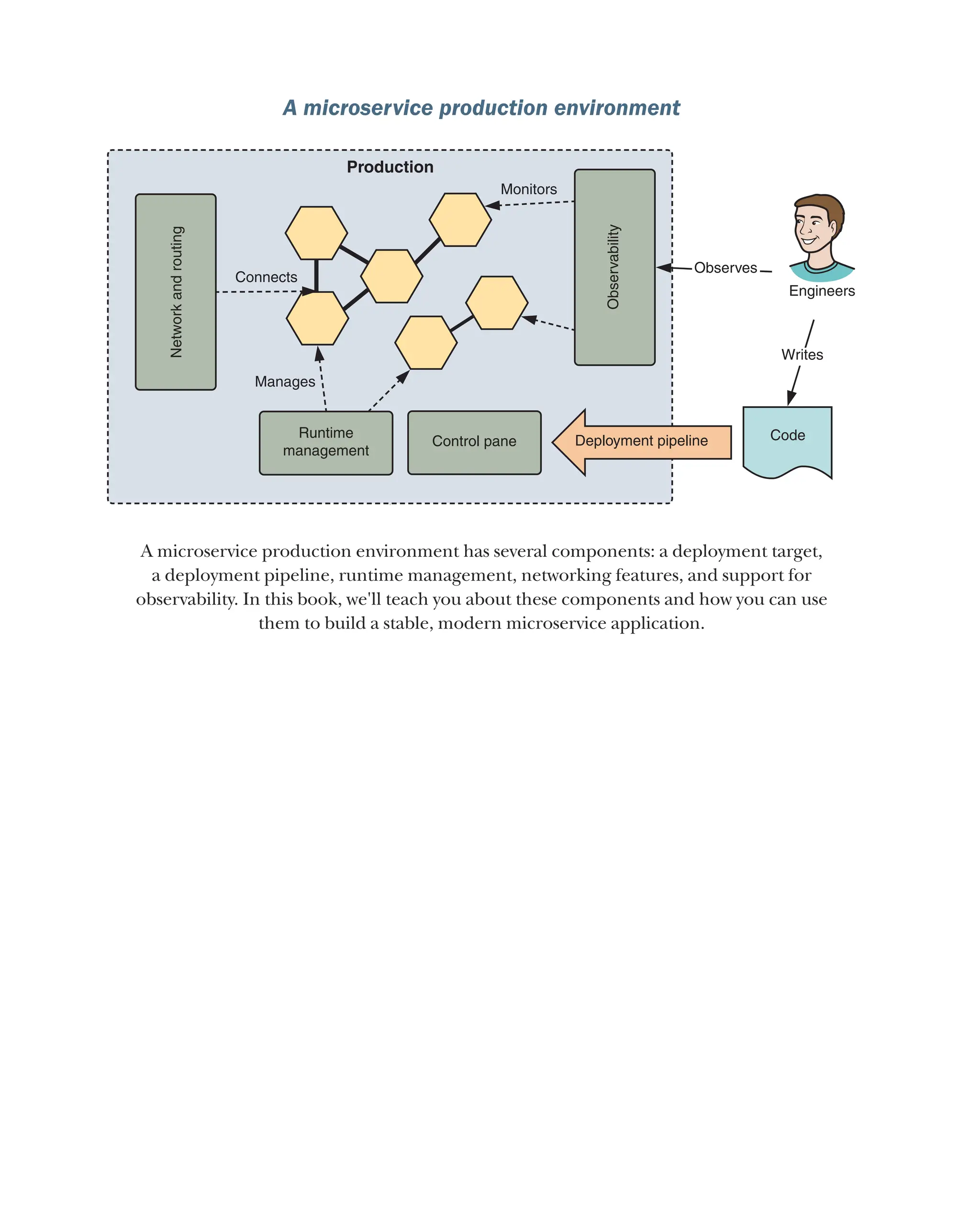





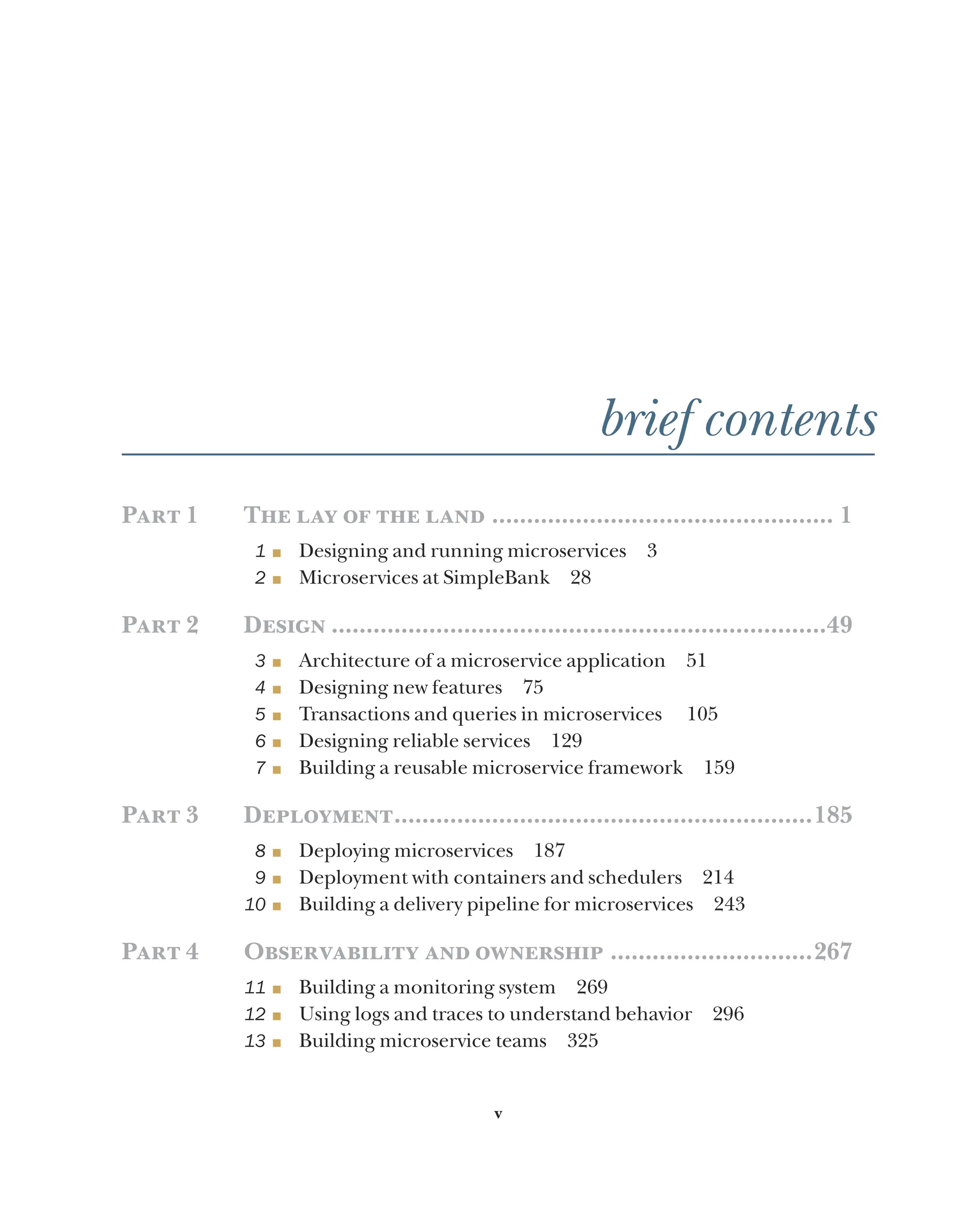


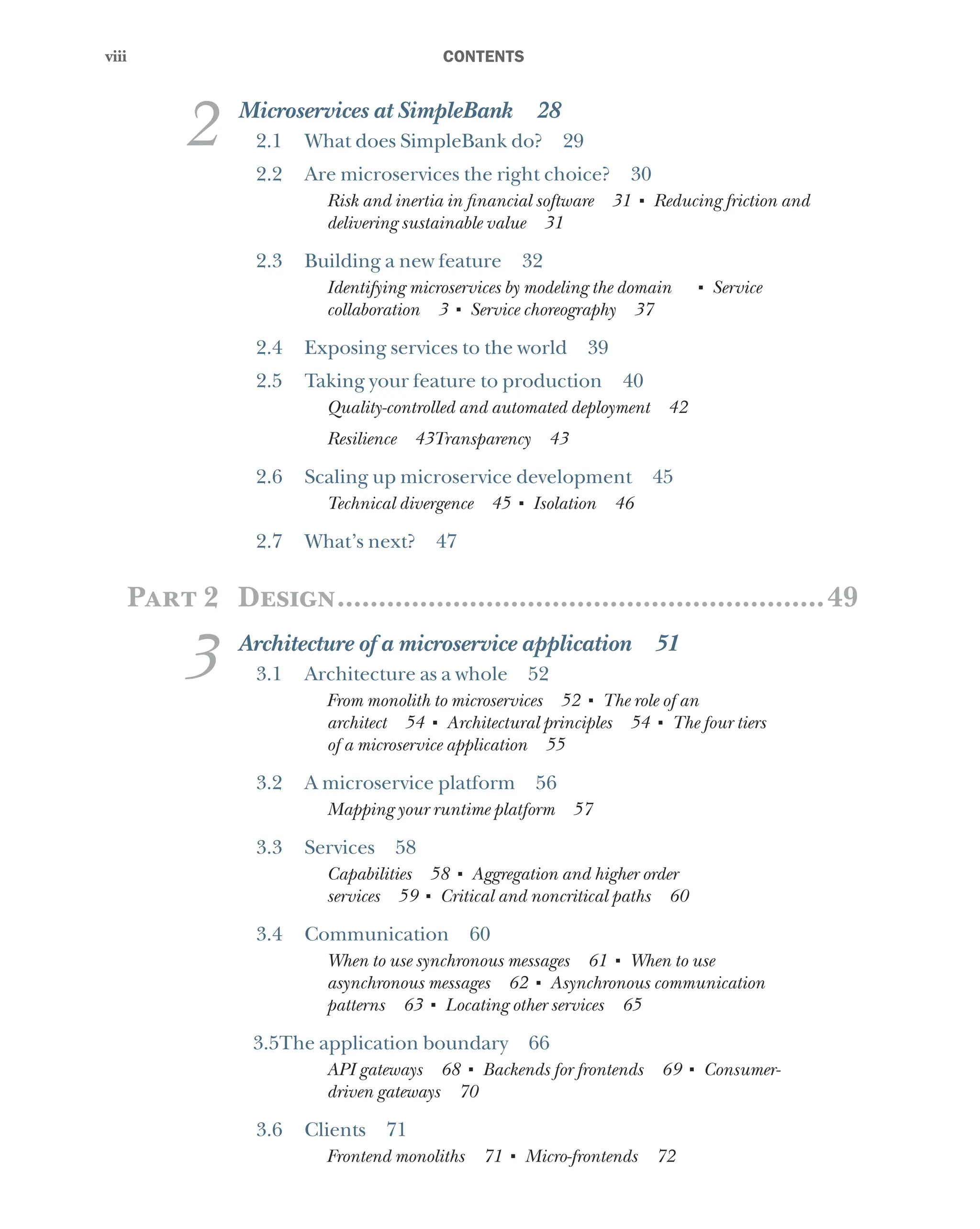

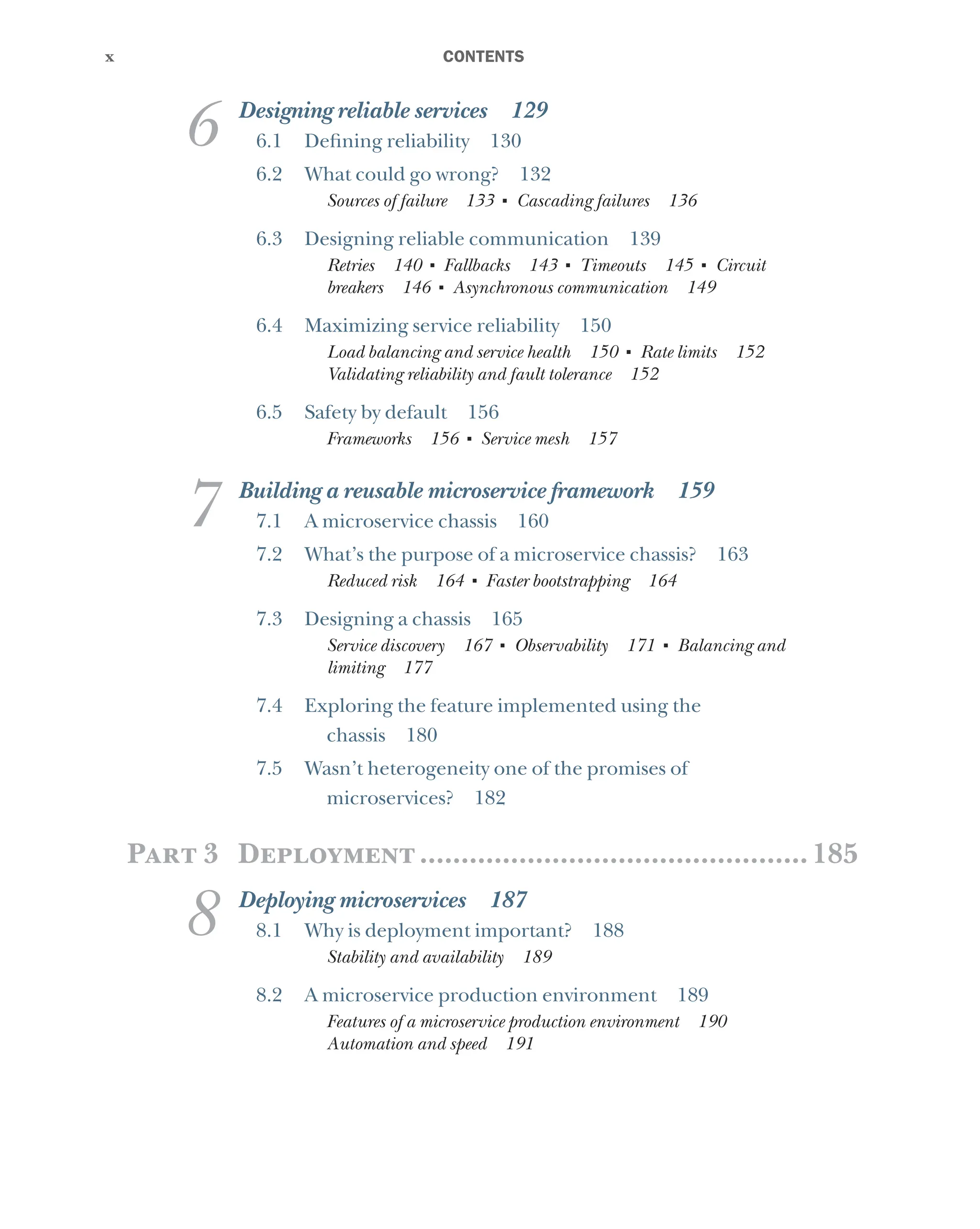
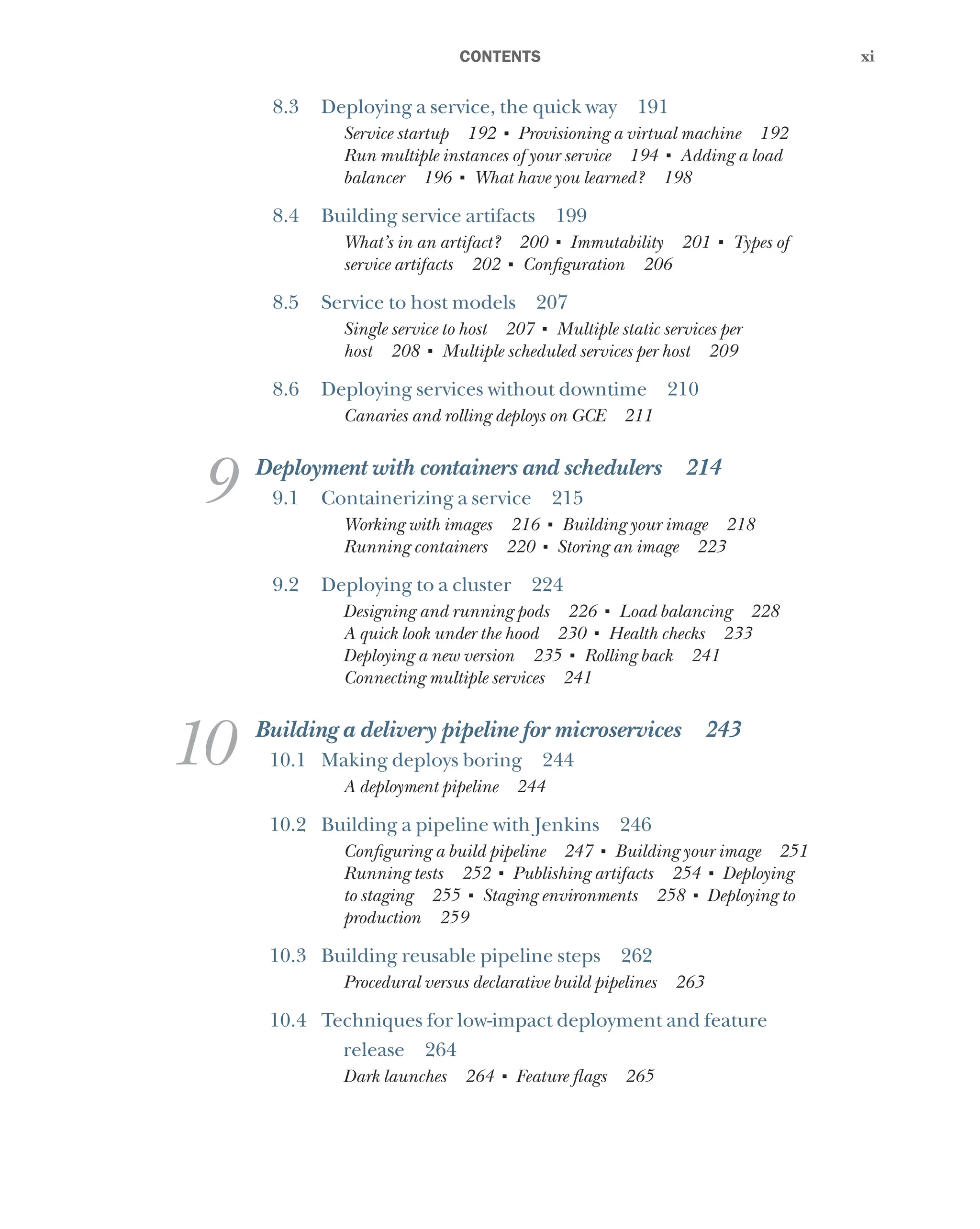
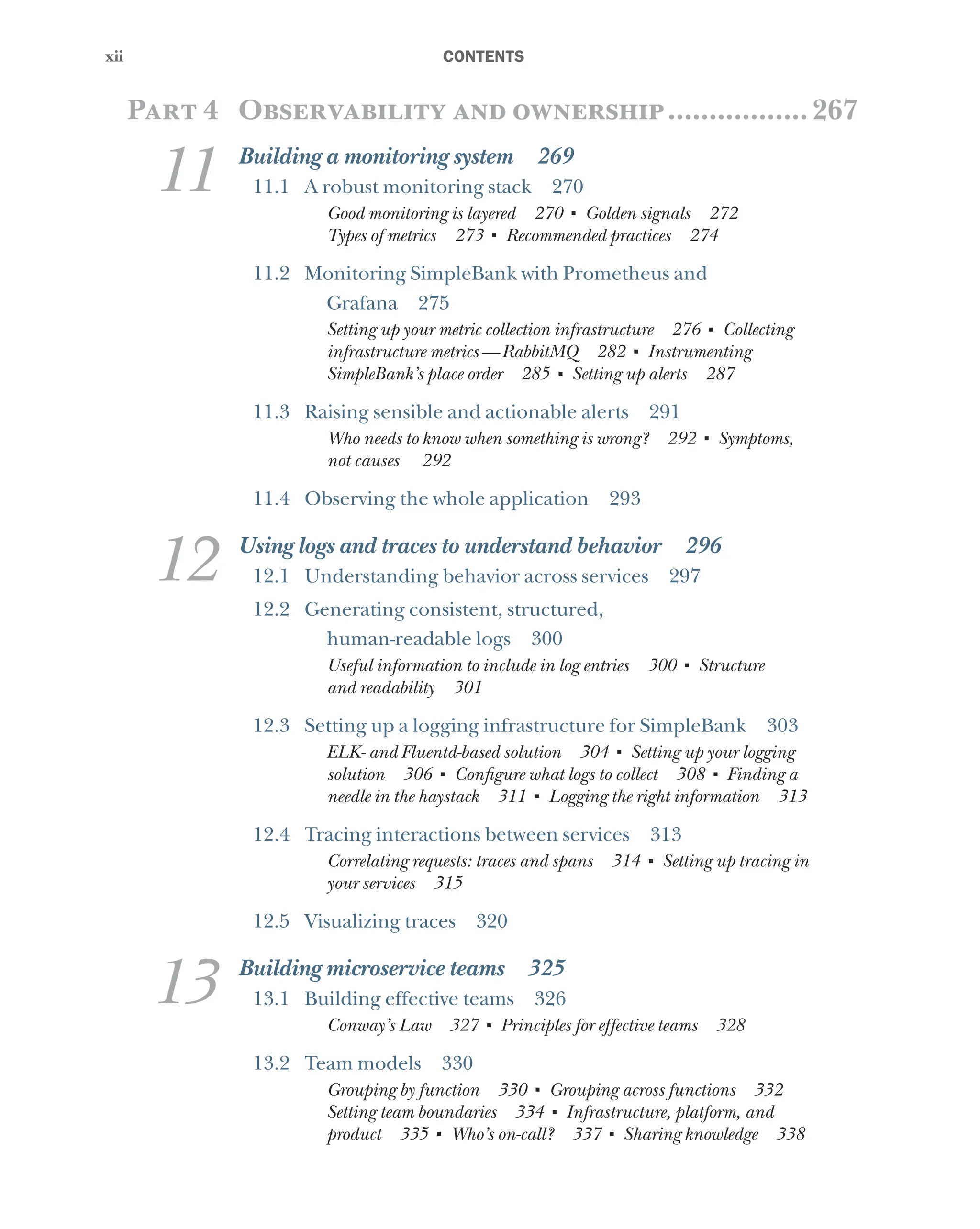
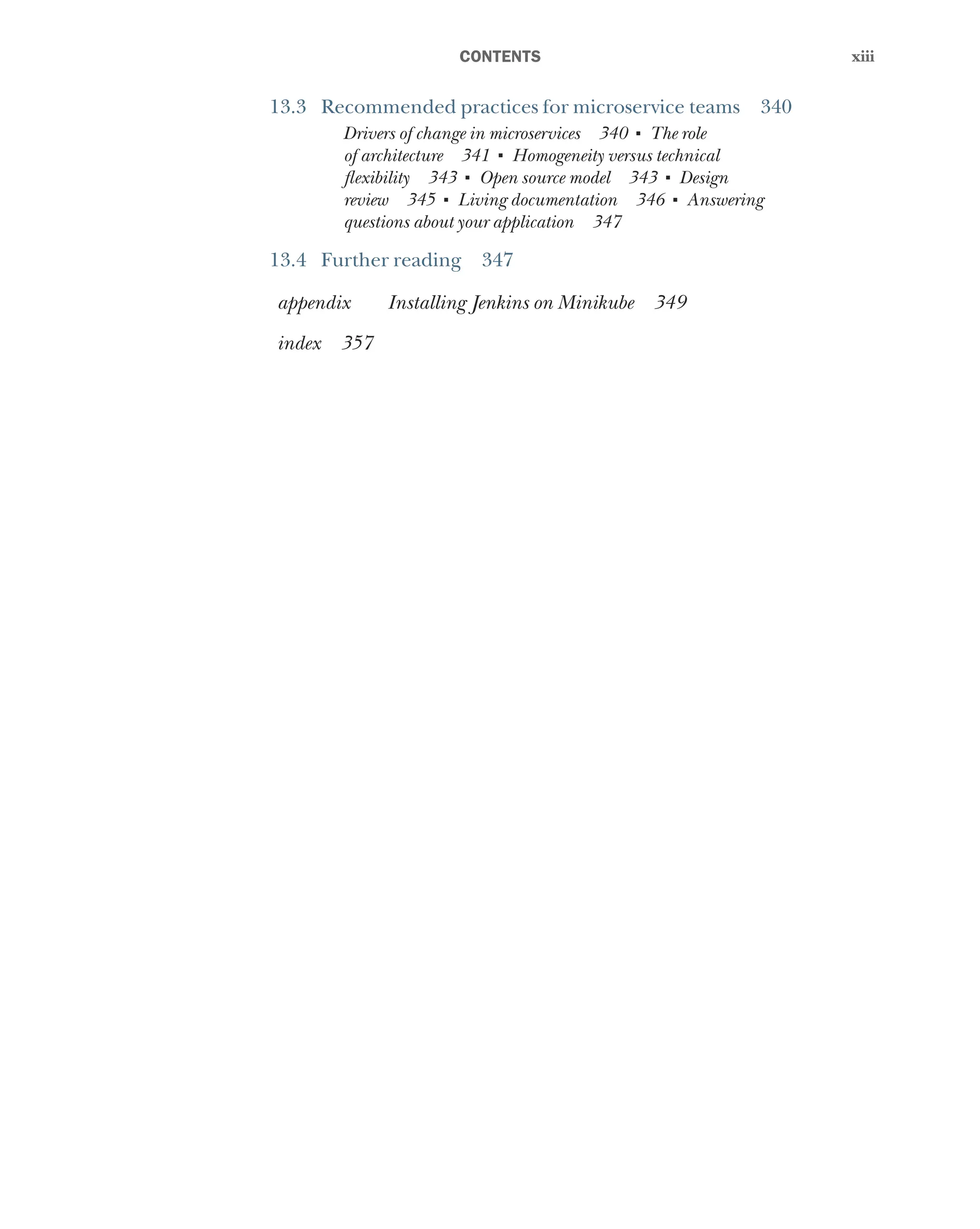

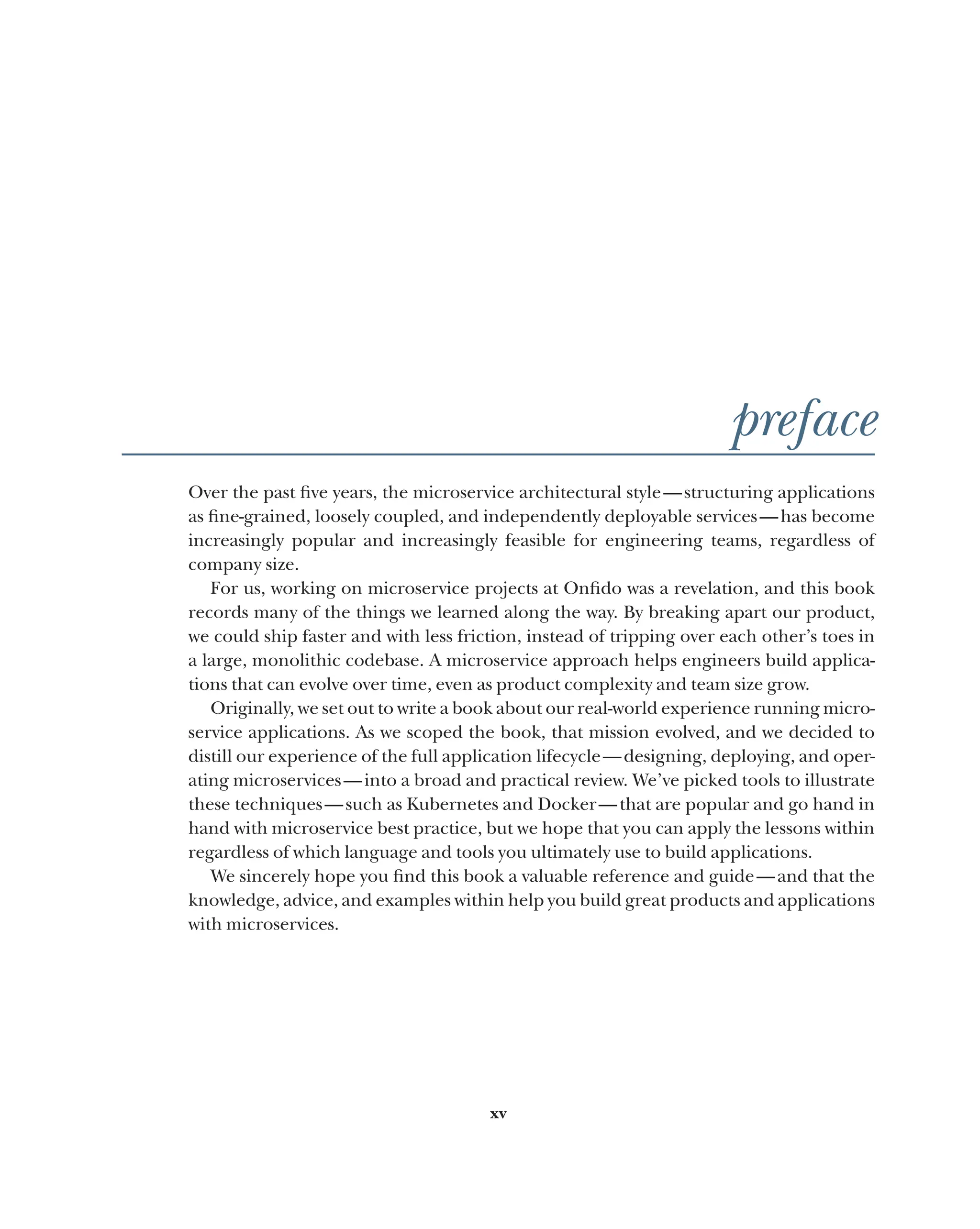


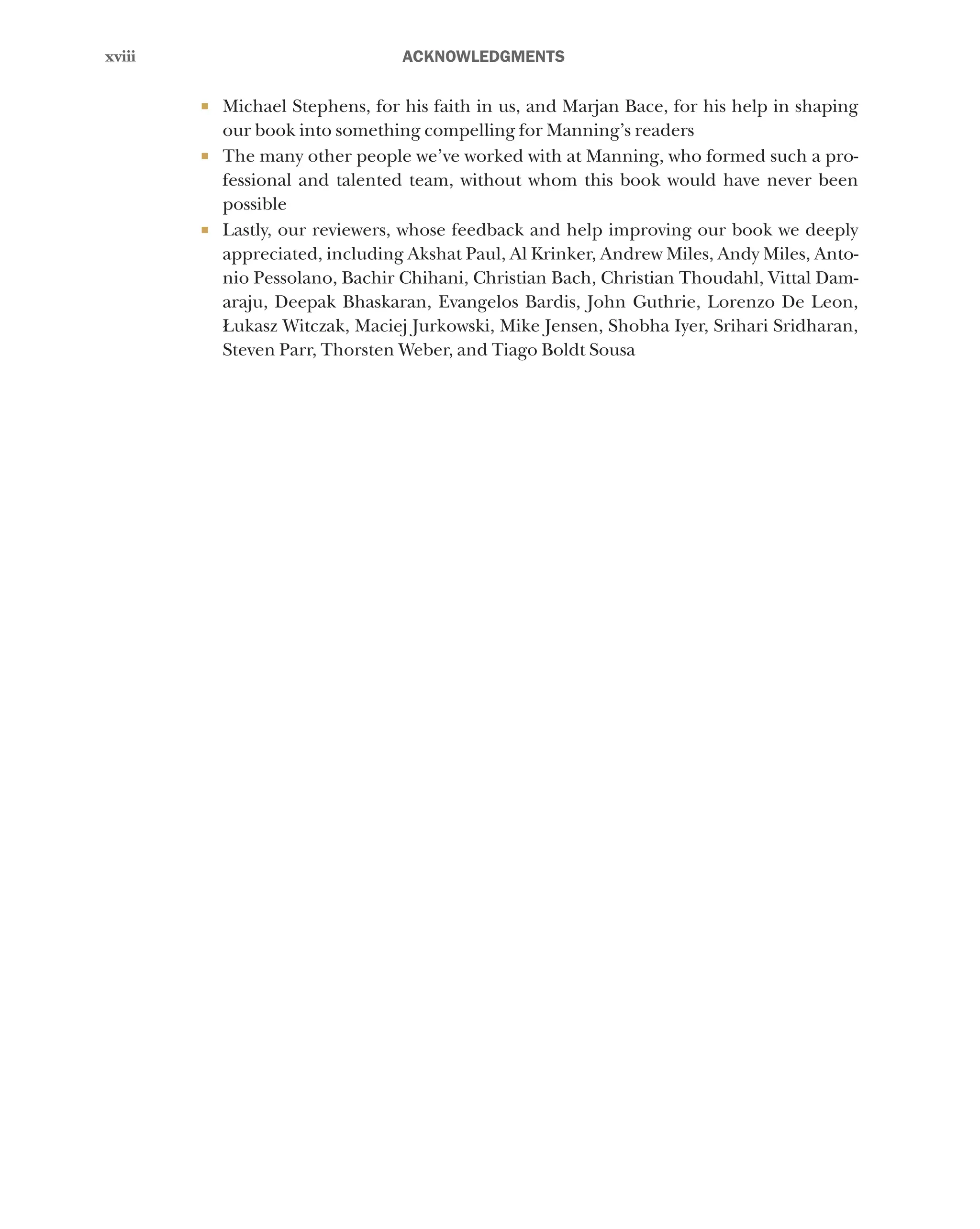
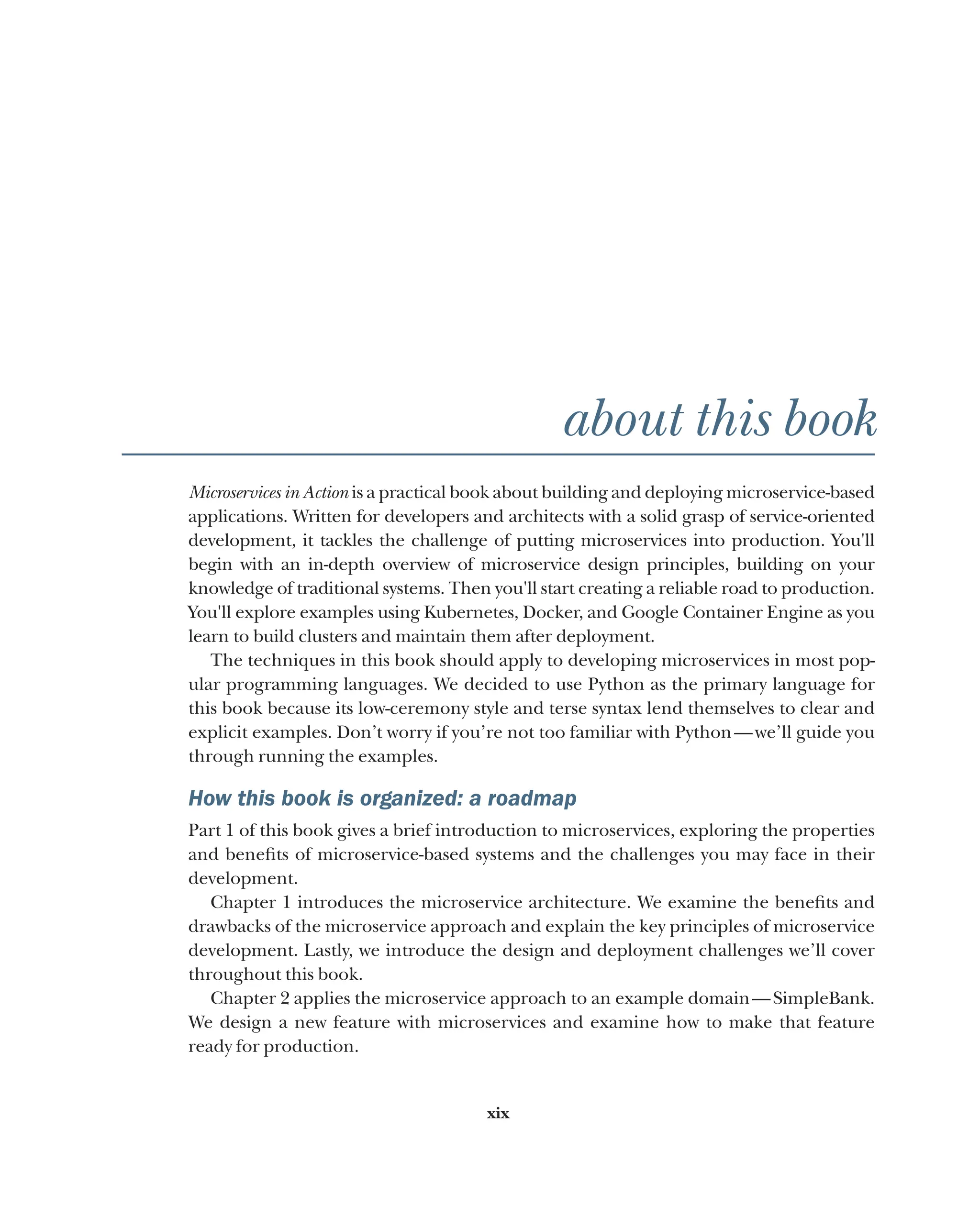
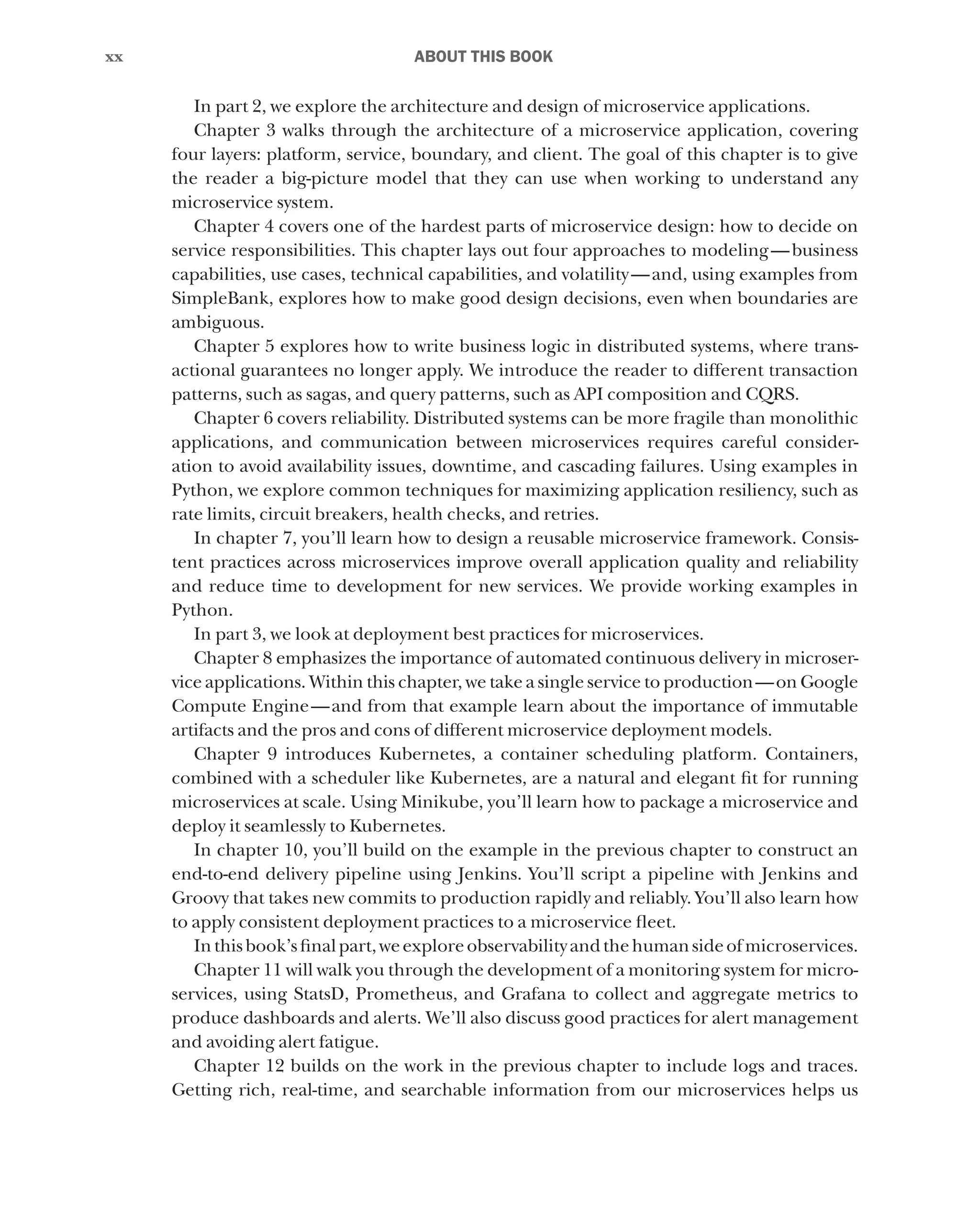
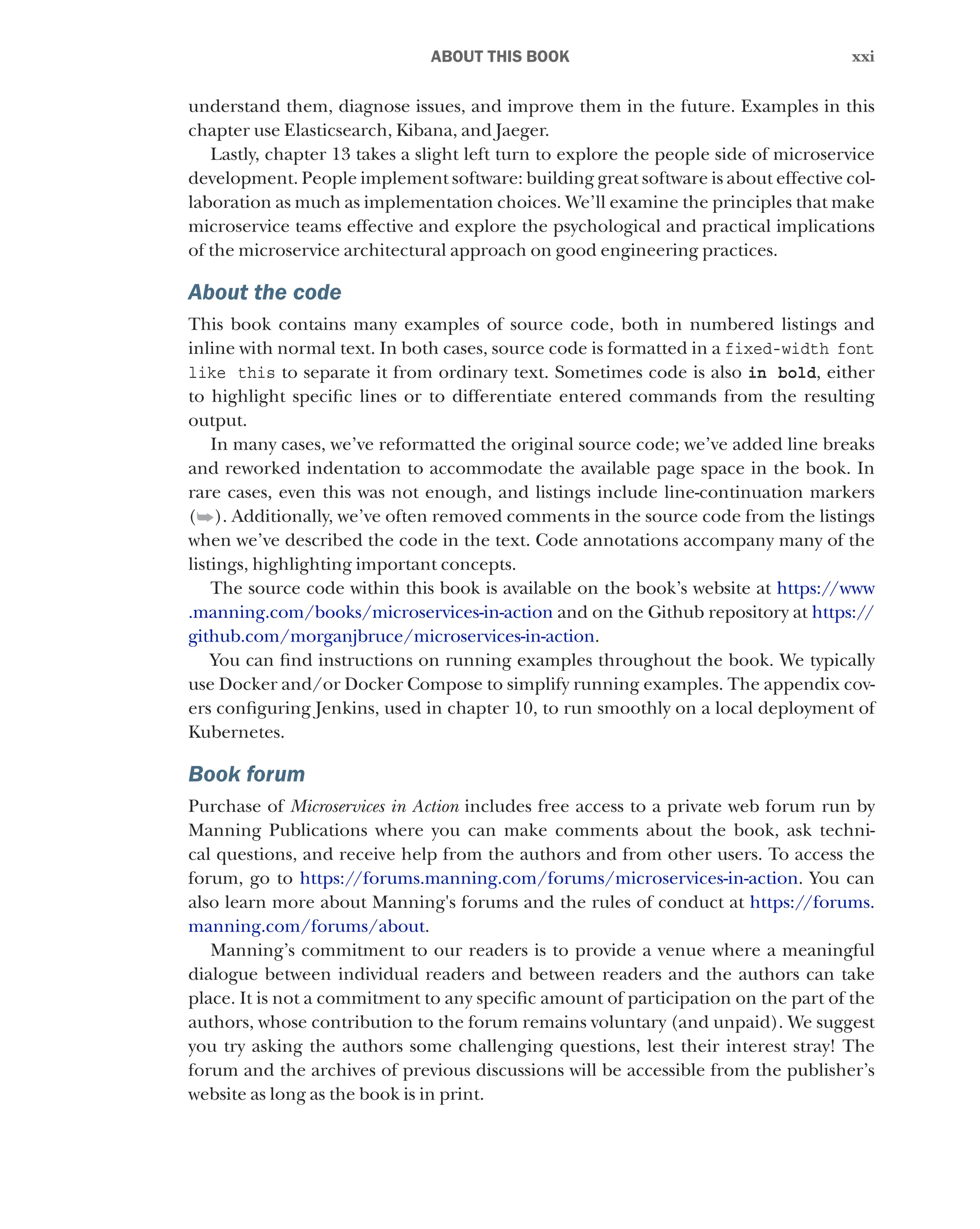



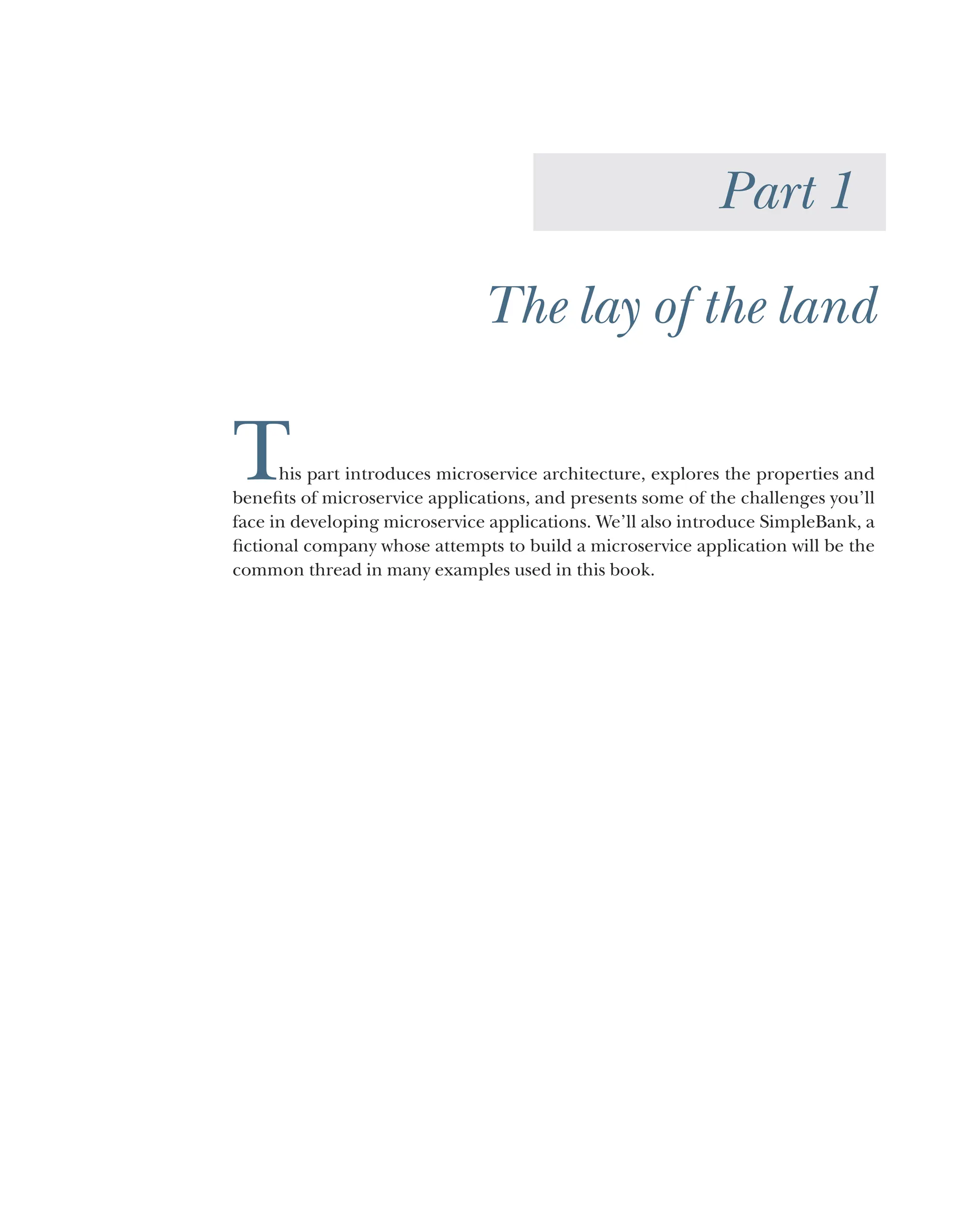

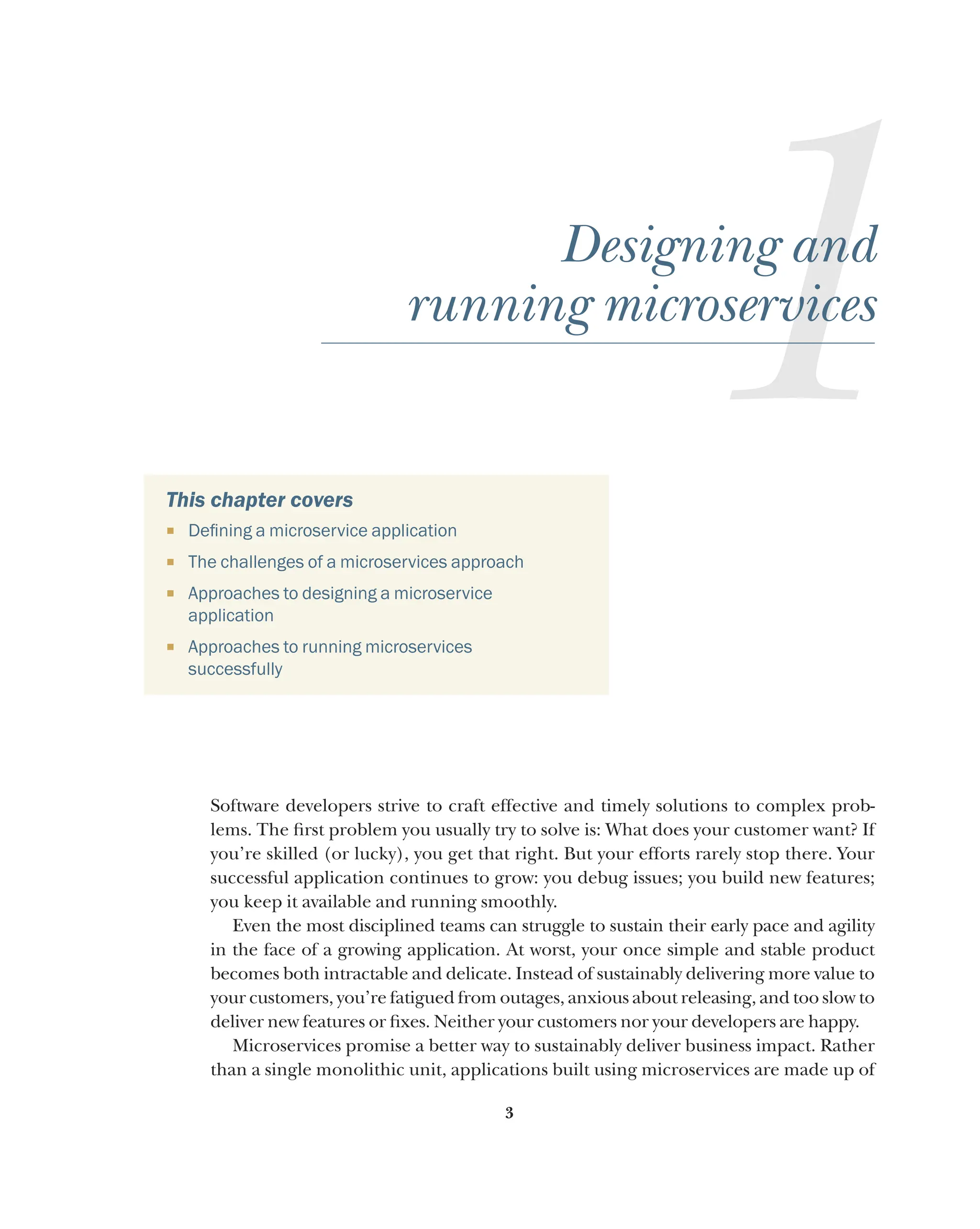
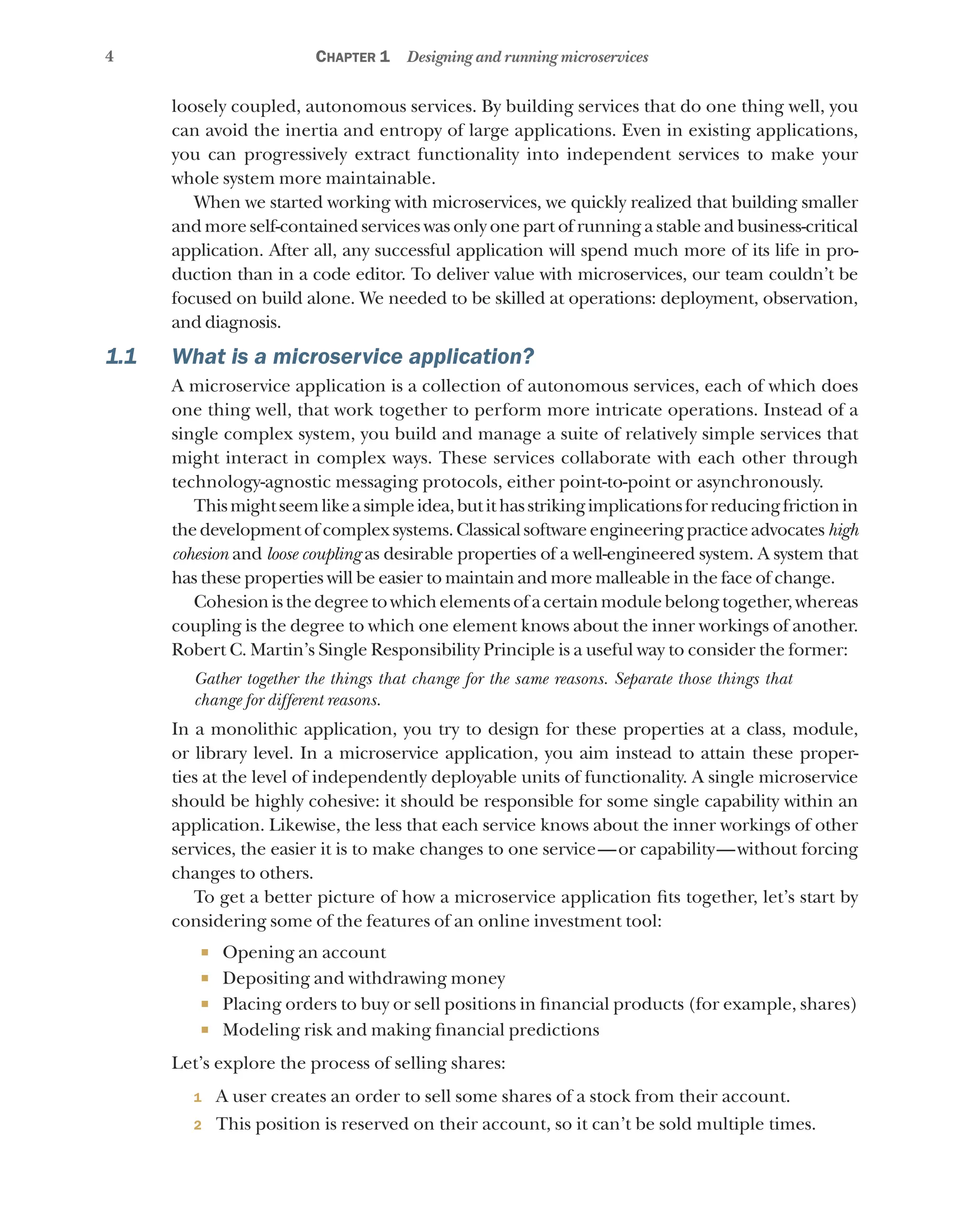

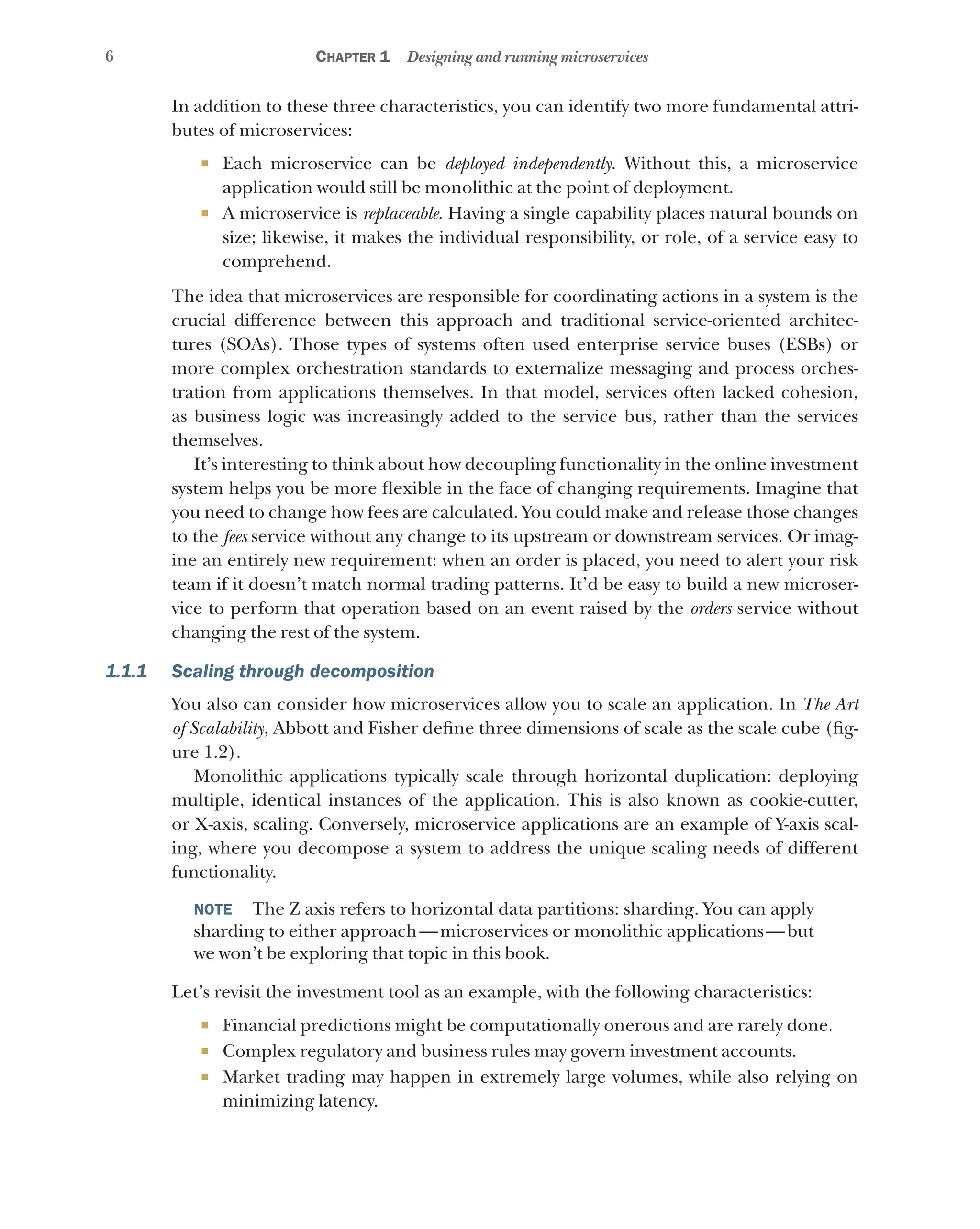
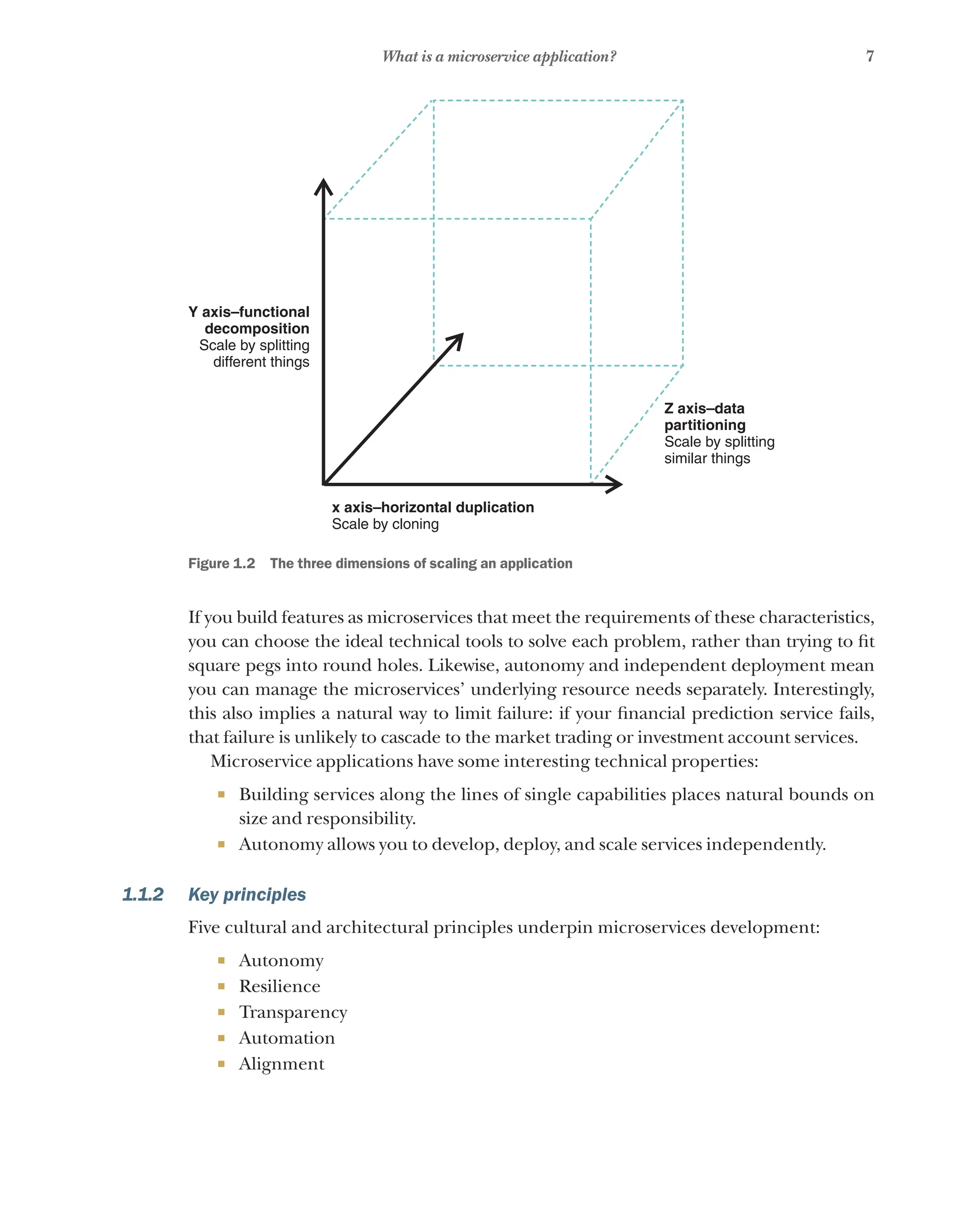

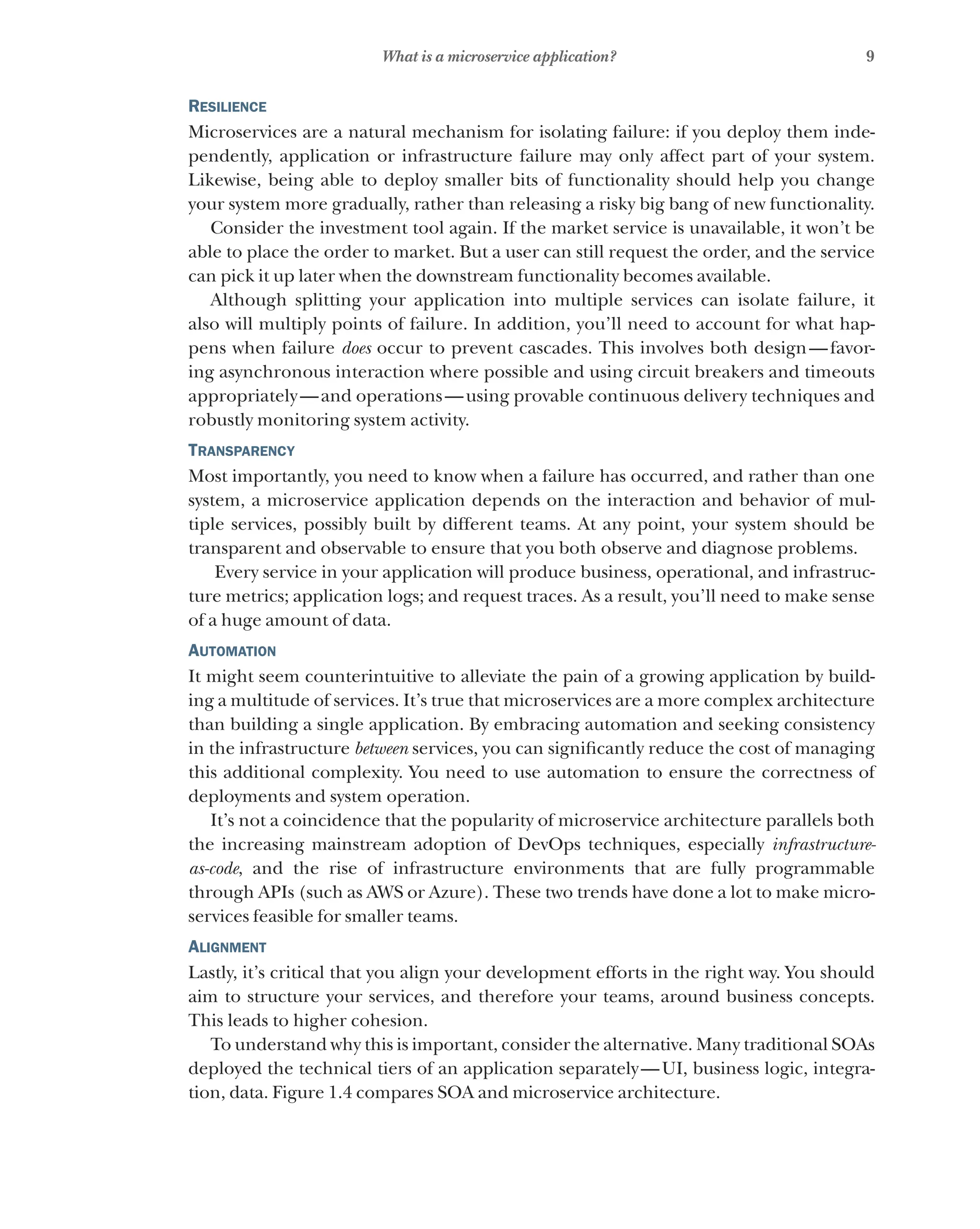
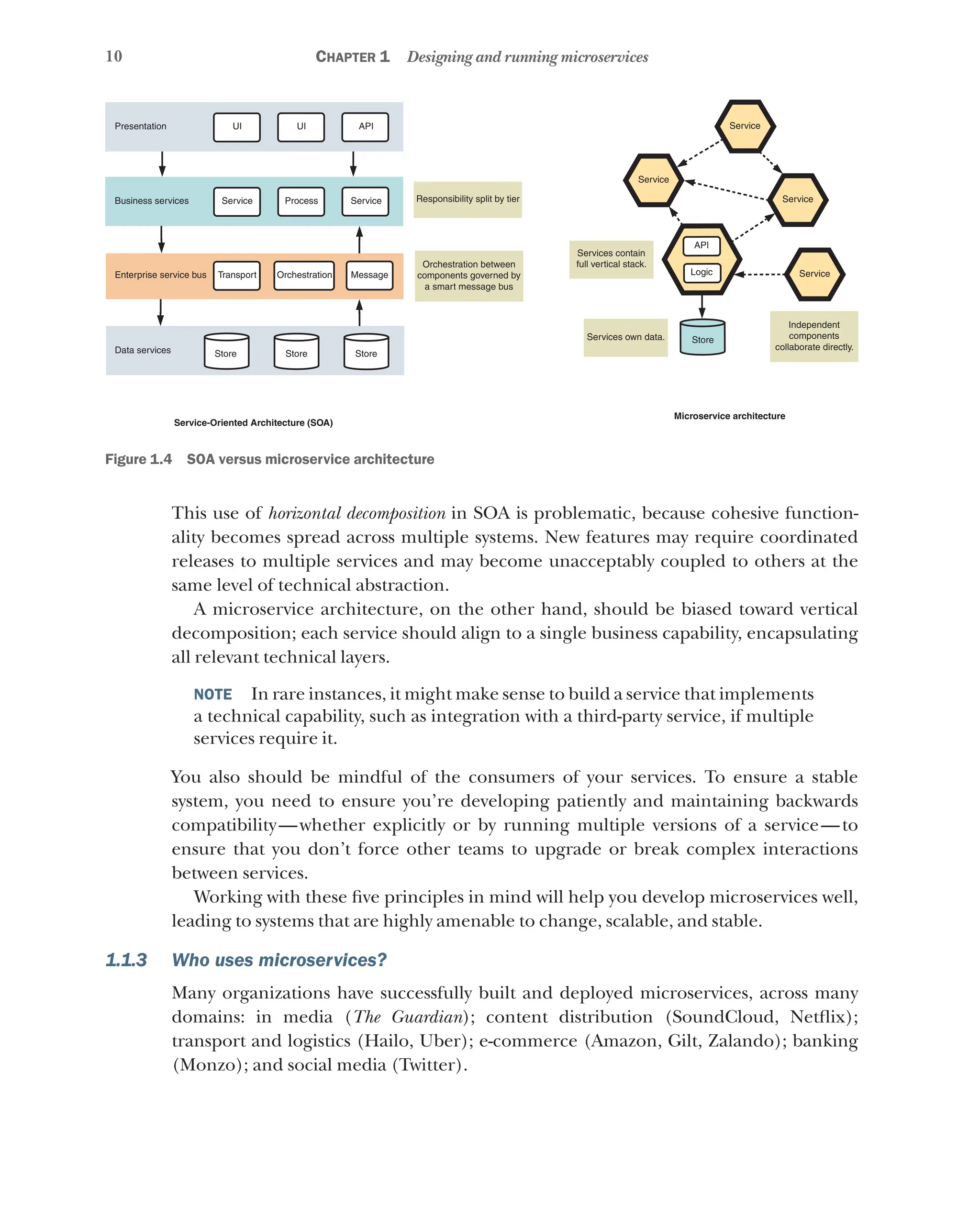
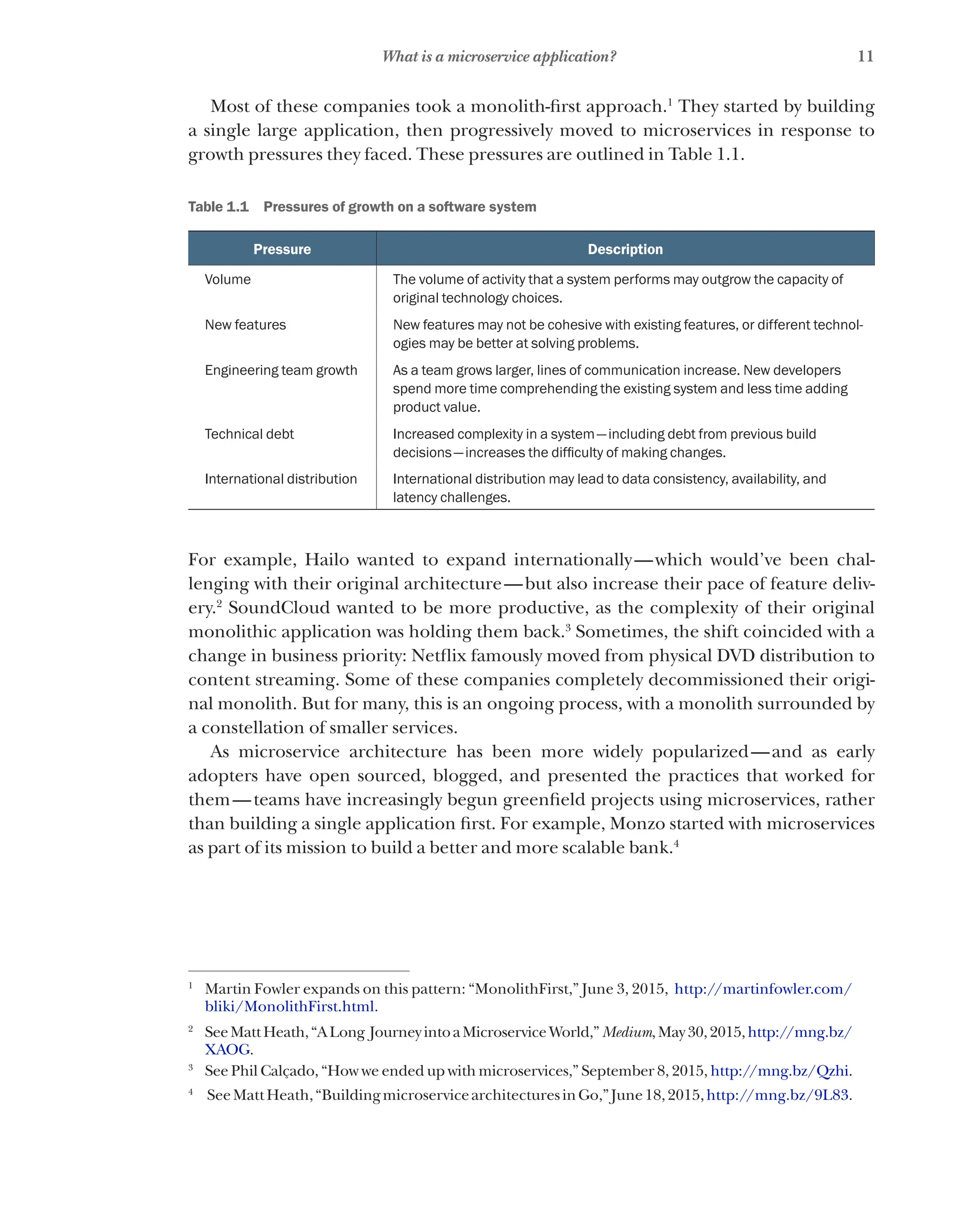
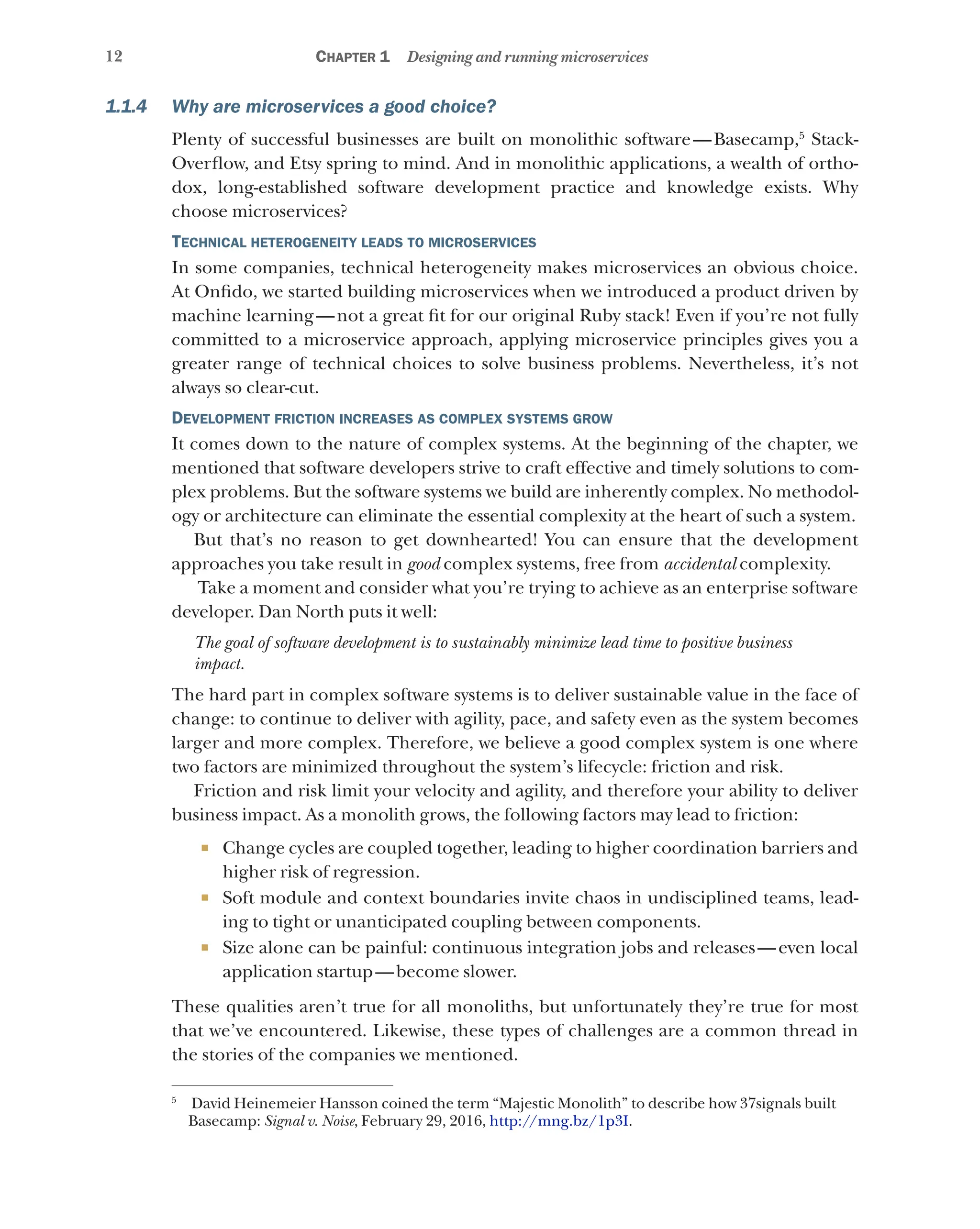
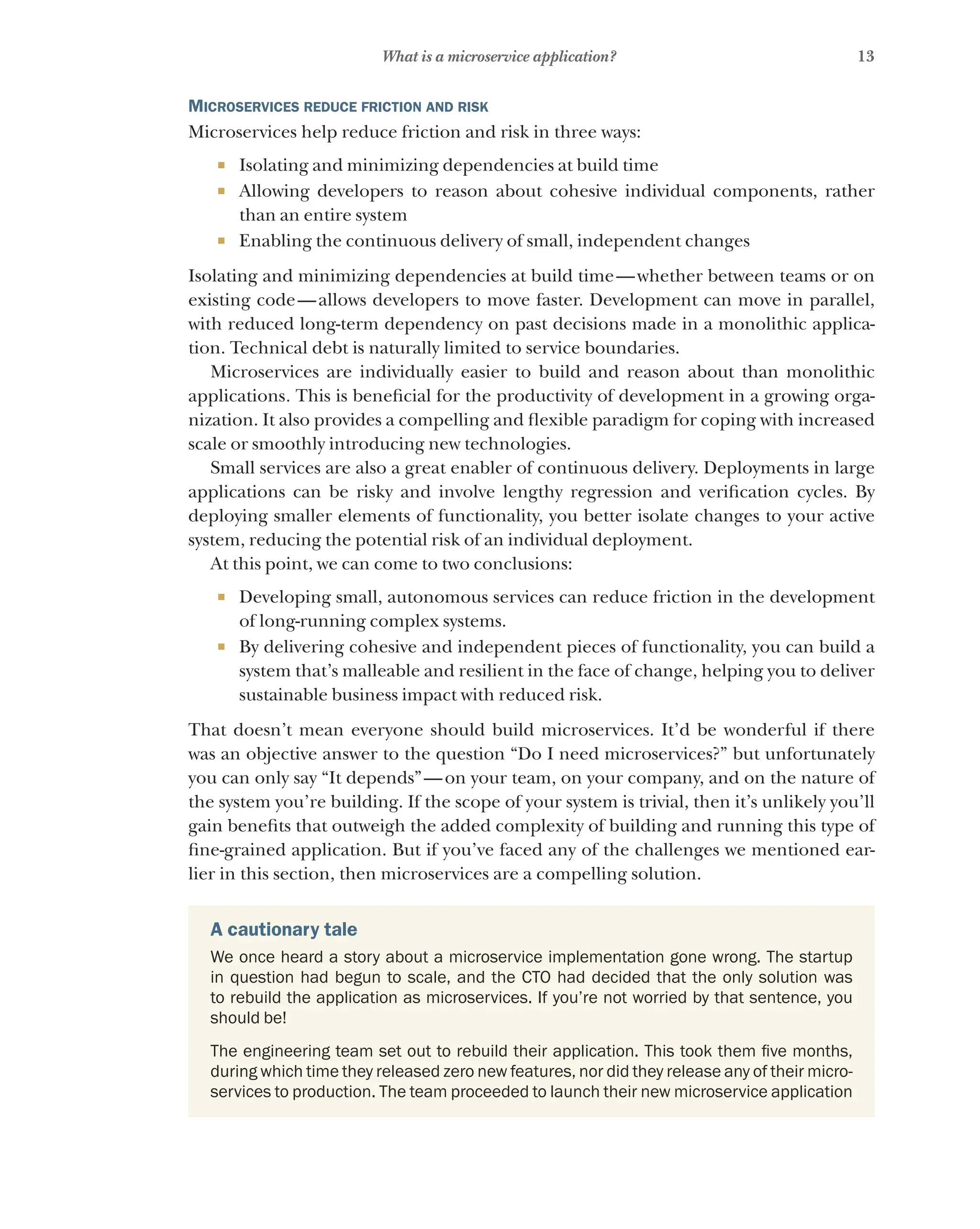
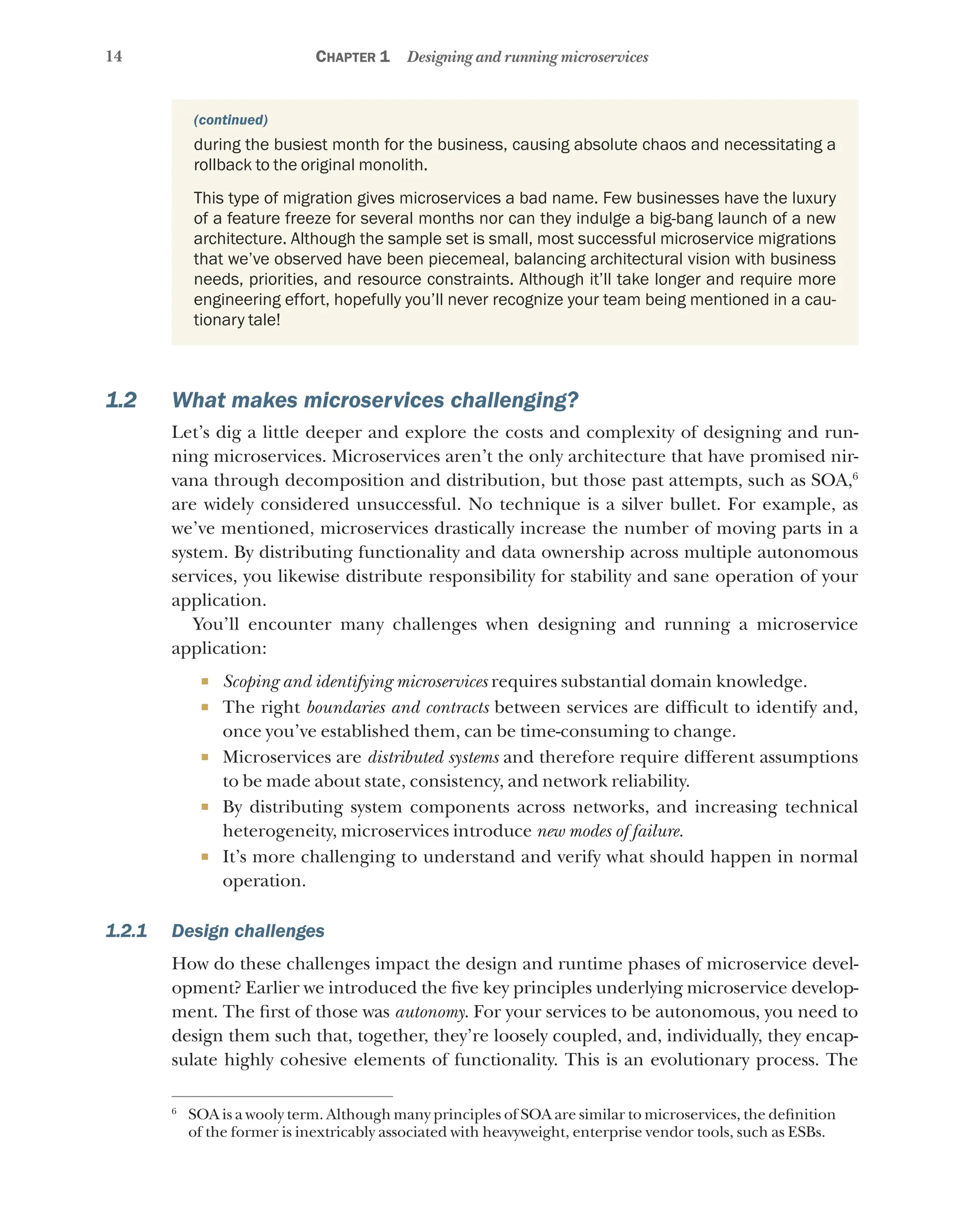

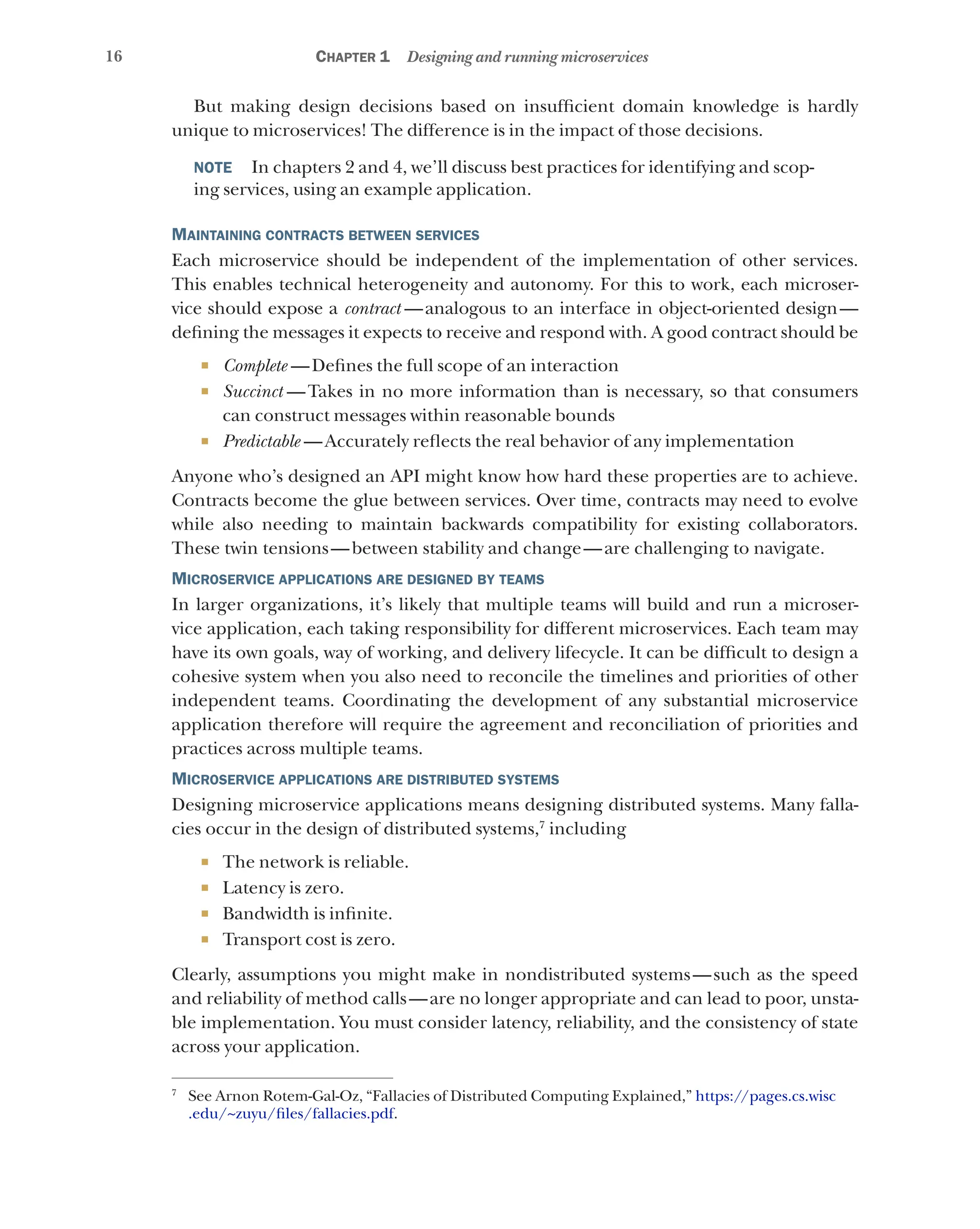
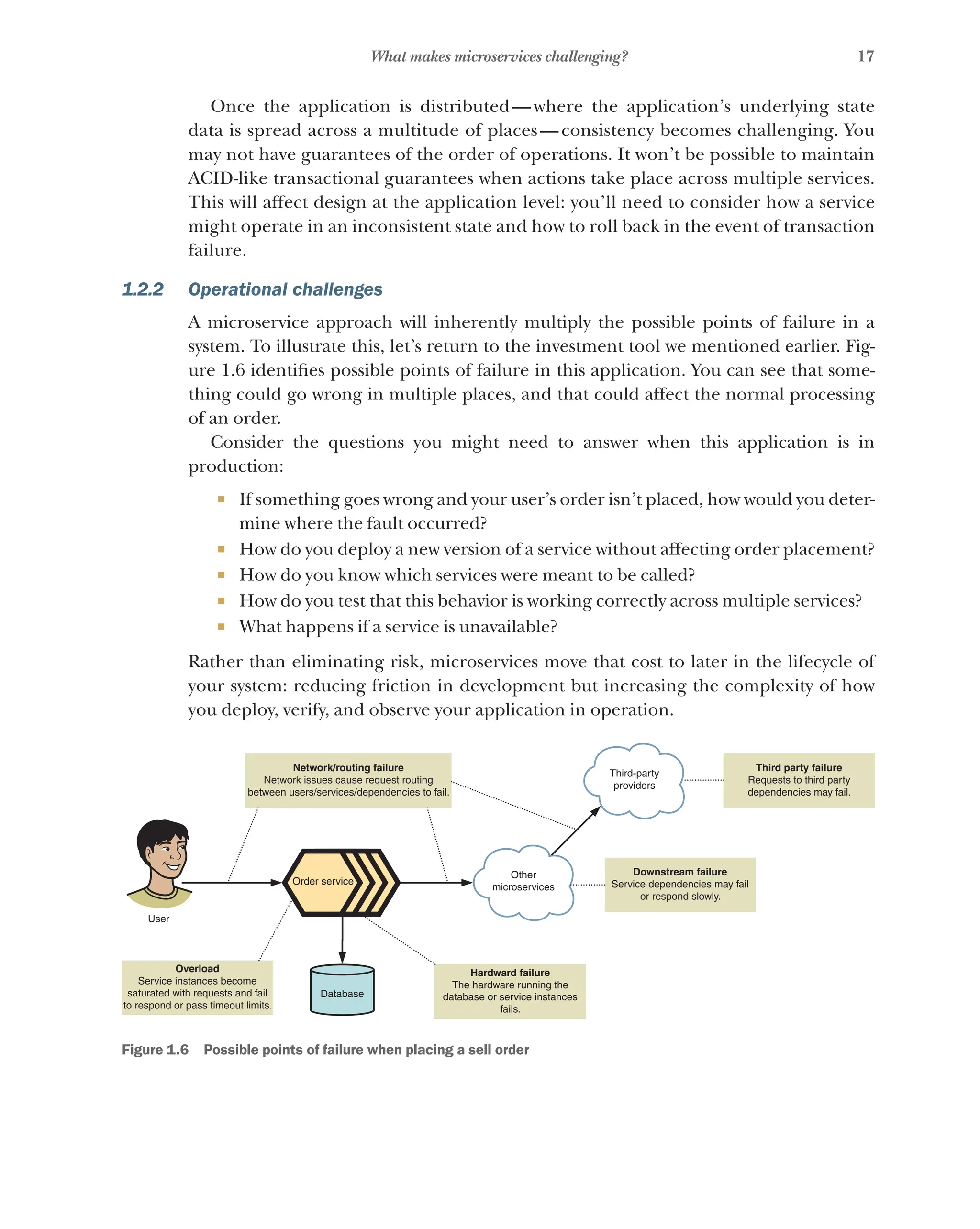
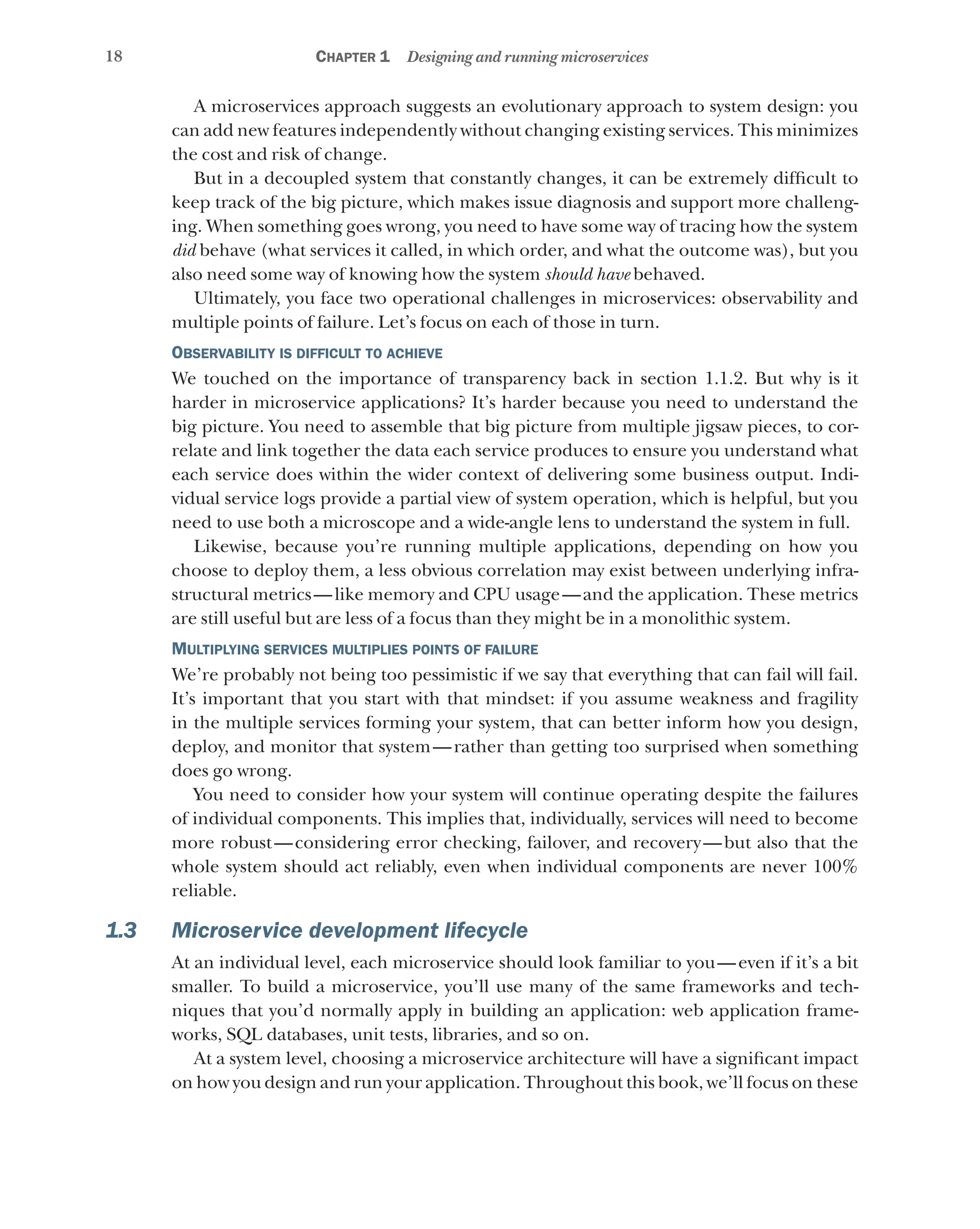
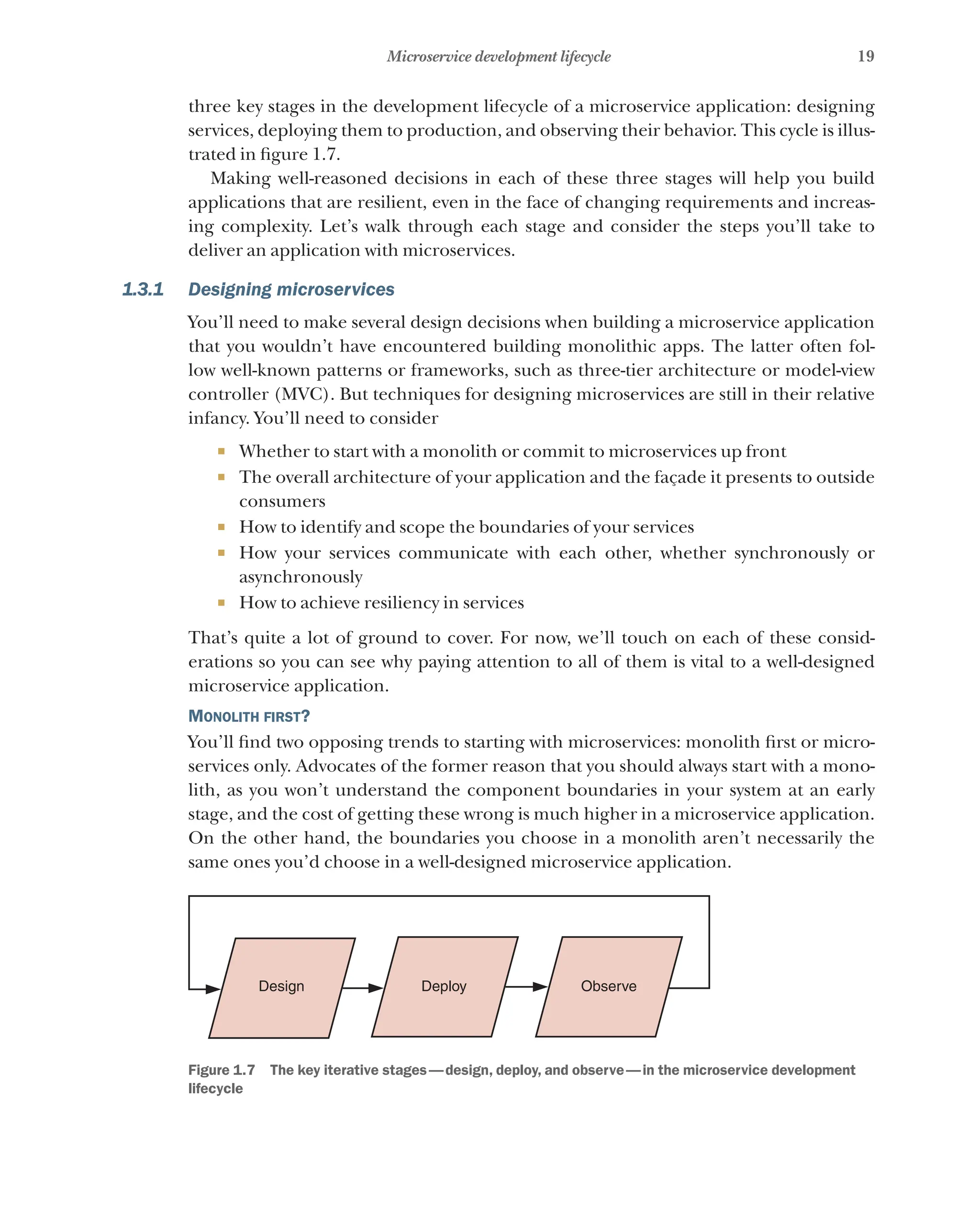
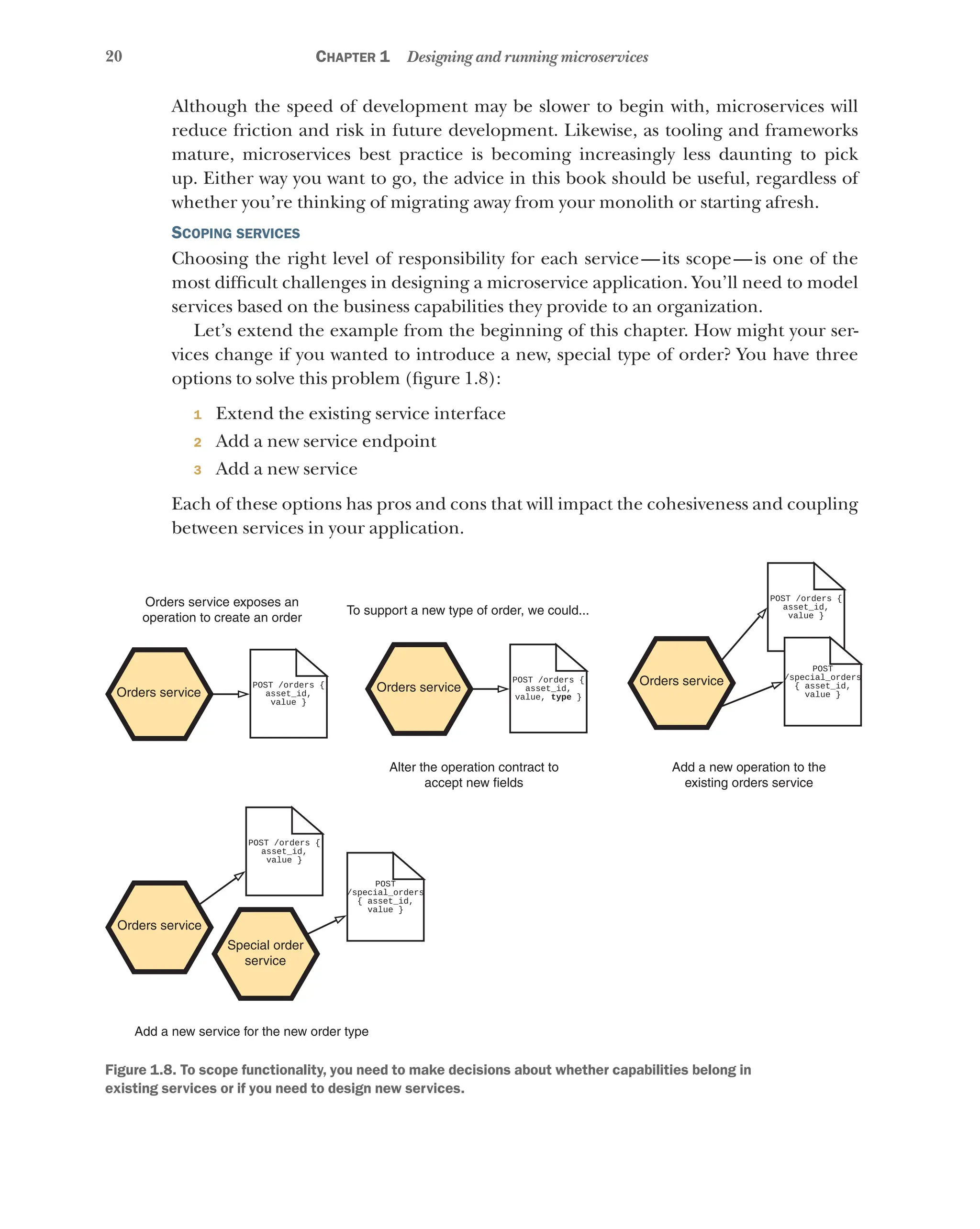

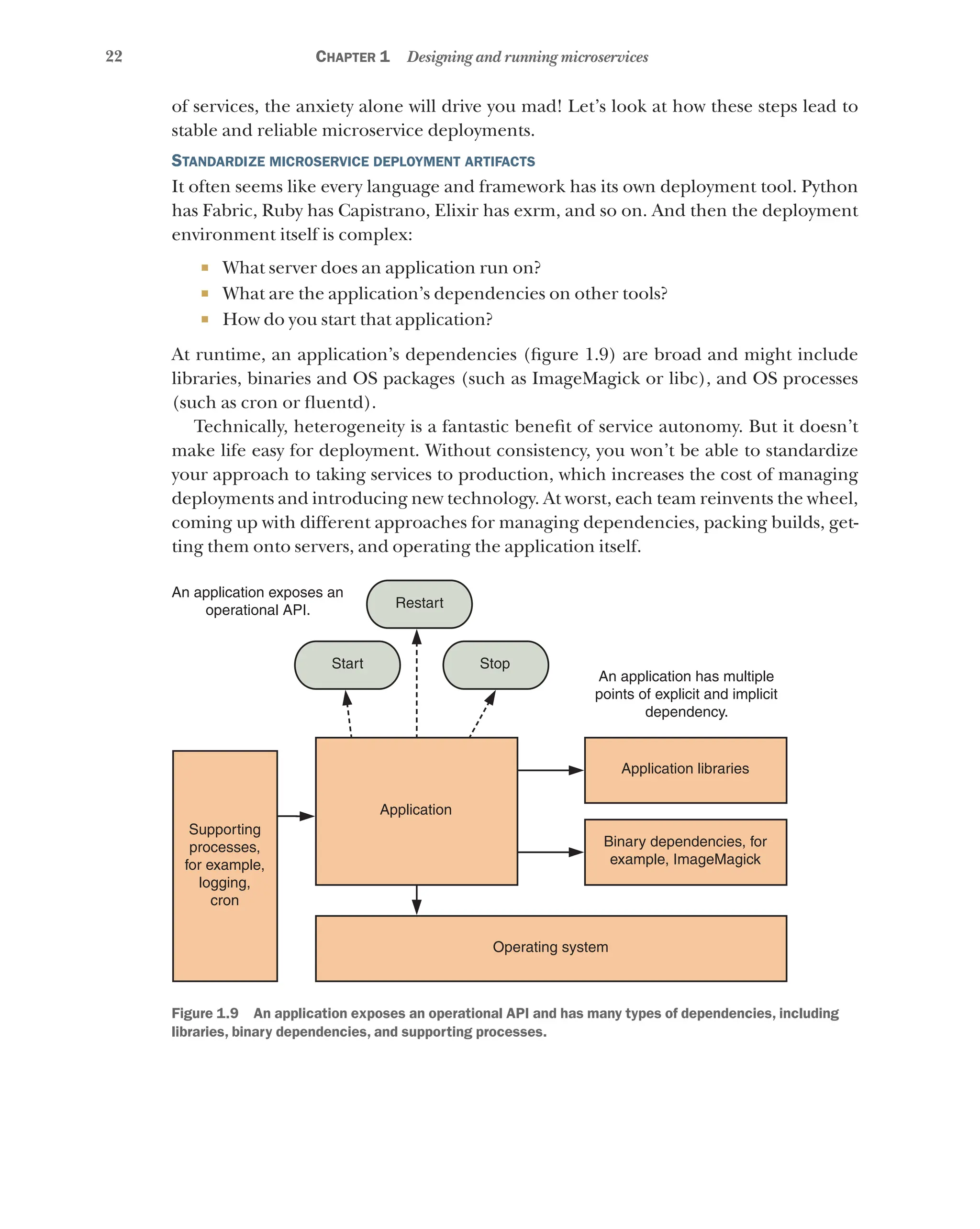
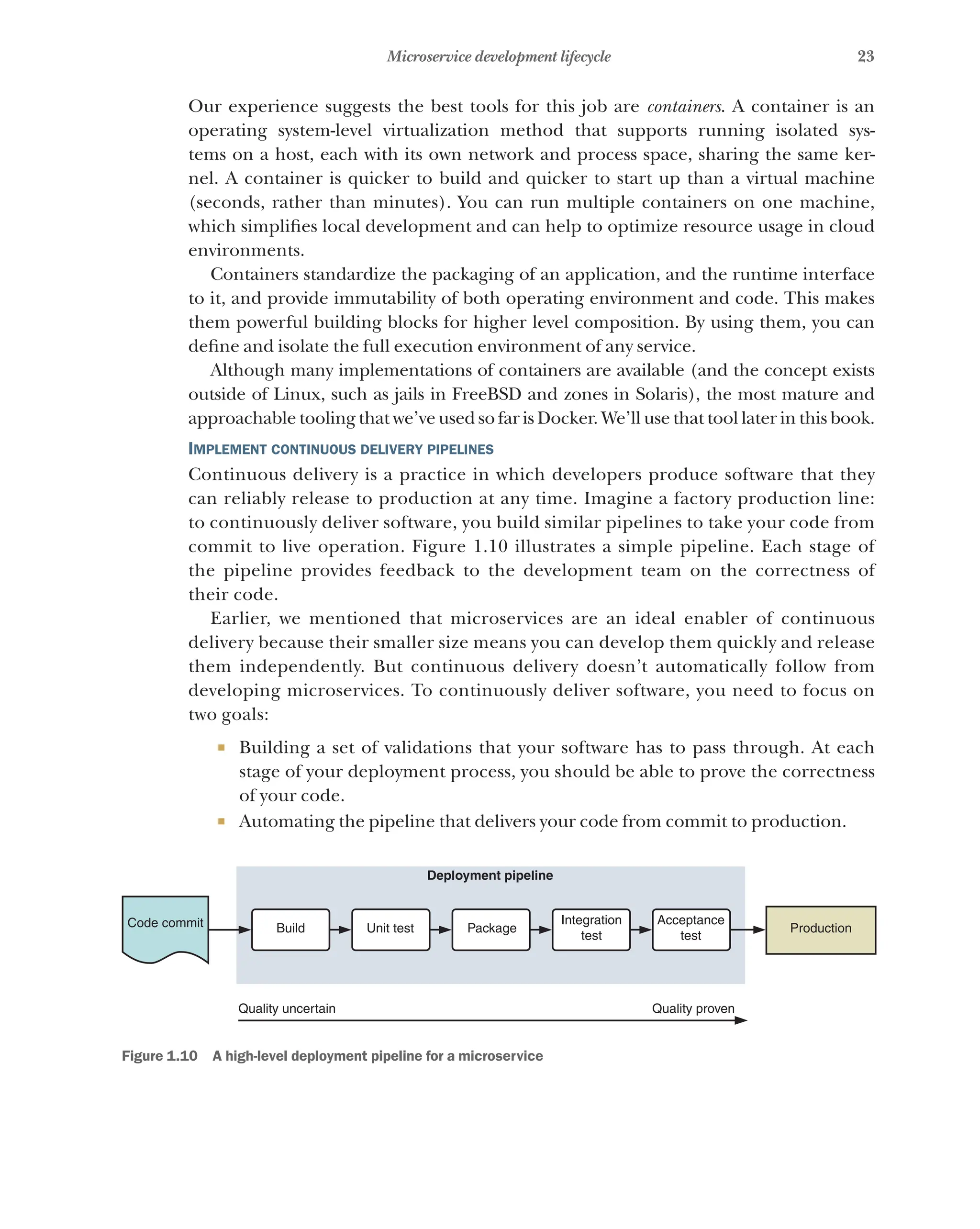
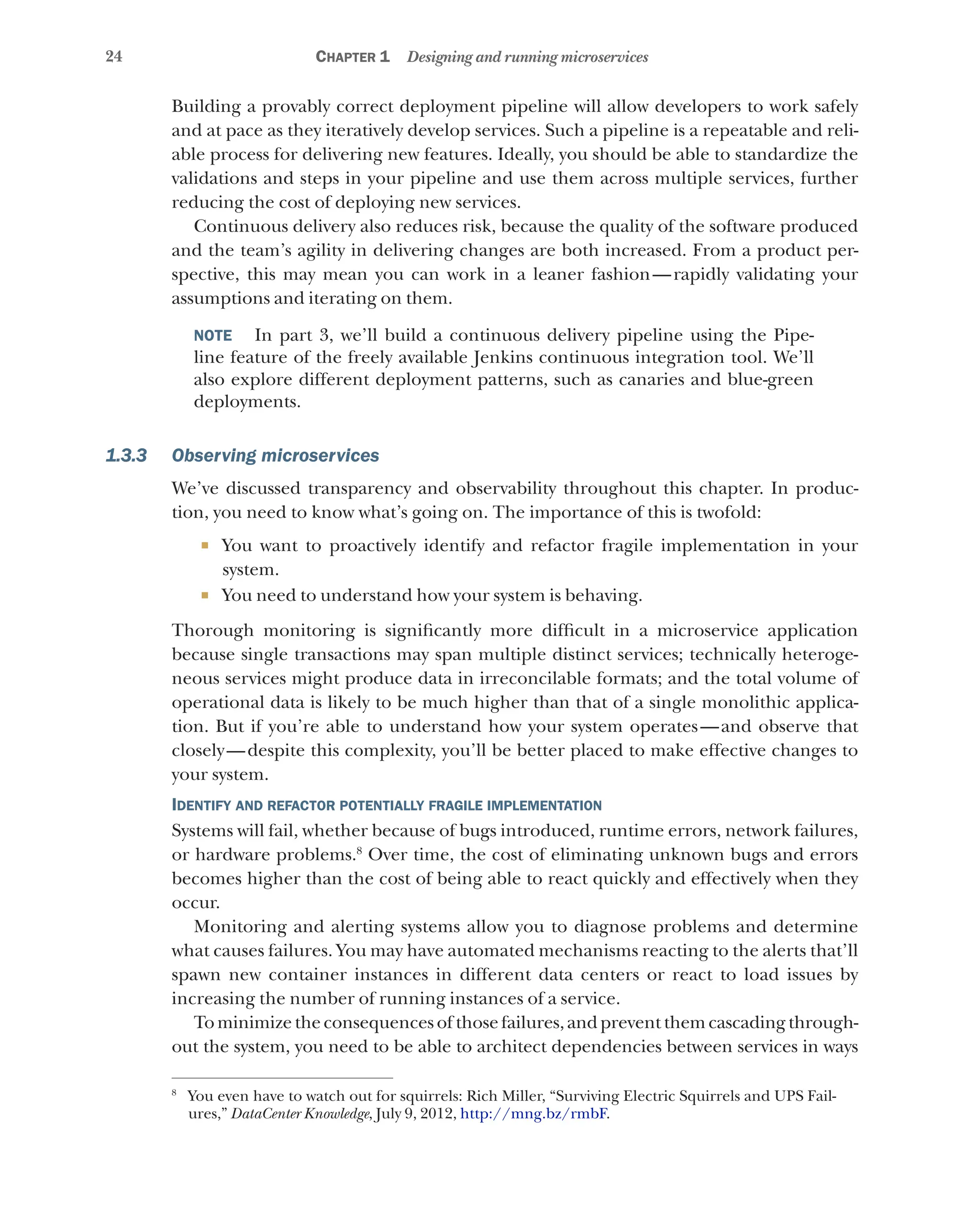
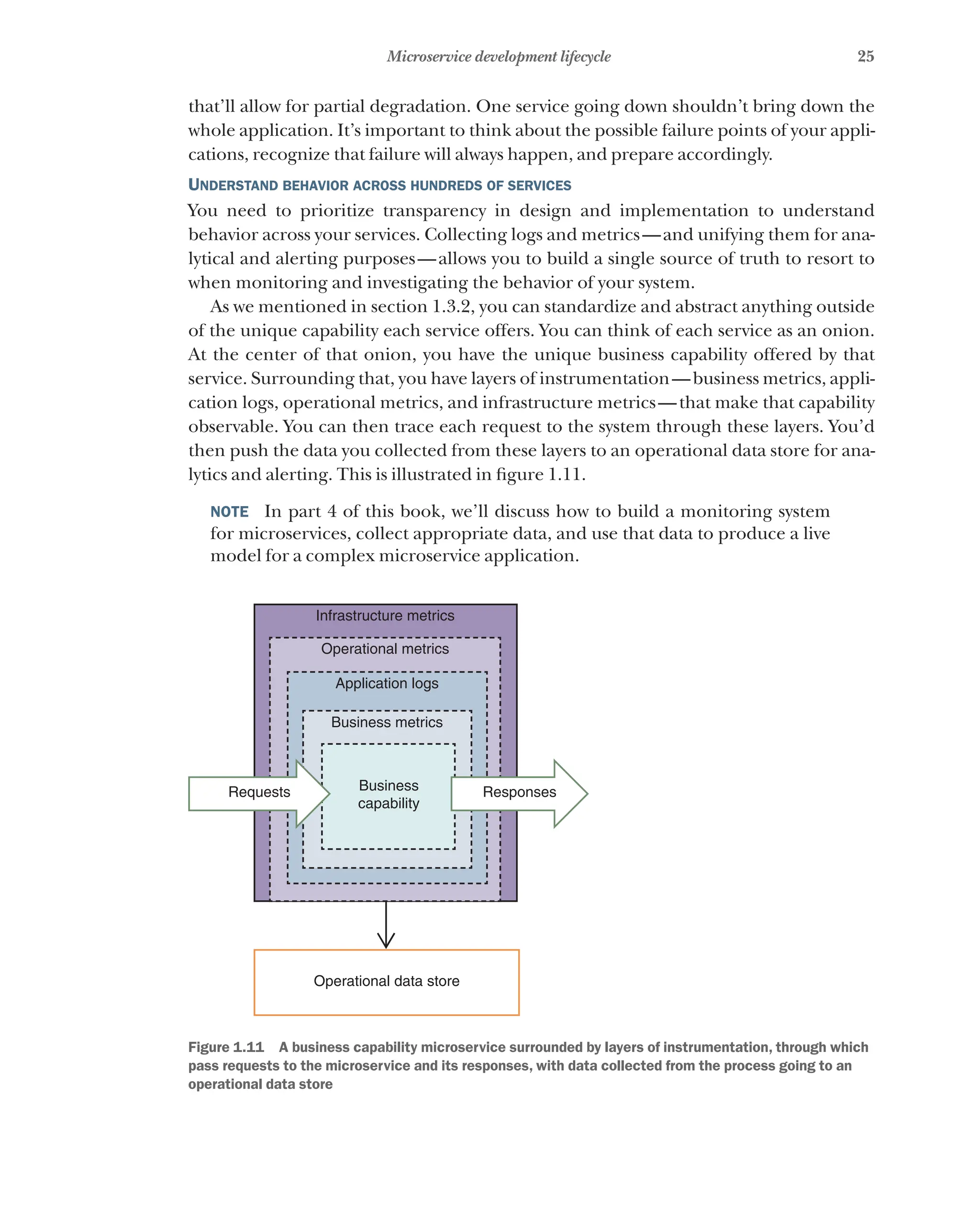

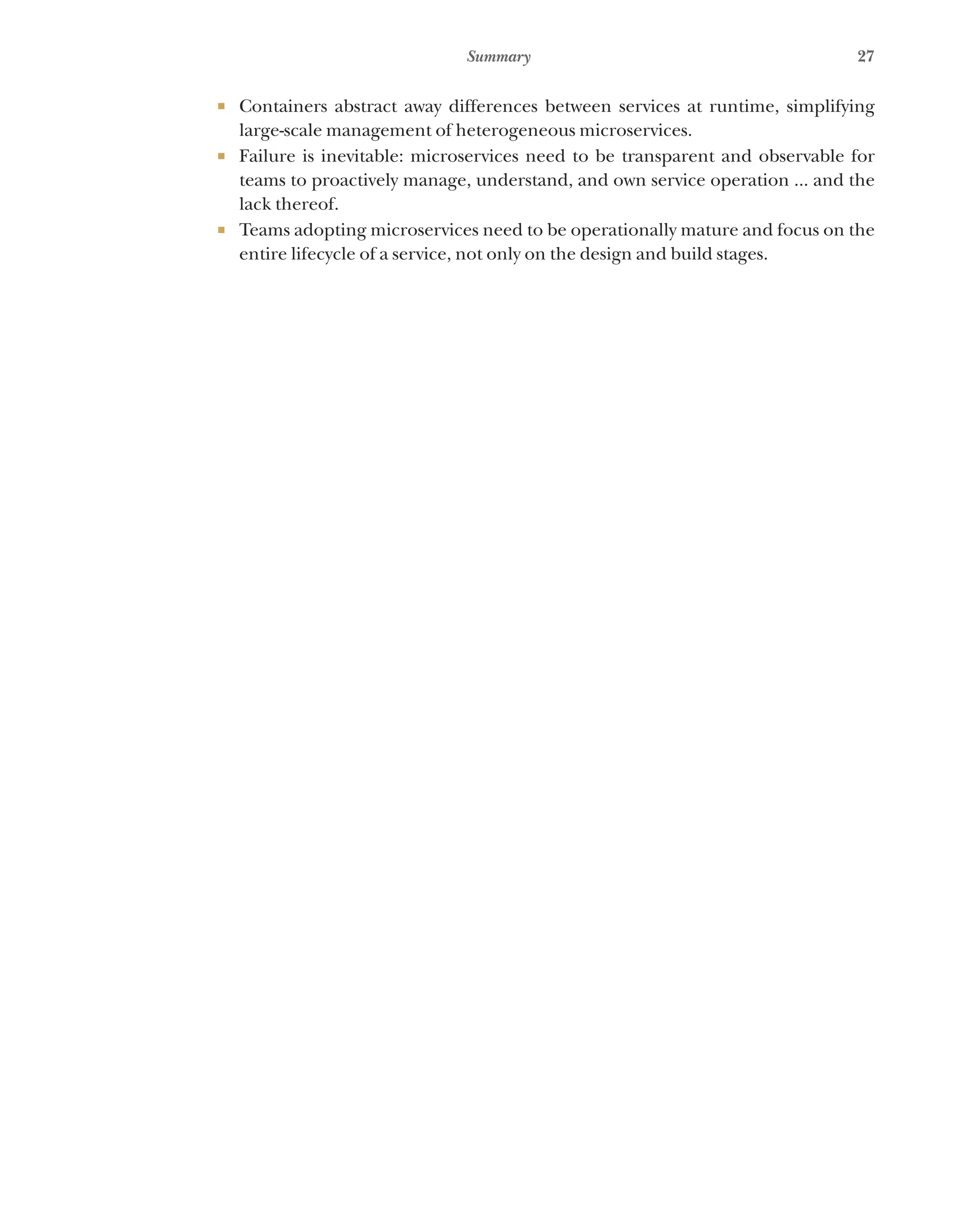
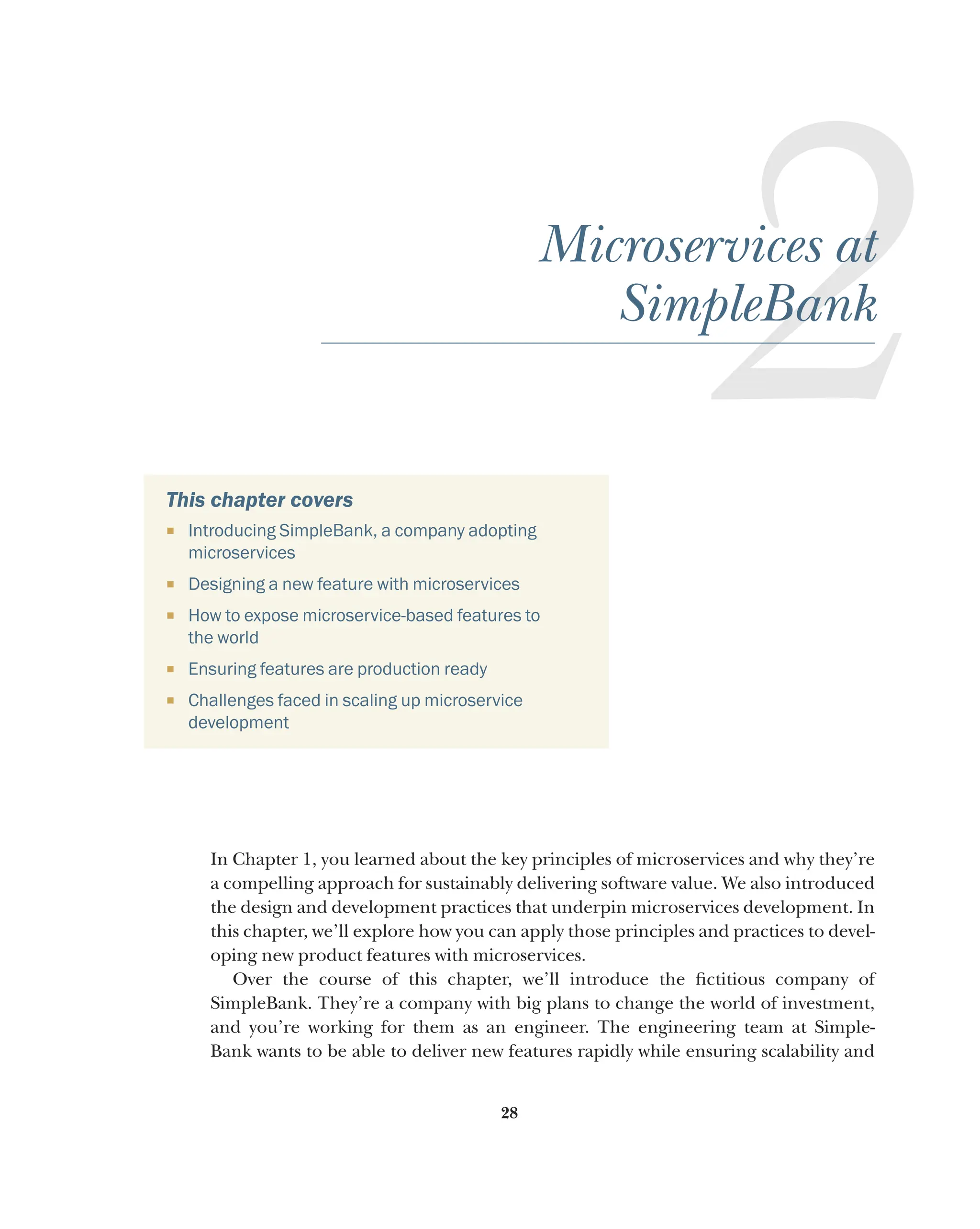
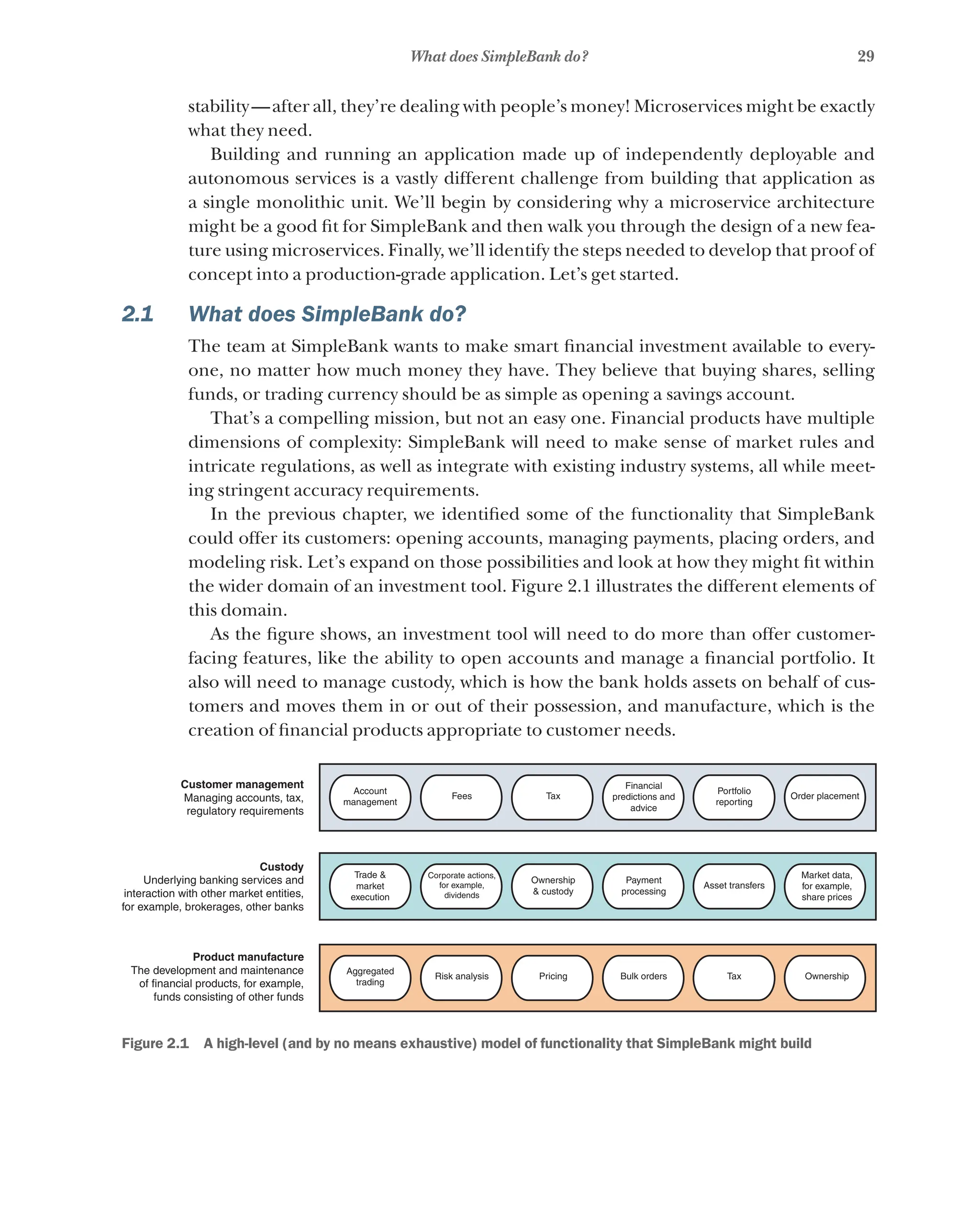
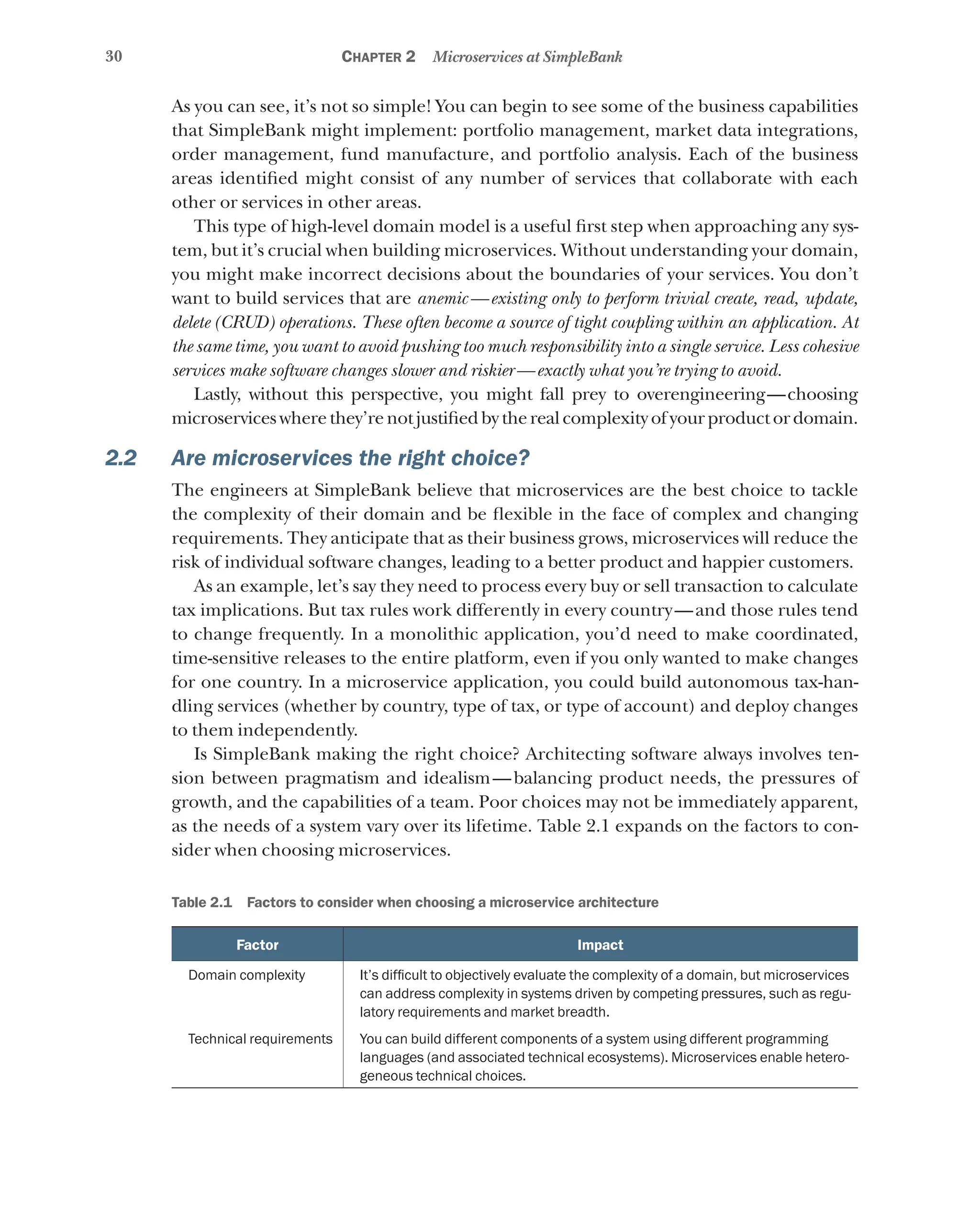
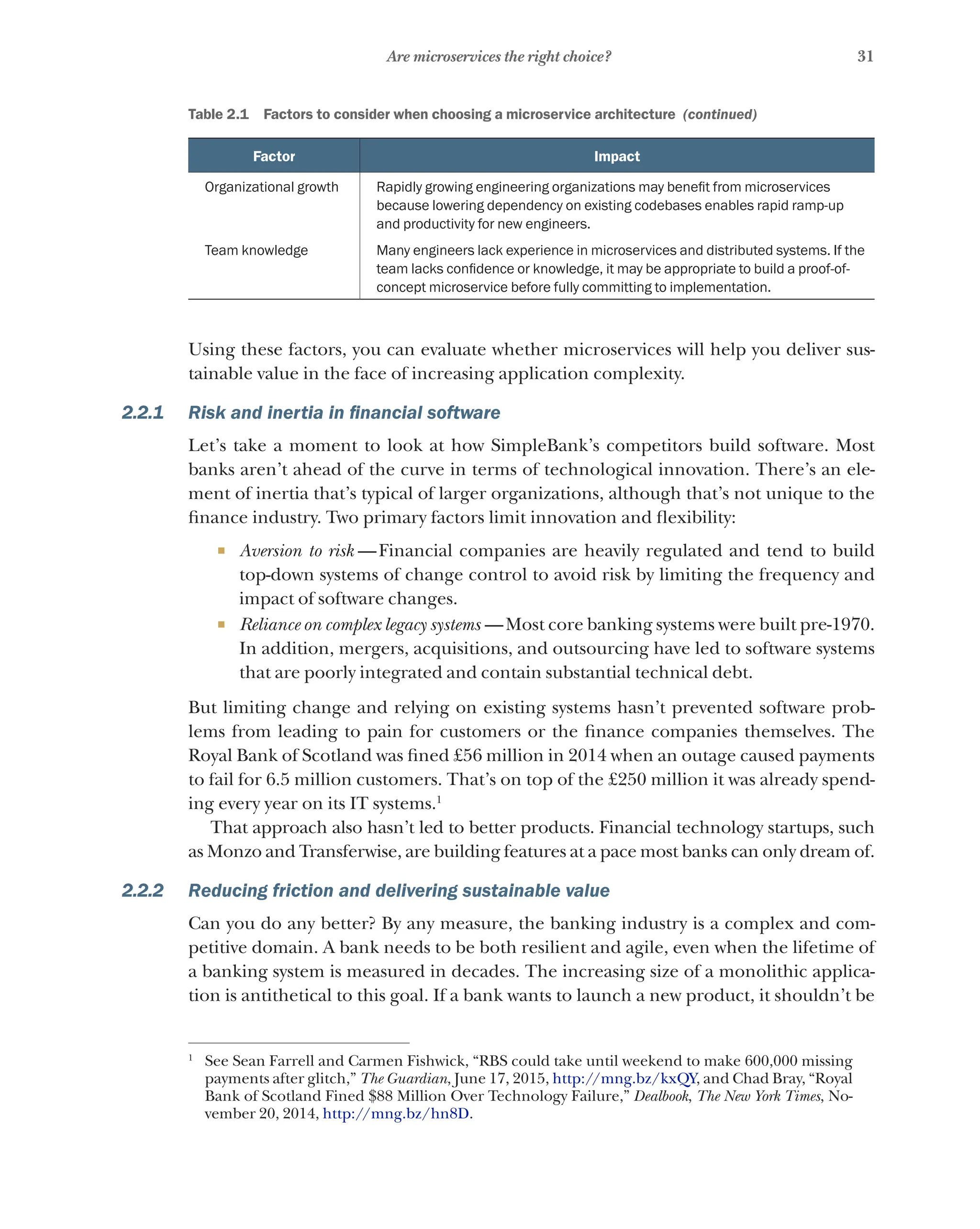
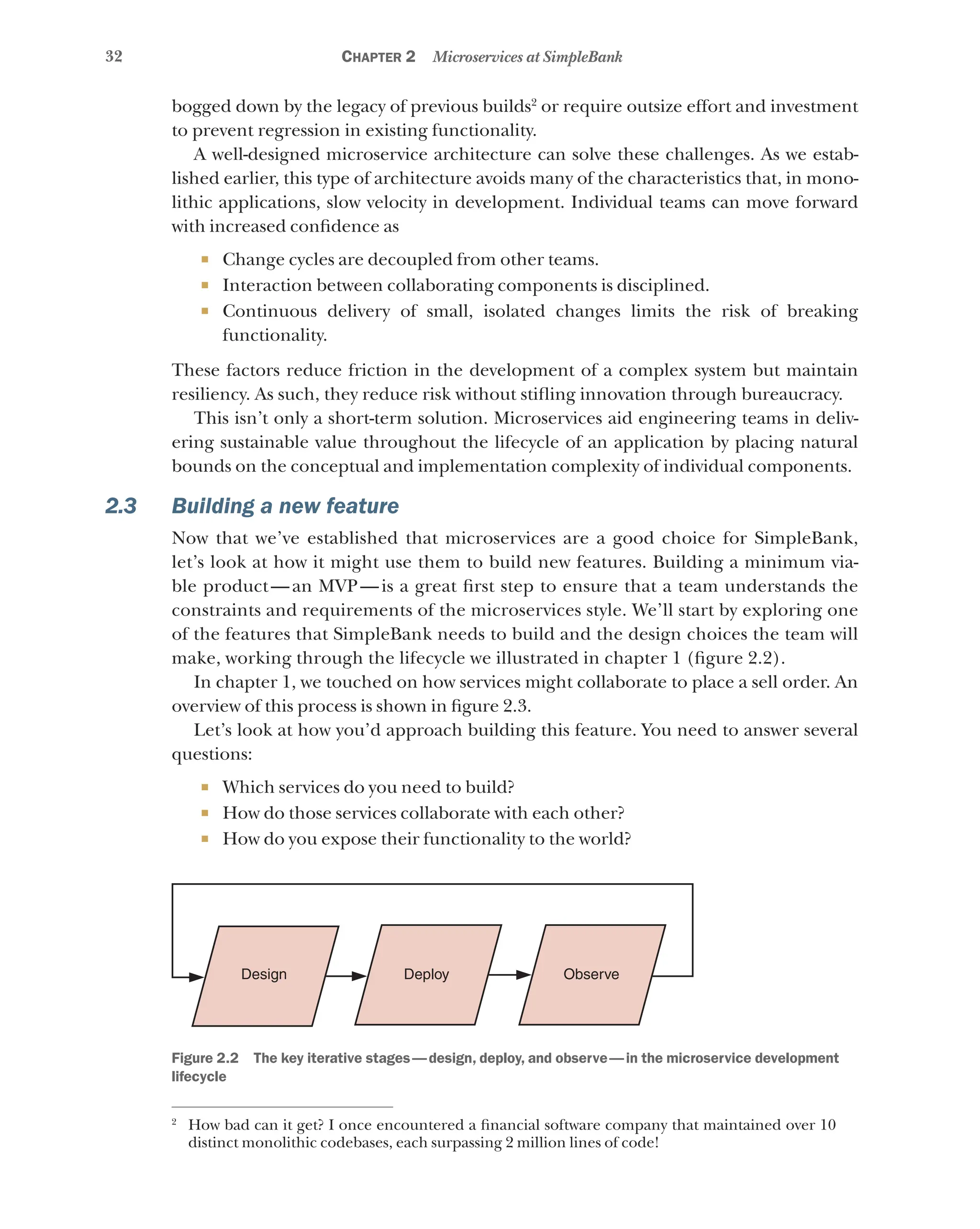
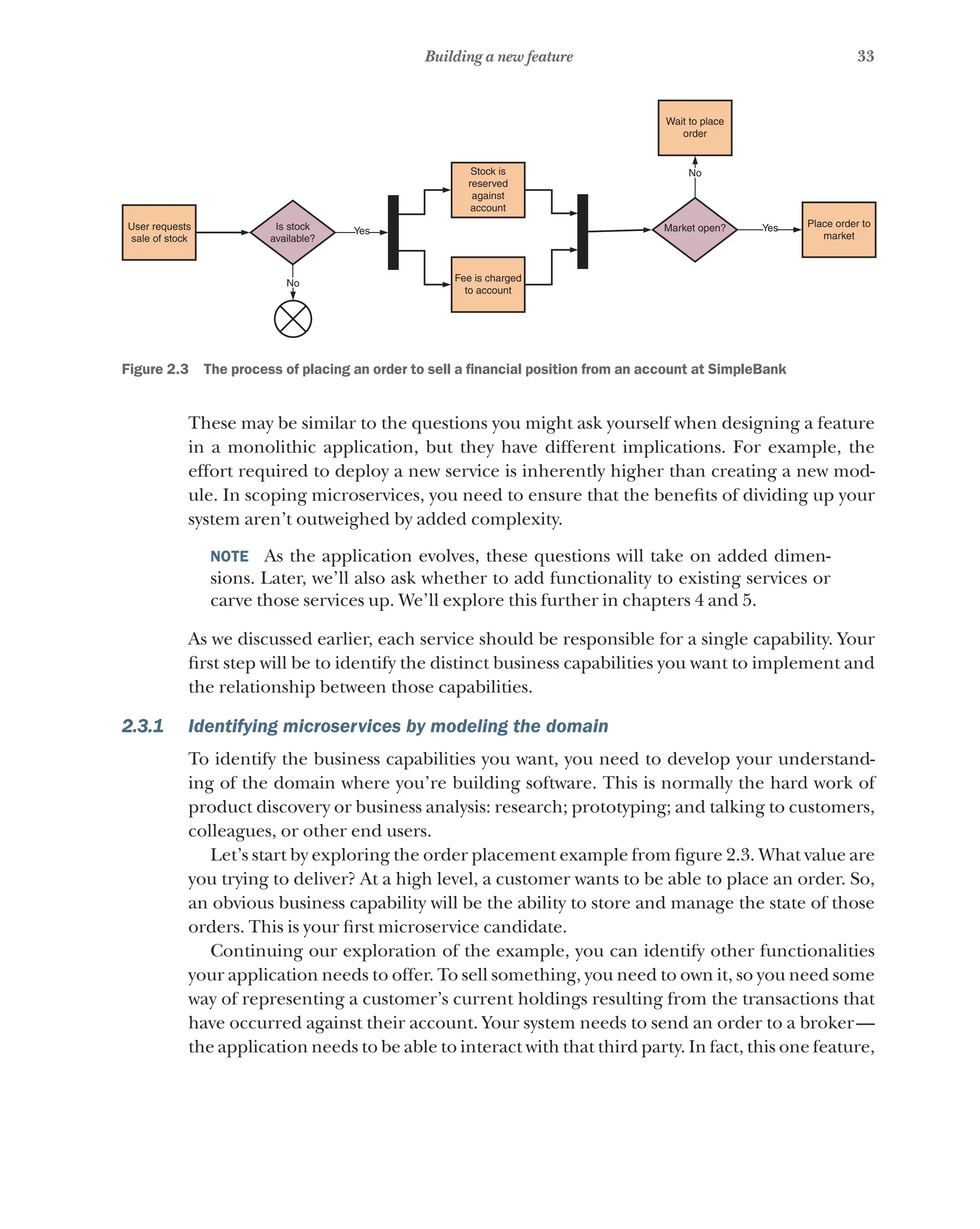
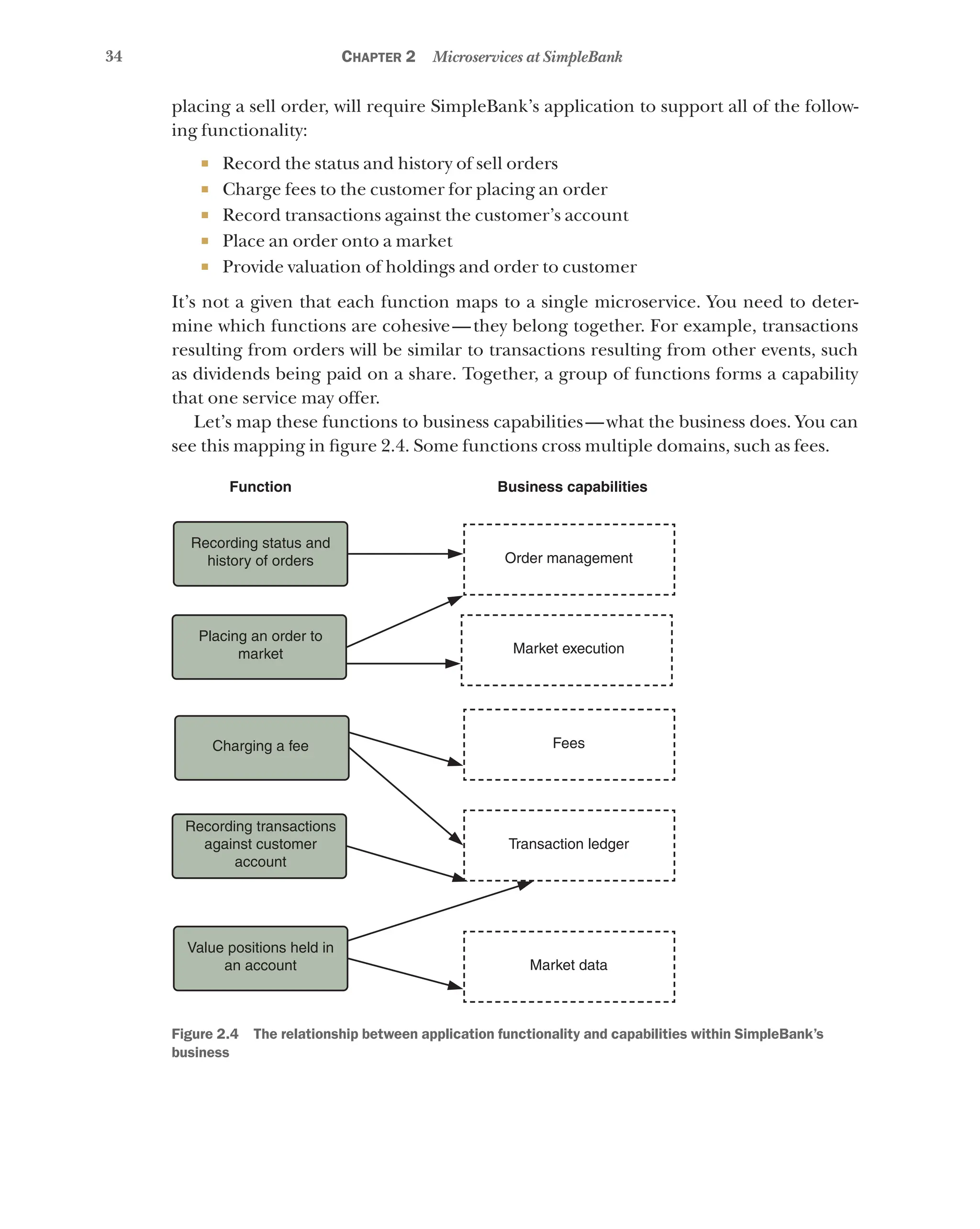
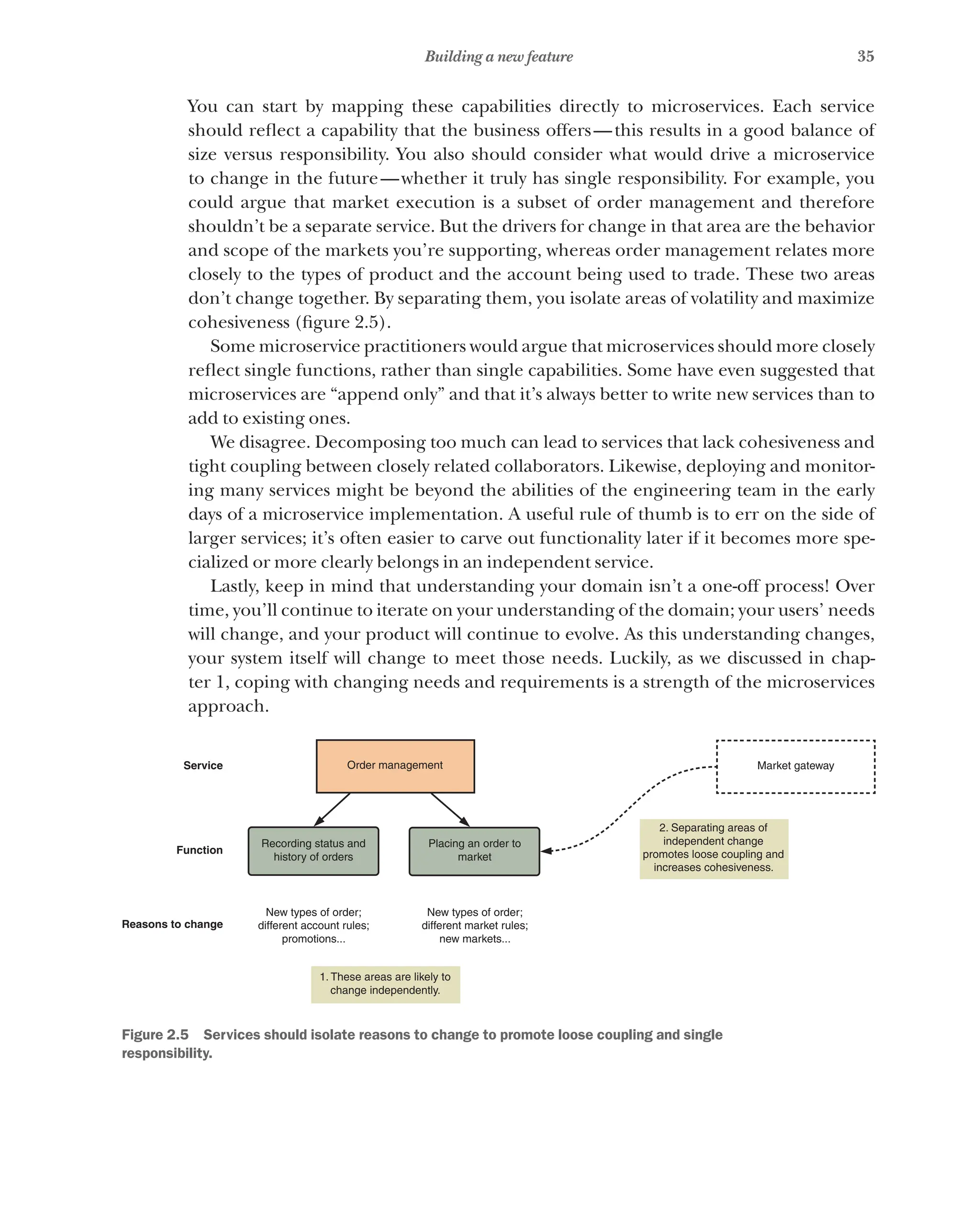

![37
Building a new feature
Earlier, we pointed out that microservices should be autonomous, and to achieve that, ser-
vices should be loosely coupled. You achieve this partly through the design of your services,
“[gathering] together the things that change for the same reasons” to minimize the chance
that changes to one service require changes to its upstream or downstream collaborators.
You also need to consider service contracts and service responsibility.
Service contracts
The messages that each service accepts, and the responses it returns, form a contract
between that service and the services that rely on it, which you can call upstream collabo-
rators. Contracts allow each service to be treated as a black box by its collaborators: you
send a request and you get something back. If that happens without errors, the service
is doing what it’s meant to do.
Although the implementation of a service may change over time, maintaining
contract-level compatibility ensures two things:
1 Those changes are less likely to break consumers.
2 Dependencies between services are explicitly identifiable and manageable.
In our experience, contracts are often implicit in naïve or early microservice imple-
mentations; they’re suggested by documentation and practice, rather than explicitly
codified. As the number of services grows, you can realize significant benefit from stan-
dardizing the interfaces between them in a machine-readable format. For example,
REST APIs may use Swagger/OpenAPI. As well as aiding the conformance testing of
individual services, publishing standardized contracts will help engineers within an
organization understand how to use available services.
Service responsibility
You can see in figure 2.6 that the orders service has a lot of responsibility. It directly
orchestrates the actions of every other service involved in the process of placing an
order. This is conceptually simple, but it has downsides. At worst, our other services
become anemic, with many dumb services controlled by a small number of smart ser-
vices, and those smart services grow larger
This approach can lead to tighter coupling. If you want to introduce a new part of this
process—let’s say you want to notify a customer’s account manager when a large order
is placed—you’re forced to deploy new changes to the orders service. This increases
the cost of change. In theory, if the orders service doesn’t need to synchronously con-
firm the result of an action—only that it’s received a request—then it shouldn’t need
to have any knowledge of those downstream actions.
2.3.3 Service choreography
Within a microservice application, services will naturally have differing levels of responsi-
bility. But you should balance orchestration with choreography. In a choreographed system,
a service doesn’t need to directly command and trigger actions in other services. Instead,
each service owns specific responsibilities, which it performs in reaction to other events.](https://image.slidesharecdn.com/microservicesinaction-240113230140-1bc300cc/75/microservices-in-action-pdf-64-2048.jpg)
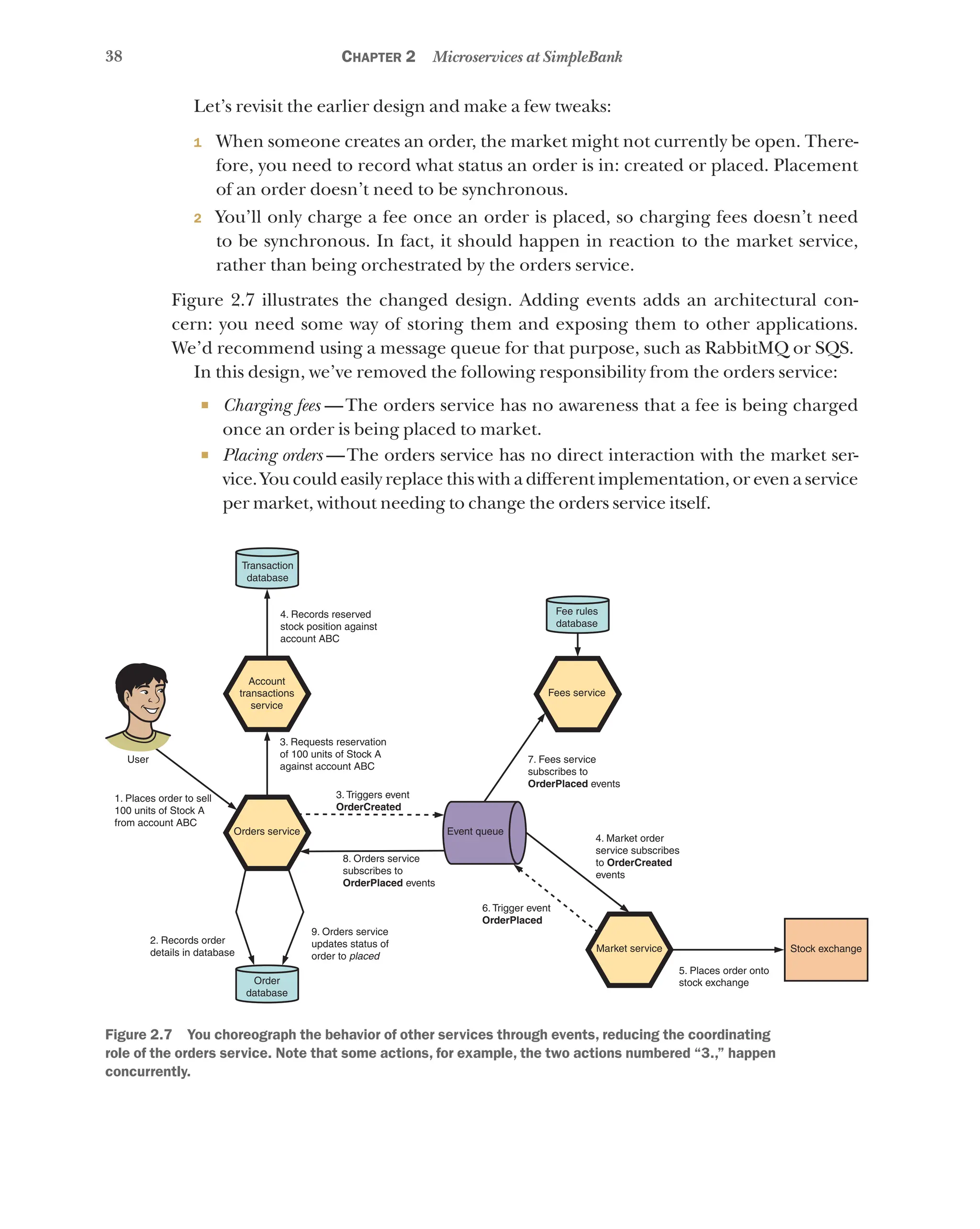
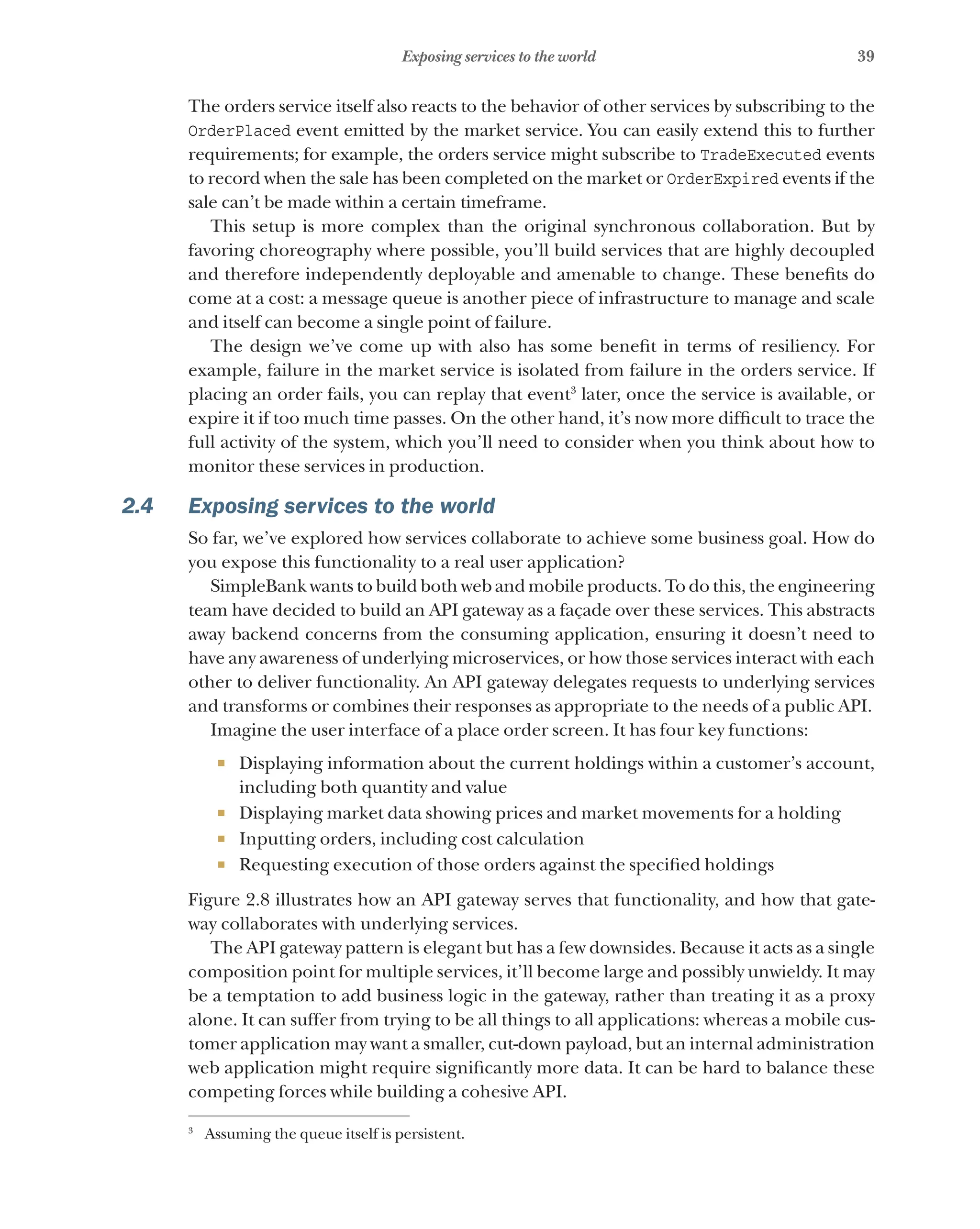
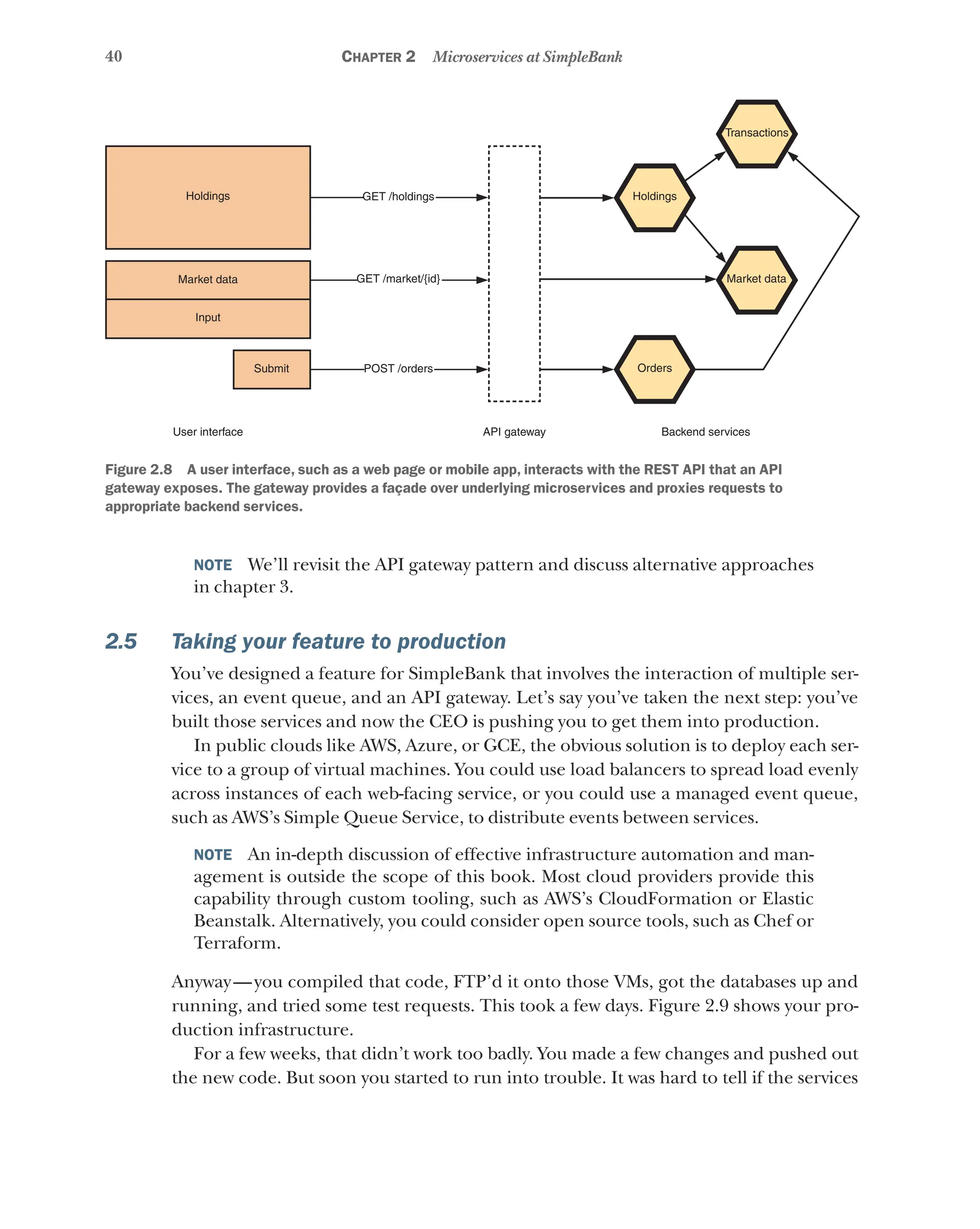
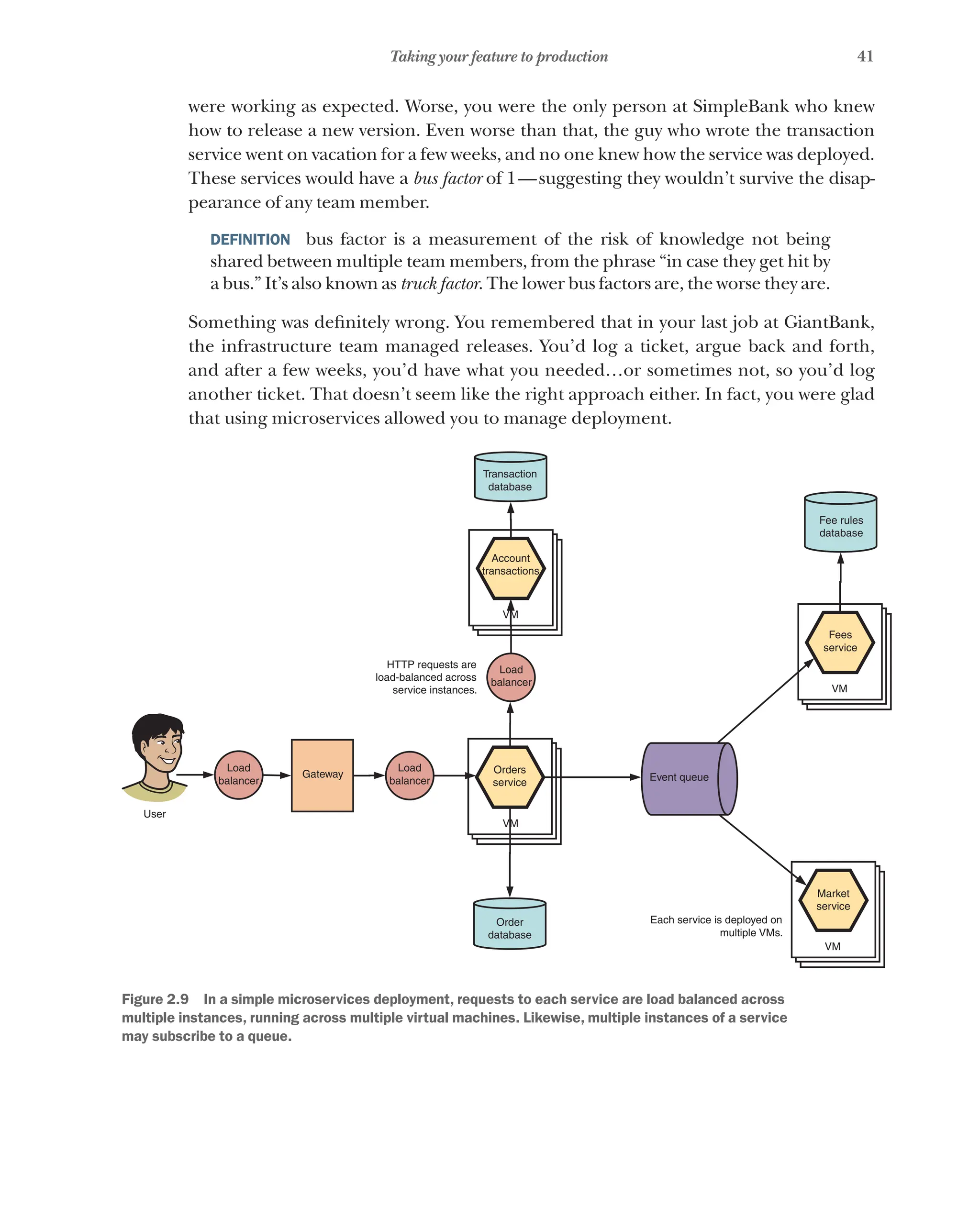
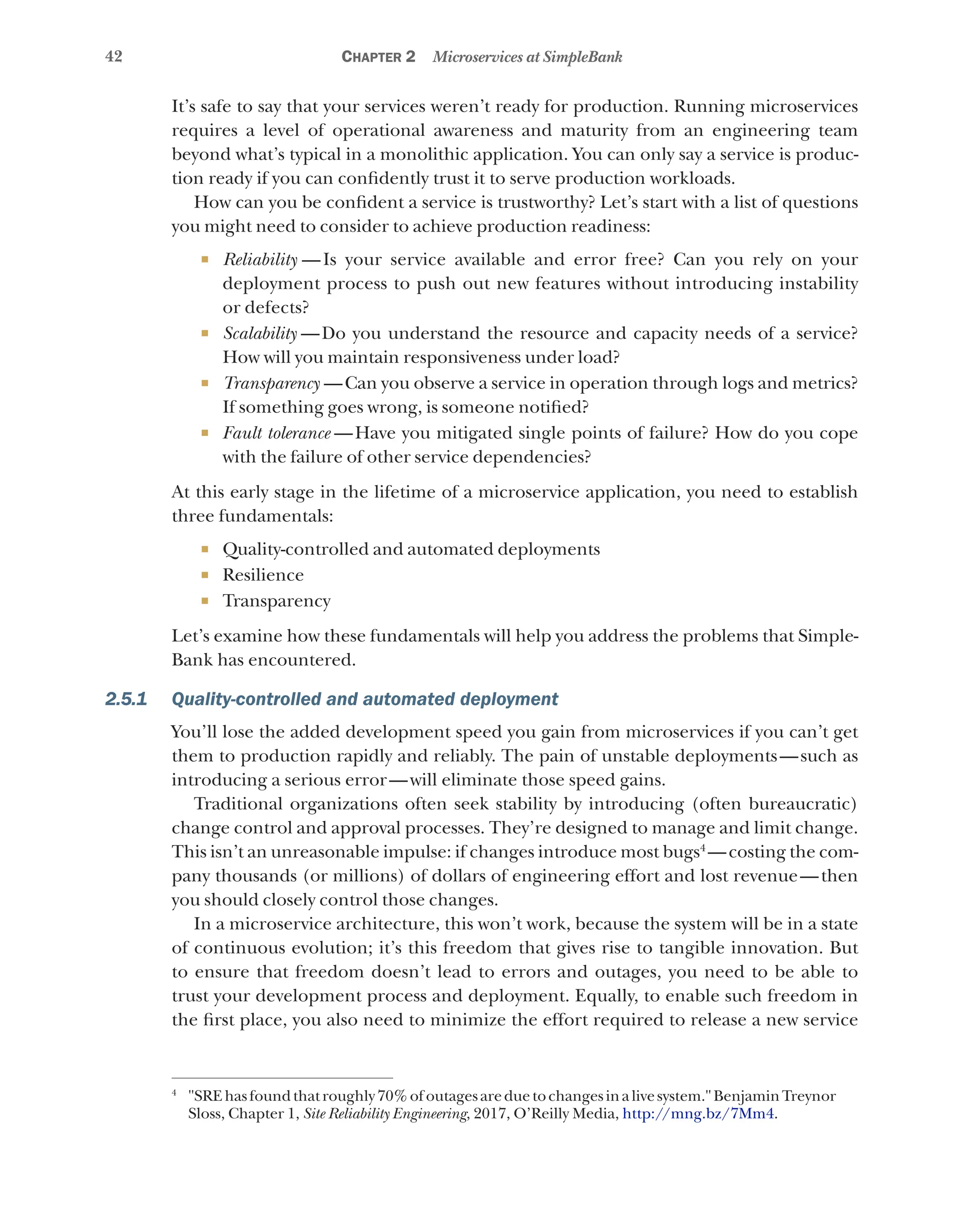
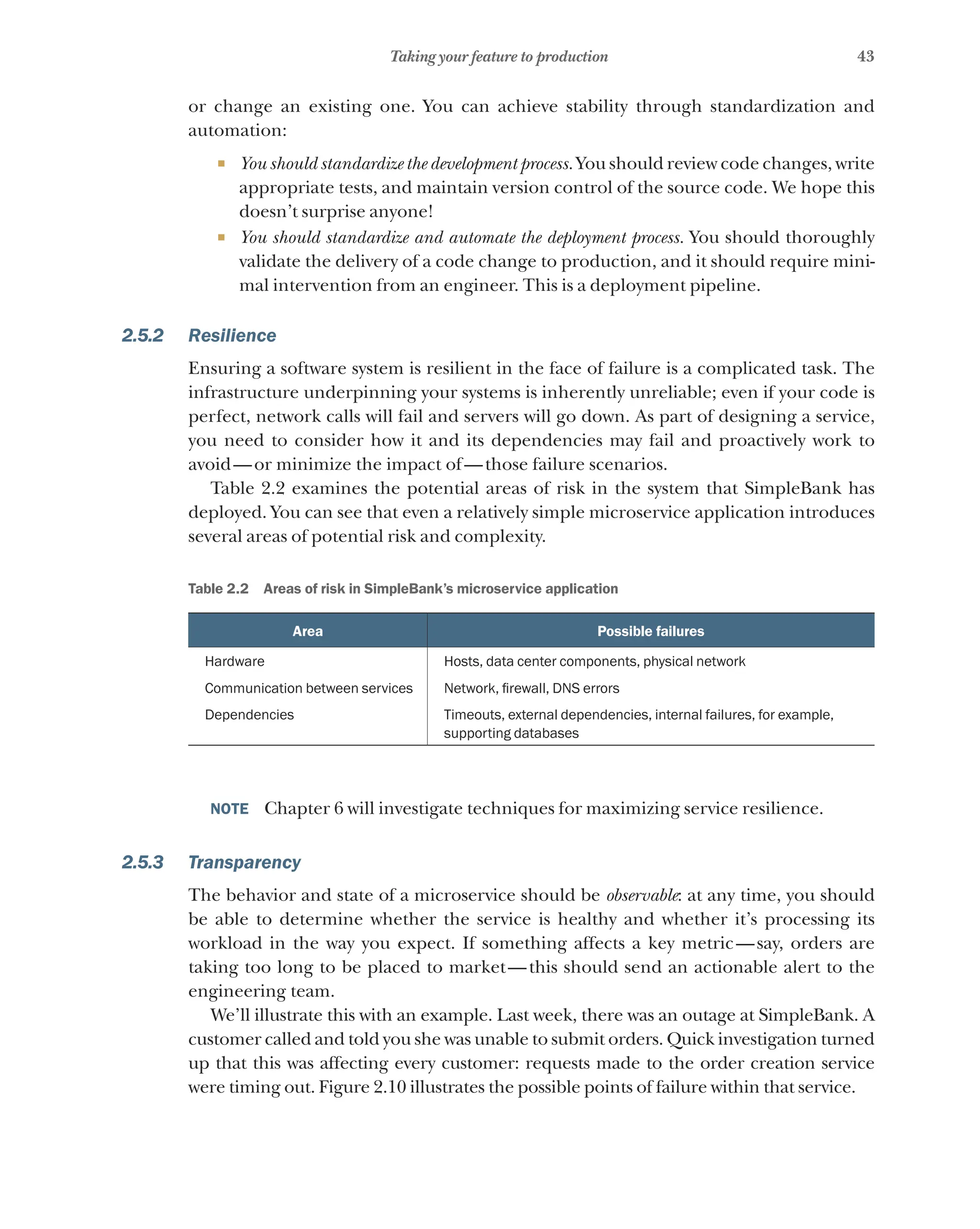
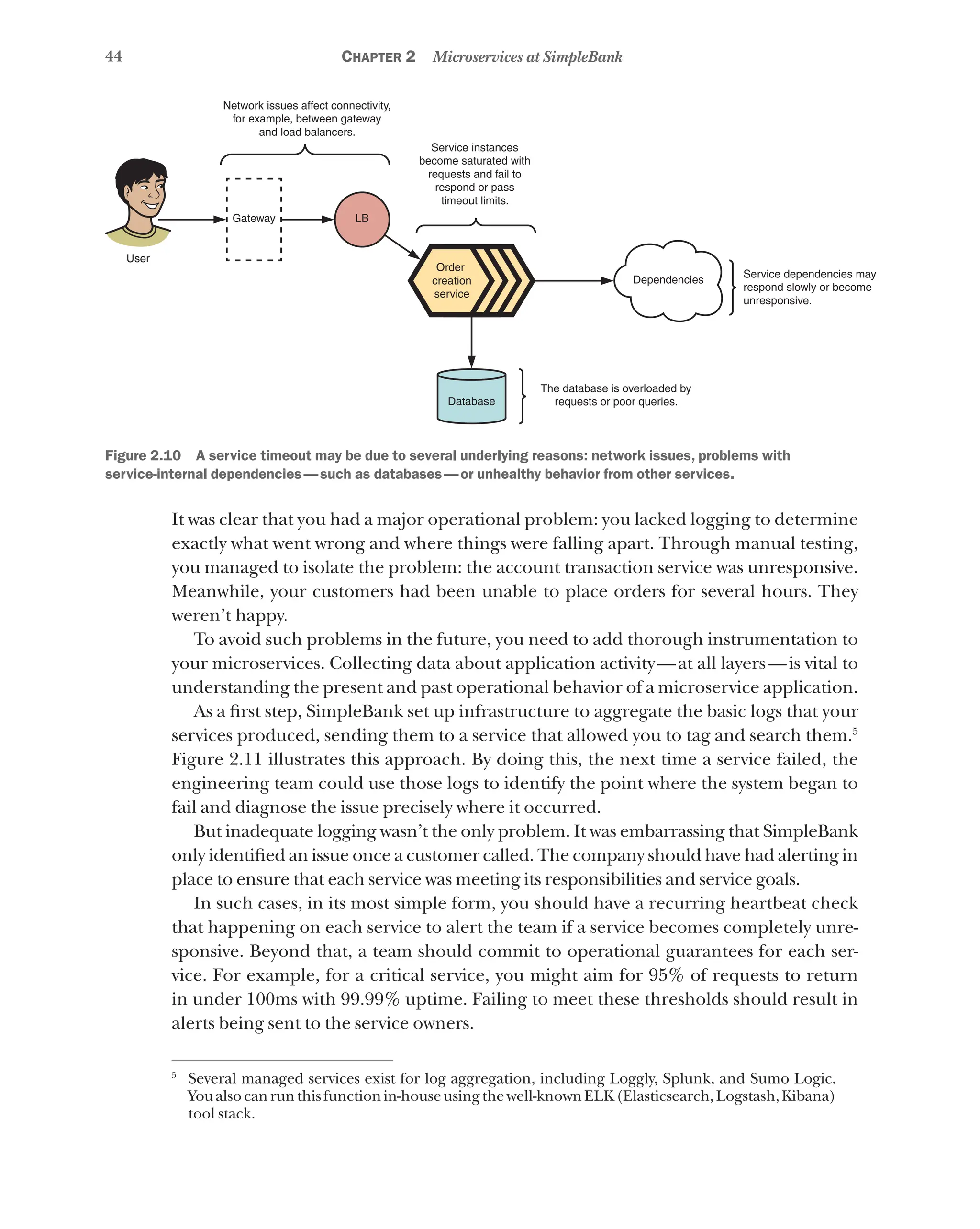
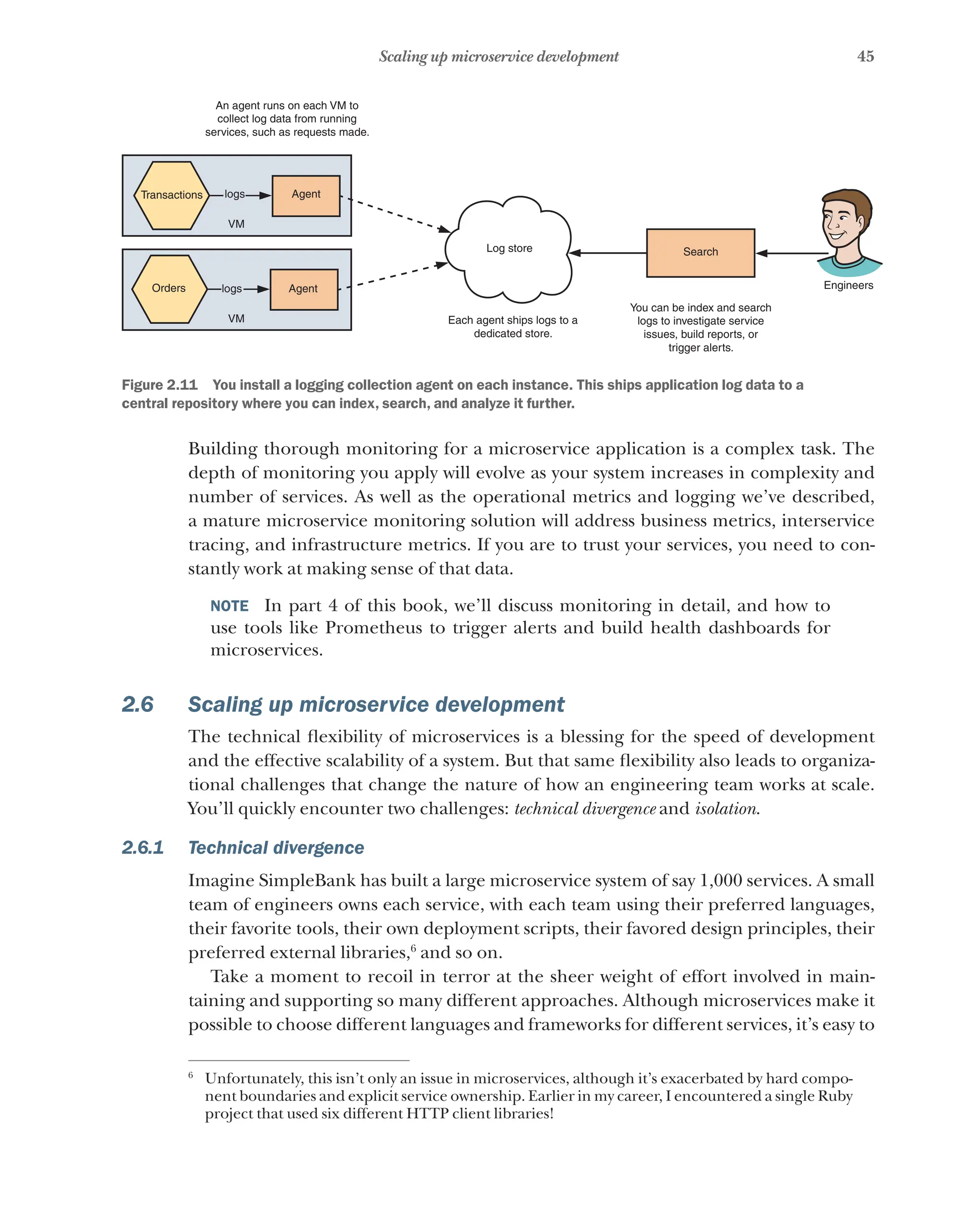
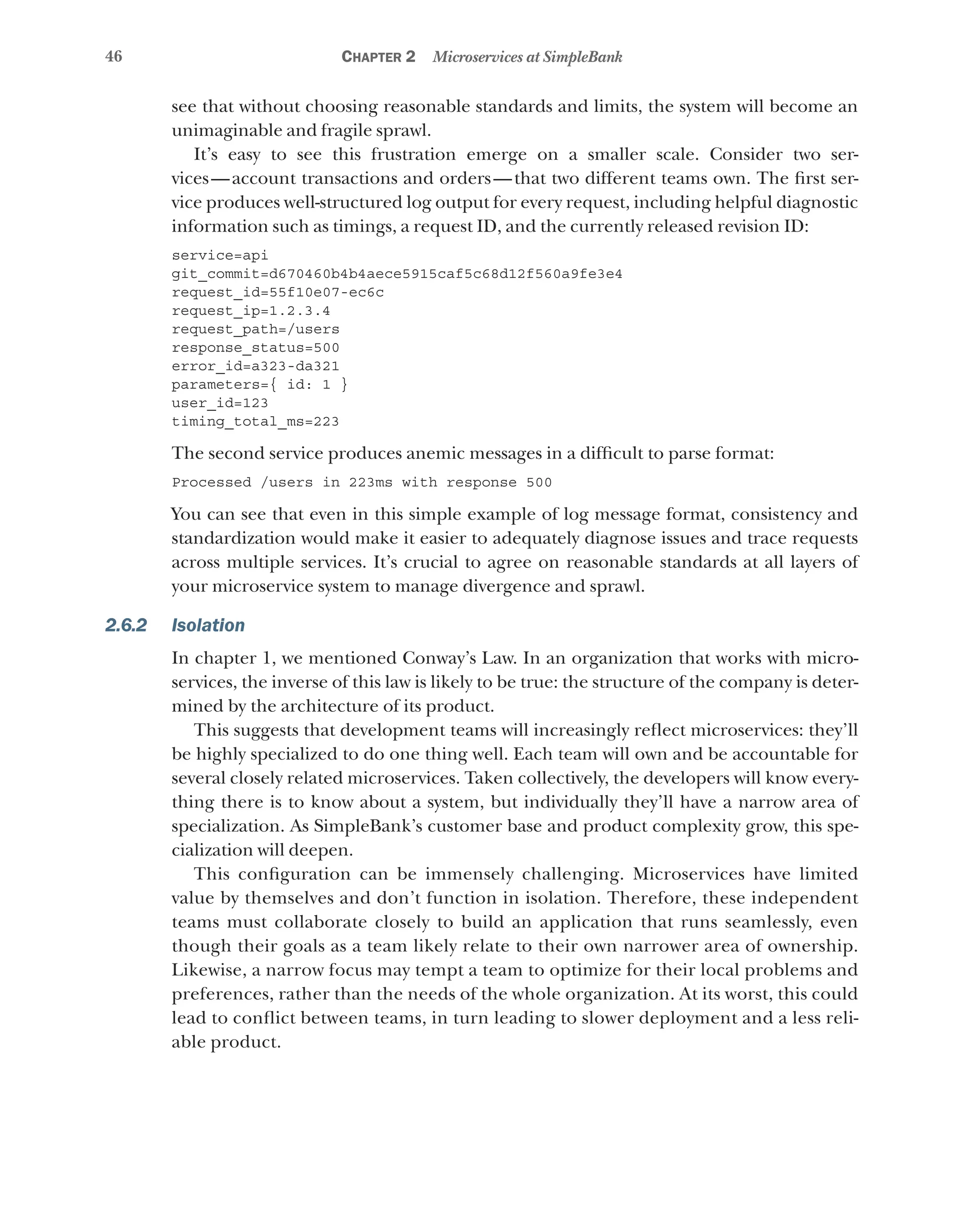
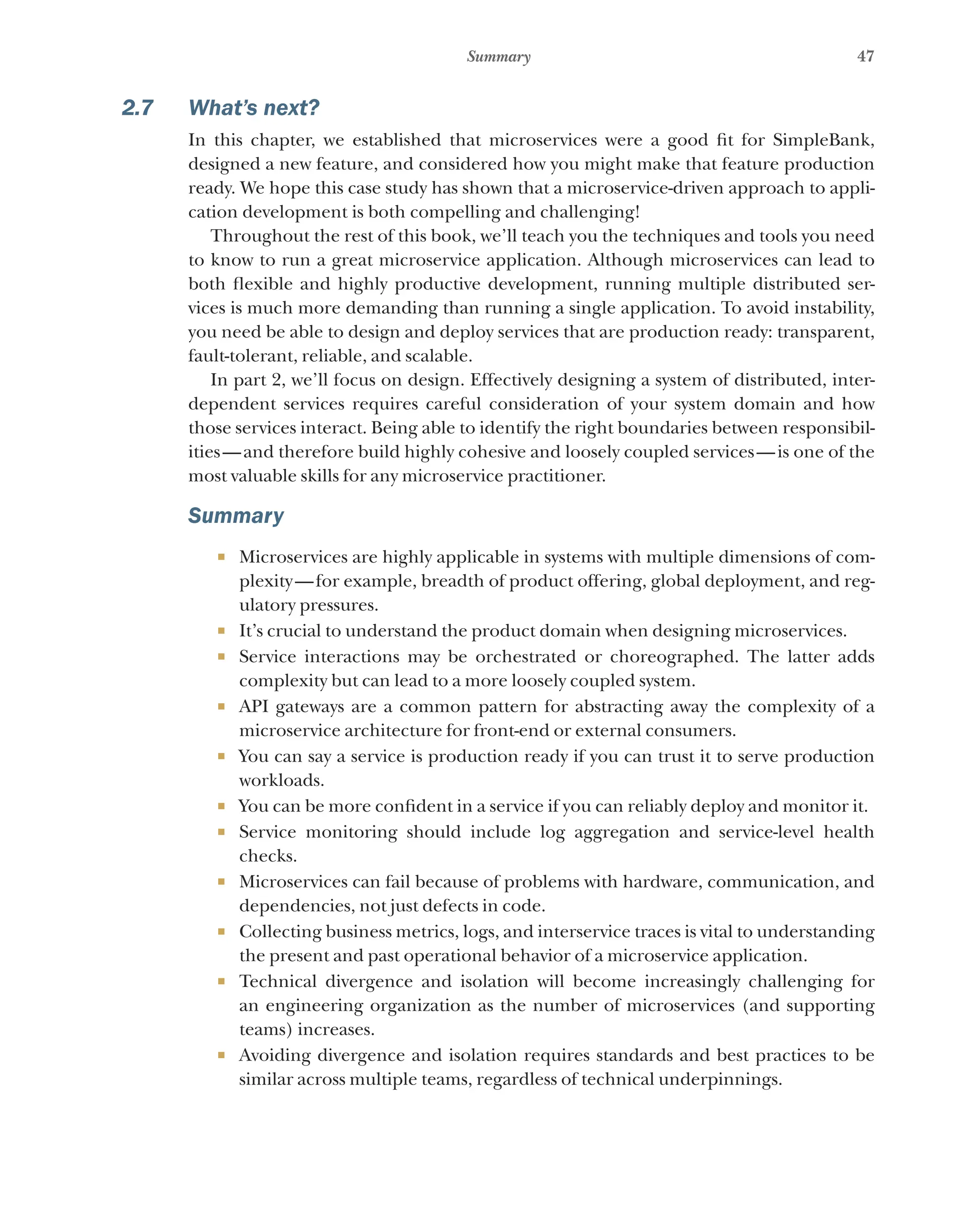



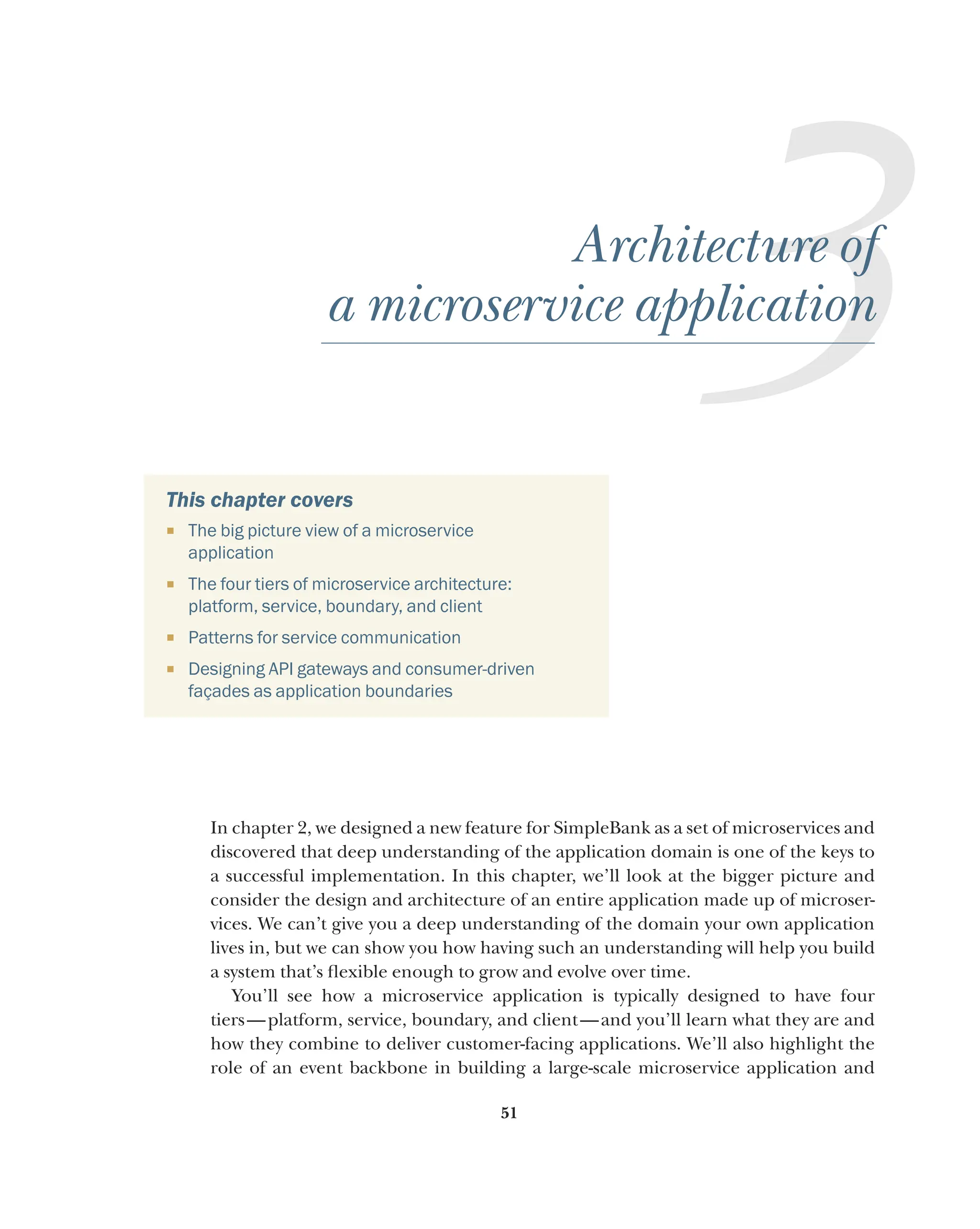

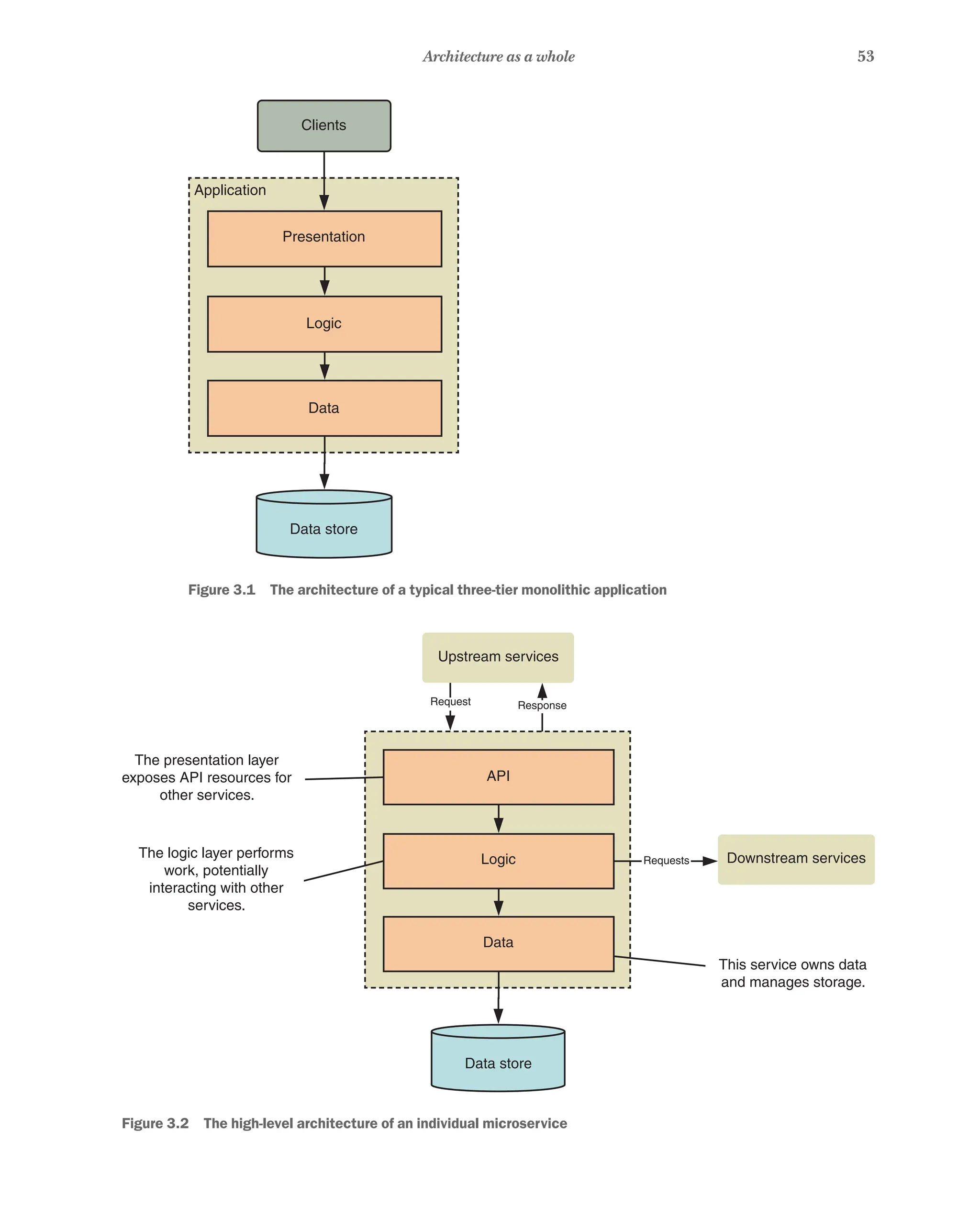
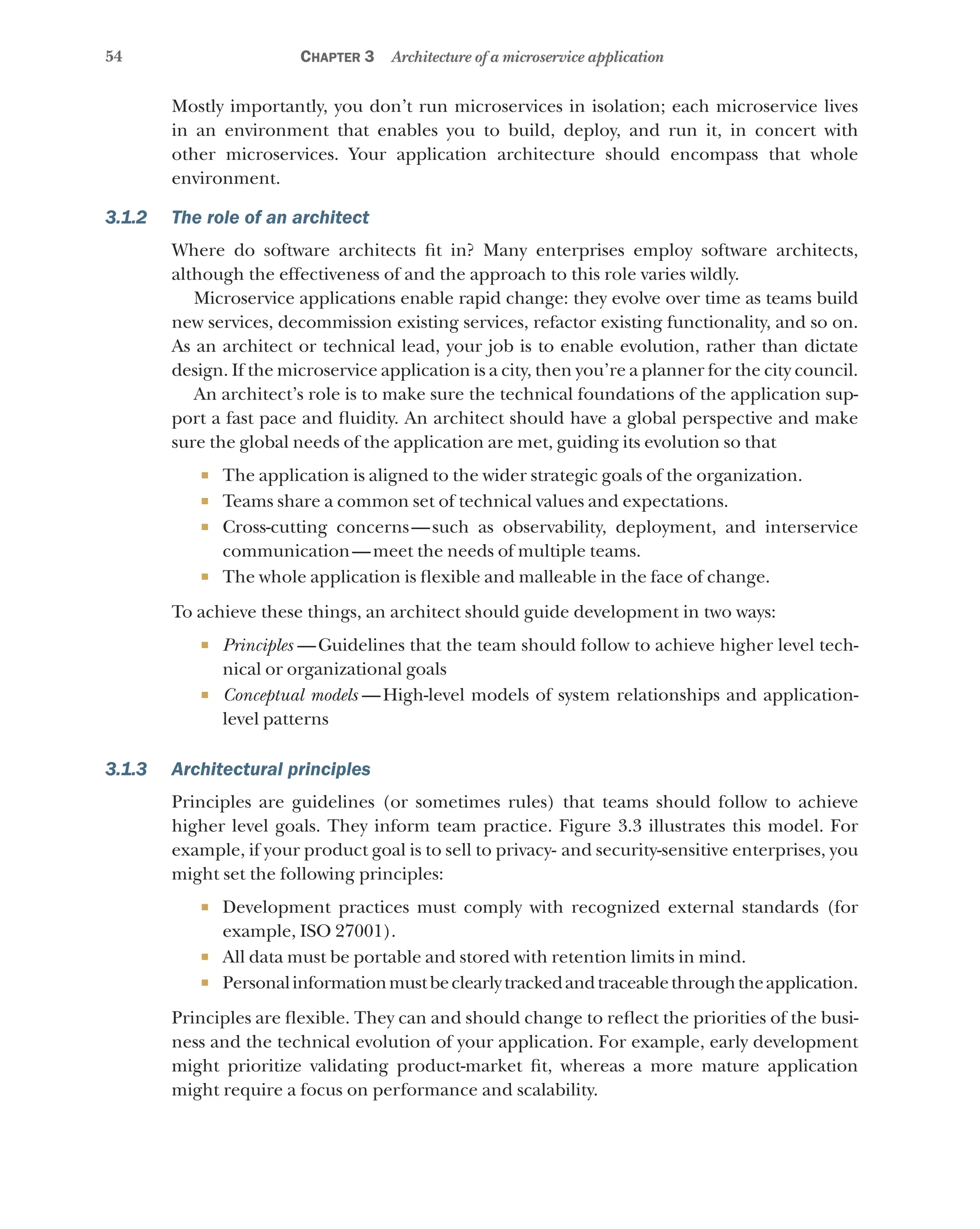
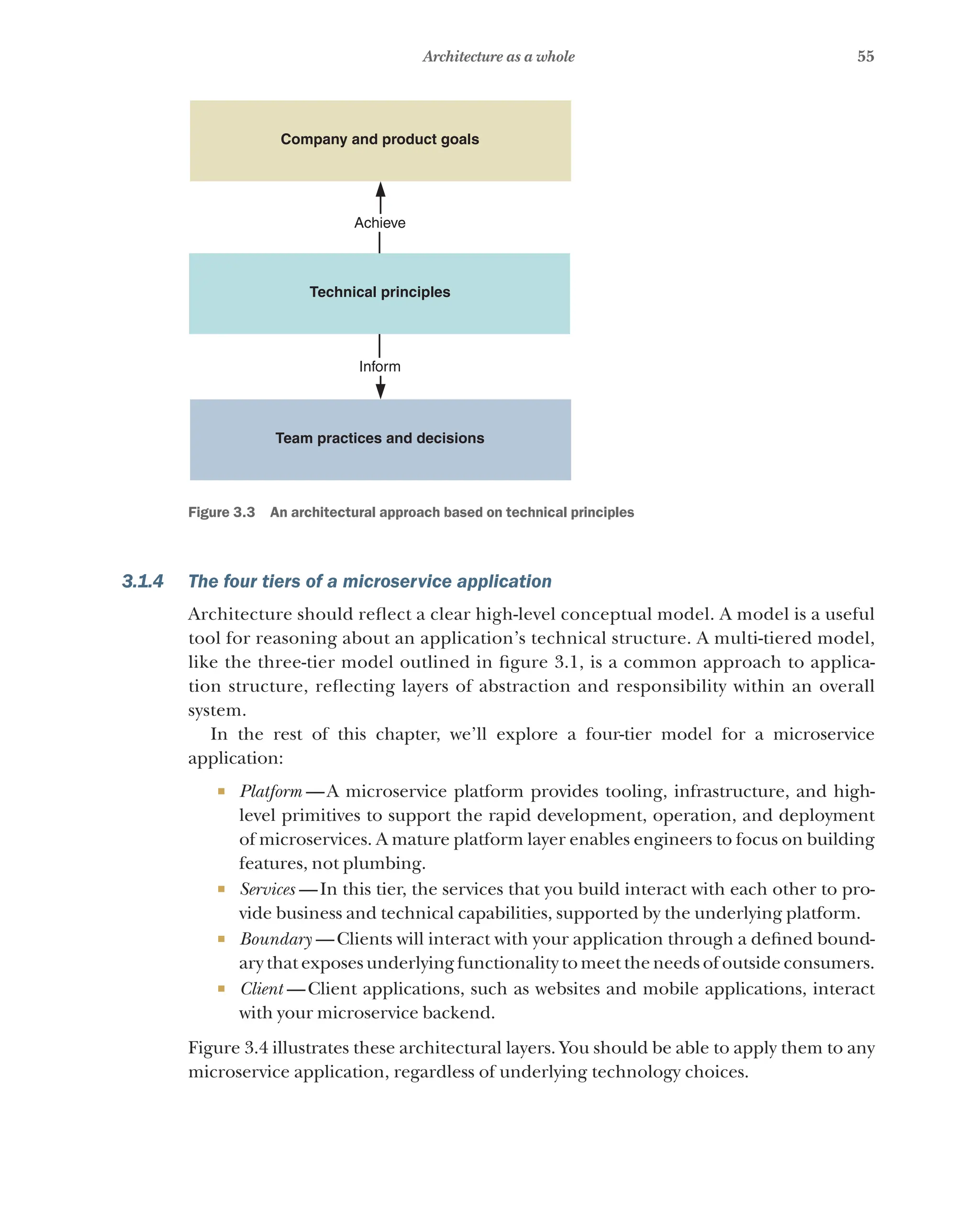
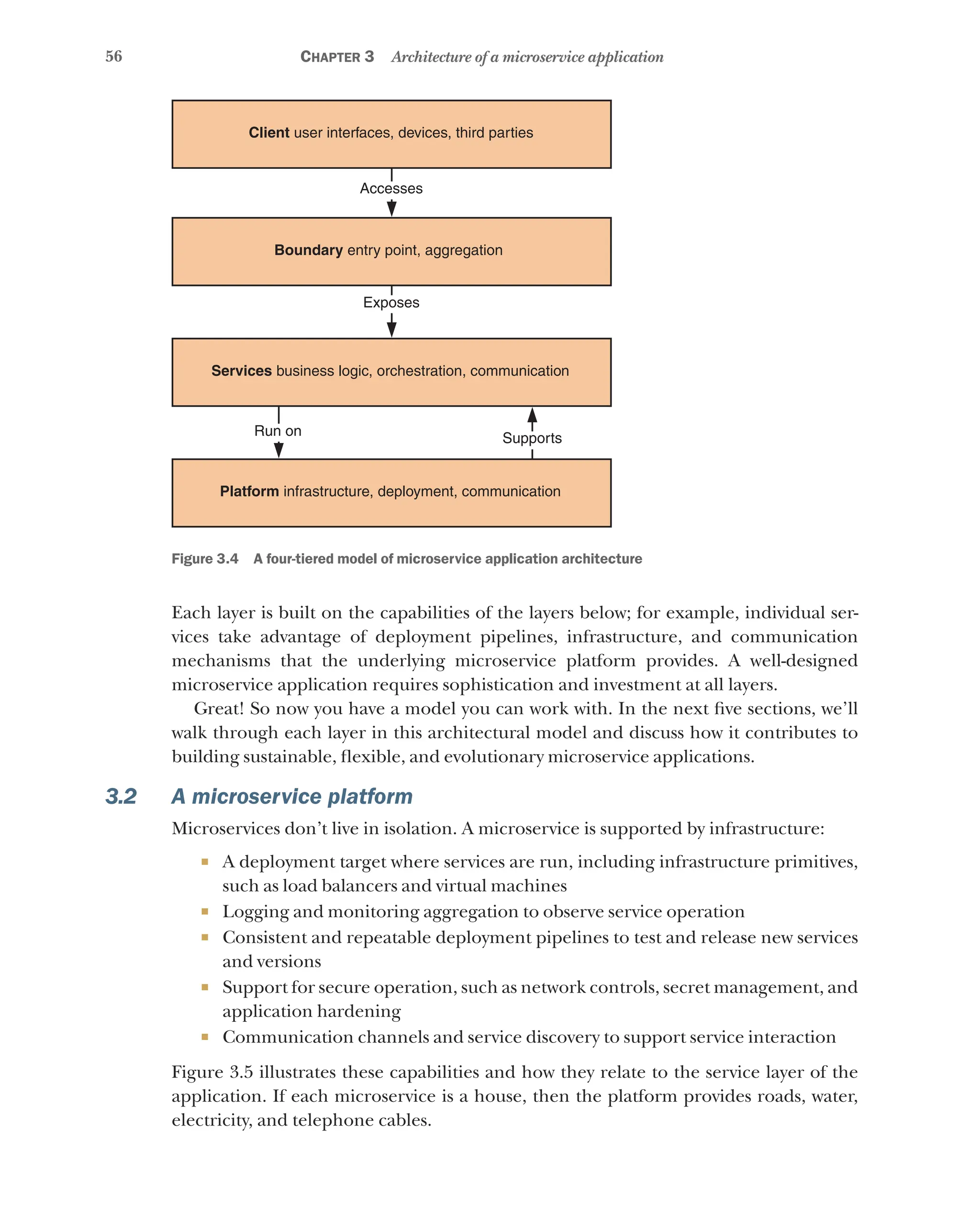
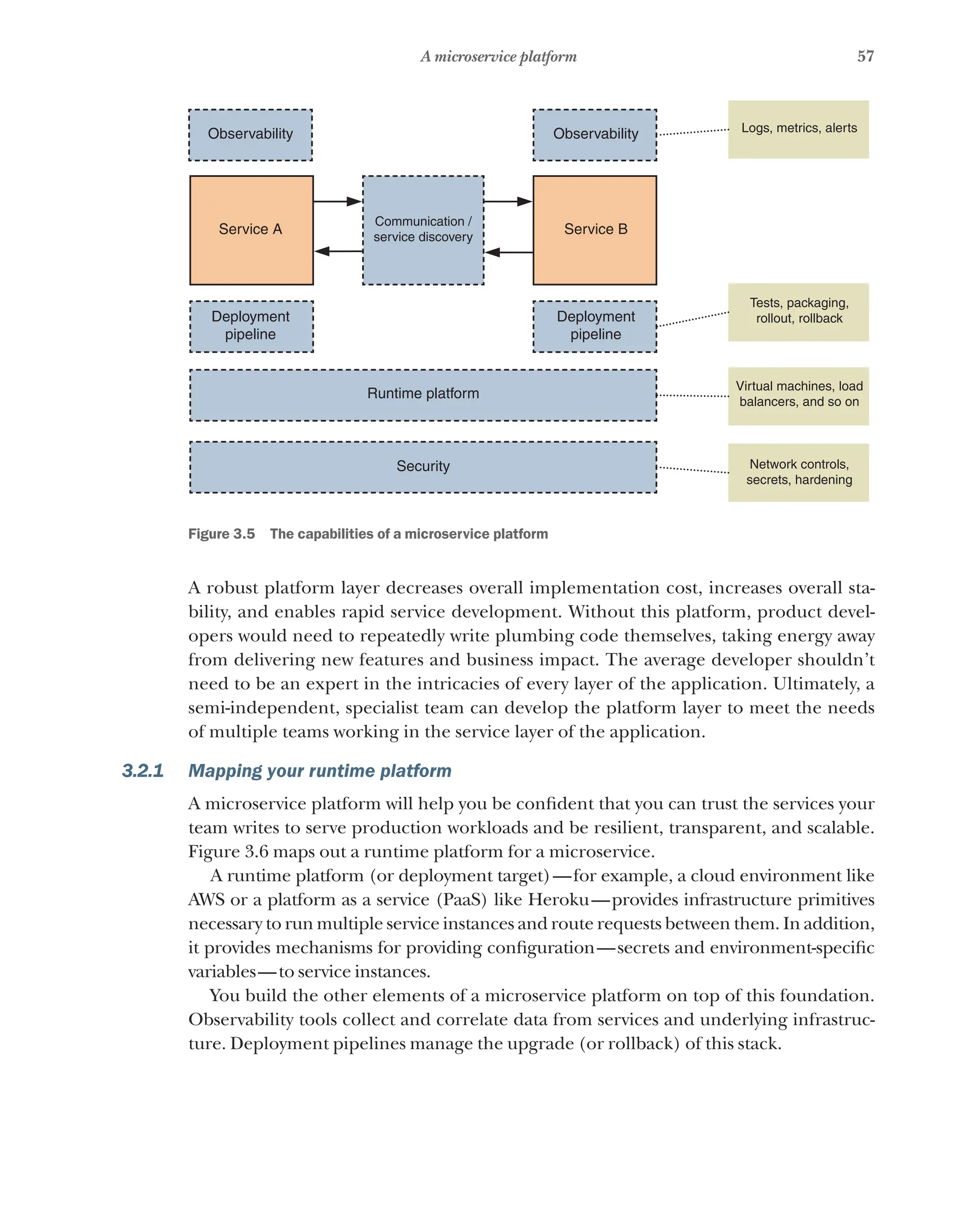

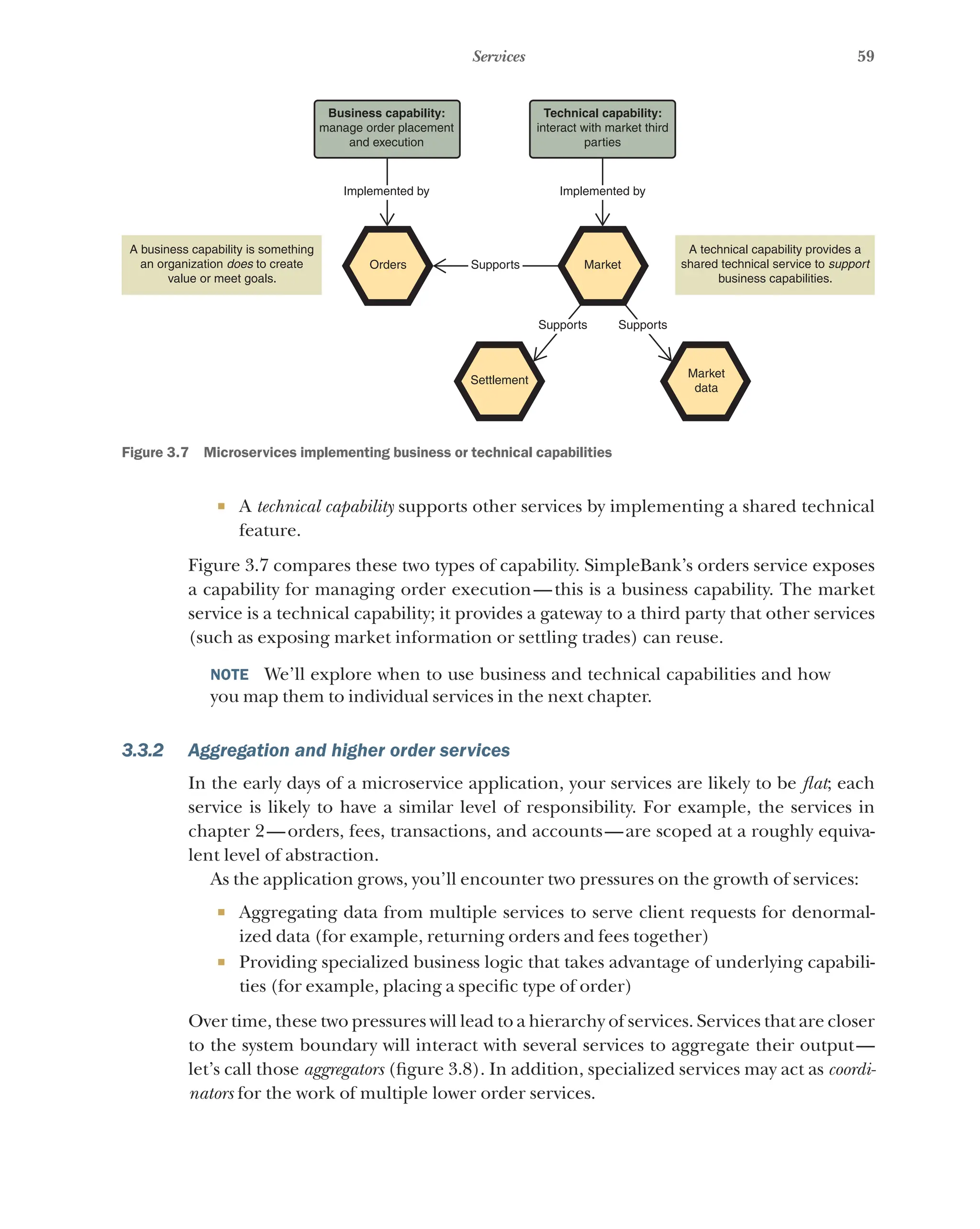
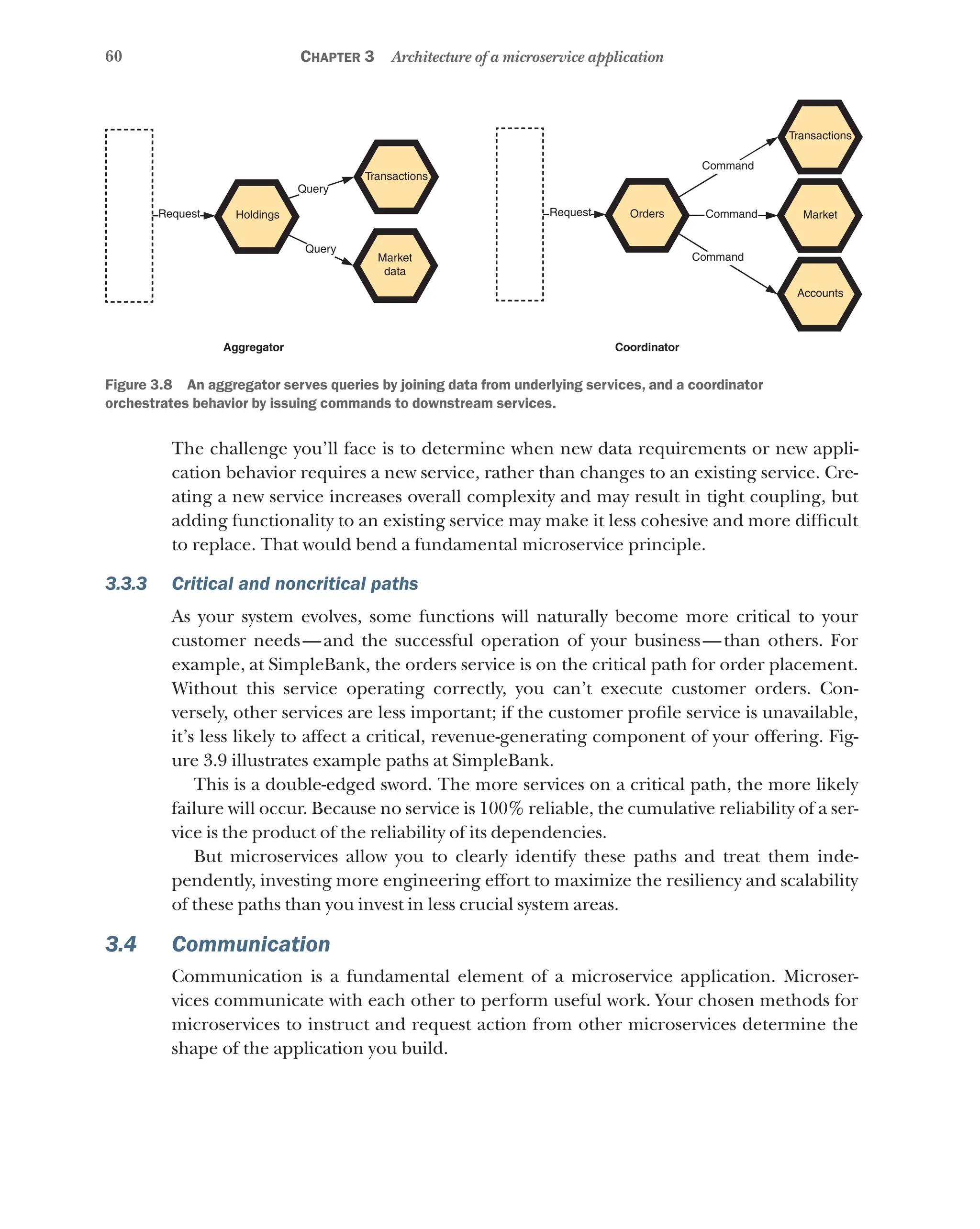
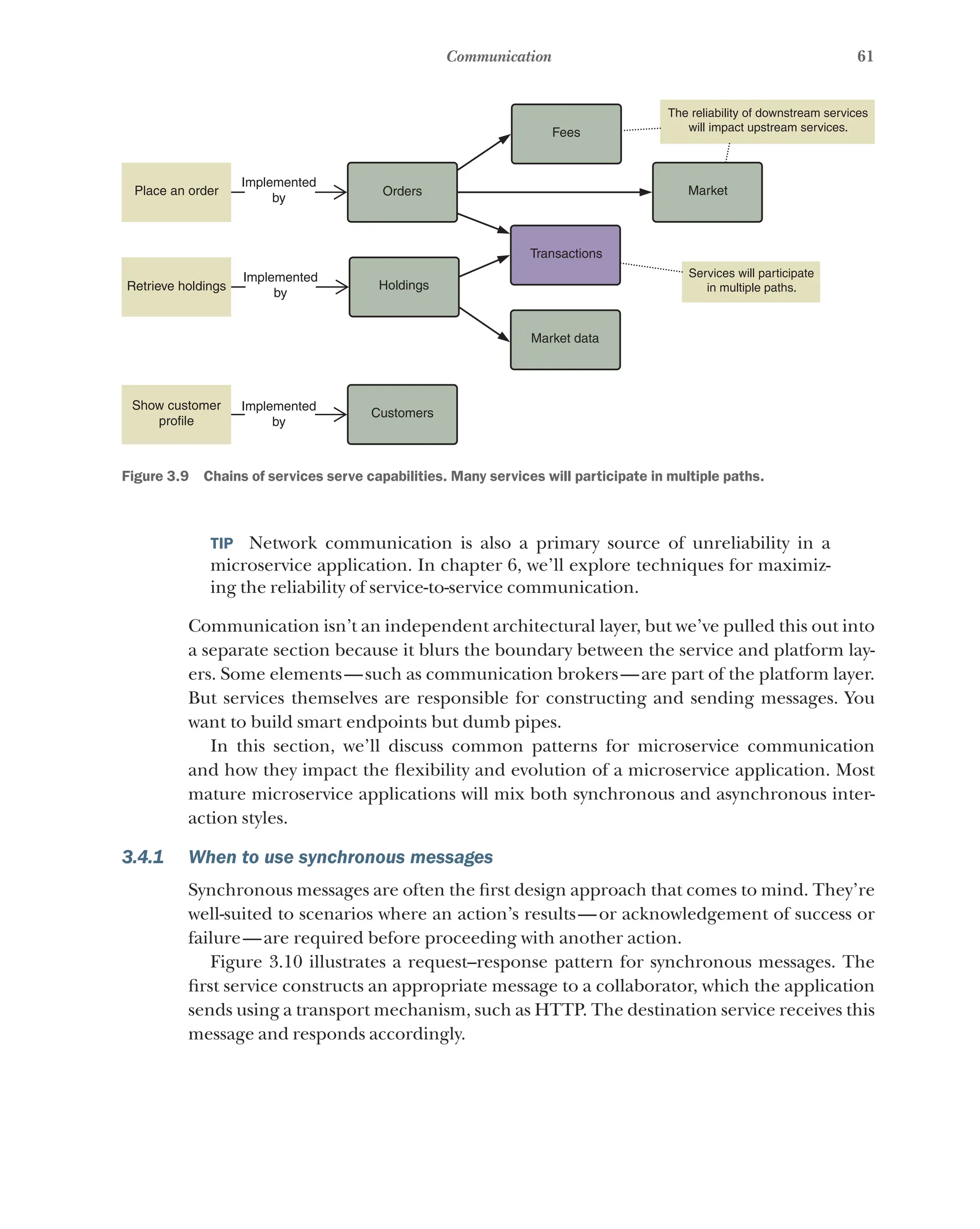

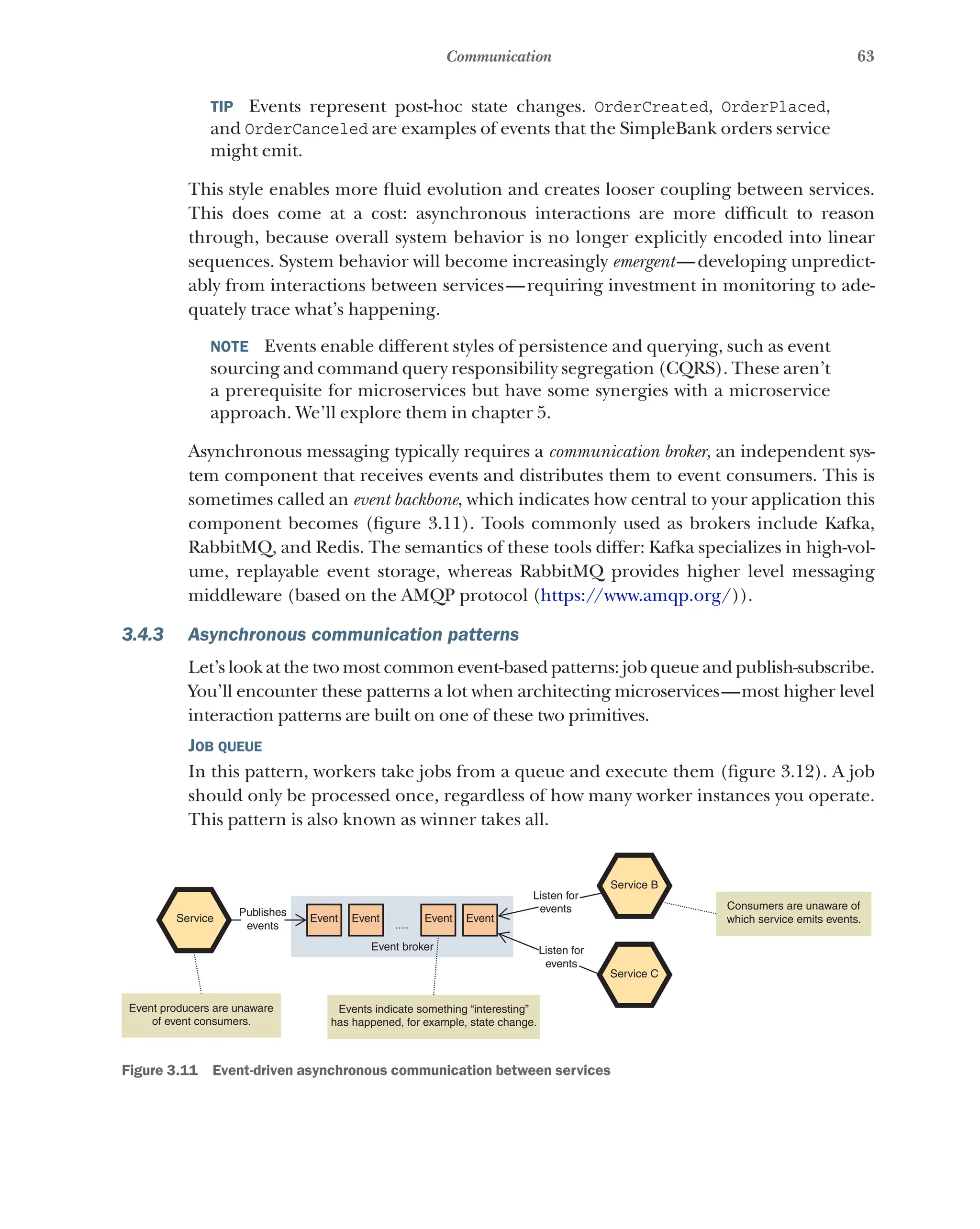
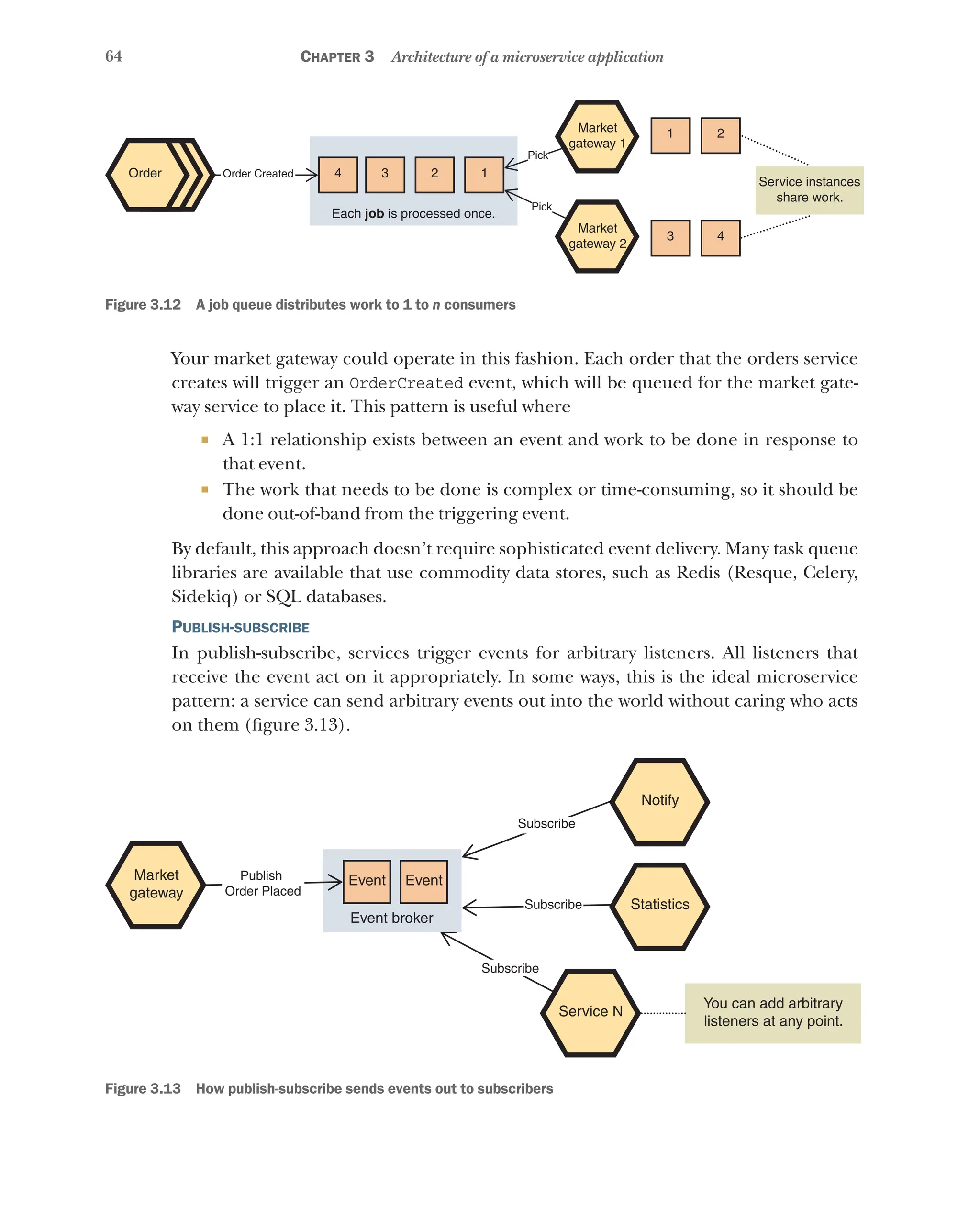
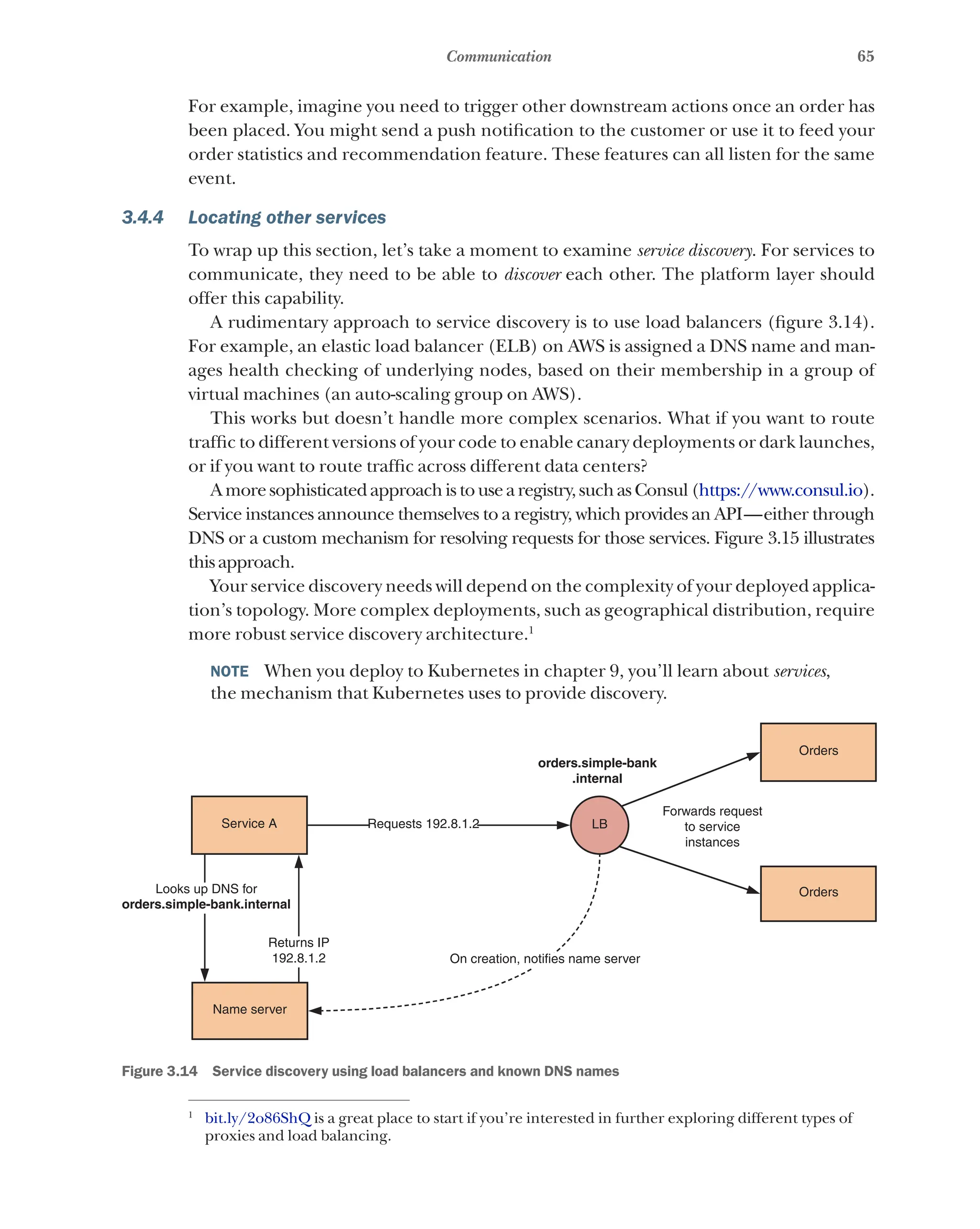
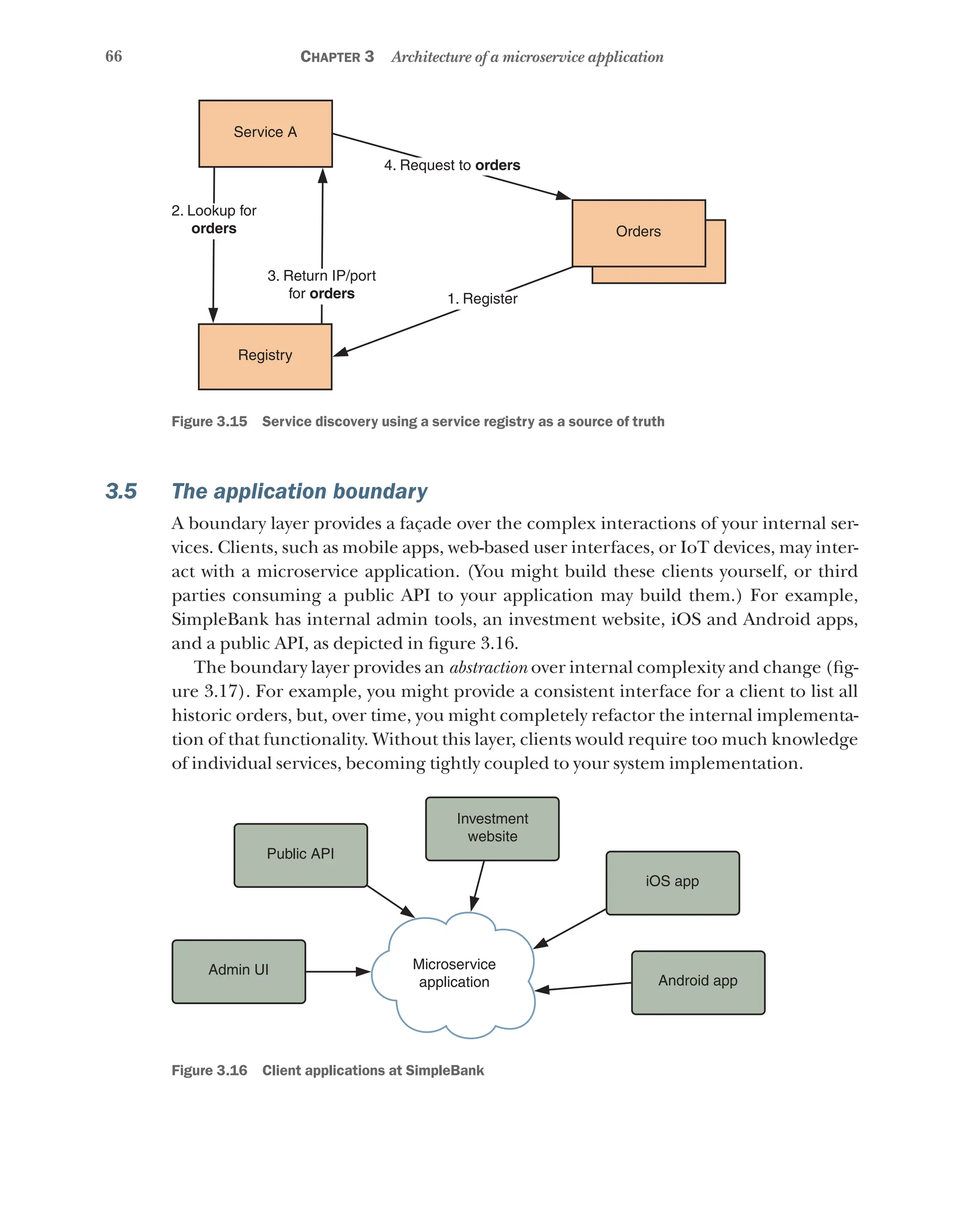
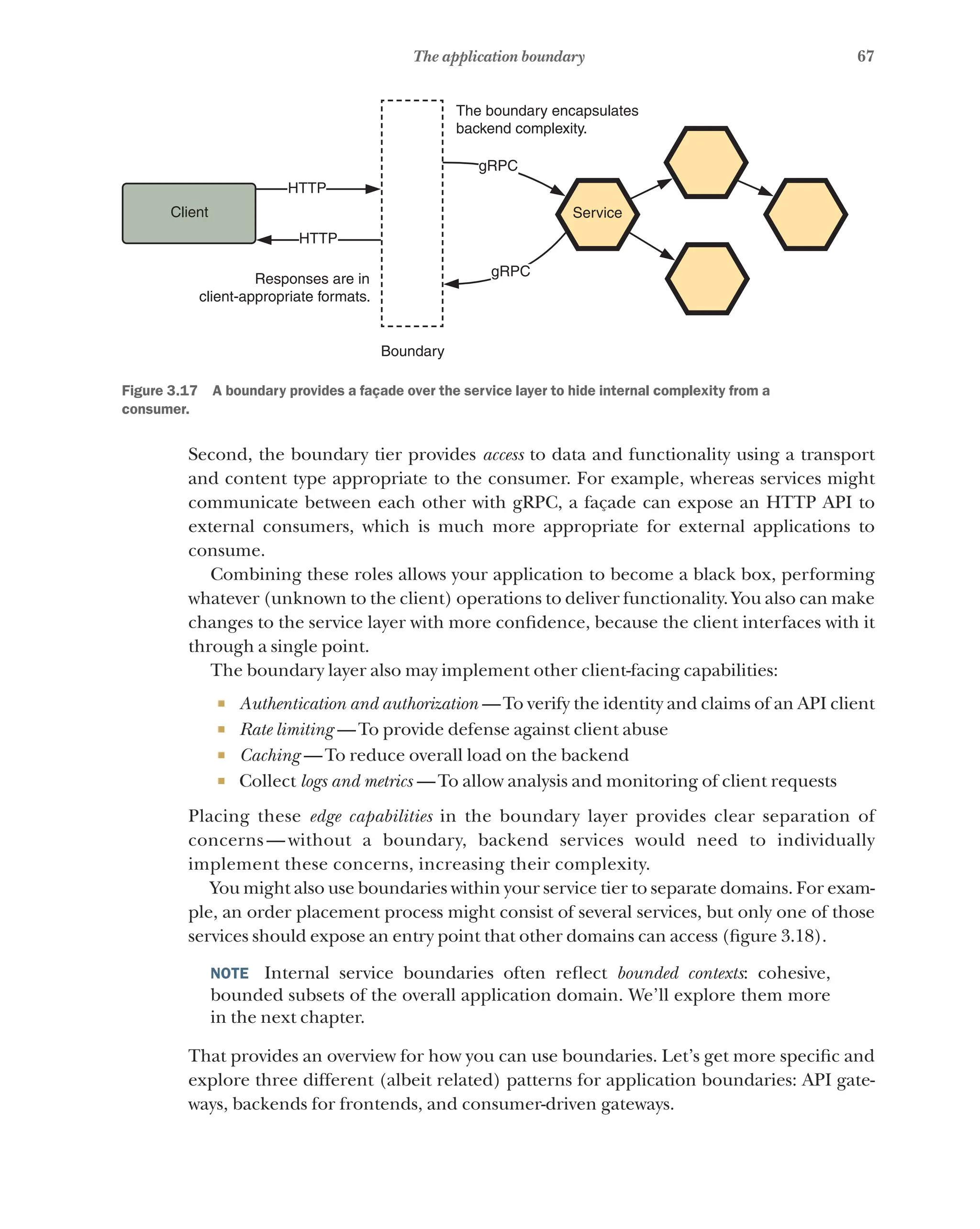

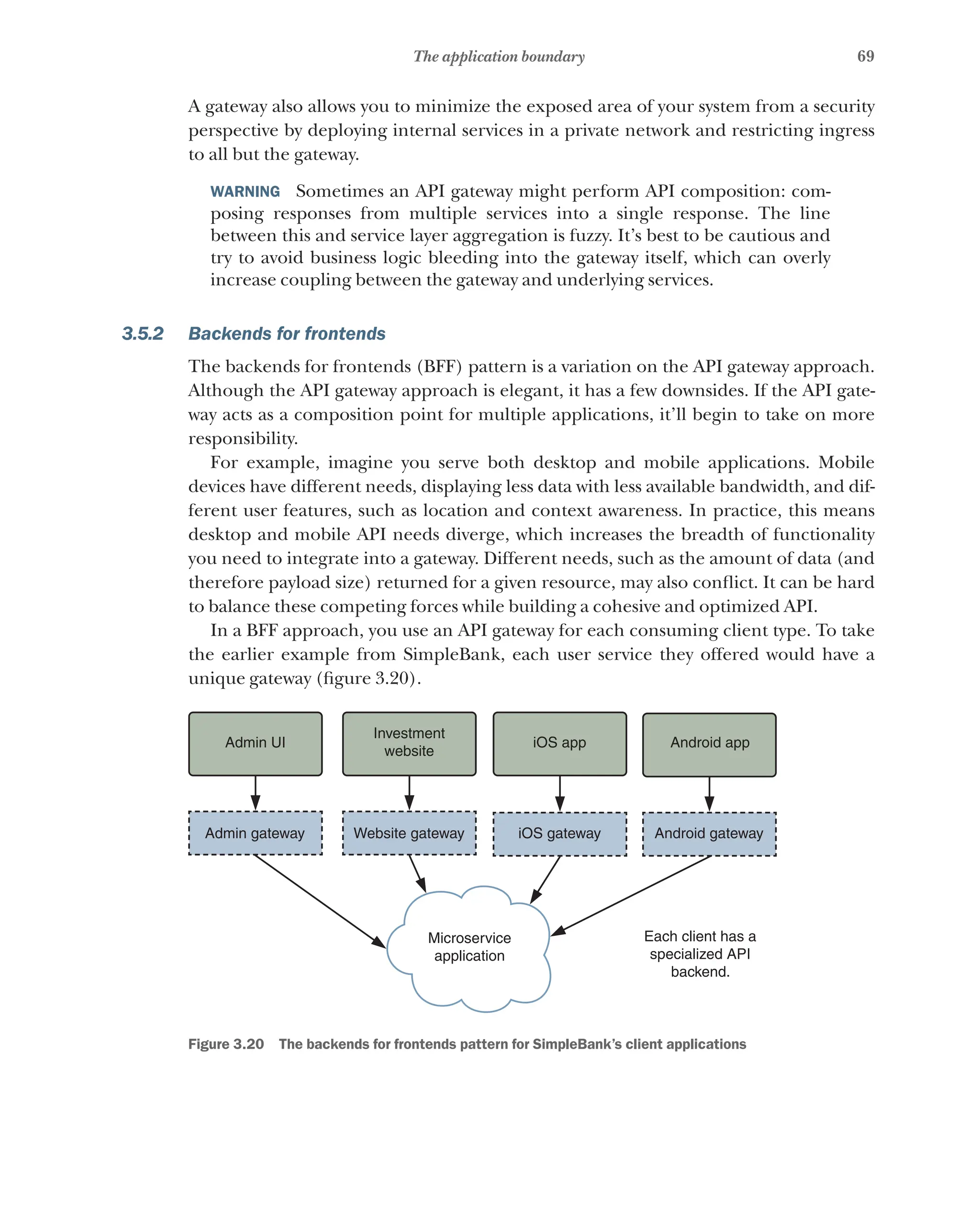
![70 Chapter 3 Architecture of a microservice application
Doing so allows the gateway to be highly specific and responsive to the needs of its
consumer without bloat or conflict. This results in smaller, simpler gateways and more
focused development.
3.5.3 Consumer-driven gateways
In both previous patterns, the API gateway determines the structure of the data it
returns to your consumer. To serve different clients, you might build unique backends.
Let’s flip this around. What if you could build a gateway that allowed consumers to
express exactly what data they needed from your service? Think of this like an evolu-
tion of the BFF approach: rather than building multiple APIs, you can build a single
“super-set” API that allows consumers to define the shape of response they require.
You can achieve this using GraphQL. GraphQL is a query language for APIs that
allows consumers to specify which data fields they want and to multiplex different
resources into a single request. For example, you might expose the following schema
for SimpleBank clients.
Listing 3.1 Basic GraphQL schema for SimpleBank
type Account {
id: ID!
name: String!
currentHoldings: [Holding]!
orders: [Order]!
}
type Order {
id: ID!
status: String!
asset: Asset!
quantity: Float!
}
type Holding {
asset: Asset!
quantity: Float!
}
type Asset {
id: ID!
name: String!
type: String!
price: Float!
}
type Root {
accounts: [Account]!
account(id: ID): Account
}
schema: {
query: Root
}
The ! indicates the field is non-nullable.
An account contains lists of Holding and Order.
Returns all accounts or an account by its ID
The schema has a single entry point for queries.](https://image.slidesharecdn.com/microservicesinaction-240113230140-1bc300cc/75/microservices-in-action-pdf-97-2048.jpg)

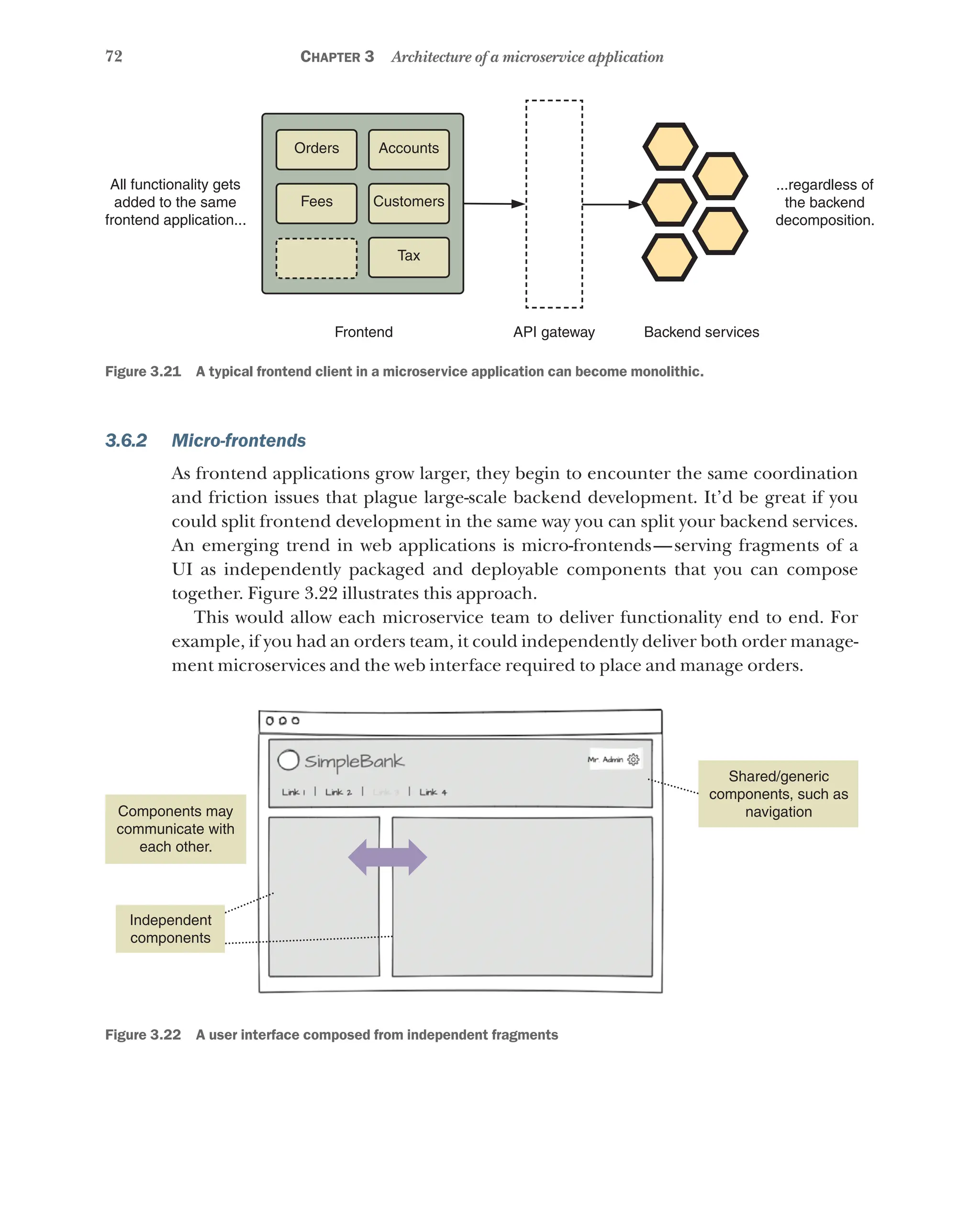


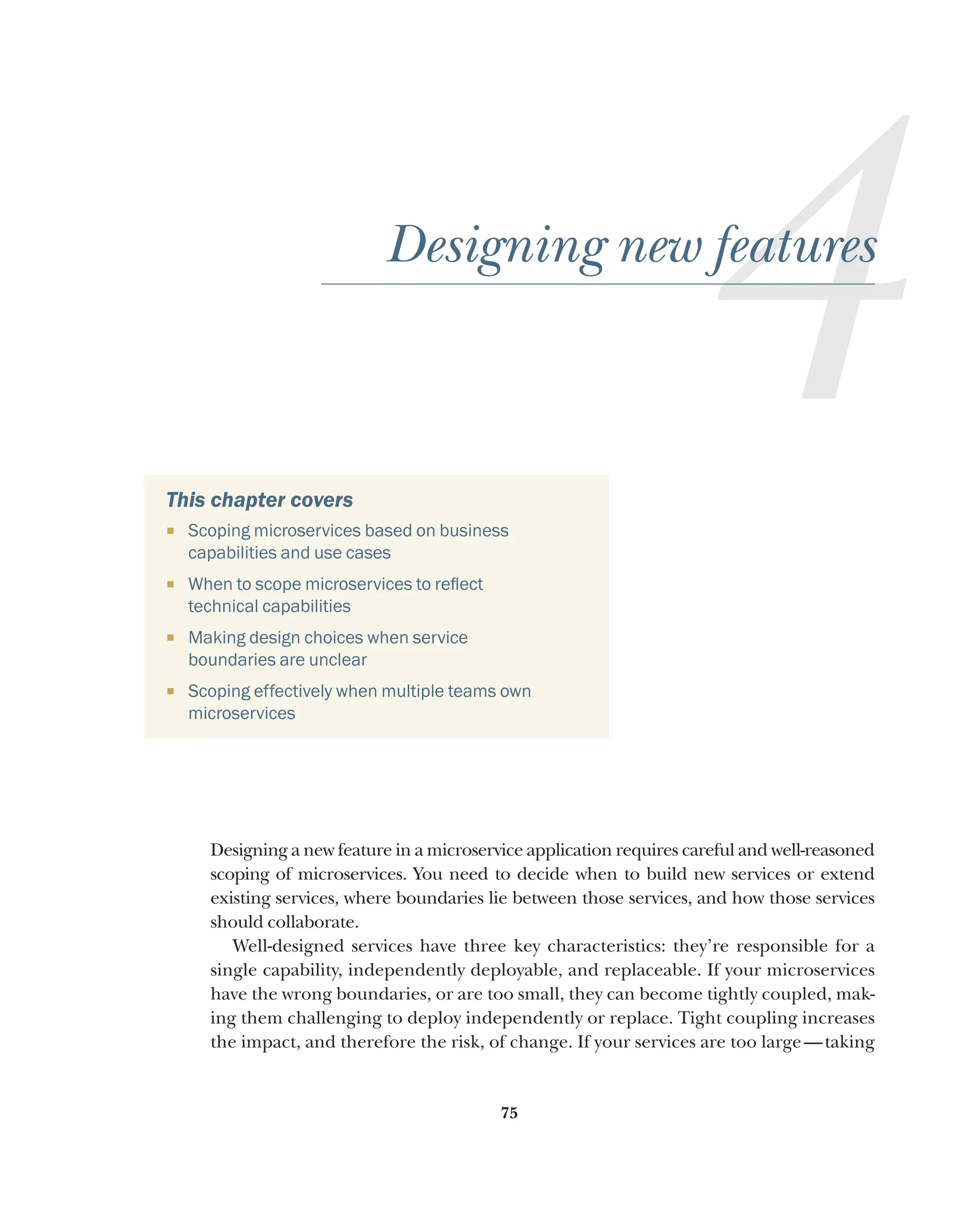
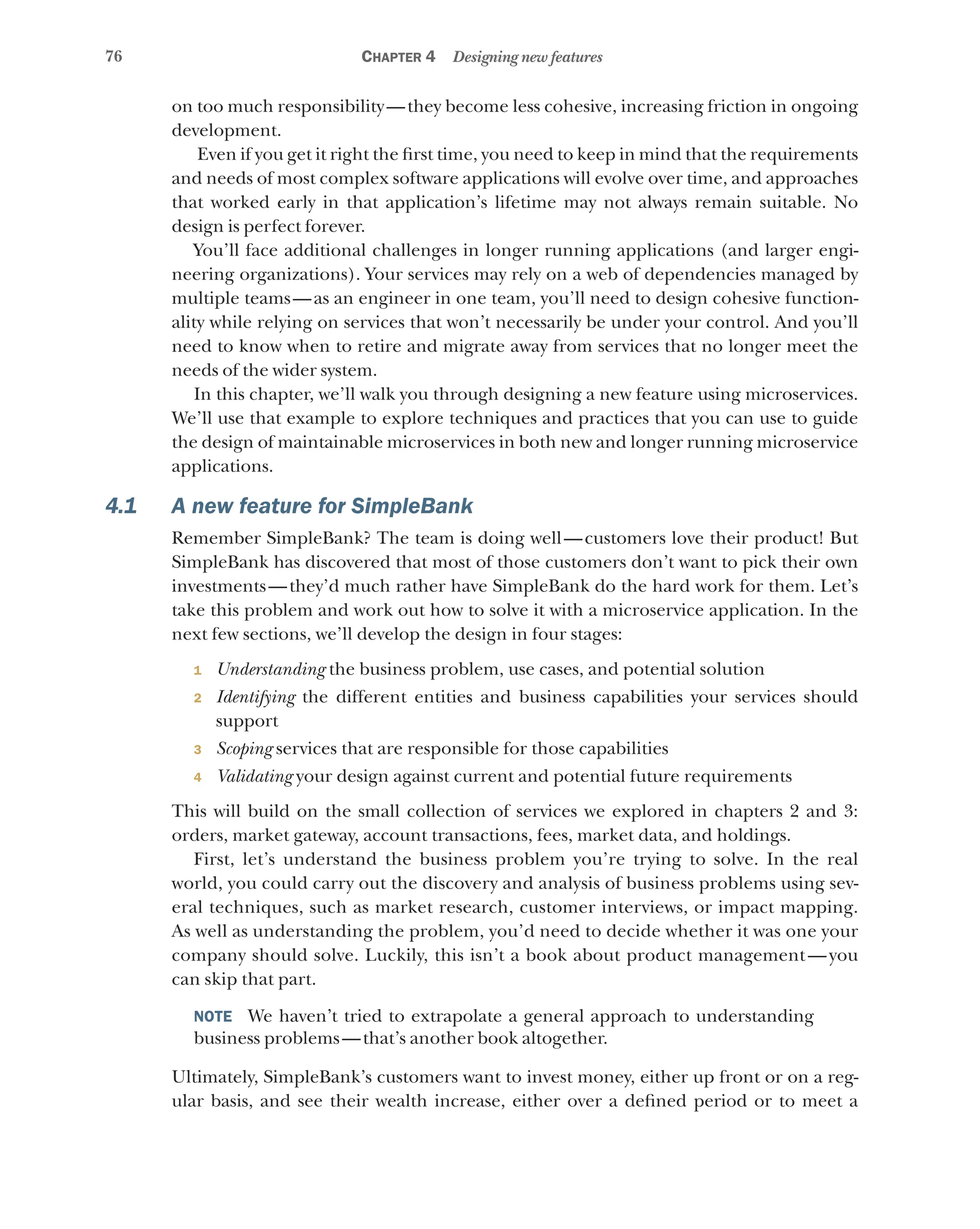


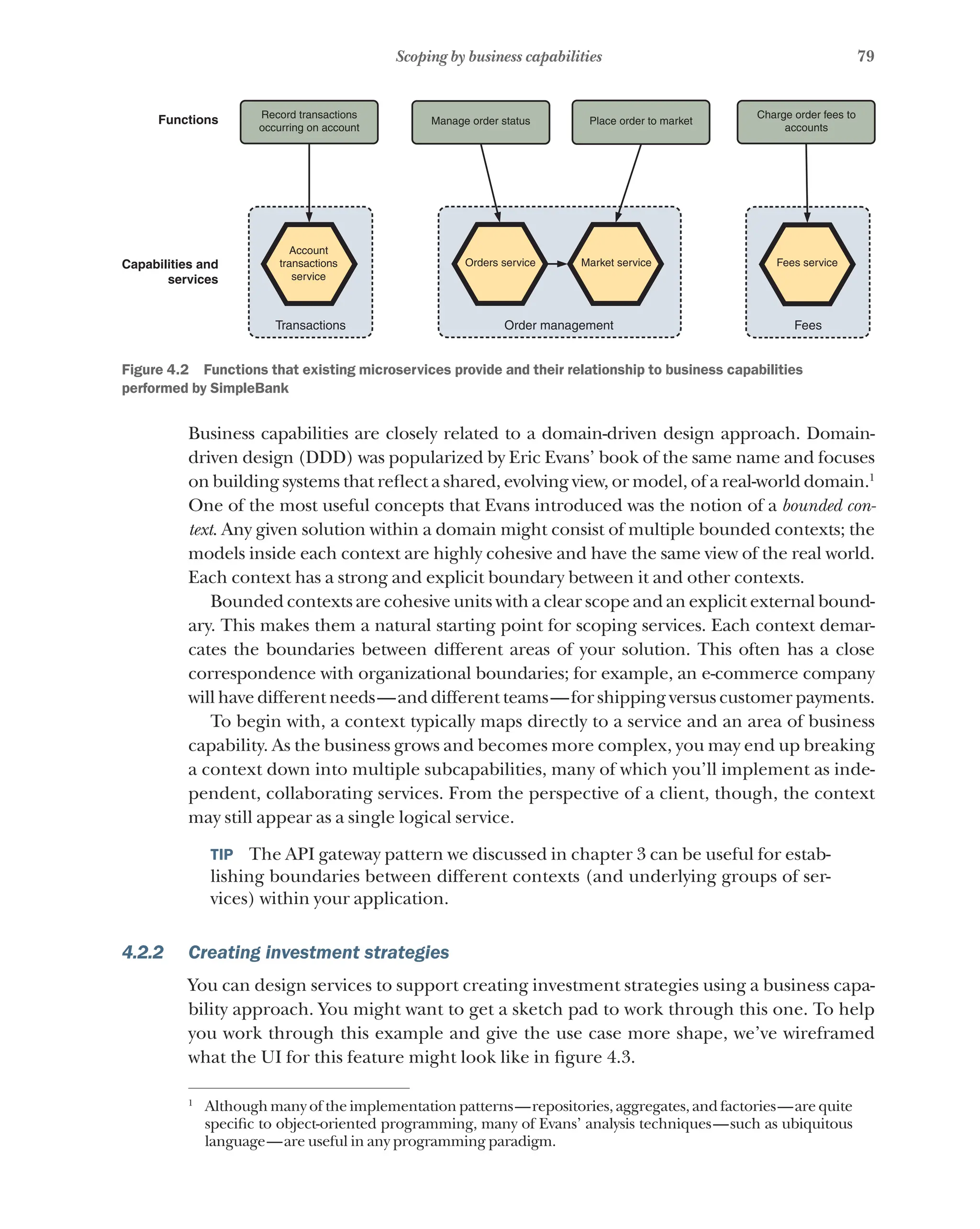
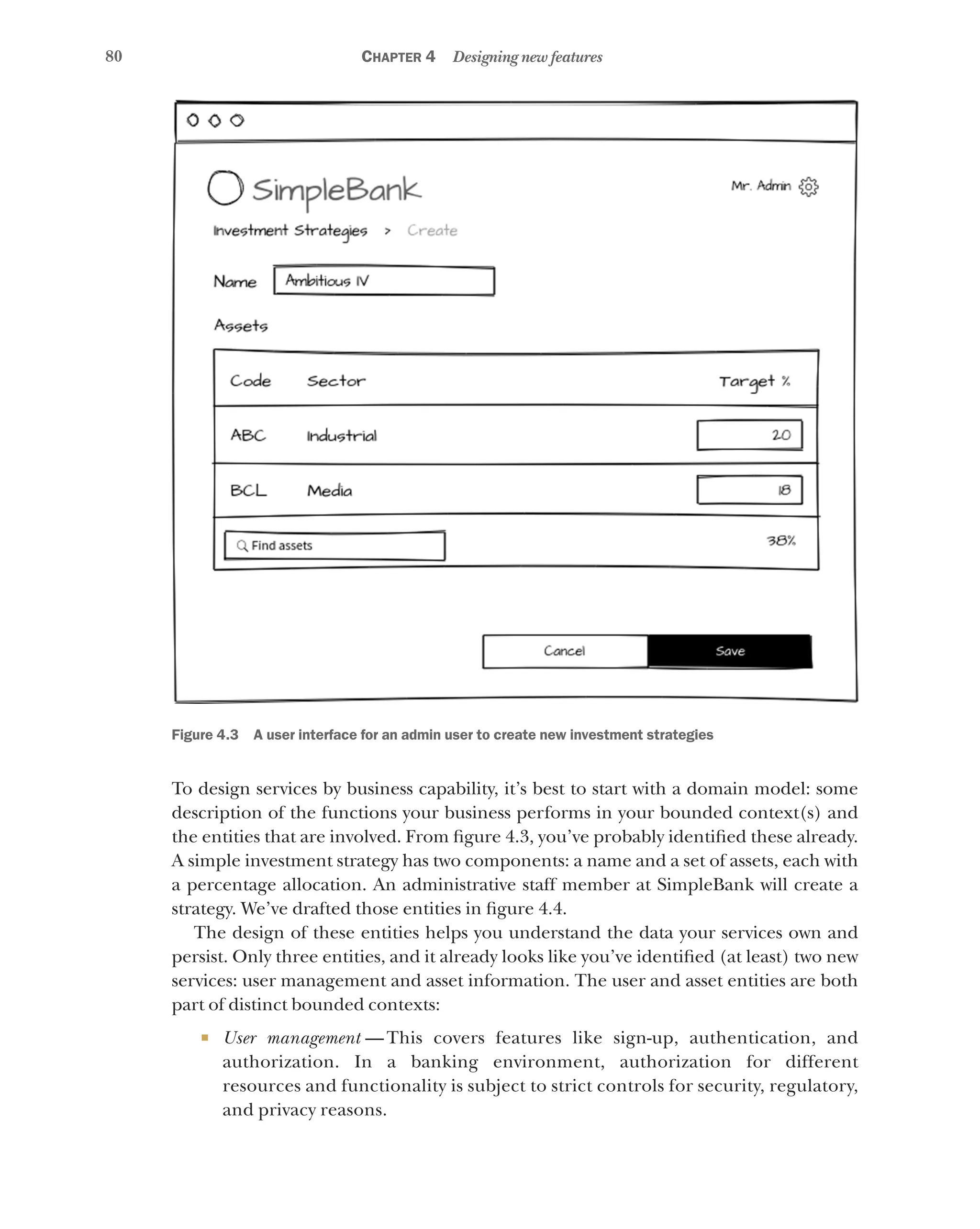

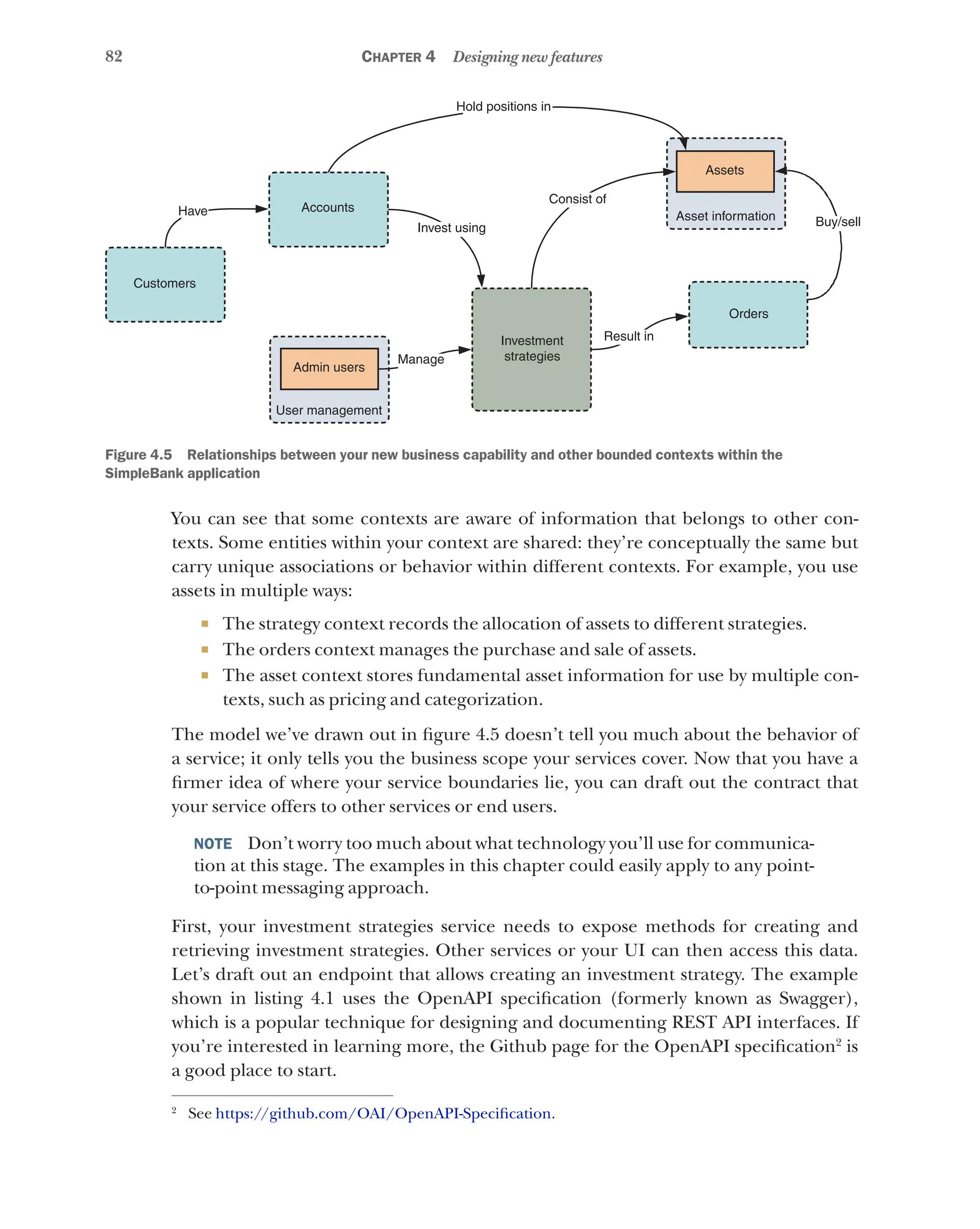
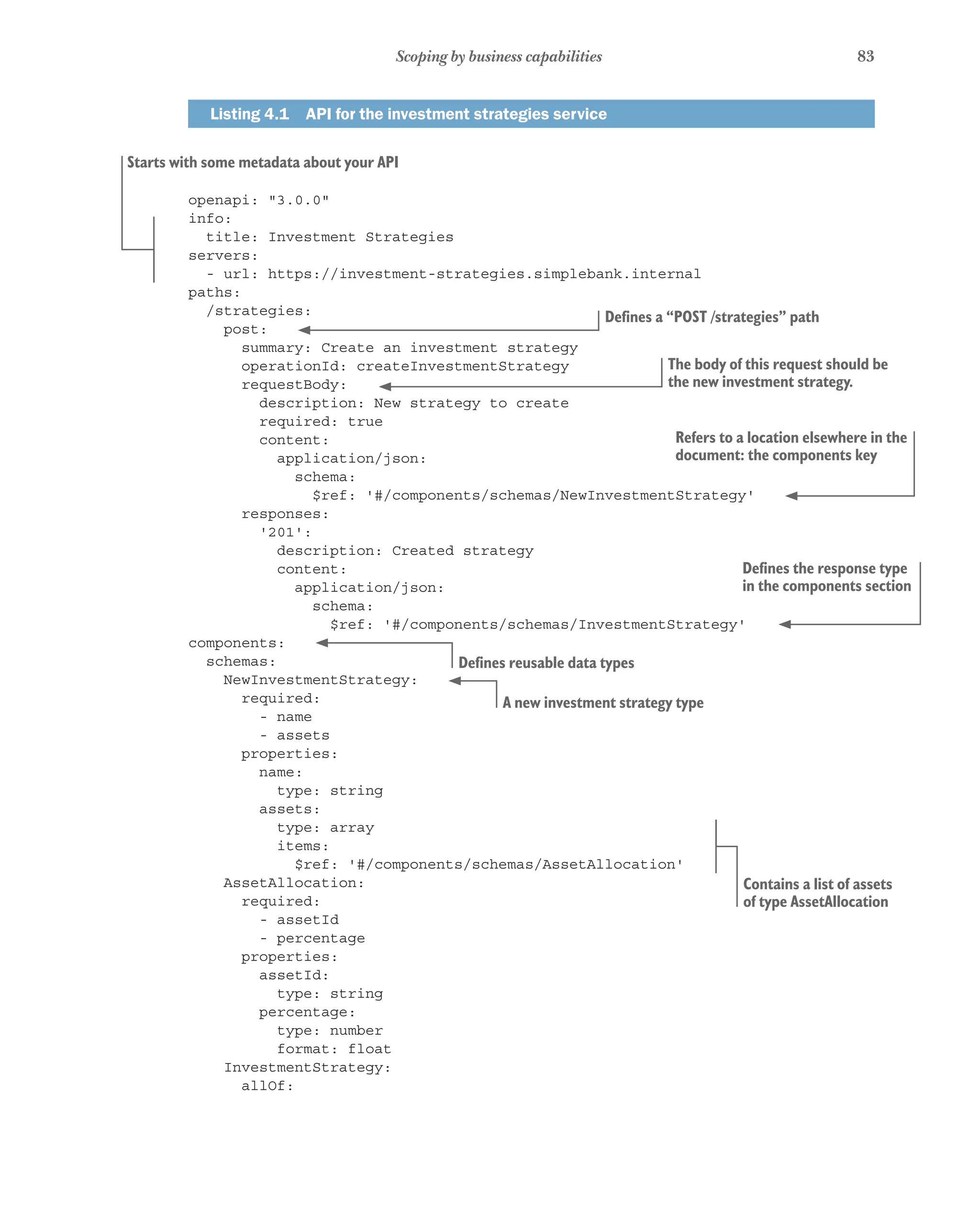

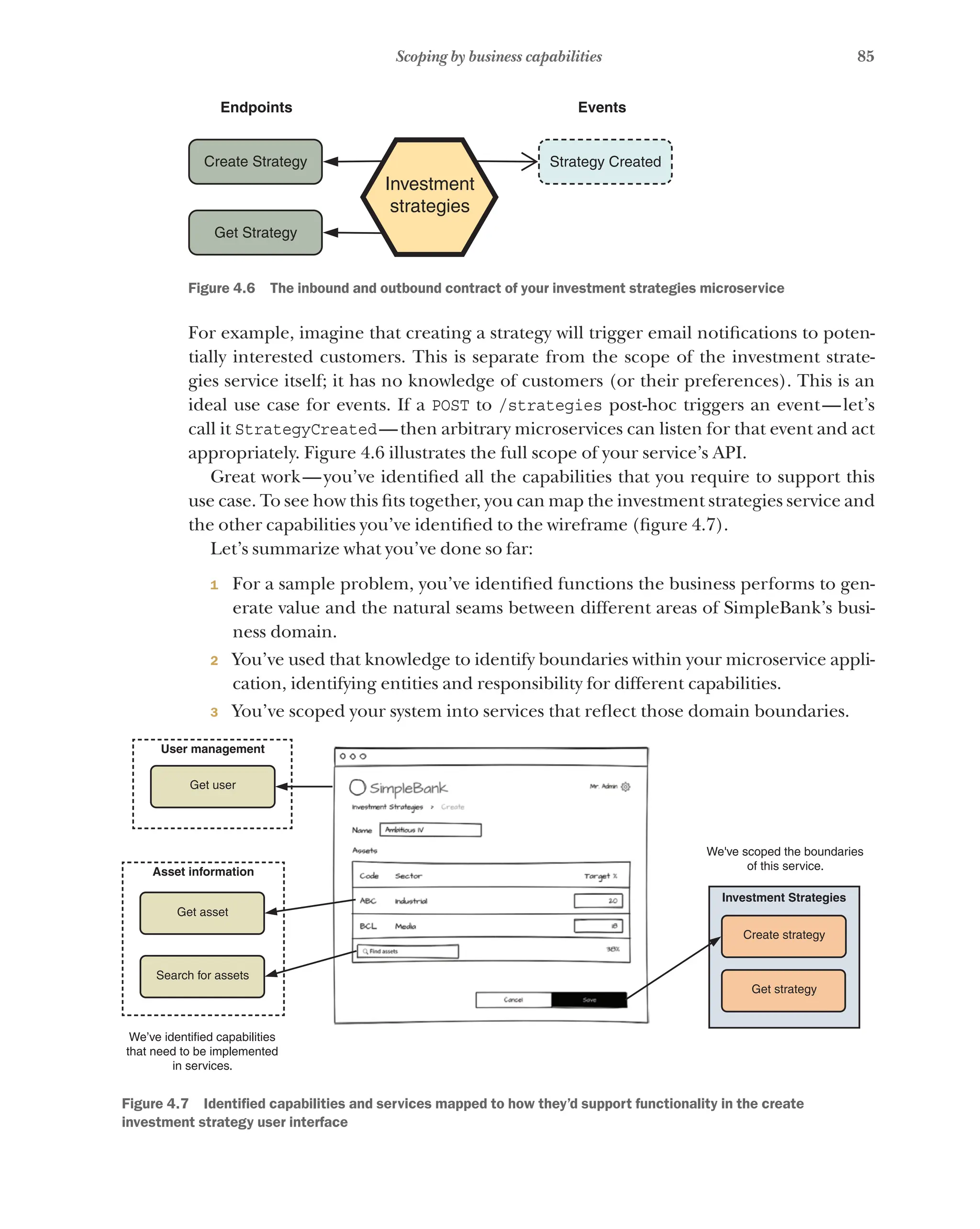

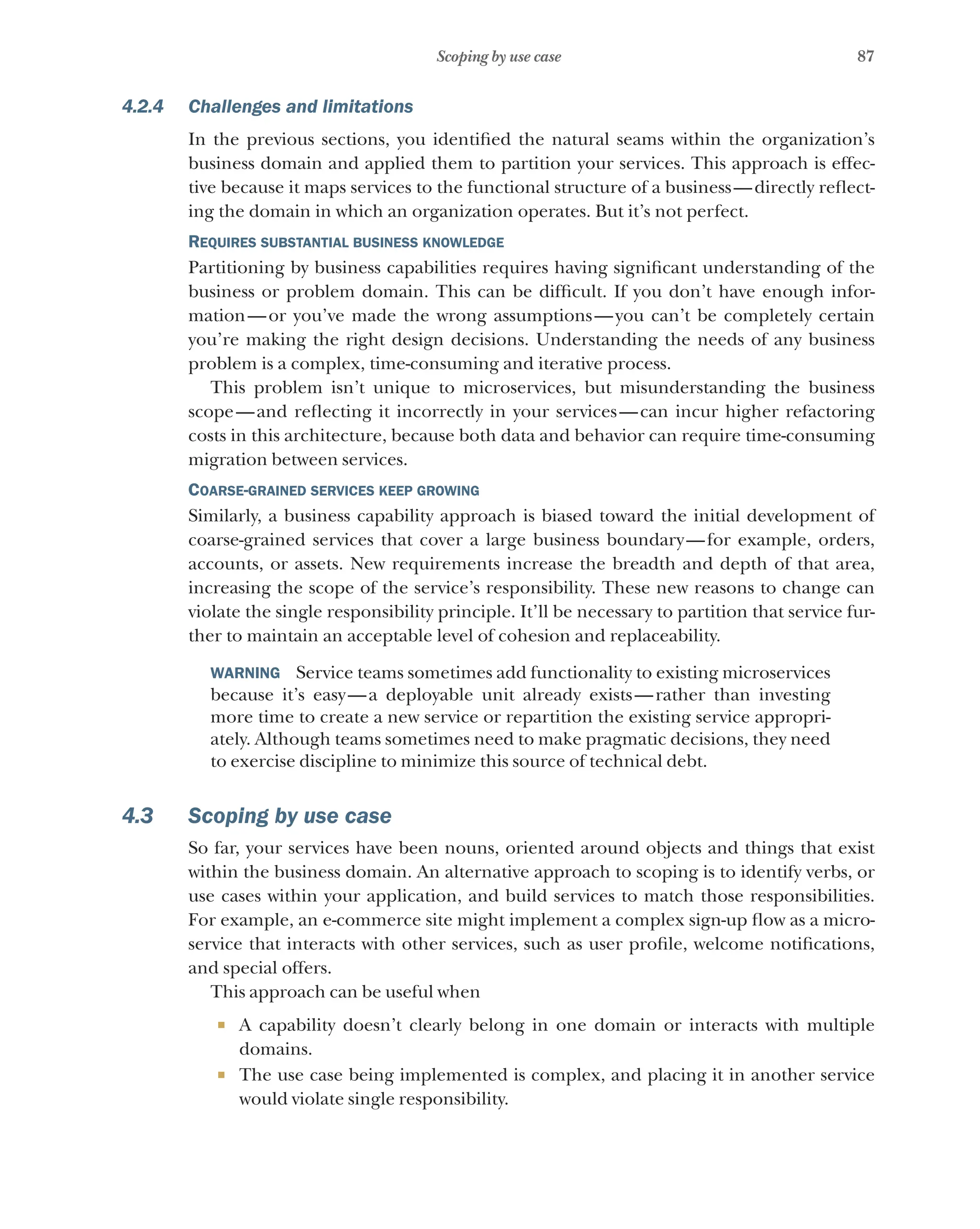
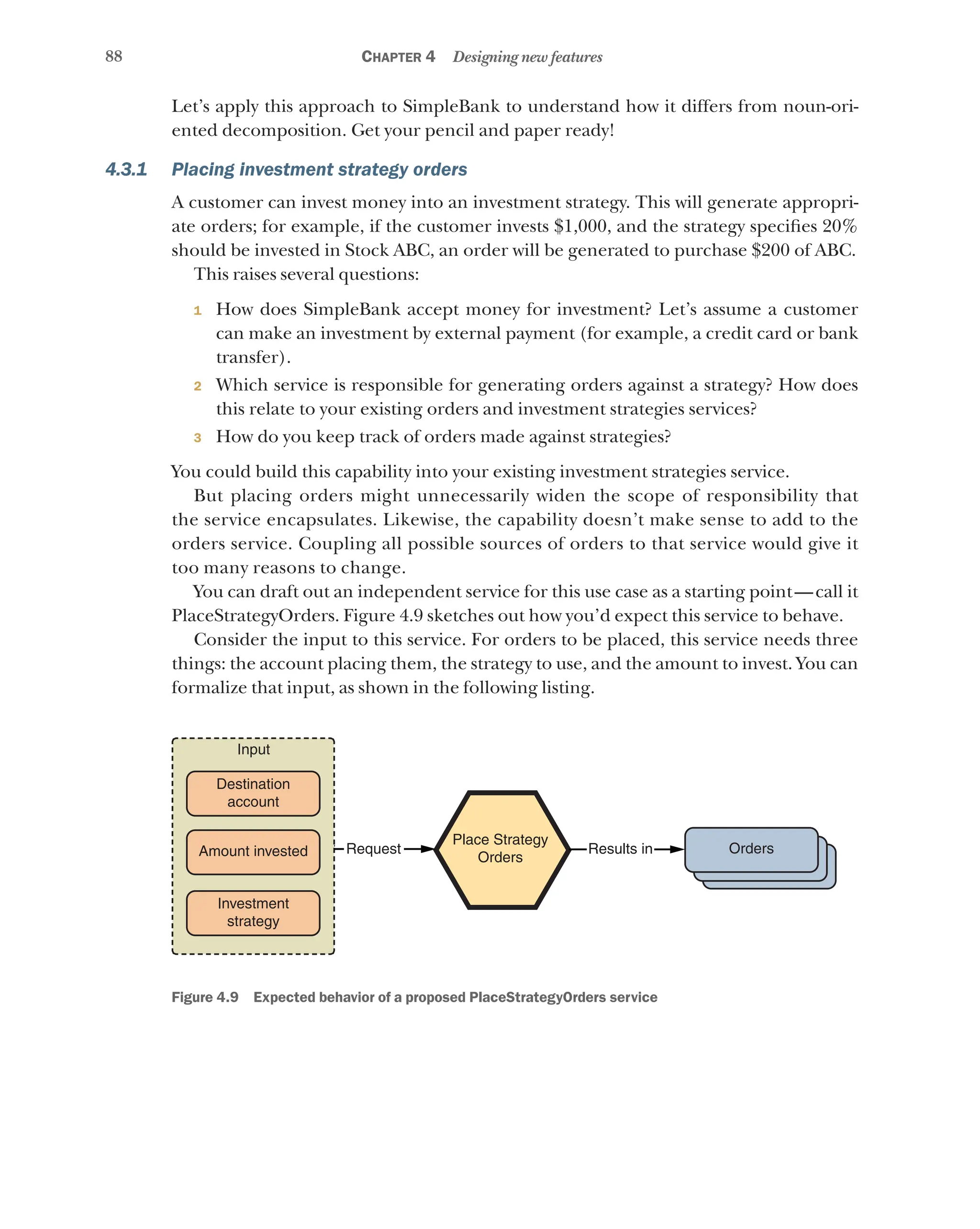
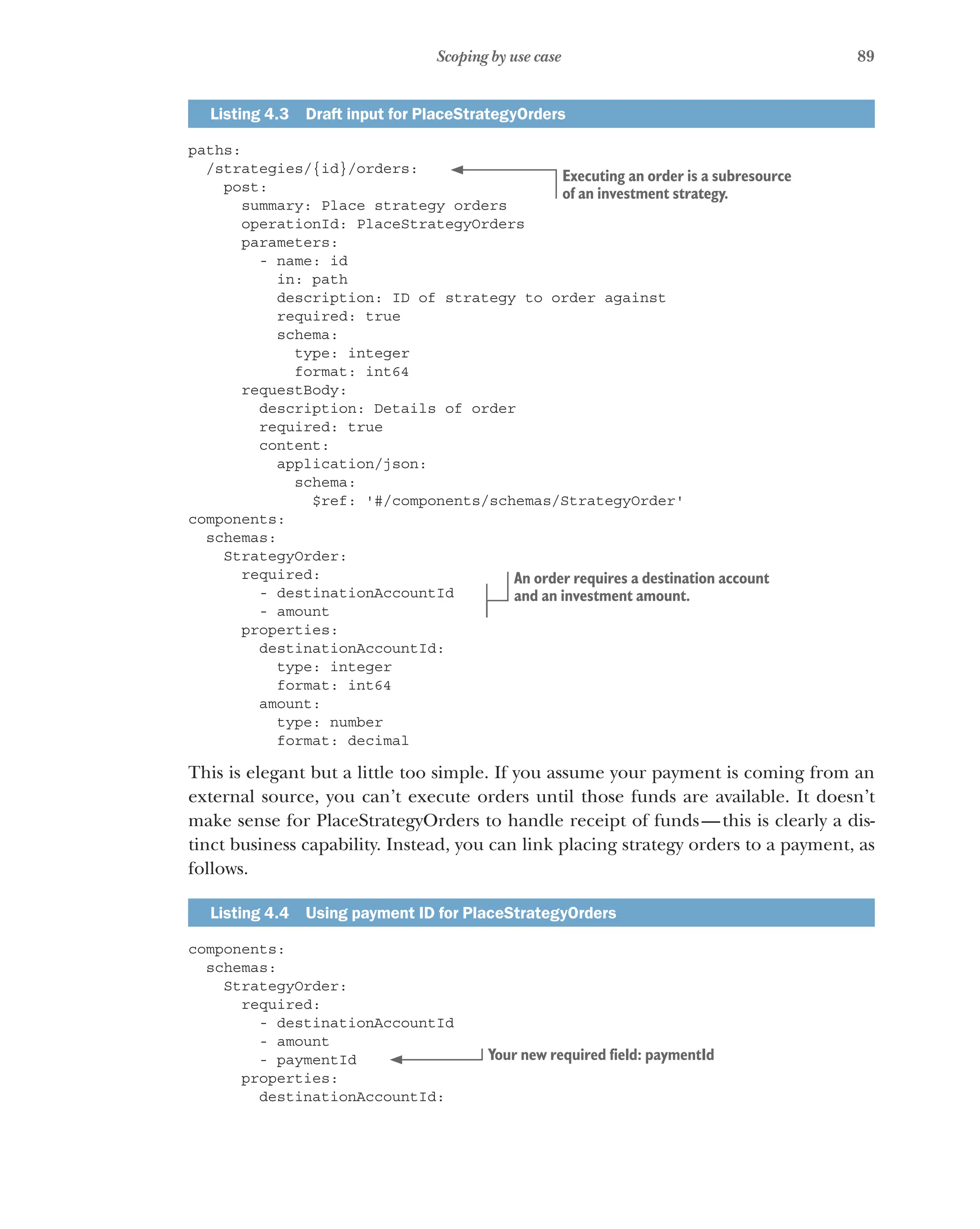
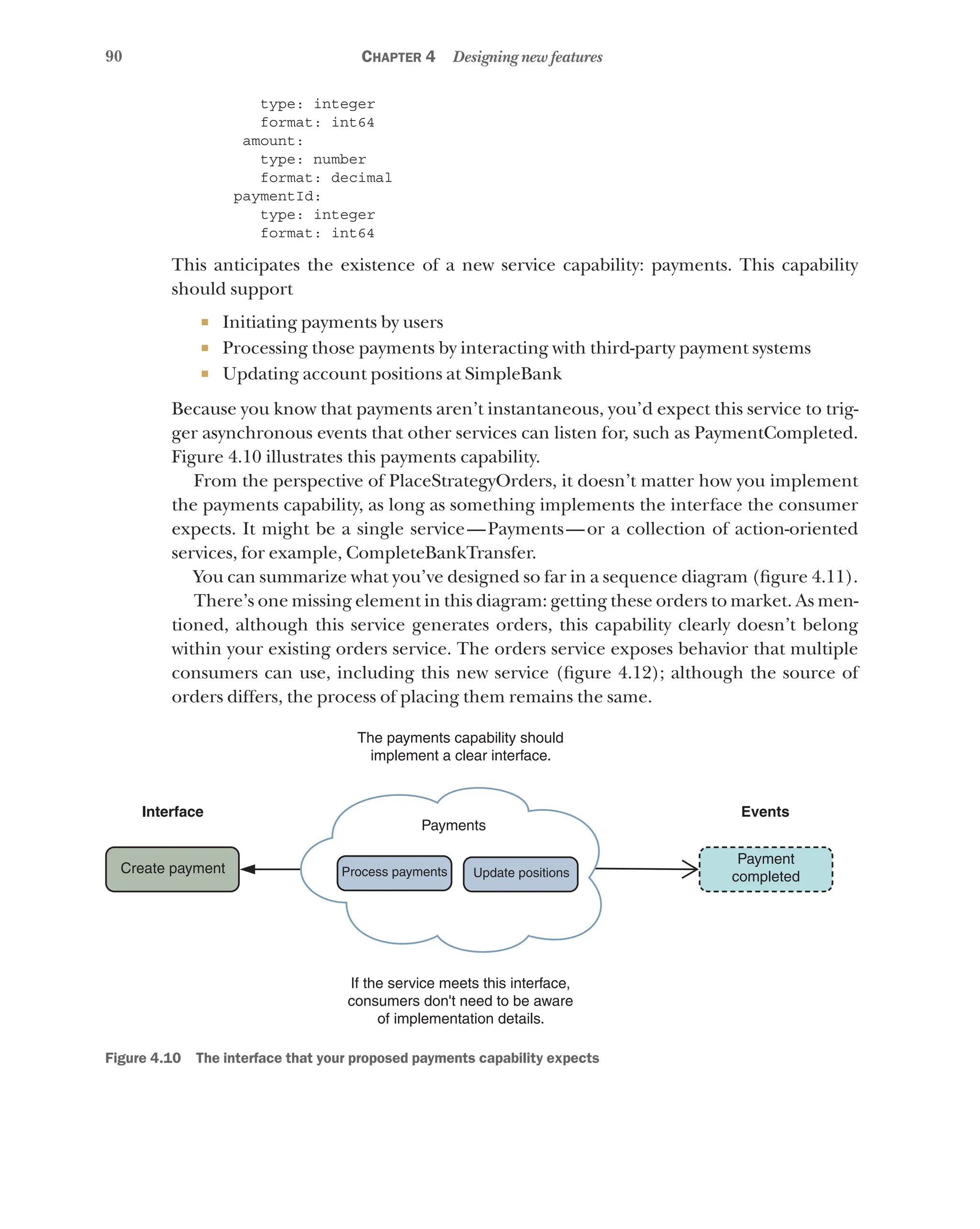
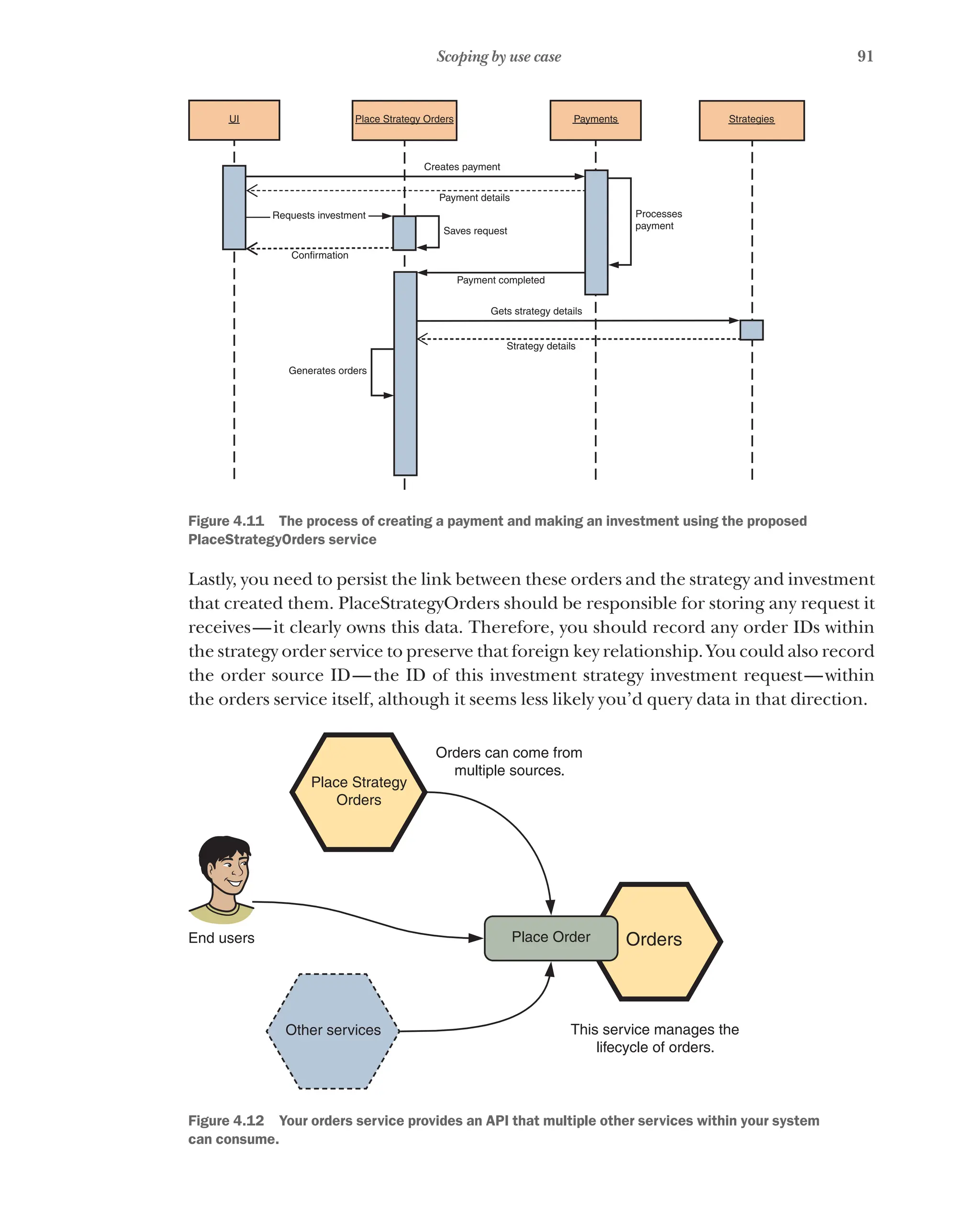
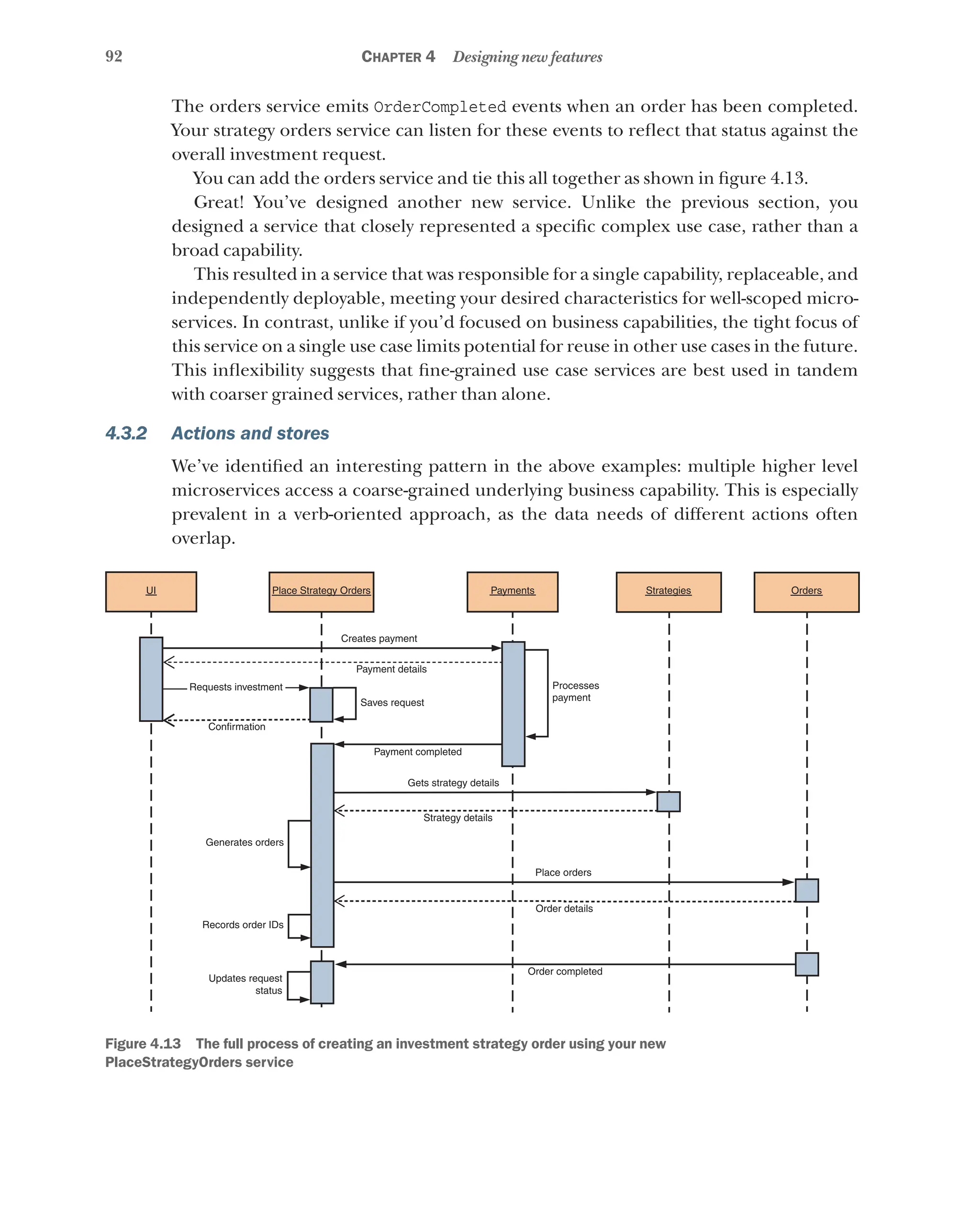
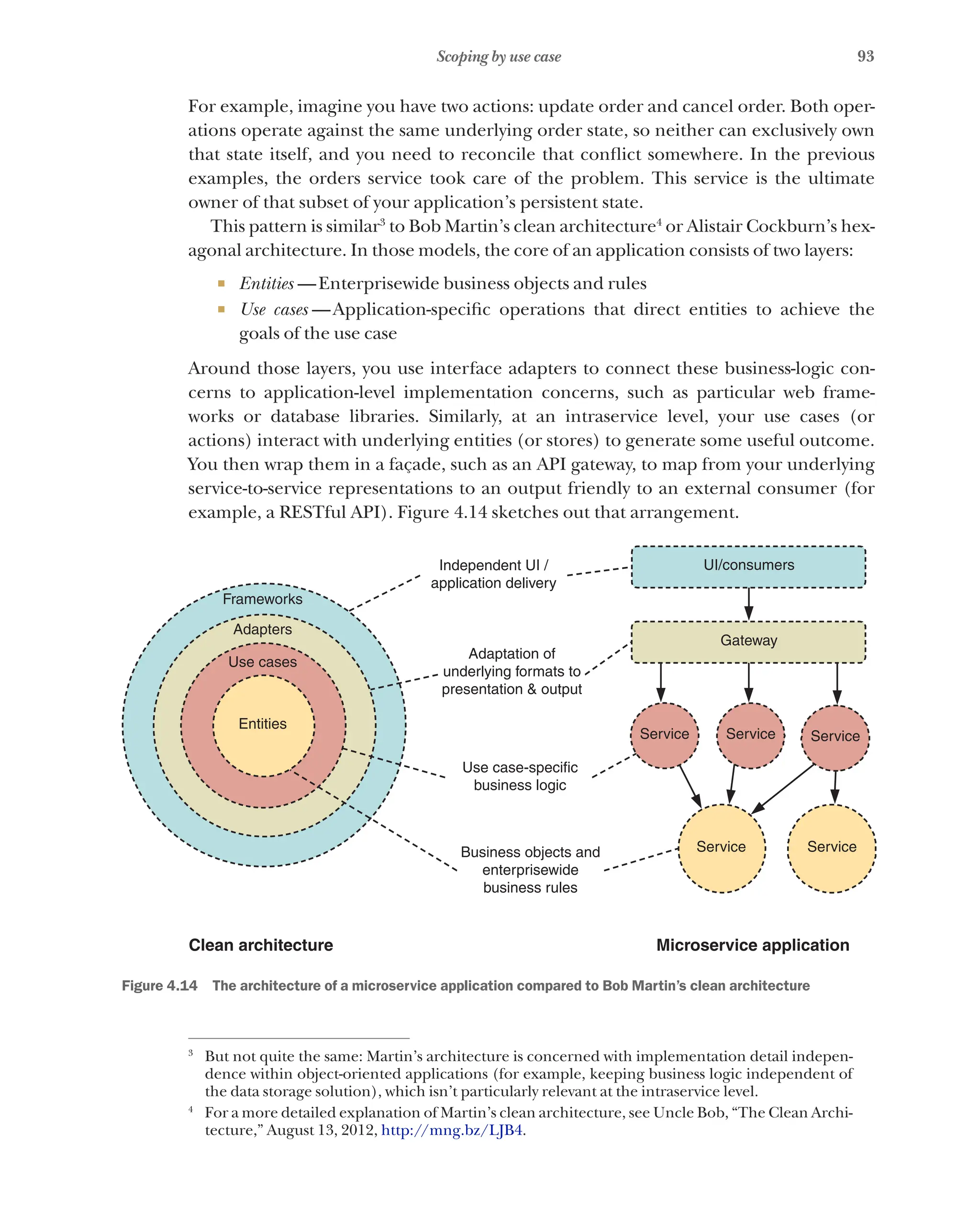

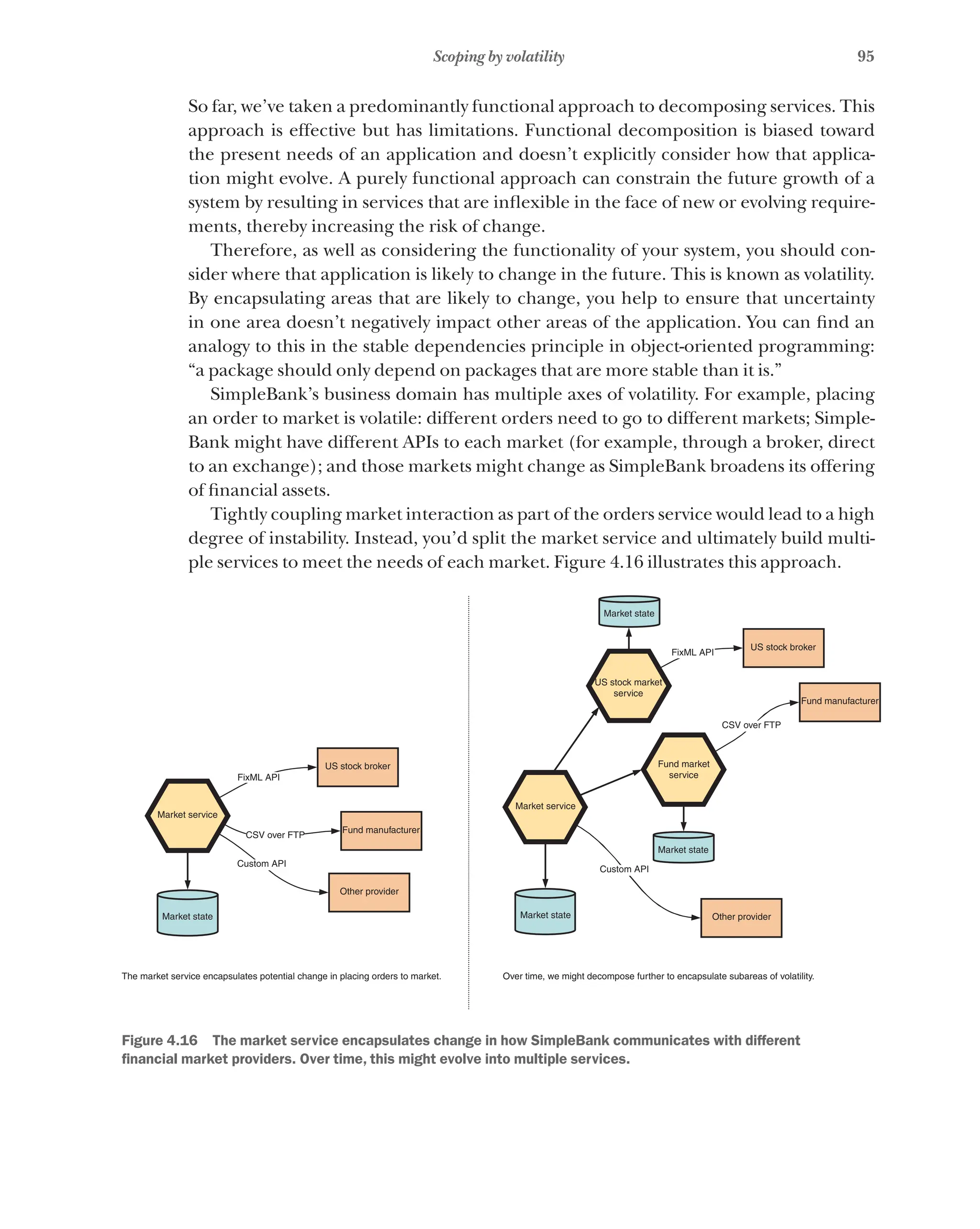
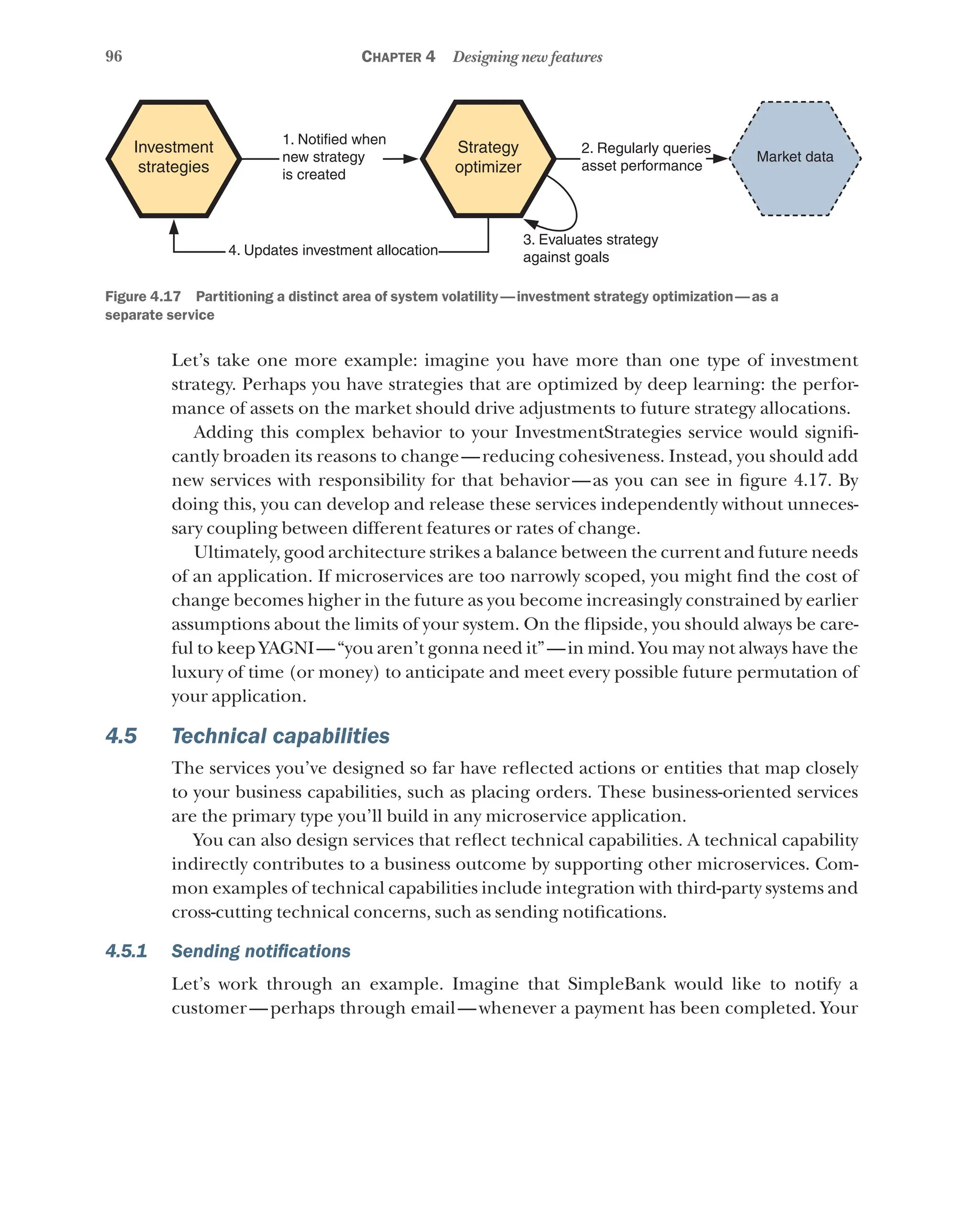
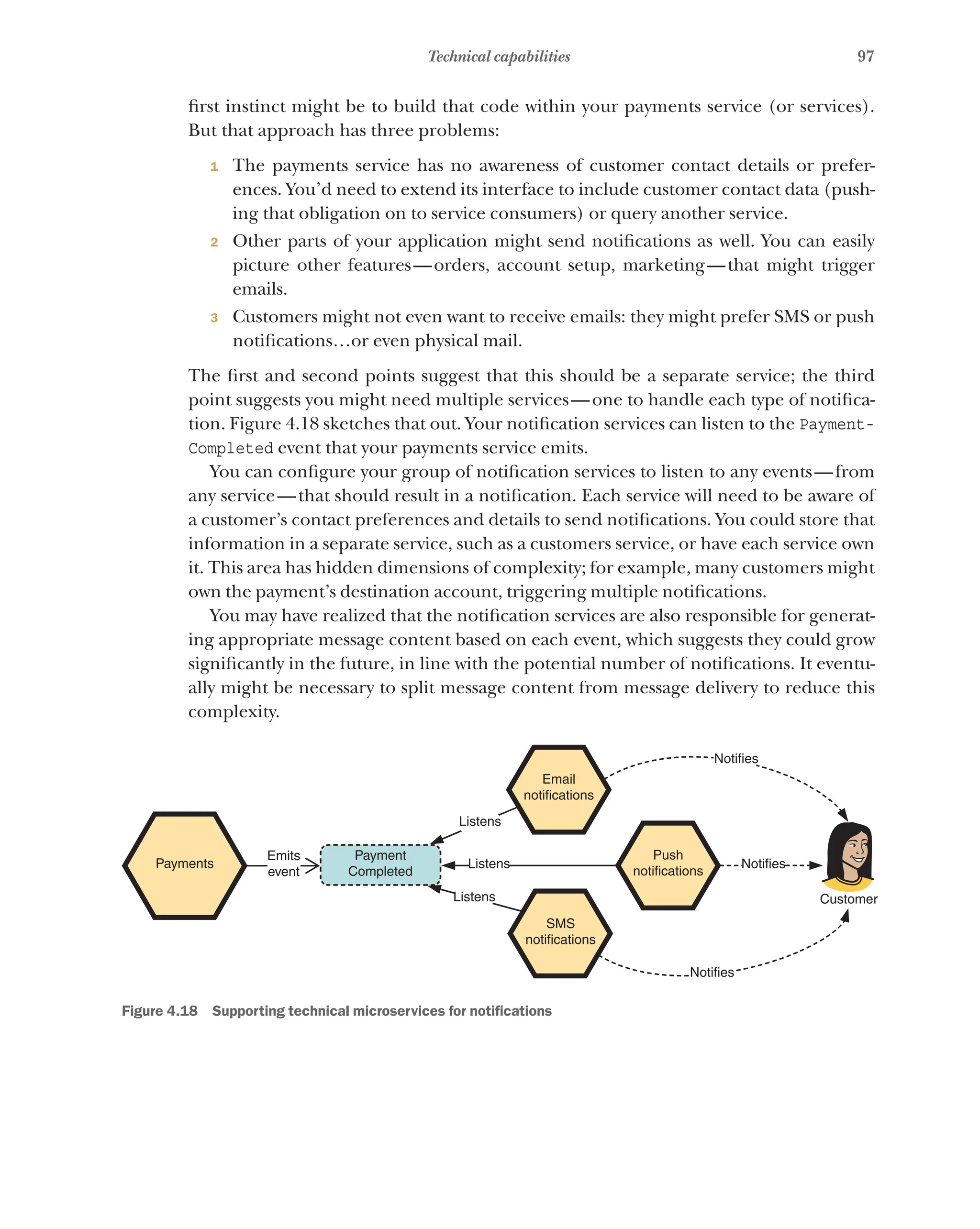
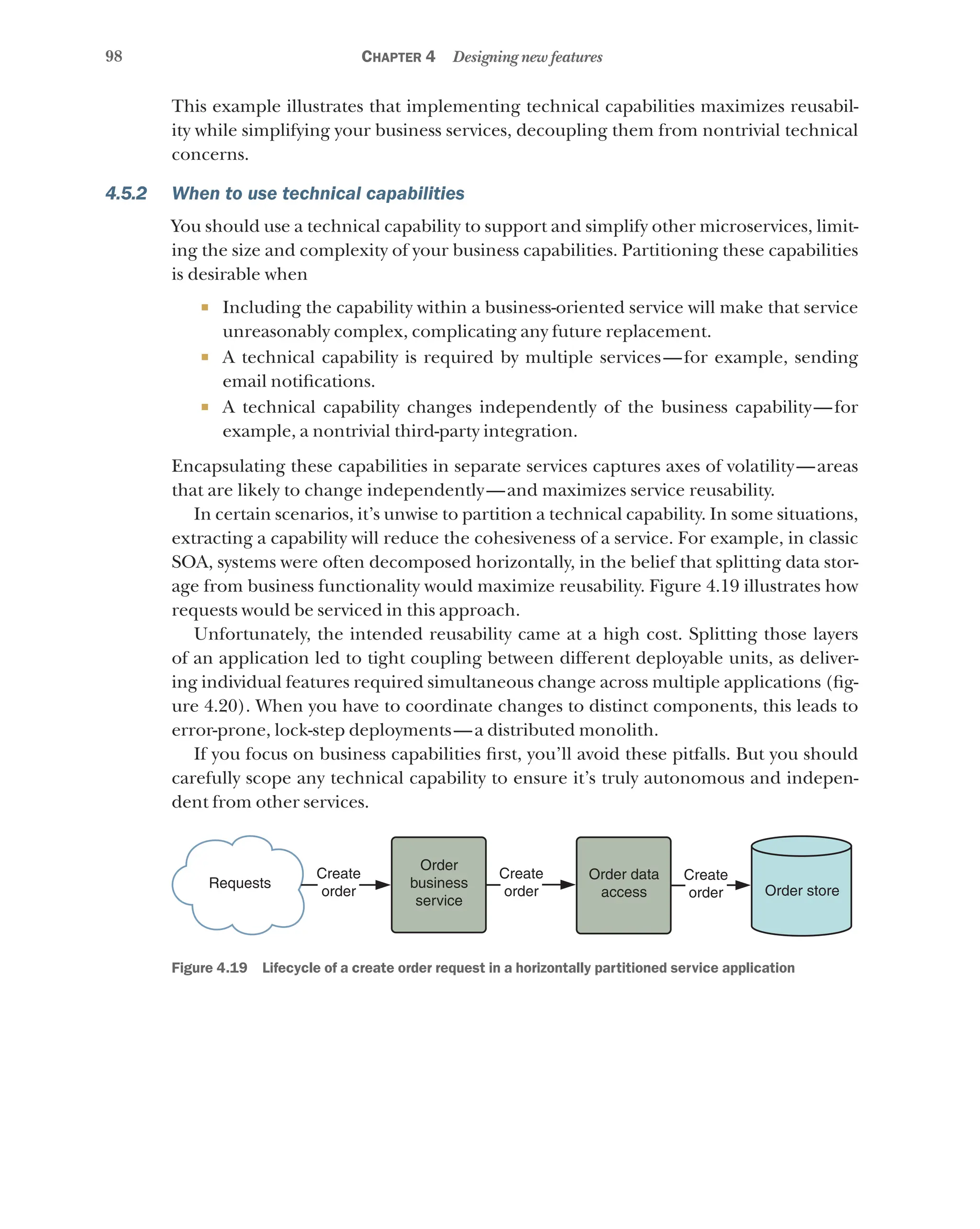

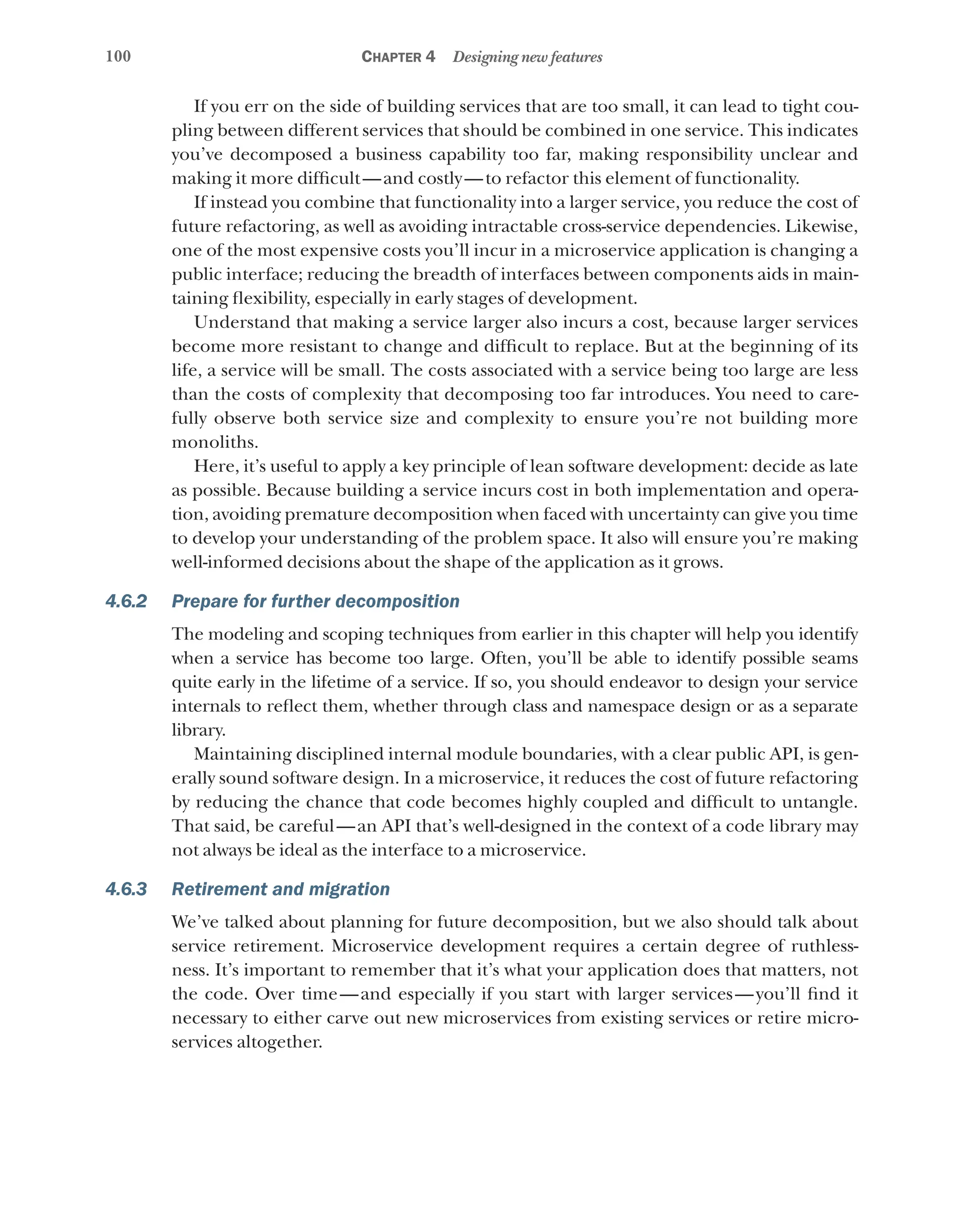
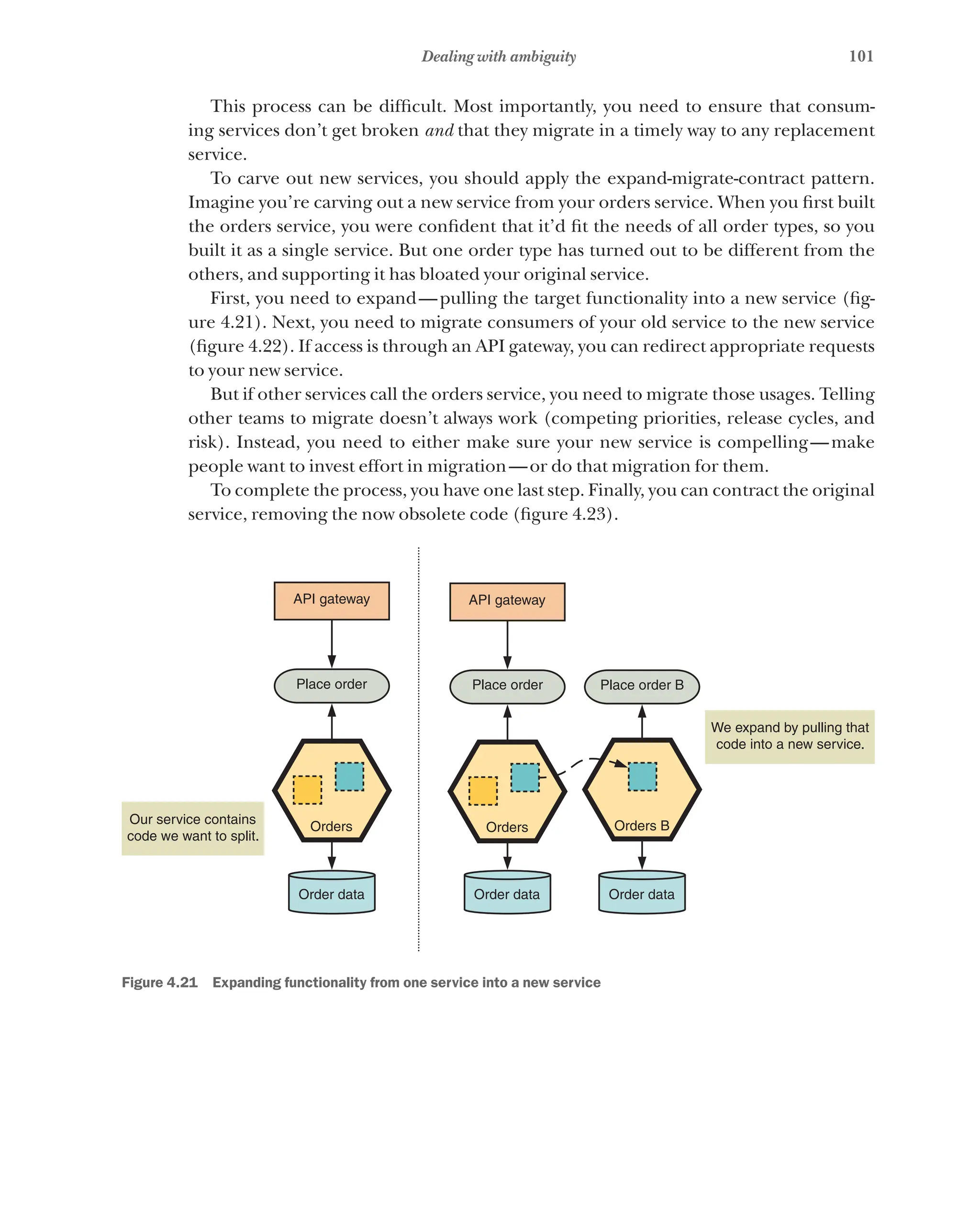
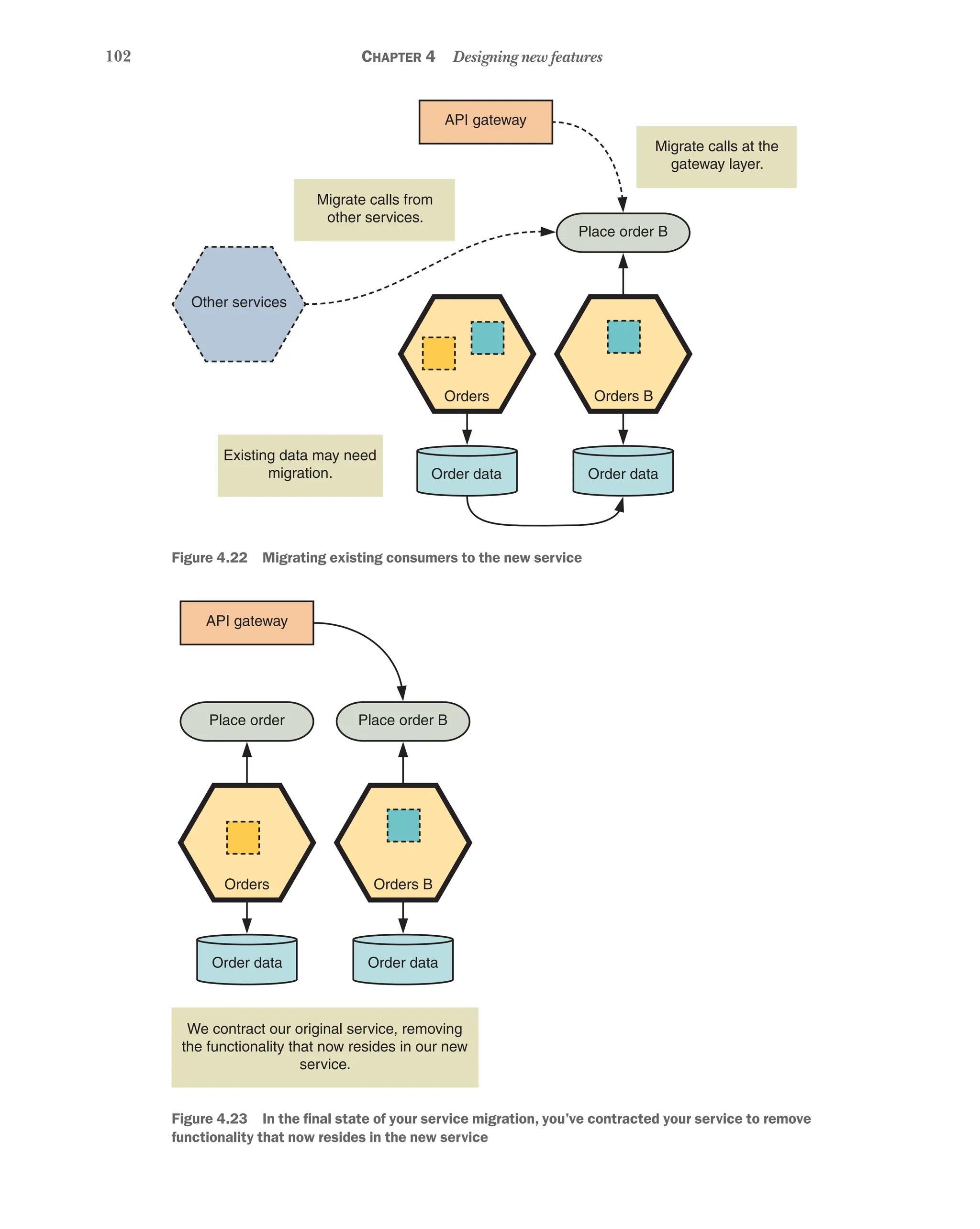
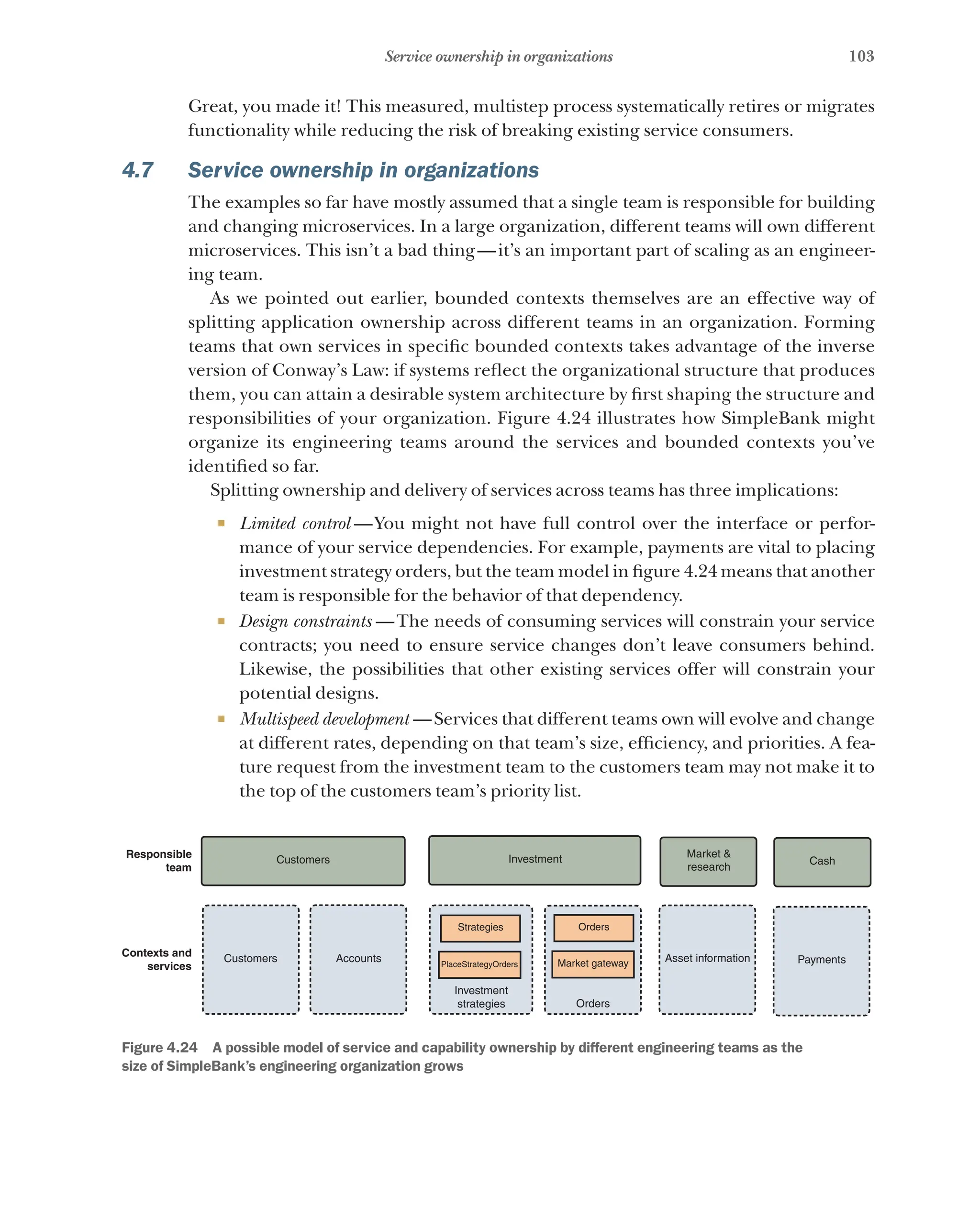
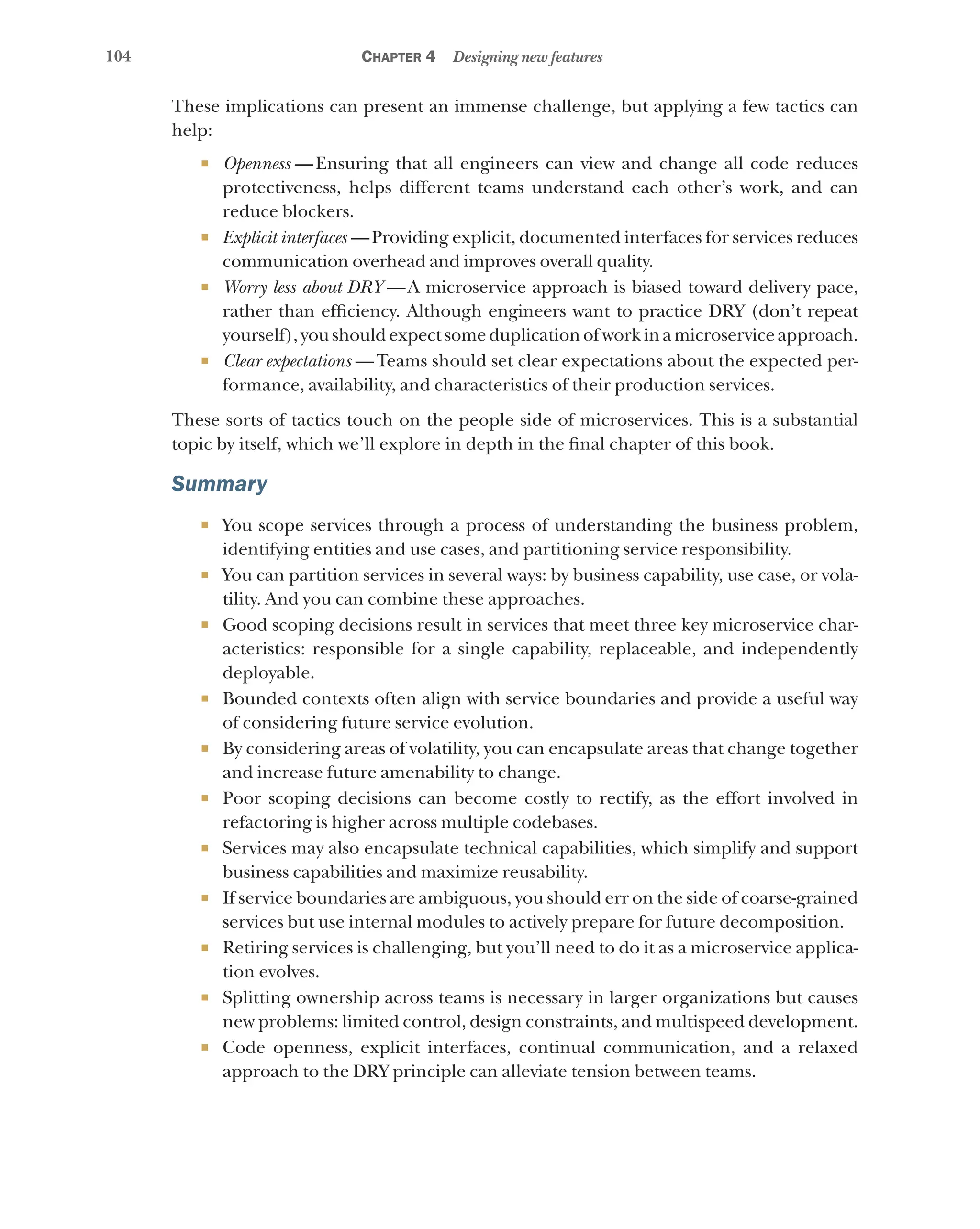
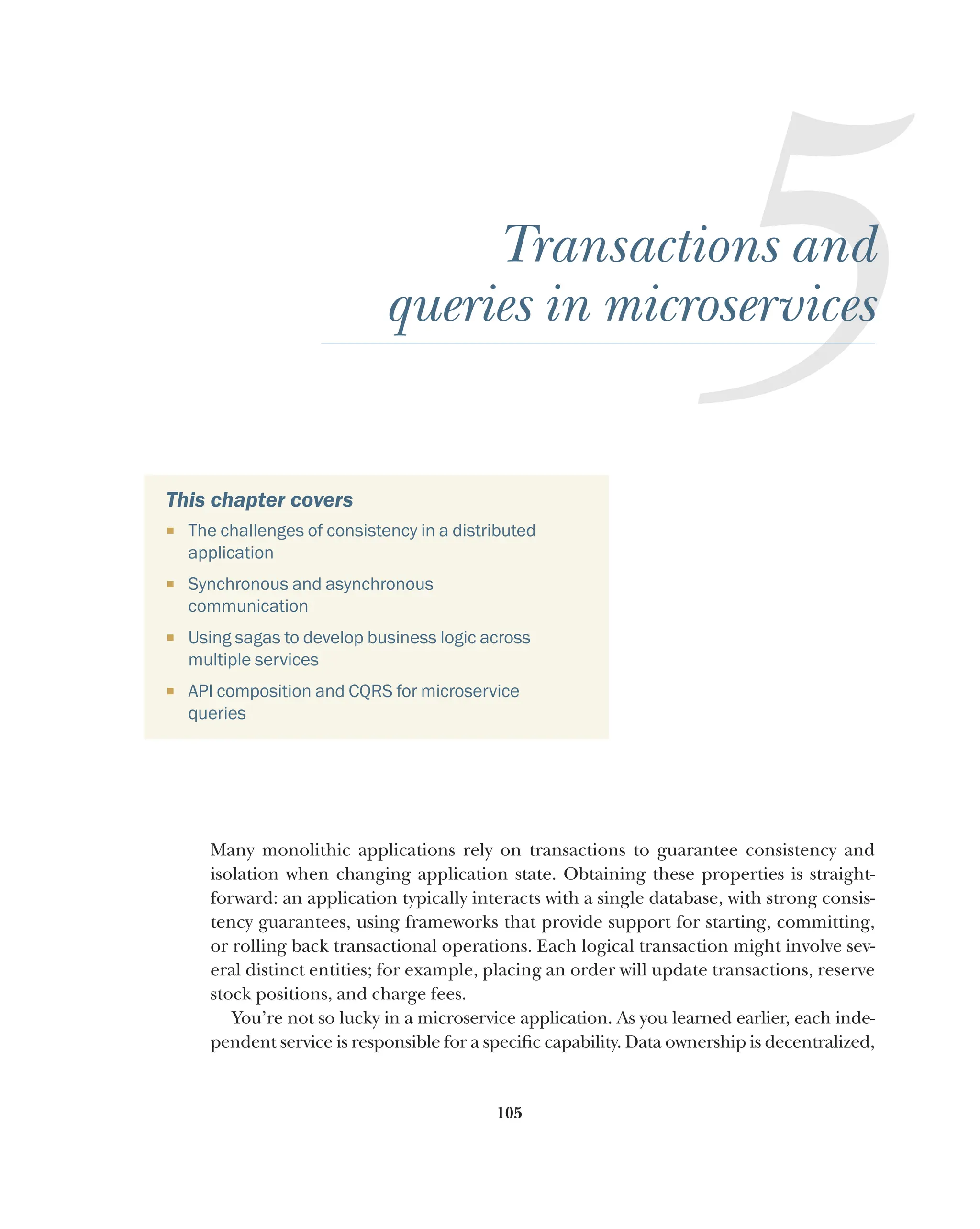
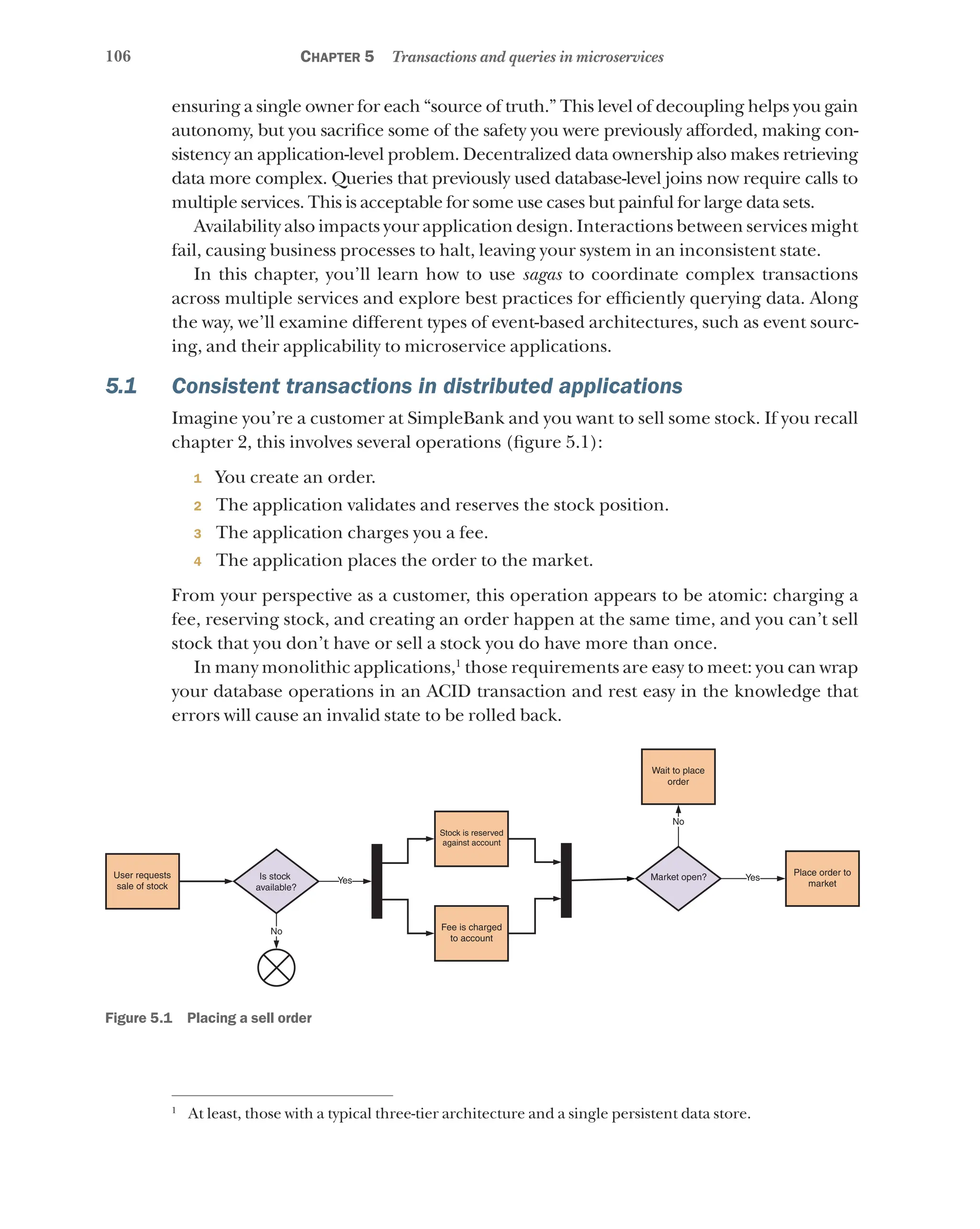
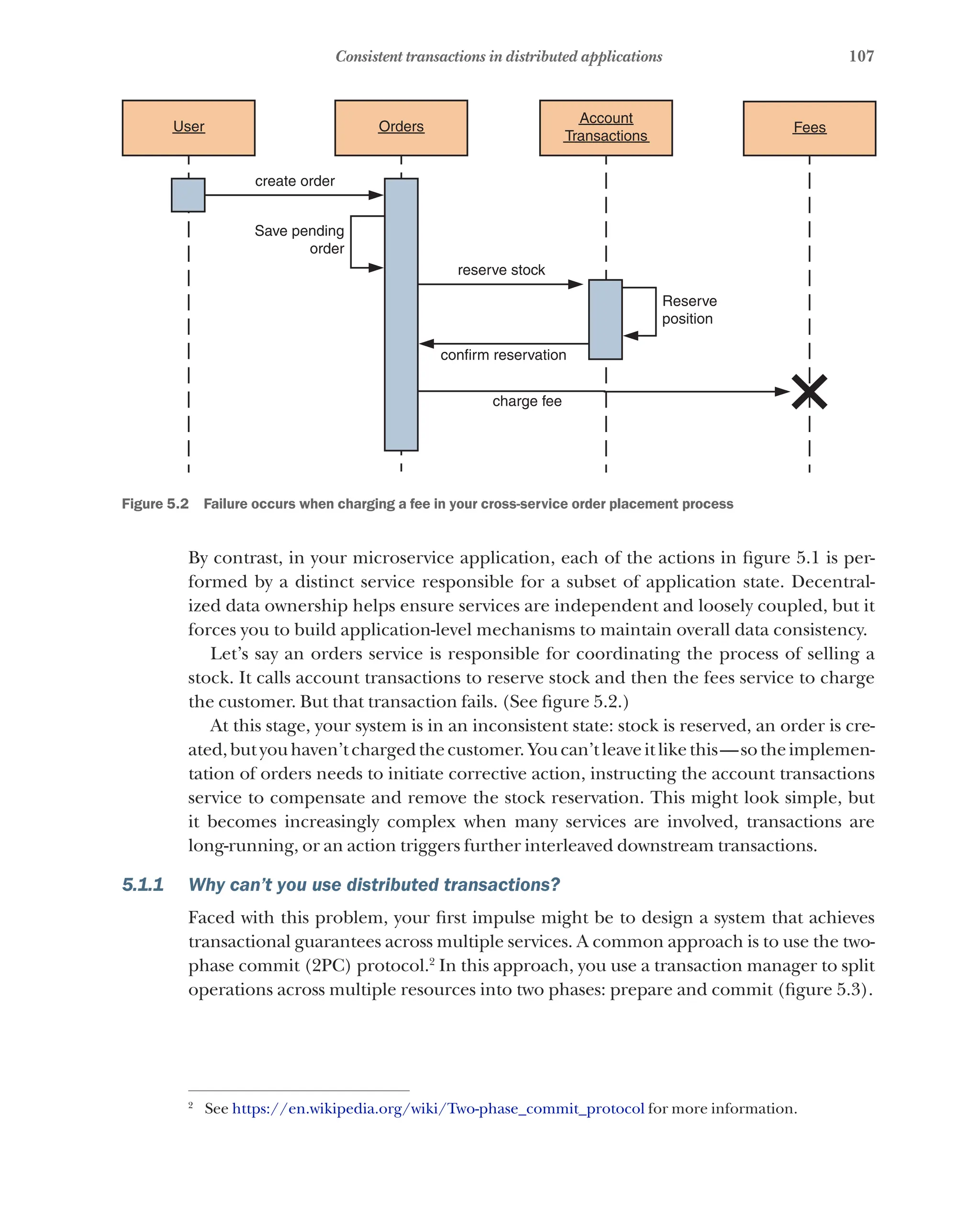
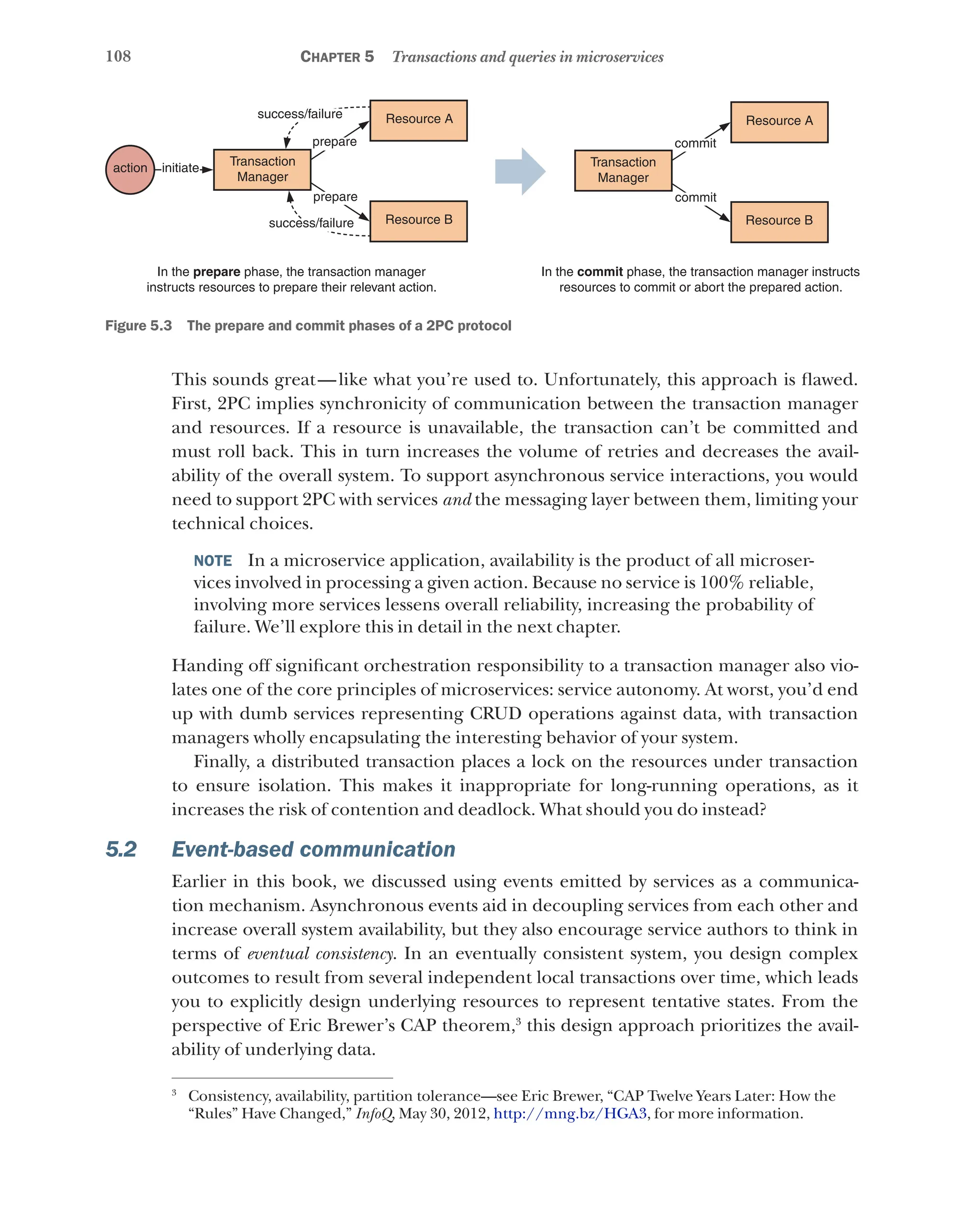
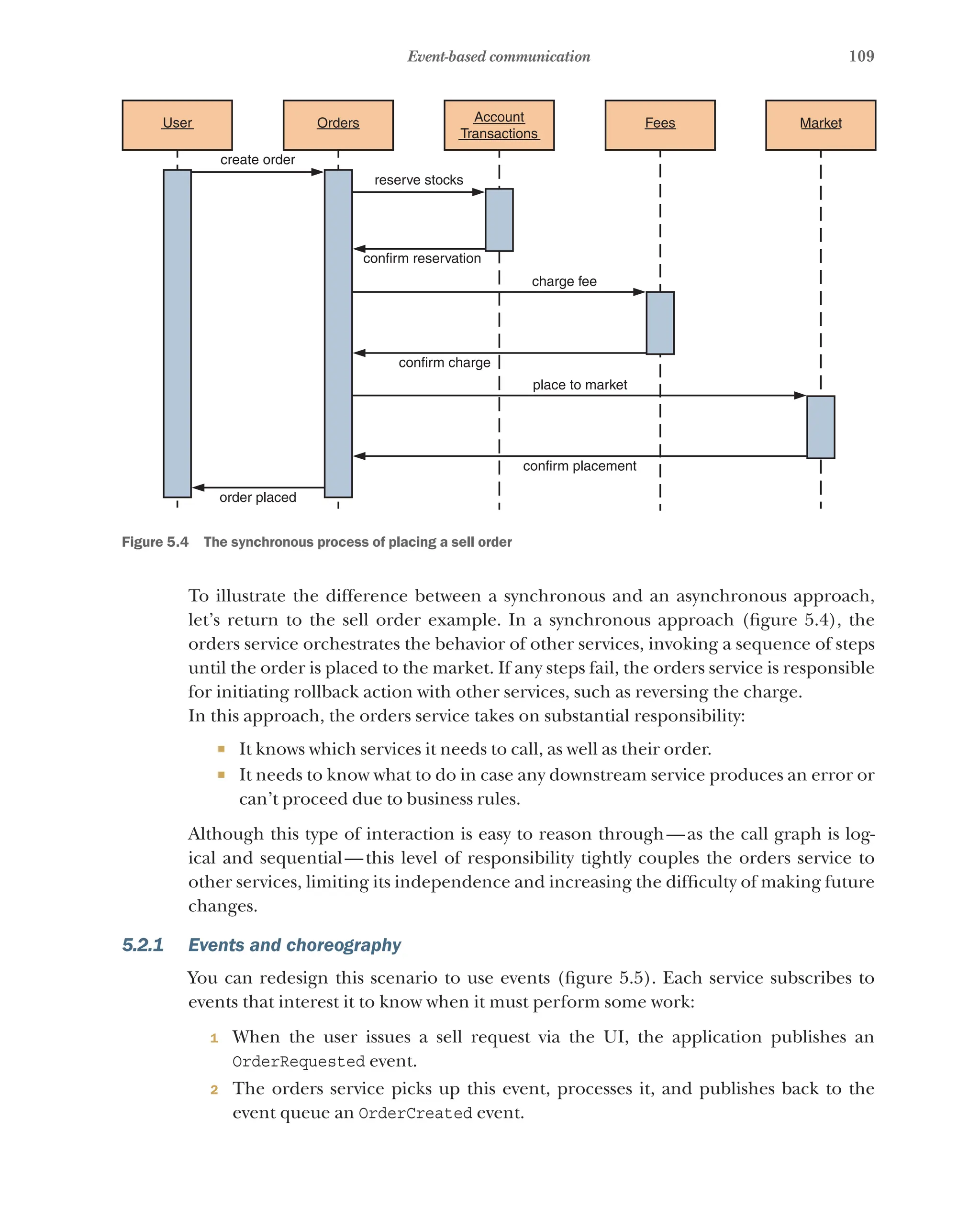
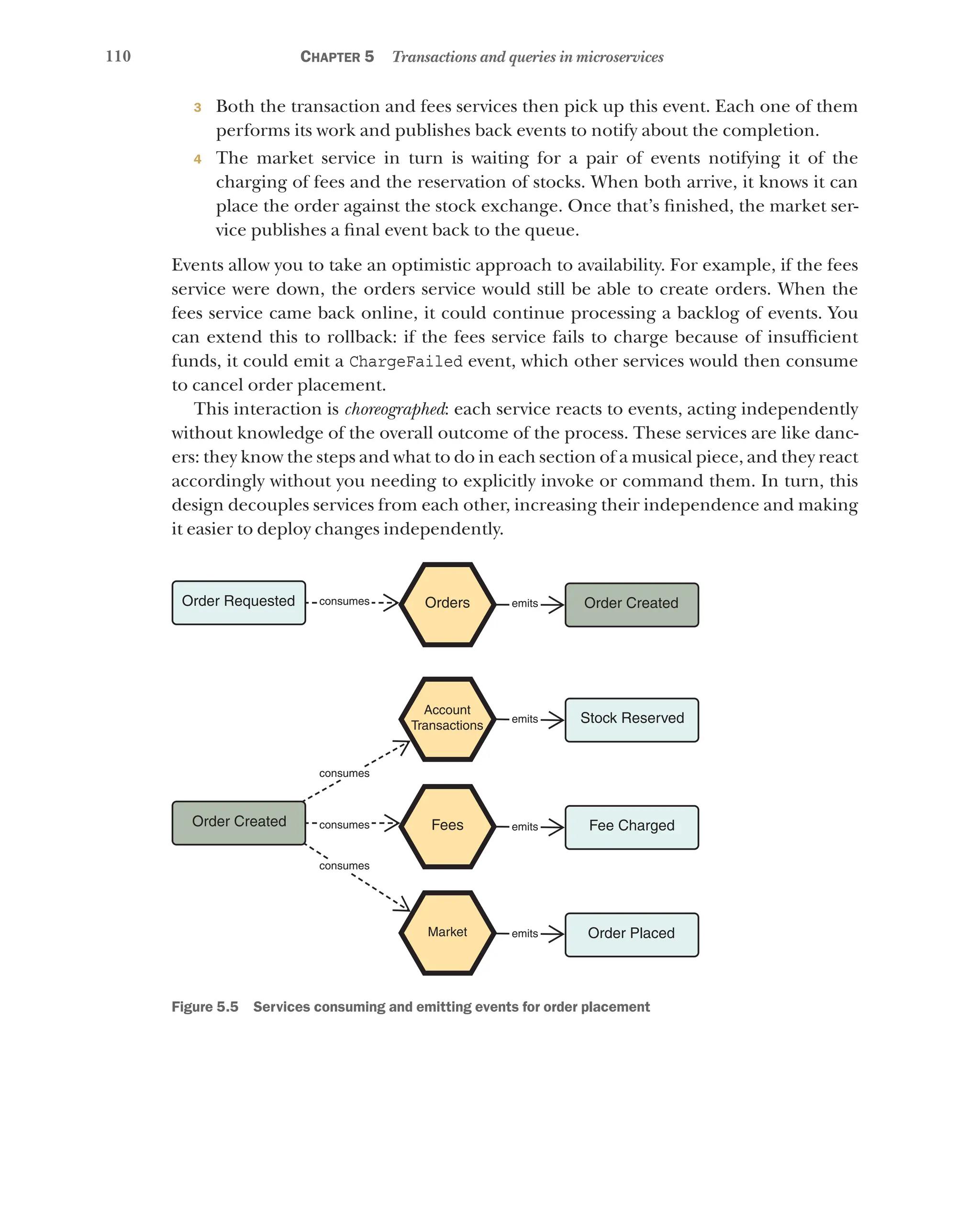

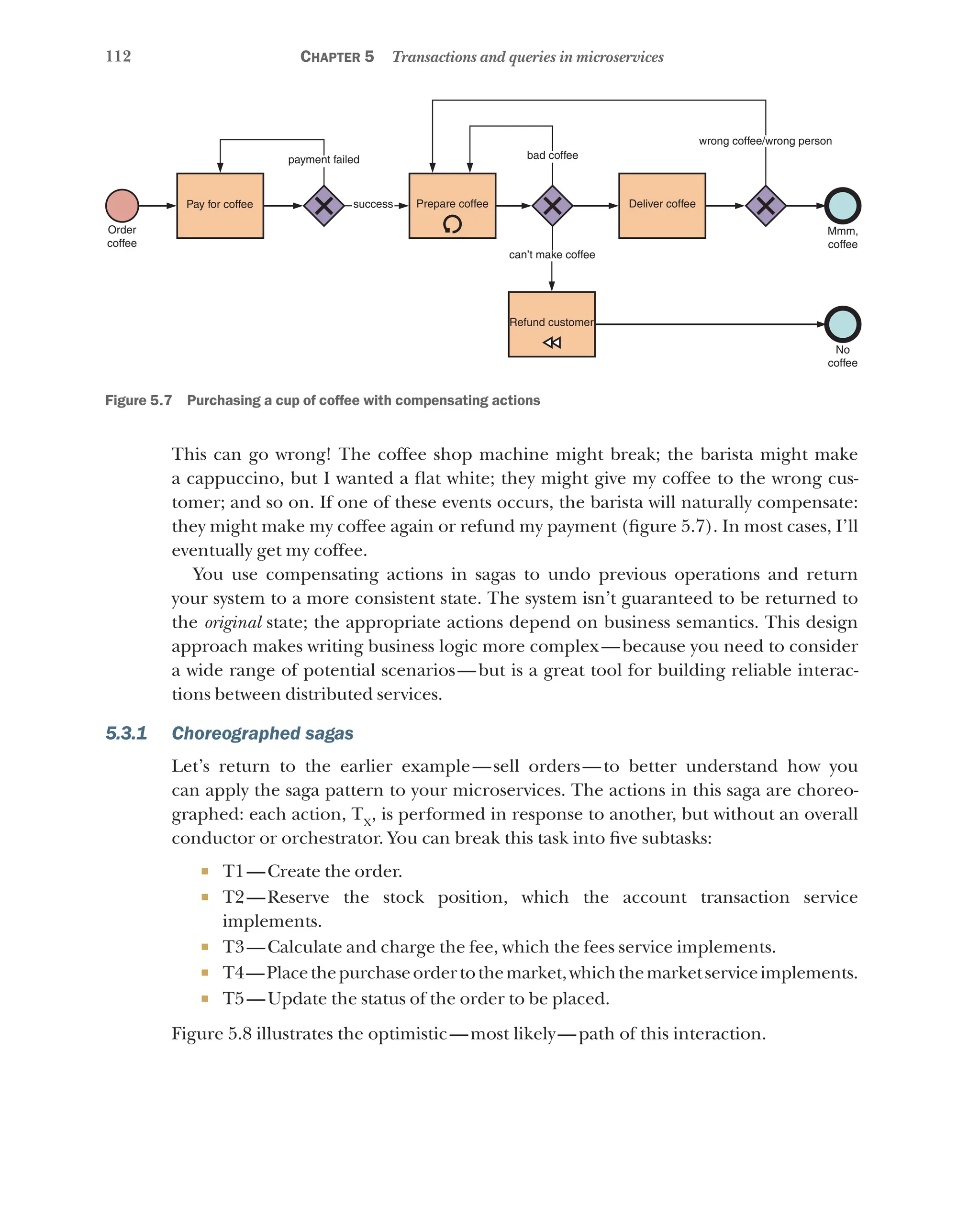
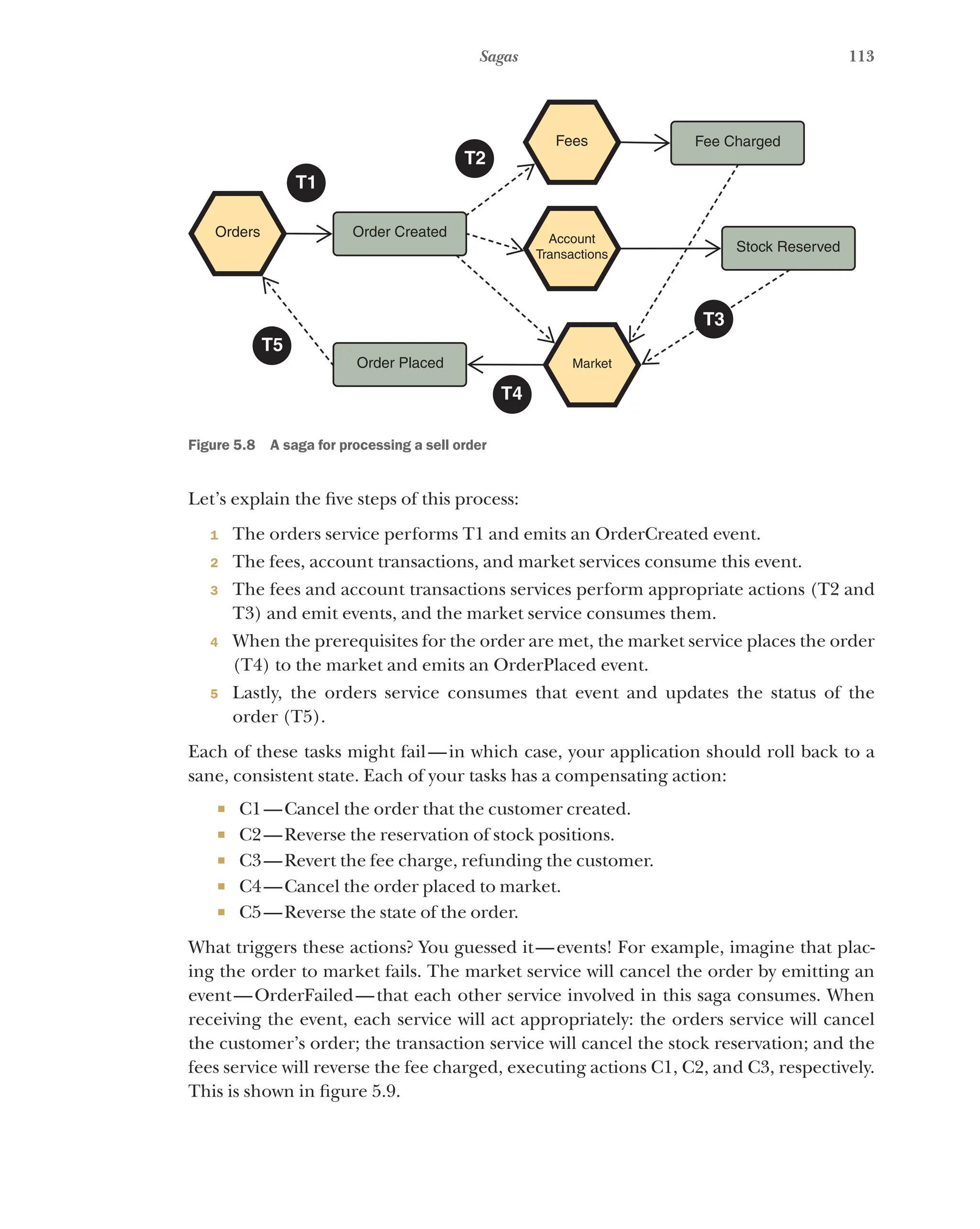
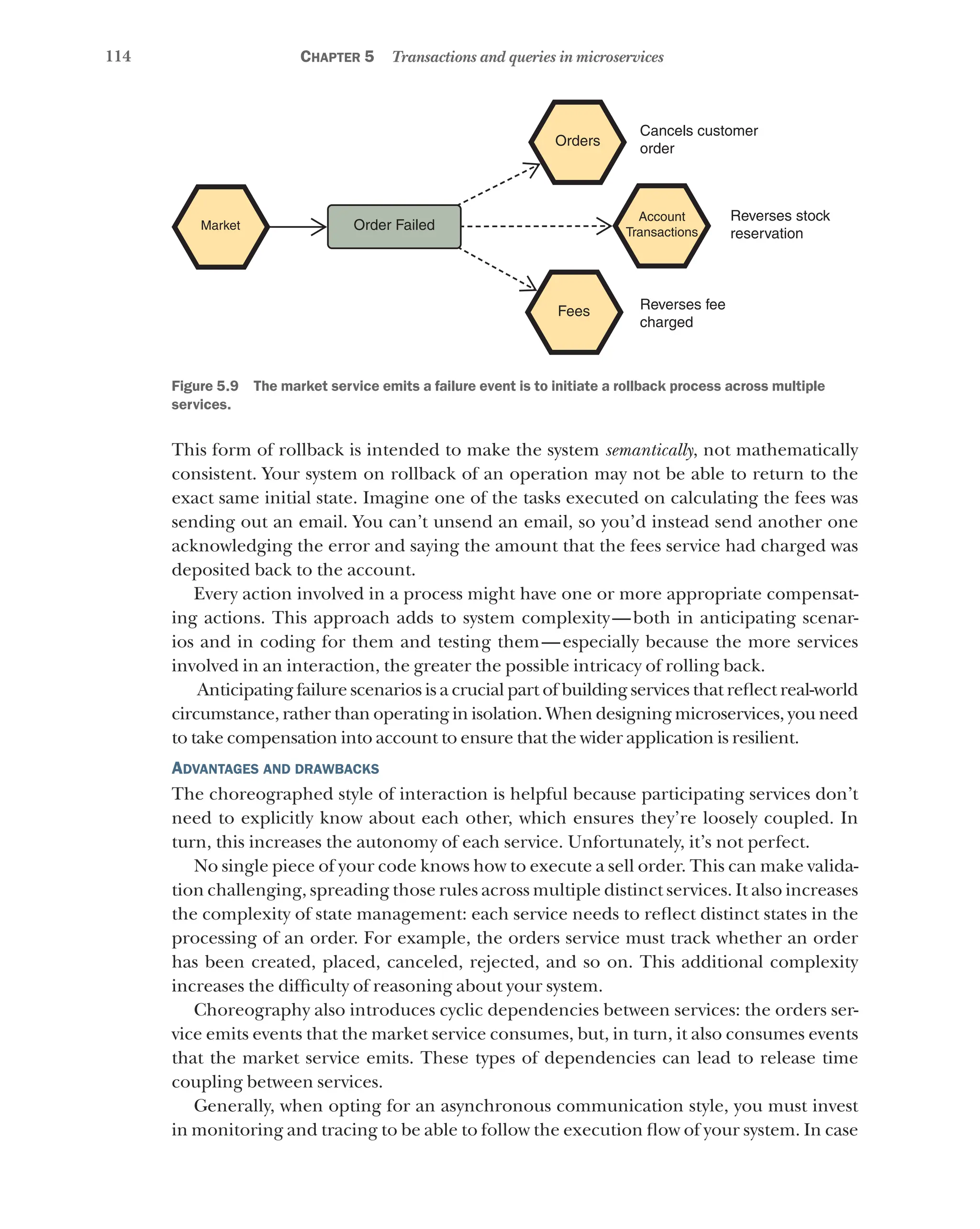
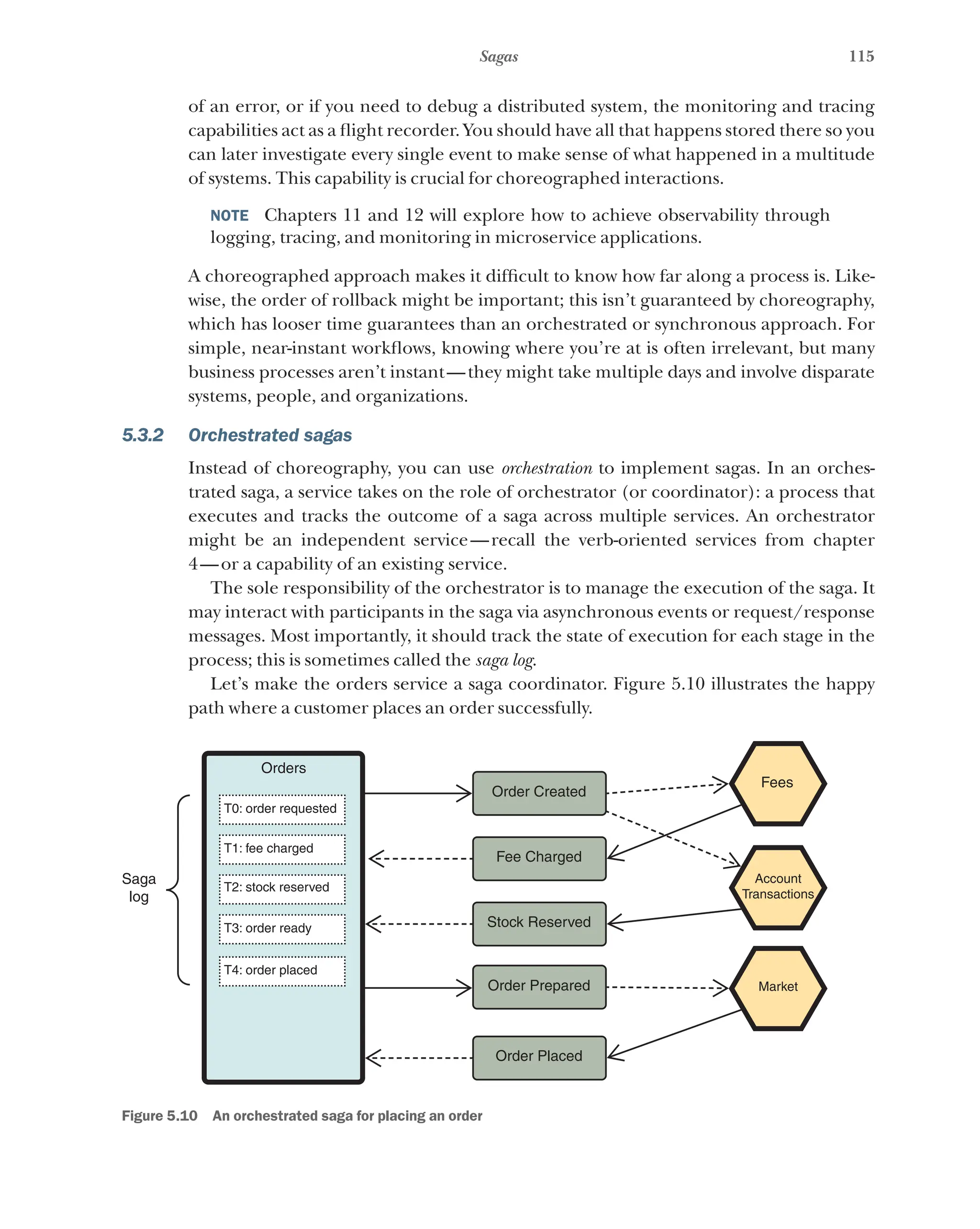
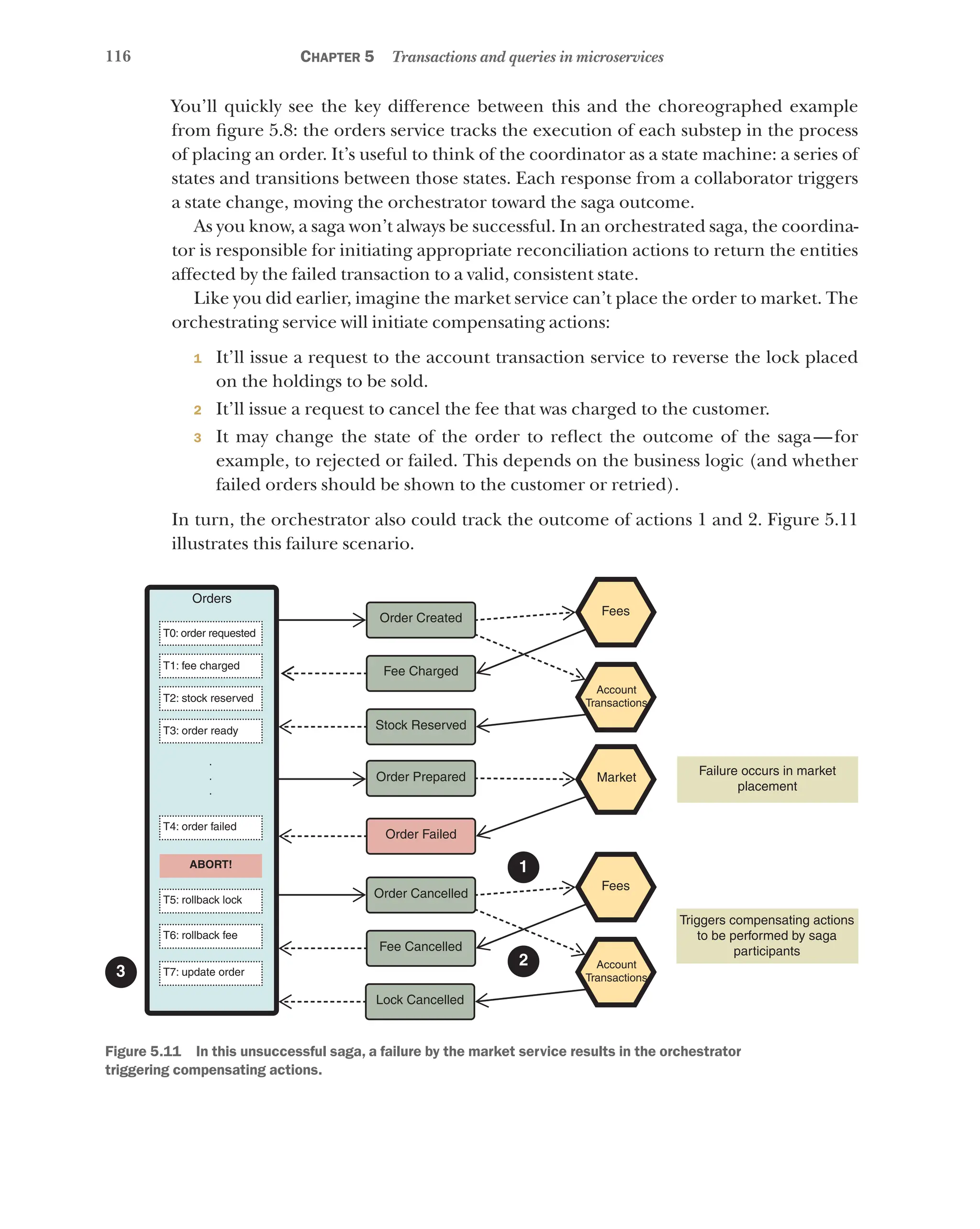
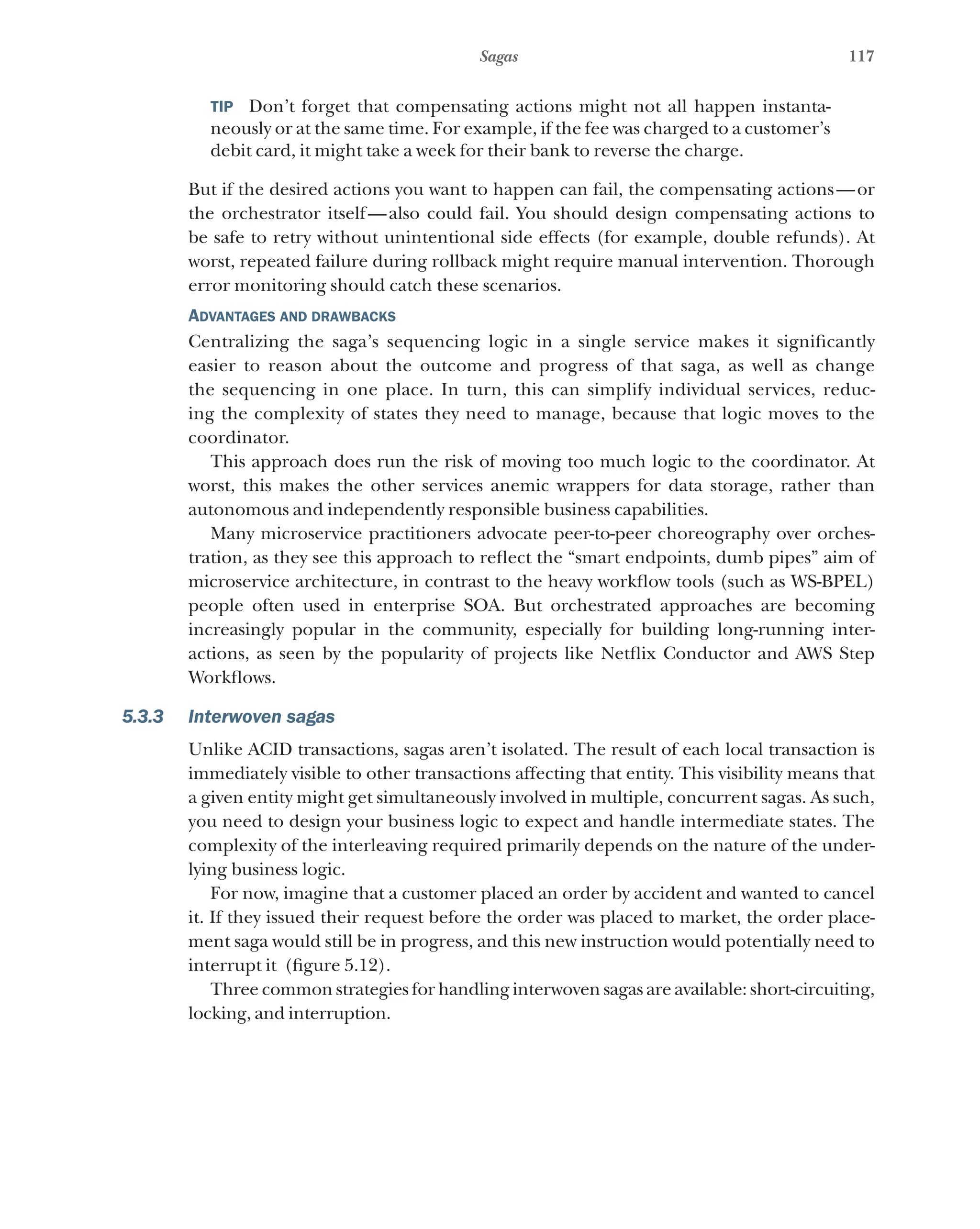
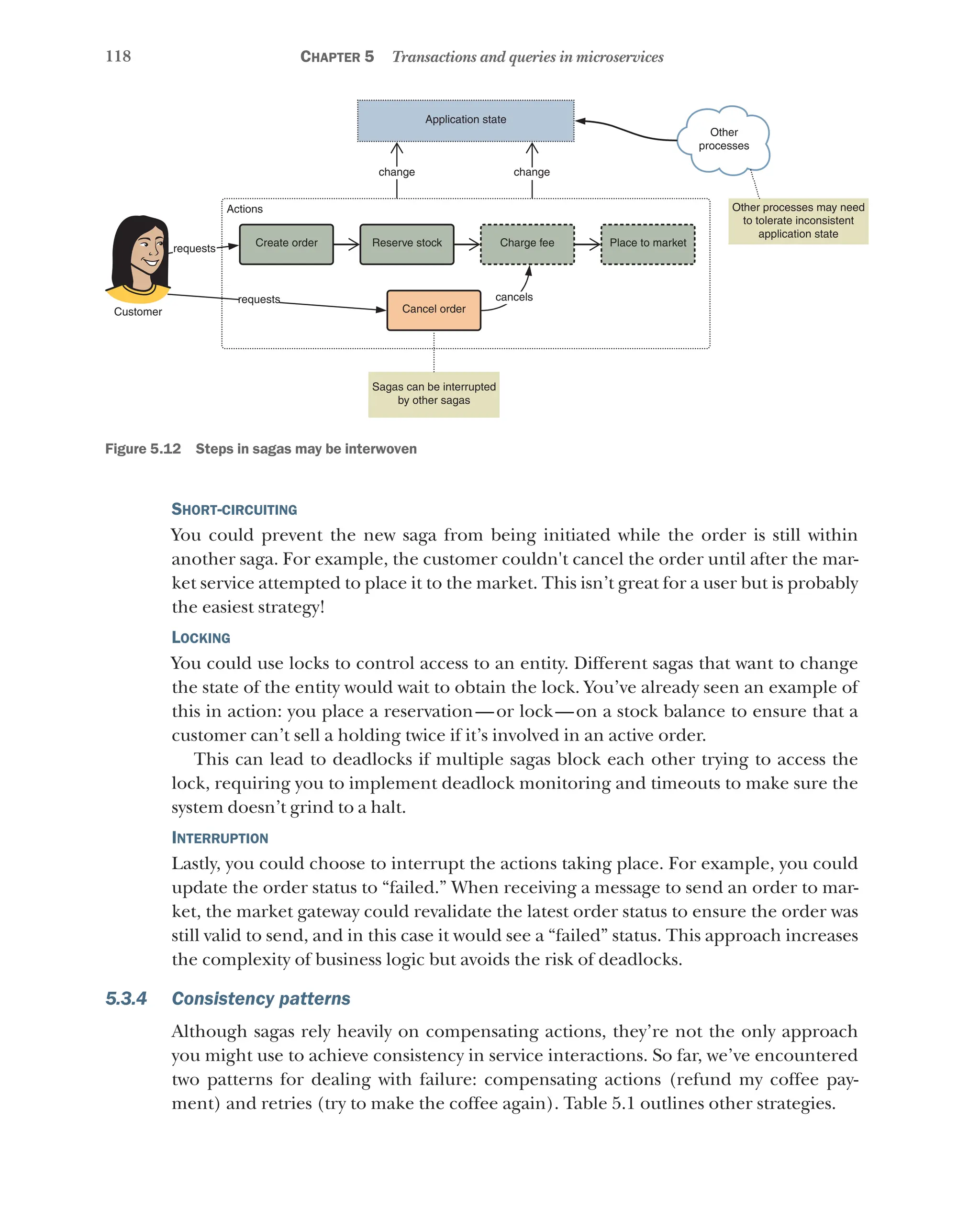
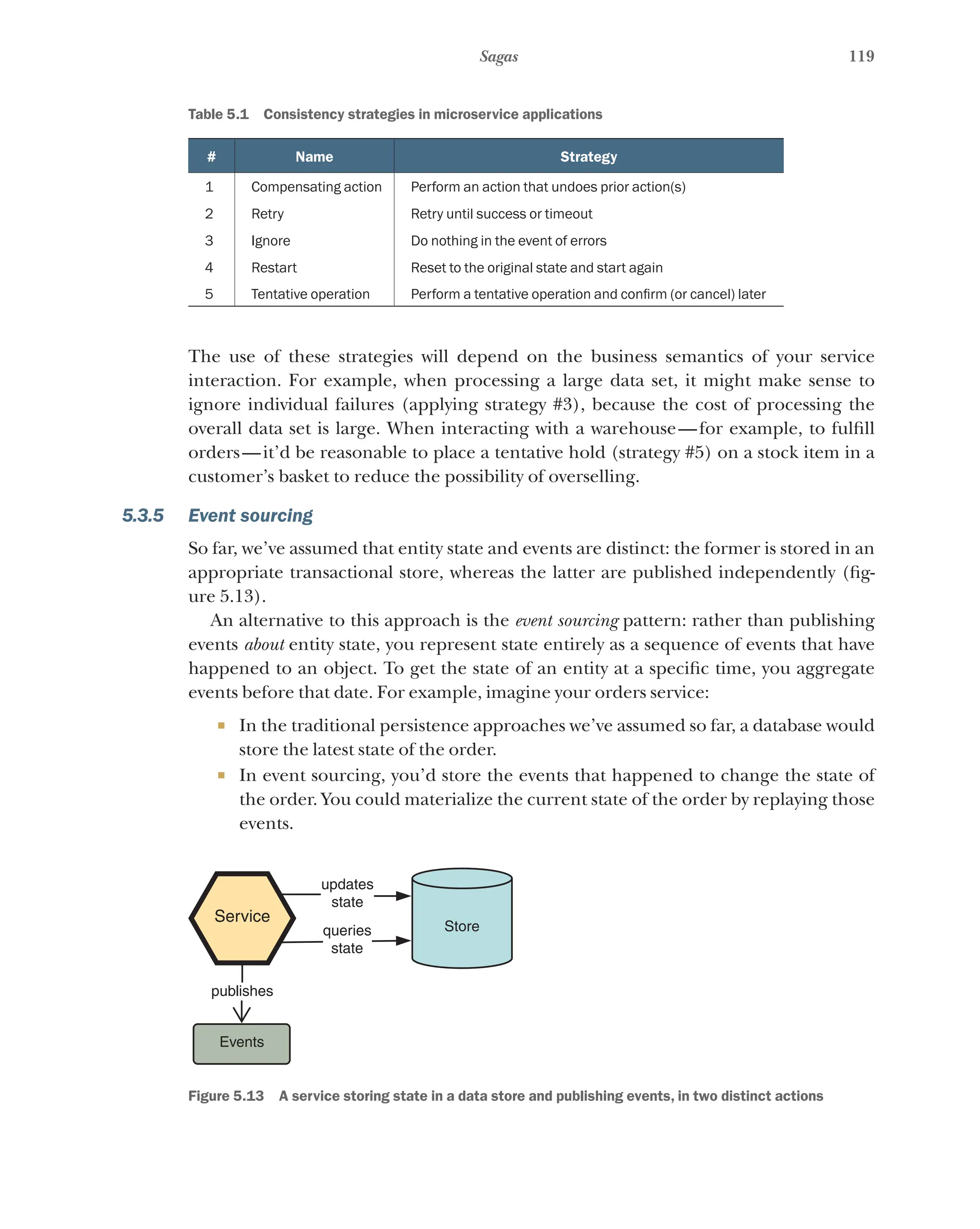


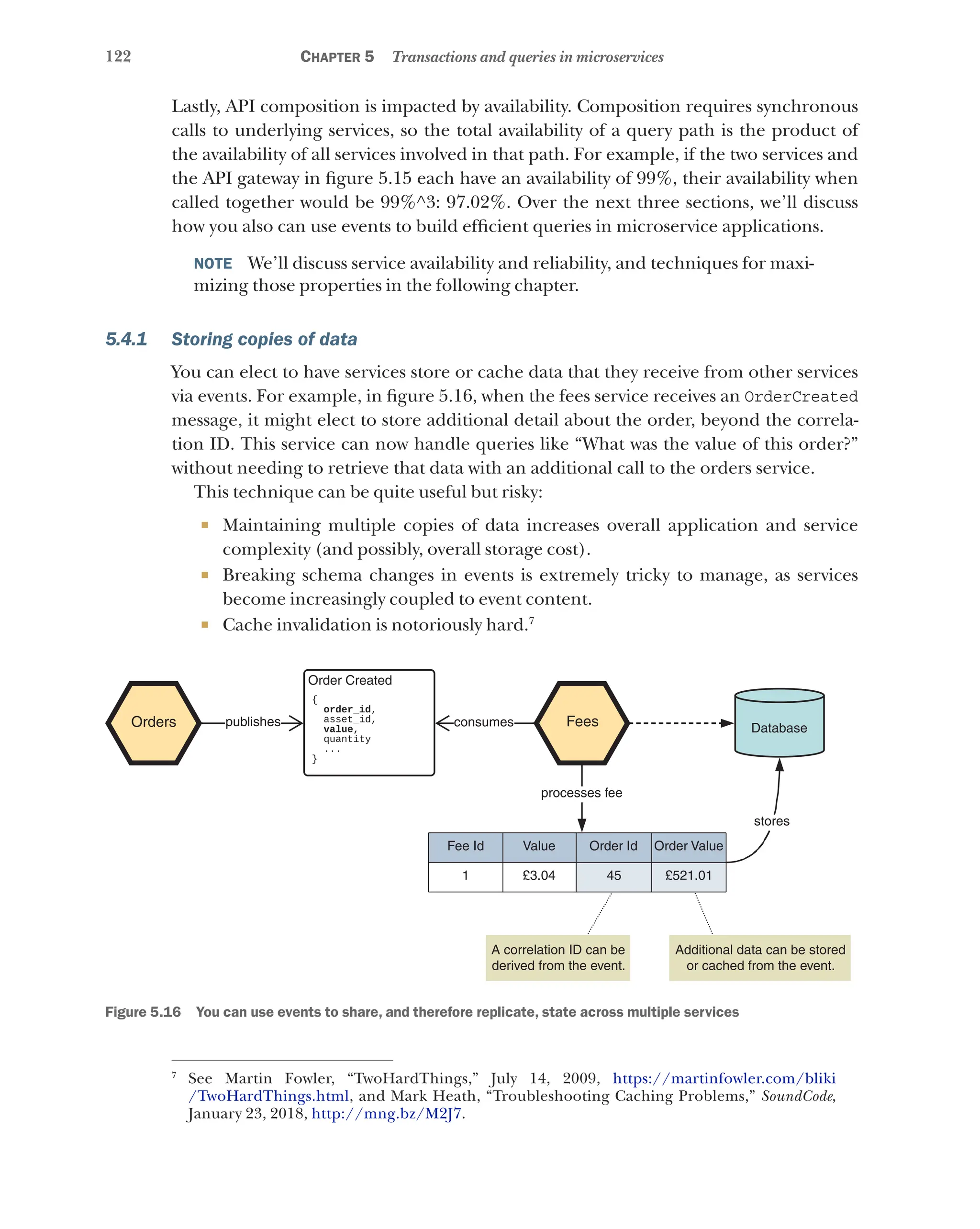
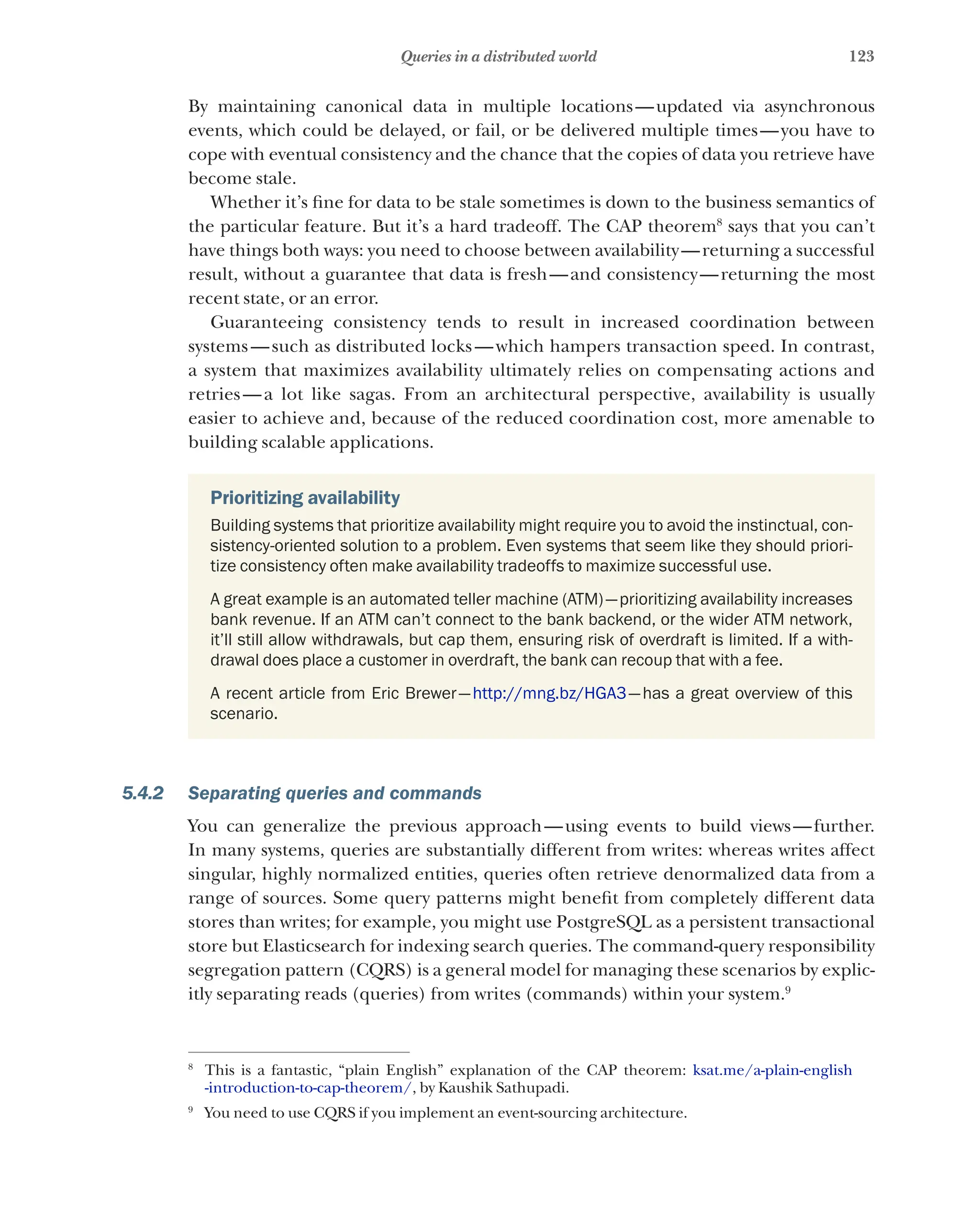
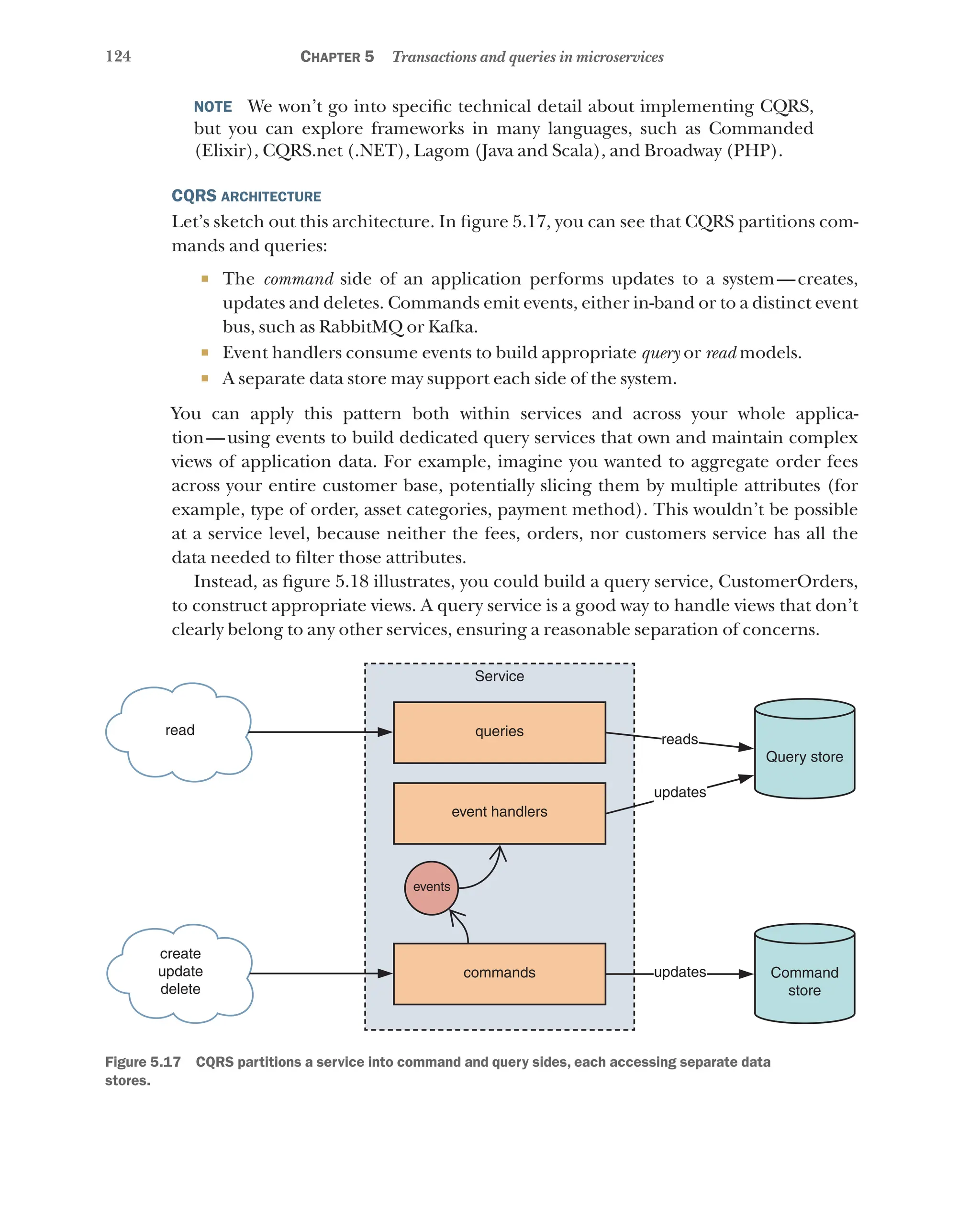
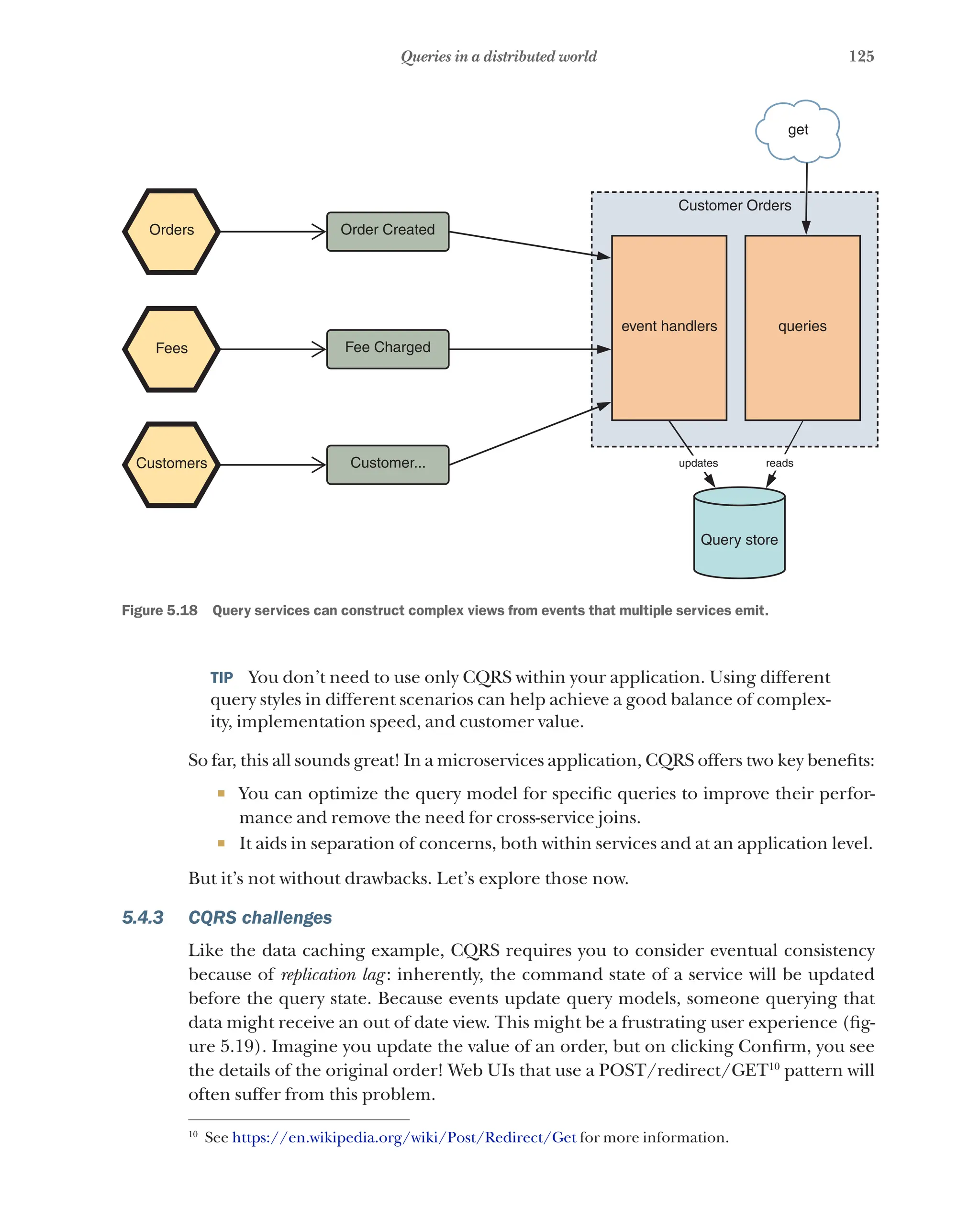
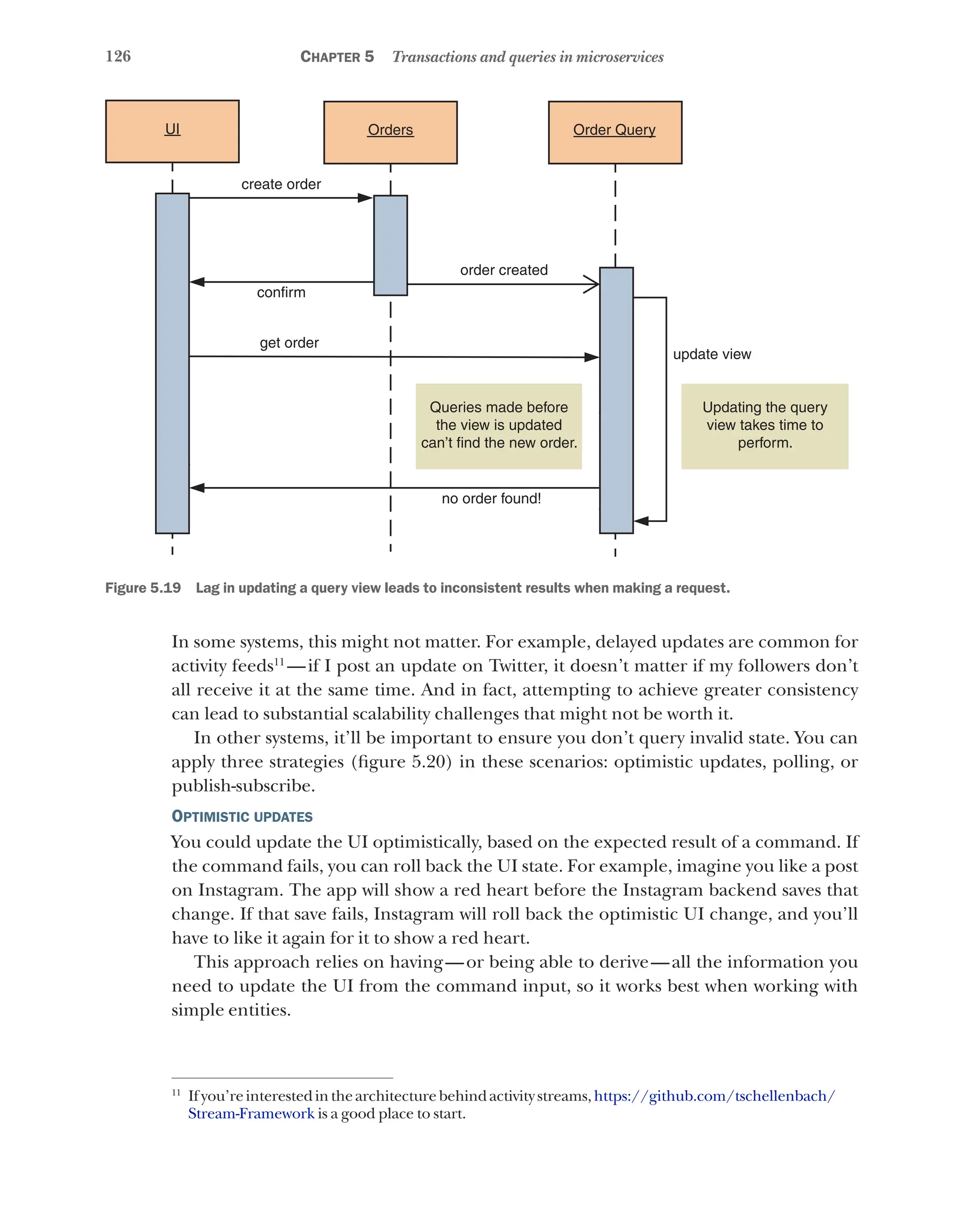
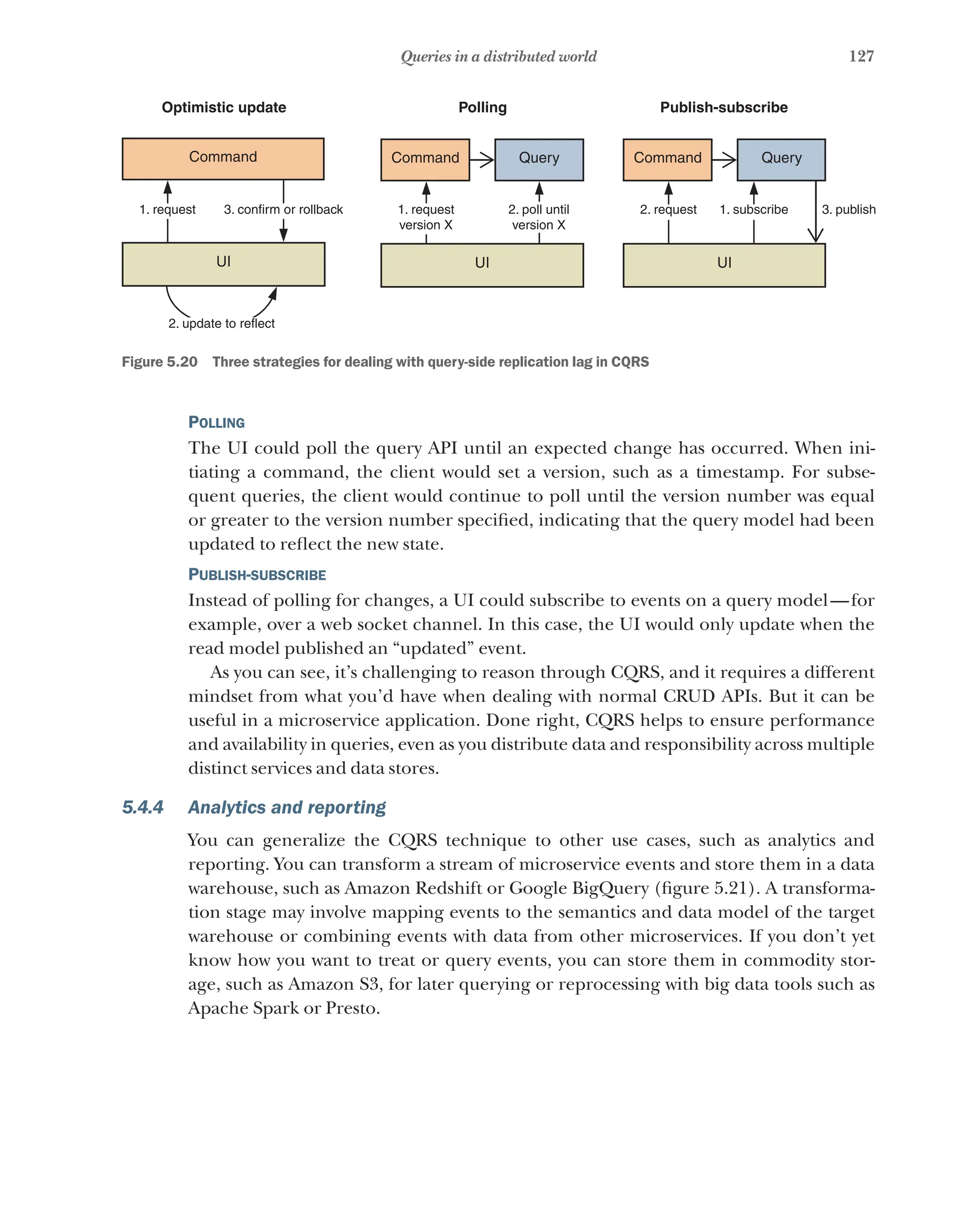
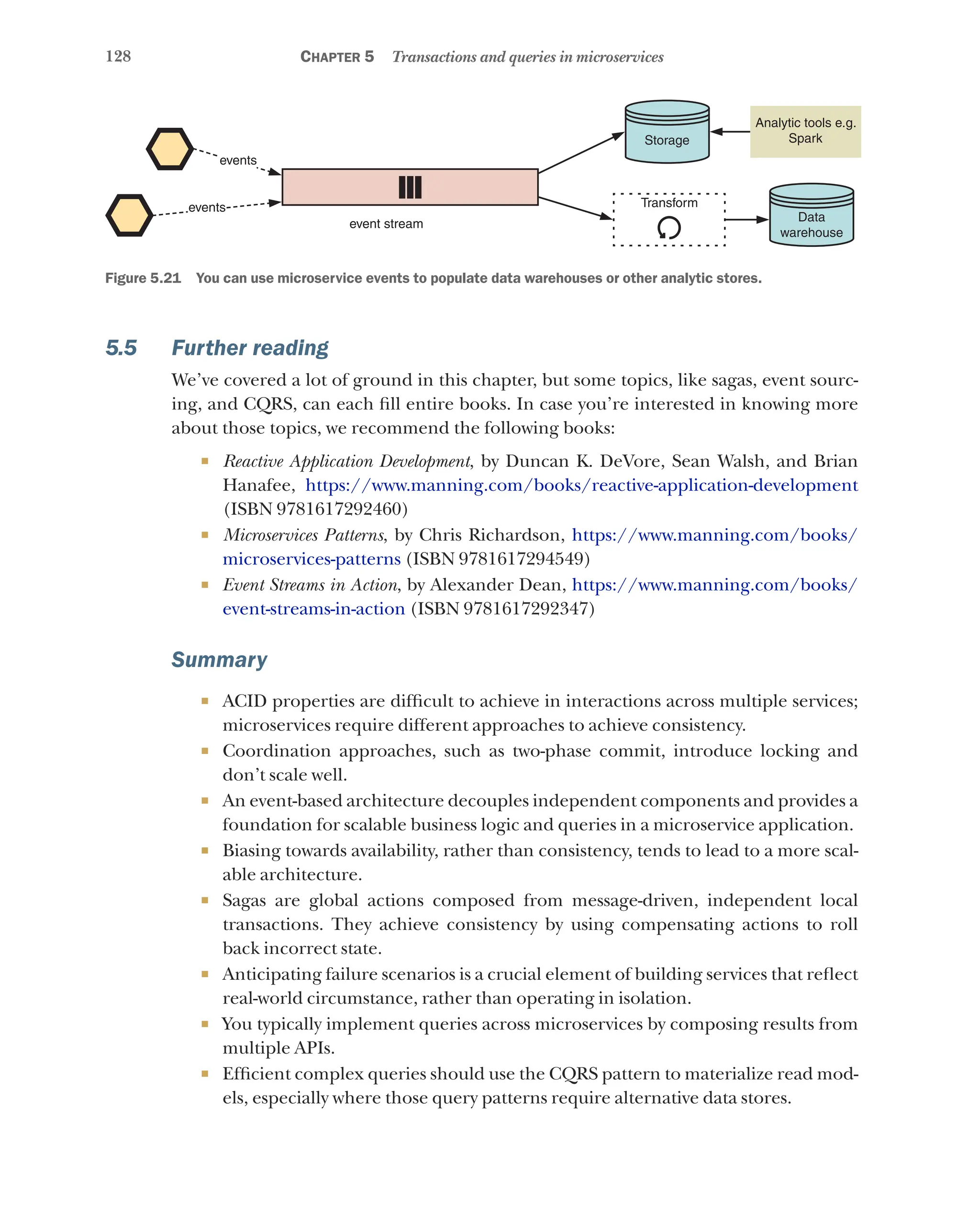

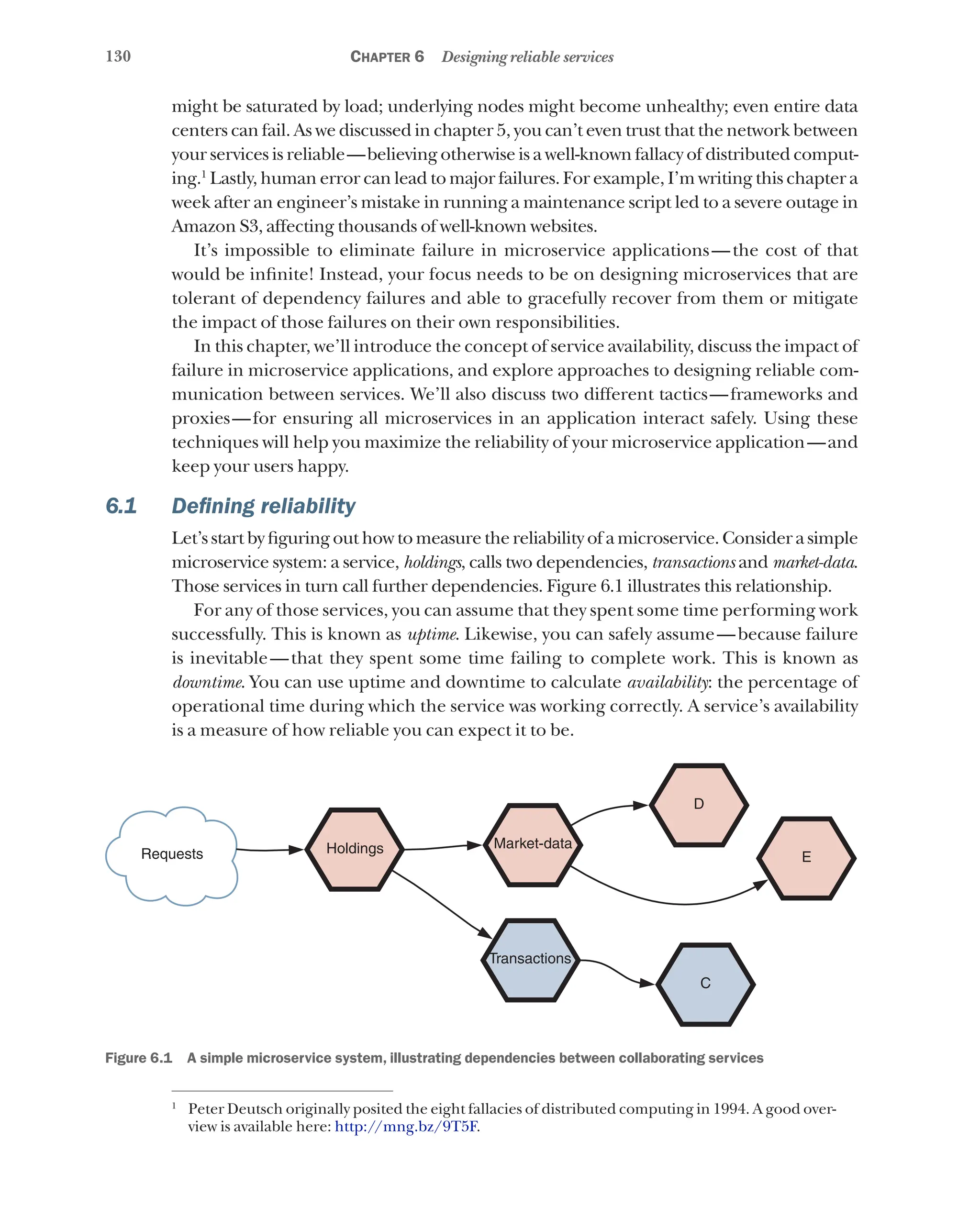
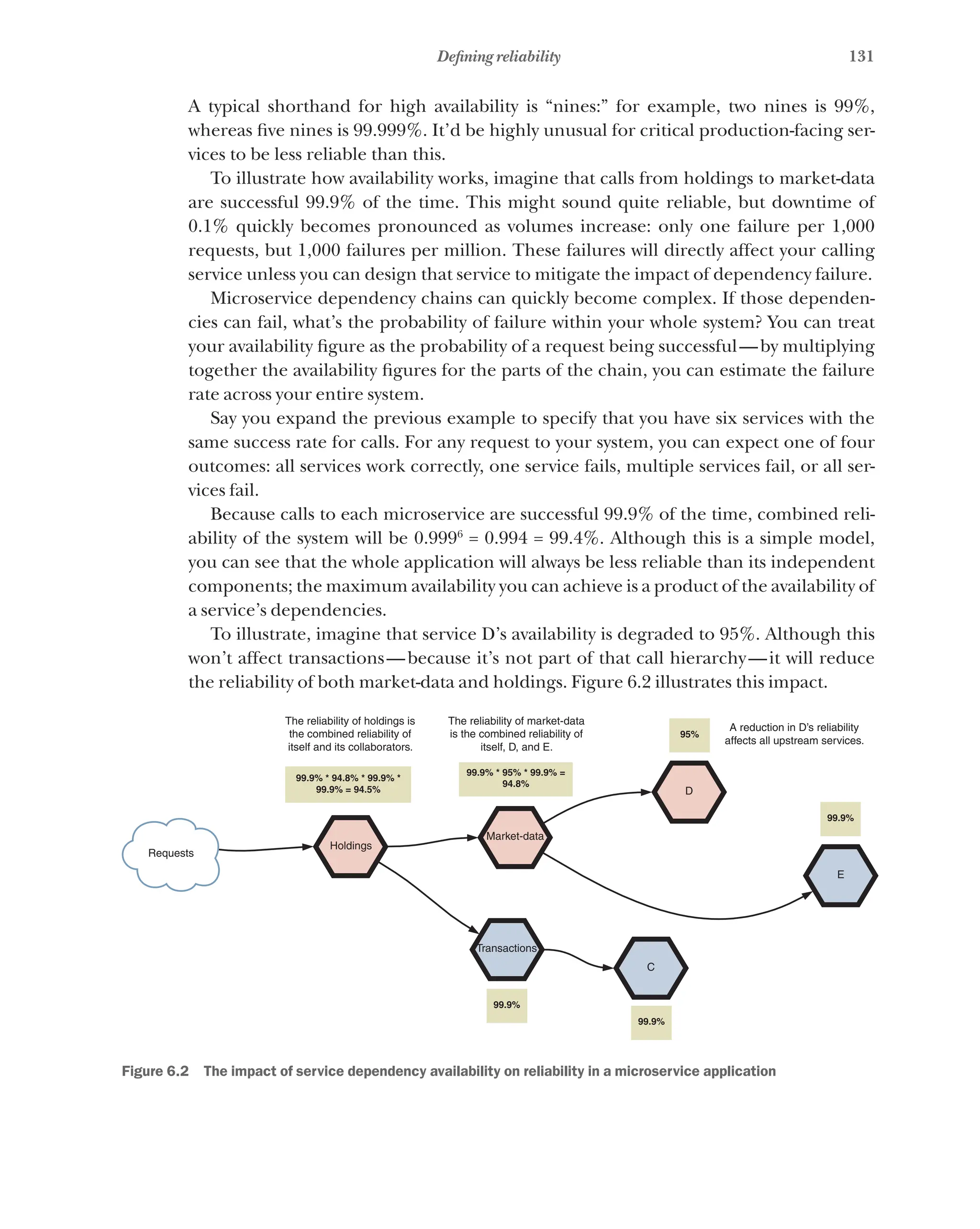
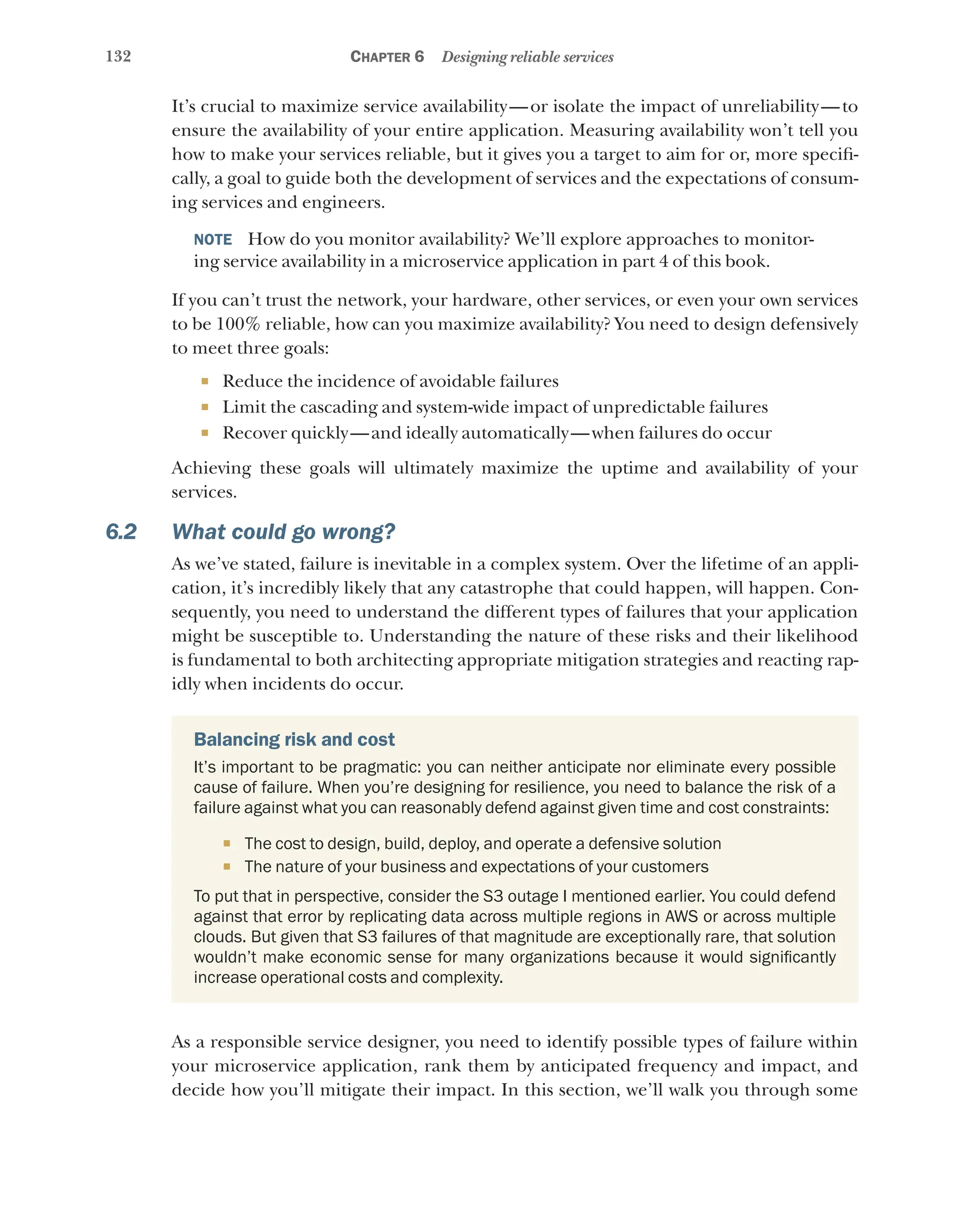
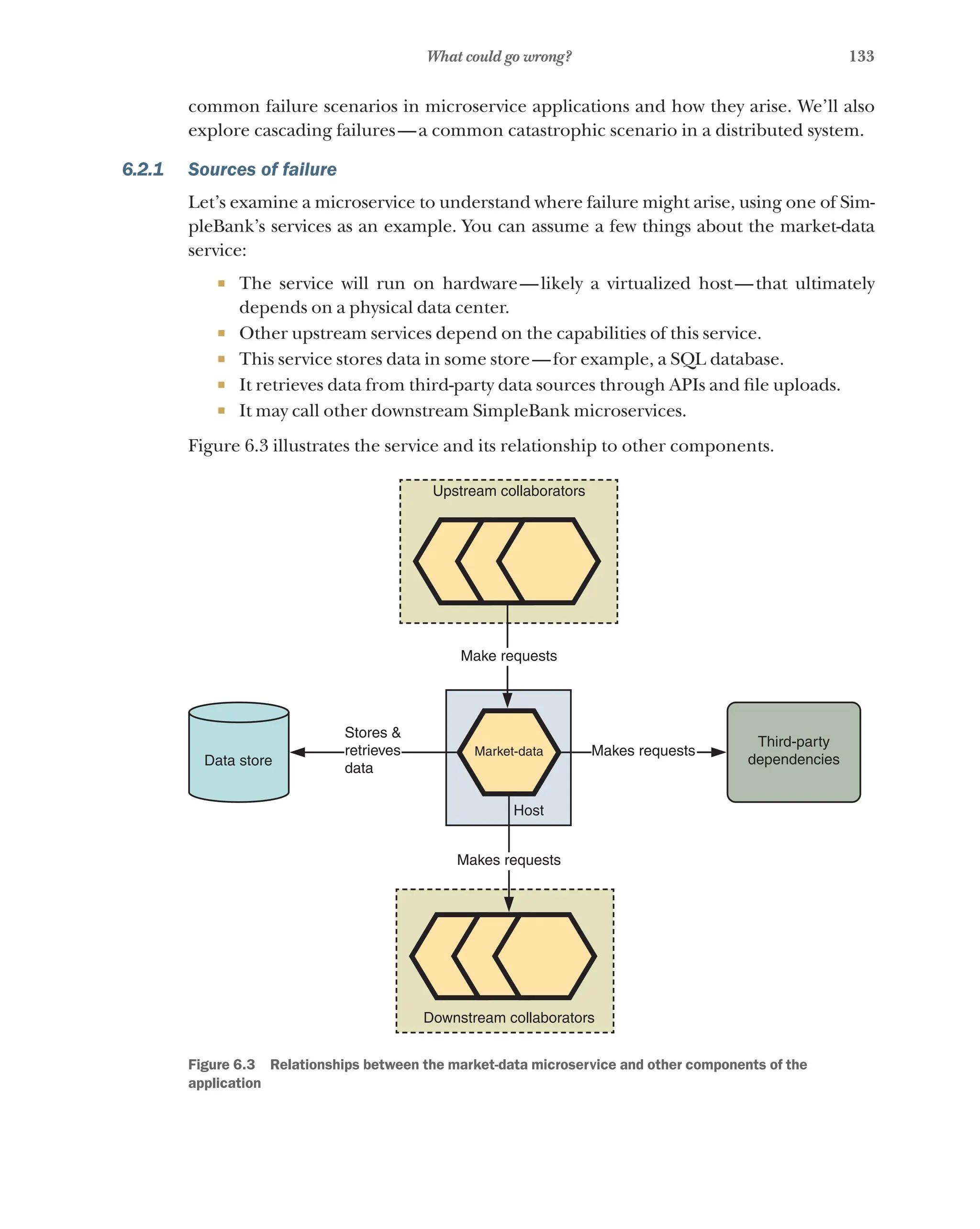
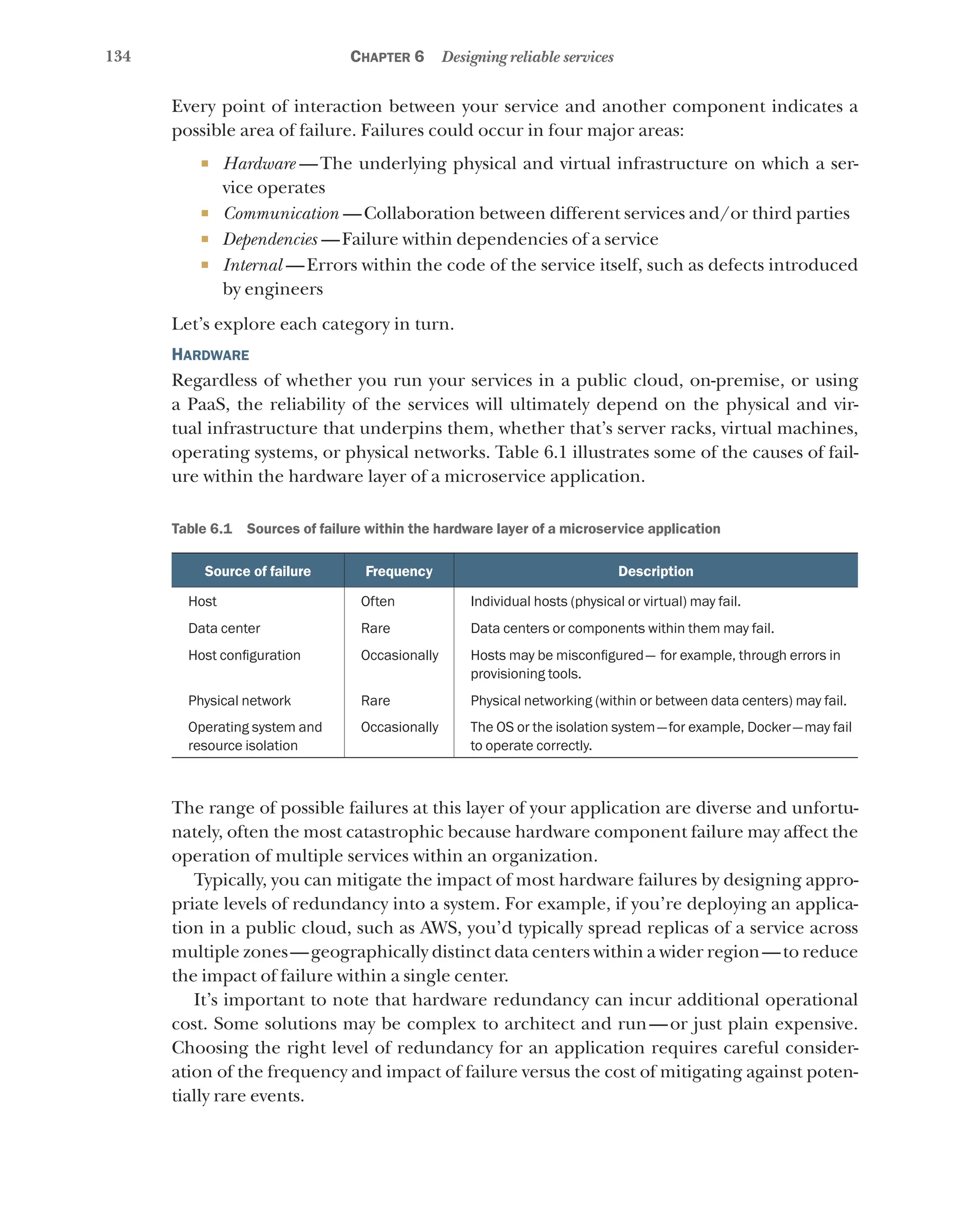
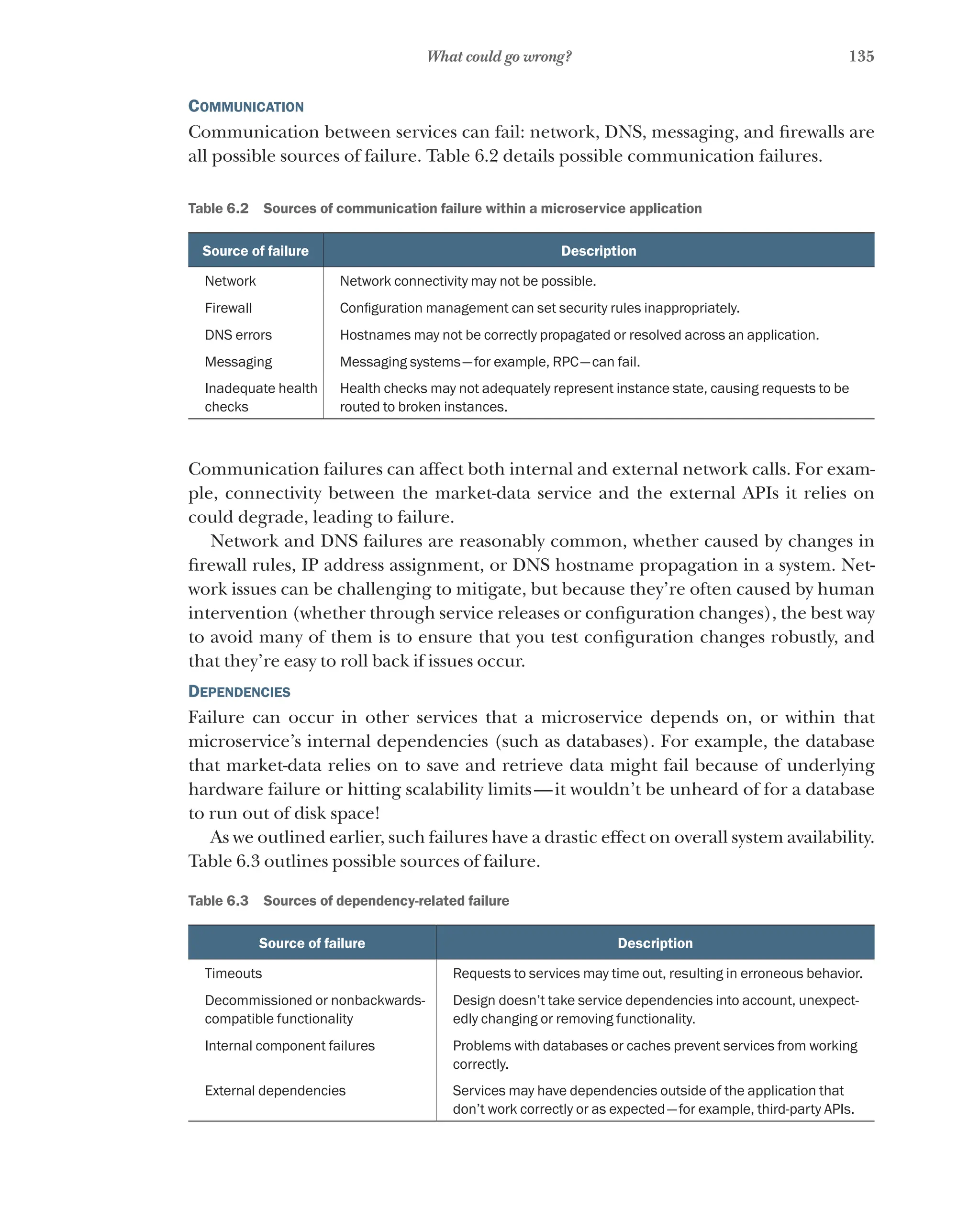
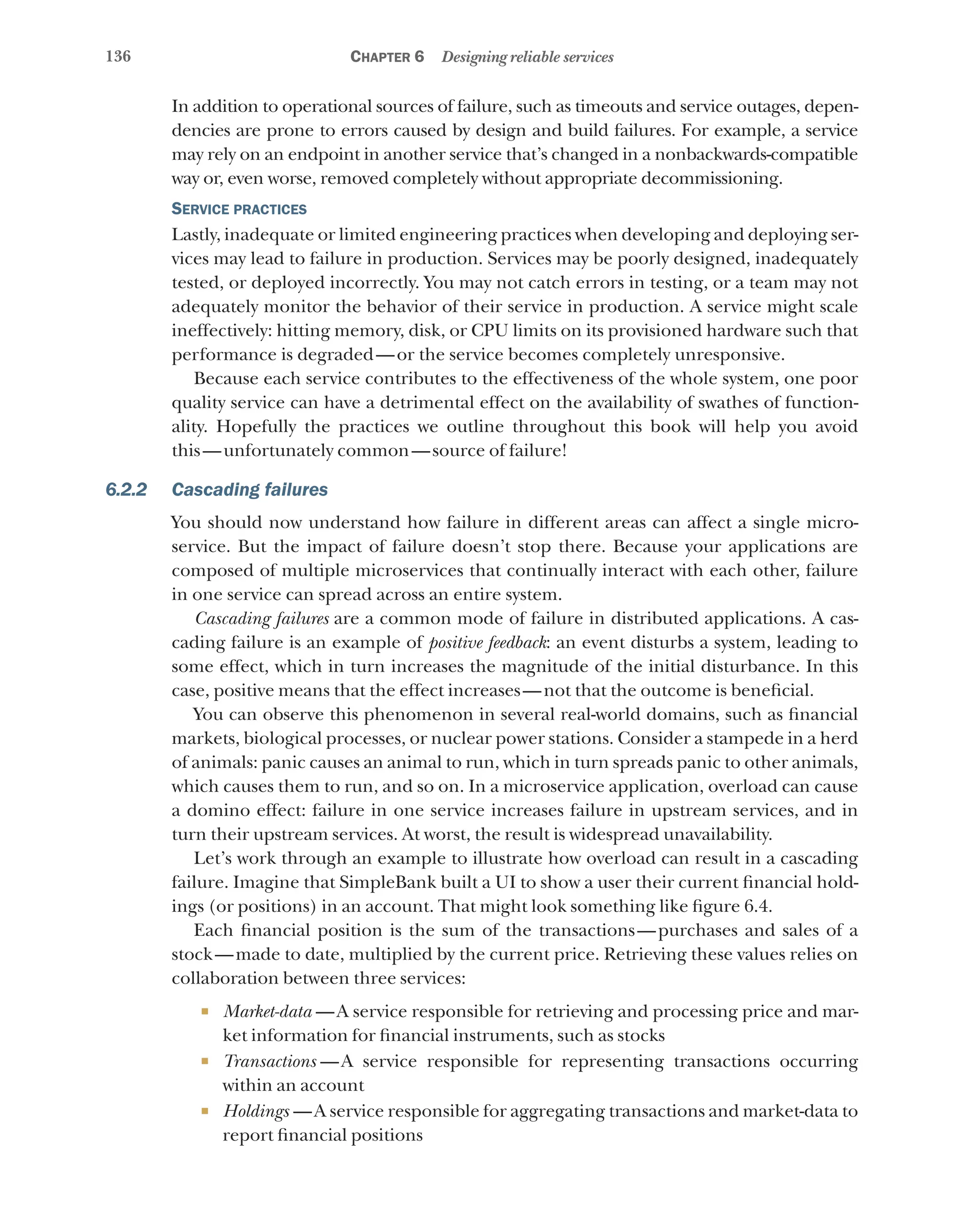
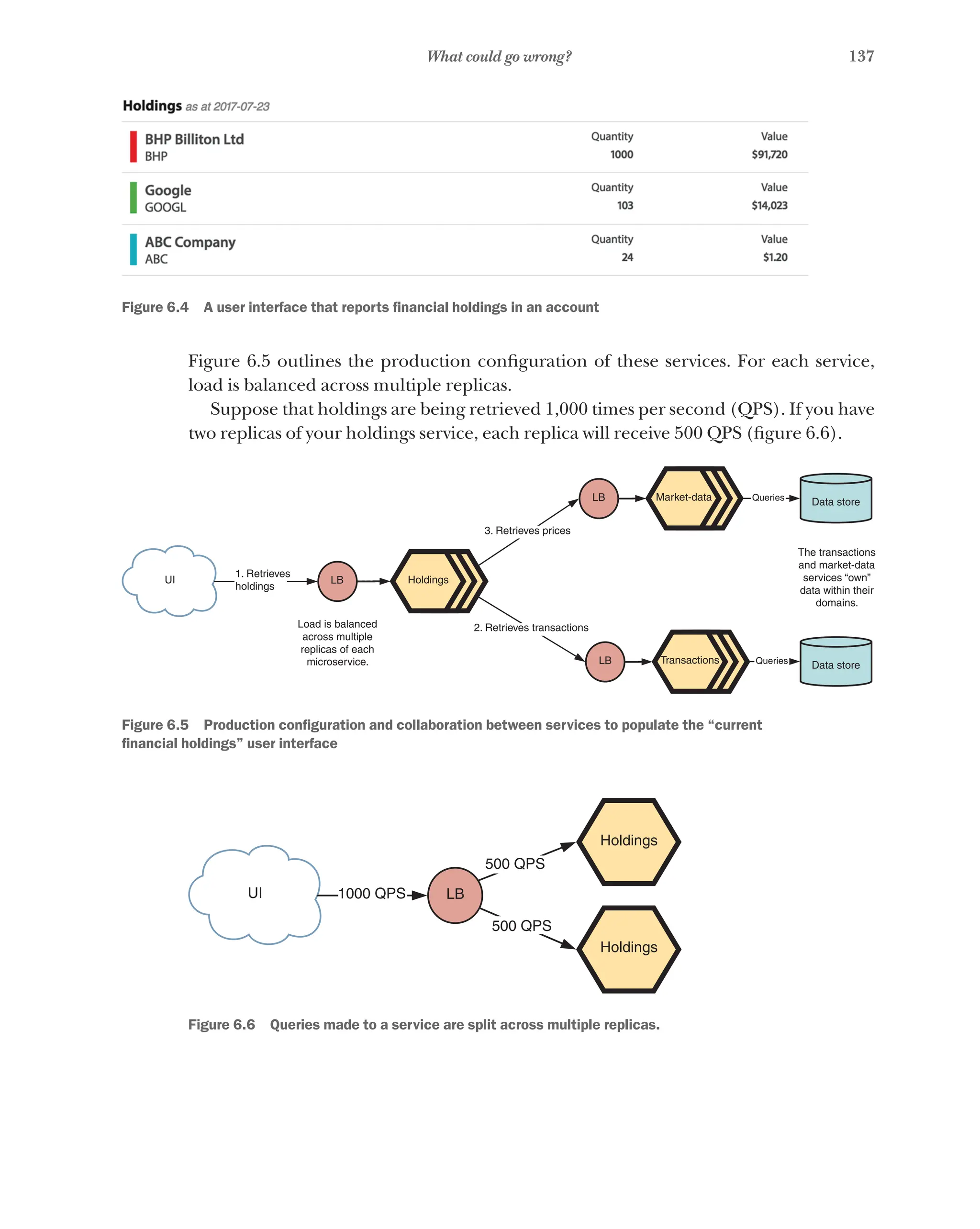
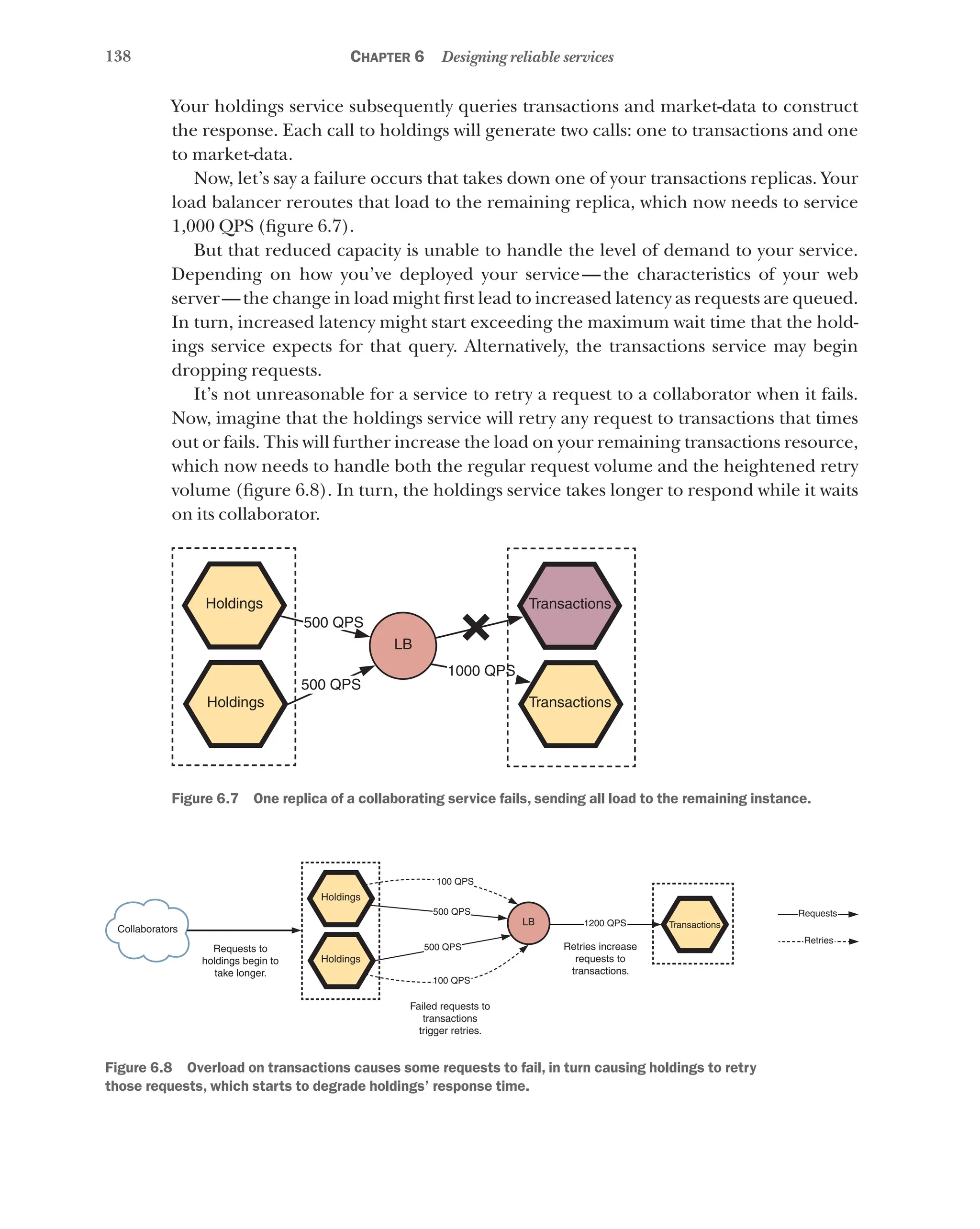
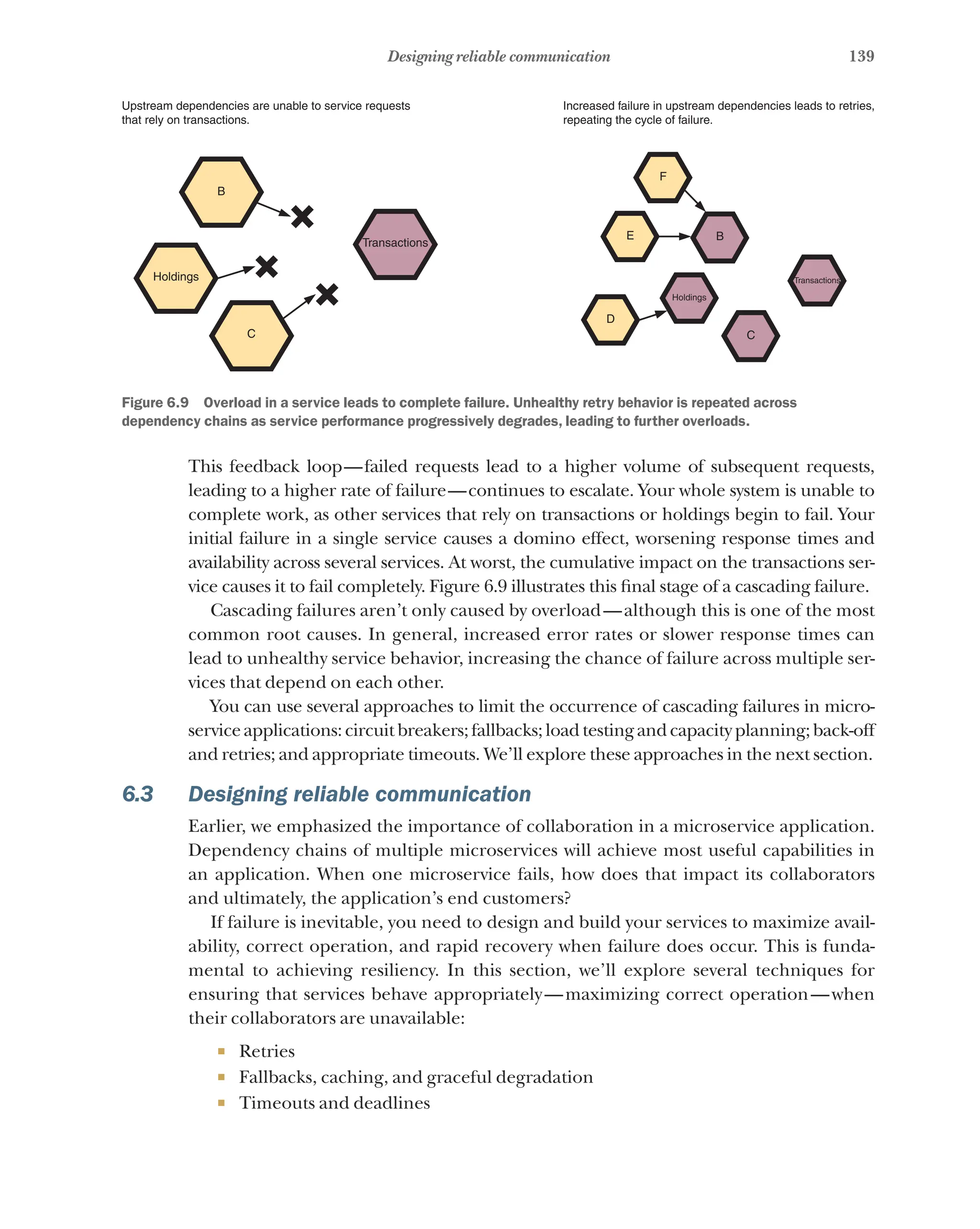
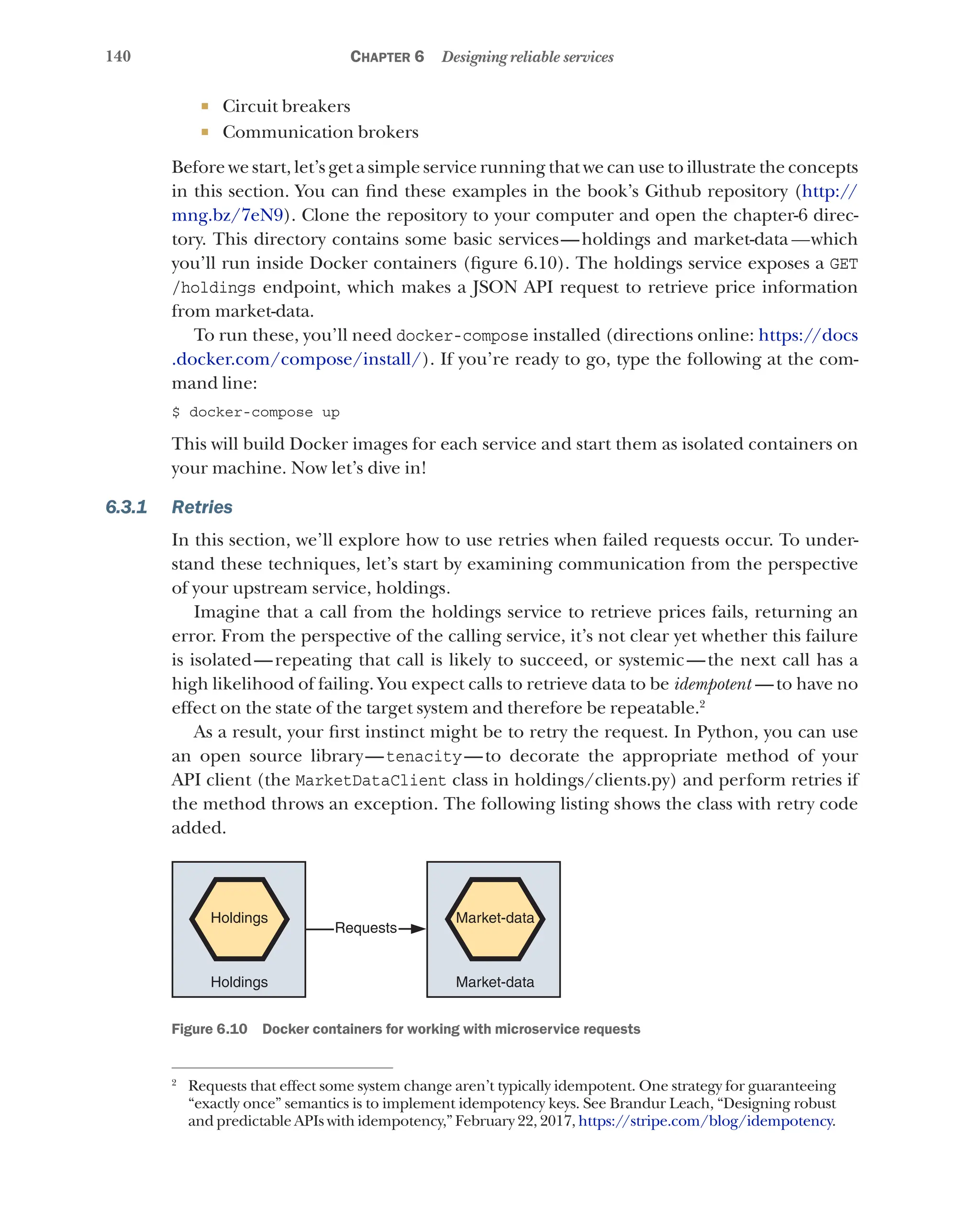
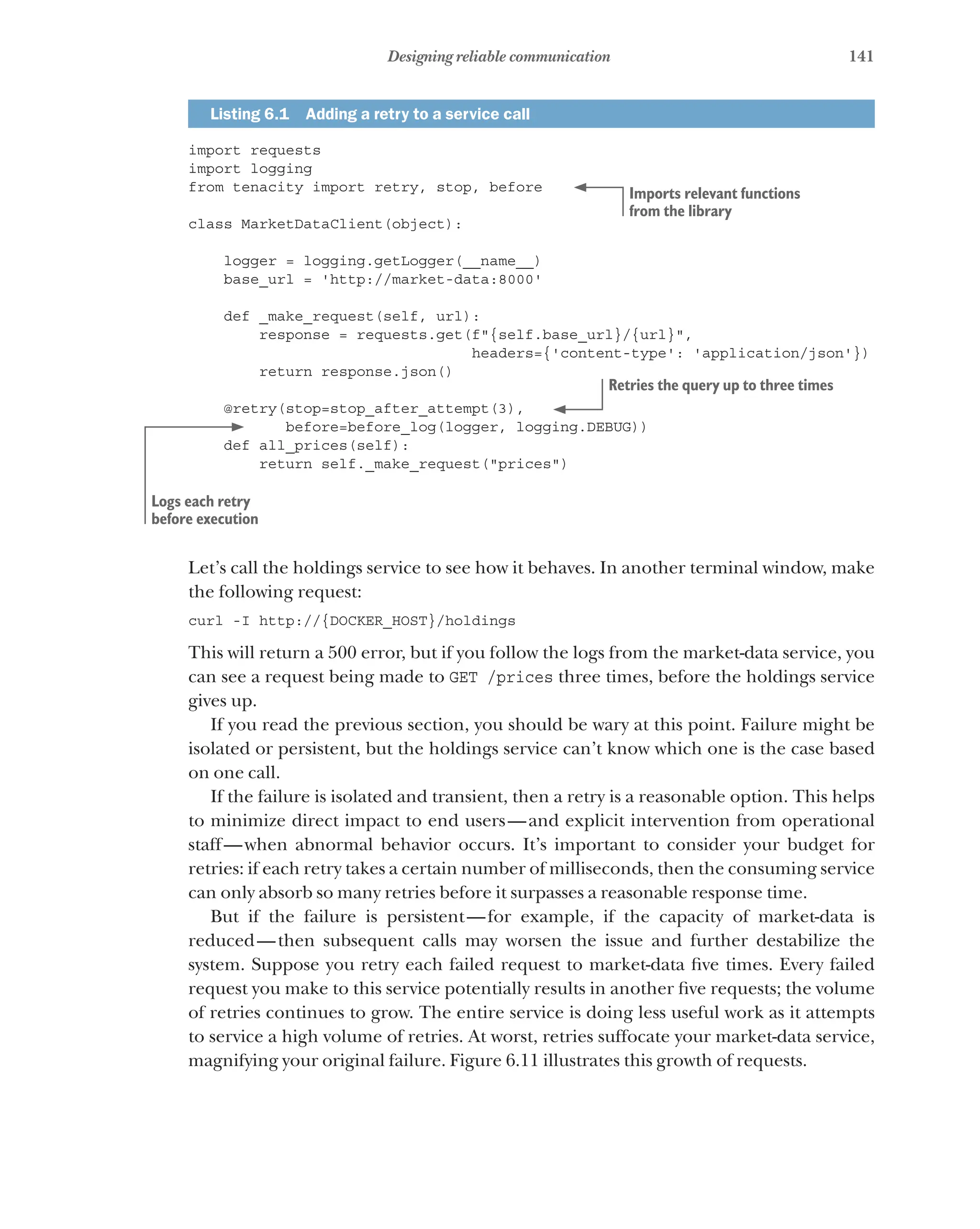
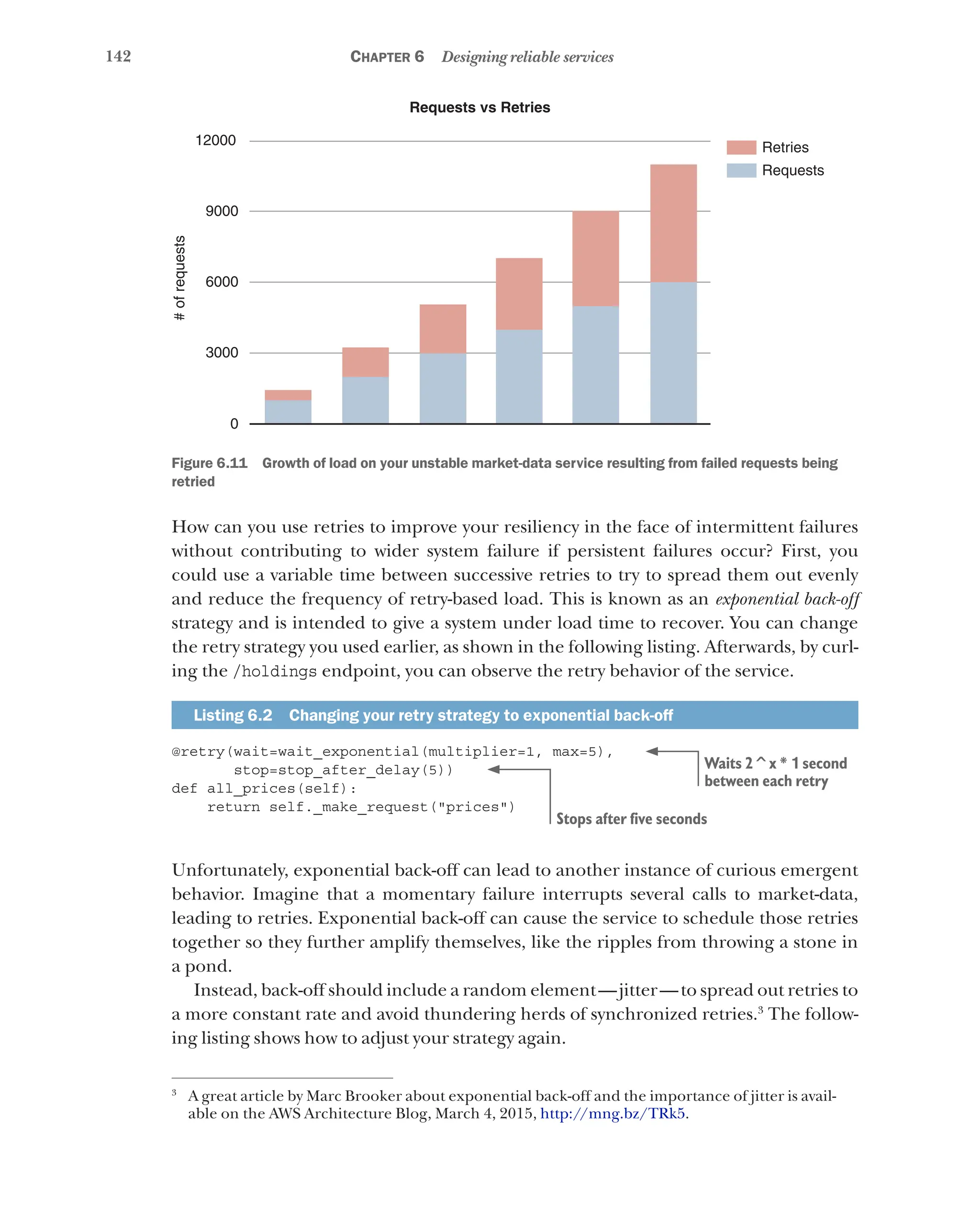
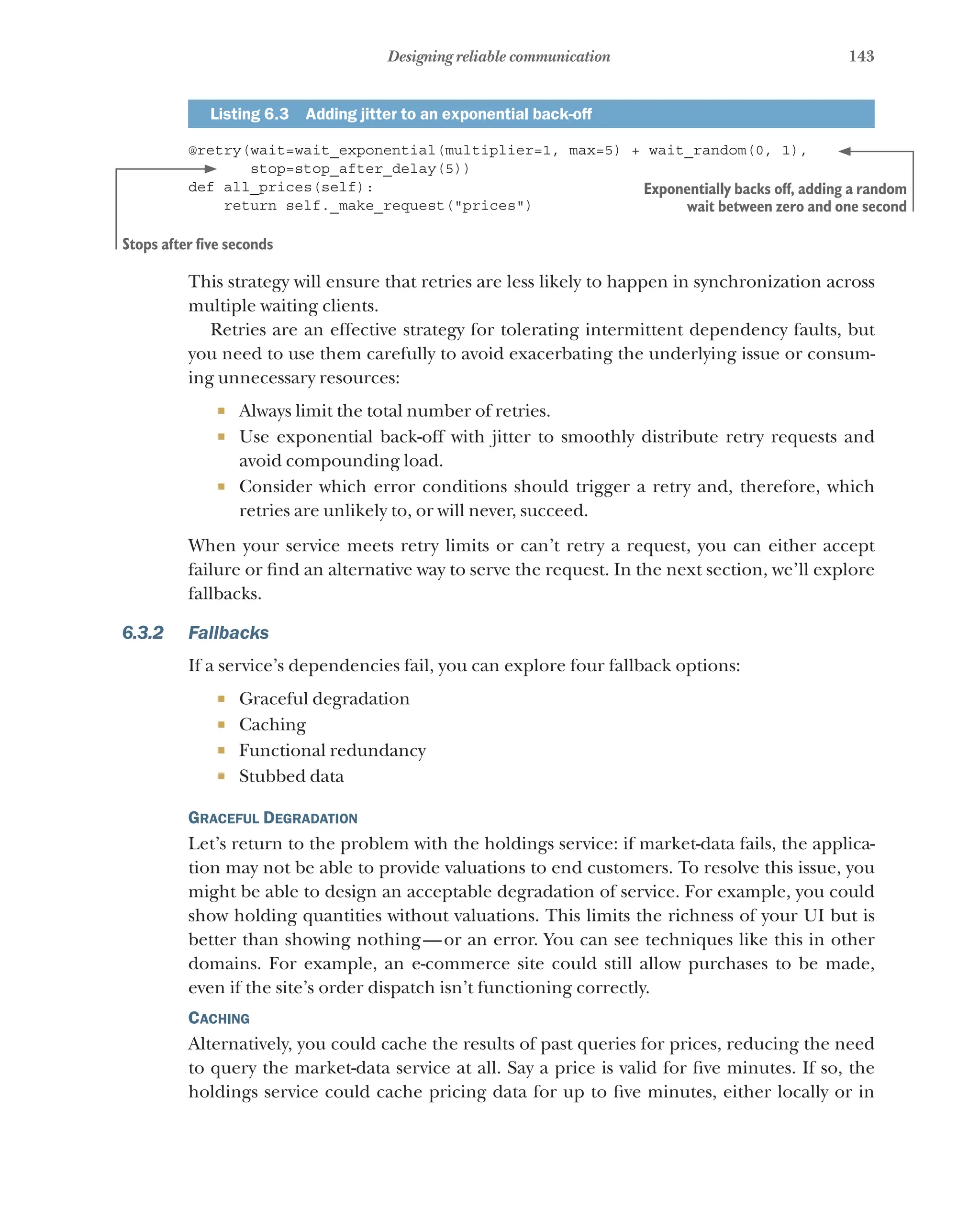

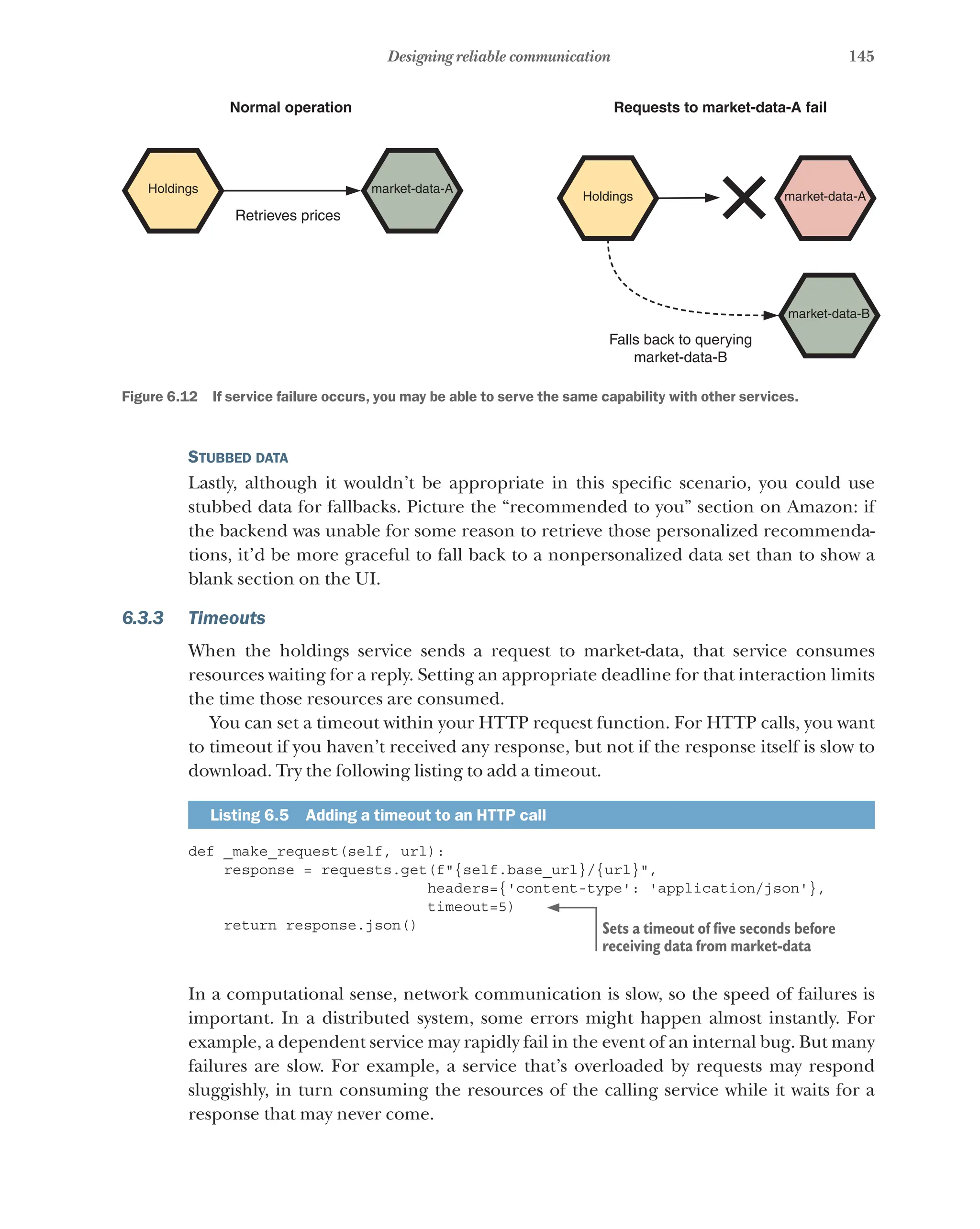
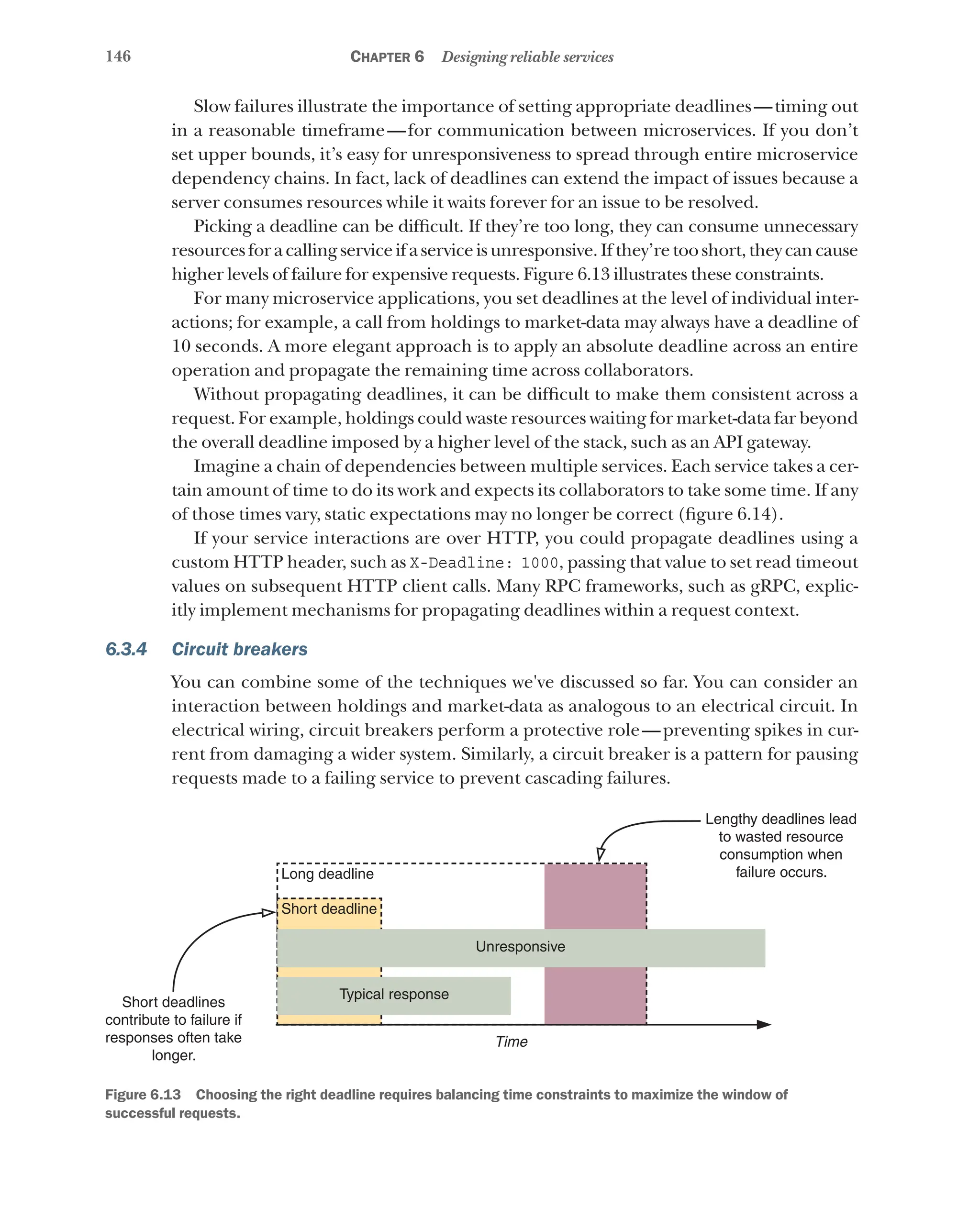
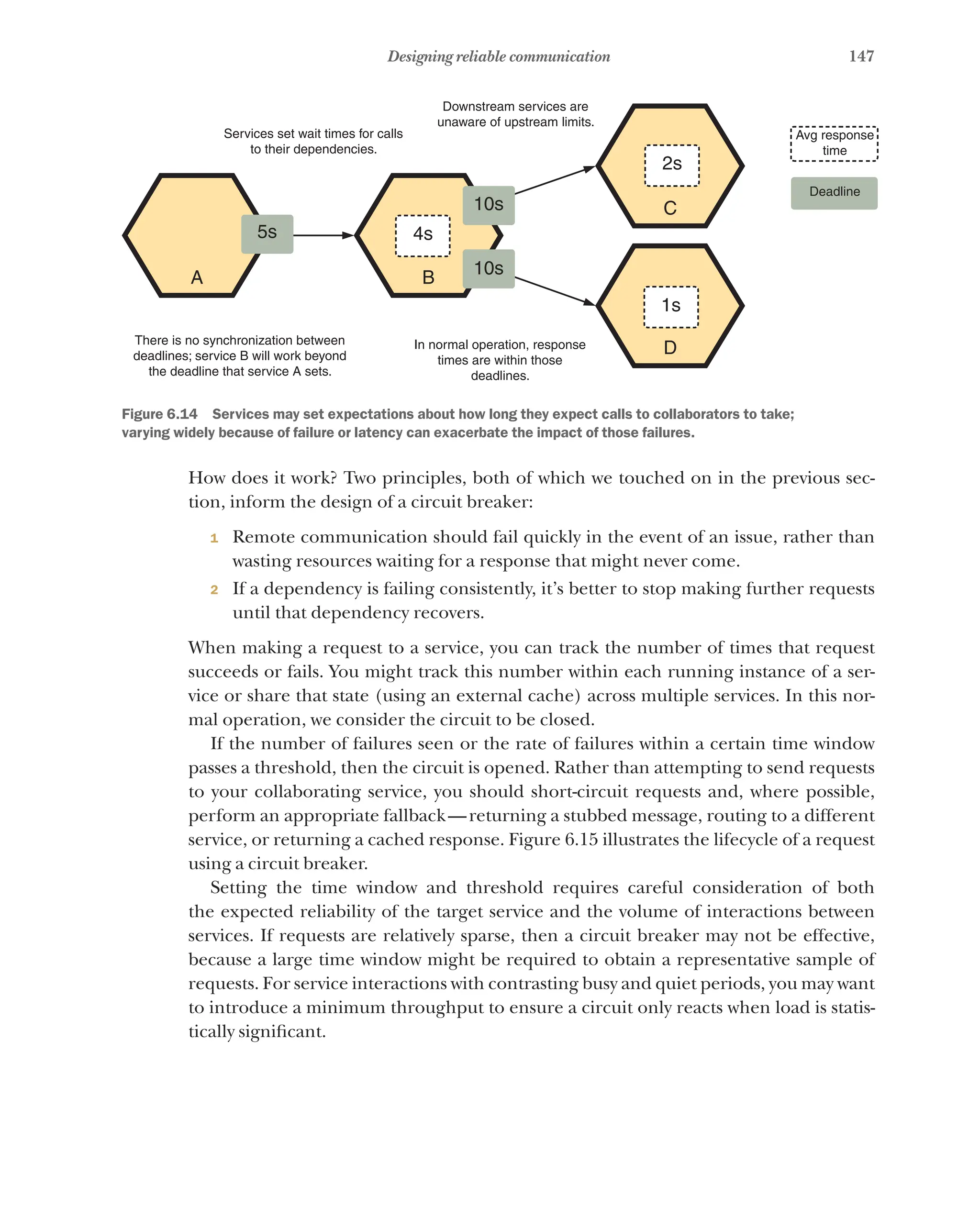

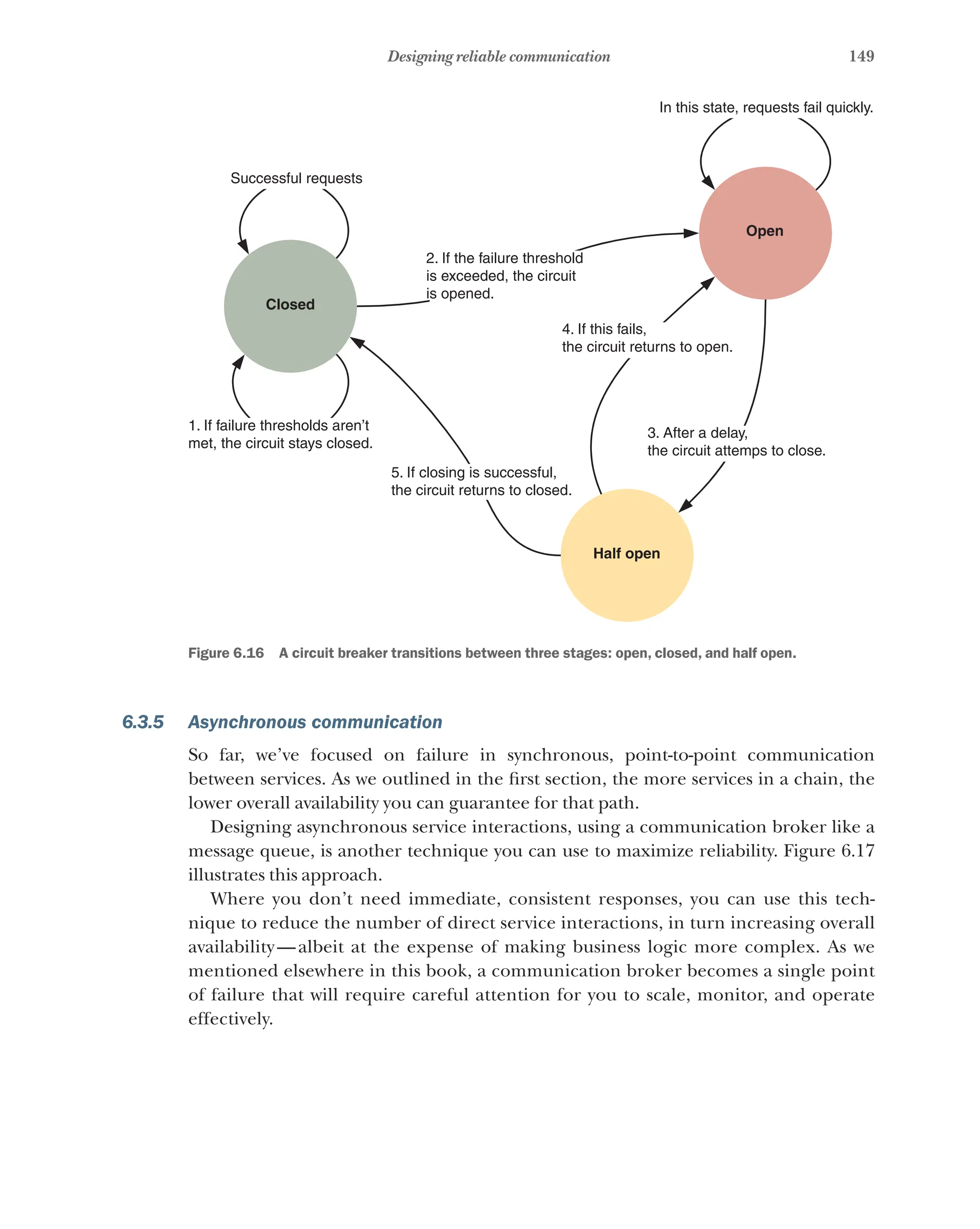

![151
Maximizing service reliability
You can classify health checks based on two criteria: liveness and readiness. A live-
ness check is typically a simple check that the application has started and is running
correctly. For example, an HTTP service should expose an endpoint—commonly
/health, /ping, or /heartbeat—that returns a 200 OK response once the service is
running (figure 6.18). If an instance is unresponsive, or returns an error message, the
load balancer will no longer deliver requests there.
In contrast, a readiness check indicates whether a service is ready to serve traffic,
because being alive may still not indicate that requests will be successful. A service might
have many dependencies—databases, third-party services, configuration, caches—so
you can use a readiness check to see if these constituent components are in the correct
state to serve requests. Both of the example services implement a simple HTTP liveness
check, as shown in the following listing.
Listing 6.6 Flask handler for an HTTP liveness check
@app.route('/ping', methods=["GET"])
def ping():
return 'OK'
Health checks are binary: either an instance is available or it isn’t. This works well with
typical round-robin load balancing, where requests are distributed to each replica in
turn. But in some circumstances the functioning of a service may be degraded and
exhibit increased latency or error rates without a health check reflecting this status.
As such, it can be beneficial to use load balancers that are aware of latency and able
to route requests to instances that are performing better, or those that are under less
load, to achieve more consistent service behavior. This is a typical feature of a microser-
vice proxy, which we’ll touch on later in this chapter.
LB
4xx/5xx
200
200
Holdings
Holdings
LB
200
Holdings
Holdings
Figure 6.18 Load balancers continuously query service instances to check their health. If an instance
is unhealthy, the load balancer will no longer route requests to that instance until it recovers.](https://image.slidesharecdn.com/microservicesinaction-240113230140-1bc300cc/75/microservices-in-action-pdf-178-2048.jpg)
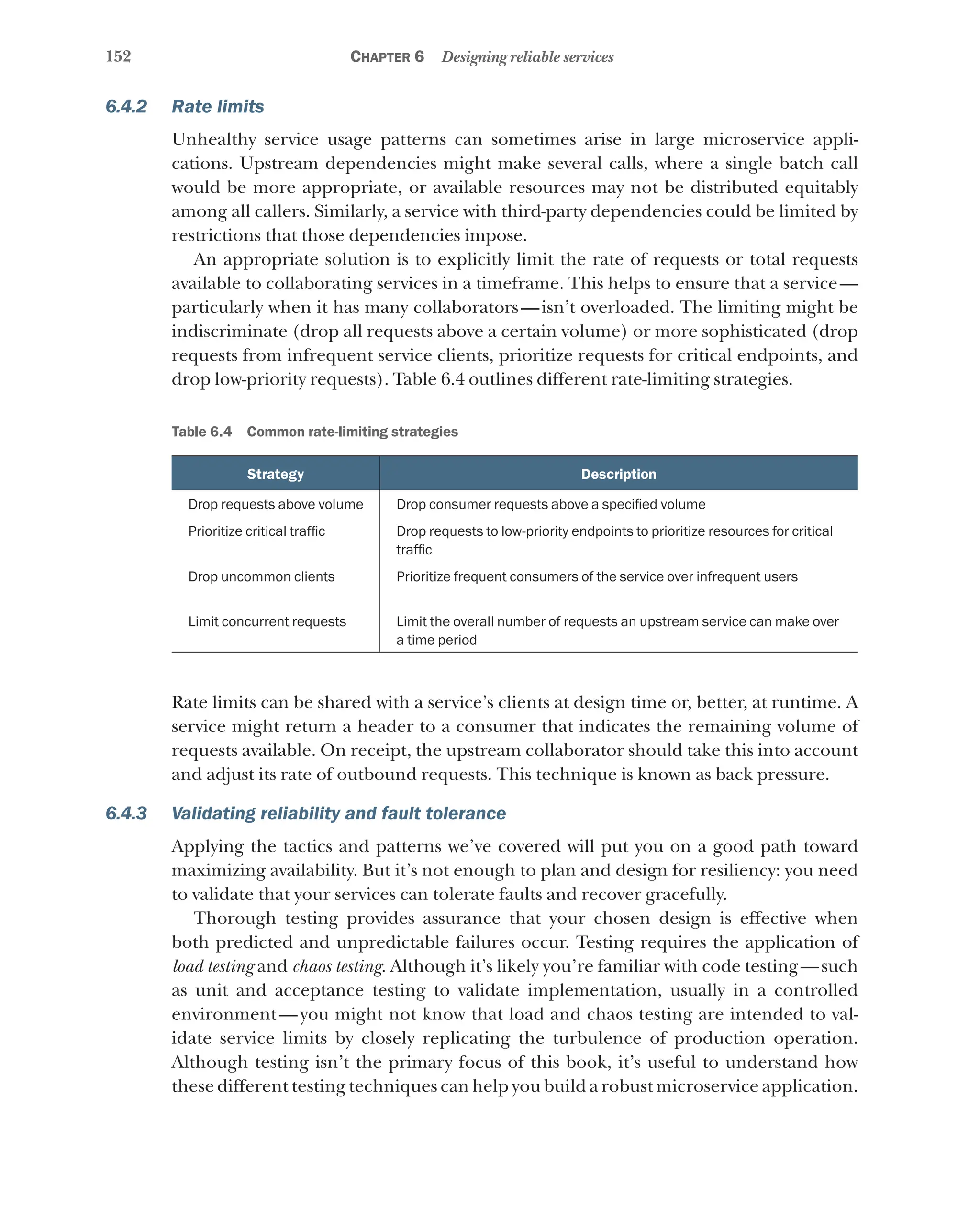
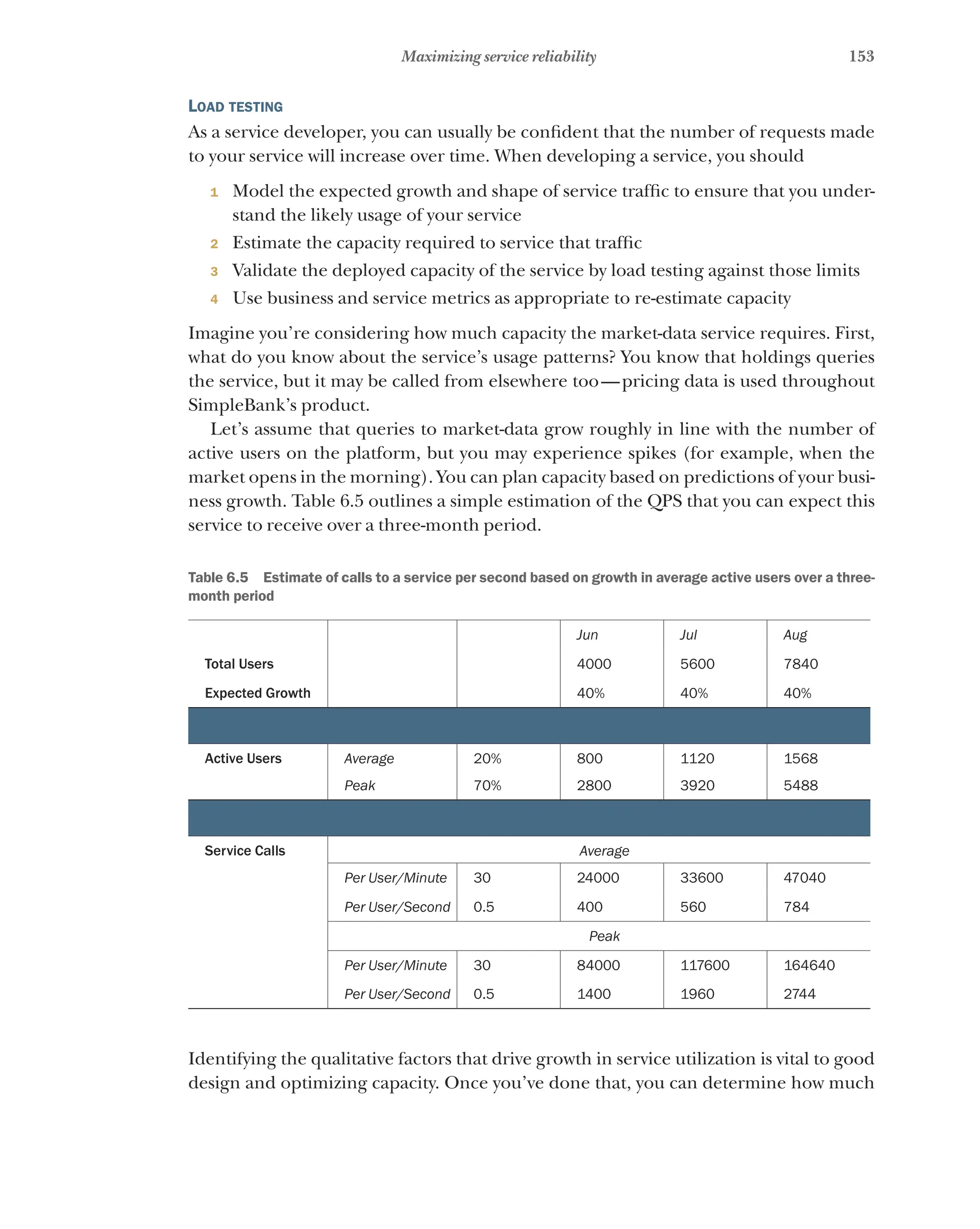

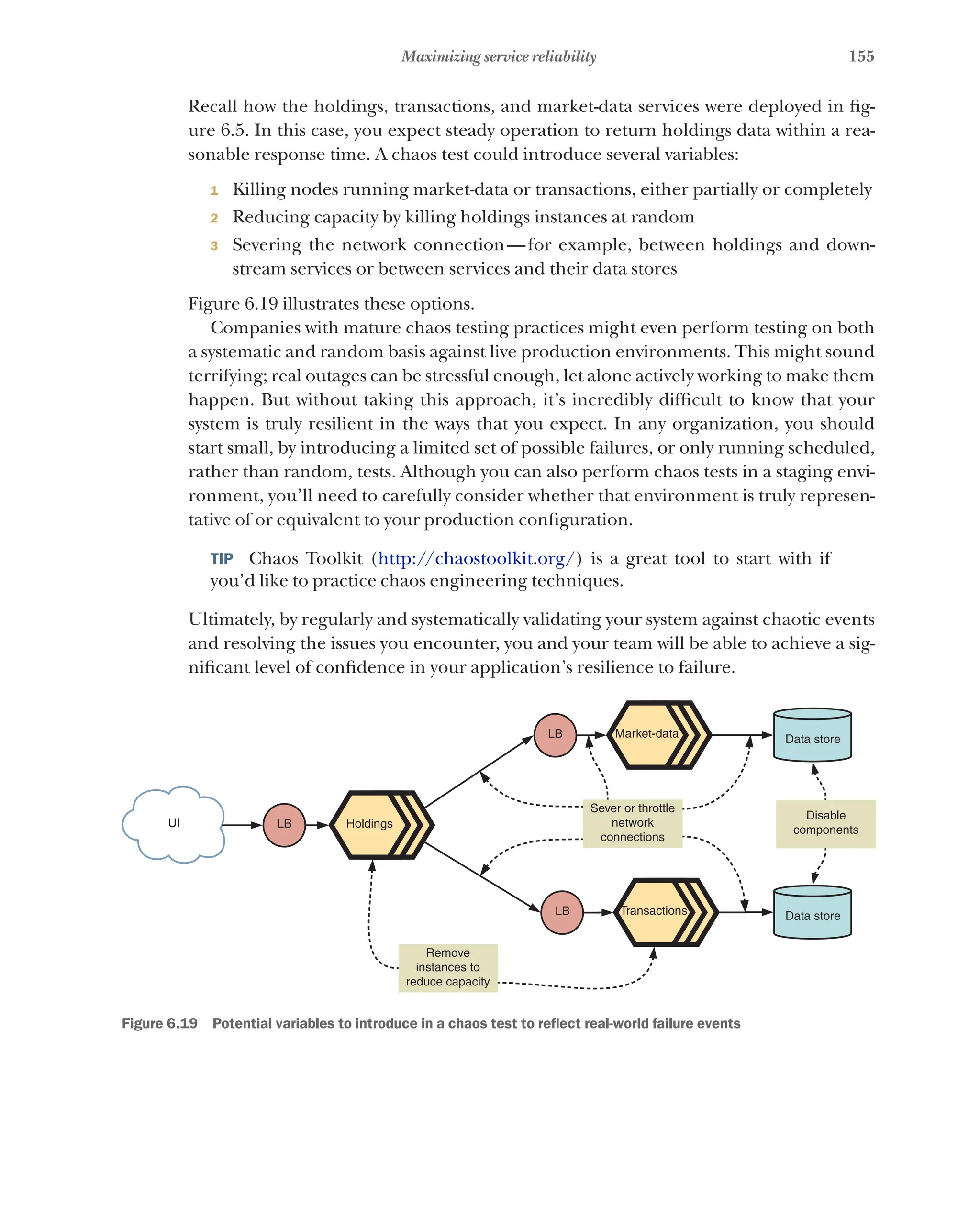
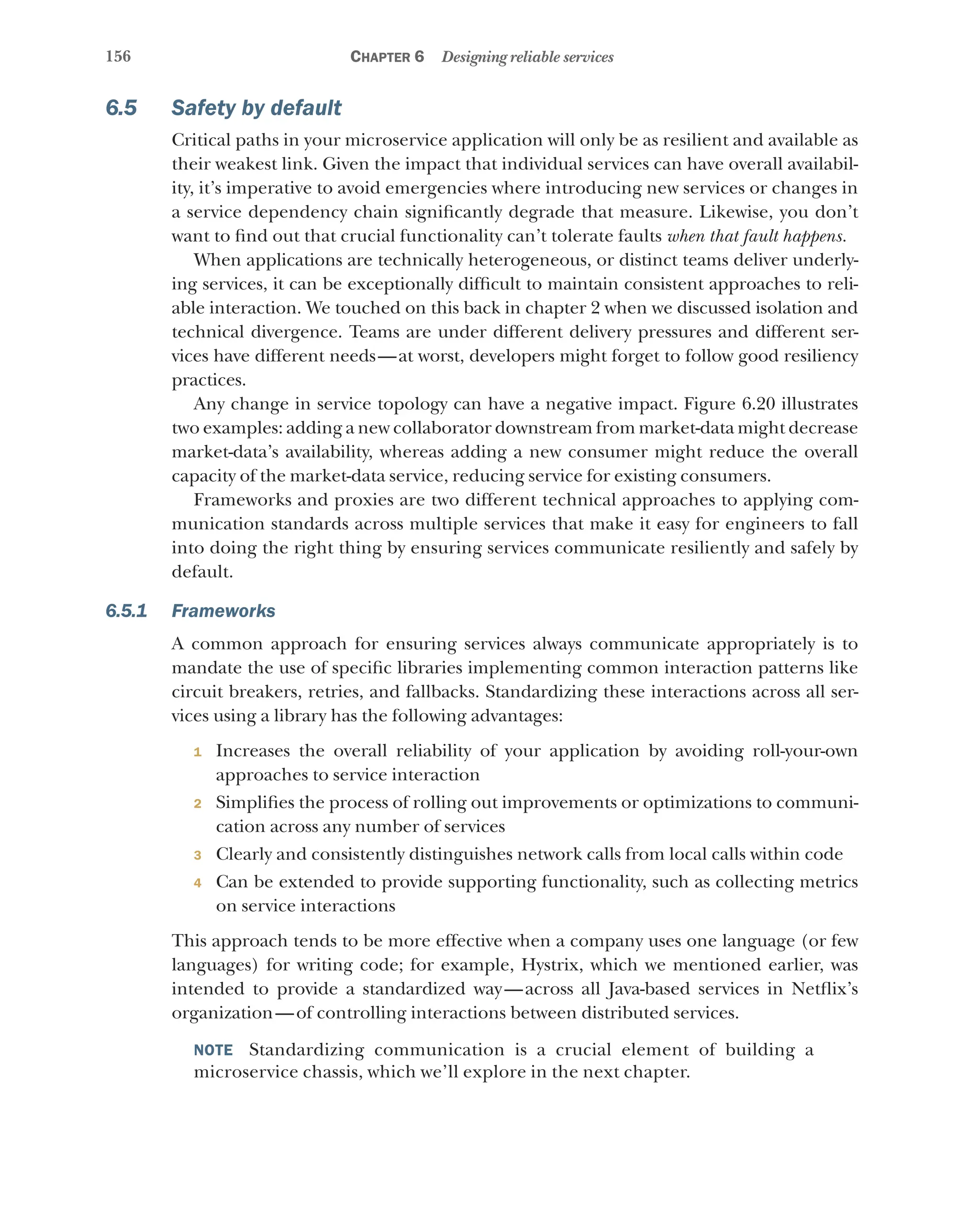


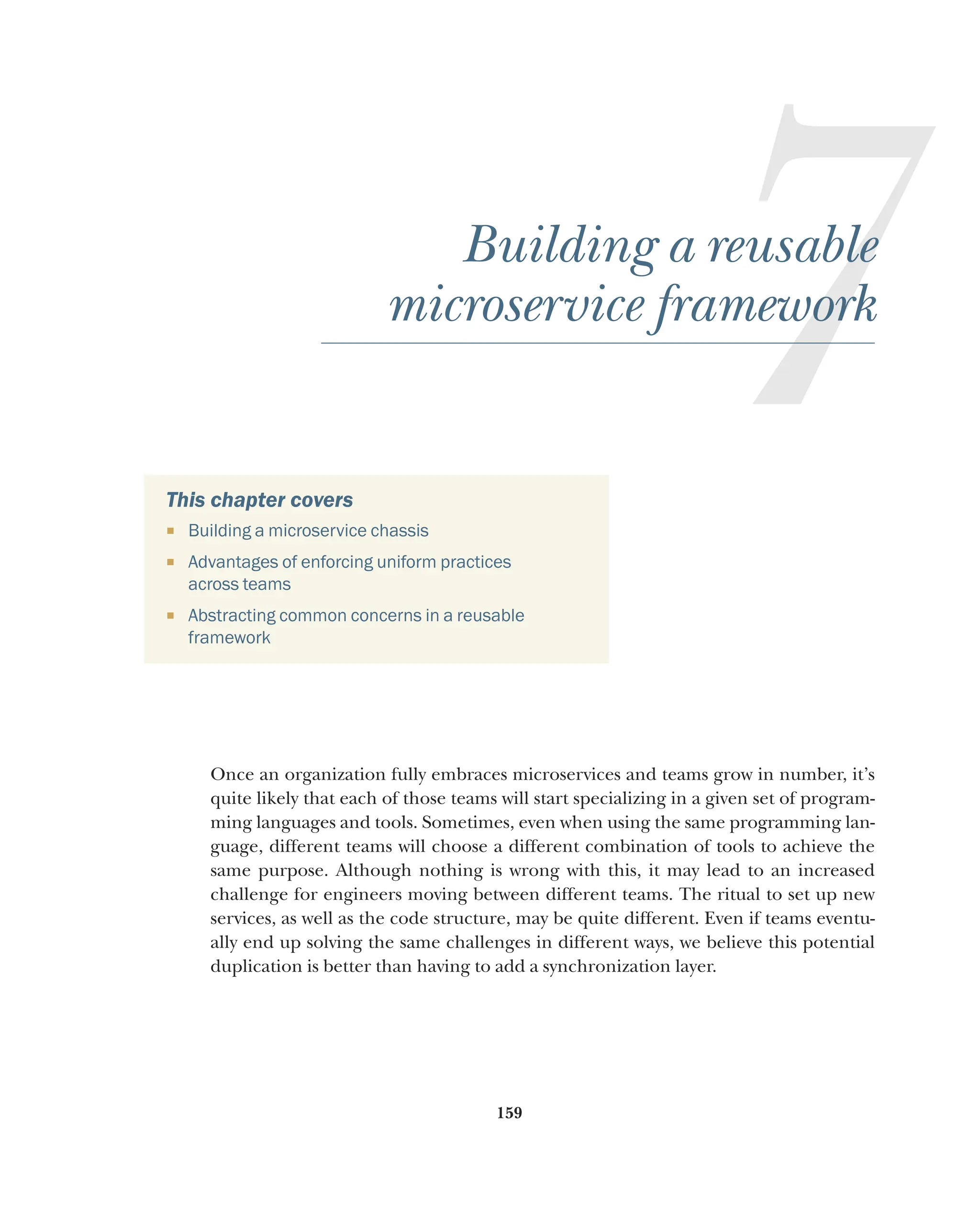
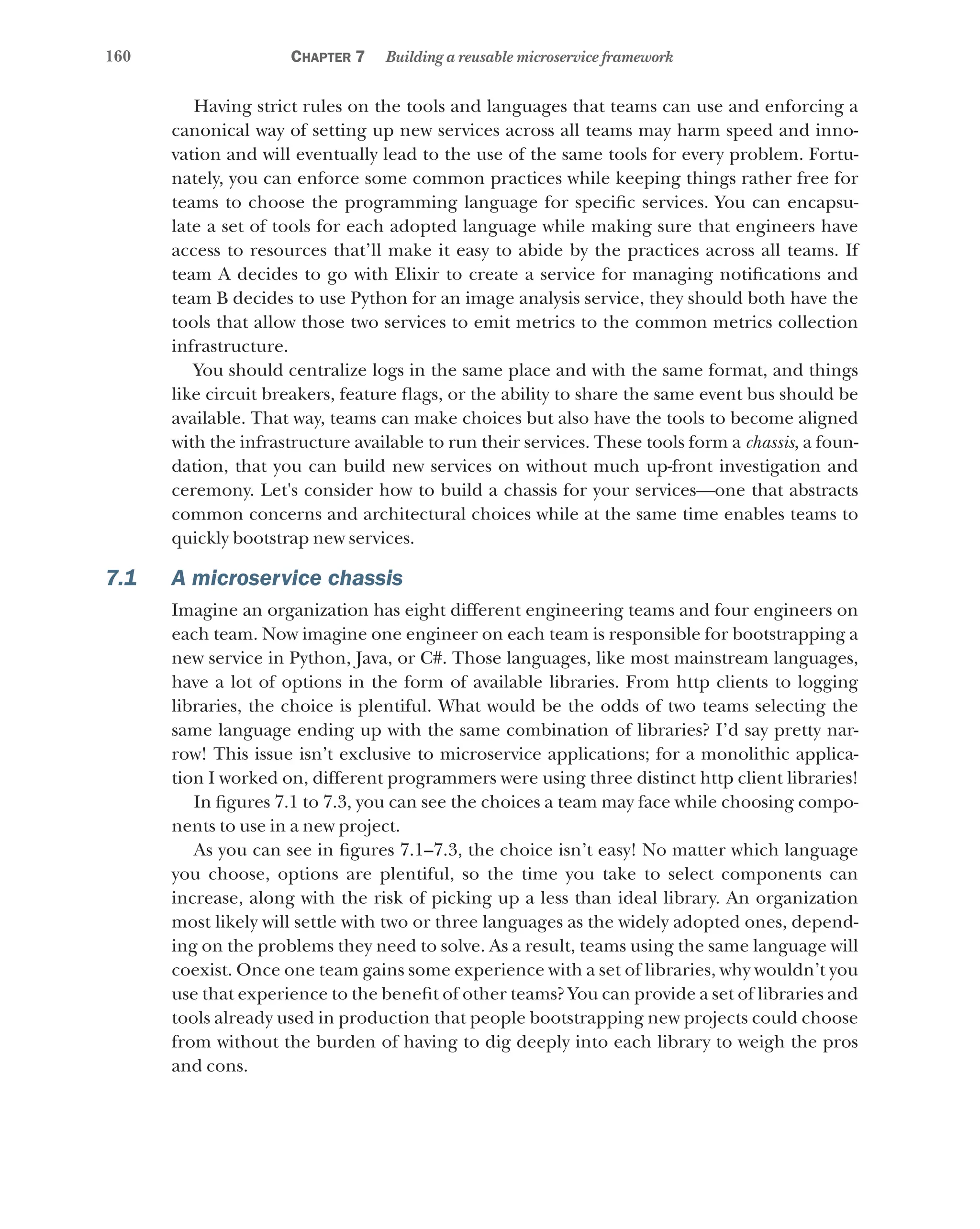
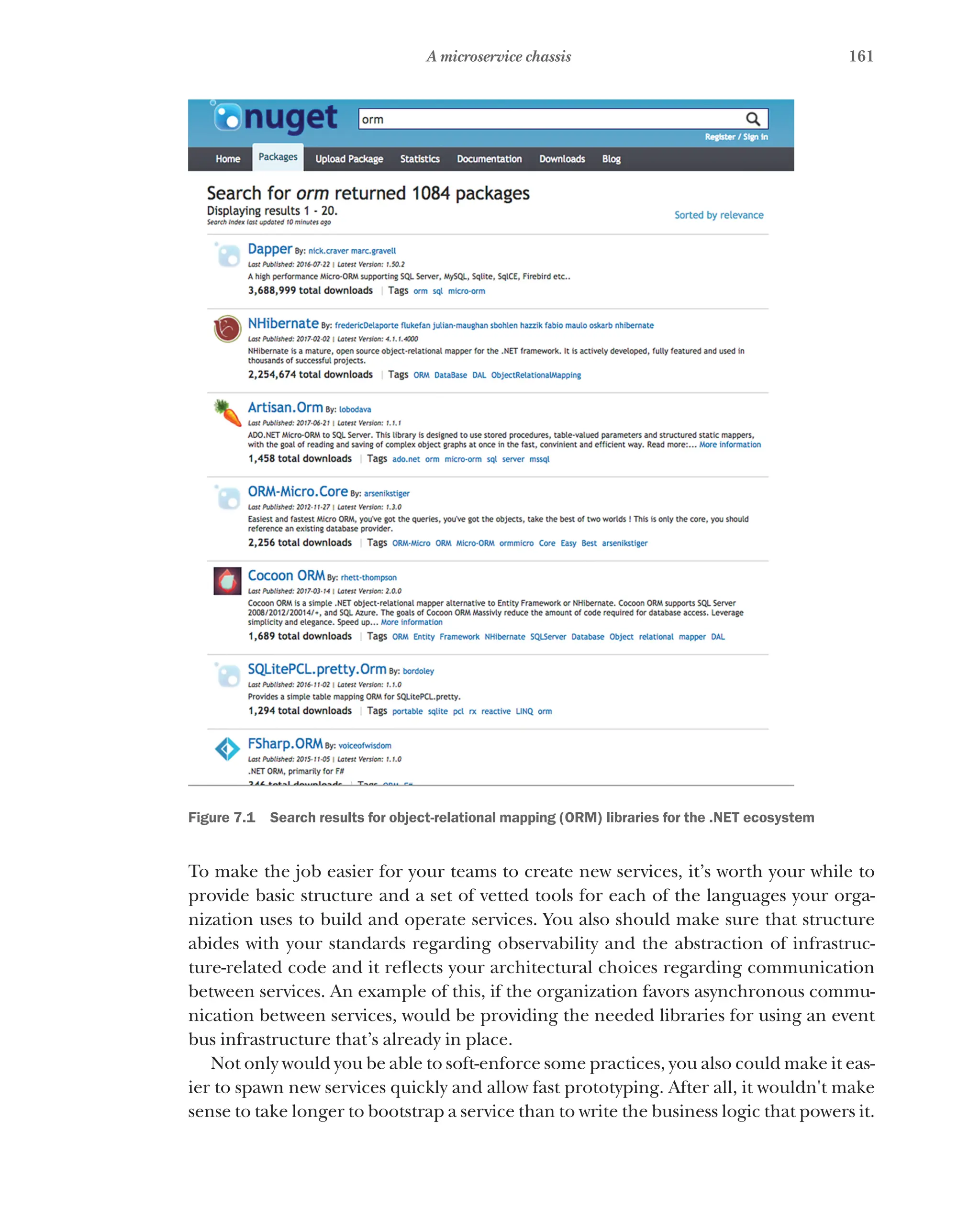

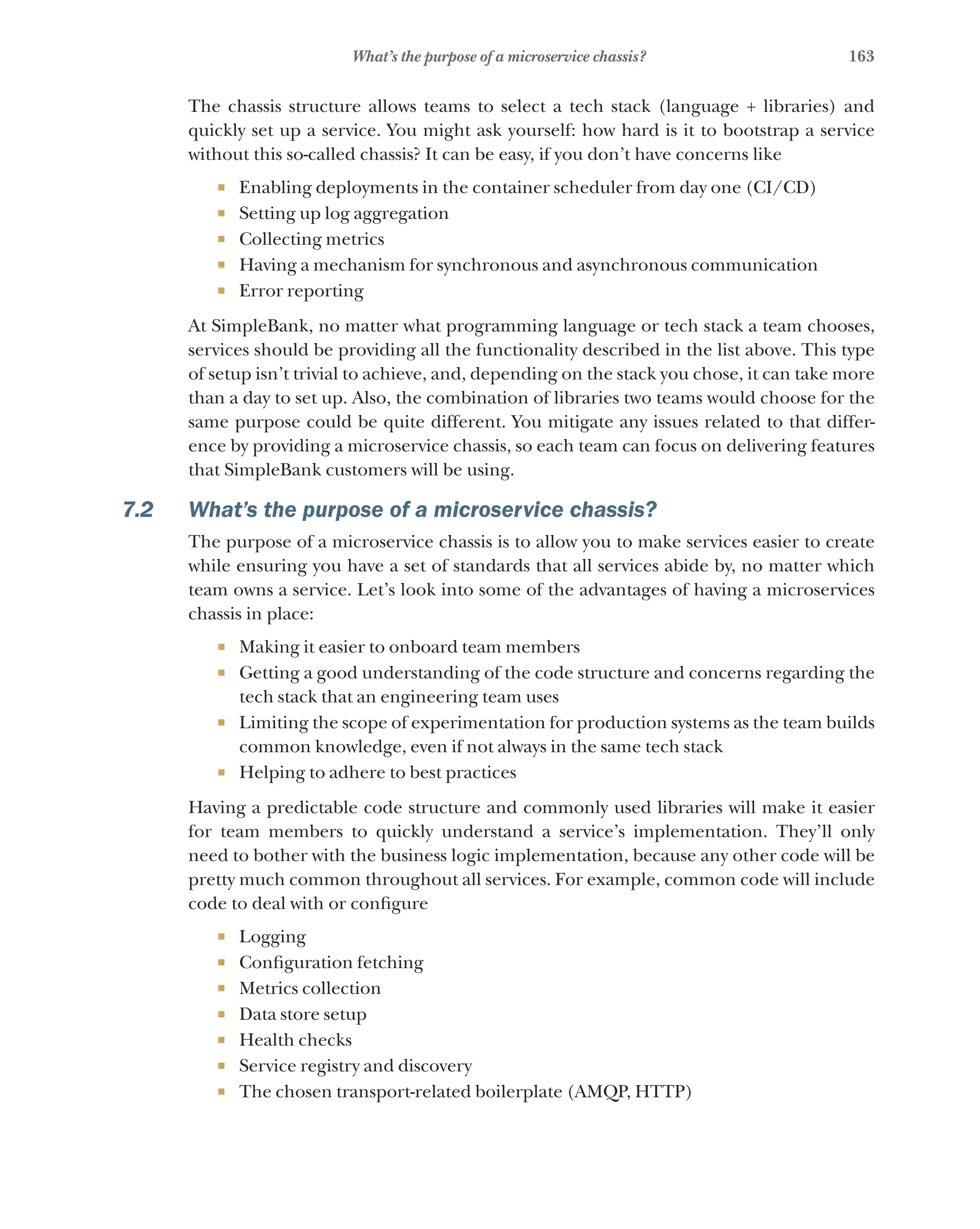

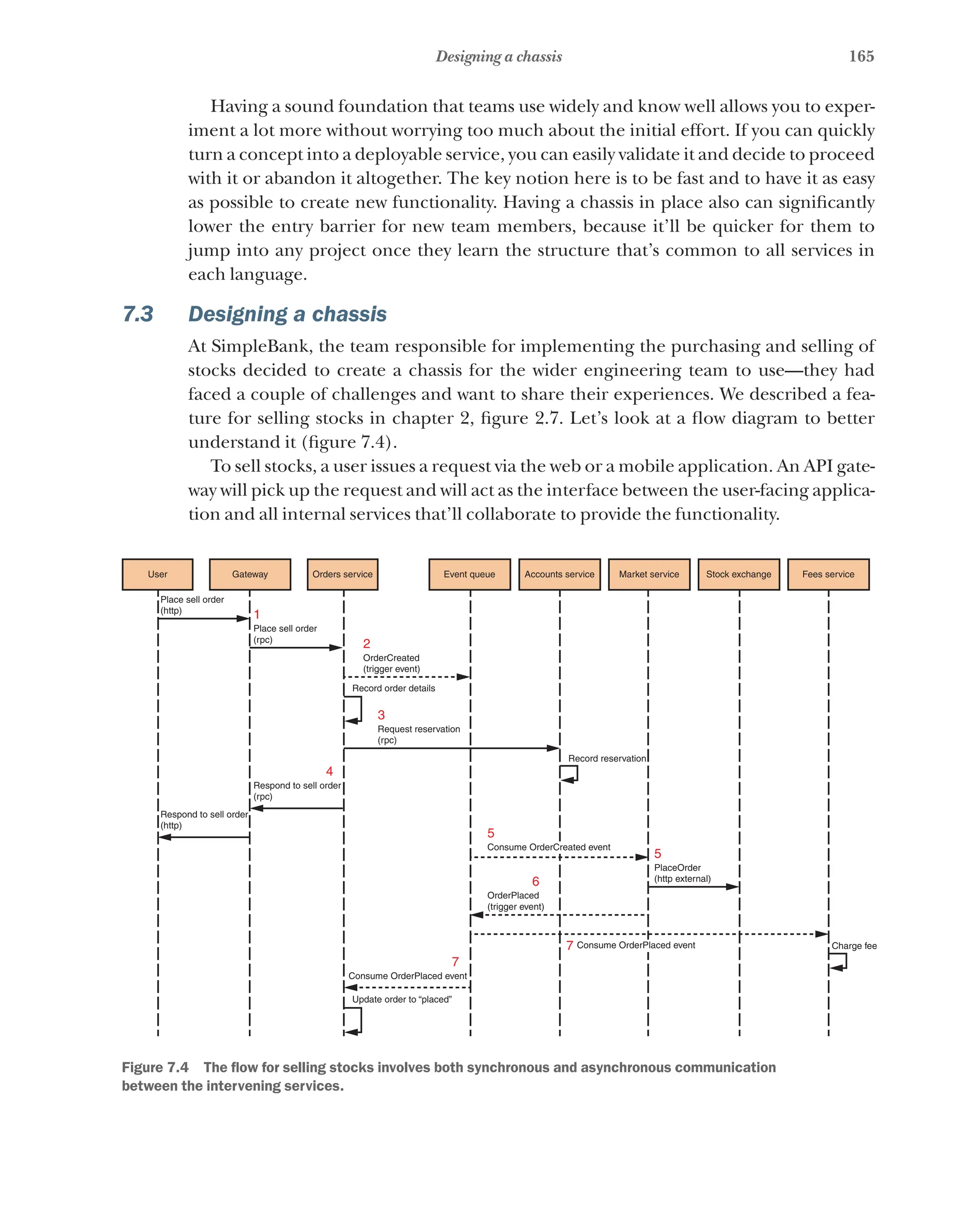
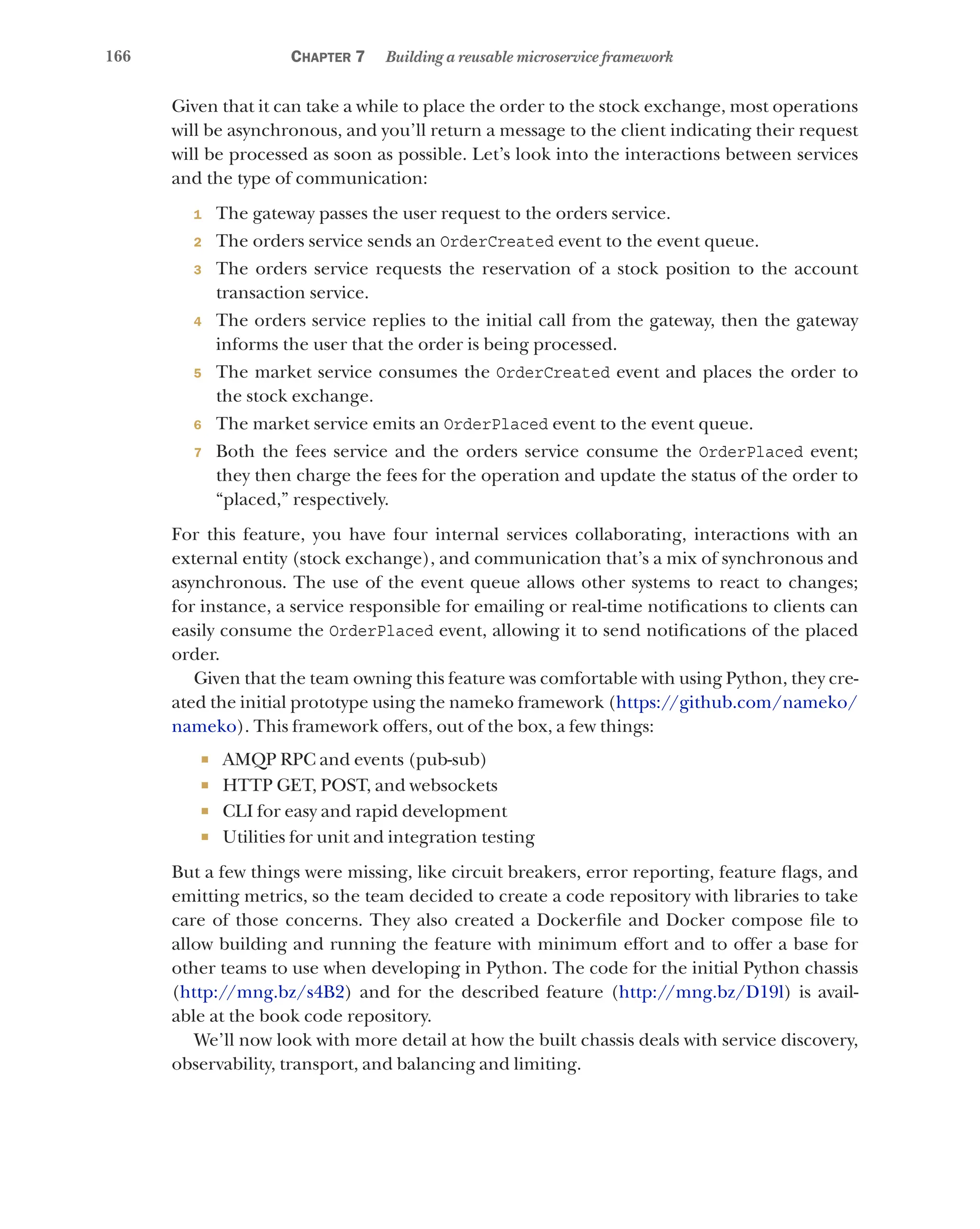
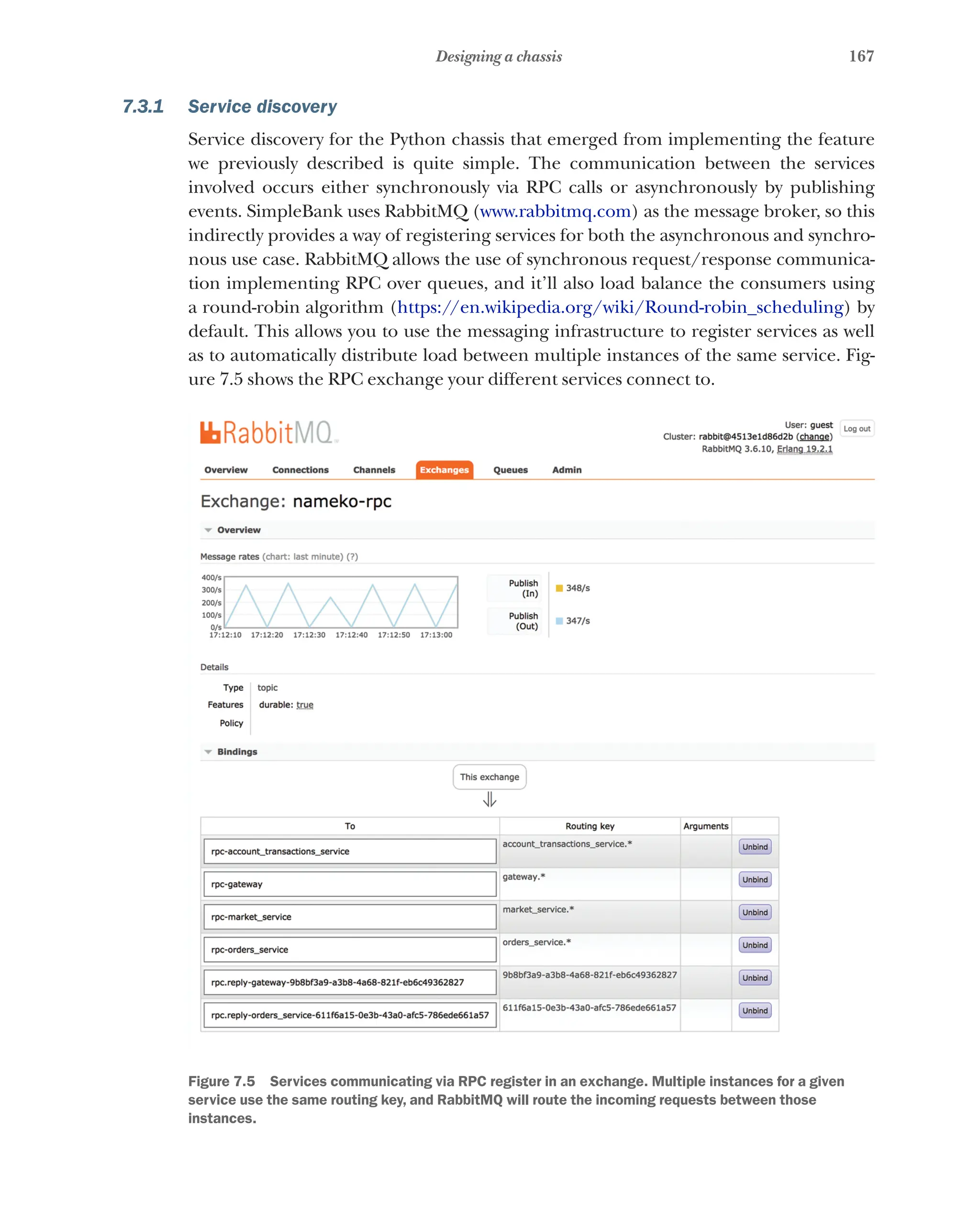

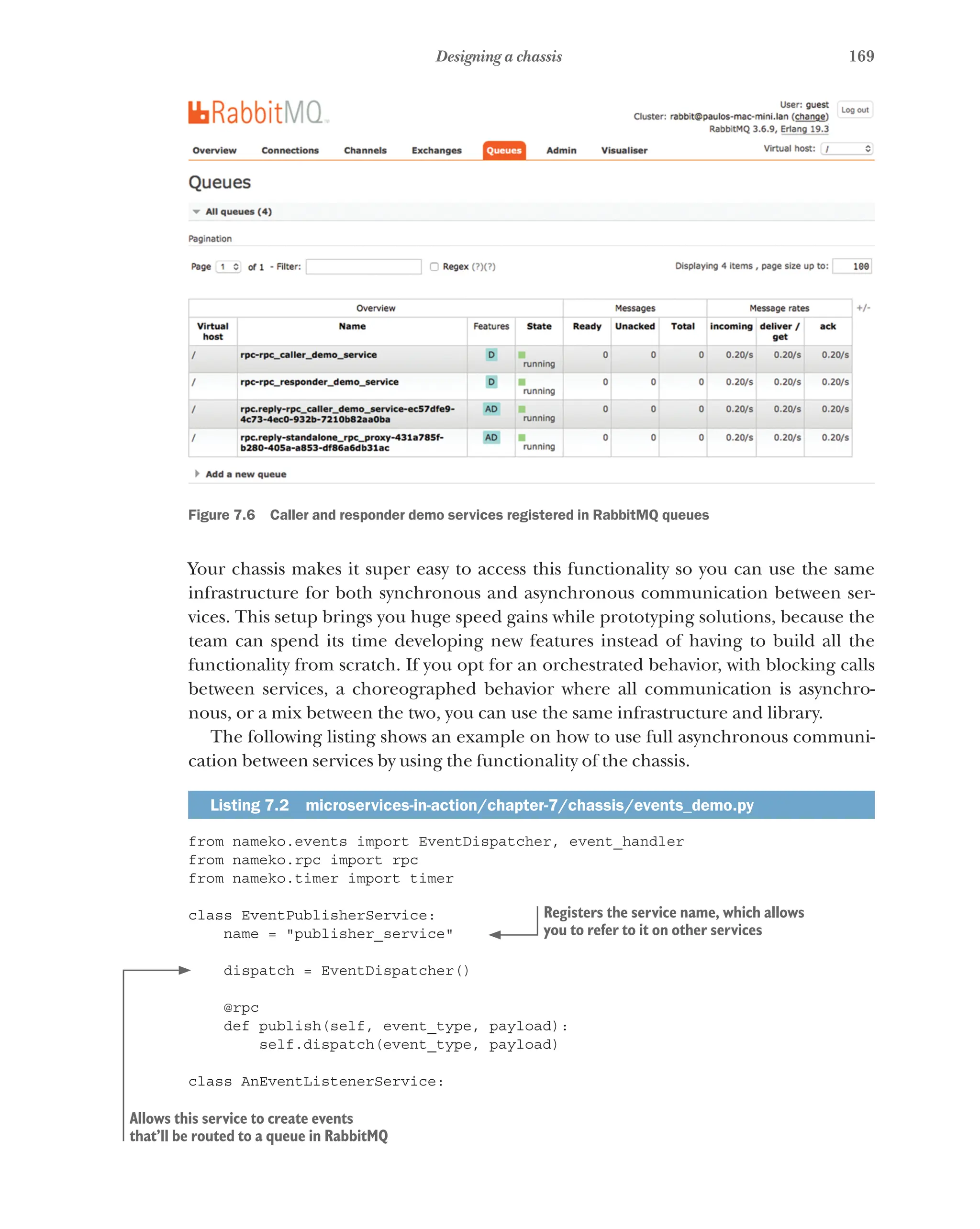
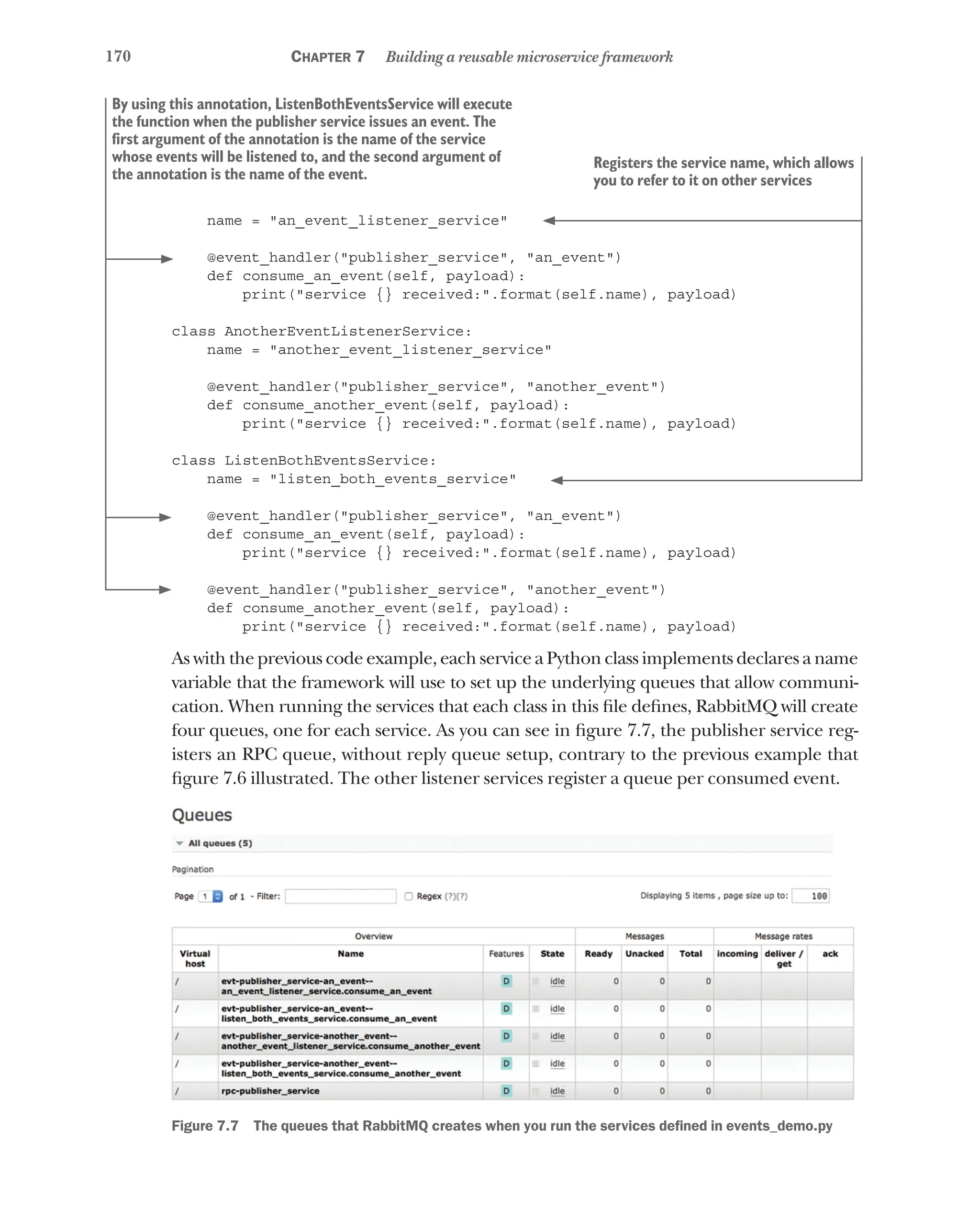
![171
Designing a chassis
The team chose nameko to be part of the microservice chassis because it makes it easy
to abstract from the details of implementing and setting up these two types of commu-
nication over the existing message broker. In section 7.3.3, we’ll also look into another
advantage that comes out of the box, because the message broker also takes care of
load balancing.
7.3.2 Observability
To operate and maintain services, you need to be aware of what’s going on in produc-
tion at all times. As a result, you’ll want the services to emit metrics to reflect the way
they’re operating, report errors, and aggregate logs in a usable format. In part 4 of the
book, we’ll focus on all these topics in more detail. But for now, let’s keep in mind that
services should address these concerns from day one. Operating and maintaining ser-
vices is as important as writing them in the first place, and, in most cases, they’ll spend
a lot more time running than being developed.
Your microservice chassis has the dependencies shown in the following listing.
Listing 7.3 microservices-in-action/chapter-7/chassis/setup.py
(…)
keywords='microservices chassis development',
packages=find_packages(exclude=['contrib', 'docs', 'tests']),
install_requires=[
'nameko>=2.6.0',
'statsd>=3.2.1',
'nameko-sentry>=0.0.5',
'logstash_formatter>=0.5.16',
'circuitbreaker>=1.0.1',
'gutter>=0.5.0',
'request-id>=0.2.1',
],
(…)
From the seven declared dependencies, you use three of them for observability pur-
poses. These libraries will allow you to collect metrics, report errors, and gather some
contextual information around them and to adapt your logging to the format you use
in all services deployed at SimpleBank.
Library to emit metrics in StatsD format
Library to Integrate with Sentry error reporting
Library to format the logs in logstash format](https://image.slidesharecdn.com/microservicesinaction-240113230140-1bc300cc/75/microservices-in-action-pdf-198-2048.jpg)
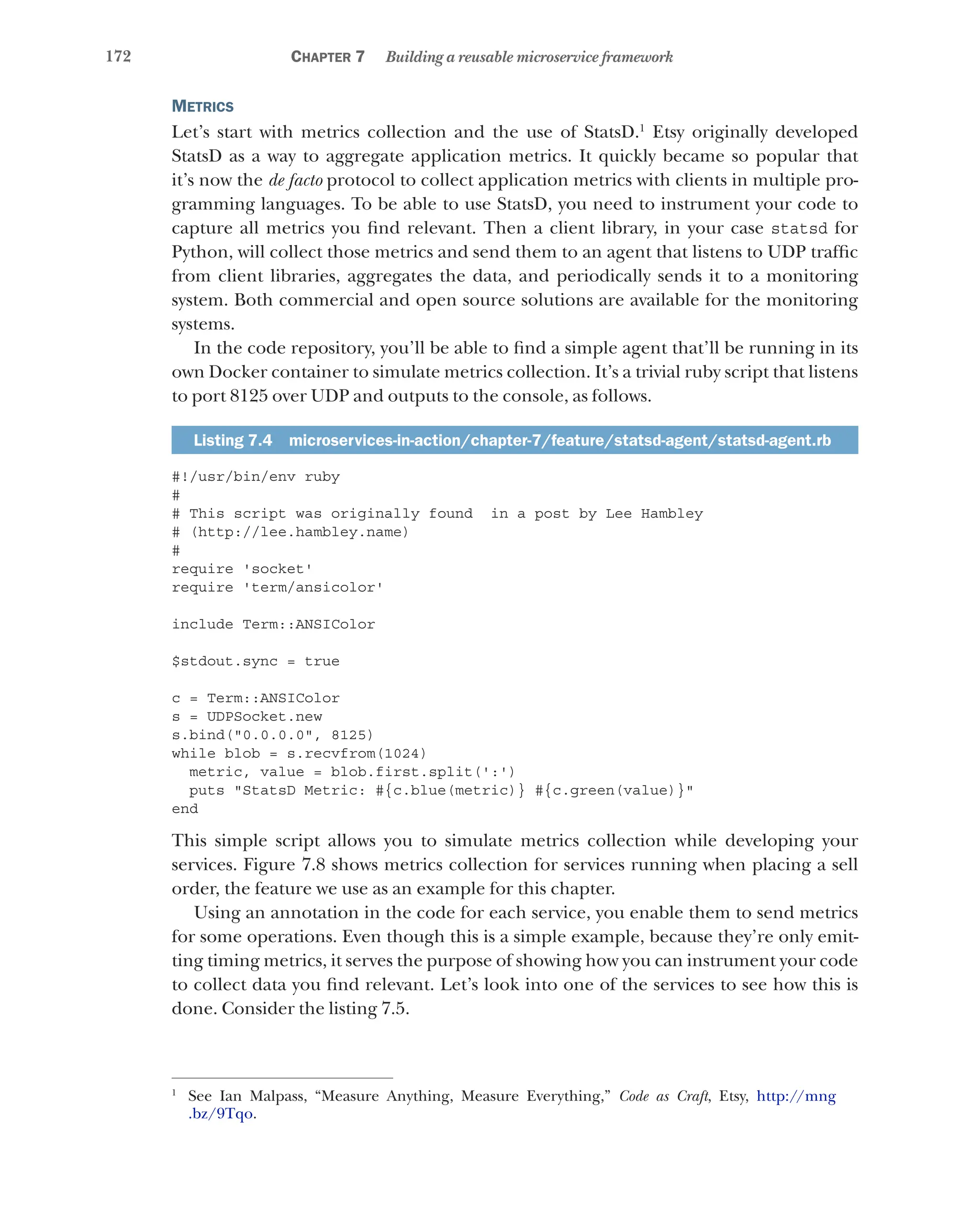
![173
Designing a chassis
Figure 7.8 StatsD agent collecting metrics that services collaborating in a place sell order operation
have emitted
Listing 7.5 microservices-in-action/chapter-7/feature/fees/app.py
import json
import datetime
from nameko.events import EventDispatcher, event_handler
from statsd import StatsClient
class FeesService:
name = "fees_service"
statsd = StatsClient('statsd-agent', 8125,
prefix='simplebank-demo.fees')
@event_handler("market_service", "order_placed")
@statsd.timer('charge_fee')
def charge_fee(self, payload):
print("[{}] {} received order_placed event ... charging fee".format(
payload, self.name))
Imports the StatsD client so
you can use it in the module
Configures the StatsD client
by passing the host, the port,
and the prefix you’ll use for
all the emitted merics
Using this annotation enables you to collect the time it takes
for the 'charge_fee' function to run. The StatsD library uses the
value passed as an argument for the annotation as the metric
name. In this case, the charge_fee function will emit the metric
named 'simplebank-demo.fees.charge_fee'; the prefix you
configured before will be prepended to the metric name passed
to the annotation.](https://image.slidesharecdn.com/microservicesinaction-240113230140-1bc300cc/75/microservices-in-action-pdf-200-2048.jpg)
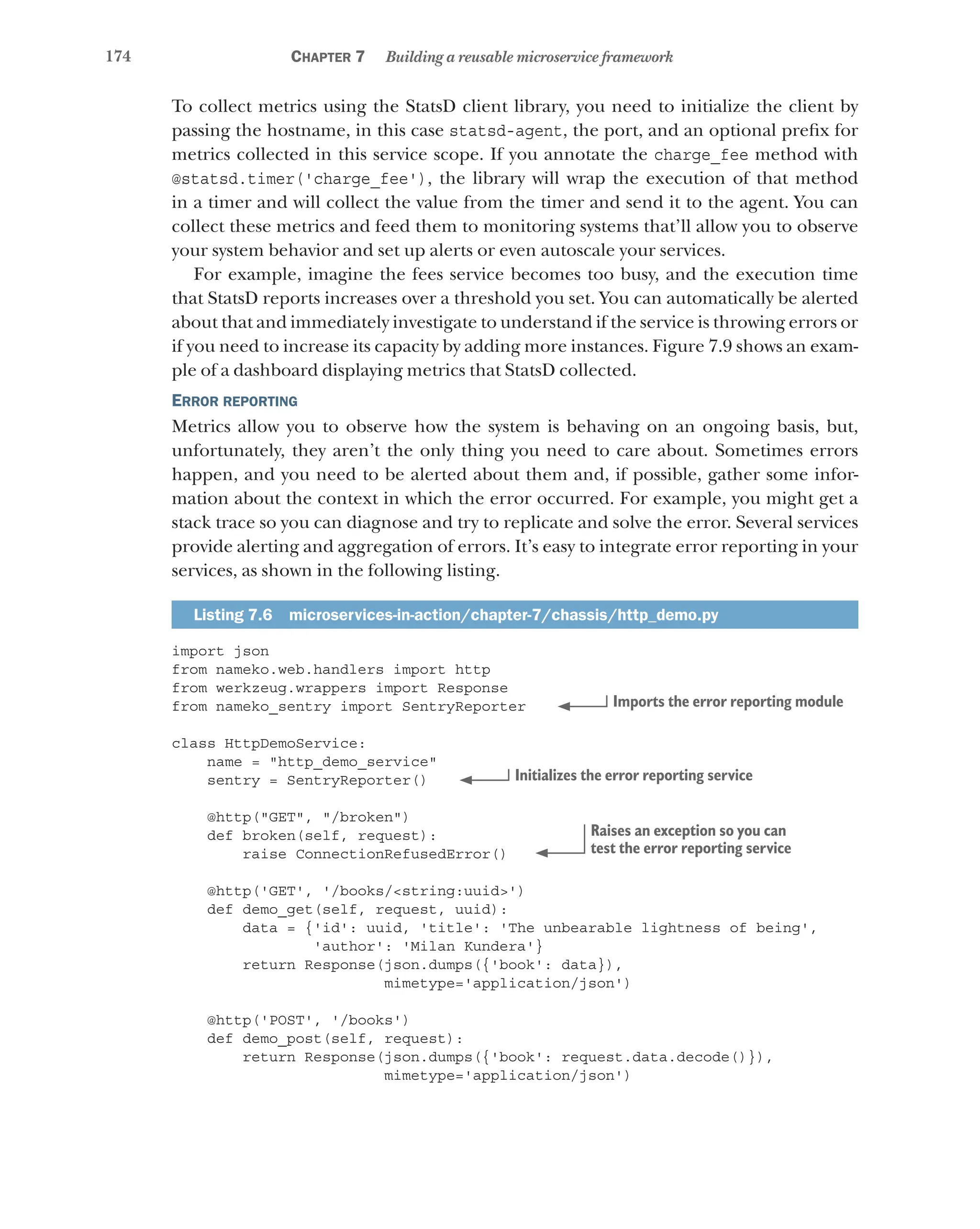
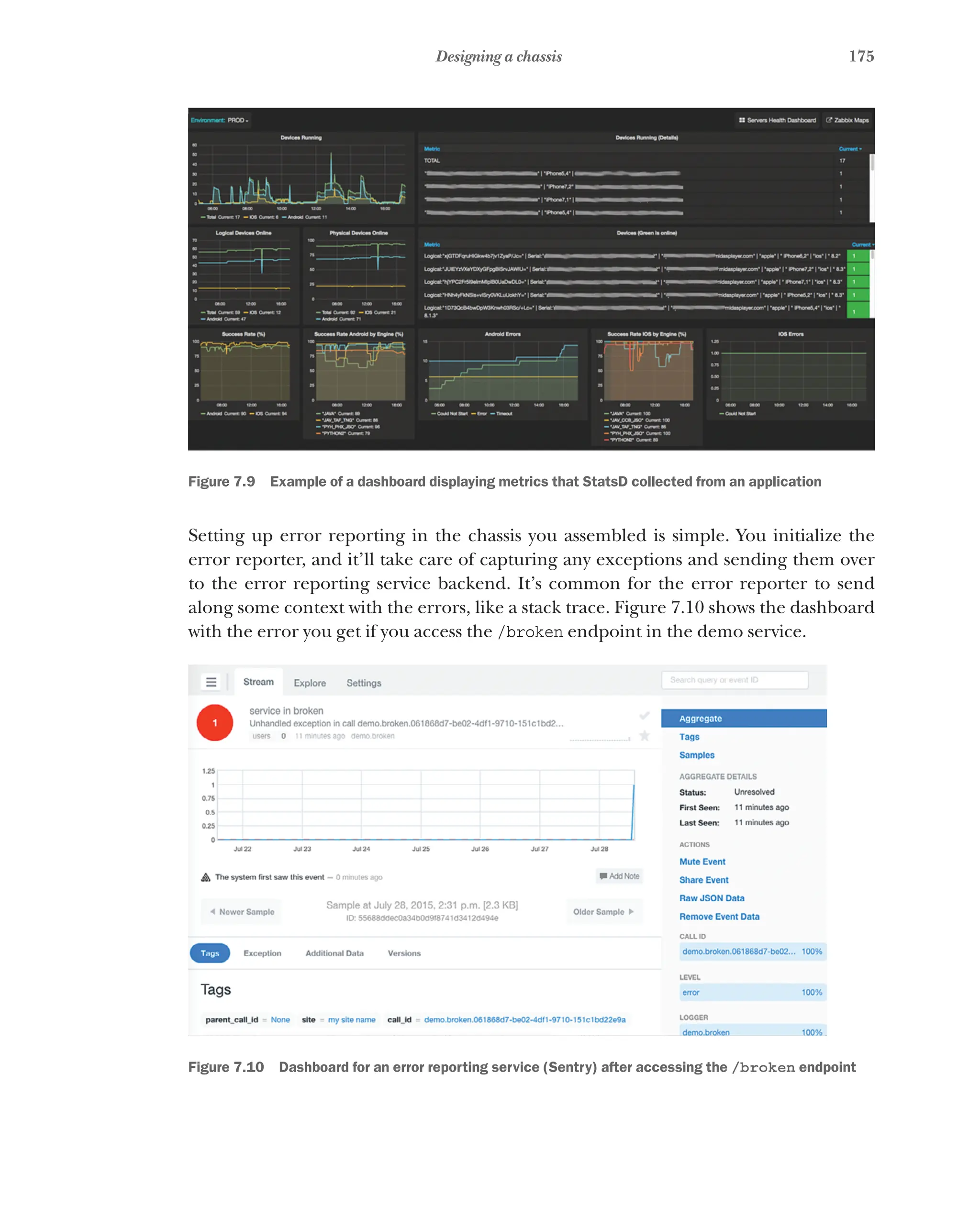
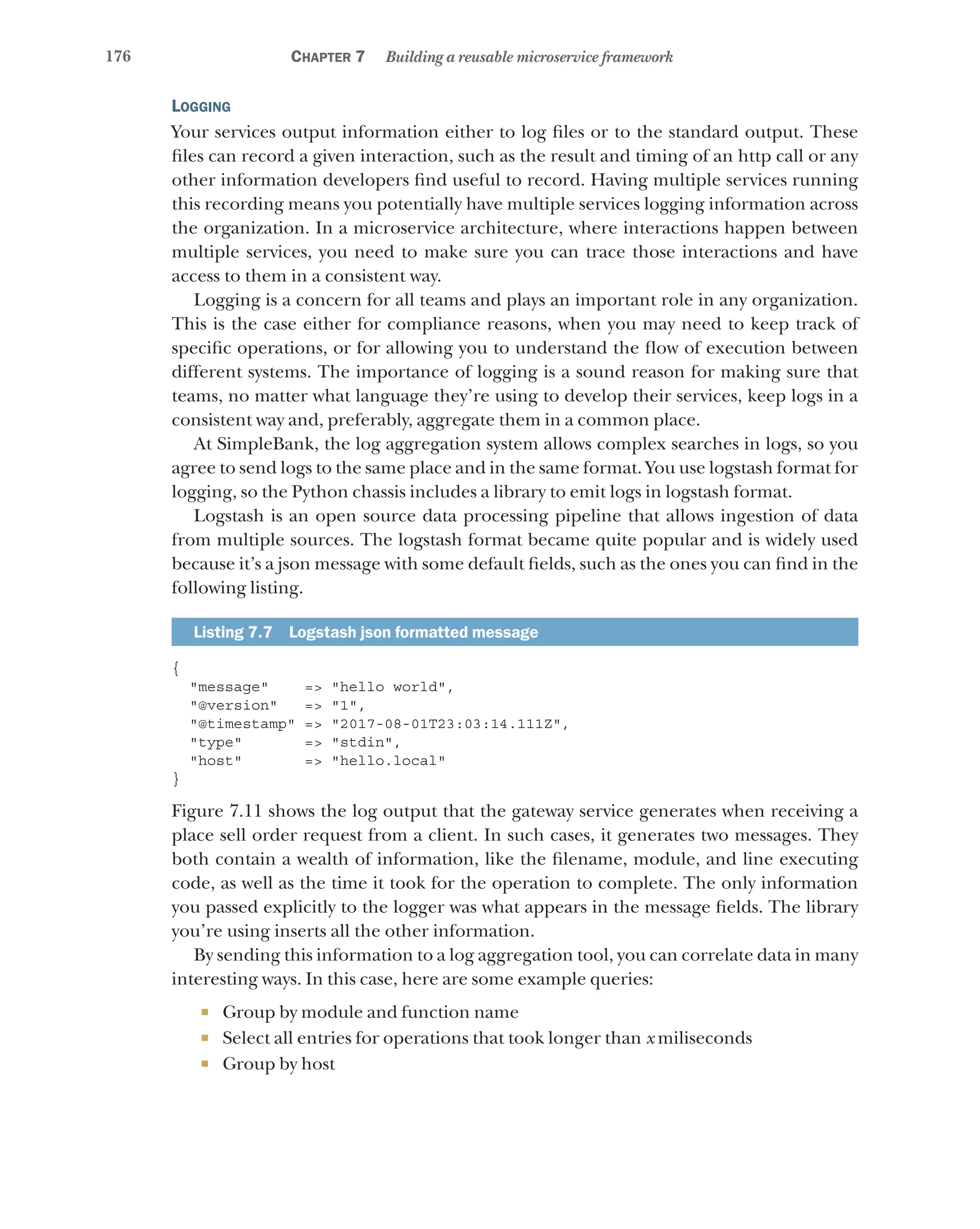

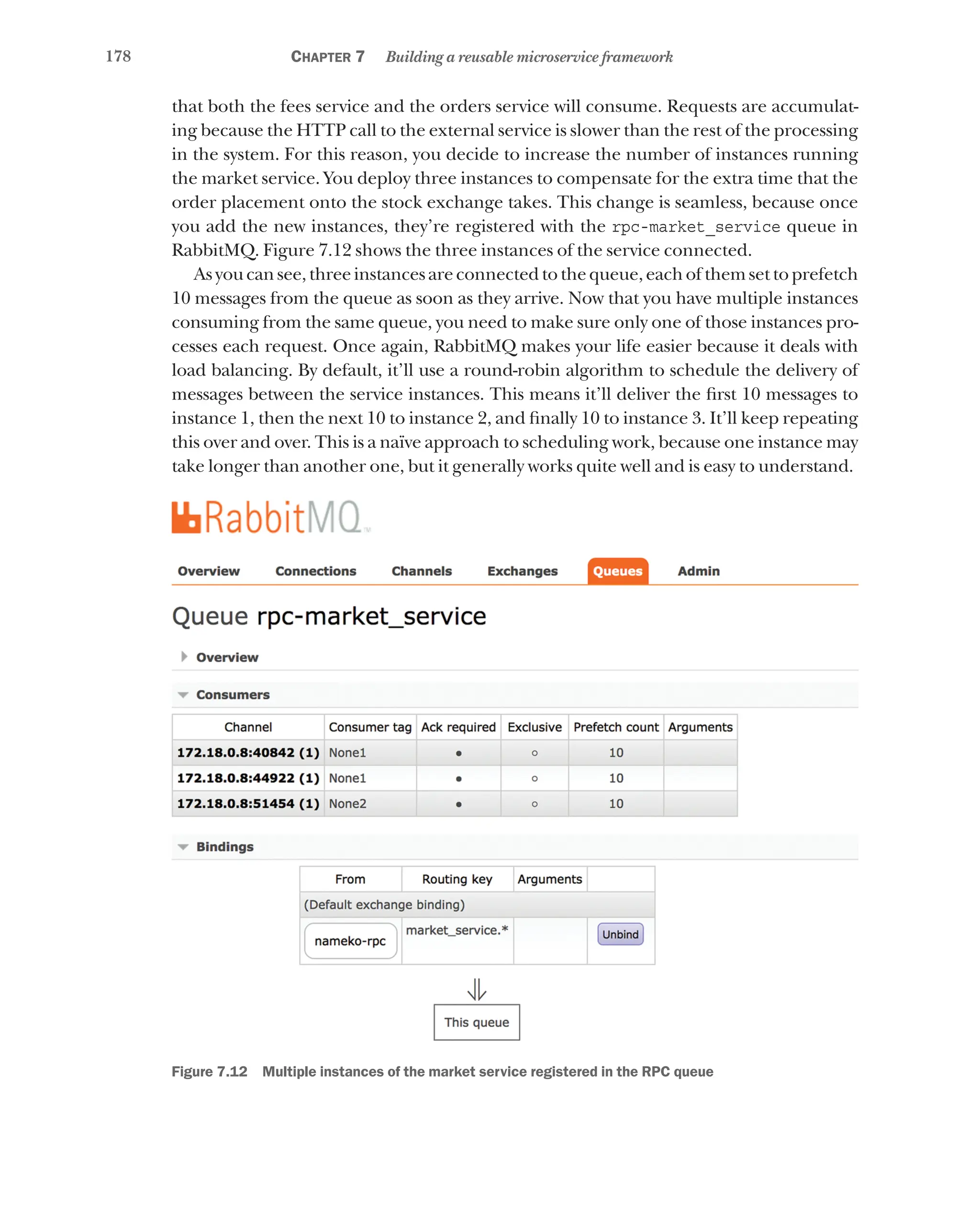
![179
Designing a chassis
The only thing you need to be careful about is checking if the connected instances
are healthy so they don’t start accumulating messages. You can do so by making use
of metrics, using StatsD, to monitor the number of messages that each instance is
processing and if they’re accumulating. In your code, you also can implement health
checks so that any instance not responding to those health check requests can be
flagged and restarted. RabbitMQ also will work as a limiting buffer, storing messages
until the service instances can process them. According to the configuration shown in
figure 7.12, each instance will receive ten messages to process at a time and will only
be assigned new messages after it has finished processing previous ones.
It’s worth mentioning that in the particular case of the market service as it interacts
with a third-party system, you also implement a circuit breaking mechanism. Let’s look
at the service code where the call to the stock exchange is implemented, as follows.
Listing 7.9 microservices-in-action/chapter-7/feature/market/app.py
import json
import requests
(…)
from statsd import StatsClient
from circuitbreaker import circuit
class MarketService:
name = "market_service"
statsd = StatsClient('statsd-agent', 8125,
prefix='simplebank-demo.market')
(…)
@statsd.timer('place_order_stock_exchange')
@circuit(failure_threshold=5, expected_exception=
➥ConnectionError)
def __place_order_exchange(self, request):
print("[{}] {} placing order to stock exchange".format(
request, self.name))
response = requests.get('https://jsonplaceholder.typicode.com/
posts/1')
return json.dumps({'code': response.status_code, 'body': response.
text})
You make use of the circuit breaker library to configure the number of consecutive fail-
ures to connect that you’ll tolerate. In the example shown, if you have five consecutive
failing calls with the ConnectionError exception, you’ll open the circuit, and no call
will be made for 30 seconds. After those 30 seconds, you’ll enter the recovery stage,
allowing one test call. If the call is successful, it’ll close the circuit again, resuming nor-
mal operation and allowing calls to the external service; otherwise, it’ll prevent calls
for another 30 seconds.
Imports the circuit breaker
functionality to use in the module
Allows you to configure how many exceptions you tolerate before
opening the circuit and the type of exceptions that’ll count as a failure](https://image.slidesharecdn.com/microservicesinaction-240113230140-1bc300cc/75/microservices-in-action-pdf-206-2048.jpg)

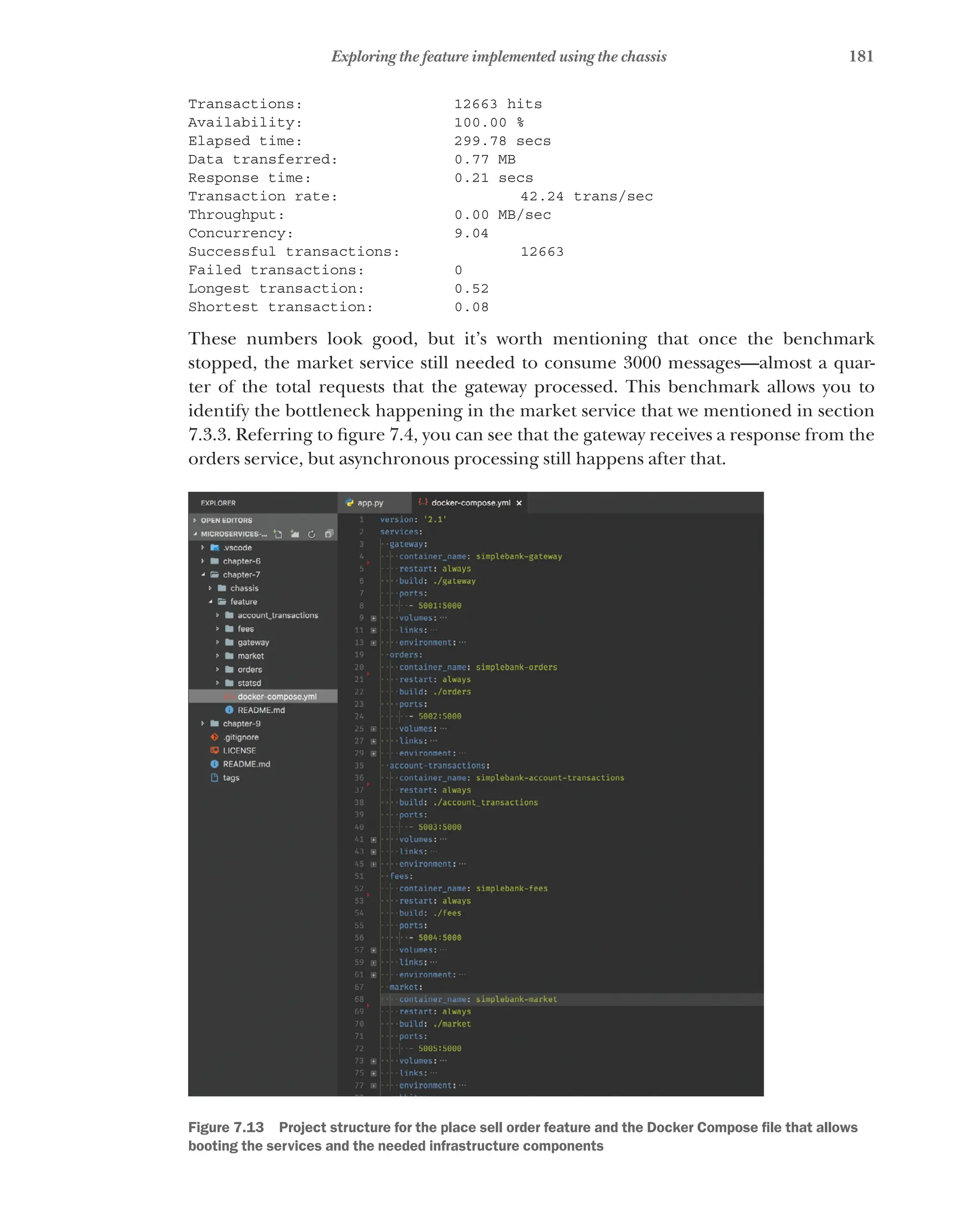
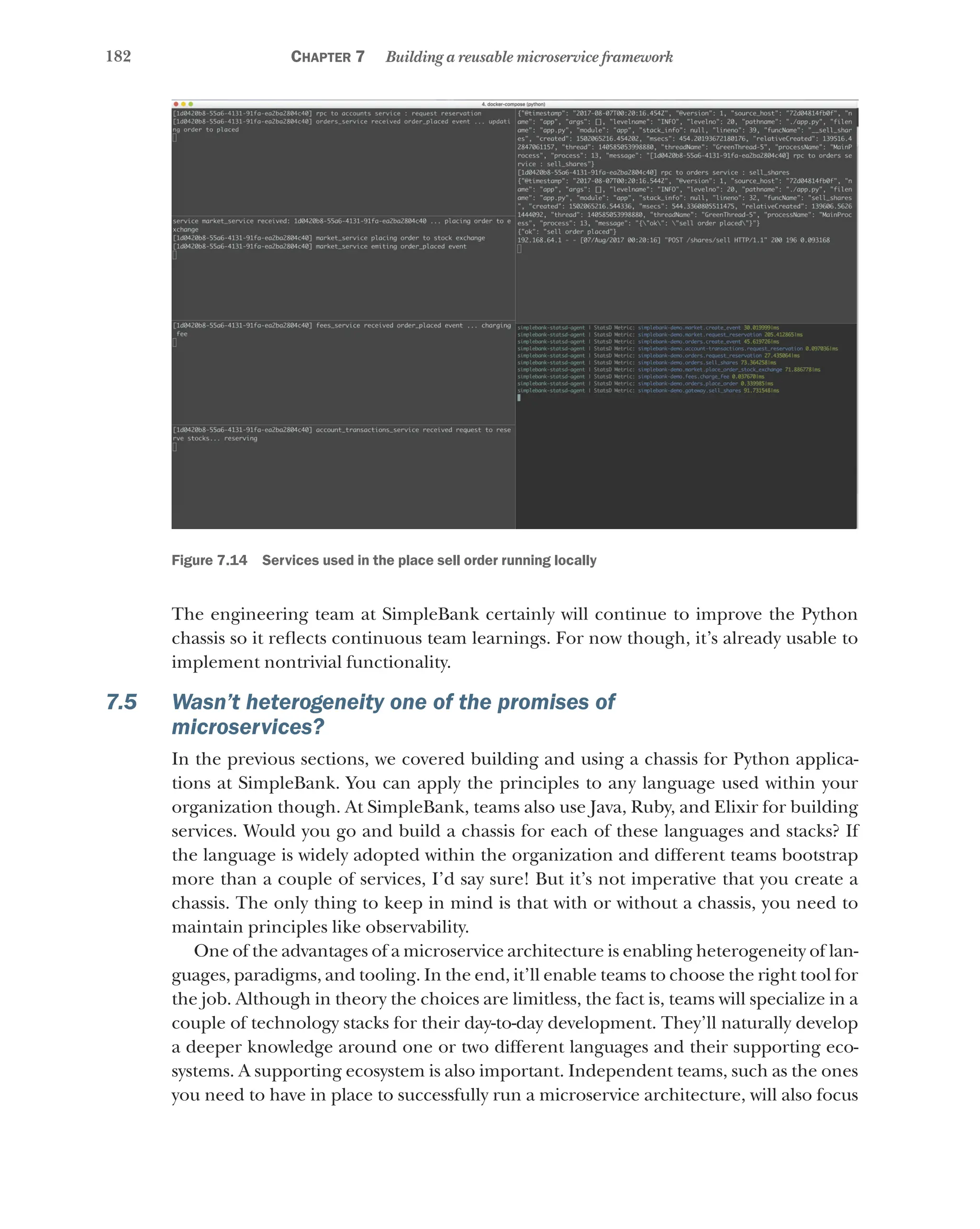




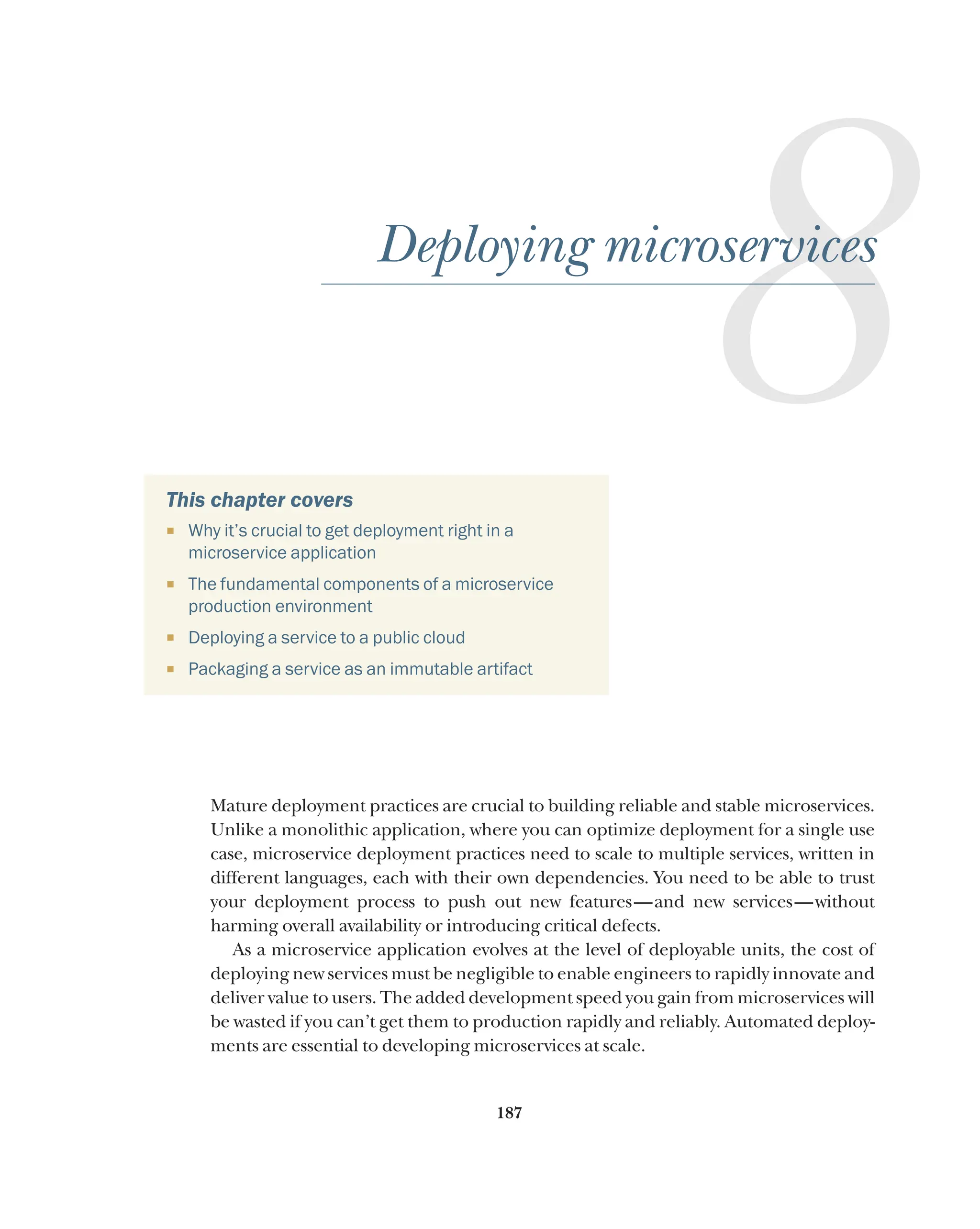
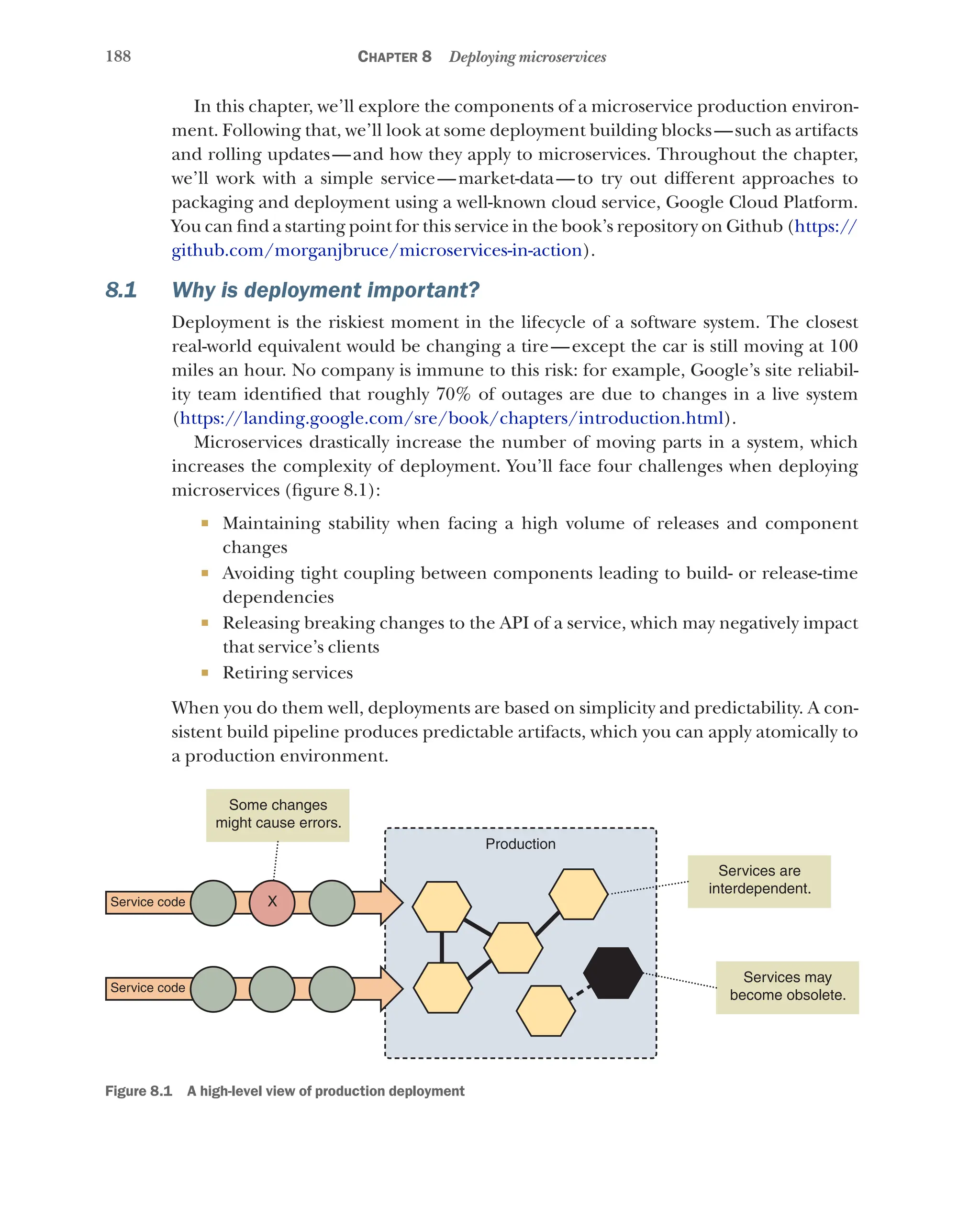
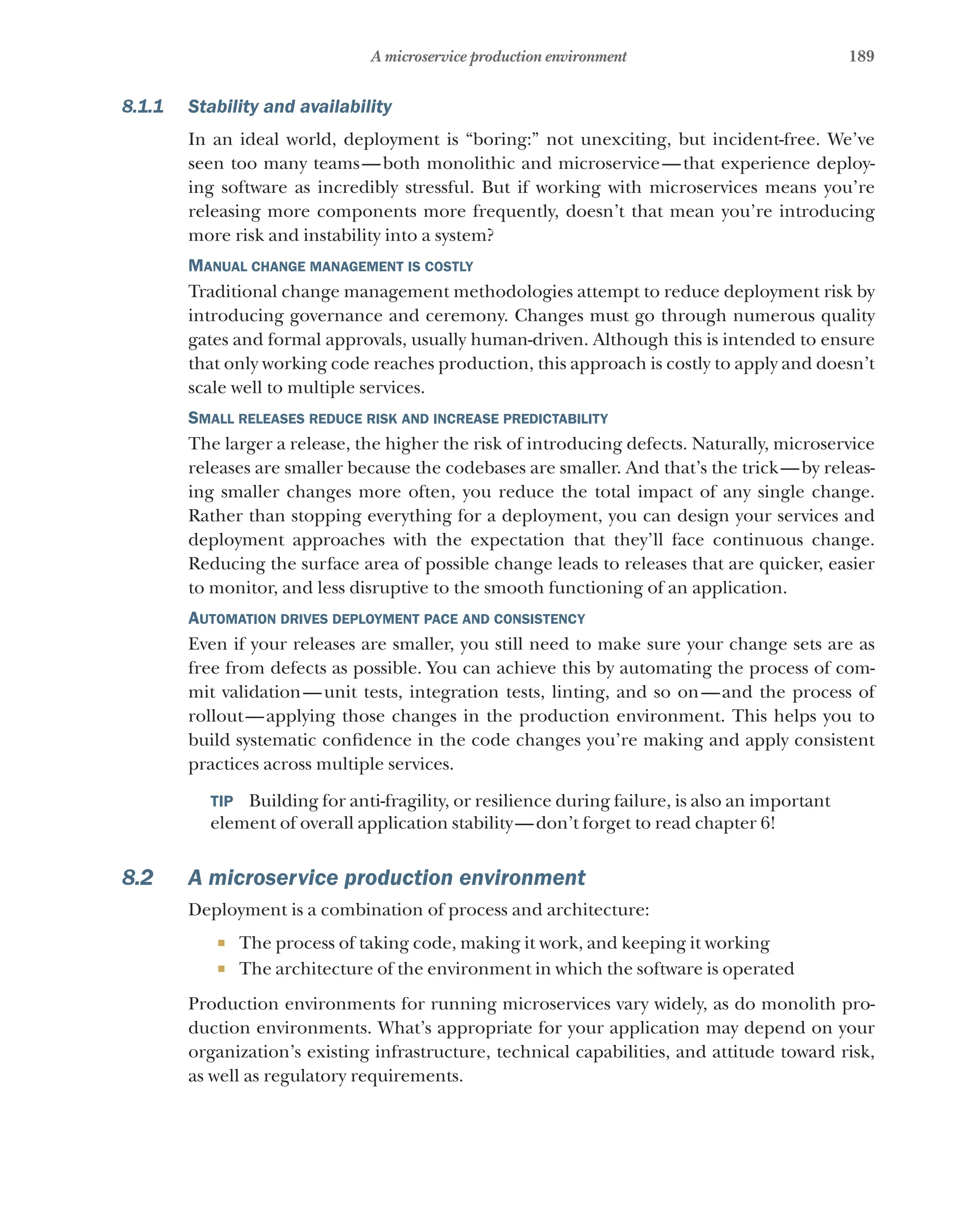
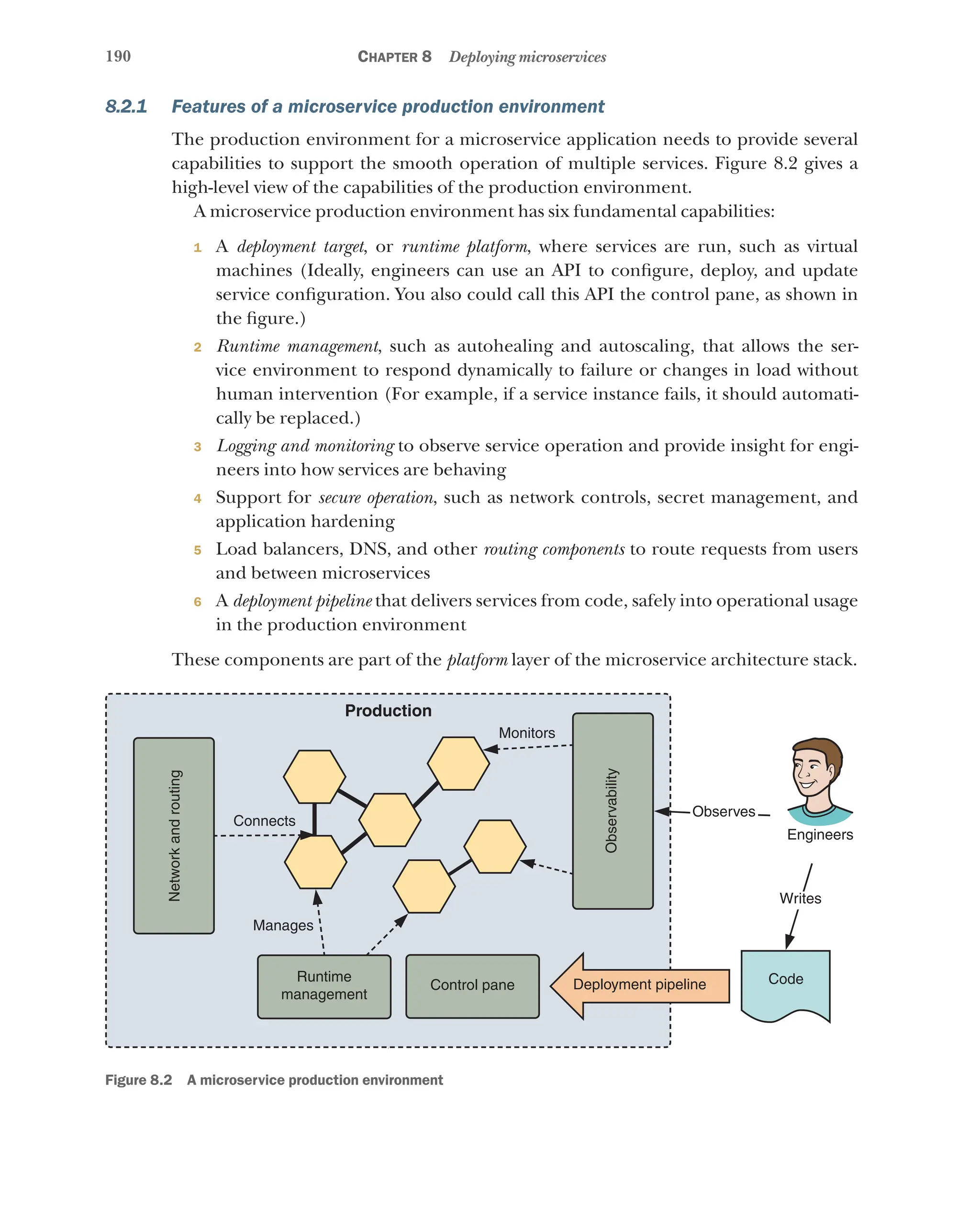

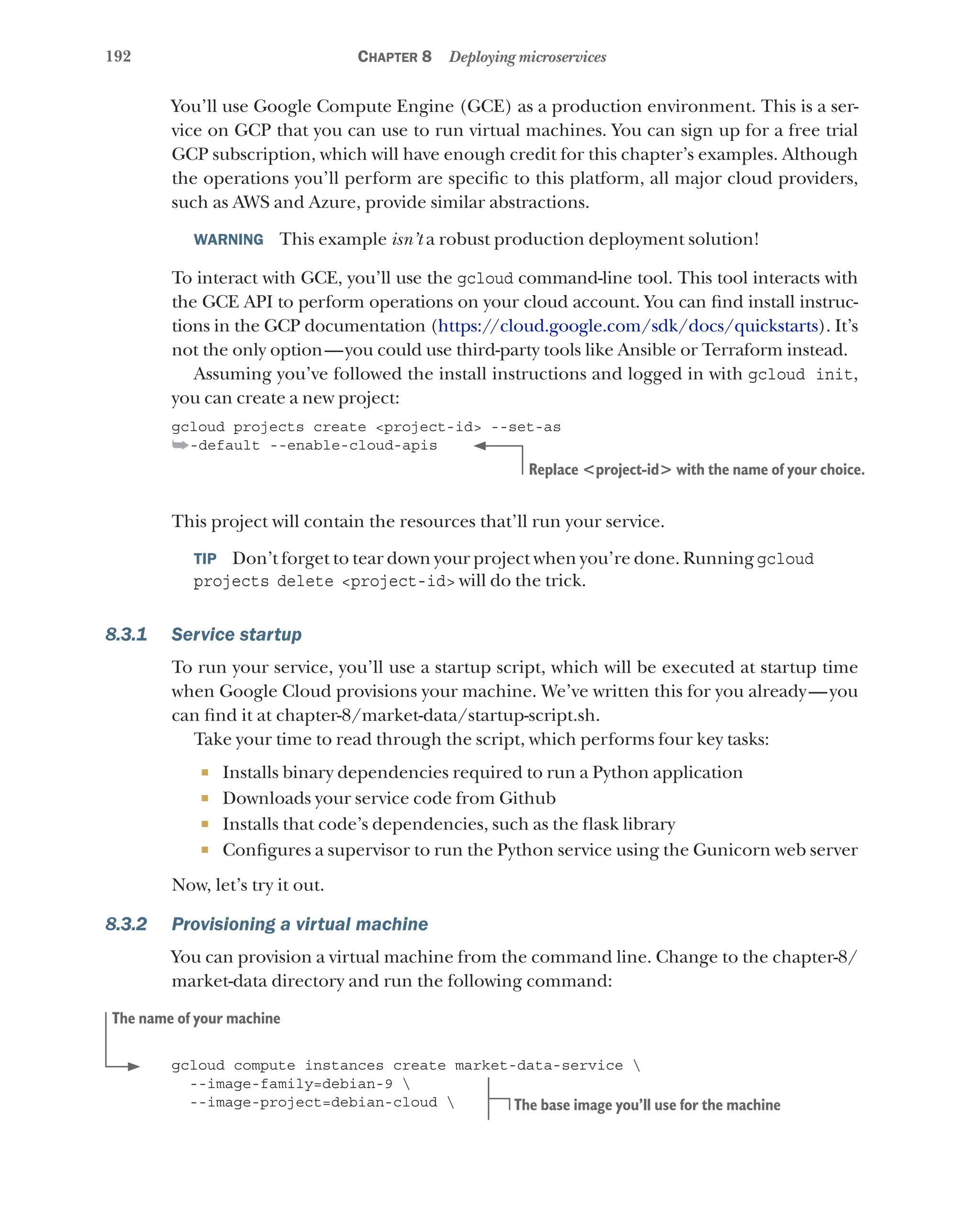
![193
Deploying a service, the quick way
--machine-type=g1-small
--scopes userinfo-email,cloud-platform
--metadata-from-file startup-script=startup
➥-script.sh
--tags api-service
--zone=europe-west1-b
This will create a machine and return the machine’s external IP address—something
like figure 8.4.
This approach to startup does take a while. If you want to watch the progress of the
startup process, you can tail the output of the virtual machine’s serial port:
gcloud compute instances tail-serial-port-output market-data-service
Once the startup process has completed, you should see a message in the log, similar
to this example:
Mar 16 12:17:14 market-data-service-1 systemd[1]: Startup finished in
➥ 1.880s (kernel) + 1min 52.486s (userspace) = 1min 54.367s.
Great! You’ve got a running service—although you can’t call it yet. You’ll need to open
the firewall to make an external call to this service. Running the following command
will open up public access to port 8080 for all services with the tag api-service:
gcloud compute firewall-rules create default-allow-http-8080
--allow tcp:8080
--source-ranges 0.0.0.0/0
--target-tags api-service
--description "Allow port 8080 access to api-service"
You can test your service by curling the external IP of the virtual machine. The external
IP was returned when you created the instance (figure 8.4). If you didn’t note it, you can
retrieve all instances by running gcloud compute instances list. Here’s the curl:
curl -R http://<EXTERNAL-IP>:8080/ping
If all is going well, the response you get will be the name of the virtual machine—
market-data-service.
Figure 8.4 Information about a newly created virtual machine
The size of the machine to provision
Starts up using your startup script
Identifies this machine’s workload
The compute zone—or data center—where this service should start
Allows tcp queries to port 8080
From any IP address
To machines with the api-service tag
Replace EXTERNAL-IP with the
IP address of your service.](https://image.slidesharecdn.com/microservicesinaction-240113230140-1bc300cc/75/microservices-in-action-pdf-220-2048.jpg)
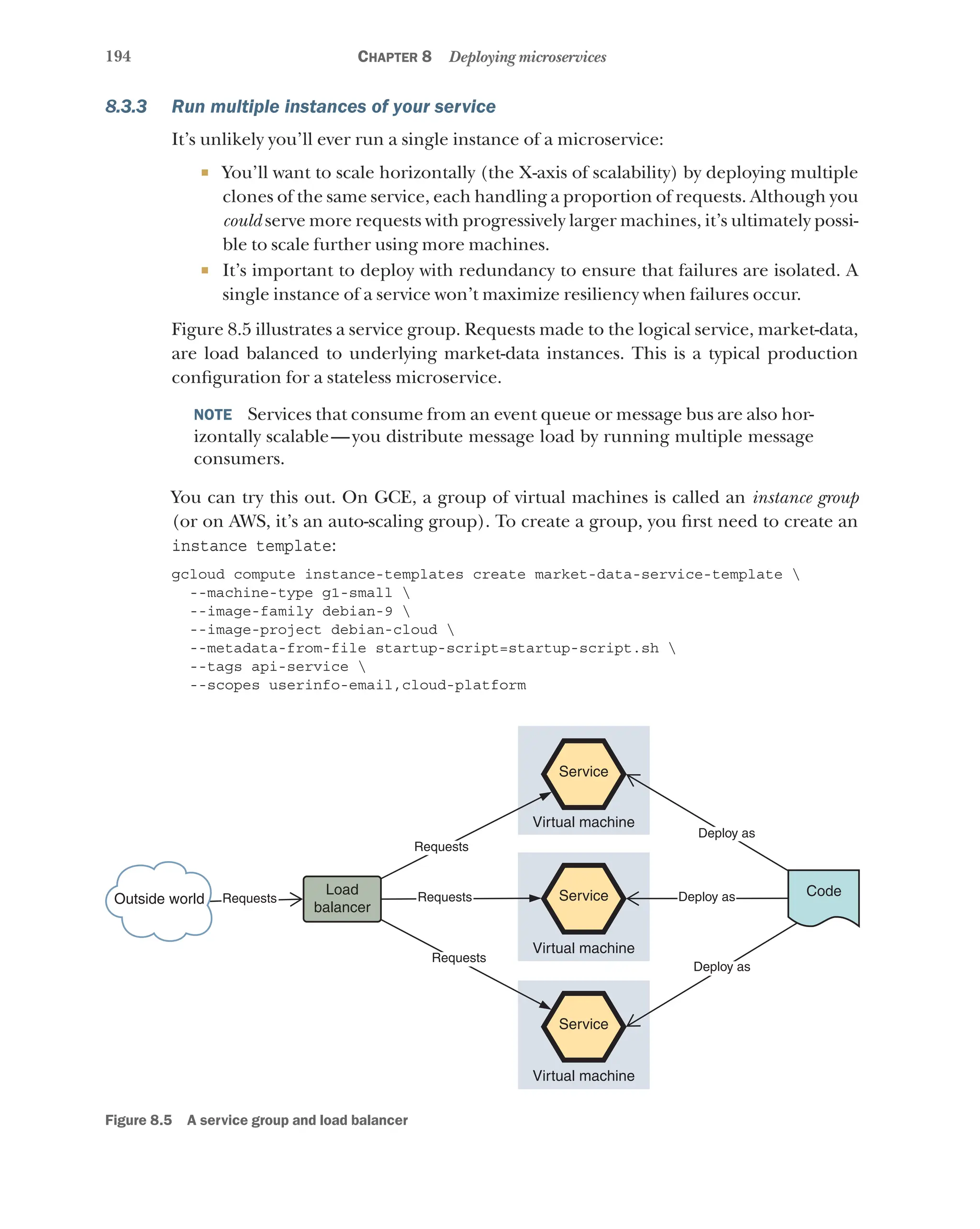
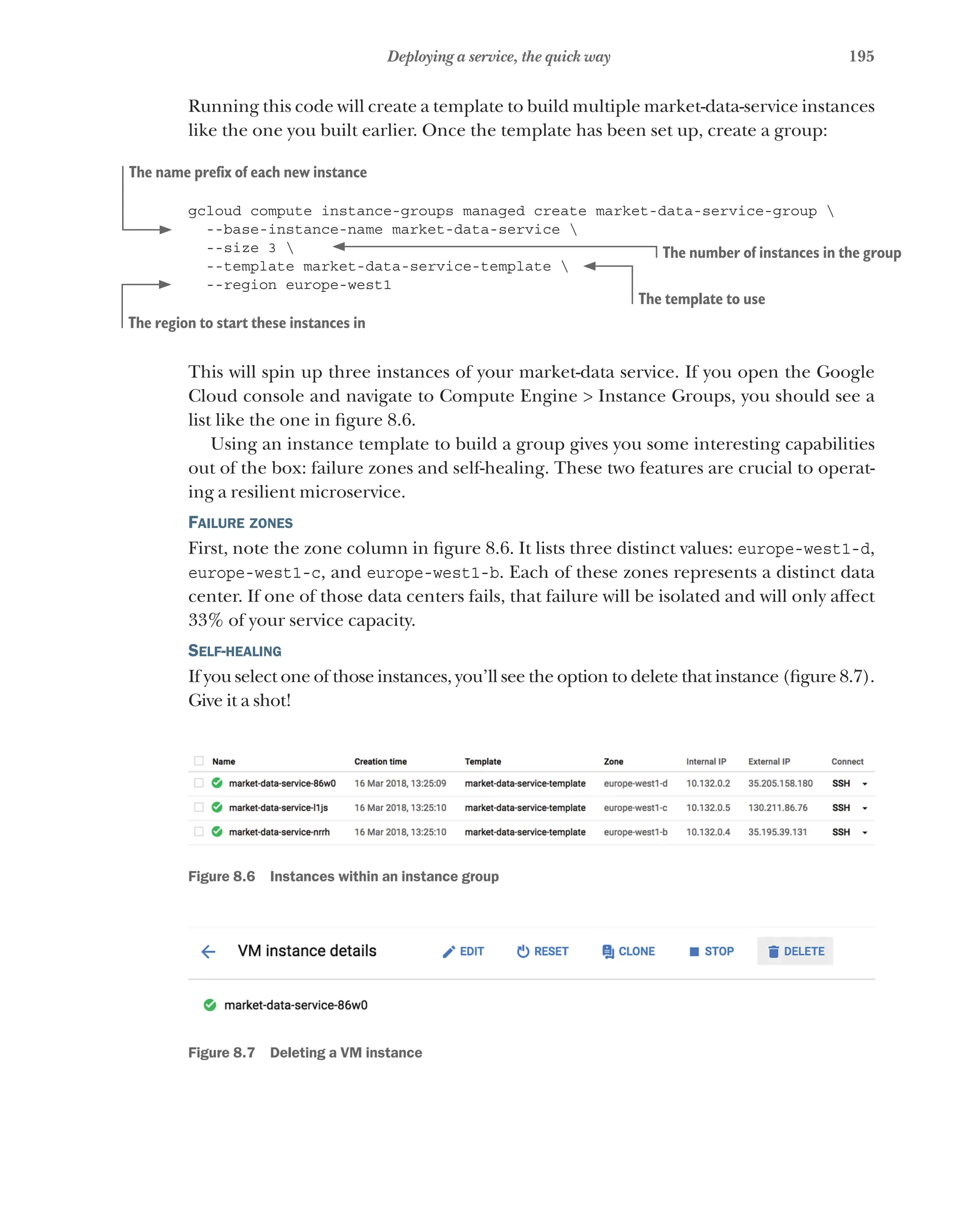
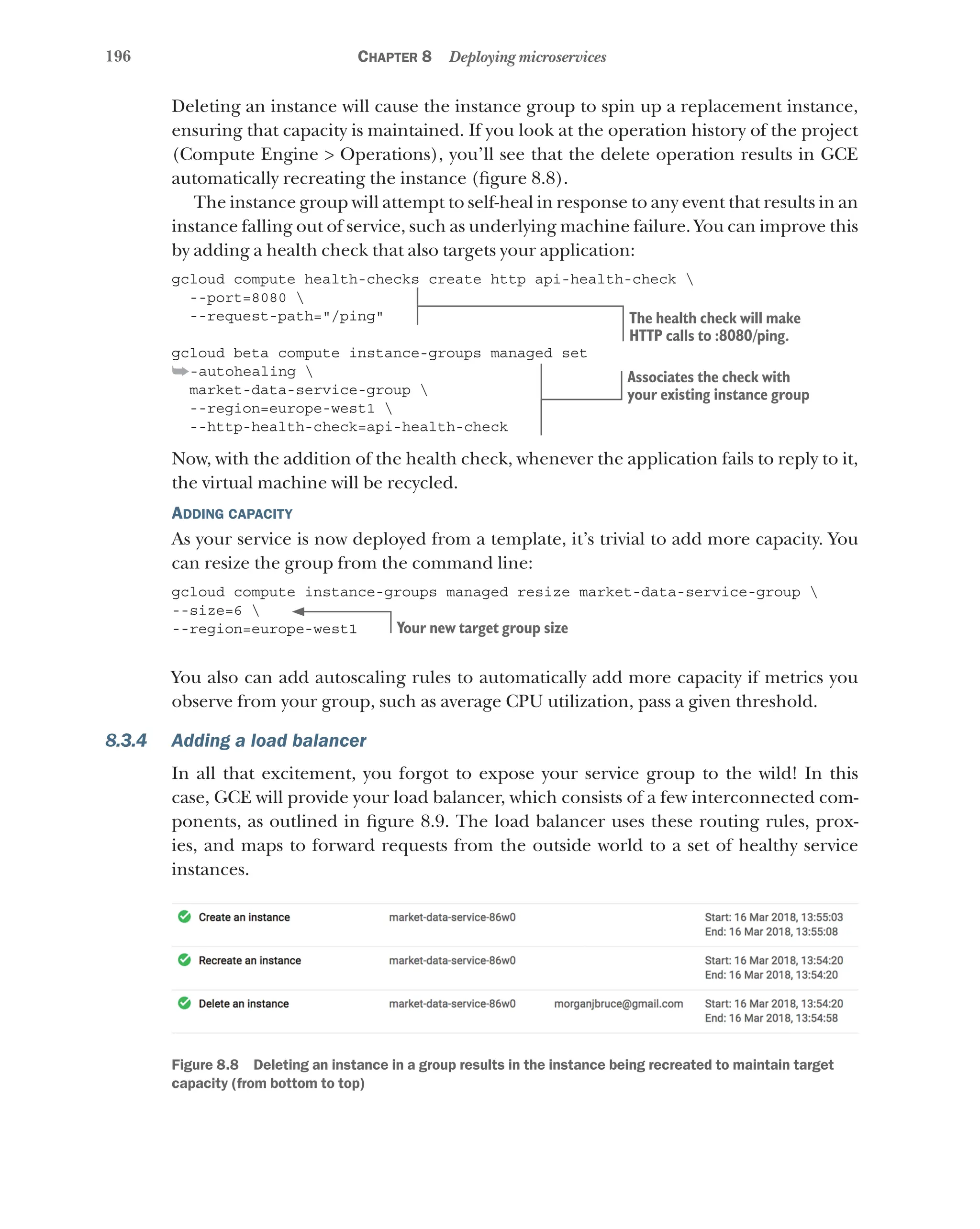

![198 Chapter 8 Deploying microservices
Finally, you need to create a static IP address for your service and a forwarding rule
that connects that IP to the HTTP proxy you’ve created:
gcloud compute addresses create market-data-service-ip
--ip-version=IPV4
--global
export IP=`gcloud compute addresses describe market
➥-data-service-ip --global --format json | jq –raw
➥-output '.address'`
gcloud compute forwarding-rules create
➥api-forwarding-rule
--address $IP
--global
--target-http-proxy api-proxy
--ports 80
printenv IP
This code creates a public IP address and configures requests to that IP to be forwarded
to your HTTP proxy and on to your backend service. Once run, these rules take sev-
eral minutes to propagate. After a wait, try to curl the service—curl "http://$IP/
ping?[1-100]". That will start you with 100 requests. If you see the names of differ-
ent market-data nodes being output to your terminal—terrific—you’ve deployed a
load-balanced microservice!
NOTE In the real world, you’d be unlikely to expose microservices directly to
the outside world. You’re only doing it here because it makes testing much
easier. GCE also supports internal load balancing (https://cloud.google.com/
load-balancing/docs/internal/) and Cloud Endpoints, a managed API gate-
way (https://cloud.google.com/endpoints/).
8.3.5 What have you learned?
In these examples, you’ve built some of the key elements of a microservice deployment
process:
¡ Using an instance template established a primitive deployment operation, mak-
ing it simple to add and remove capacity for a given service.
¡ Combining instance groups, load balancers, and health checks allowed you to
autoscale and autoheal your microservice deployment.
¡ Deploying into independent zones helped you build bulwarks to limit the impact
of failures.
But a few things are missing. Your releases weren’t predictable, because you pulled
your latest code and compiled it on the machine. A new code commit could cause dif-
ferent service instances to be running inconsistent versions of the code (figure 8.10).
Without any explicit versioning or packaging, there would be no easy way to roll your
code forward or back.
Retrieves the IP address
Adds a forwarding rule that forwards
from the IP address to the HTTP proxy
Outputs the IP address you created](https://image.slidesharecdn.com/microservicesinaction-240113230140-1bc300cc/75/microservices-in-action-pdf-225-2048.jpg)
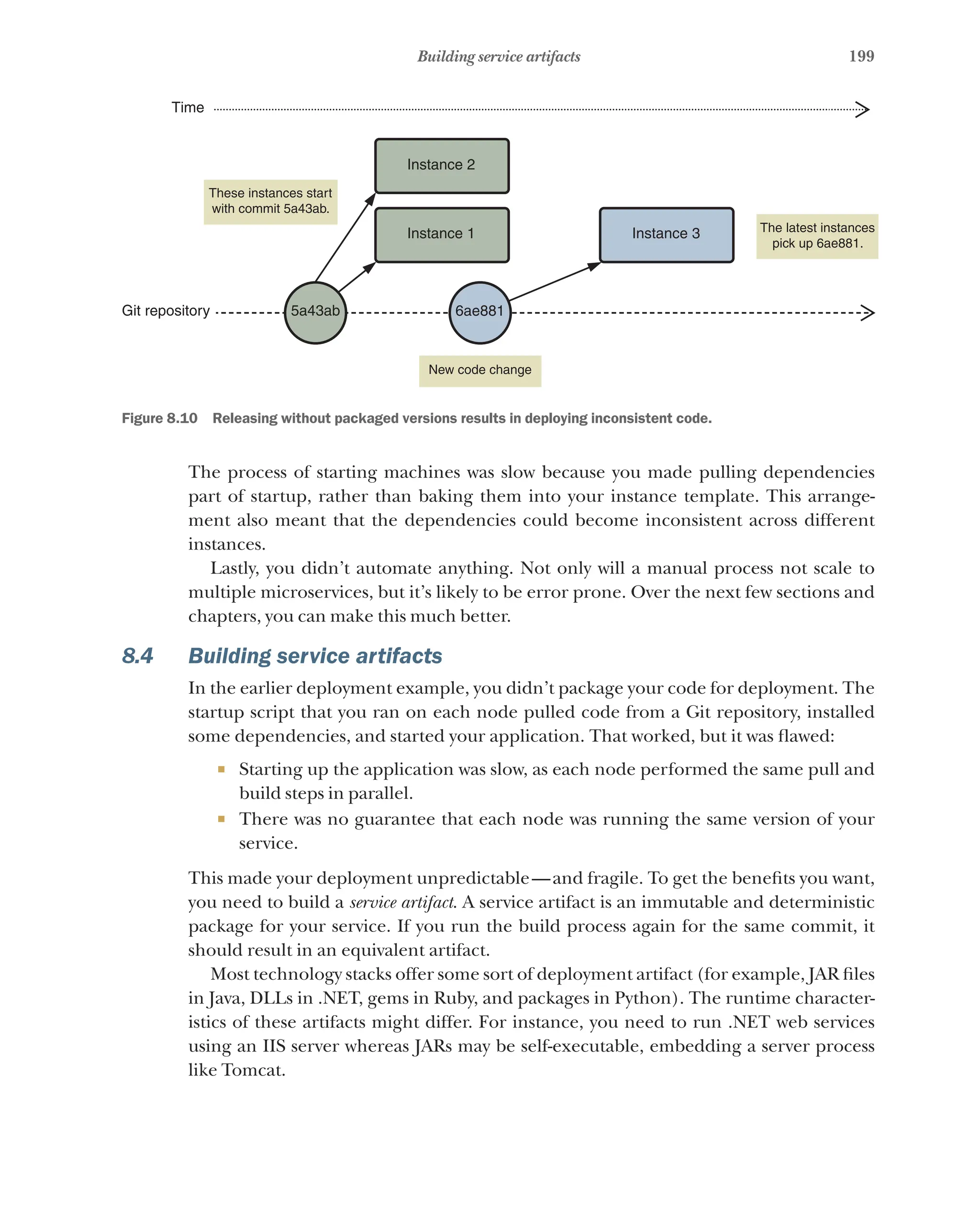
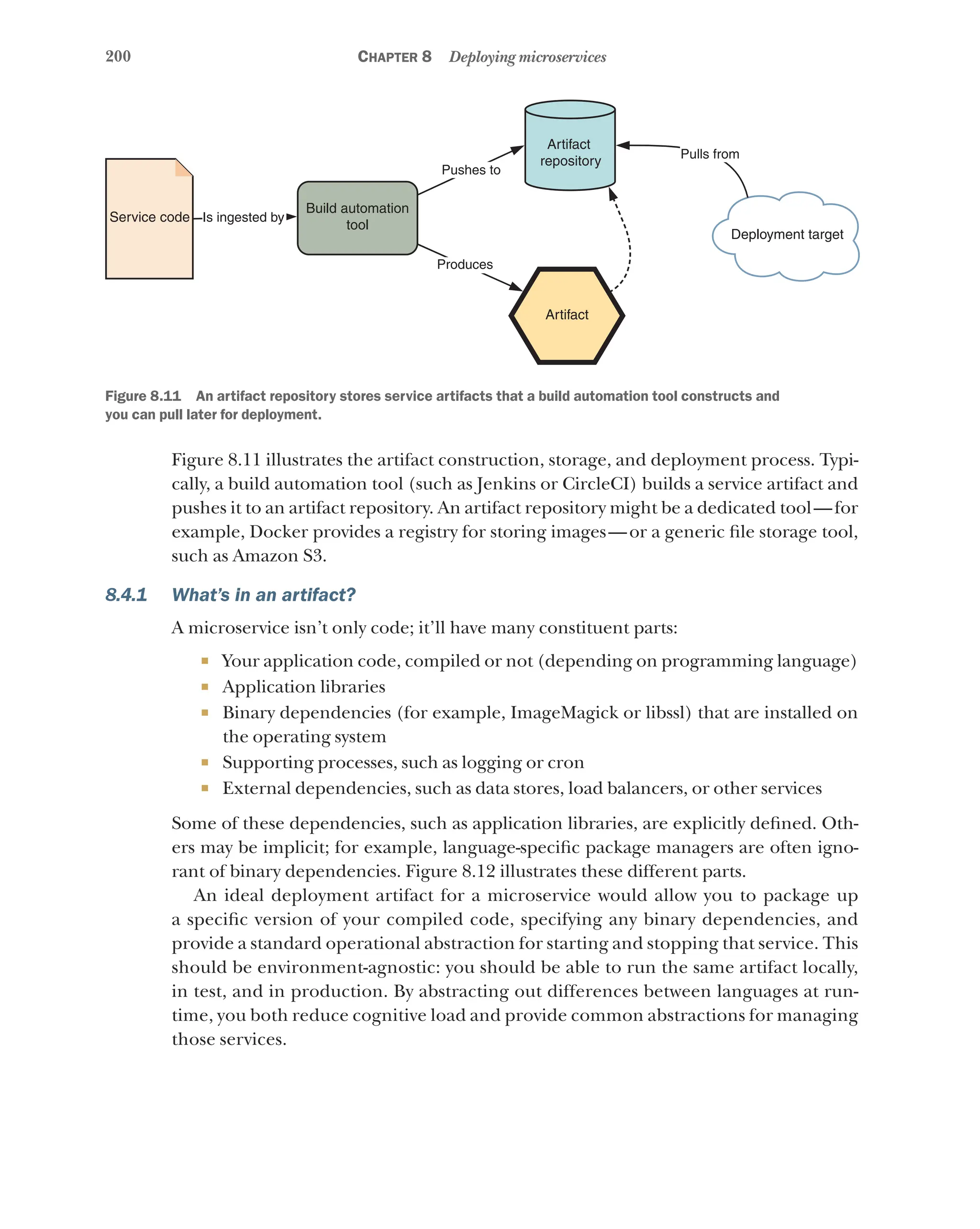
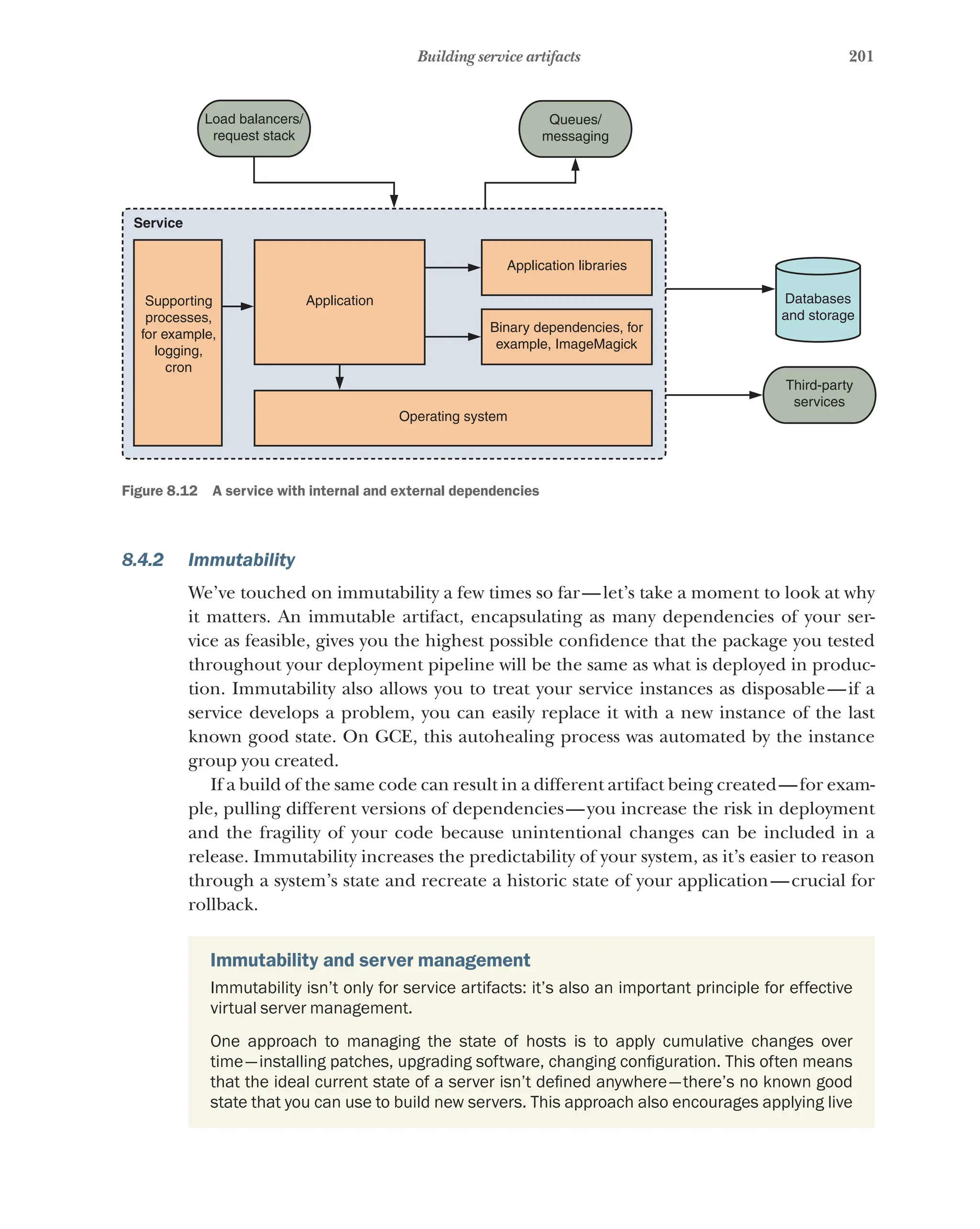
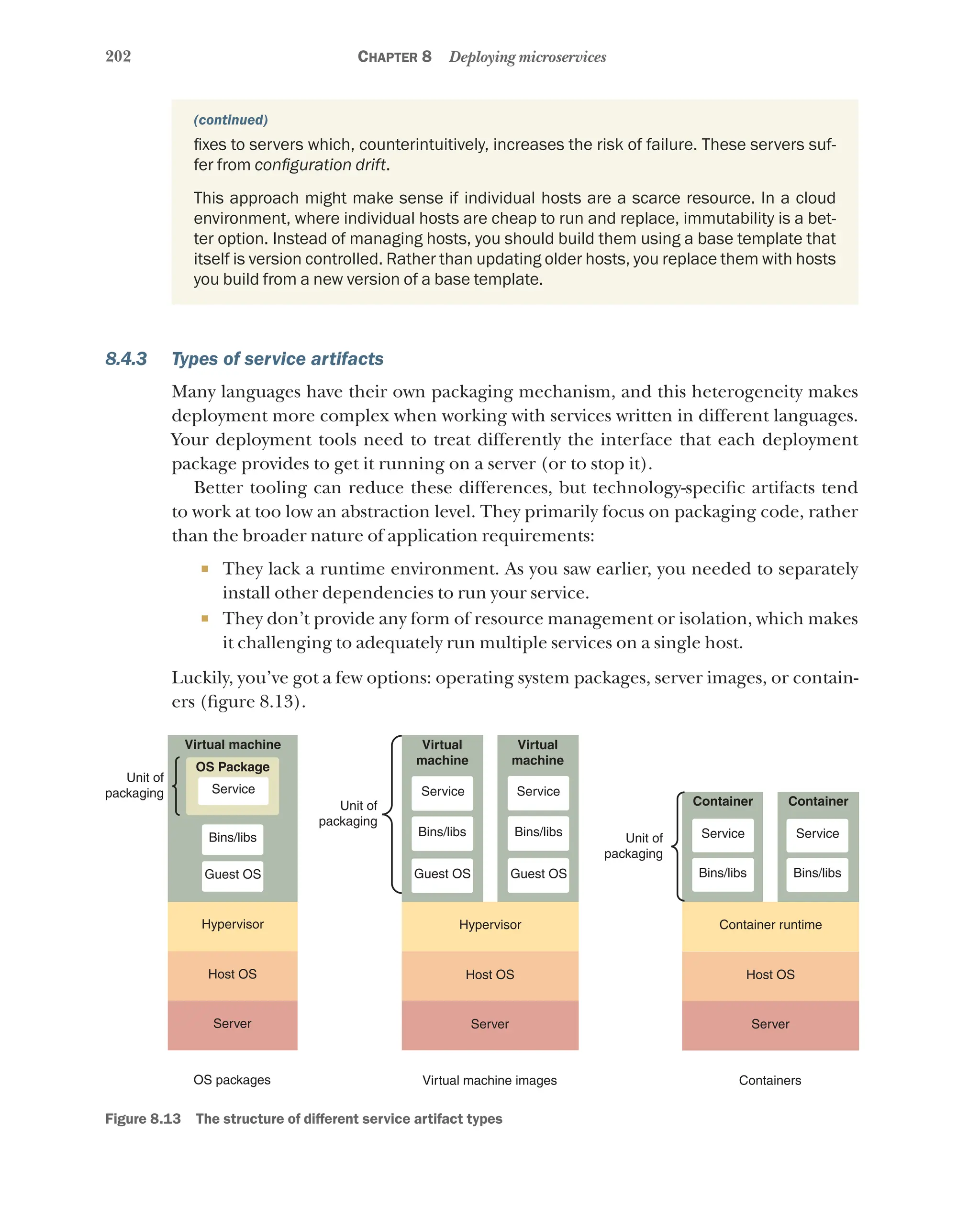

![204 Chapter 8 Deploying microservices
},
"builders":
[
{
"type": "googlecompute",
"project_id": "market-data-1",
"source_image_family": "debian-9",
"zone": "europe-west1-b",
"image_name": "market-data-service-{{user `commit`}}",
"image_description": "image built for market-data
➥-service {{user `commit`}}",
"instance_name": "market-data-service-{{uuid}}",
"machine_type": "n1-standard-1",
"disk_type": "pd-ssd",
"ssh_username": "debian",
"startup_script_file": "startup-script.sh"
}
]
}
Now, run the packer build command from within the chapter-8/market-data
directory:
packer build
-var "commit=`git rev-parse head`"
instance-template.json
If you watch the console output, it’ll reflect the four steps I outlined above: using the
GCE API, Packer will start an instance, run the startup script, and save the instance as a
new template image, tagged with the source Git commit. You can use the Git commit to
explicitly distinguish different versions of your code.
NOTE In this case, you still pulled code directly from Git to your machine
image. In complied languages such as Java, compilation into an executable
should be a separate step that a build automation tool executes.
This approach builds an immutable, predictable, and self-contained artifact. This
immutable server pattern, combined with a configuration tool like Packer, allows you
to store a reproducible base state as code.
It has a few limitations:
¡ Images are locked to one cloud provider, making them nontransferable to other
providers as well as to developers who want to recreate the deployed artifact on
their machines.
¡ Image builds are often slow because of the lengthy time it takes to spin up a
machine and take a snapshot.
¡ It’s not easy for you to use for a multiple service-per-host model.
Defines how an image will be built
Gets the latest commit hash
Uses the instance template defined in listing 8.1](https://image.slidesharecdn.com/microservicesinaction-240113230140-1bc300cc/75/microservices-in-action-pdf-231-2048.jpg)
![205
Building service artifacts
Containers
Instead of distributing entire machines, containerization tools, such as Docker or rkt,
provide a more lightweight approach to encapsulating an application and its depen-
dencies. You can run multiple containers on one machine, isolated from each other
but with lower resource overhead than a virtual machine because they share the kernel
of one operating system. They avoid the overhead of virtualizing the disk and guest
operating system of each virtual machine.
Try a quick example using Docker. (You can find instructions for installing Docker
on the Docker website: https://docs.docker.com/install/.) You build a Docker image
from a Dockerfile. Add the following file to the chapter-8/market-data folder.
Listing 8.2 Dockerfile for market-data service
FROM python:3.6
ADD . /app
WORKDIR /app
RUN pip install -r requirements.txt
CMD ["gunicorn", "-c", "config.py", "app:app", "--bind"
➥, "0.0.0.0:8080"]
EXPOSE 8000
Then, use the docker command-line tool to build the container:
$ docker build -t market-data:`git rev-parse head` .
Sending build context to Docker daemon 71.17 kB
Step 1/3 : FROM python:3.6
---> 74145628c331
Step 2/3 : ADD . /app
---> bb3608d5143f
Removing intermediate container 74c250f83f8c
Step 3/3 : WORKDIR /app
---> 7a595179cc39
Removing intermediate container 19d3bffa4d2a
Successfully built 7a595179cc39
This will build a container image and tag it with the name market-data:<commit ID>.
Now that you’ve built an image for the application, you can run it locally. Try it out:
$ docker run -d -p 8080:8080 market-data:`git rev-parse head`
You’ll see startup logs from gunicorn in your terminal. If you like, try to curl the service
on port 8000. You probably noticed that startup and build time for the container was
significantly faster than the virtual machines on GCE. This is one of the key benefits of
using containers.
Starts from a public base
image for Python apps
Adds your application code to the container
Installs the service’s requirements
Sets a startup command for the service
Exposes the service’s
port from the container](https://image.slidesharecdn.com/microservicesinaction-240113230140-1bc300cc/75/microservices-in-action-pdf-232-2048.jpg)

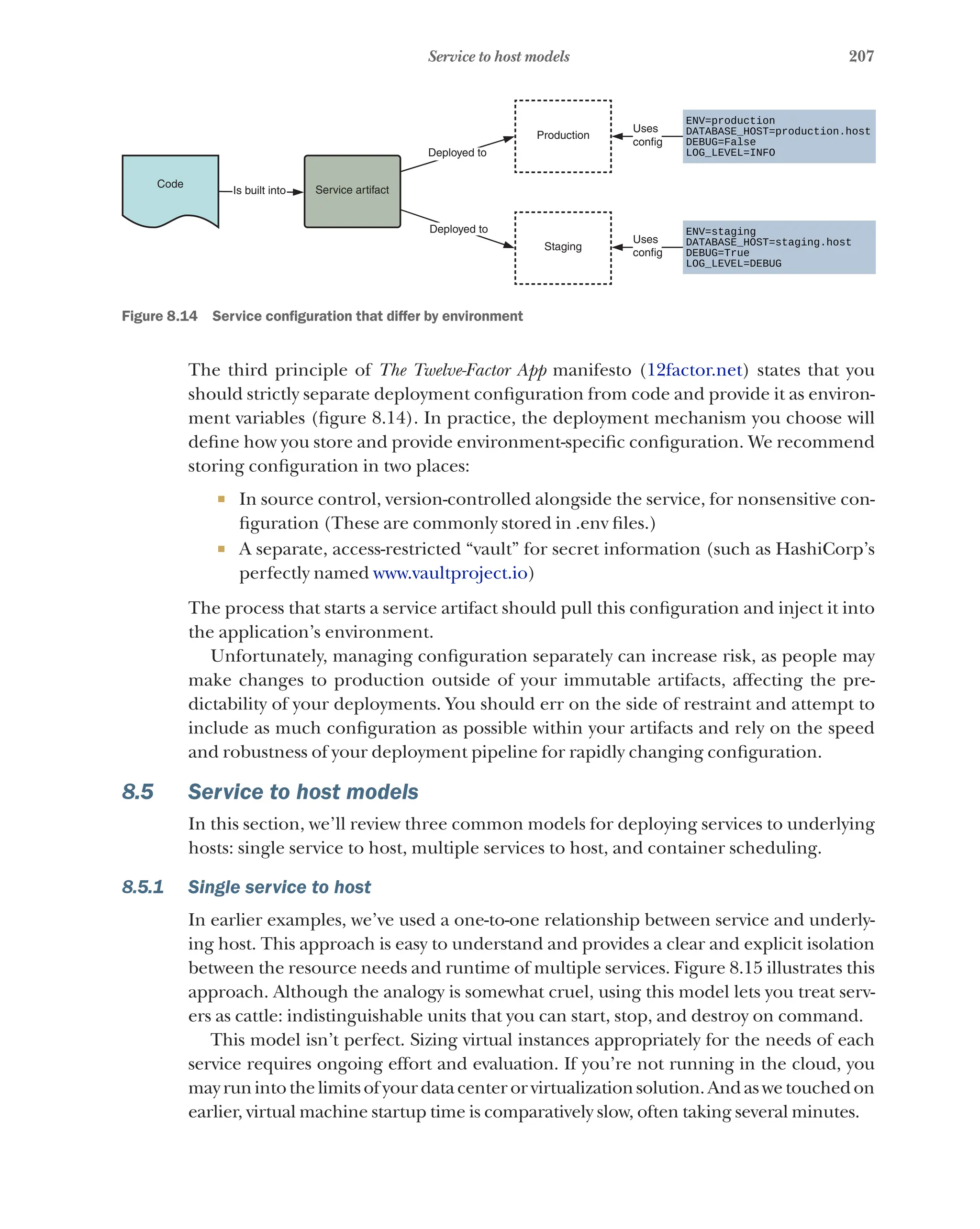
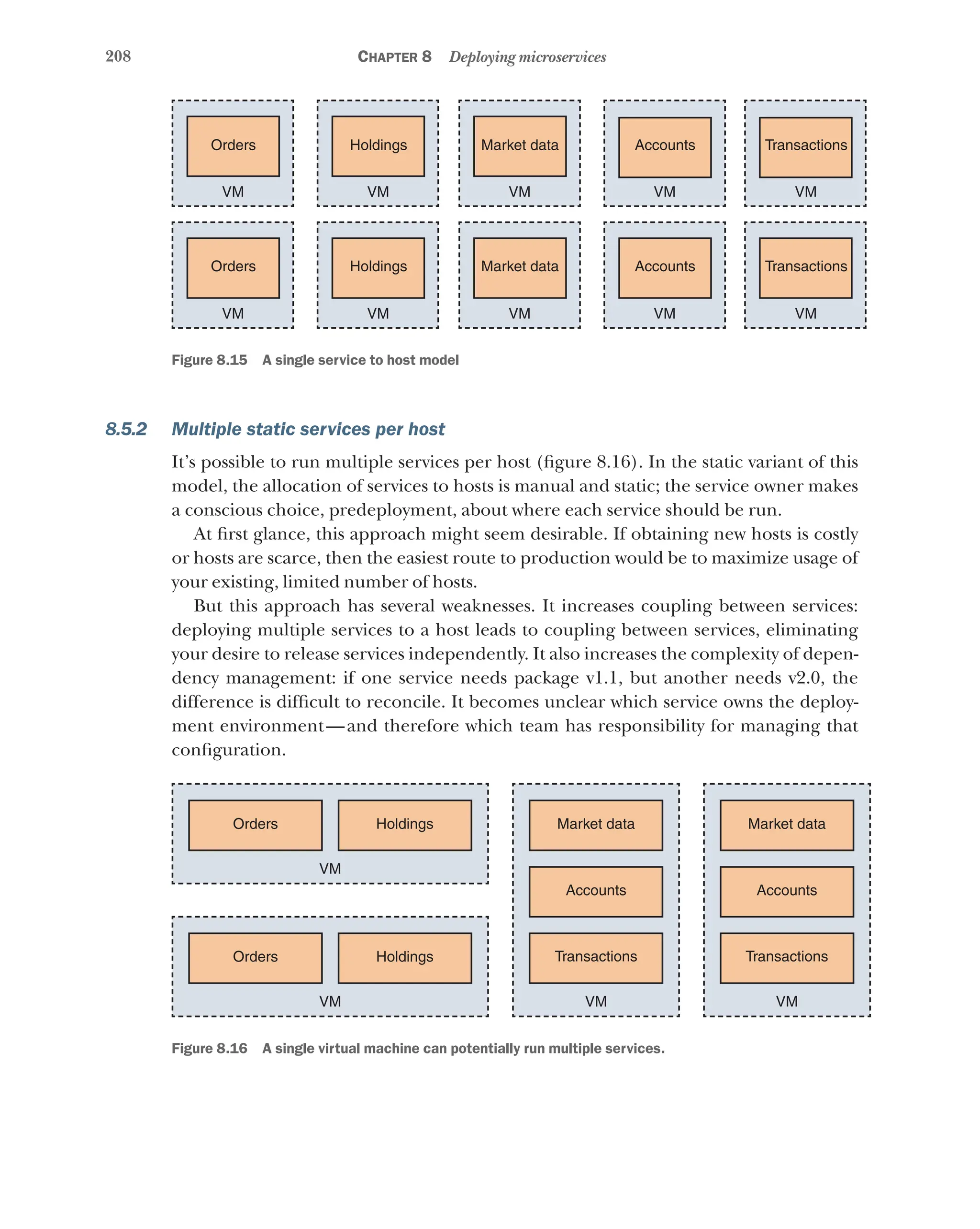
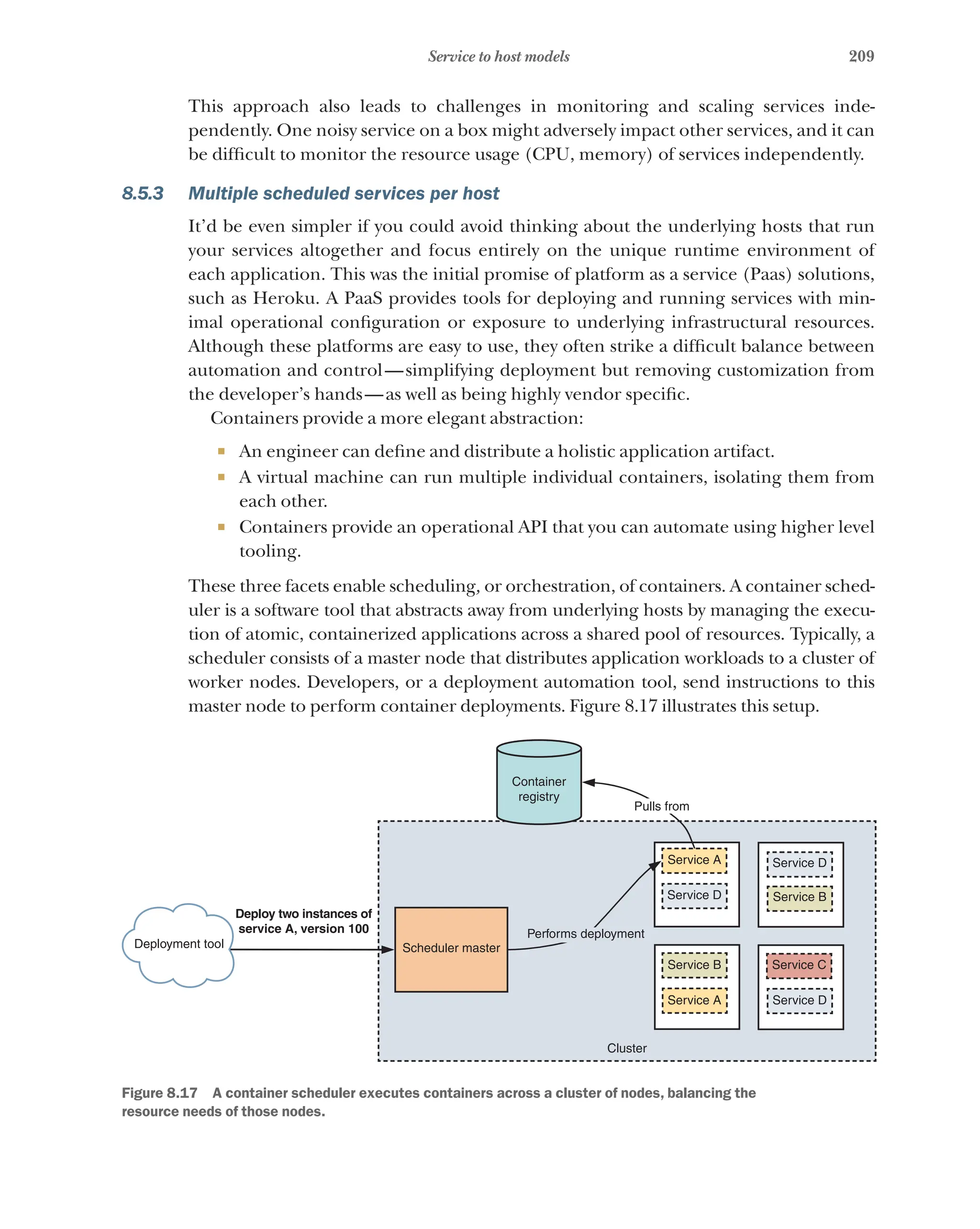
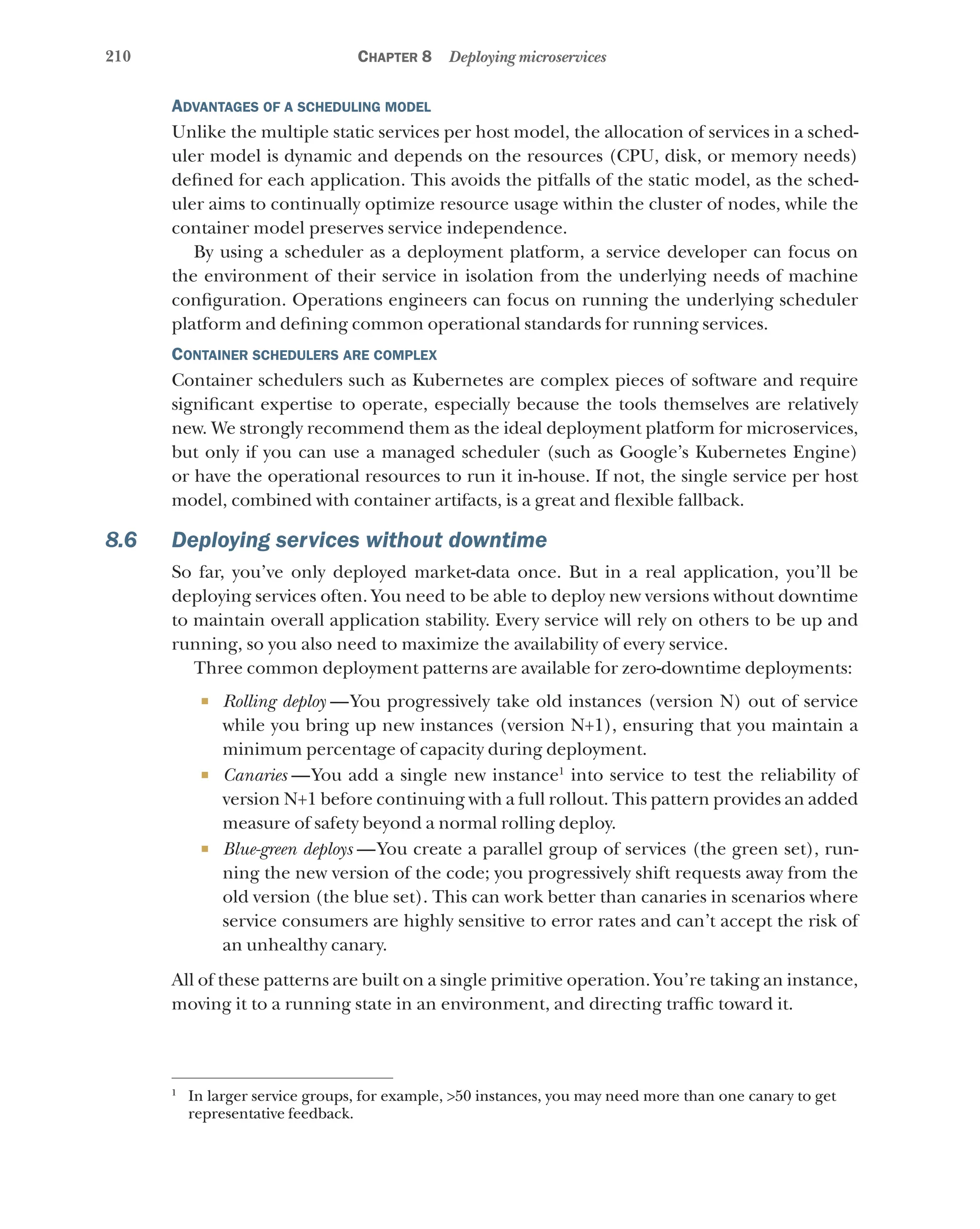

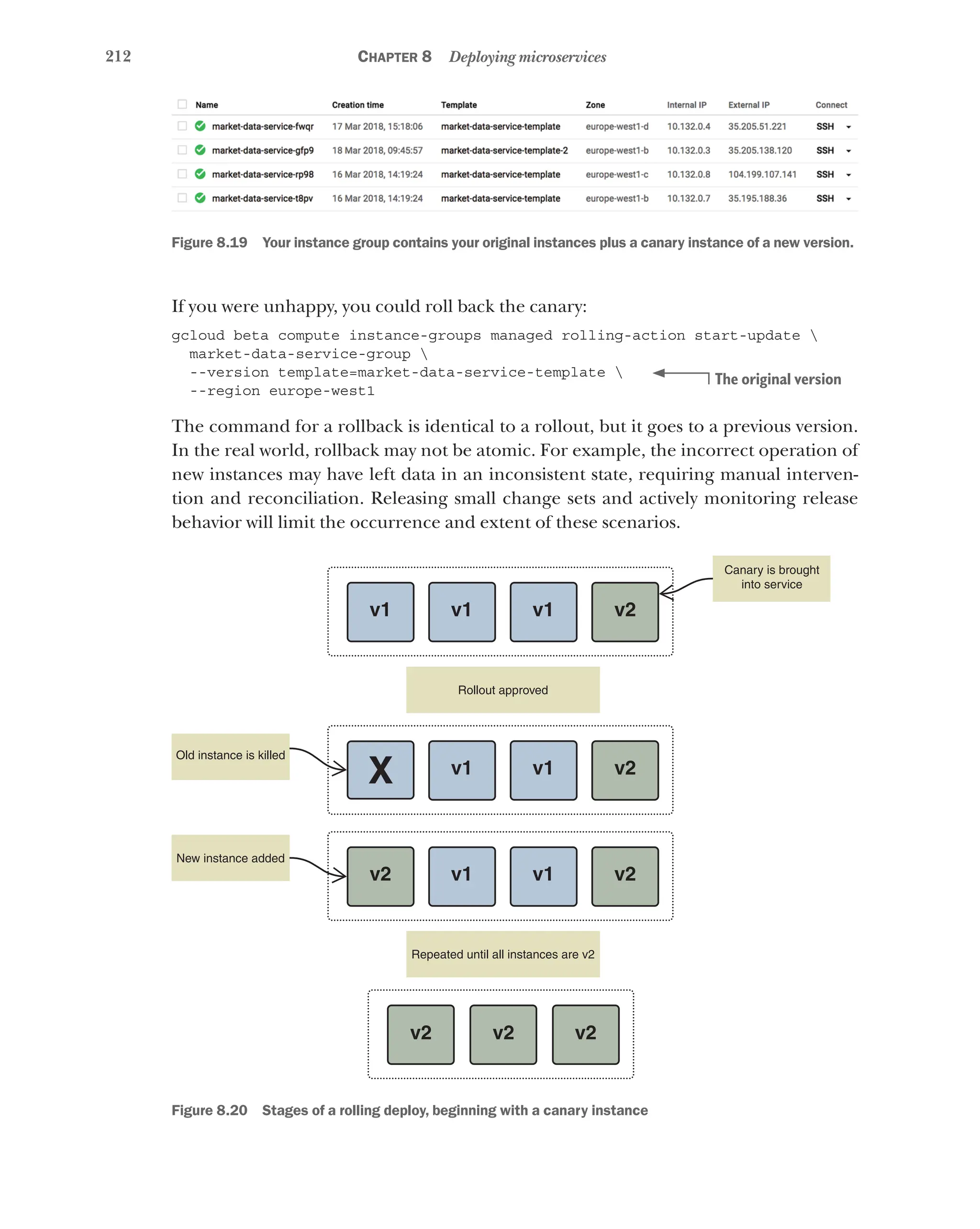

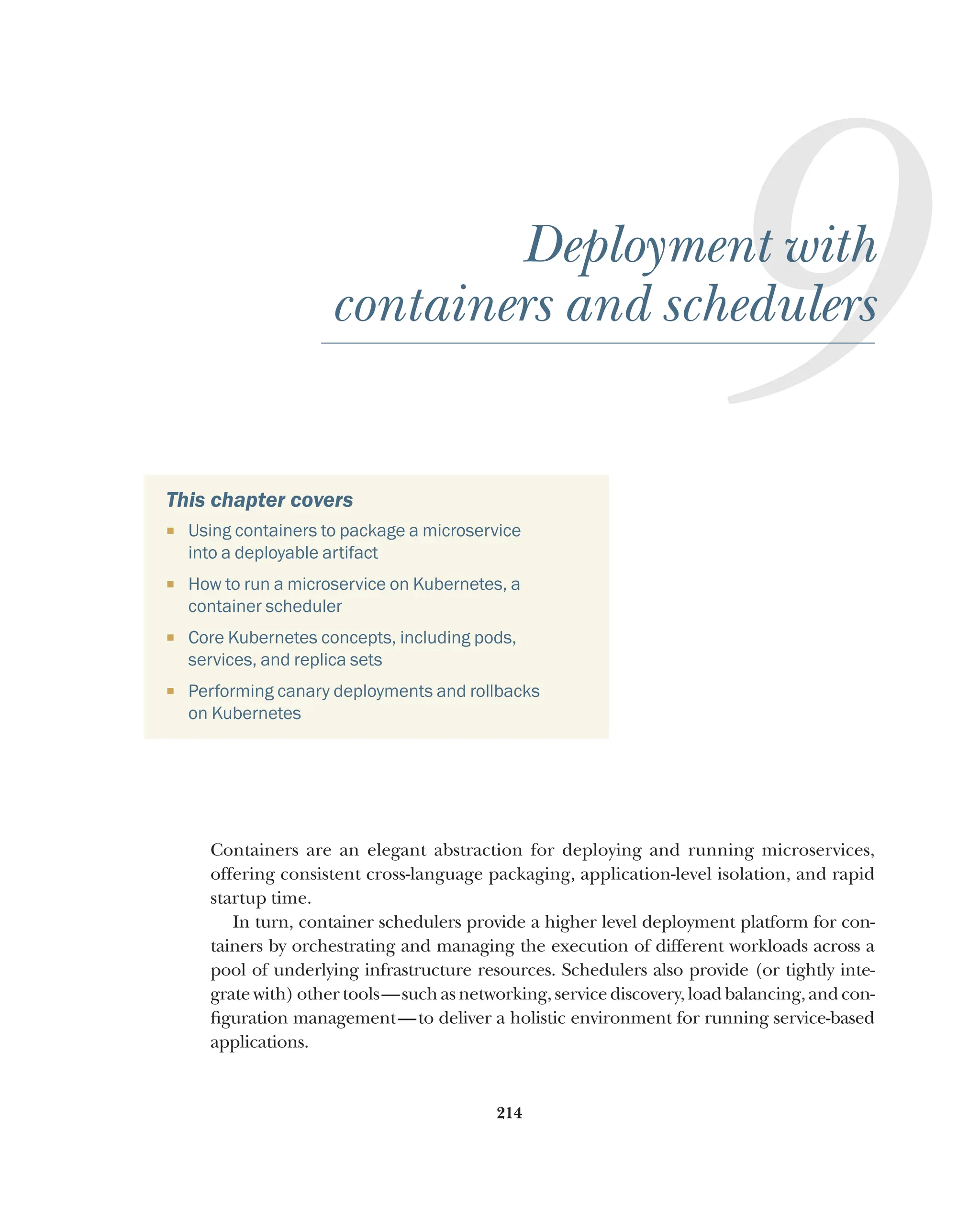
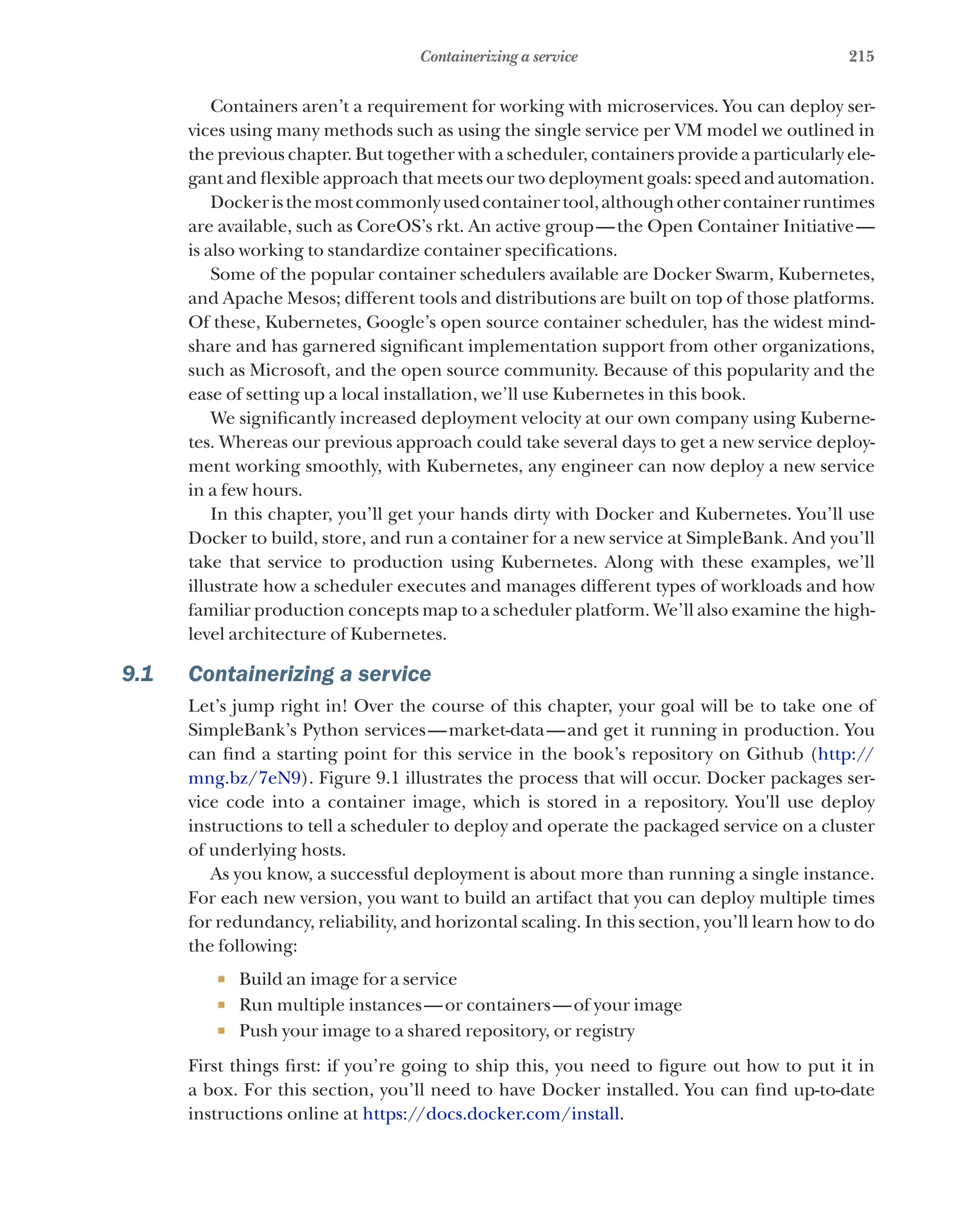
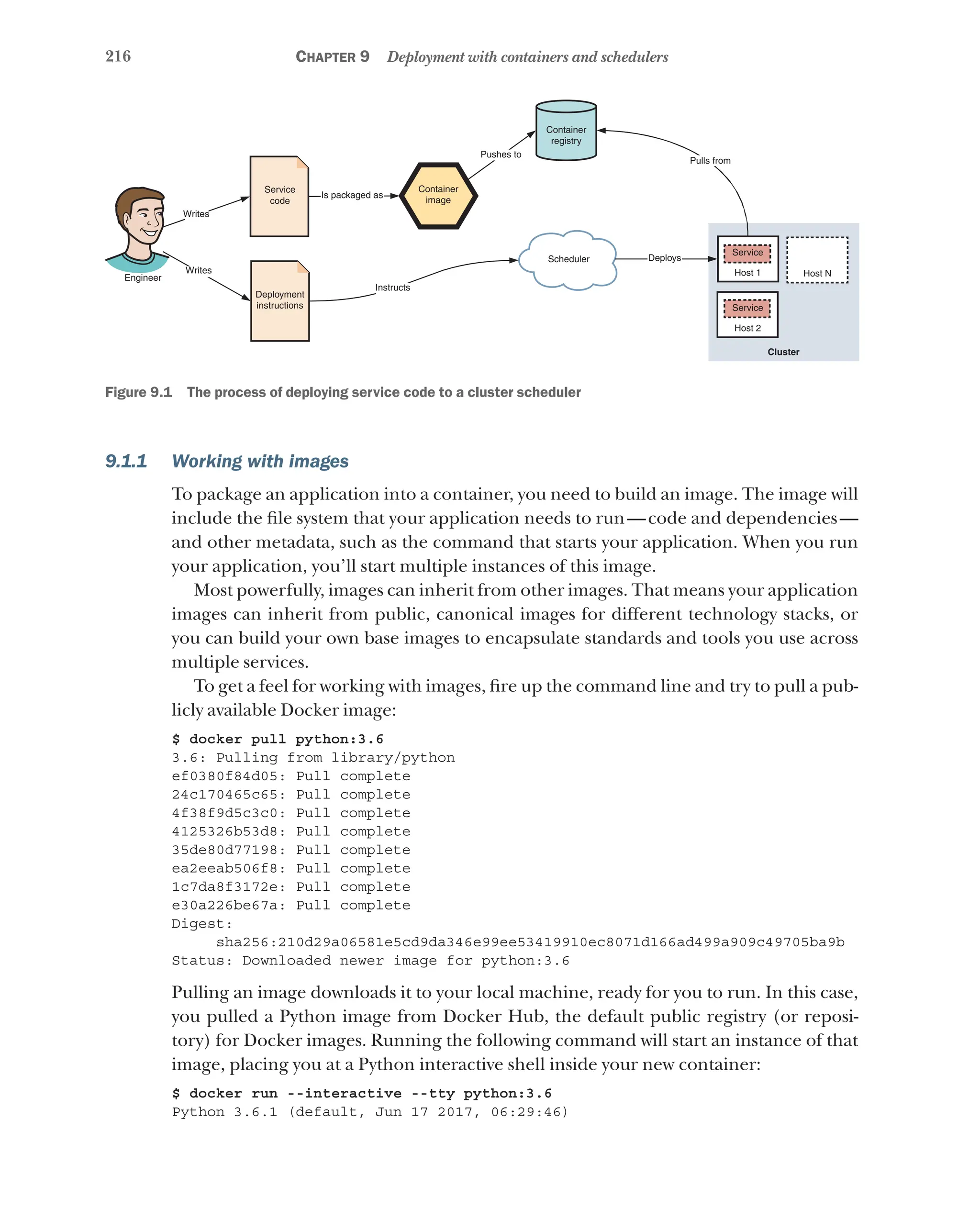
![217
Containerizing a service
[GCC 4.9.2] on linux
Type "help", "copyright", "credits" or "license" for more information.
>>>
You should note a few things here. The –-interactive (or –i) flag indicates that the
container should be interactive, accepting input from STDIN, whereas the –-tty (or
–t) flag connects a terminal for user input to the Docker container. When you started
the container, it executed the default command set within the image. You can check
what that is by inspecting the image metadata:
$ docker image inspect python:3.6 --format="{{.Config
➥.Cmd}}"
[python3]
You can instruct Docker to execute other commands inside your container; for exam-
ple, to enter the container at an OS shell, rather than Python, you could suffix the
command you used to start the image instance with bash.
When you watched the output of your earlier pull command, you might’ve noticed
that Docker downloaded multiple items, each identified by a hash—these are layers.
An image is a union of multiple layers; when you build an image, each command you
run (apt-get update, pip install, apt-get install –y, and so on) creates a new
layer. You can list the commands that went into building the python:3.6 image:
$ docker image history python:3.6
Each line that this script returns represents a different command used to construct
the python:3.6 image. In turn, some of those layers were inherited from another
base image. Commands defined in a Dockerfile specify the layers in an image using
a lightweight domain-specific language (DSL). If you look at the Dockerfile for this
image—you can find it on Github (http://mng.bz/JxDj)—you’ll notice the first line:
FROM buildpack-deps:jessie
This specifies that the image should inherit from the buildpack-deps:jessie image.
If you follow that thread on Docker Hub, you can see that your Python container has a
deep inheritance hierarchy that installs common binary dependencies and the under-
lying Debian operating system. This is detailed in figure 9.2.
python:3.6 buildpack-deps:jessie buildpack-deps:jessie-scm buildpack-deps:jessie-curl debian:jessie
Installs base operating
system
Installs basic HTTP tools,
for example, curl, wget
Installs common SCM
packages, for example,
Git, Mercurial
Installs common binaries,
for example, make, libmagick,
libc, libpq, gcc, libxml2
Installs and configures
python and pip
Figure 9.2 The inheritance hierarchy of images used to construct the python:3.6 container on Docker Hub
The Docker image configuration is output as JSON,
which you can parse using Go text templates.](https://image.slidesharecdn.com/microservicesinaction-240113230140-1bc300cc/75/microservices-in-action-pdf-244-2048.jpg)

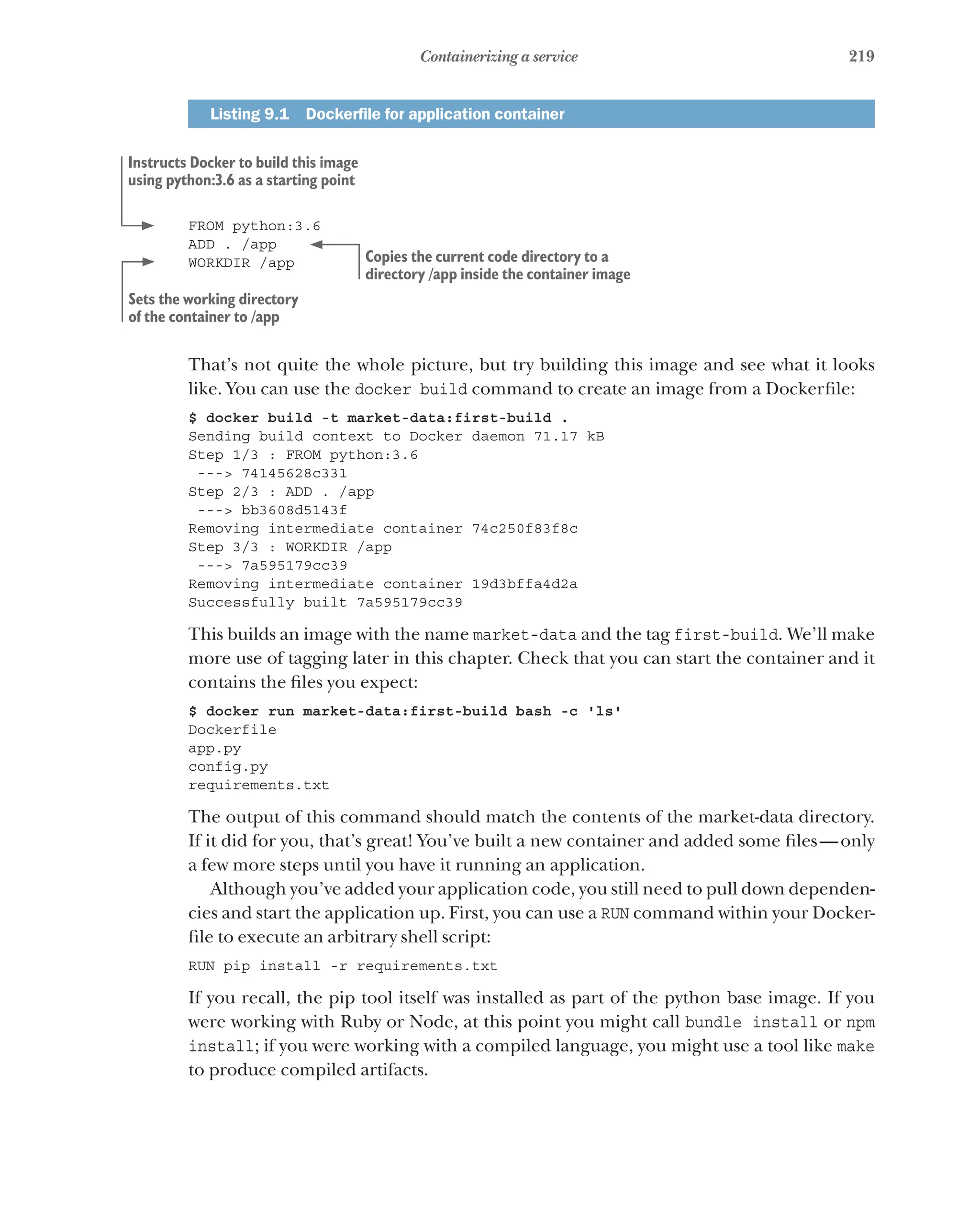
![220 Chapter 9 Deployment with containers and schedulers
NOTE For more complex applications, especially for compiled languages, you
may want to use the builder pattern or multistage builds to separate your devel-
opment and runtime Docker images: http://mng.bz/LMFr.
Next, you need to set the command that’ll be used to start your application. Add
another line to your Dockerfile:
CMD ["gunicorn", "-c ", "config.py", "app:app"]
And a final touch: you need to instruct Docker to expose a port to your app. In this
case, your Flask app expects traffic on port 8000. Putting that together, you get your
final Dockerfile, as shown in the following listing. You should build the image again,
this time tagging it as latest.
Listing 9.2 Complete Dockerfile for the market-data service
FROM python:3.6
ADD . /app
WORKDIR /app
RUN pip install -r requirements.txt
CMD ["gunicorn", "-c ", "config.py", "app:app"]
EXPOSE 8000
Public images and security
The python:3.6 image we’ve used so far is derived from debian:jessie, which
has a reputation for being well maintained and rapidly releasing patches to disclosed
vulnerabilities.
But, as when working with any software, it’s important to be aware that using public
Docker images potentially increases your security risk. Many images, particularly those
that aren’t officially maintained, aren’t regularly patched or updated, which can increase
the threat surface of your system.
If in doubt, security scanning tools, such as Clair (https://github.com/coreos/clair), exist
for analyzing the security stance of Docker containers. You can use these on an ad-hoc
basis or integrate them into your continuous integration pipeline.
Maintaining your own base images is also an option but does involve an extra time invest-
ment. Deciding to take this route requires careful consideration of your team’s capabili-
ties and security expertise.
9.1.3 Running containers
Now that you’ve built an image for the application, you can run it. Try it out:
$ docker run -d -p 8000:8000 --name market-data market-data:latest
This command should return a long hash to the terminal. That’s the ID of your con-
tainer—you’ve started it in detached mode, rather than in the foreground. You’ve also
used the -p flag to map the container port so it’s accessible from the Docker host. If](https://image.slidesharecdn.com/microservicesinaction-240113230140-1bc300cc/75/microservices-in-action-pdf-247-2048.jpg)

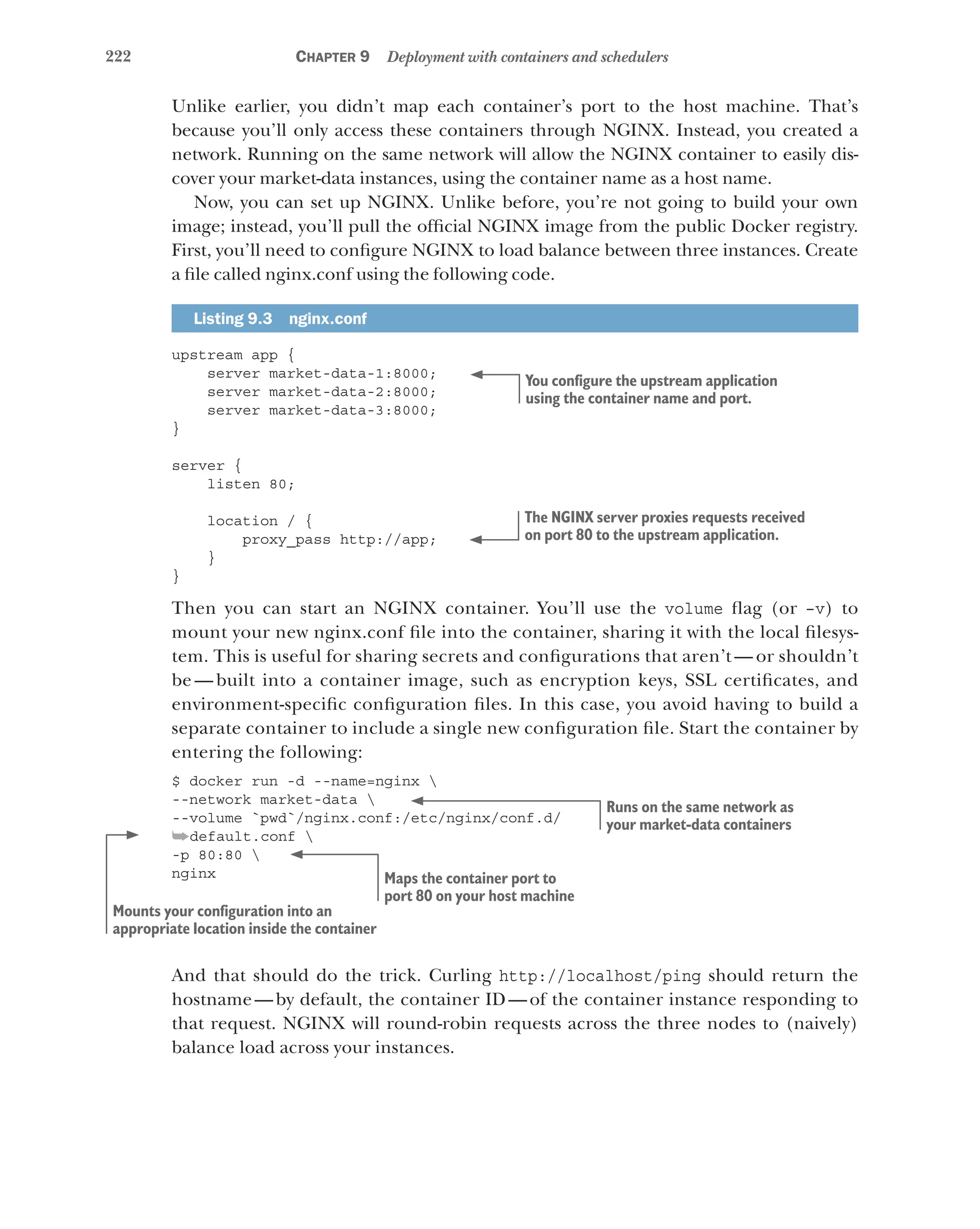

![224 Chapter 9 Deployment with containers and schedulers
Figure 9.6 The private repository page on Docker Hub shows a record of the tagged image you pushed.
That’s it! You’ve successfully pushed your image to a public repository. You can double-
check that through the web UI (figure 9.6) by logging into https://hub.docker
.com. Other engineers (if your repository is private, you’ll need to grant them access)
can pull your image using docker pull [image name].
Let’s take stock for a moment:
¡ You’ve learned how to package a simple application into a lightweight,
cross-platform artifact — a container image.
¡ We’ve explored how Docker images are built from multiple layers to support
inheritance from common base containers and increase startup speed.
¡ You’ve run multiple isolated instances of an application container.
¡ You’ve pushed the image you built to a Docker registry.
Using these techniques in a build pipeline will ensure greater consistency and predict-
ability across a fleet of services, regardless of underlying programming language, as well
as helping to simplify local development. Next, we’ll explore how a container sched-
uler works by taking your containerized application and deploying it with Kubernetes.
9.2 Deploying to a cluster
A container scheduler is a software tool that abstracts away from underlying hosts by
managing the execution of atomic, containerized applications across a shared pool of
resources. This is possible because containers provide strong isolation of resources and
a consistent API.
Using a scheduler is a compelling deployment platform for microservices because
it eases the management of scaling, health checks, and releases across, in theory, any
number of independent services. And it does so while ensuring efficient utilization of
underlying infrastructure. At a high level, a container scheduler workflow looks some-
thing like this:
¡ Developers write declarative instructions to specify which applications they want to
run. These workloads might vary: you might want to run a stateless, long-running
service; a one-off job; or a stateful application, like a database.
¡ Those instructions go to a master node.](https://image.slidesharecdn.com/microservicesinaction-240113230140-1bc300cc/75/microservices-in-action-pdf-251-2048.jpg)
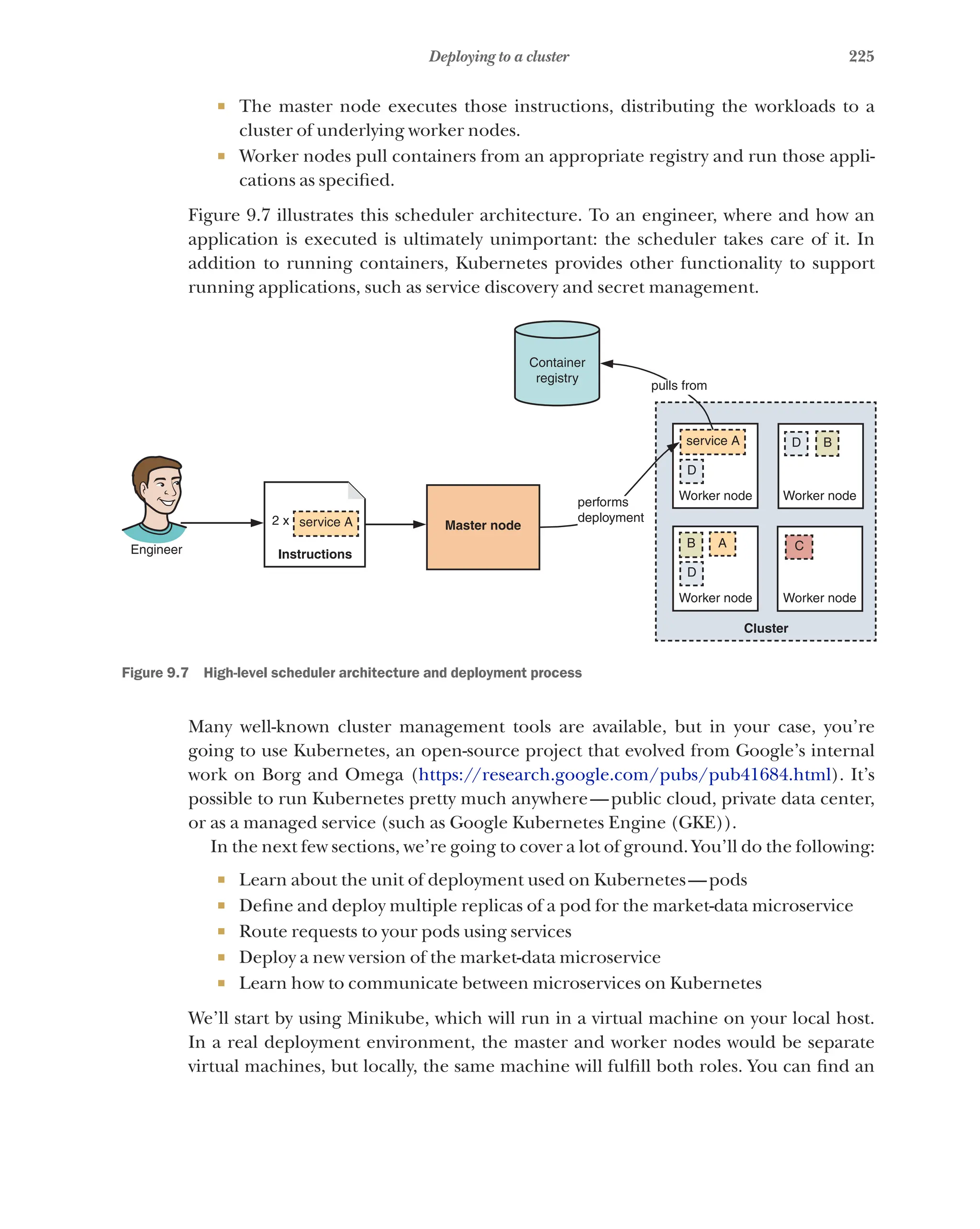

![227
Deploying to a cluster
and a pod is one kind of object. These configuration files represent the desired state
of your cluster. When you apply this configuration to Kubernetes, the scheduler will
continually work to maintain that ideal state. In this file, you’ve defined a ReplicaSet,
which is a Kubernetes object that manages a group of pods.
NOTE We’ll occasionally use dot-notation to refer to paths within a *.yml file.
For example, in listing 9.4, the path to the market-data container definition
would be spec.template.spec.containers[0].
To apply this to your local cluster, you can use the kubectl command-line tool. When
you started Minikube, it should have automatically configured kubectl to operate on
your cluster. This tool interacts with an API exposed by the cluster’s master node. Give
it a try:
$ kubectl apply -f market-data-replica-set.yml
replicaset "market-data" configured
Kubernetes will asynchronously create the objects you’ve defined. You can observe the
status of this operation using kubectl. Running kubectl get pods (or kubectl get
pods -l app=market-data) will show you the pods that your command has created
(figure 9.8). They’ll take a few minutes to start up for the first time as the node down-
loads your Docker image.
You saw earlier that you didn’t create individual pods. It’s unusual to create or destroy
pods directly; instead, pods are managed by controllers. A controller is responsible
for taking some desired state—say, always running three instances of the market-data
pod—and performing actions to reach that state. This observe-diff-act loop happens
continually.
You’ve just encountered the most common type of controller: the ReplicaSet. If
you’ve ever encountered instance groups on AWS or GCP, you might find their behav-
ior similar. A replica set aims to ensure a specific number of pods are running at any
one time. For example, let’s say a pod dies—maybe a node in the cluster failed—the
replica set will observe that the state of the cluster no longer matches the desired state
and will attempt to schedule a replacement elsewhere in the cluster.
You can see this in action. Delete one of the pods you’ve just created (pods are iden-
tified by name):
$ kubectl delete pod <pod name>
The replica set will schedule a new pod to replace the one you destroyed (figure 9.9).
Figure 9.8 The results of the kubectl get pods command after creating a new replica set](https://image.slidesharecdn.com/microservicesinaction-240113230140-1bc300cc/75/microservices-in-action-pdf-254-2048.jpg)
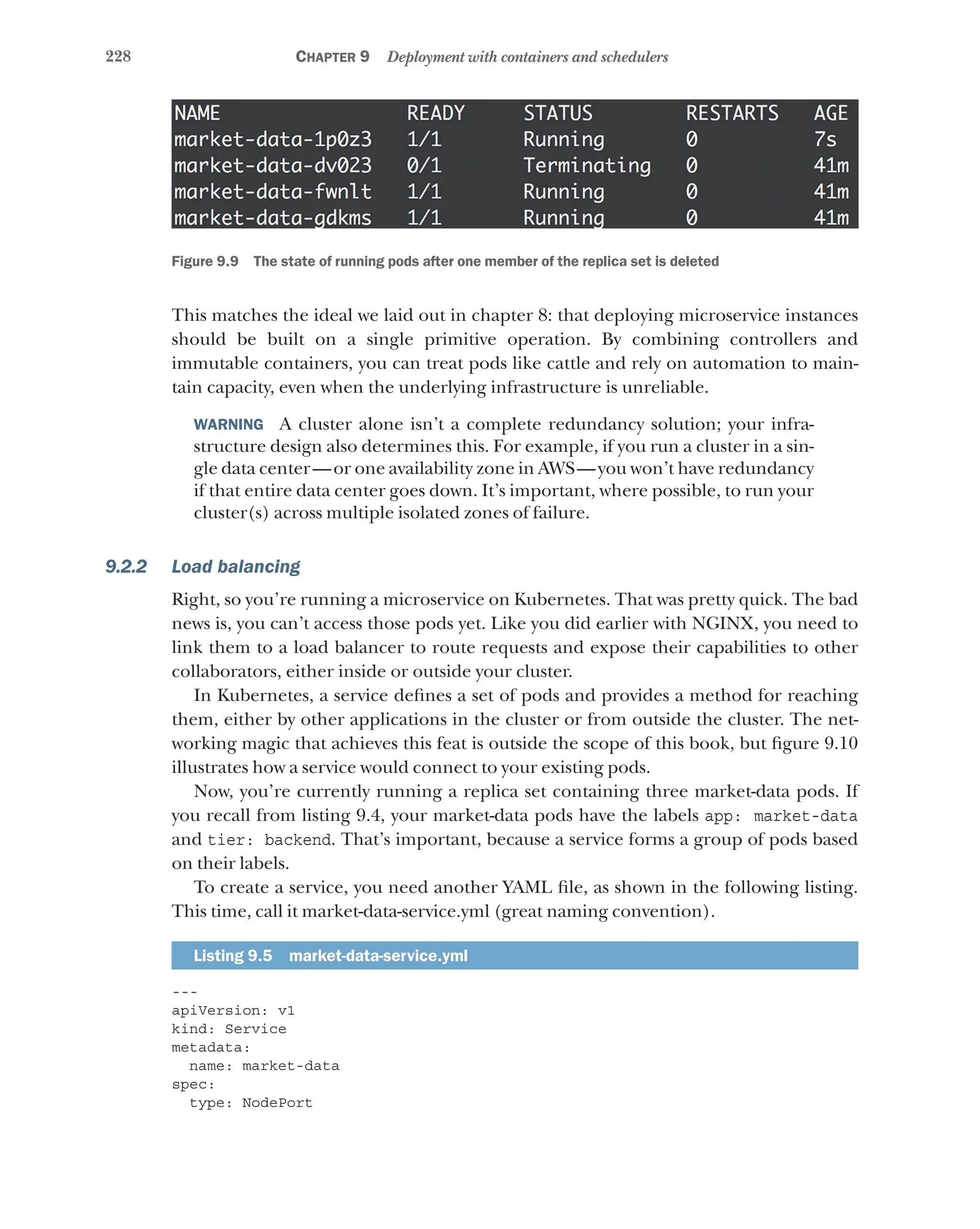
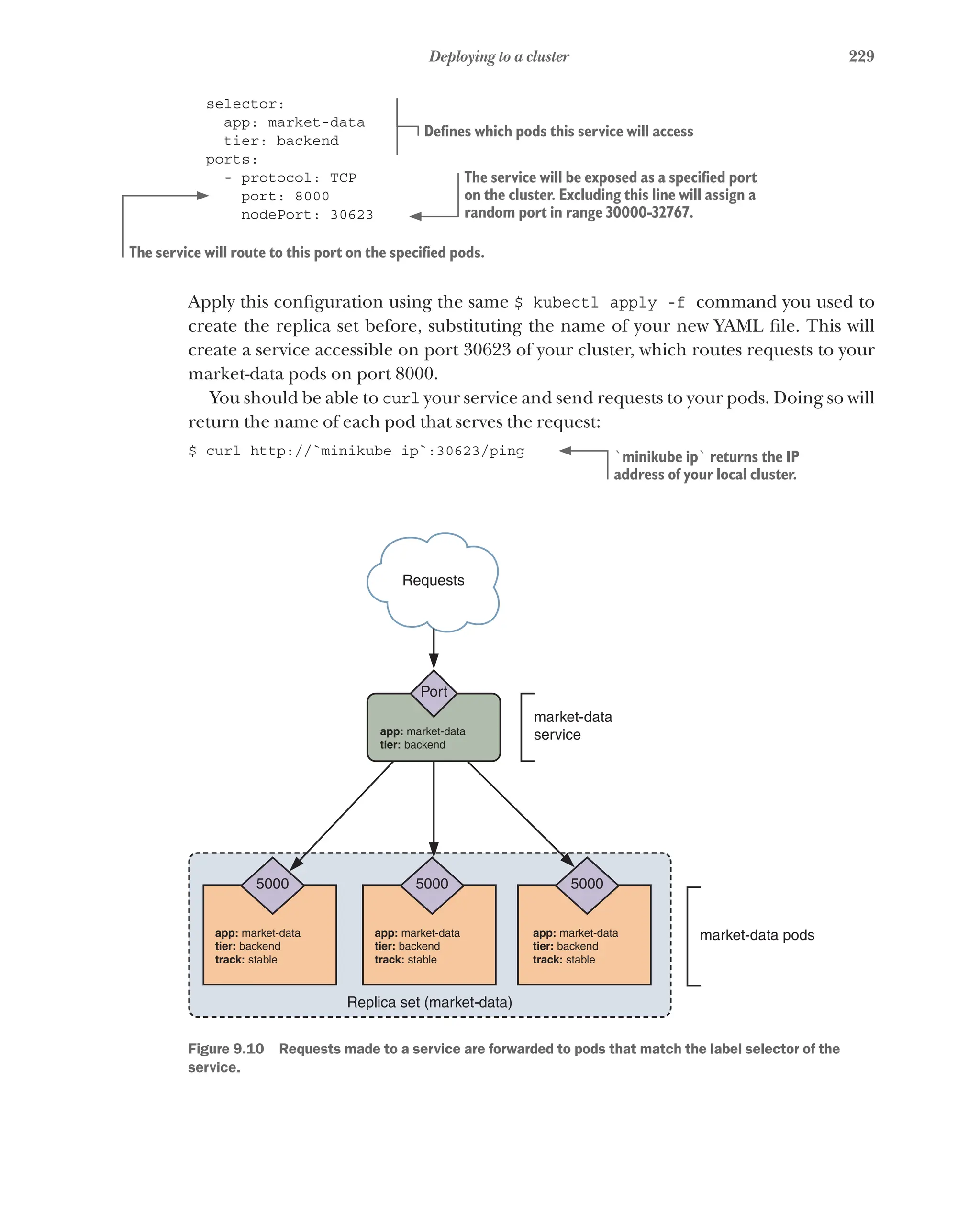
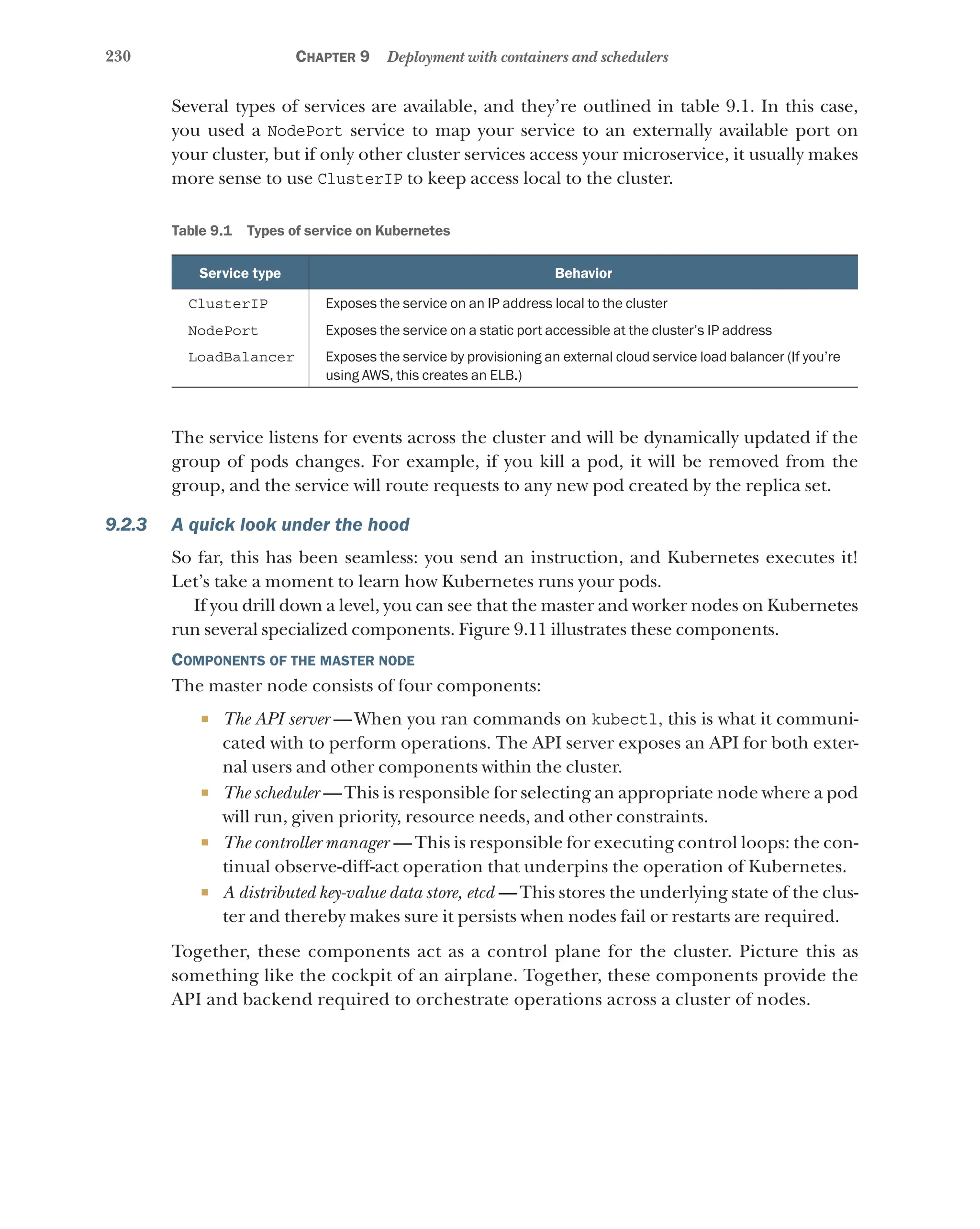
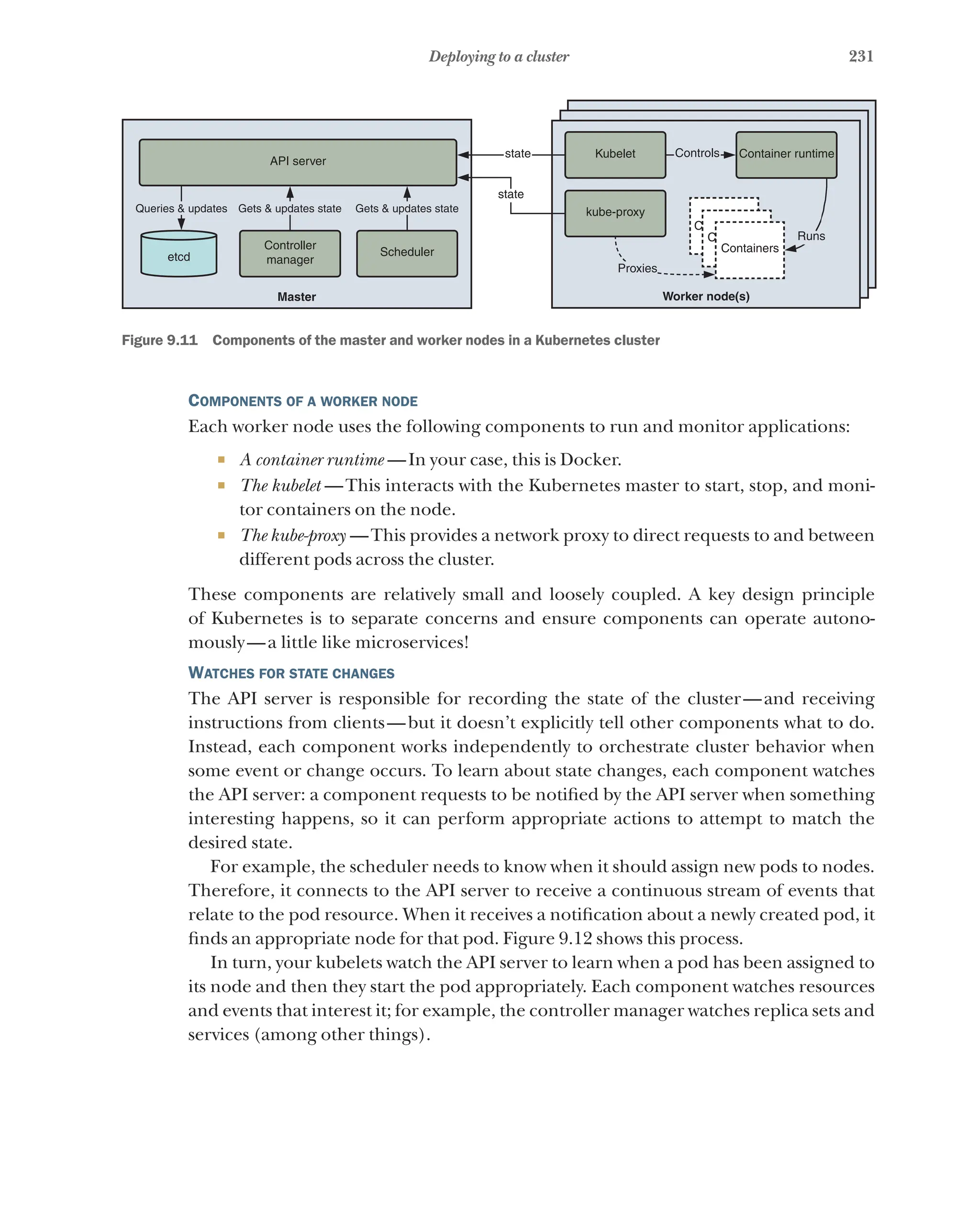
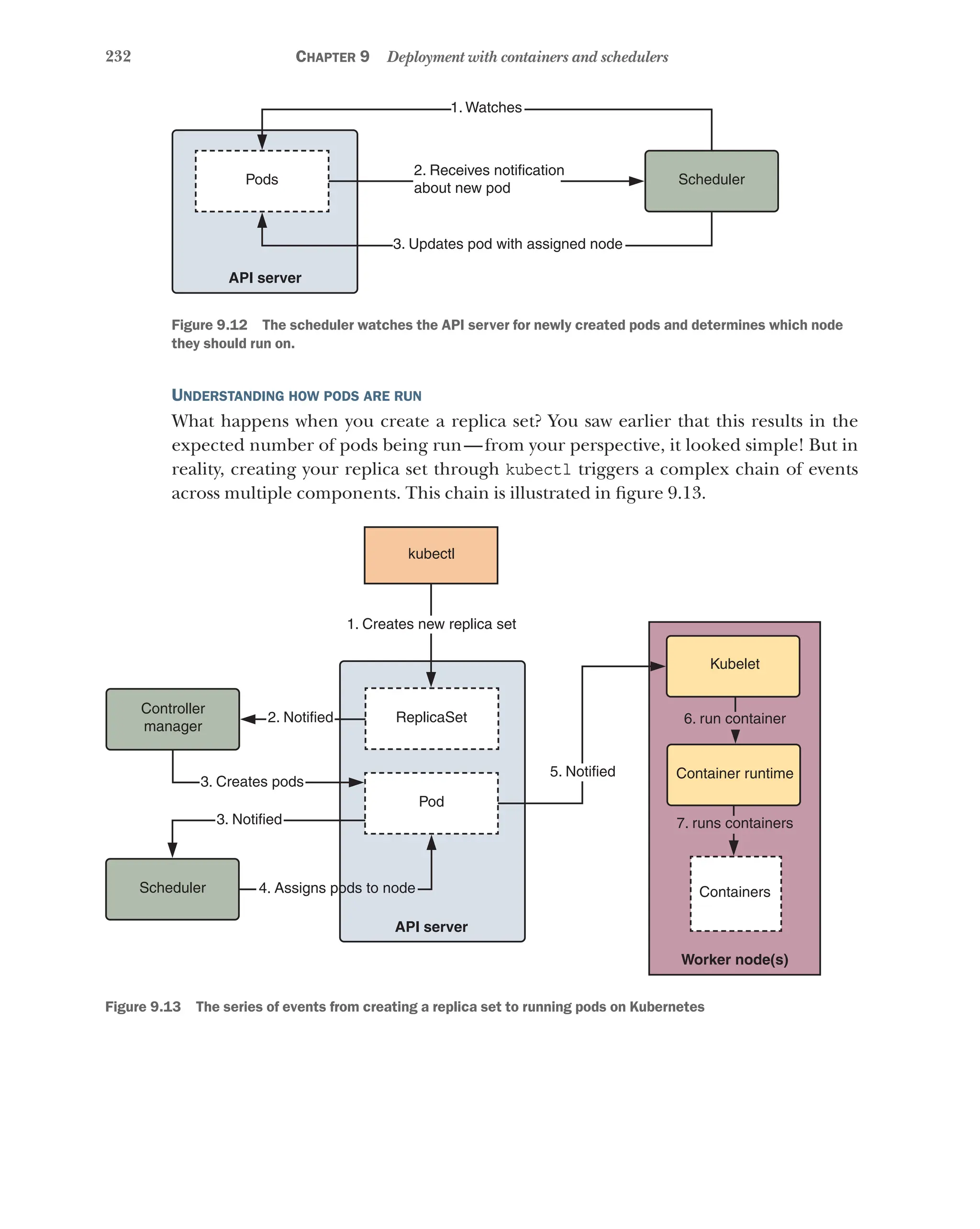
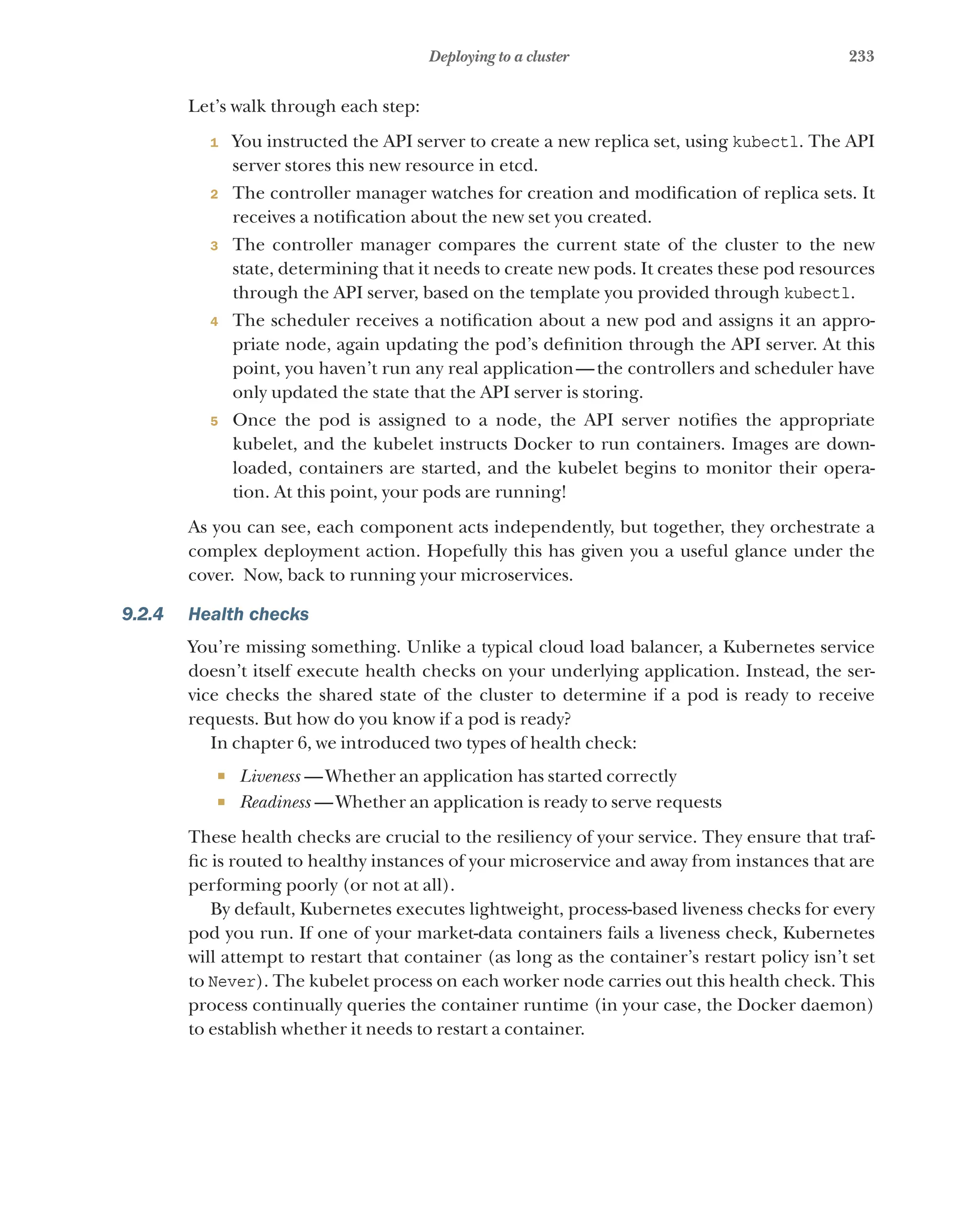
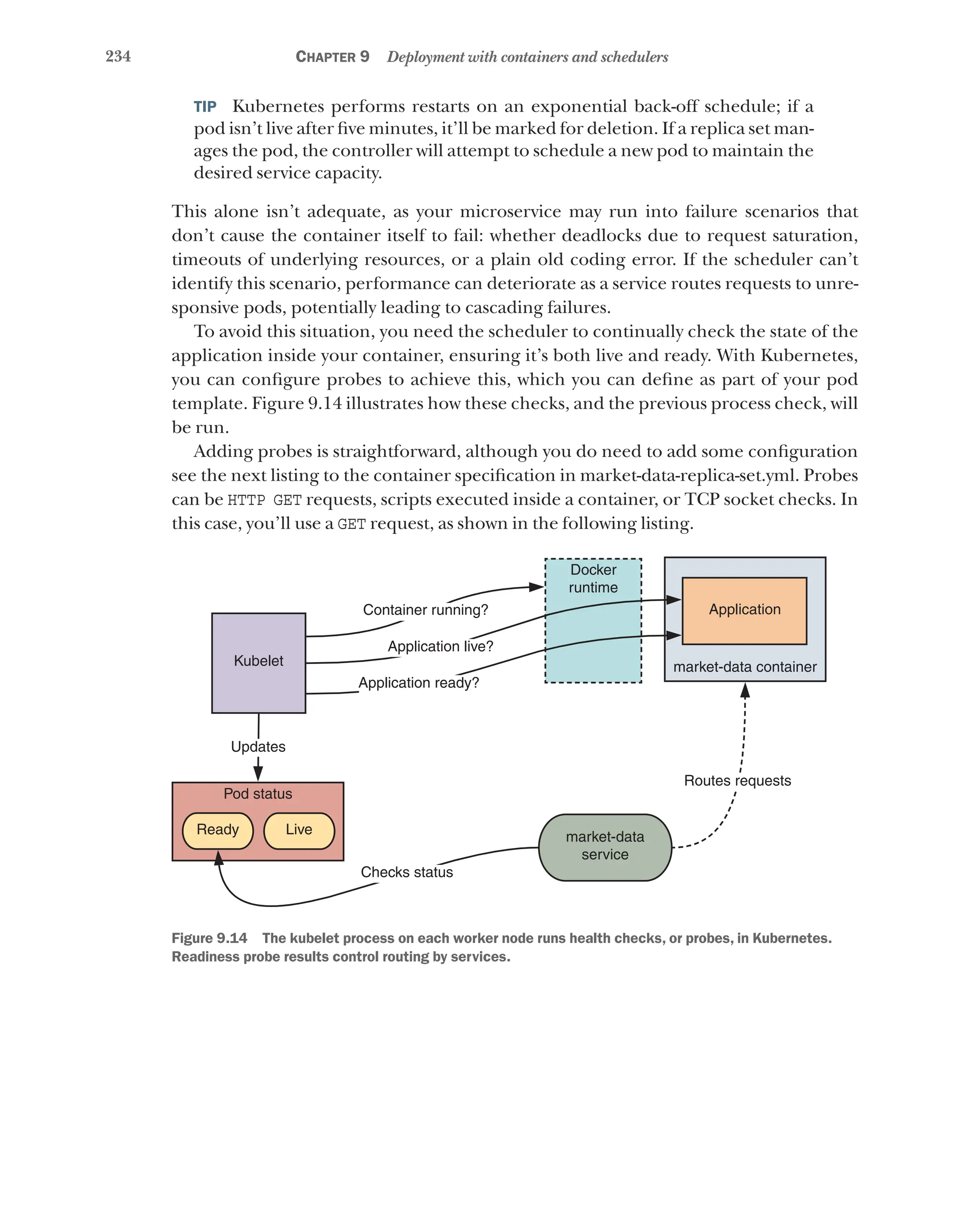
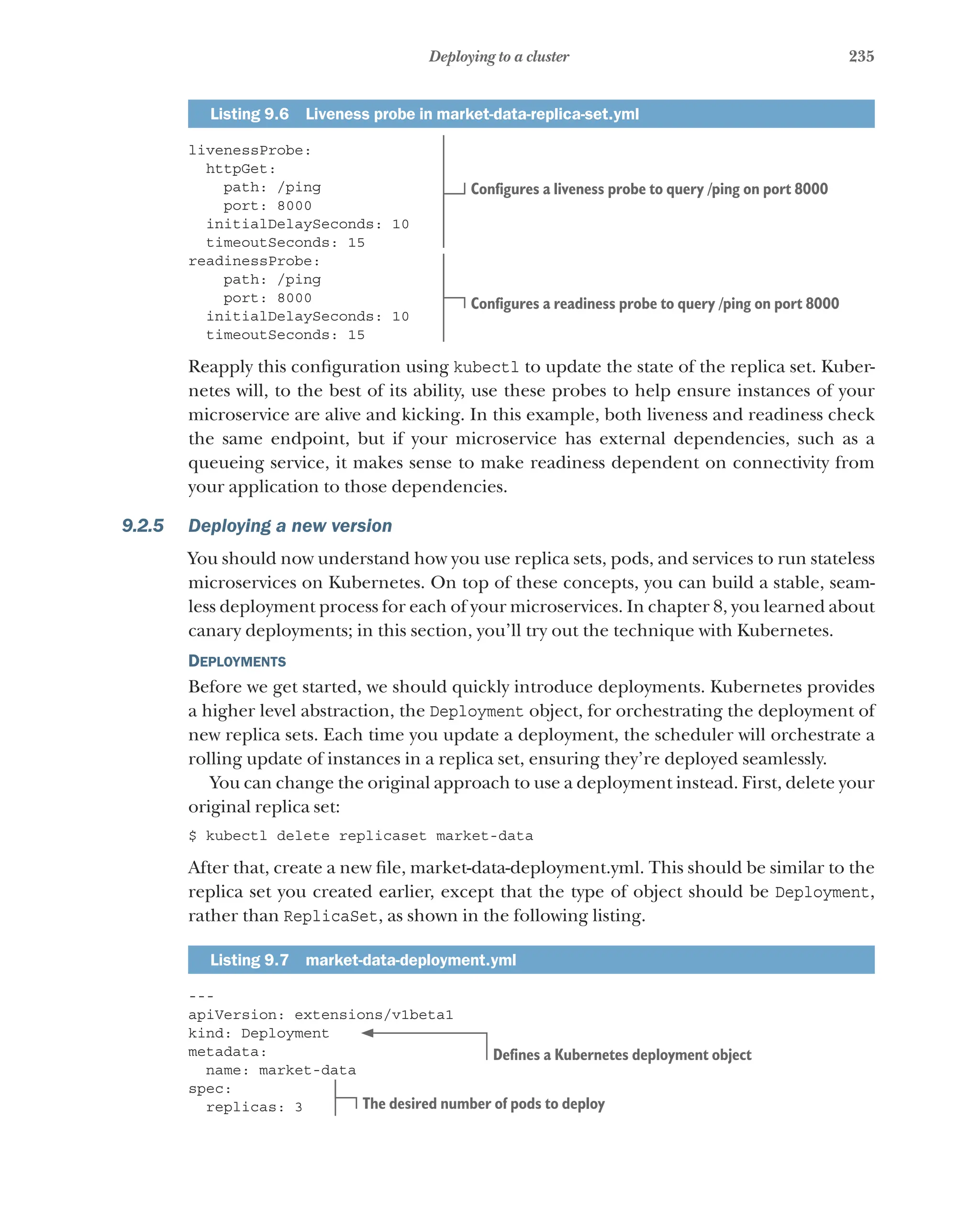
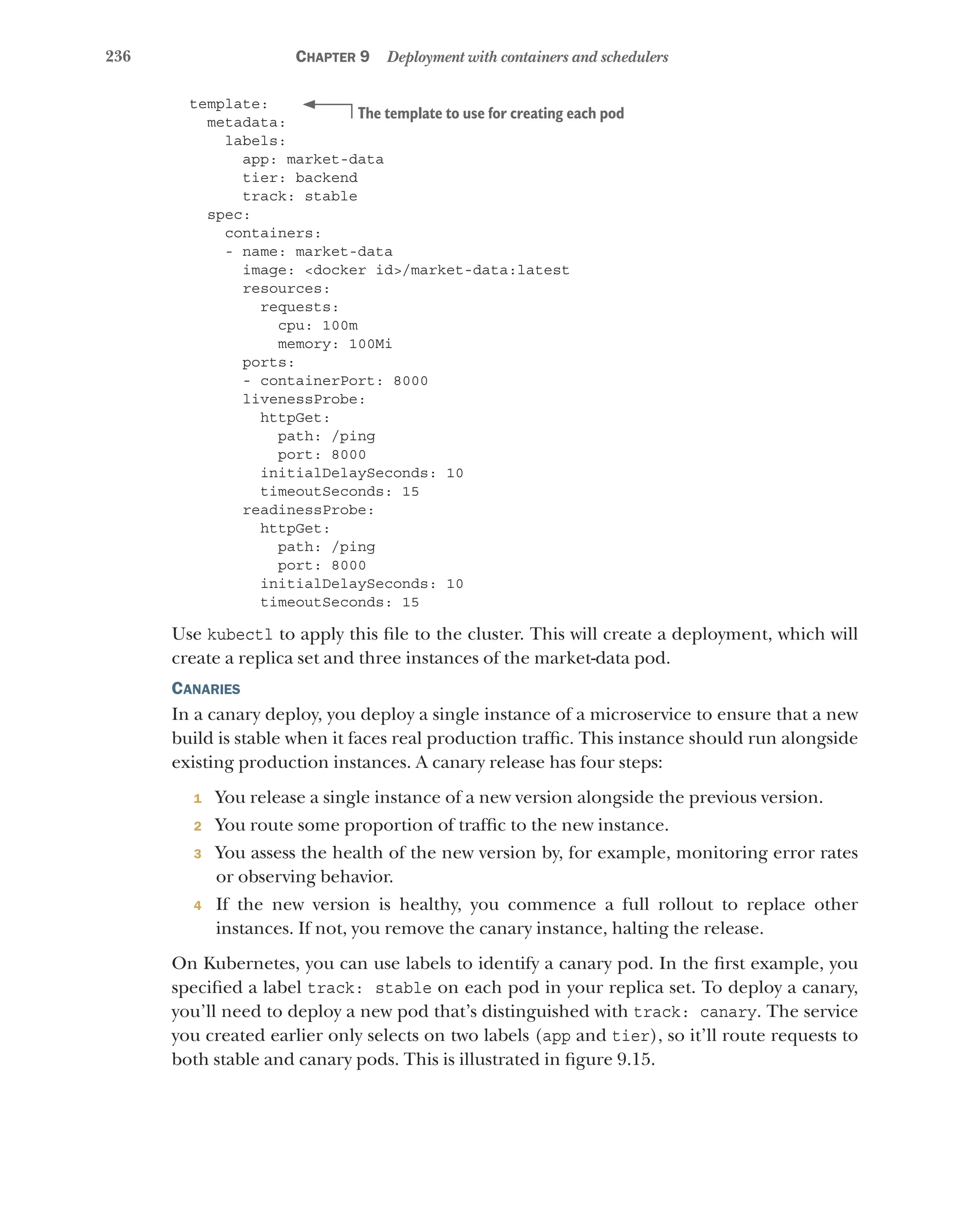
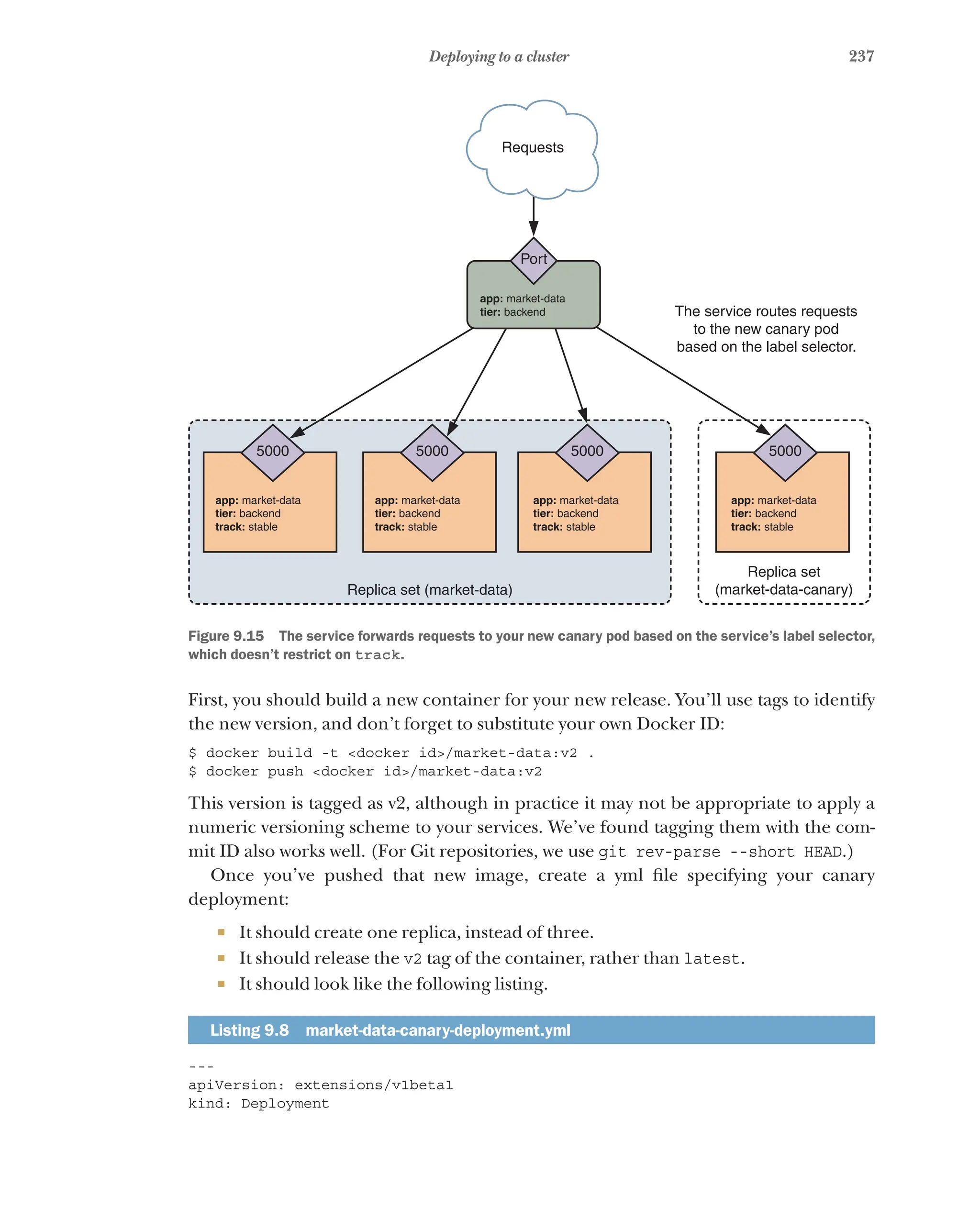


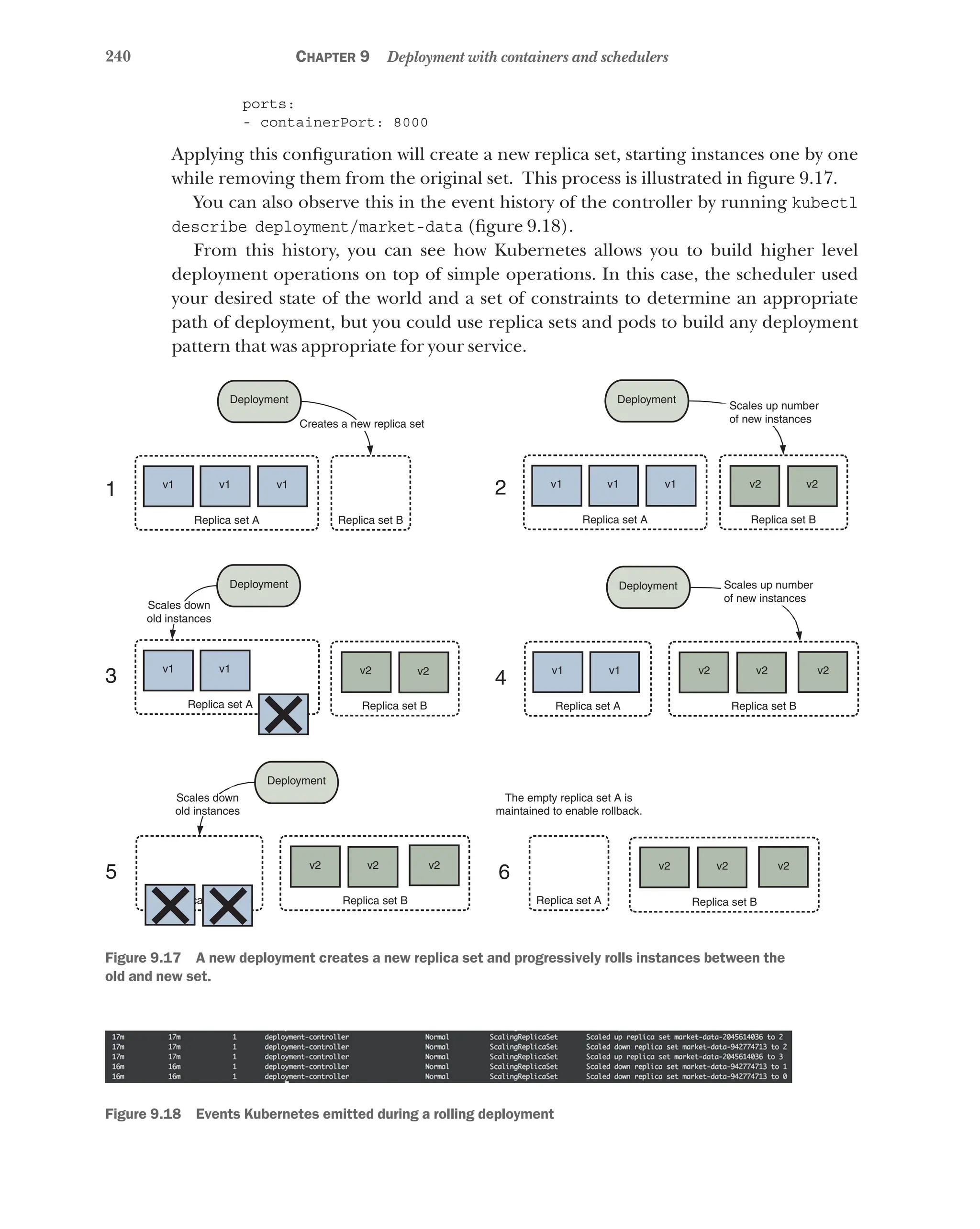
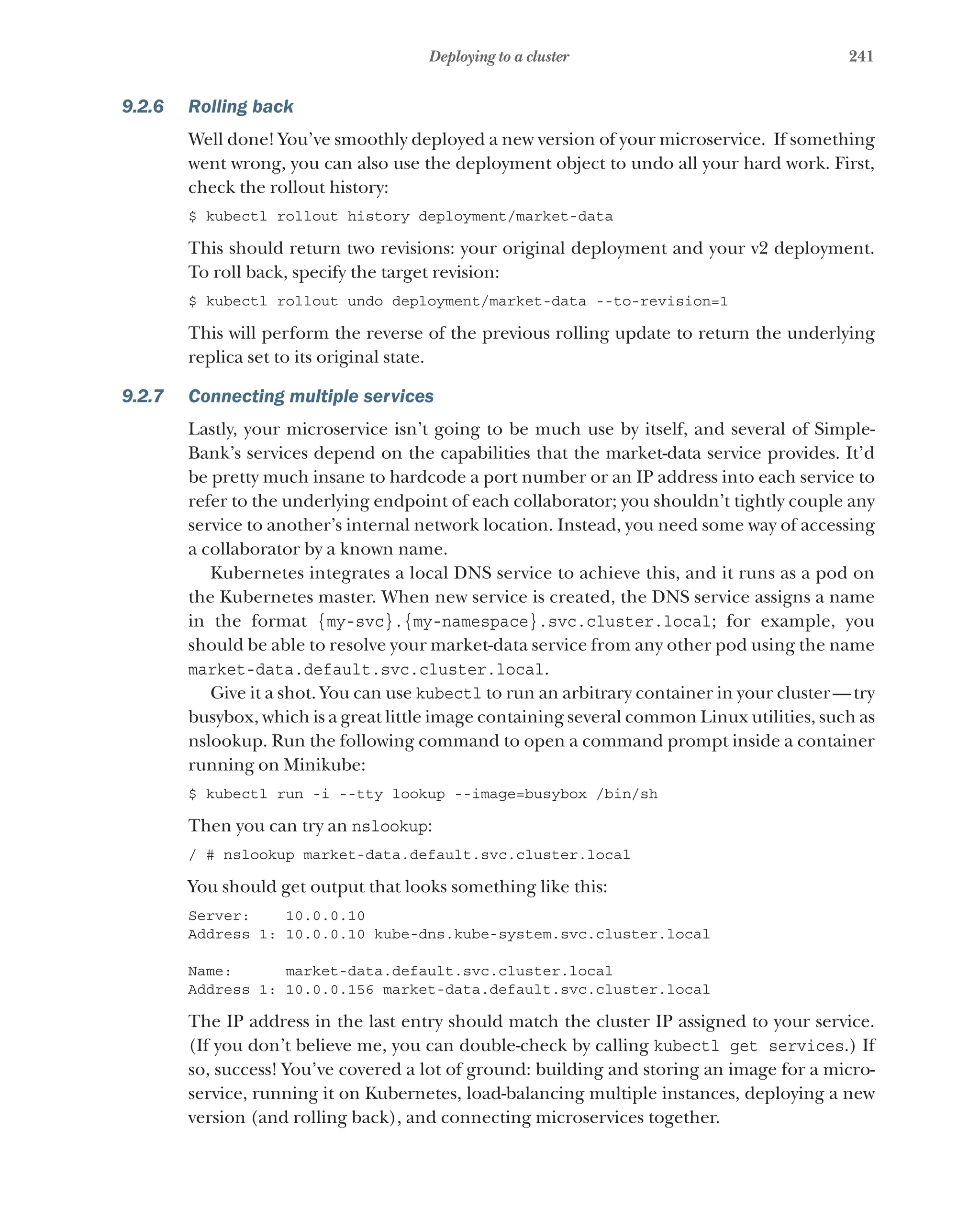
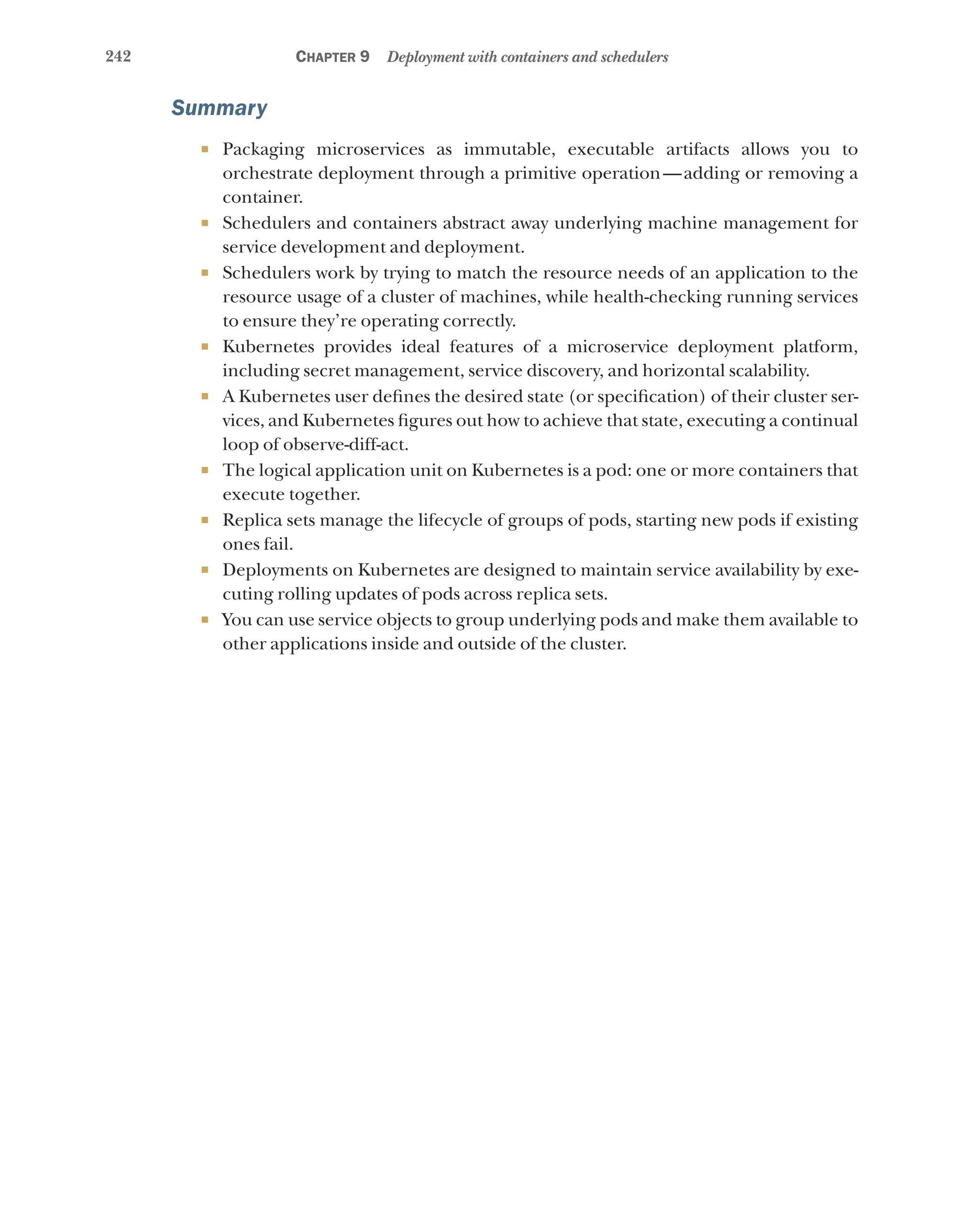
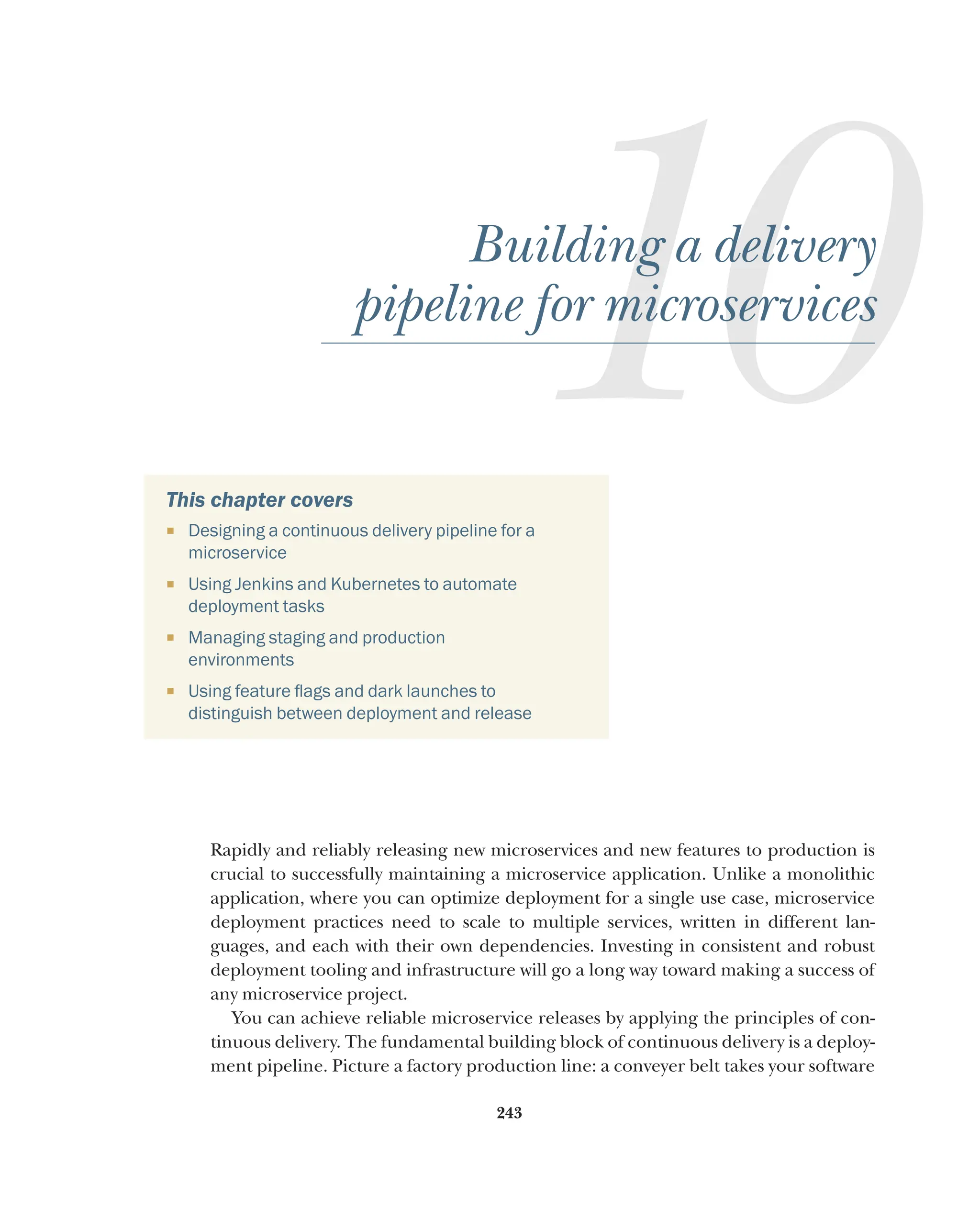
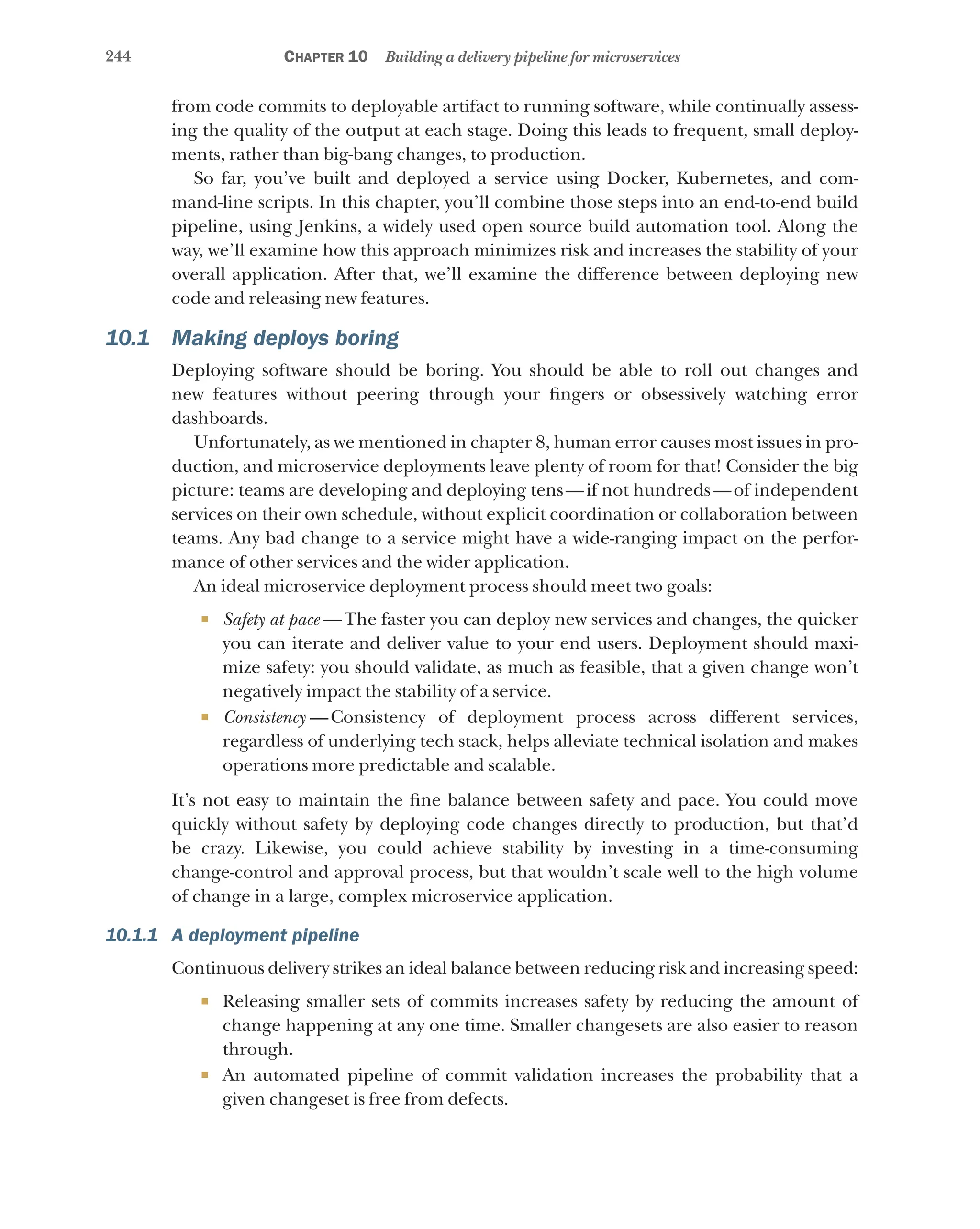
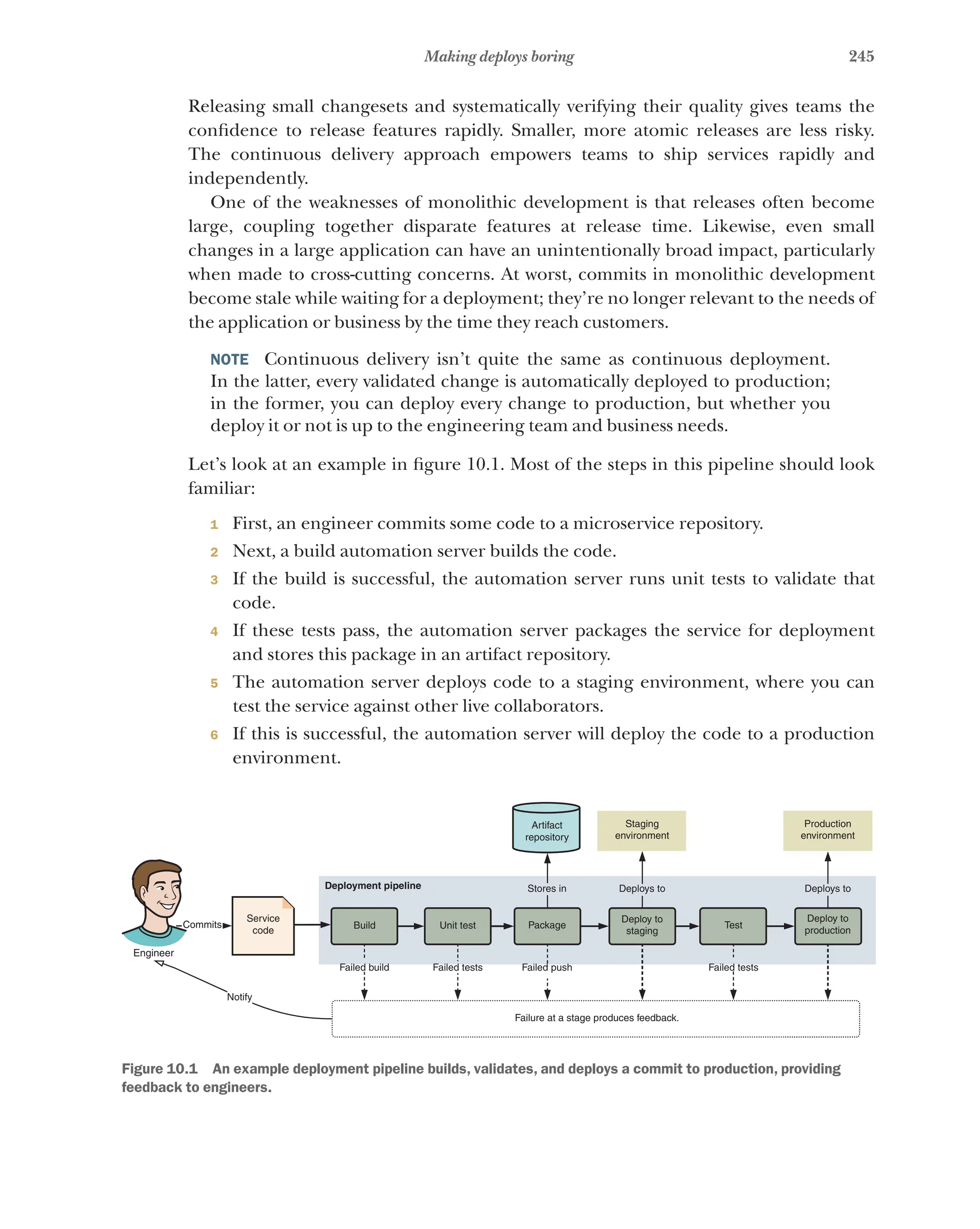
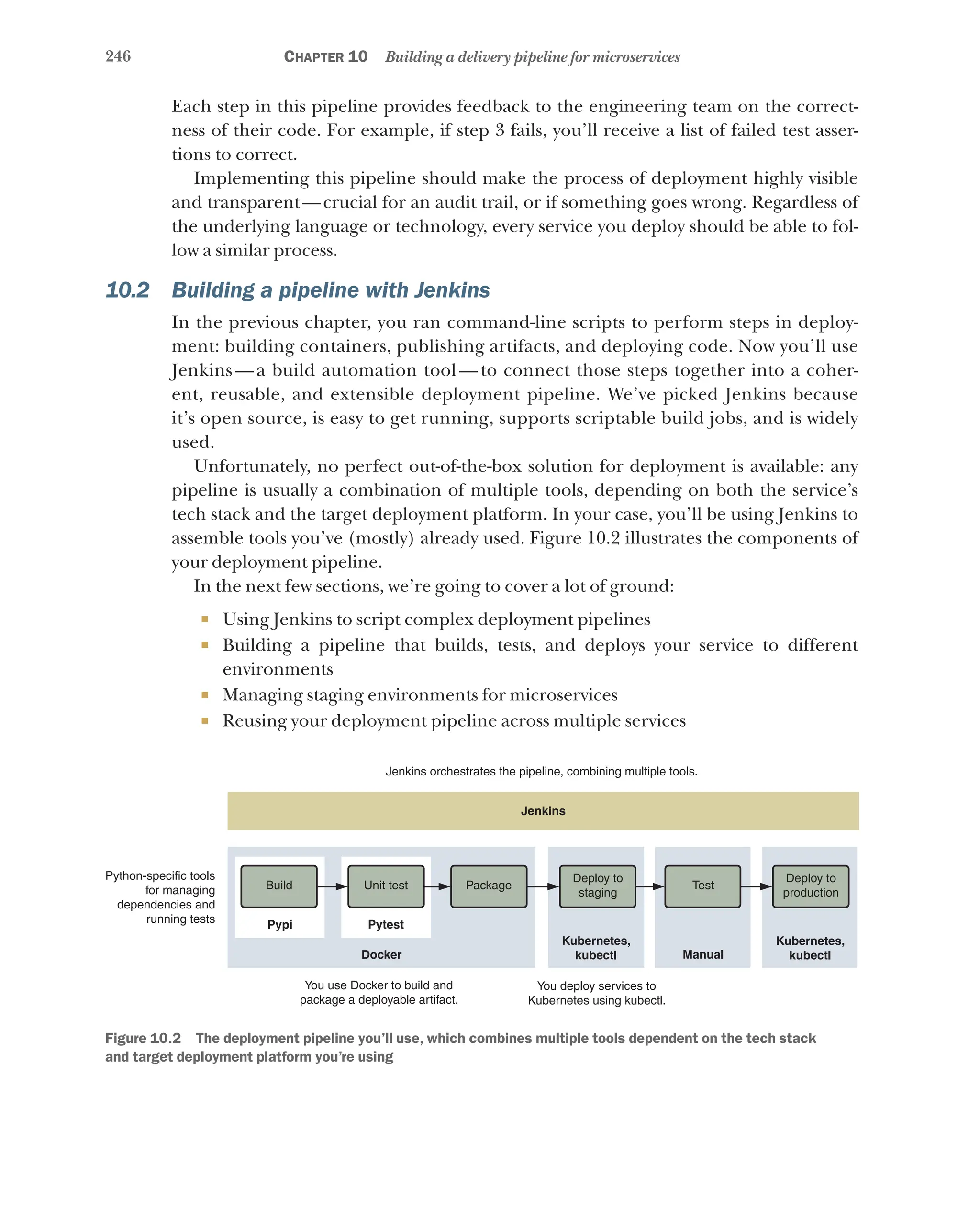
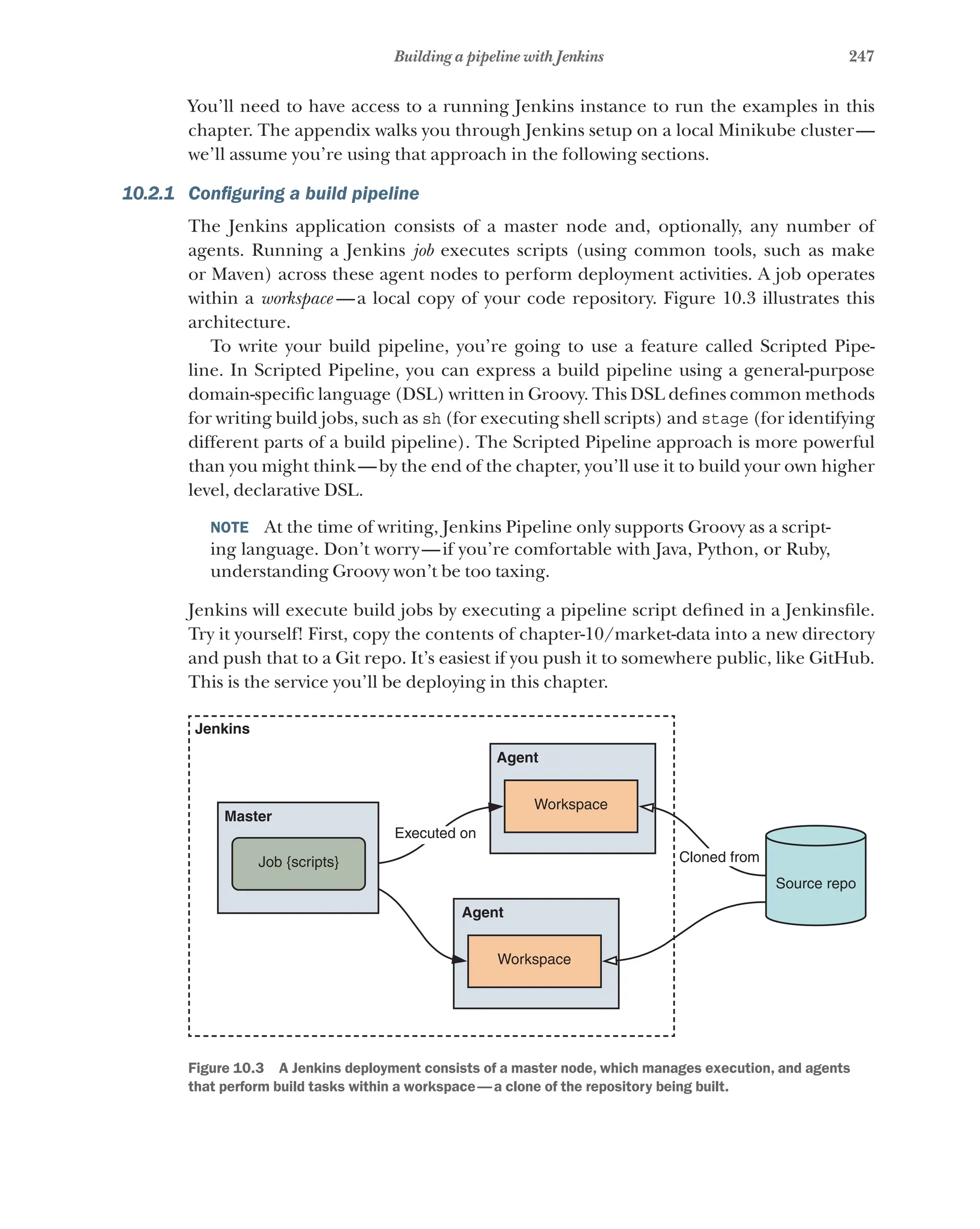
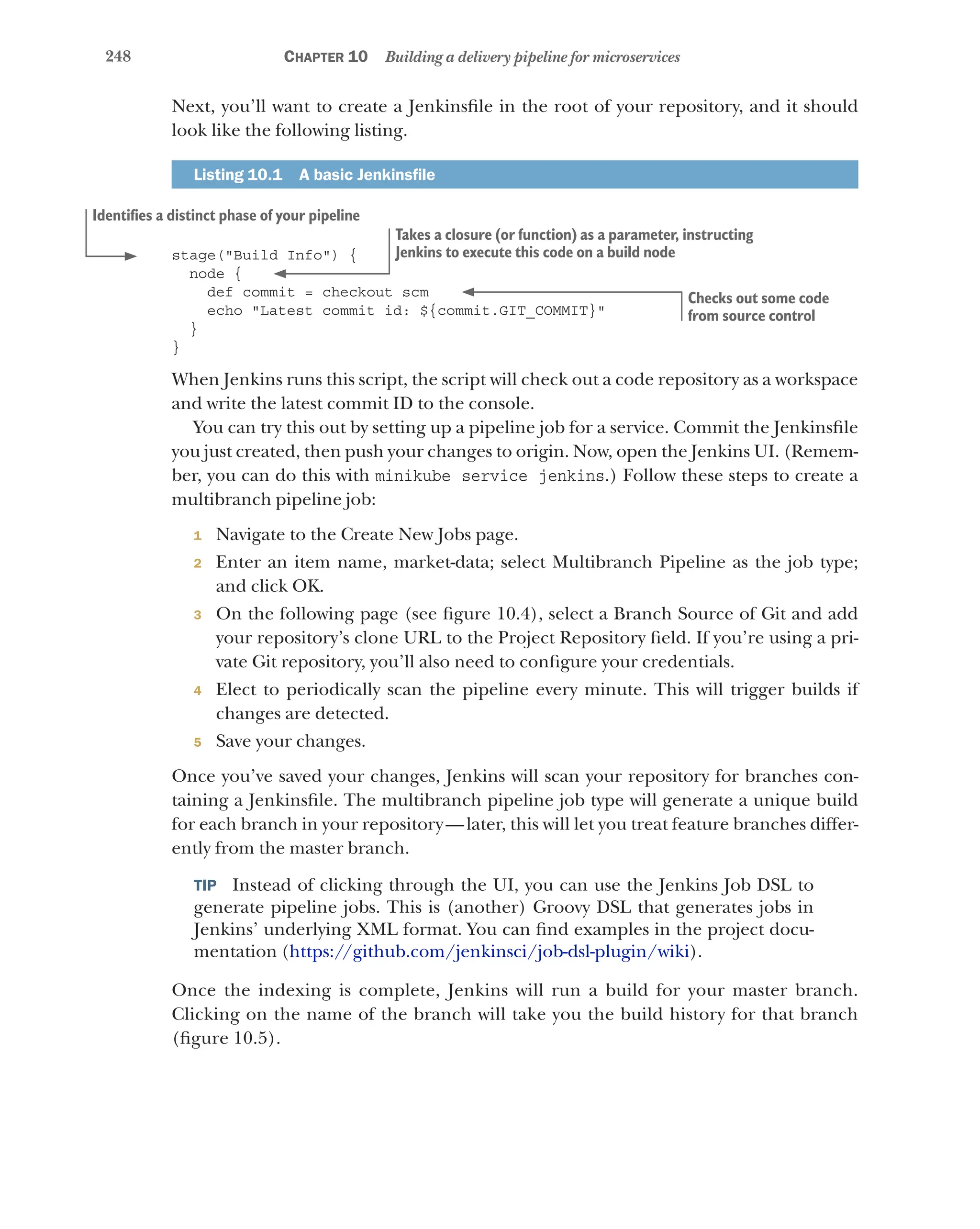
![249
Building a pipeline with Jenkins
Figure 10.4 New project configuration screen, showing Branch Sources options
Click the build number and then Console Output. This traces the output of the build.
Within that output, you should be able to see how your Jenkinsfile has been executed:
Agent default-q3ccc is provisioned from template Kubernetes Pod Template
Agent specification [Kubernetes Pod Template] (jenkins-jenkins-slave):
* [jnlp] jenkins/jnlp-slave:3.10-1(resourceRequestCpu: 200m, resourceRequest
➥Memory: 256Mi, resourceLimitCpu: 200m, resourceLimitMemory: 256Mi)
Running on default-q3ccc in /home/jenkins/workspace/market-data_master
➥-27MDVADAYDBX5WJSRWQIFEL3T7GD4LWPU5CXCZNTJ4CKBDLP3LVA
[Pipeline] {
[Pipeline] checkout
Cloning the remote Git repository
Cloning with configured refspecs honoured and without tags
Cloning repository https://github.com/morganjbruce/market-data.git
> git init /home/jenkins/workspace/market-data_master
[CA}-27MDVADAYDBX5WJSRWQIFEL3T7GD4LWPU5CXCZNTJ4CKBDLP3LVA # timeout=10
Fetching upstream changes from https://github.com/morganjbruce/
➥market-data.git
> git --version # timeout=10
> git fetch --no-tags --progress https://github.com/morganjbruce/
➥market-data.git +refs/heads/*:refs/remotes/origin/*
> git config remote.origin.url https://github.com/morganjbruce/
➥market-data.git # timeout=10
> git config --add remote.origin.fetch +refs/heads/*:refs/remotes/origin/
➥* # timeout=10
> git config remote.origin.url https://github.com/morganjbruce/
➥market-data.git # timeout=10
Fetching without tags](https://image.slidesharecdn.com/microservicesinaction-240113230140-1bc300cc/75/microservices-in-action-pdf-276-2048.jpg)
![250 Chapter 10 Building a delivery pipeline for microservices
Fetching upstream changes from https://github.com/morganjbruce/
➥market-data.git
> git fetch --no-tags --progress https://github.com/morganjbruce/
➥market-data.git +refs/heads/*:refs/remotes/origin/*
Checking out Revision 80bfb7bdc4fa0b92dcf360393e5d49e0f348b43b (master)
> git config core.sparsecheckout # timeout=10
> git checkout -f 80bfb7bdc4fa0b92dcf360393e5d49e0f348b43b
Commit message: "working through ch10"
First time build. Skipping changelog.
[Pipeline] echo
Latest commit id: 80bfb7bdc4fa0b92dcf360393e5d49e0f348b43b
[Pipeline] }
[Pipeline] // node
[Pipeline] }
[Pipeline] // stage
[Pipeline] End of Pipeline
Finished: SUCCESS
Figure 10.5 Build history for the master branch of your repository](https://image.slidesharecdn.com/microservicesinaction-240113230140-1bc300cc/75/microservices-in-action-pdf-277-2048.jpg)
![251
Building a pipeline with Jenkins
Each [Pipeline] step traces the execution of your code. Awesome—you’ve deployed
a build automation tool, configured it against a service repository, and run your first
build pipeline! Next, let’s look at the first stage of your pipeline: build.
10.2.2 Building your image
You’re going to use Docker to build and package your images. First, let’s change your
Jenkinsfile, as shown in the following listing.
Listing 10.2 Jenkinsfile for build step
def withPod(body) {
podTemplate(label: 'pod', serviceAccount: 'jenkins', containers: [
containerTemplate(name: 'docker', image: 'docker', command: 'cat',
➥ttyEnabled: true),
containerTemplate(name: 'kubectl', image: 'morganjbruce/kubectl',
➥command: 'cat', ttyEnabled: true)
],
volumes: [
hostPathVolume(mountPath: '/var/run/docker.sock', hostPath:
➥'/var/run/docker.sock'),
]
) { body() }
}
withPod {
node('pod') {
def tag = "${env.BRANCH_NAME}.${env.BUILD_NUMBER}"
def service = "market-data:${tag}"
checkout scm
container('docker') {
stage('Build') {
sh("docker build -t ${service} .")
}
}
}
}
This script will build your service and tag the resulting Docker container with the cur-
rent build number. It’s definitely more complex than the earlier version, so let’s take a
quick walk through what you’re doing:
1 You define a pod template for your build, which Jenkins will use to create pods
on Kubernetes for a build agent. This pod contains two containers—Docker and
kubectl.
Defines a pod template to use to run your job
Requests an instance of your pod template
Checks out the latest code from Git
Enters the Docker container of your pod
Starts a new pipeline stage
Runs a docker command to build your service image](https://image.slidesharecdn.com/microservicesinaction-240113230140-1bc300cc/75/microservices-in-action-pdf-278-2048.jpg)
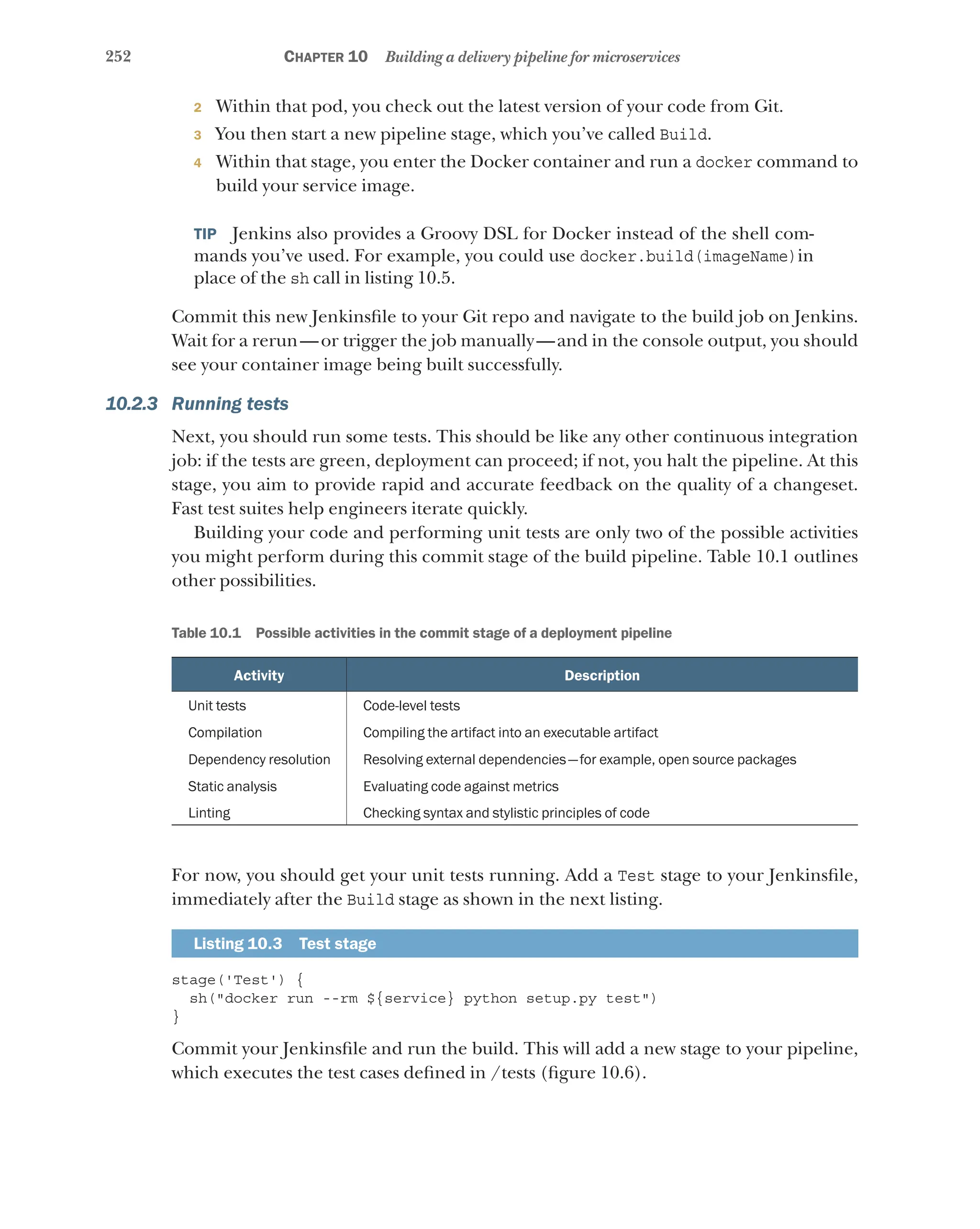
![253
Building a pipeline with Jenkins
Figure 10.6 Your pipeline so far with Build and Test stages
Unfortunately, this code alone won’t make the results visible in the build. Only success
or failure will do that. You can archive the XML results you’re generating by adding the
following to your Jenskinsfile.
Listing 10.4 Archiving results from test stage
stage('Test') {
try {
sh("docker run -v `pwd`:/workspace --rm ${service}
➥python setup.py test")
} finally {
step([$class: 'JUnitResultArchiver', testResults:
➥'results.xml'])
}
}
Mounts the current
workspace as a volume
Archives the results that the test job generates](https://image.slidesharecdn.com/microservicesinaction-240113230140-1bc300cc/75/microservices-in-action-pdf-280-2048.jpg)
![254 Chapter 10 Building a delivery pipeline for microservices
This code mounts the current workspace as a volume within the Docker container. The
python test process will write output to that volume as /workspace/result.xml, and you
can access those results even after Docker has stopped and removed the service con-
tainer. You use the try–finally statement to ensure you achieve results regardless of
pass or failure.
TIP A good build pipeline directs feedback to the responsible engineering
team. For example, our deployment pipelines at Onfido notify commit authors
through Slack and email if pipeline stages fail. We also emit events from our
pipeline for monitoring tools such as PagerDuty to consume. For more on
sending notifications, see the Jenkins documentation (http://mng.bz/C5X3).
Committing your changed Jenkinsfile and running a fresh build will store test results
in Jenkins. You can view them on the build page. Great—you’ve validated your under-
lying code. Now you’re almost ready to deploy.
10.2.4 Publishing artifacts
You need to publish an artifact—in this case, our Docker container image—to be able
to deploy it. If you used a private Docker registry in chapter 9, you’ll need to configure
your Docker credentials within Jenkins:
1 Navigate to Credentials > System > Global Credentials > Add Credentials.
2 Add username and password credentials, using your credentials to https://hub
.docker.com.
3 Set the ID as dockerhub and click OK to save these credentials.
If you’re using a public registry, you can skip this step. Either way, when you’re ready,
add a third step to your Jenkinsfile, as follows.
Listing 10.5 Publishing artifacts
def tagToDeploy = "[your-account]/${service}"
stage('Publish') {
withDockerRegistry(registry: [credentialsId:
➥'dockerhub']) {
sh("docker tag ${service} ${tagToDeploy}")
sh("docker push ${tagToDeploy}")
}
}
The target public image tag—replace
with your account name
Logs in to the Docker registry
using stored credentials
Tags the image with your Docker account name](https://image.slidesharecdn.com/microservicesinaction-240113230140-1bc300cc/75/microservices-in-action-pdf-281-2048.jpg)
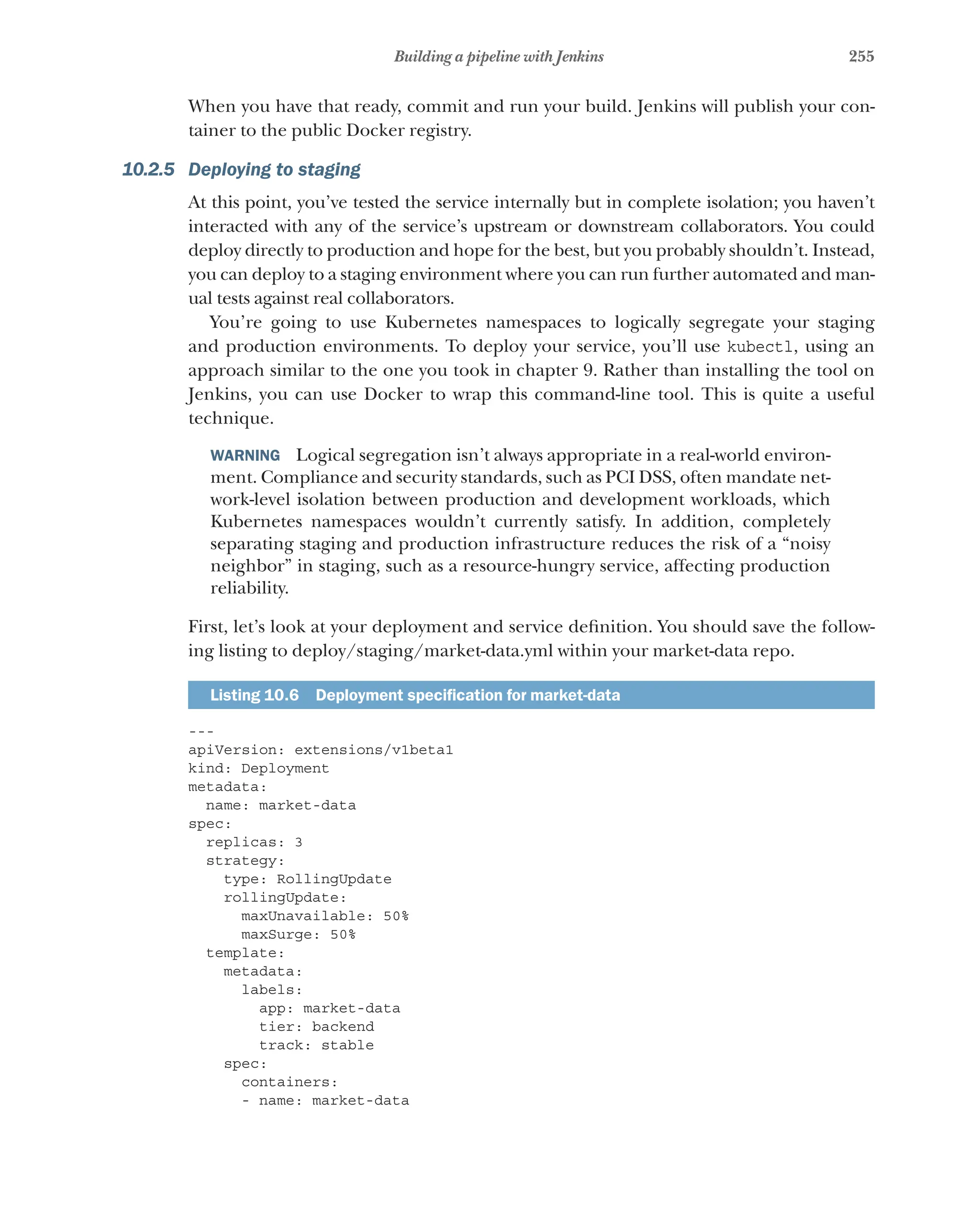
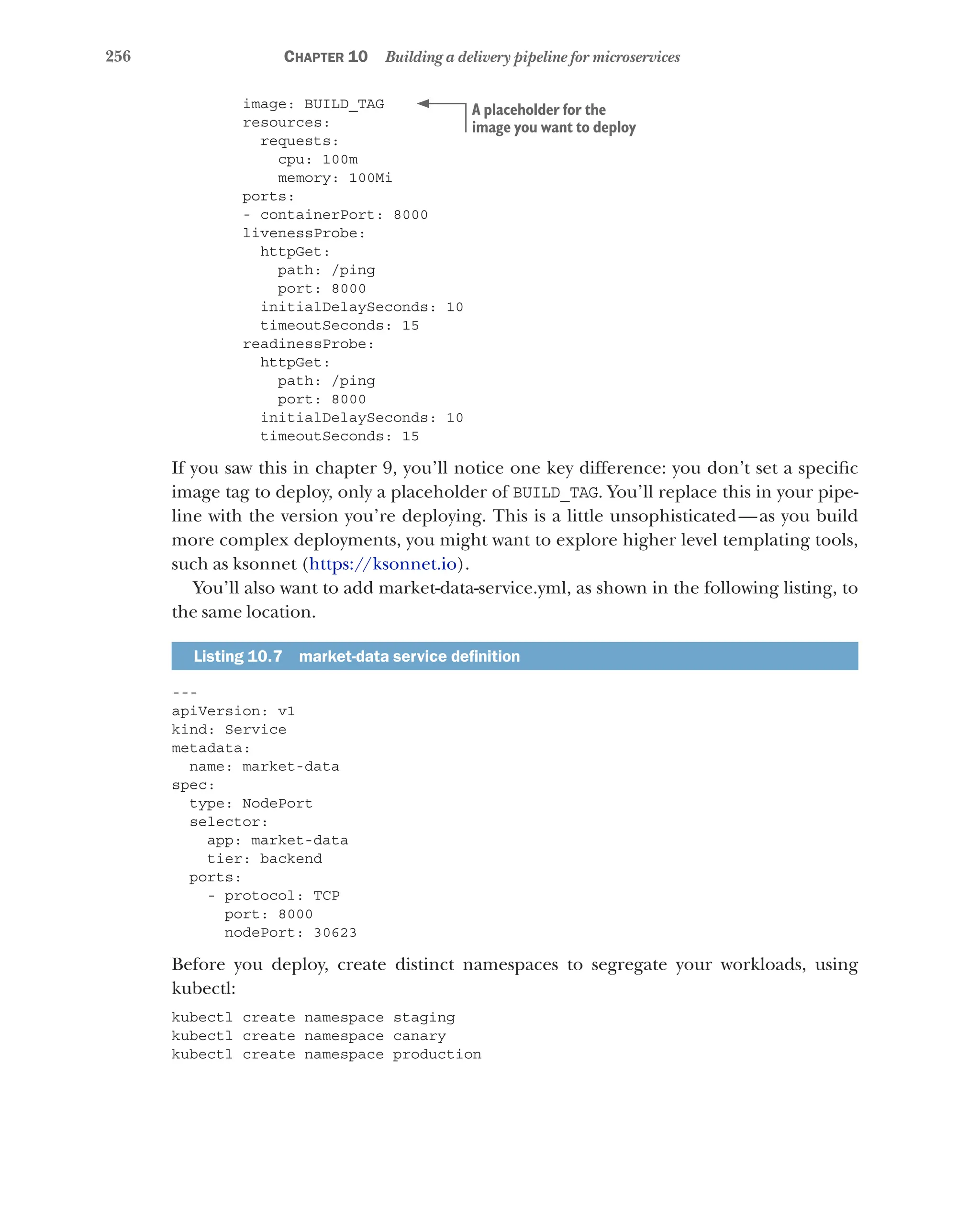
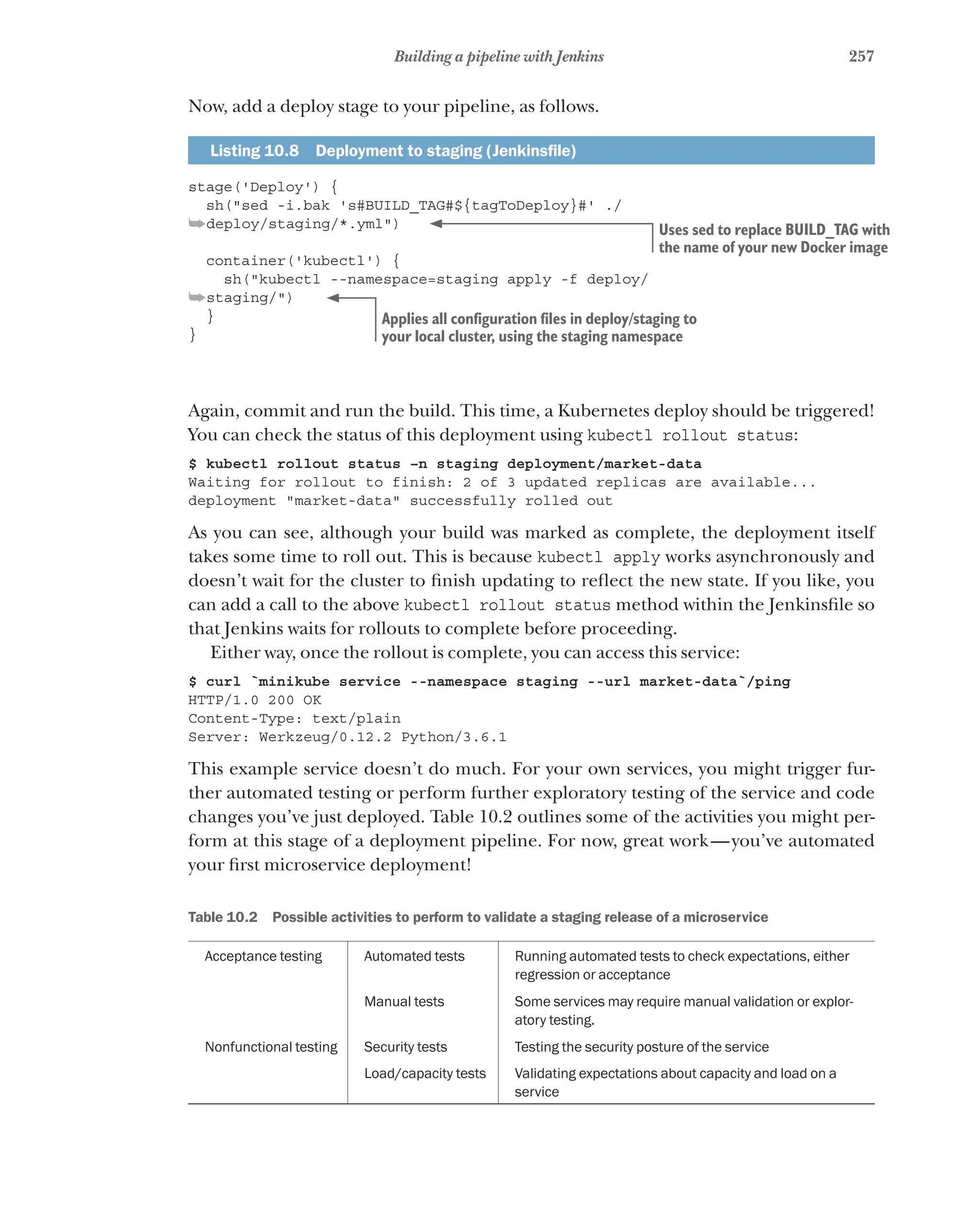
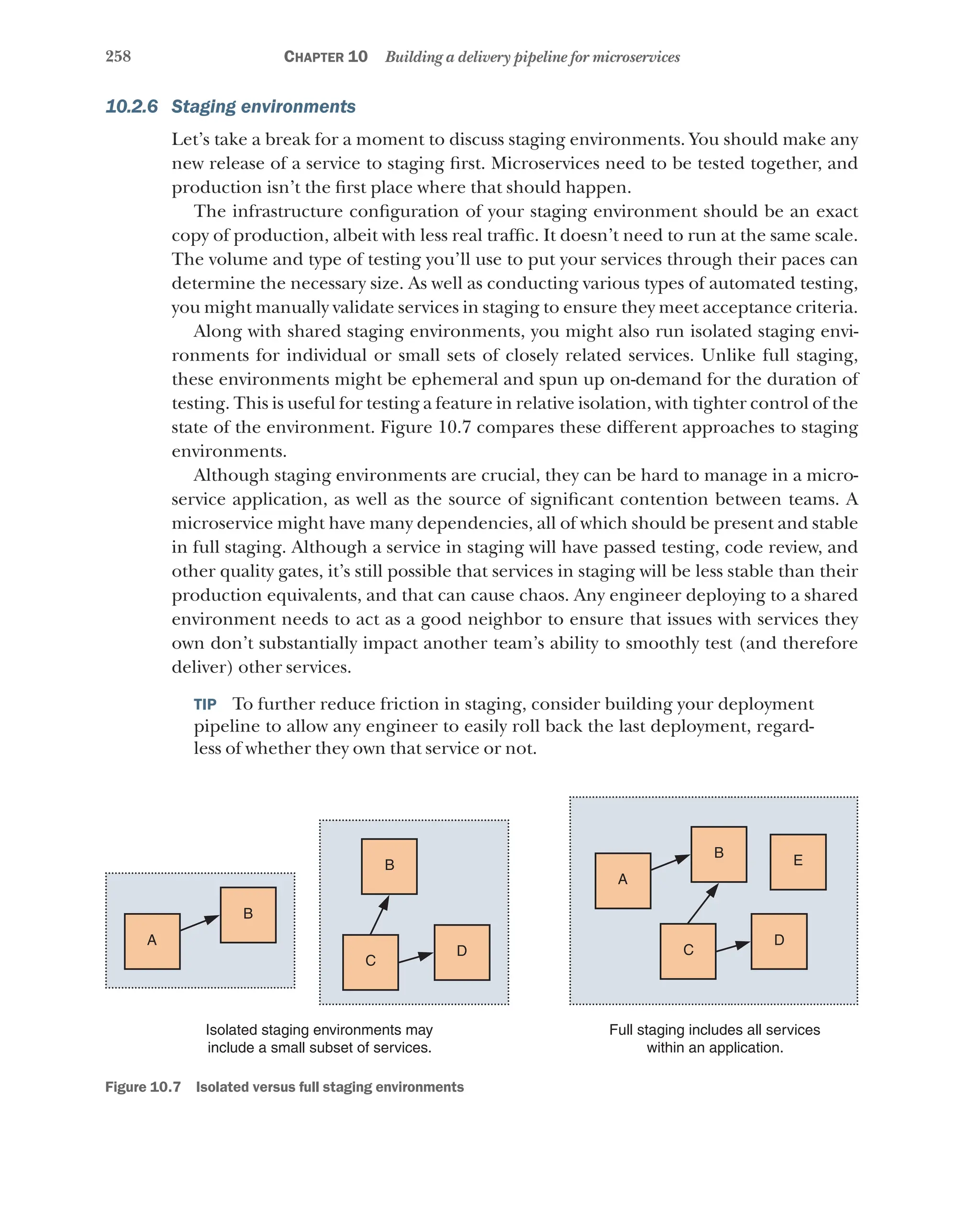
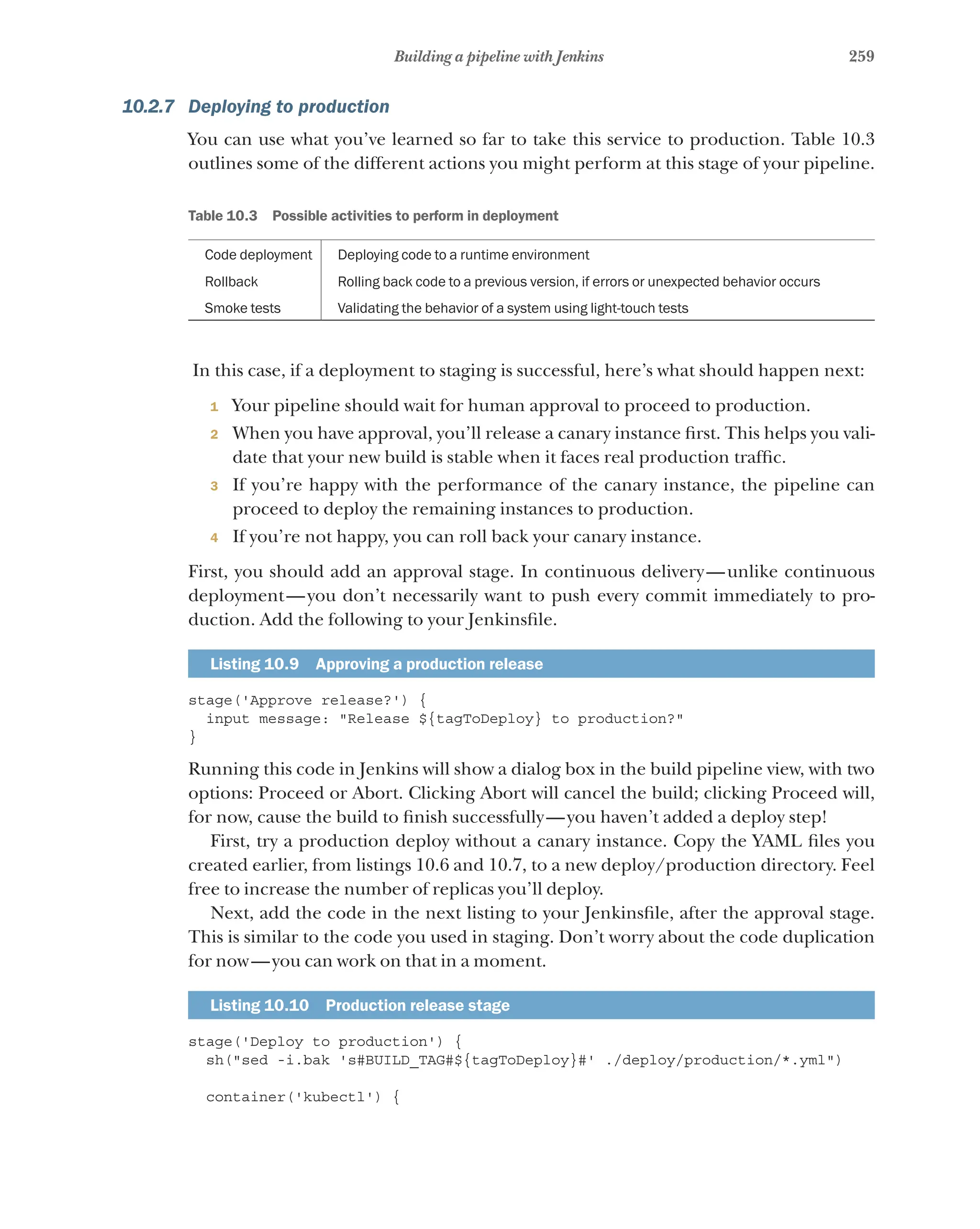
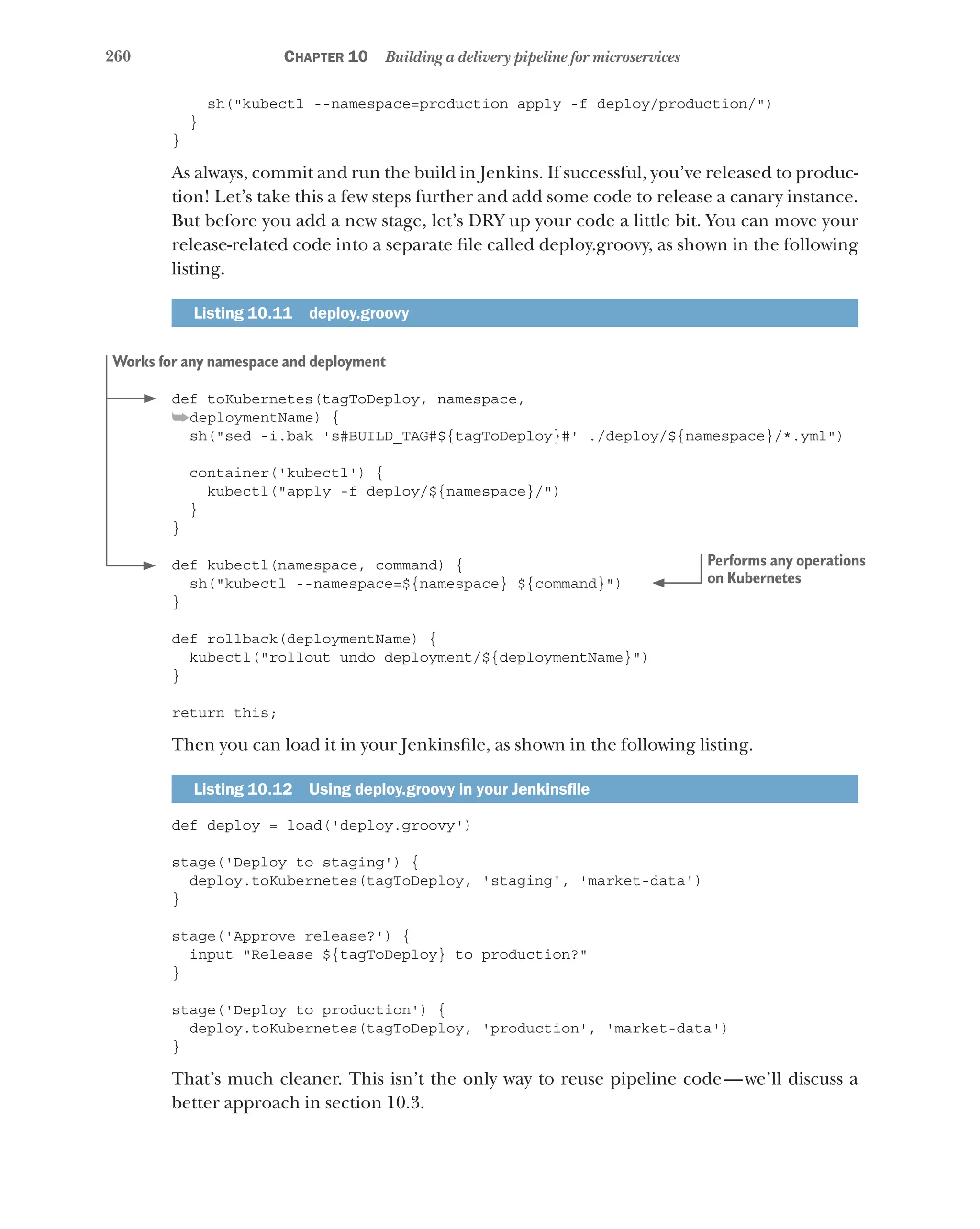
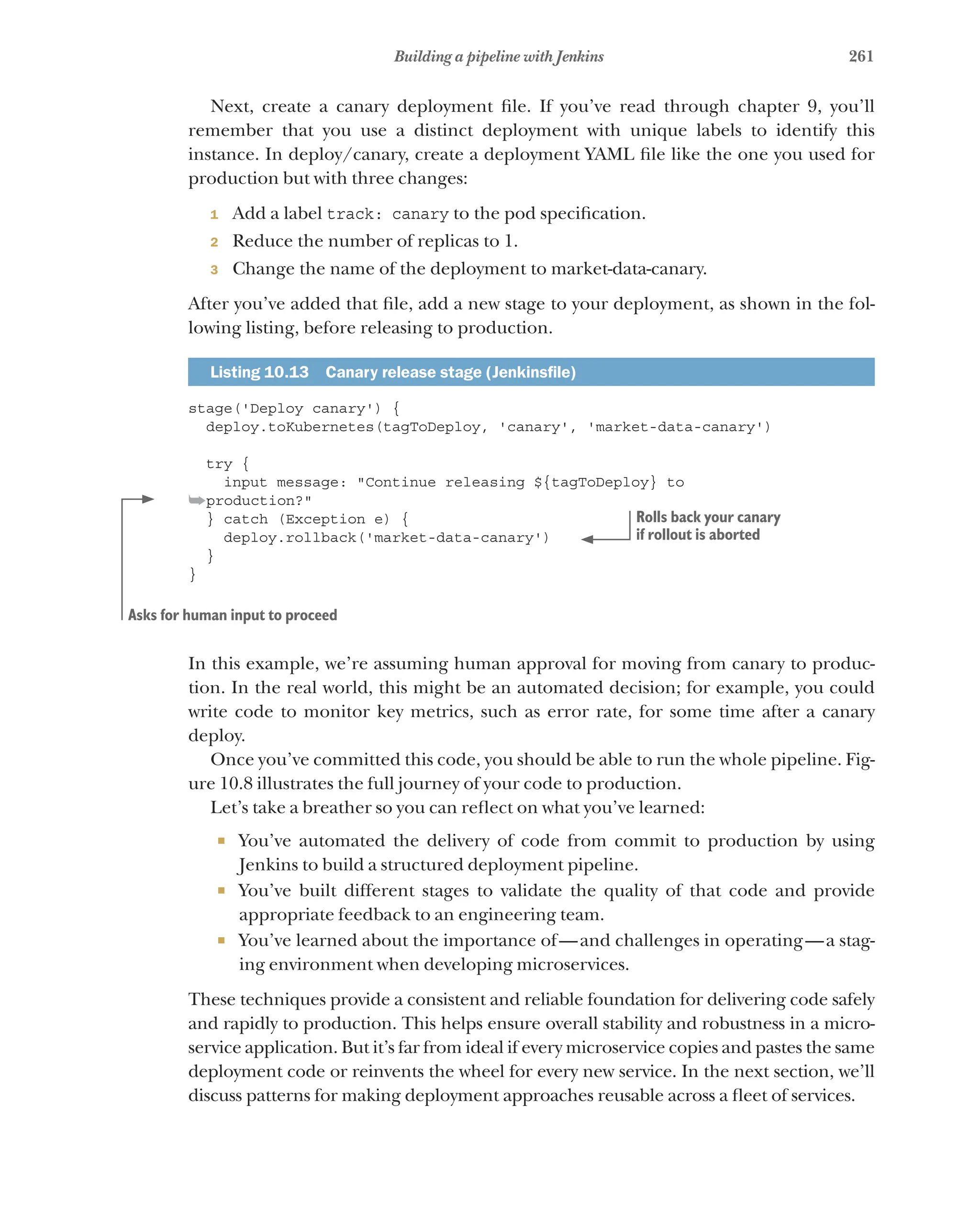
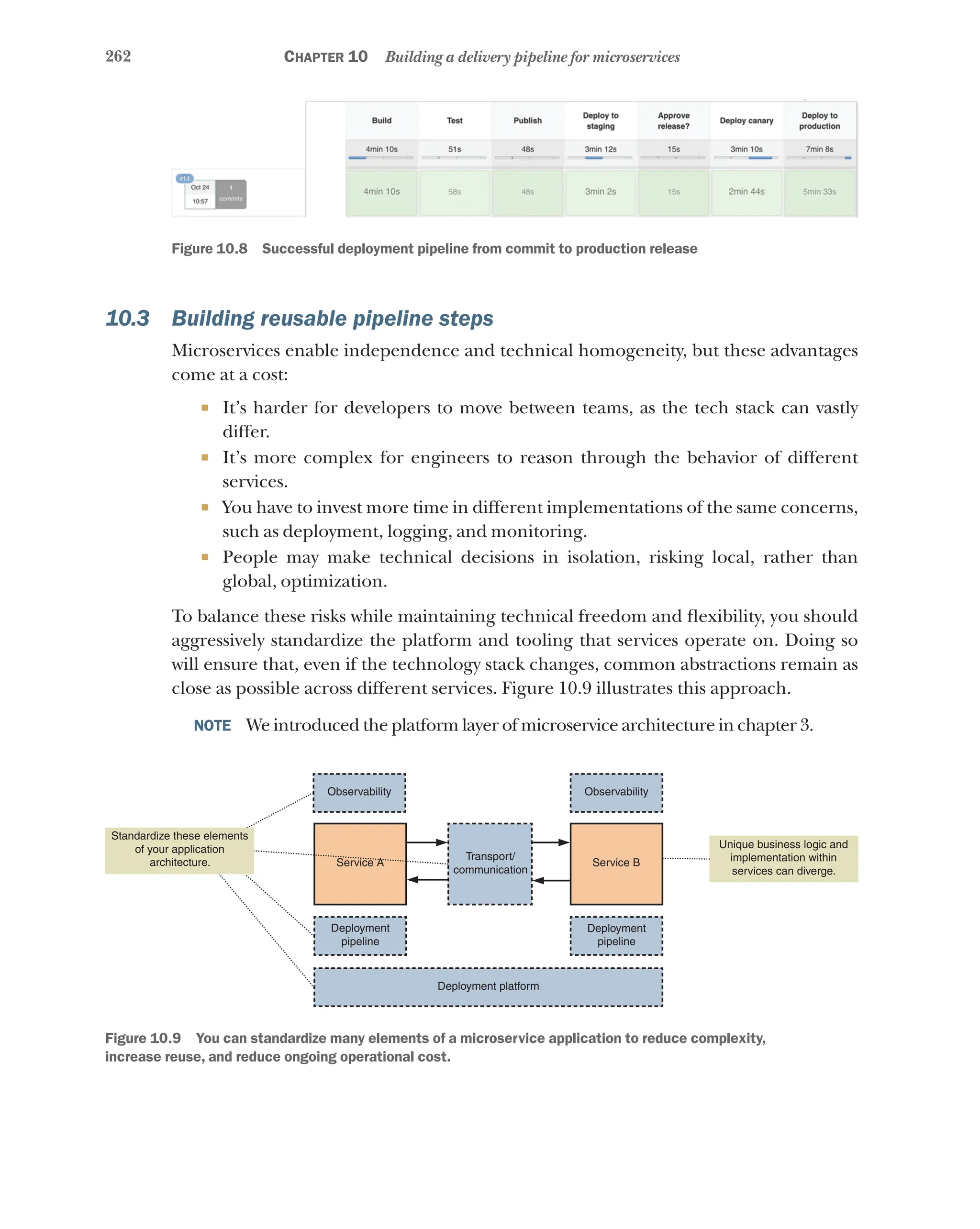
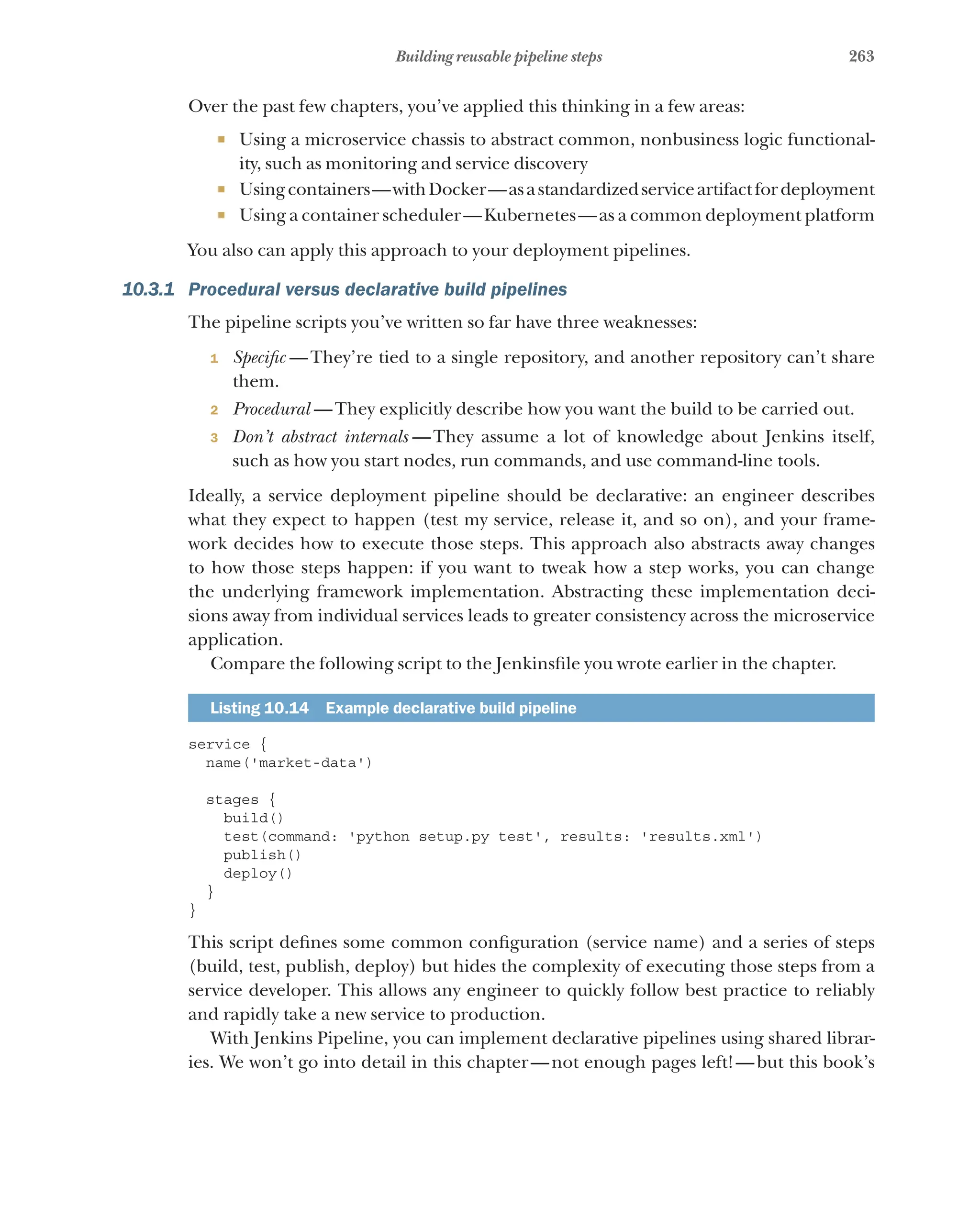
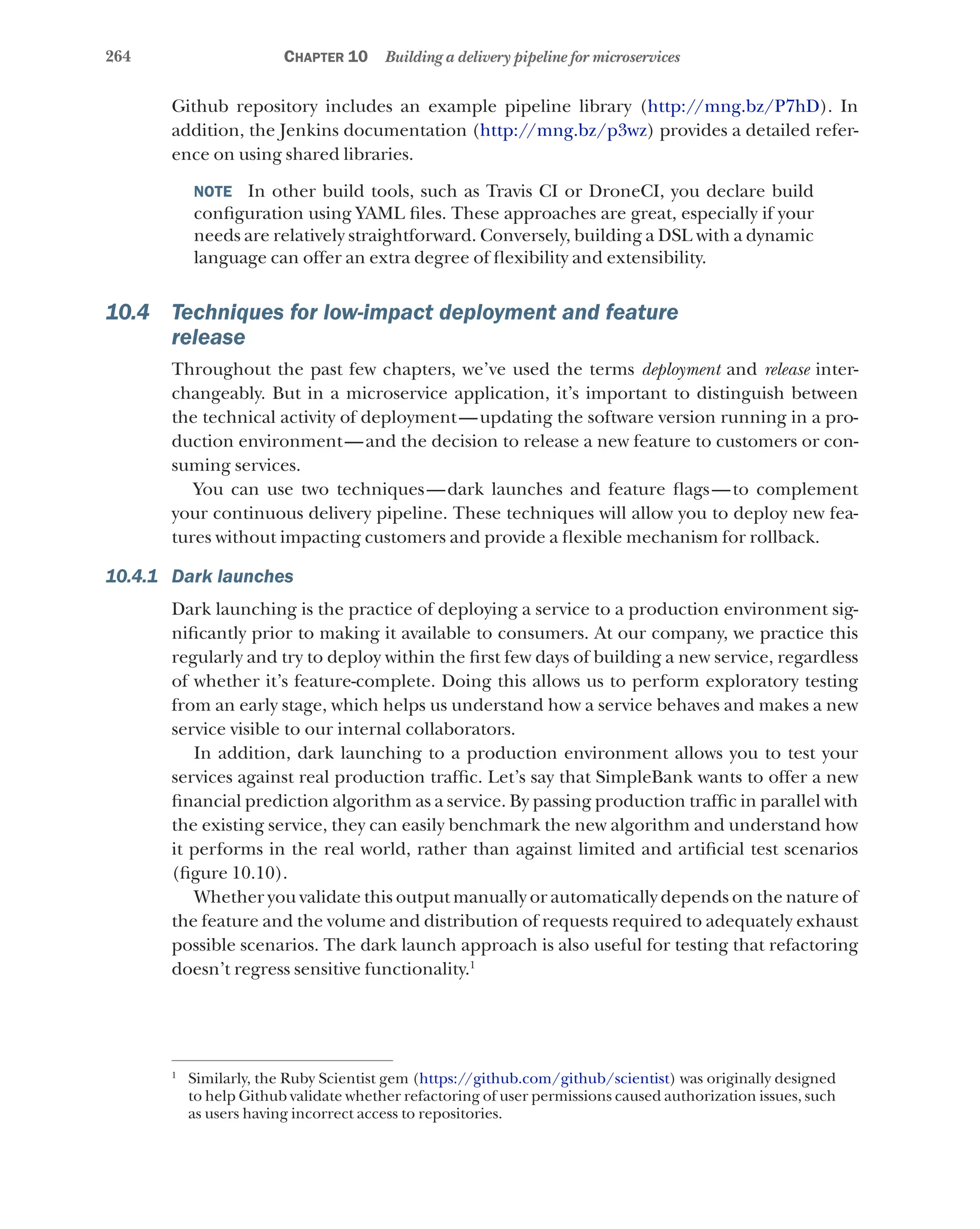
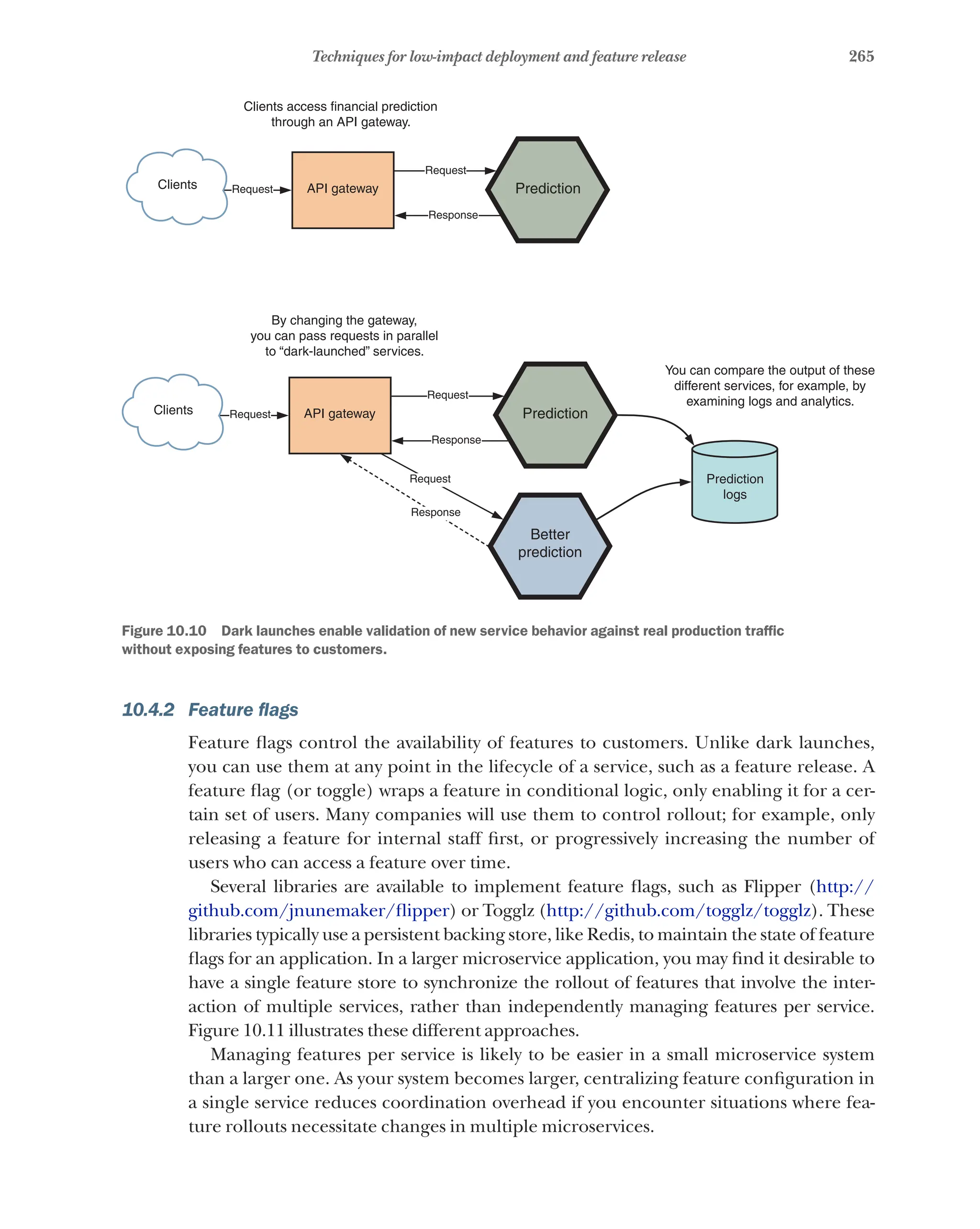
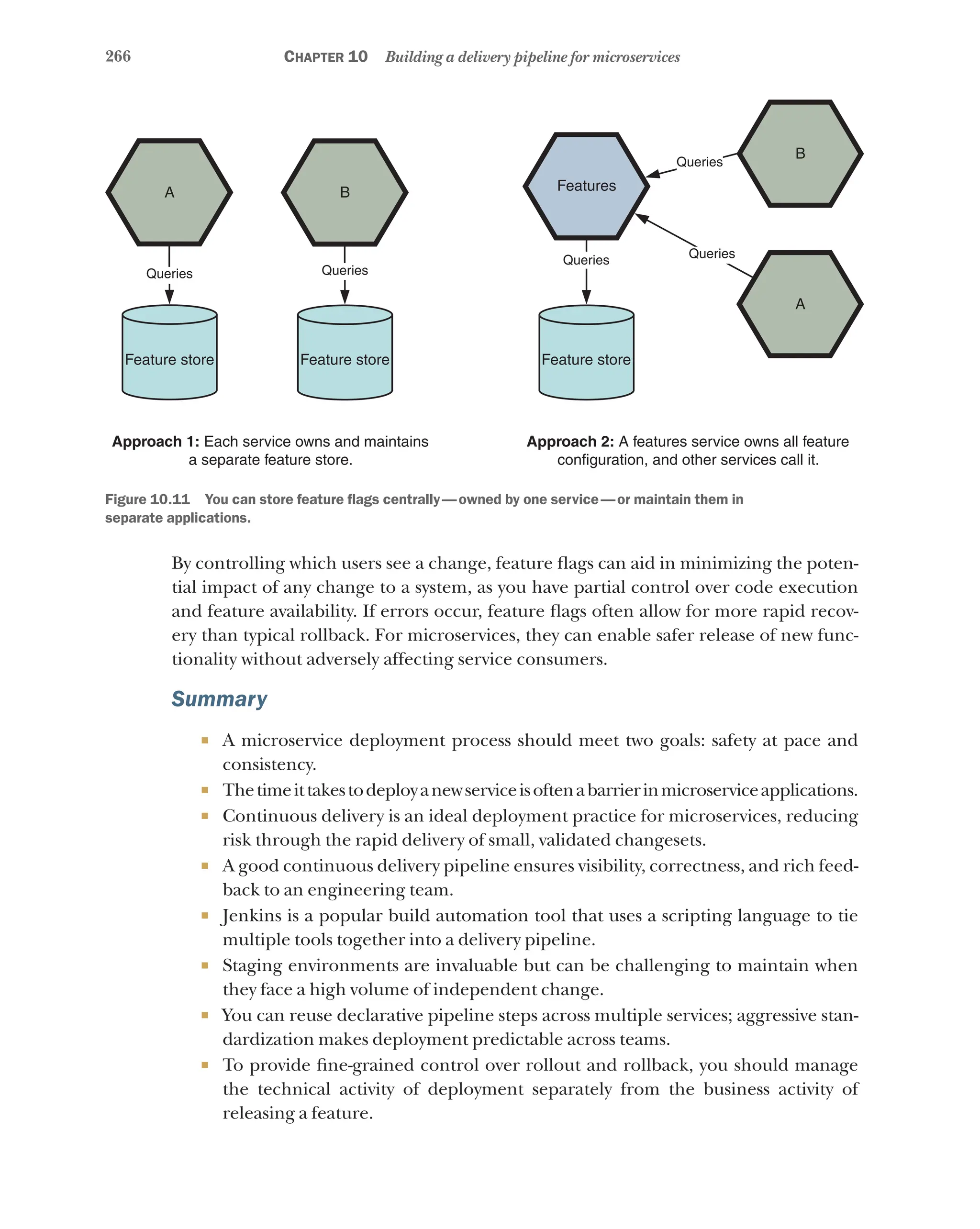
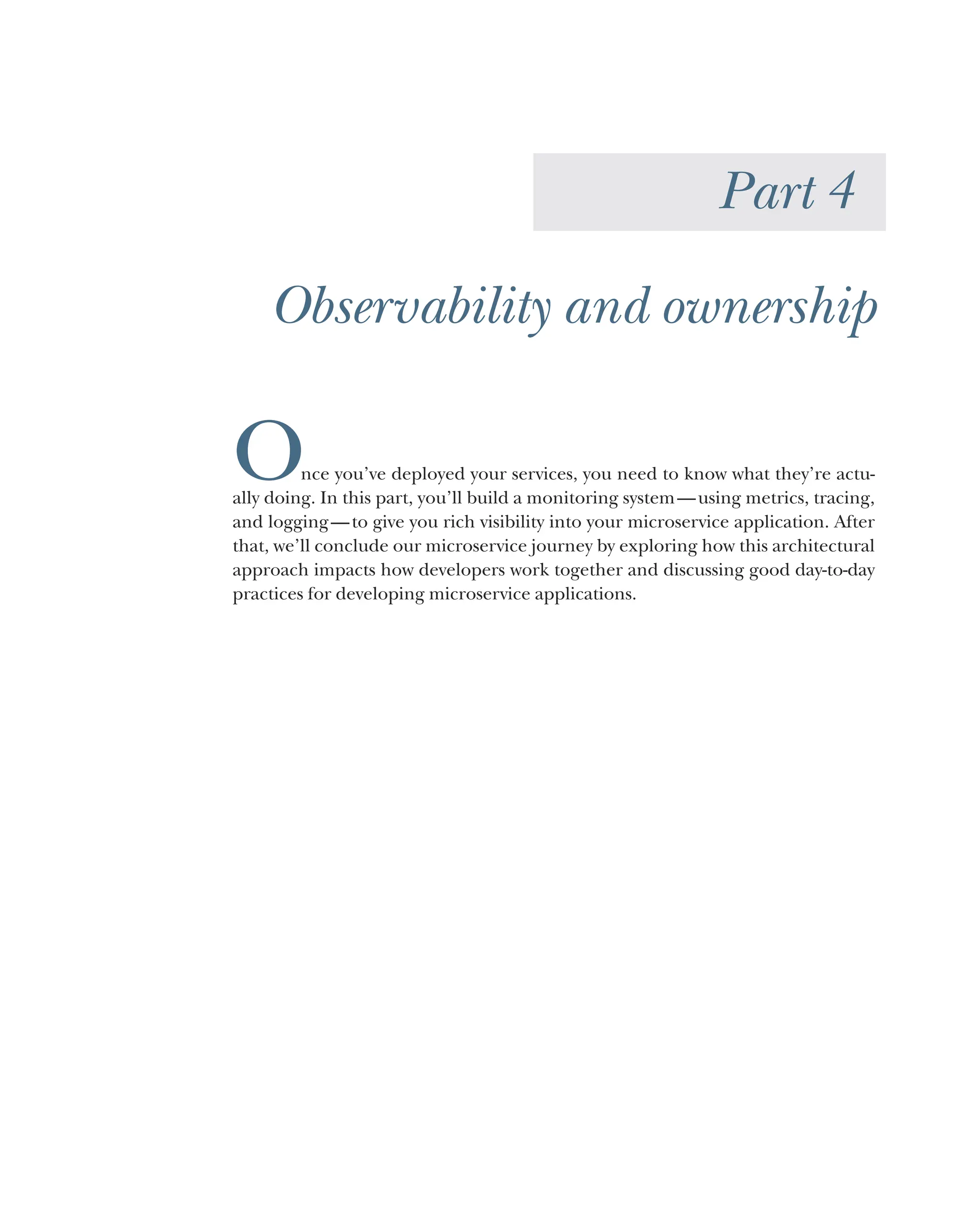



![271
A robust monitoring stack
able to know is that the service itself isn’t serving requests. That alone tells you nothing
about the cause of the issue. If you also collect metrics at the infrastructure level, you
can understand problems that’ll most likely affect multiple other components.
In figure 11.2, you can see the services that work together to allow a client to place an
order for selling or buying shares. Multiple services are involved. Some communication
between services is synchronous, either via RPC or HTTP, and some is asynchronous,
using an event queue. To be able to understand how services are performing, you need
to be able to collect multiple data points to monitor and either diagnose issues or pre-
vent them before they even arise.
Monitoring individual services will be of little to no use because services provide iso-
lation but don’t exist isolated from the outside world. Services often depend on each
other and on the underlying infrastructure (for example, the network, databases, cache
stores, and event queues). You can get a lot of valuable information by monitoring ser-
vices, but you need more. You need to understand what’s going on in all your layers.
2018-02-04T13:55:19.263380548Z
{"@timestamp": "2018-02-04T13:55:19.262Z",
"@version": 1, "source_host": "bb69db21f1eb",
"name": "root", "args": [], "levelname": "INFO",
"levelno": 20, "pathname": "./app.py", "filename":
"app.py", "module": "app", "stack_info": null,
"lineno": 33, "funcName": "sell_shares", "created":
1520171719.26152,
Services
Metrics
Alerts
Metrics
Metrics
Metrics
Traces
Logs
Centralized logging
Traces
Traces
Traces
2018-02-04T13:55:19.263380548Z
{"@timestamp": "2018-02-04T13:55:19.262Z",
"@version": 1, "source_host": "bb69db21f1eb",
"name": "root", "args": [], "levelname": "INFO",
"levelno": 20, "pathname": "./app.py", "filename":
"app.py", "module": "app", "stack_info": null,
"lineno": 33, "funcName": "sell_shares", "created":
1520171719.26152,
2018-02-04T13:55:19.263380548Z
{"@timestamp": "2018-02-04T13:55:19.262Z",
"@version": 1, "source_host": "bb69db21f1eb",
"name": "root", "args": [], "levelname": "INFO",
"levelno": 20, "pathname": "./app.py", "filename":
"app.py", "module": "app", "stack_info": null,
"lineno": 33, "funcName": "sell_shares", "created":
1520171719.26152,
2
Figure 11.1 Components of a monitoring stack—metrics, traces, and logs—each aggregated in their
own dashboards](https://image.slidesharecdn.com/microservicesinaction-240113230140-1bc300cc/75/microservices-in-action-pdf-298-2048.jpg)
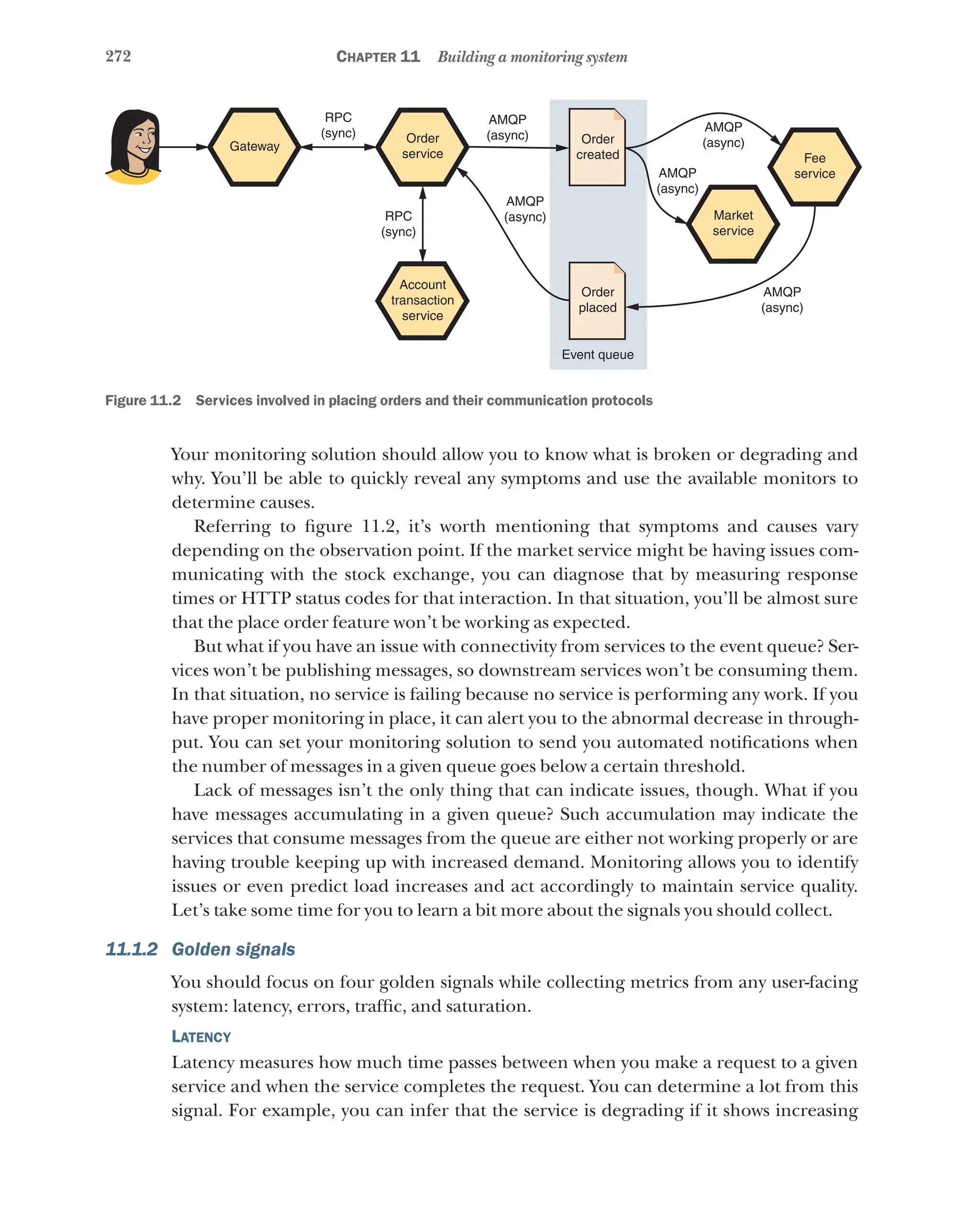

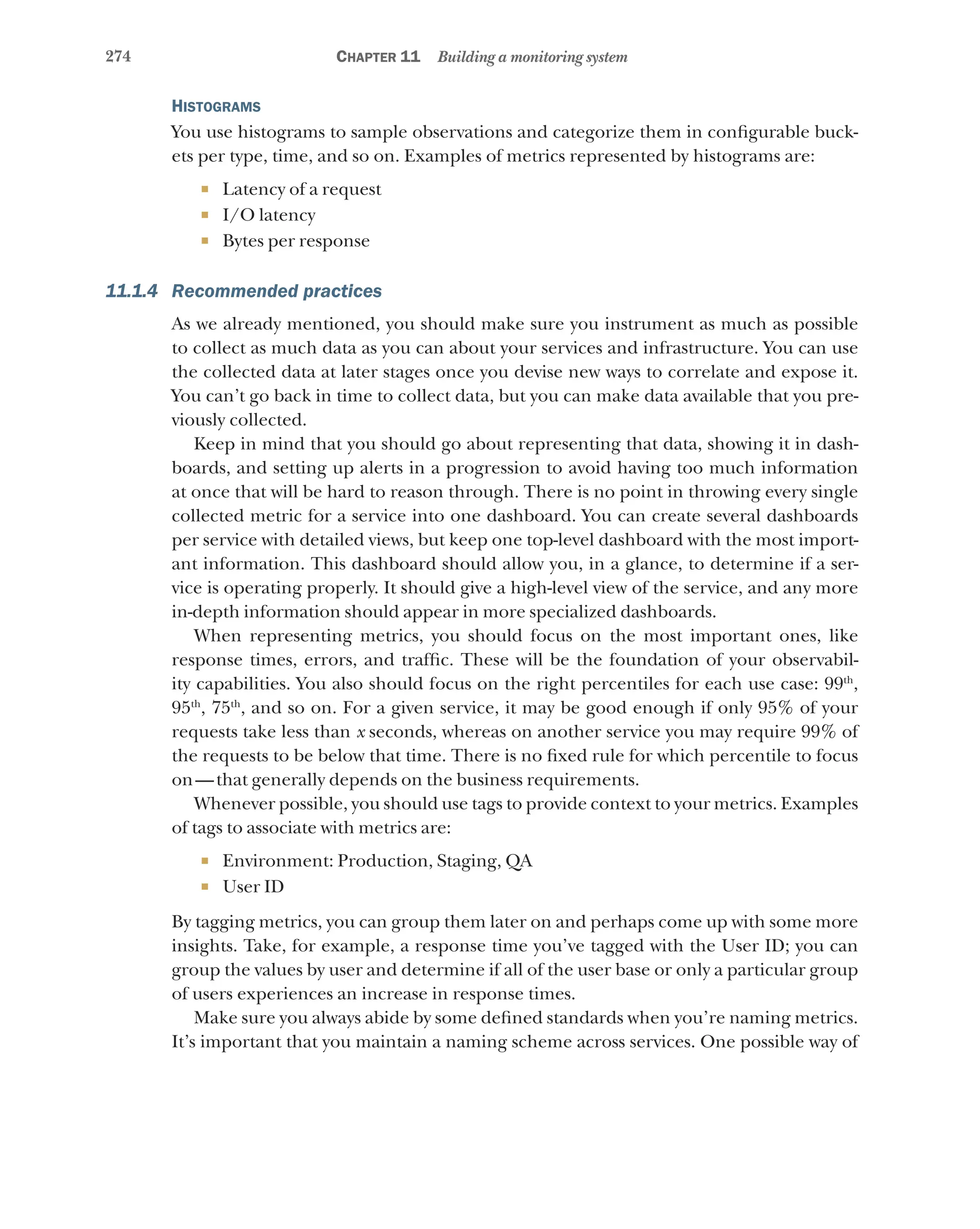

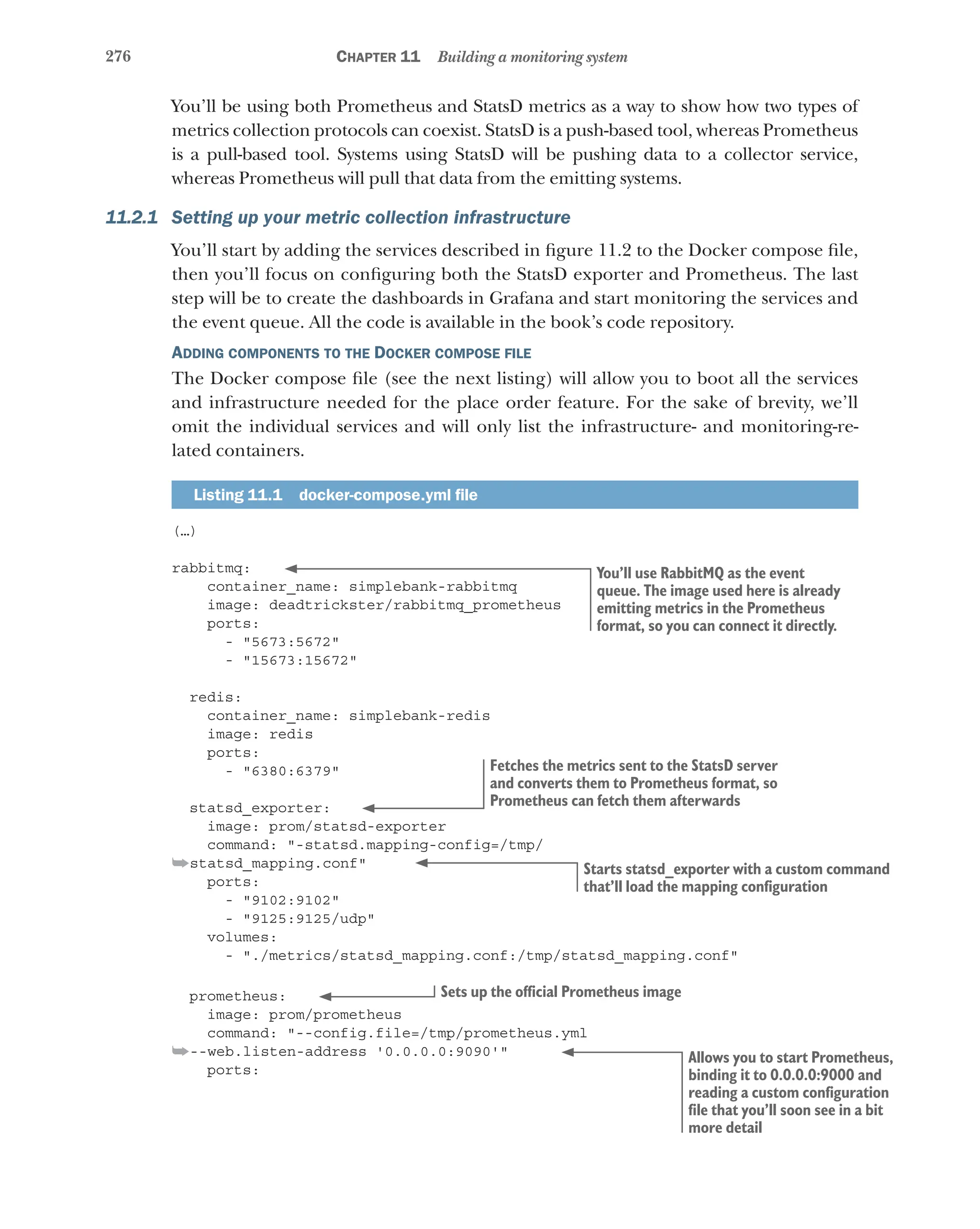
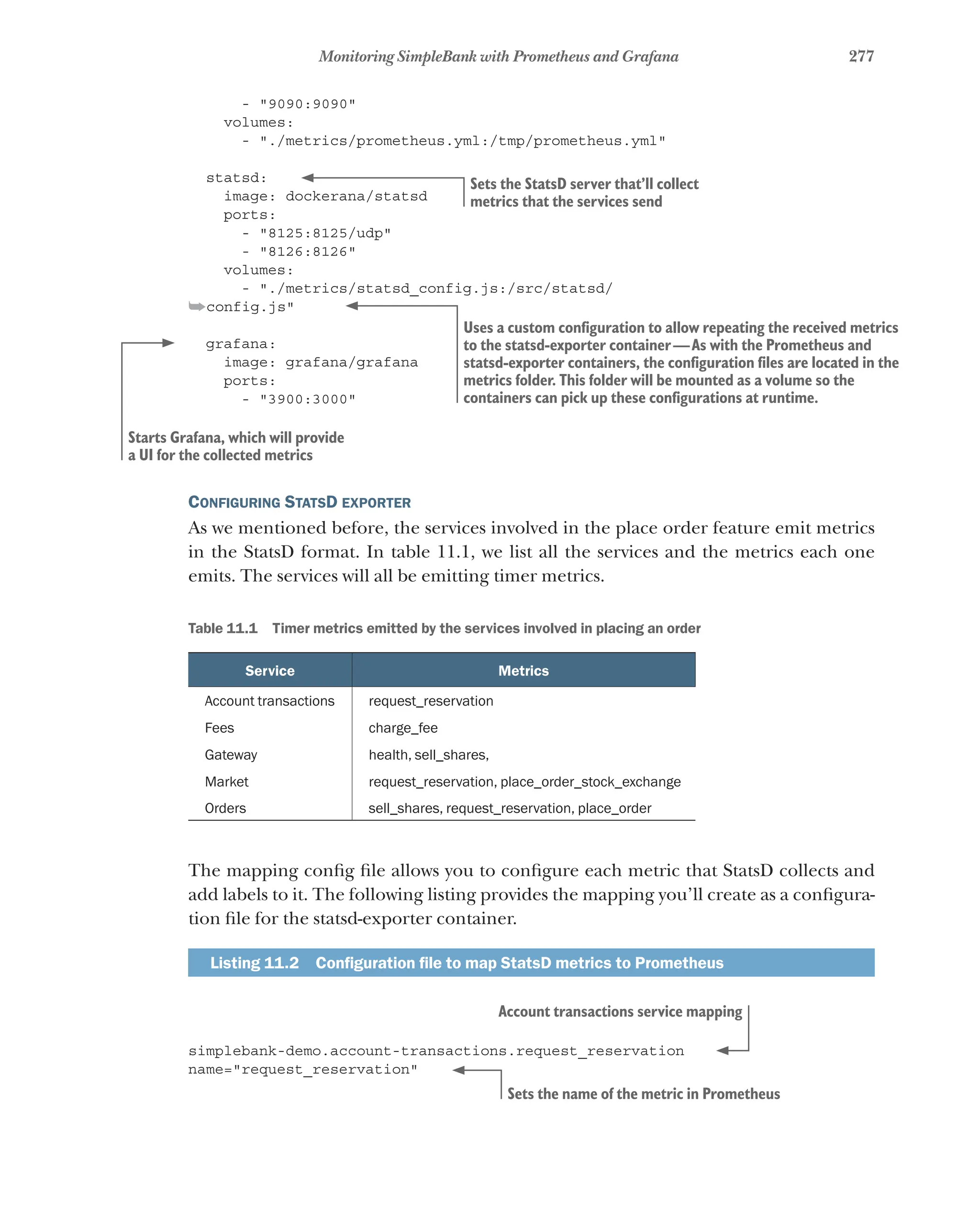
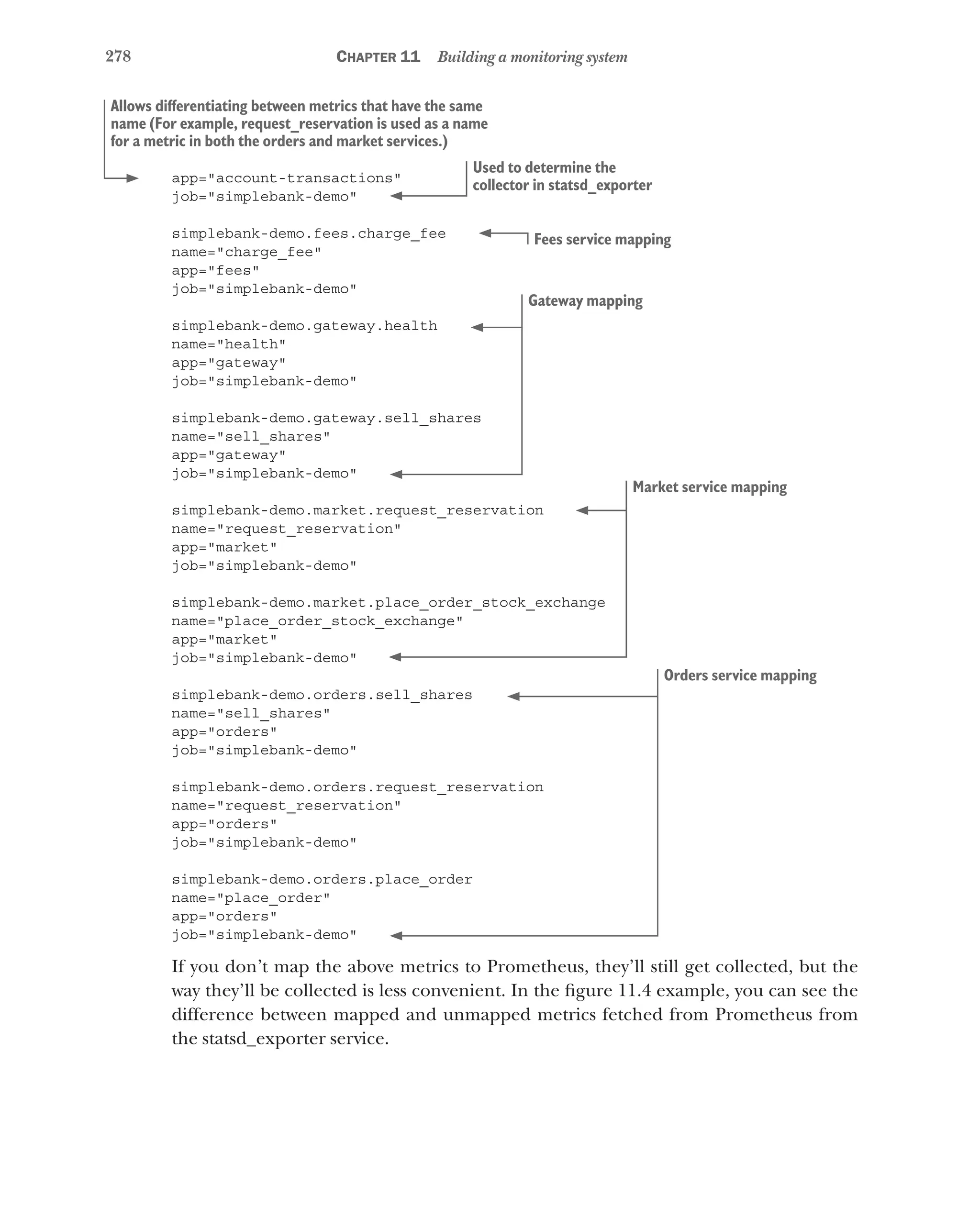
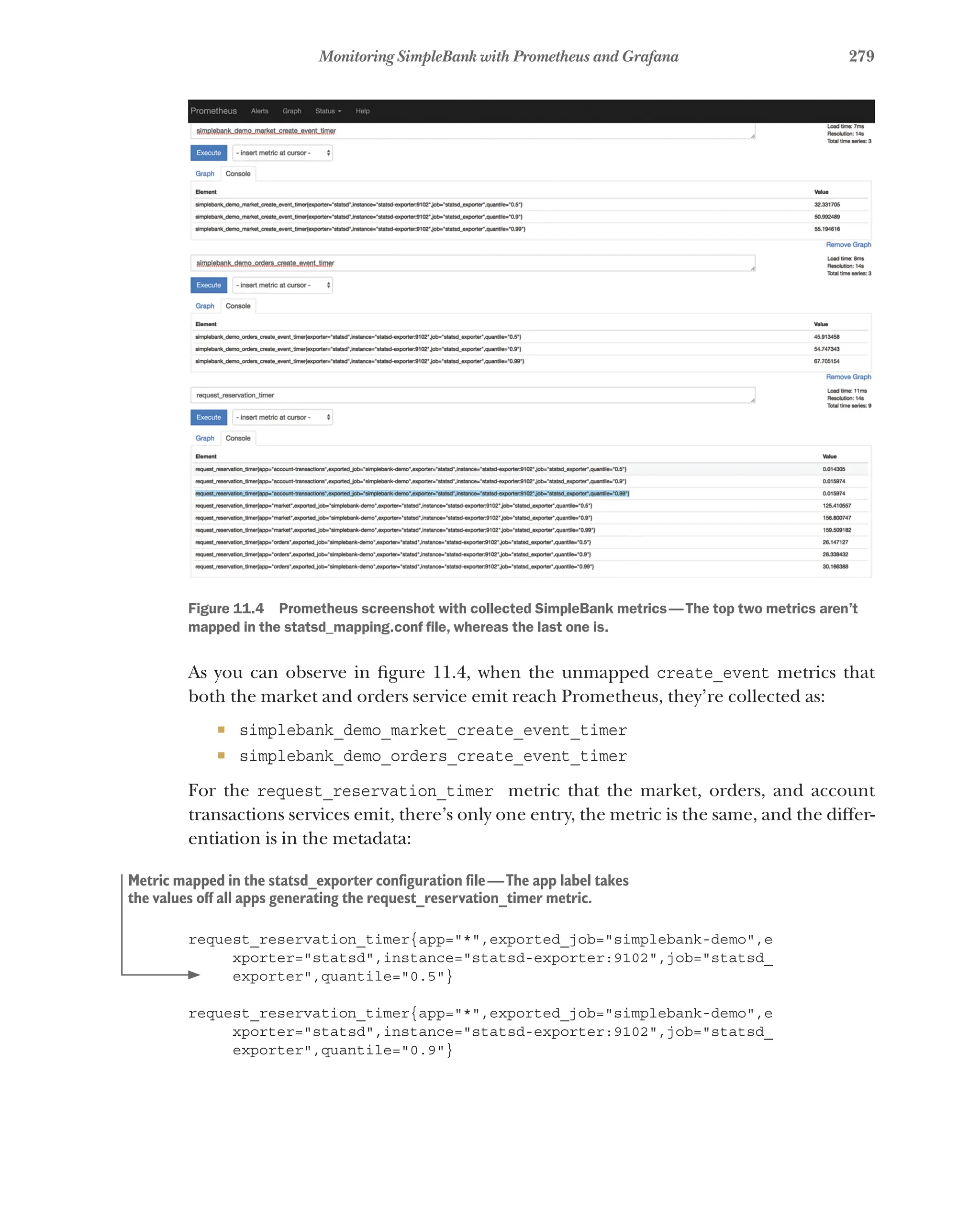
![280 Chapter 11 Building a monitoring system
request_reservation_timer{app="*",exported_job="simplebank-demo",e
xporter="statsd",instance="statsd-exporter:9102",job="statsd_
exporter",quantile="0.99"}
simplebank_demo_market_create_event_timer{exporter="statsd",instance="statsd-
exporter:9102",job="statsd_exporter",quantile="0.5"}
Configuring Prometheus
Now that you’ve configured the StatsD exporter, it’s time to configure Prometheus for
it to fetch data from both the StatsD exporter and RabbitMQ, as shown in the following
listing. Both of these sources will be available as targets for metrics data fetching.
Listing 11.3 Prometheus configuration file
global:
scrape_interval: 5s
evaluation_interval: 10s
external_labels:
monitor: 'simplebank-demo'
alerting:
alertmanagers:
- static_configs:
- targets:
scrape_configs:
- job_name: 'statsd_exporter'
static_configs:
- targets: ['statsd-exporter:9102']
labels:
exporter: 'statsd'
metrics_path: '/metrics'
- job_name: 'rabbitmq'
static_configs:
- targets: ['rabbitmq:15672']
labels:
exporter: 'rabbitmq'
metrics_path: '/api/metrics'
Setting up Grafana
To receive metrics in Grafana, you need to set up a data source. First, you can boot your
applications and infrastructure by using the Docker compose file. This will allow you to
access Grafana on port 3900, as follows.
Metric not mapped in the statsd_exporter configuration
file—There’s no app and no exported_job labels.
Sets the interval at which Prometheus will
scrape the configured targets for metrics
Scrapes config section where each target
is configured
Will be added as a label any time
series scraped from the config
The target host and metrics path will be
concatenated to determine the URL to
collect metrics from. Given that in this case
the scheme defaults to http, the URL will be
'http://rabbitmq:15672/api/metrics'.](https://image.slidesharecdn.com/microservicesinaction-240113230140-1bc300cc/75/microservices-in-action-pdf-307-2048.jpg)
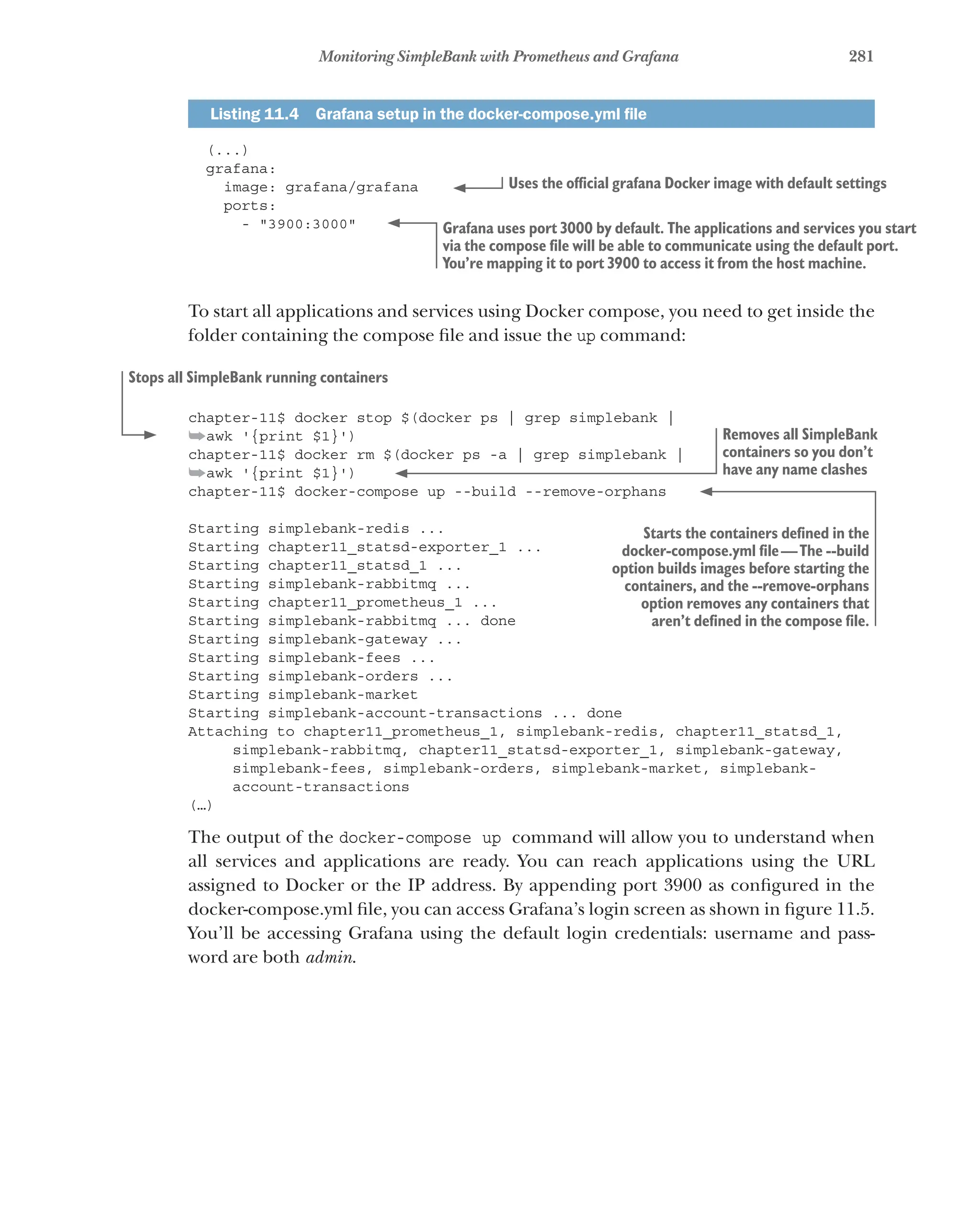
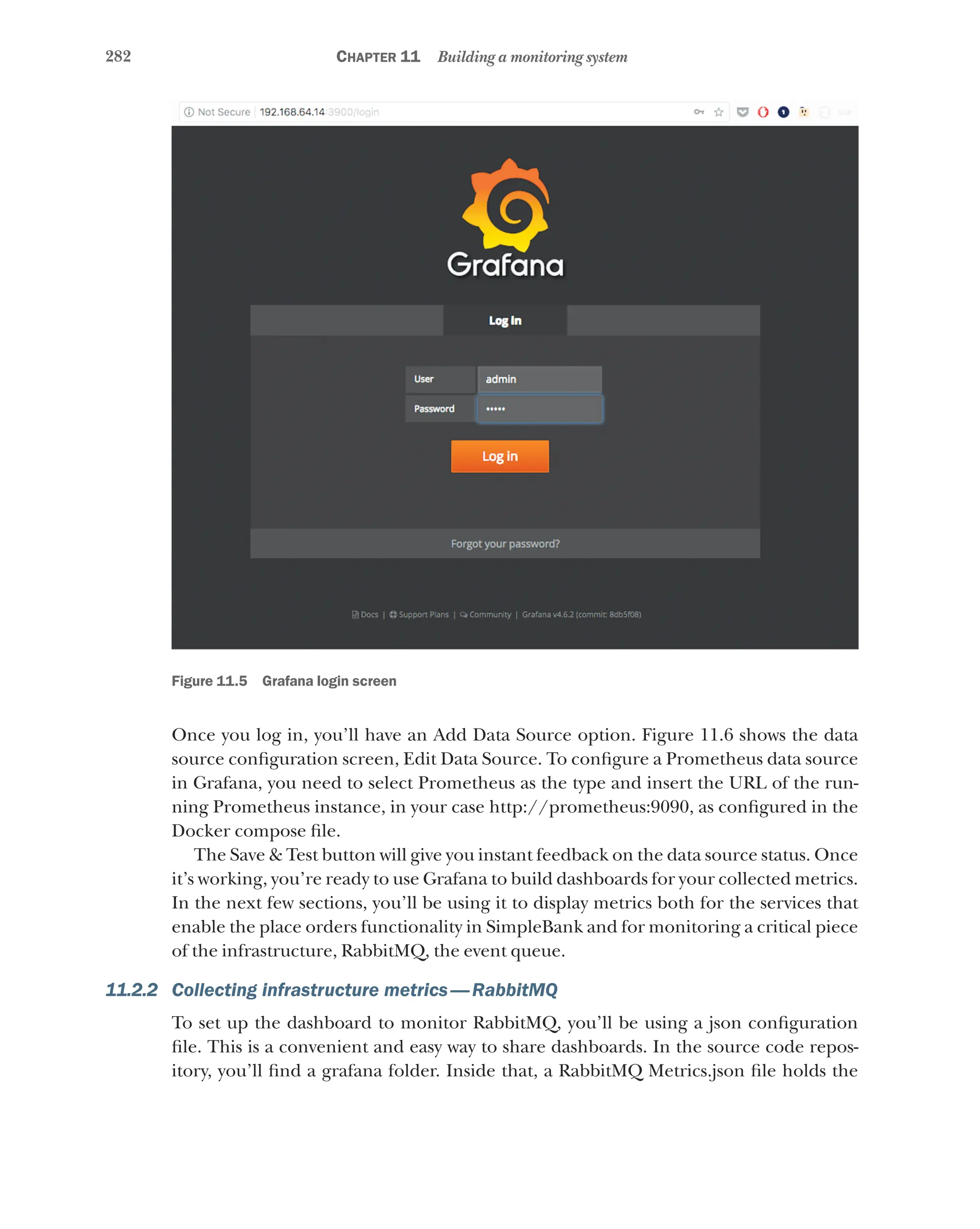

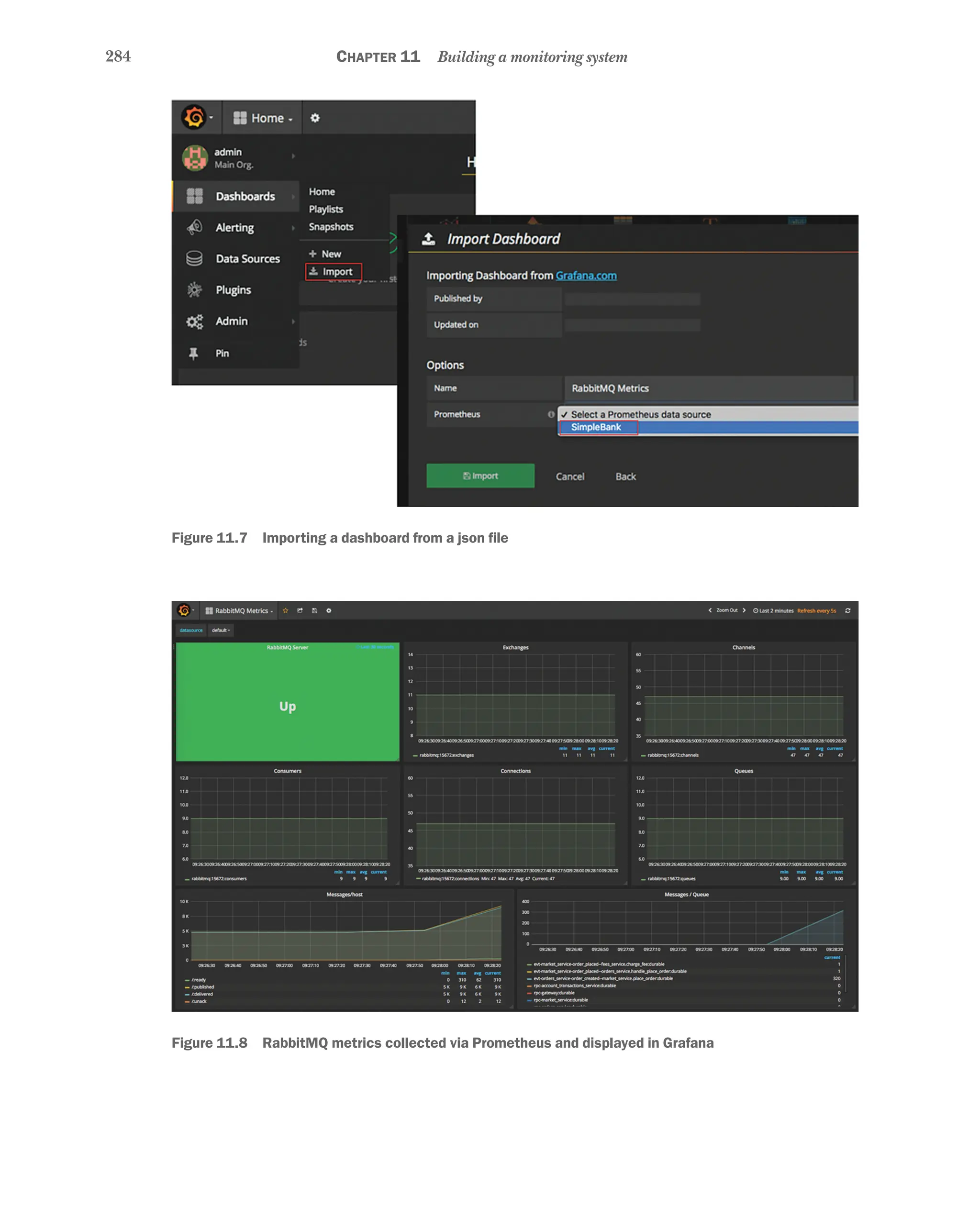

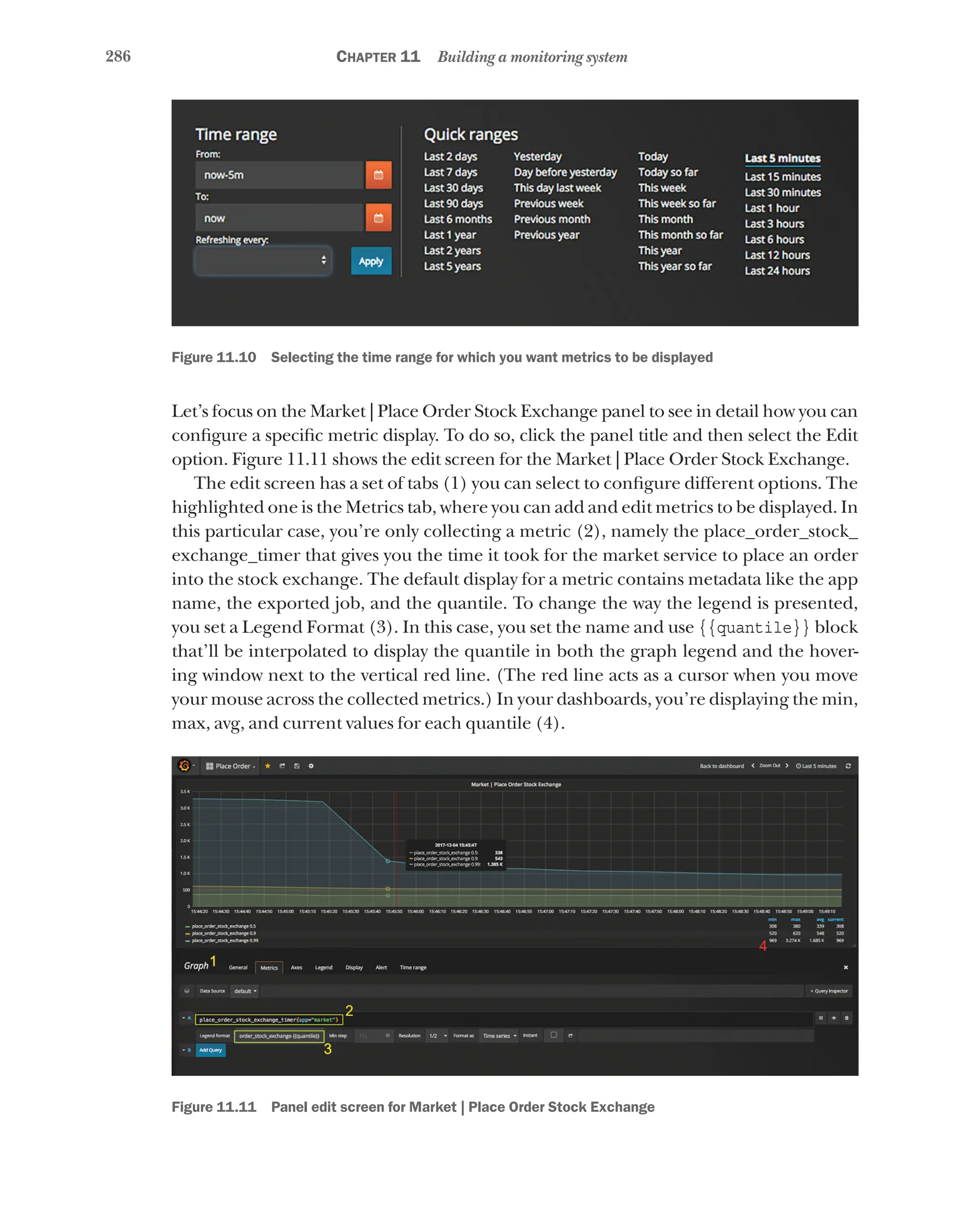

![288 Chapter 11 Building a monitoring system
"instance":"rabbitmq:15672",
"job":"rabbitmq",
"queue":"evt-orders_service-order_created
➥--market_service.place_order",
"vhost":"/"
}
}
],
"message":"Messages accumulating in the queue",
"ruleId":1,
"ruleName":"High number of messages in a queue",
"ruleUrl":"http://localhost:3000/dashboard/db/rabbitmq-metrics?fullscreen
➥u0026editu0026tab=alertu0026panelId=2u0026orgId=1",
"state":"alerting",
"title":"[Alerting] High number of messages in a queue"
}
Figure 11.12 The message queue’s status showing alert overlays
Shows information about the queue
where the alert was triggered
Identifies what rule
this alert is related to
Indicates the message type—In this case, "alerting" means
an alert was triggered and the number of messages in the
queue is above the normal operating threshold.](https://image.slidesharecdn.com/microservicesinaction-240113230140-1bc300cc/75/microservices-in-action-pdf-315-2048.jpg)
![289
Monitoring SimpleBank with Prometheus and Grafana
Likewise, when the number of messages in a queue goes below the value defined as the
threshold for alerting, the service also issues a message to notify about it:
alerts.alert.209f0d07-b36a-43f4-b97c-2663daa40410:
{
"evalMatches":[],
"message":"Messages accumulating in the queue",
"ruleId":1,
"ruleName":"High number of messages in a queue",
"ruleUrl":"http://localhost:3000/dashboard/db/rabbitmq-metrics?fullscreen
➥u0026editu0026tab=alertu0026panelId=2u0026orgId=1",
"state":"ok",
"title":"[OK] High number of messages in a queue"
}
Let’s now see how you can set up this alert for the number of messages in queues.
You’ll also be using Grafana for setting up the alert, because it offers this capability and
the alerts will display on the panels they relate to. You’ll be able to both receive notifi-
cations and check the panels for previous alerts.
You’ll start by adding a notification channel that’ll you’ll use to propagate alert
events. Figure 11.13 shows how to create a new notification channel
To set up a new notification channel in Grafana, follow these steps:
1 Click the Grafana icon on the top left of the screen.
2 Under the Alerting menu, select Notification Channels.
Figure 11.13 Setting up a new notification channel in Grafana
Identifies the rule the
alert is related to
The "ok" state means the number of messages in the queues are all back to
below the set threshold; the conditions for a previous alert are no longer met.](https://image.slidesharecdn.com/microservicesinaction-240113230140-1bc300cc/75/microservices-in-action-pdf-316-2048.jpg)
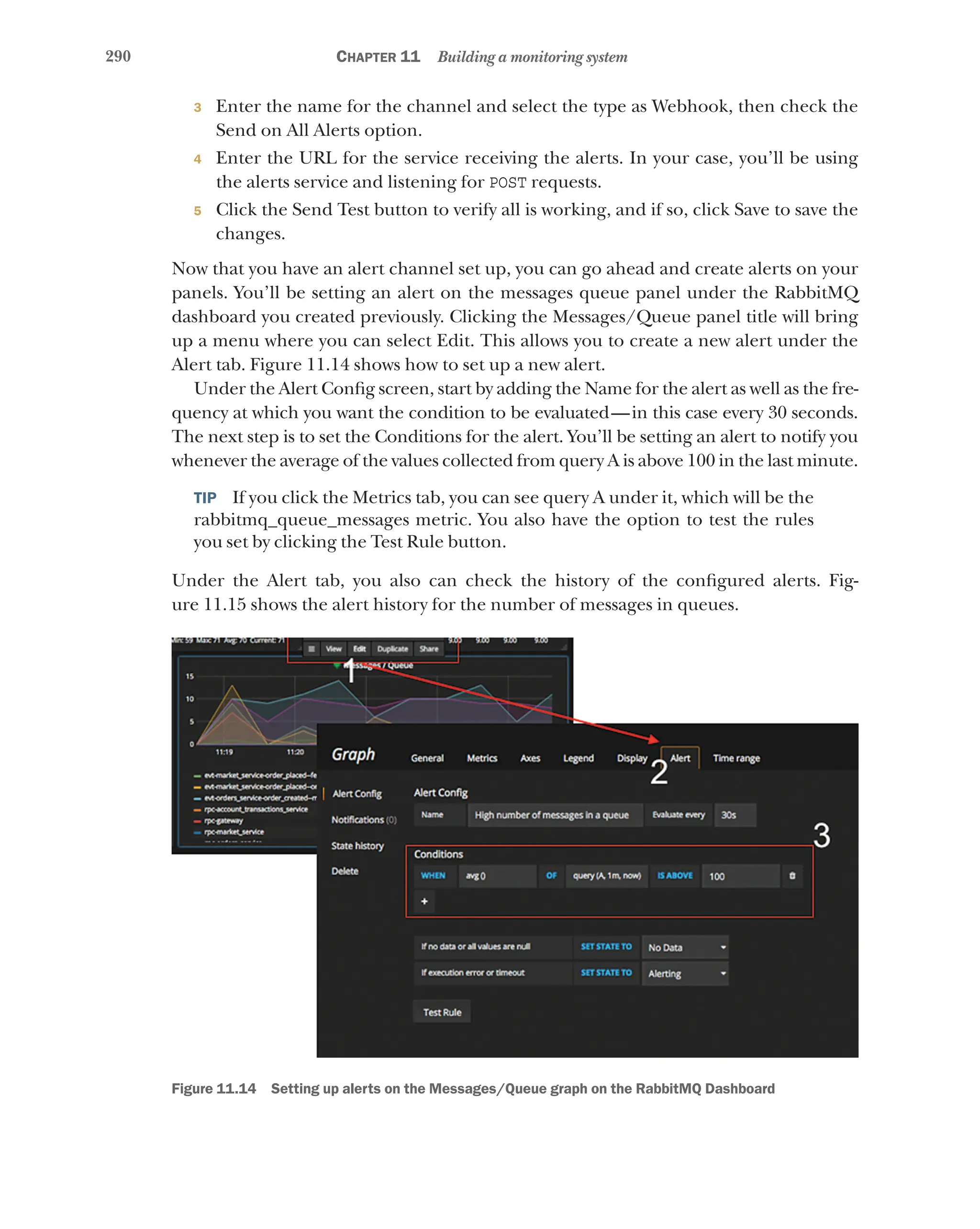
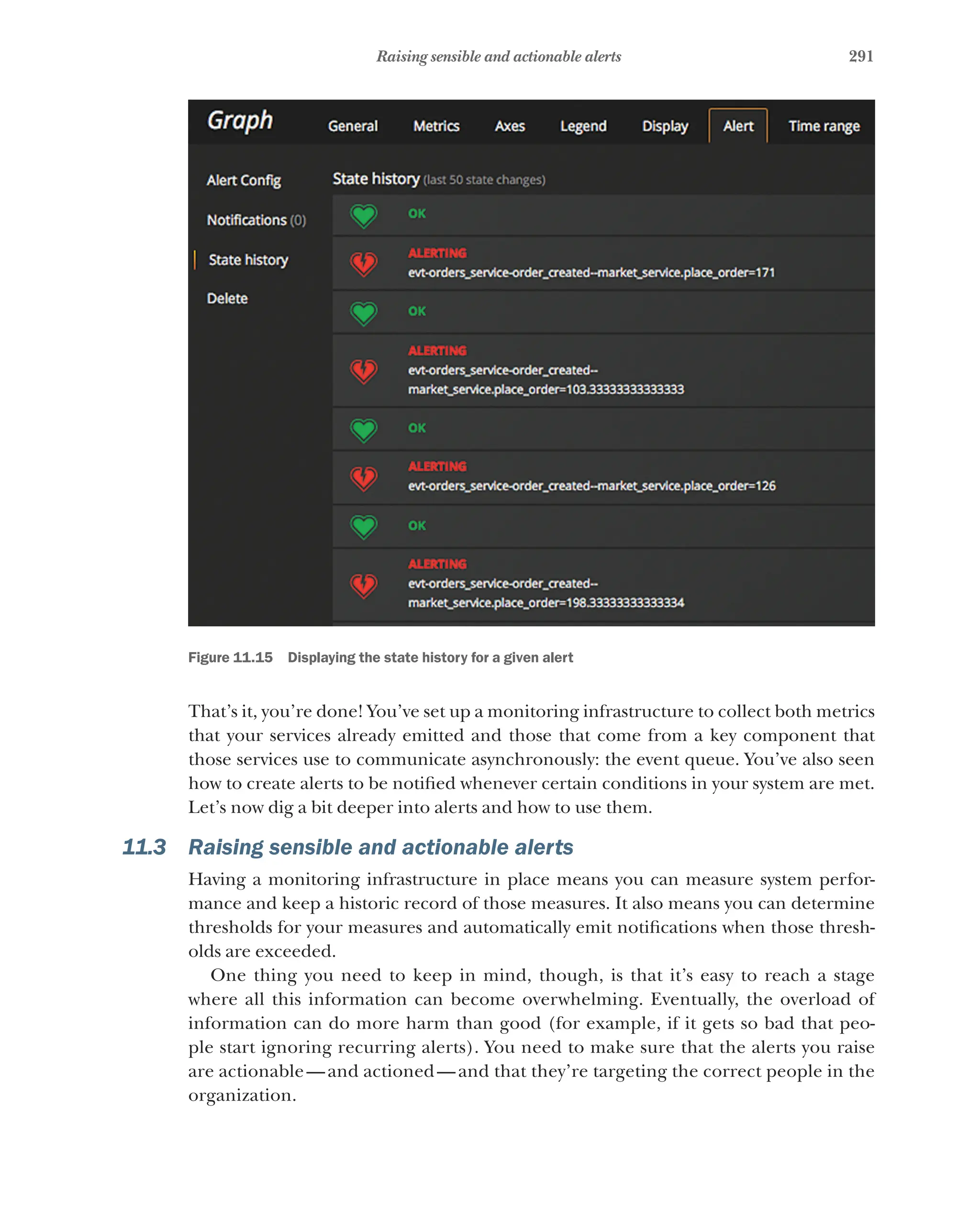
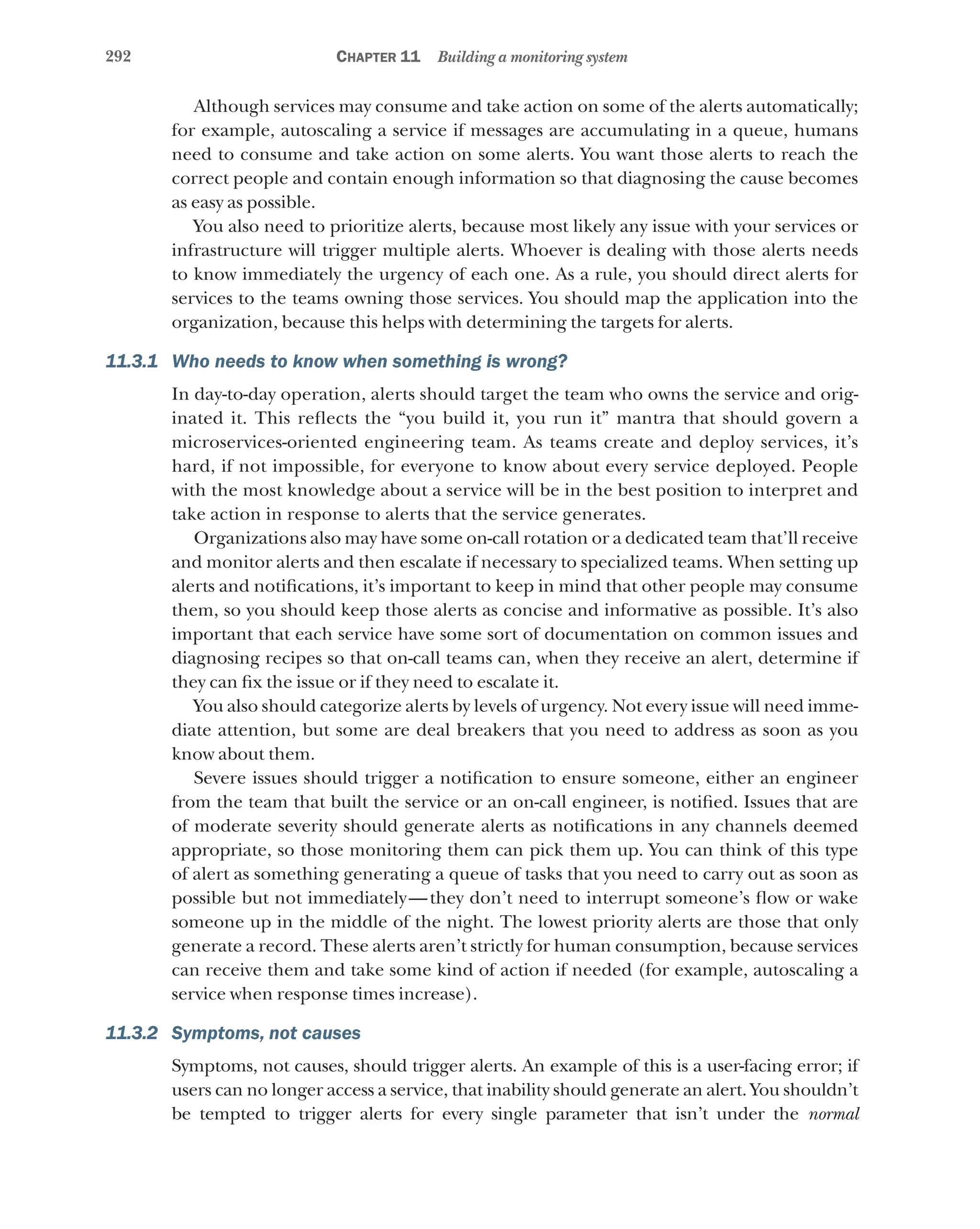
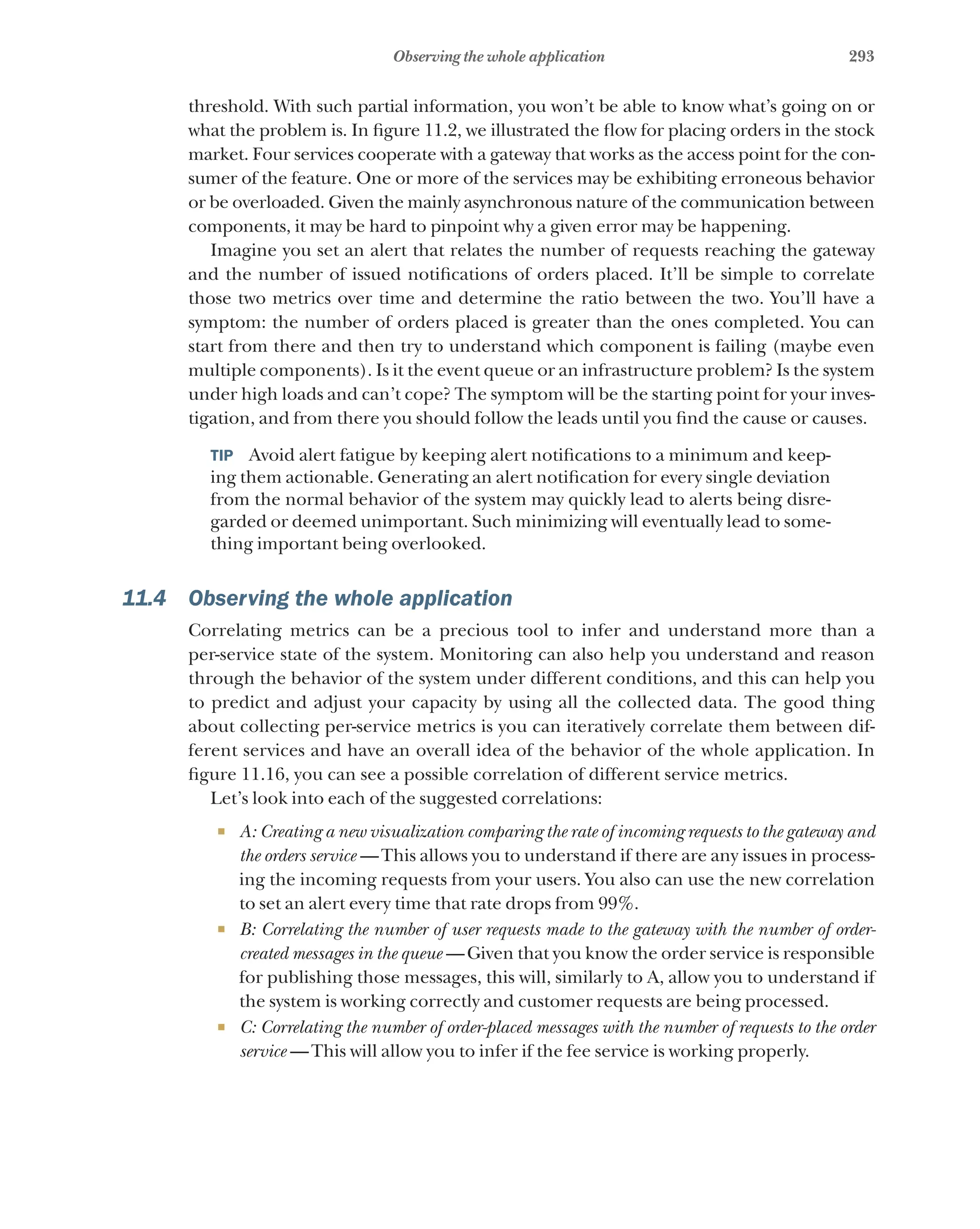

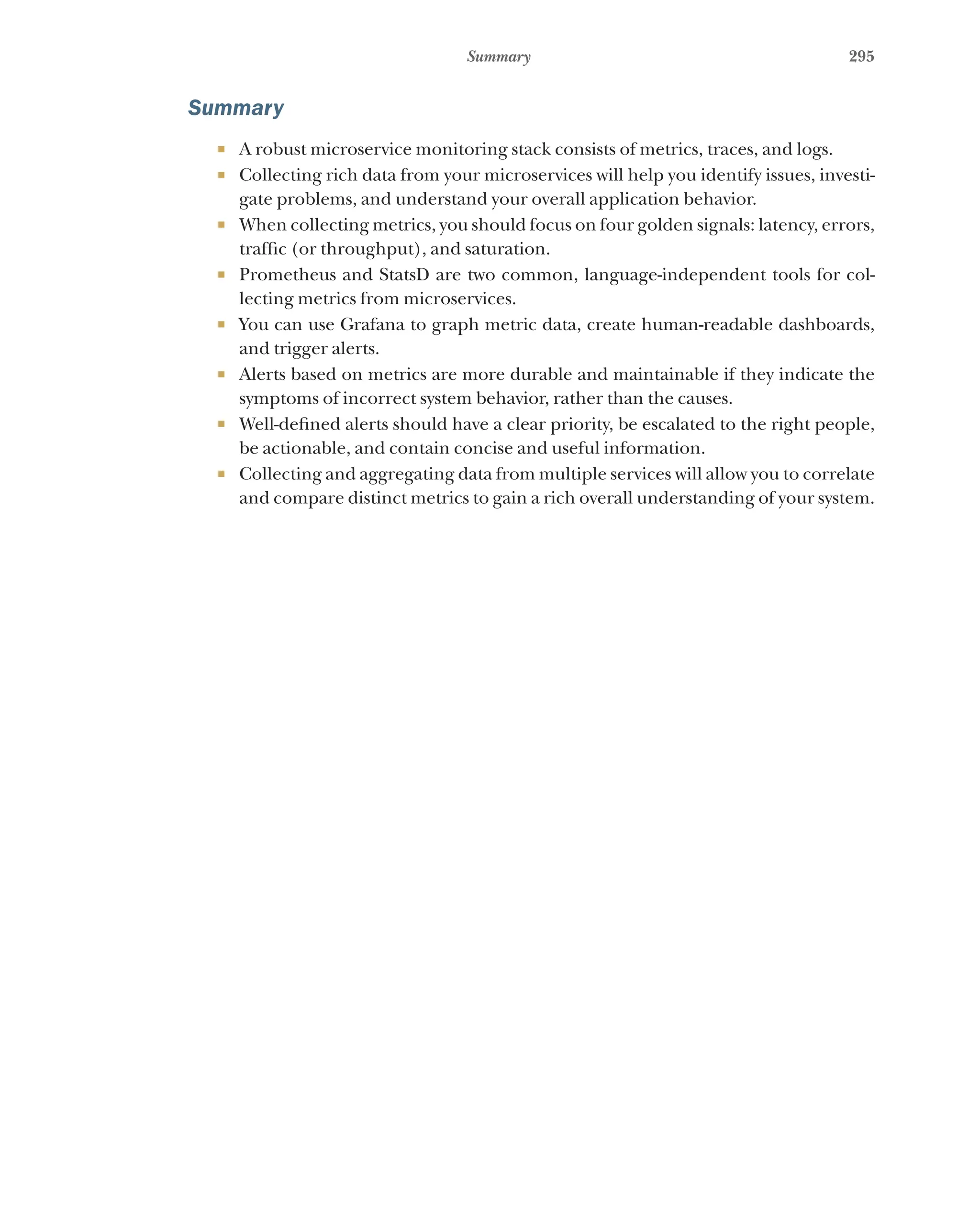
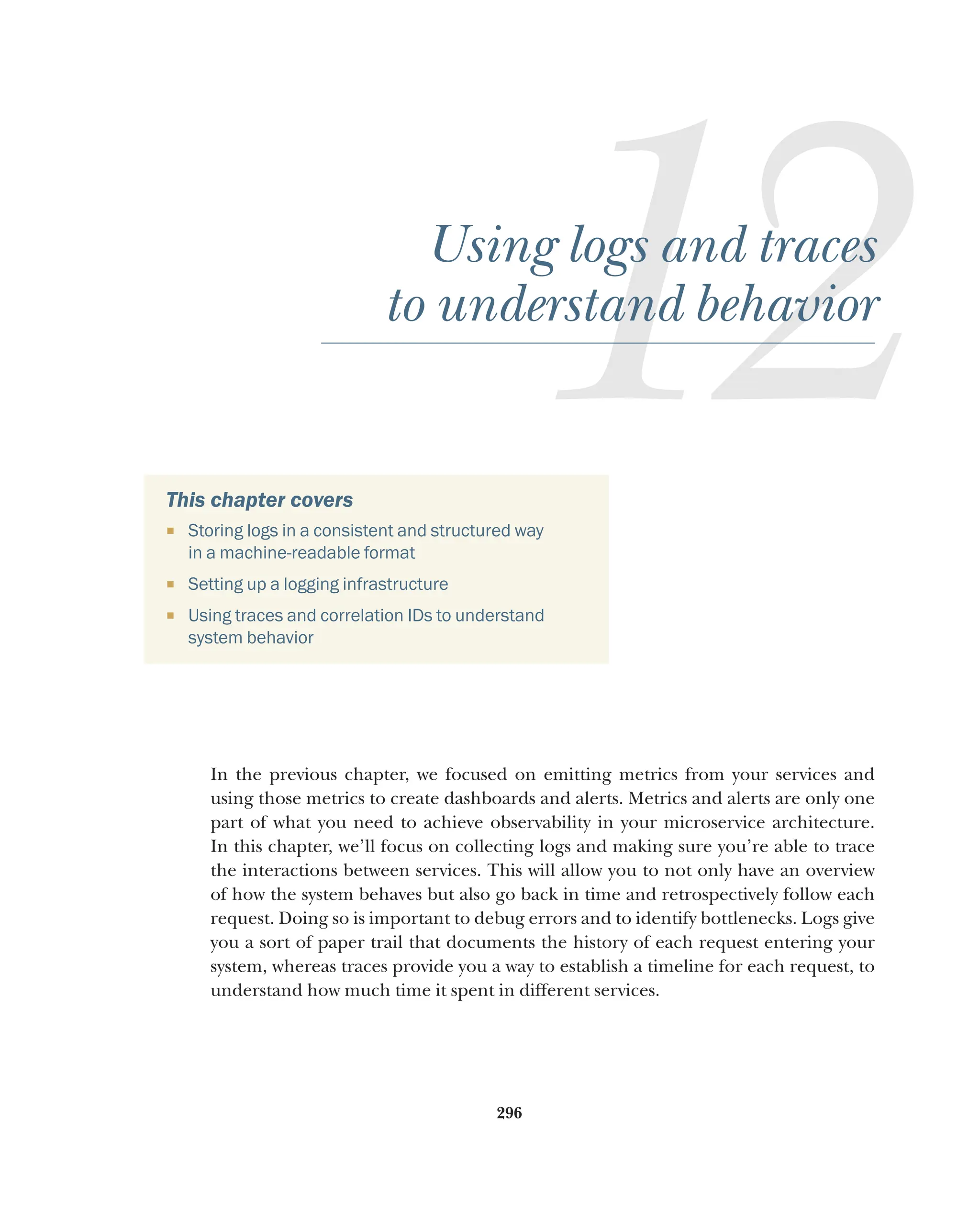



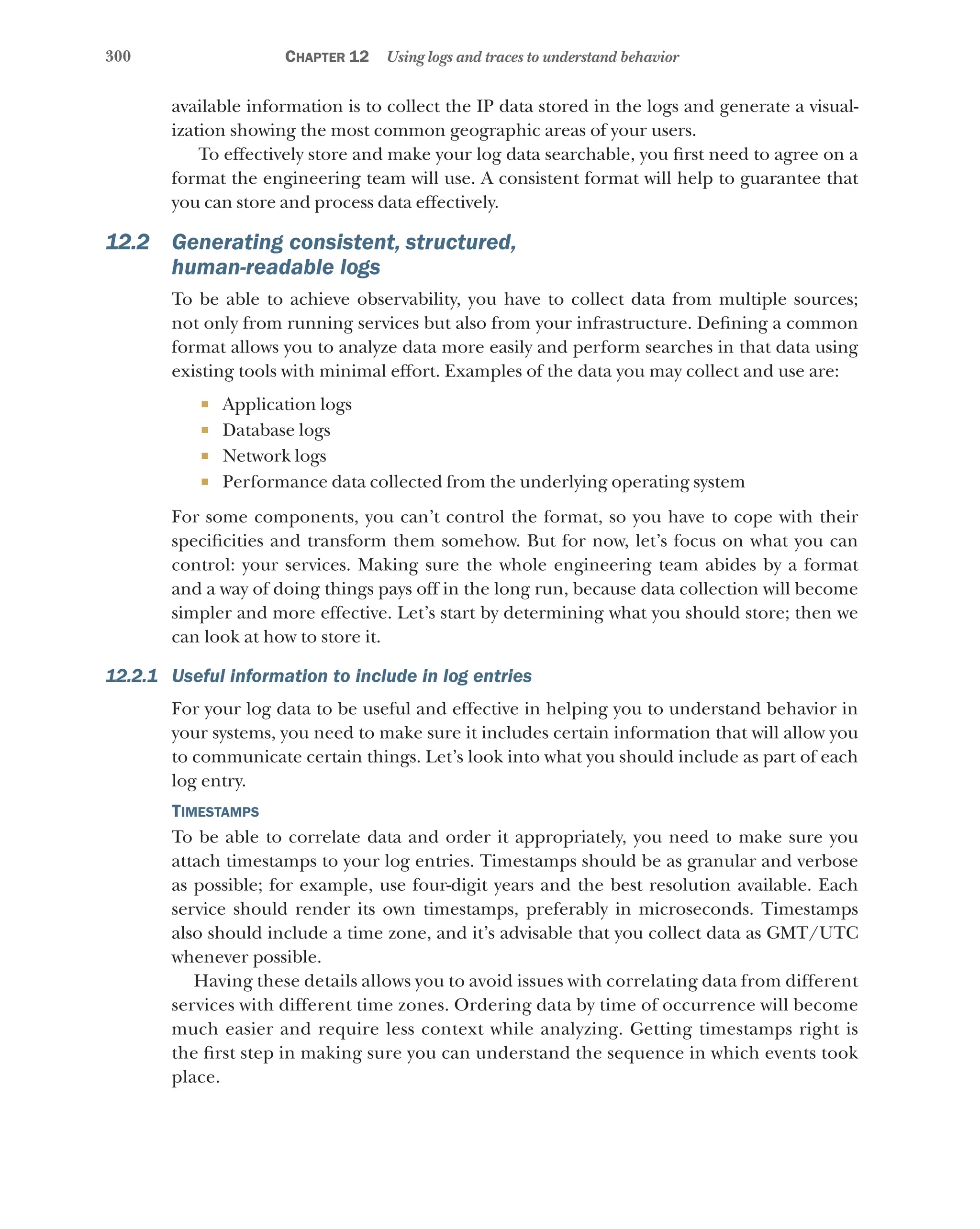
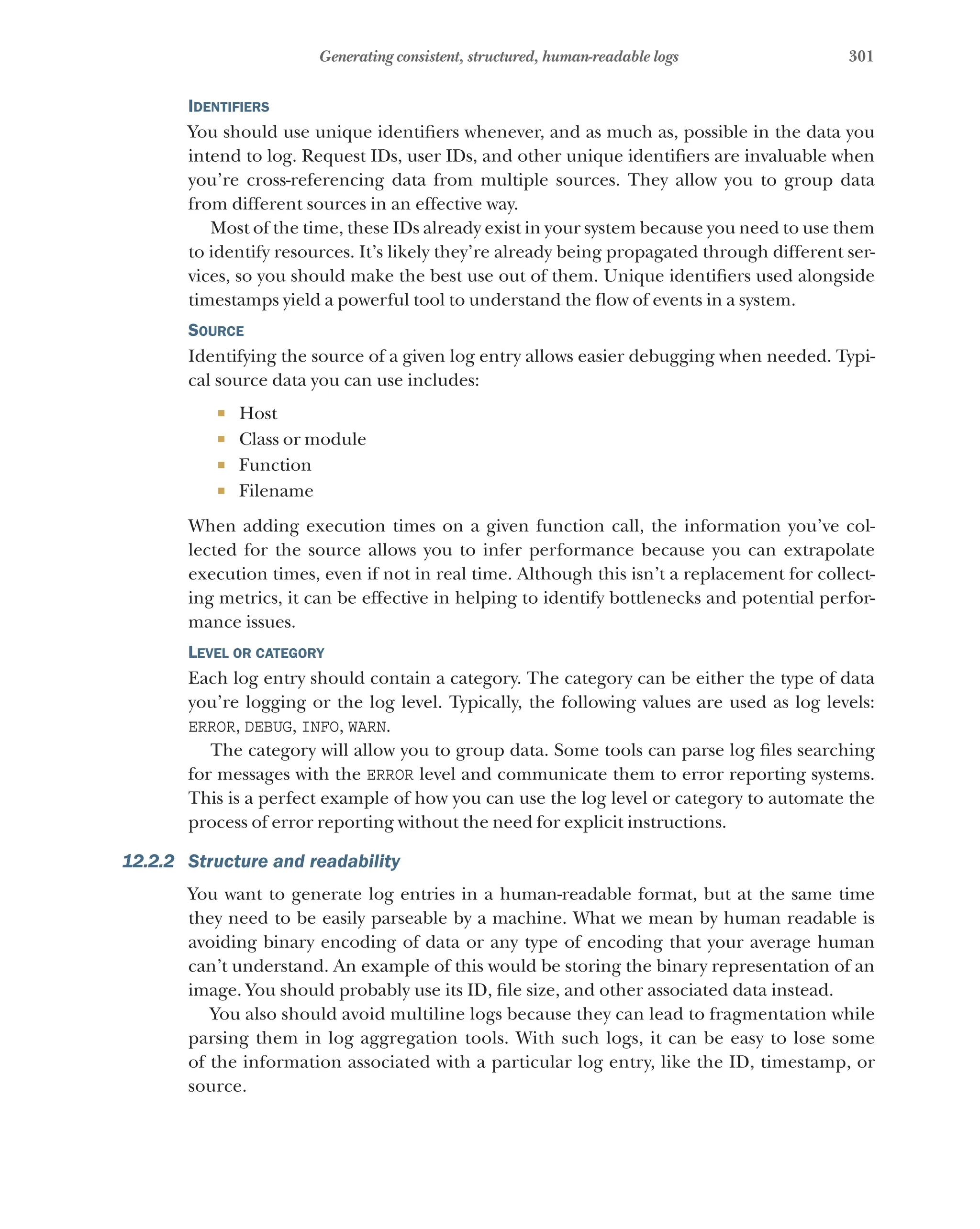
![302 Chapter 12 Using logs and traces to understand behavior
For the examples in this chapter, you’ll be using JSON to encode your log entries.
Doing so allows you to provide human-readable and machine-parseable data, as well as
to automatically include some of the data we mentioned in the previous section.
In chapter 7, when we were discussing a microservice chassis, we introduced a Python
library that provides log formatting: logstash-formatter. Logstash libraries are avail-
able for different languages, so you can expect the format to be widespread and easily
usable no matter what language you chose to code your services in.
Logstash
Logstash is a tool to collect, process, and forward events and log messages from multiple
sources. It provides multiple plugins to configure data collecting.
We’re interested in the formatting conventions of Logstash, and you’ll be using its V1 for-
mat specification in your SimpleBank services.
Let’s now look into a log entry collected using the Logstash library for Python. This mes-
sage is formatted using V1 of the logstash format, and the application generated it auto-
matically when it was booting, without the need for any specific code instruction to log it:
{
"source_host" : "e7003378928a",
"pathname" : "usrlocallibpython3.6site-packagesnamekorunners.py",
➥"relativeCreated" : 386.46125793457031,
"levelno" : 20,
"msecs" : 118.99447441101074,
"process" : 1,
"args" : [ "orders_service" ],
"name" : "nameko.runners",
"filename" : "runners.py",
"funcName" : "start",
"module" : "runners",
"lineno" : 64,
"@timestamp" : "2018-02-02T18:42:09.119Z",
"@version" : 1,
"message" : "starting services: orders_service",
"levelname" : "INFO",
"stack_info" : null,
"thread" : 140612517945416,
"processName" : "MainProcess",
"threadName" : "MainThread",
"msg" : "starting services: %s",
"created" : 1520275329.1189945
}
Information about the source: the host
running the application
Time taken to process the action
Filename, function, module, and line
number emitting the log
Timestamp, with Z indicating
the UTC time zone
Version of the formatter (logstash-formatter v1)
Message indicating the
starting of the server
Log level or category, in this case the INFO level](https://image.slidesharecdn.com/microservicesinaction-240113230140-1bc300cc/75/microservices-in-action-pdf-329-2048.jpg)
![303
Setting up a logging infrastructure for SimpleBank
As you can see, the Logstash library inserts relevant information, taking that burden
from the developer’s shoulders. In the following listing, you’ll see how an explicit log
call in code renders a log entry.
Listing 12.1 Logstash V1 formatted log message after an explicit log instruction
# Python code for generating a log entry
self.logger.info ({"message": "Placing sell order",
➥"uuid": res})
{
"@timestamp": "2018-02-02T18:43:08.221Z",
"@version": 1,
"source_host": "b0c90723c58f",
"name": "root",
"args": [],
"levelname": "INFO",
"levelno": 20,
"pathname": "./app.py",
"filename": "app.py",
"module": "app",
"stack_info": null,
"lineno": 33,
"funcName": "sell_shares",
"created": 1520333830.3000789,
"msecs": 300.0788688659668,
"relativeCreated": 15495.944738388062,
"thread": 140456577504064,
"threadName": "GreenThread-2",
"processName": "MainProcess",
"process": 1,
"message": "Placing sell order",
"uuid": "a95d17ac-f2b5-4f2c-8e8e-2a3f07c68cf2"
}
In your explicit call to the logger, you’ve only stated the desired level and the message
to log in the form of key-value pairs containing a message and a UUID. Logstash auto-
matically collected and added all the other information present in the log entry with-
out you having to declare it explicitly.
12.3 Setting up a logging infrastructure for SimpleBank
Now that you’ve set a format for collecting and presenting info, you can move on to
creating a basic logging infrastructure. In this section, you’ll be setting up the infra-
structure that’ll allow you to collect logs from all the running services and aggregate
them. It also will provide you with search and correlation capabilities. The purpose is to
have a central access point to all the log data like you already have for metrics. In figure
12.4, we illustrate what you want to achieve after setting up a logging infrastructure.
The log level, the message
field, and the uuid field
The log level determined by the call made
to the logger module, in this case, INFO
The message field
The uuid field, which identifies
and potentially allows correlation
between this log entry and
another in different services](https://image.slidesharecdn.com/microservicesinaction-240113230140-1bc300cc/75/microservices-in-action-pdf-330-2048.jpg)
![304 Chapter 12 Using logs and traces to understand behavior
Order
service
Gateway
2018-02-04T13:55:19.263380548Z {"@timestamp":
"2018-02-04T13:55:19.262Z", "@version": 1,
"source_host": "bb69db21f1eb", "name": "root", "args": [],
"levelname": "INFO", "levelno": 20, "pathname": "./app.py",
"filename": "app.py", "module": "app", "stack_info": null,
"lineno": 33, "funcName": "sell_shares", "created":
1520171719.26152, "msecs": 261.5199089050293,
"relativeCreated": 669360.3167533875, "thread":
140130358674856, "threadName": "GreenTread-13",
"processName": "MainProcess", "process": 1, "message":
"{'event': 'sell_order_received', 'uuid':
'11fcdc94-c055-4f26-988b-886165655792'}", "event":
"sell_order_received", "uuid":
"11fcdc94-c055-4f26-988b-886165655792"}
2018-02-04T13:55:20.839781524Z {"@timestamp":
"2018-02-04T13:55:20.838Z", "@version": 1,
"source_host": "e7003378928a", "name": "root", "args": [],
"levelname": "INFO", "levelno": 20, "pathname": "./app.py",
"filename": "app.py", "module": "app", "stack_info": null,
"lineno": 45, "funcName": "__create_event", "created":
1520275337.8386793, "msecs": 838.679313659668,
"relativeCreated": 669360.3167533875, "thread":
140612448880184, "threadName": "GreenTread-2",
"processName": "MainProcess", "process": 1, "message":
"{'event': 'order_created', 'uuid':
'11fcdc94-c055-4f26-988b-886165655792'}", "event":
"order_created", "uuid":
"11fcdc94-c055-4f26-988b-886165655792"}
Logs
Logs
Metrics
Metrics
Order service dashboard
Response times
# Status codes
# Requests
Gateway dashboard
Metrics dashboard Centralized logging
Response times
# Status codes
# Requests
Figure 12.4 Services making use of centralized metrics and a centralized log for easy access to data
Once you set up the log aggregation capability, like you did for metrics in chapter 11,
you’ll have all services sending both metrics and logs to centralized systems that’ll allow
you to improve observability. You’ll be able to observe data about a running system and
dig deeper to collect more information in case you need to audit or debug a particular
request. You’ll set up a solution commonly called ELK (Elasticsearch, Logstash, and
Kibana) and will use a data collector called Fluentd.
12.3.1 ELK- and Fluentd-based solution
You’ll build the logging infrastructure we propose using Elasticsearch, Logstash, and
Kibana. Also, you’ll use Fluentd for pushing logs from the apps to your centralized log-
ging solution. Before we get into more details about these technologies, have a look at
figure 12.5 to get an overview of what we want to enable you to achieve.
In figure 12.5, you can see how you can collect the logs for multiple instances of the
gateway service and forward them to your centralized logging system. We represent
multiple instances of the same service, but this will work for any of the services you have
running. Services will redirect all the log information to STDOUT (standard output), and
an agent running the Fluentd daemon will be responsible for pushing those logs into
Elasticsearch.](https://image.slidesharecdn.com/microservicesinaction-240113230140-1bc300cc/75/microservices-in-action-pdf-331-2048.jpg)
![305
Setting up a logging infrastructure for SimpleBank
2018-02-04T13:55:19.263380548Z {"@timestamp":
"2018-02-04T13:55:19.262Z", "@version": 1,
"source_host": "bb69db21f1eb", "name": "root", "args": [],
"levelname": "INFO", "levelno": 20, "pathname": "./app.py",
"filename": "app.py", "module": "app", "stack_info": null,
"lineno": 33, "funcName": "sell_shares", "created":
1520171719.26152, "msecs": 261.5199089050293,
"relativeCreated": 669360.3167533875, "thread":
140130358674856, "threadName": "GreenTread-13",
"processName": "MainProcess", "process": 1, "message":
"{'event': 'sell_order_received', 'uuid':
'11fcdc94-c055-4f26-988b-886165655792'}", "event":
"sell_order_received", "uuid":
"11fcdc94-c055-4f26-988b-886165655792"}
2018-02-04T13:55:19.263380548Z {"@timestamp":
"2018-02-04T13:55:19.262Z", "@version": 1,
"source_host": "bb69db21f1eb", "name": "root", "args": [],
"levelname": "INFO", "levelno": 20, "pathname": "./app.py",
"filename": "app.py", "module": "app", "stack_info": null,
"lineno": 33, "funcName": "sell_shares", "created":
1520171719.26152, "msecs": 261.5199089050293,
"relativeCreated": 669360.3167533875, "thread":
140130358674856, "threadName": "GreenTread-13",
"processName": "MainProcess", "process": 1, "message":
"{'event': 'sell_order_received', 'uuid':
'11fcdc94-c055-4f26-988b-886165655792'}", "event":
"sell_order_received", "uuid":
"11fcdc94-c055-4f26-988b-886165655792"}
Gateway
2018-02-04T13:55:19.263380548Z {"@timestamp":
"2018-02-04T13:55:19.262Z", "@version": 1,
"source_host": "bb69db21f1eb", "name": "root", "args": [],
"levelname": "INFO", "levelno": 20, "pathname": "./app.py",
"filename": "app.py", "module": "app", "stack_info": null,
"lineno": 33, "funcName": "sell_shares", "created":
1520171719.26152, "msecs": 261.5199089050293,
"relativeCreated": 669360.3167533875, "thread":
140130358674856, "threadName": "GreenTread-13",
"processName": "MainProcess", "process": 1, "message":
"{'event': 'sell_order_received', 'uuid':
'11fcdc94-c055-4f26-988b-886165655792'}", "event":
"sell_order_received", "uuid":
"11fcdc94-c055-4f26-988b-886165655792"}
Logs
Gateway
Logs
Gateway
Logs
Centralized logging
STDOUT
STDOUT Fluentd
STDOUT
Gateway service deployed in Kubernetes
Figure 12.5 Collecting logs from multiple service instances and forwarding them to a centralized location
By following this pattern when deploying any new services, you’ll make sure log data
gets collected and indexed and becomes searchable. But before we move to imple-
mentation, we’ll take a little time to introduce each of the technologies you’ll be
using.
Elasticsearch
Elasticsearch (www.elastic.co/products/elasticsearch) is a search and analytics engine
that stores data centrally. It indexes data, in your case log data, and allows you to per-
form efficient search and aggregation operations on the data it has stored.
Logstash
Logstash (www.elastic.co/products/logstash) is a server-side processing pipeline that
allows data ingestion from multiple sources and transforms that data prior to send-
ing it to Elasticsearch. In your case, you’ll be using the Logstash formatting and data
collection capabilities by taking advantage of client libraries. In this chapter’s earlier
examples, you already observed its ability to provide consistent data that you can send
to Elasticsearch. But here you won’t be using Logstash to send data; you’ll be using
Fluentd instead.
Kibana
Kibana (www.elastic.co/products/kibana) is a UI for visualizing Elasticsearch data. It’s
a tool you can use to query data and explore its associations. In your use case, it’ll
operate on log data. You can use Kibana to derive visualizations from gathered data, so
it’s more than a search tool. Figure 12.6 shows an example of a dashboard powered by
Kibana.](https://image.slidesharecdn.com/microservicesinaction-240113230140-1bc300cc/75/microservices-in-action-pdf-332-2048.jpg)
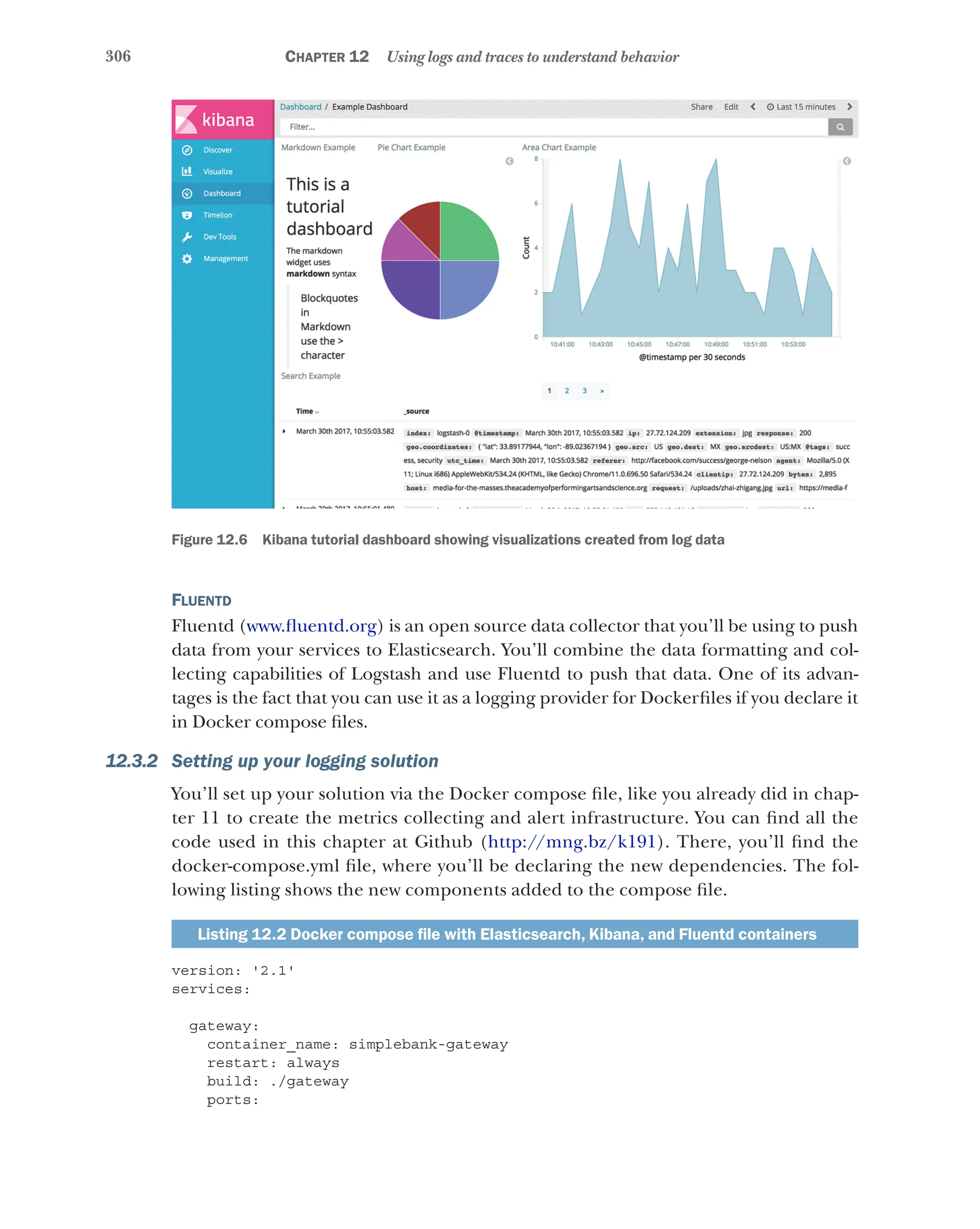
![307
Setting up a logging infrastructure for SimpleBank
- 5001:5000
volumes:
- ./gateway:/usr/src/app
links:
- "rabbitmq:simplebank-rabbitmq"
- "fluentd”
logging:
driver: "fluentd"
options:
fluentd-address: localhost:24224
tag: simplebank.gateway
(…)
kibana:
image: kibana
links:
- "elasticsearch"
ports:
- "5601:5601"
elasticsearch:
image: elasticsearch
expose:
- 9200
ports:
- "9200:9200"
fluentd:
build: ./fluentd
volumes:
- ./fluentd/conf:/fluentd/etc
links:
- "elasticsearch"
ports:
- "24224:24224"
- "24224:24224/udp"
(…)
Once you’ve added this content to the docker compose file, you’re almost ready to
boot your logging infrastructure alongside your services. But first let’s cover the miss-
ing tweaks we mentioned previously that’ll allow you to configure Fluentd to your
needs. The Dockerfile you use for building Fluentd follows.
Listing 12.3 Fluentd Dockerfile (Fluentd/Dockerfile)
FROM fluent/fluentd:v0.12-debian
RUN ["gem", "install", "fluent-plugin-elasticsearch",
➥"--no-rdoc", "--no-ri", "--version", "1.9.2"]
Now all you need is to create a configuration file for Fluentd. The following listing
shows the config file.
Adds a logging directive to each service to
force Docker to push the output of each
container running a service to Fluentd,
which in turn will make sure data gets
pushed to Elasticsearch
For Kibana, uses the default image in
Docker Hub with the defaults set
Links Kibana to the Elasticsearch container,
because it’ll consume data from it
Like you did for Kibana, uses the default
image for Elasticsearch
Builds Fluentd from a custom Docker image
Injects the configuration for Fluentd into
the built container, allowing you to
tweak the default configuration
Links the Fluentd container to the Elasticsearch
container, because it’ll be pushing data into it
Pulls the Fluentd base image
Installs the Elasticsearch
plugin for Fluentd](https://image.slidesharecdn.com/microservicesinaction-240113230140-1bc300cc/75/microservices-in-action-pdf-334-2048.jpg)
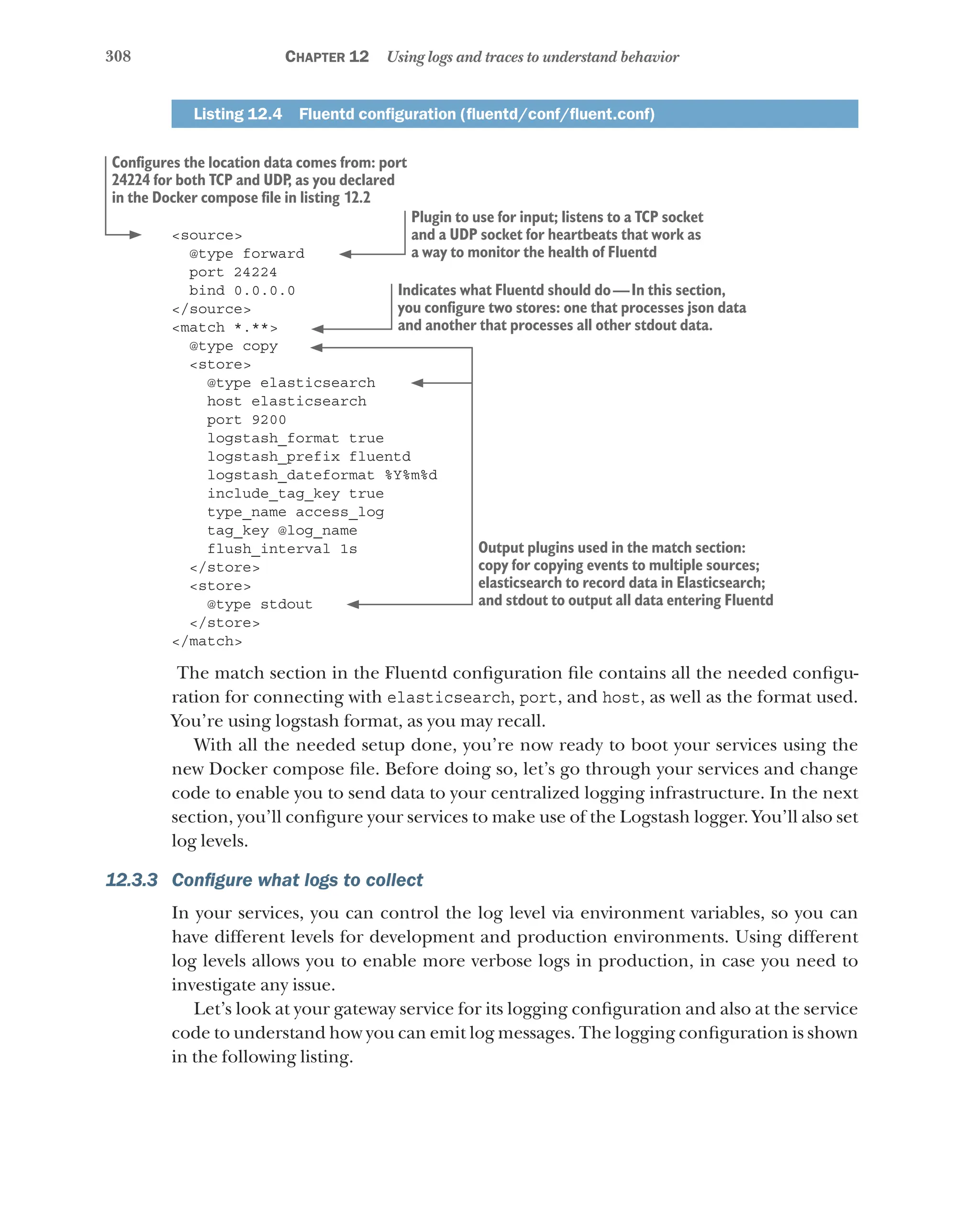
![309
Setting up a logging infrastructure for SimpleBank
Listing 12.5 Configuration file for the gateway service (gateway/config.yml)
AMQP_URI: amqp://${RABBIT_USER:guest}:${RABBIT_PASSWORD:guest}@${RABBIT_HOST:
➥localhost}:${RABBIT_PORT:5672}/
WEB_SERVER_ADDRESS: '0.0.0.0:5000'
RPC_EXCHANGE: 'simplebank-rpc'
LOGGING:
version: 1
handlers:
console:
class: logging.StreamHandler
root:
level: ${LOG_LEVEL:INFO}
handlers: [console]
This configuration will allow setting the log level when the application boots. In the
Docker compose file, you’ve set the environment variable LOG_LEVEL as INFO for all ser-
vices except for the Gateway, which has a DEBUG value. Let’s now look into the gateway
code to set up logging, as shown in the following listing.
Listing 12.6 Enable logging in the gateway service (gateway/app.py)
import datetime
import json
import logging
import uuid
from logstash_formatter import LogstashFormatterV1
from nameko.rpc import RpcProxy, rpc
from nameko.web.handlers import http
from statsd import StatsClient
from werkzeug.wrappers import Request, Response
class Gateway:
name = "gateway"
orders = RpcProxy("orders_service")
statsd = StatsClient('statsd', 8125,
prefix='simplebank-demo.gateway')
logger = logging.getLogger()
handler = logging.StreamHandler()
formatter = LogstashFormatterV1()
handler.setFormatter(formatter)
logger.addHandler(handler)
@http('POST', '/shares/sell')
@statsd.timer('sell_shares')
Logging configuration section
Defines the handler class for console logging,
which you’ll use as the handler in listing 12.6
Reads the log level from an environment variable
(LOG_LEVEL) and sets a default value of INFO in
case the environment variable isn’t defined
Registers only a `console` handler, because
you won’t be reading from log files
Imports Python’s logging facility (https://docs.python.org/3/
library/logging.html)
Imports the Logstash
Formatter so you can emit
logs in logstash format
Initializes and configures logger](https://image.slidesharecdn.com/microservicesinaction-240113230140-1bc300cc/75/microservices-in-action-pdf-336-2048.jpg)
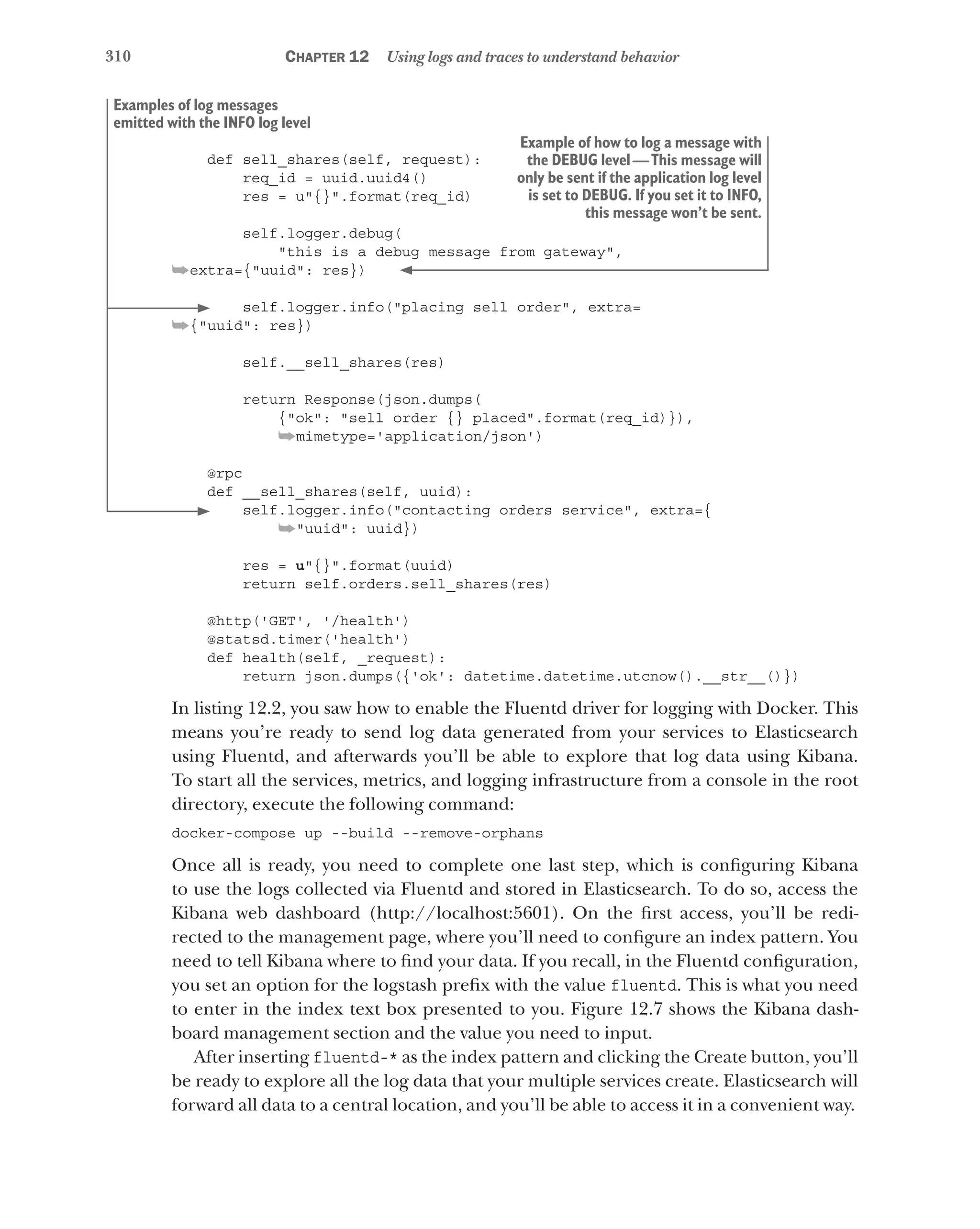


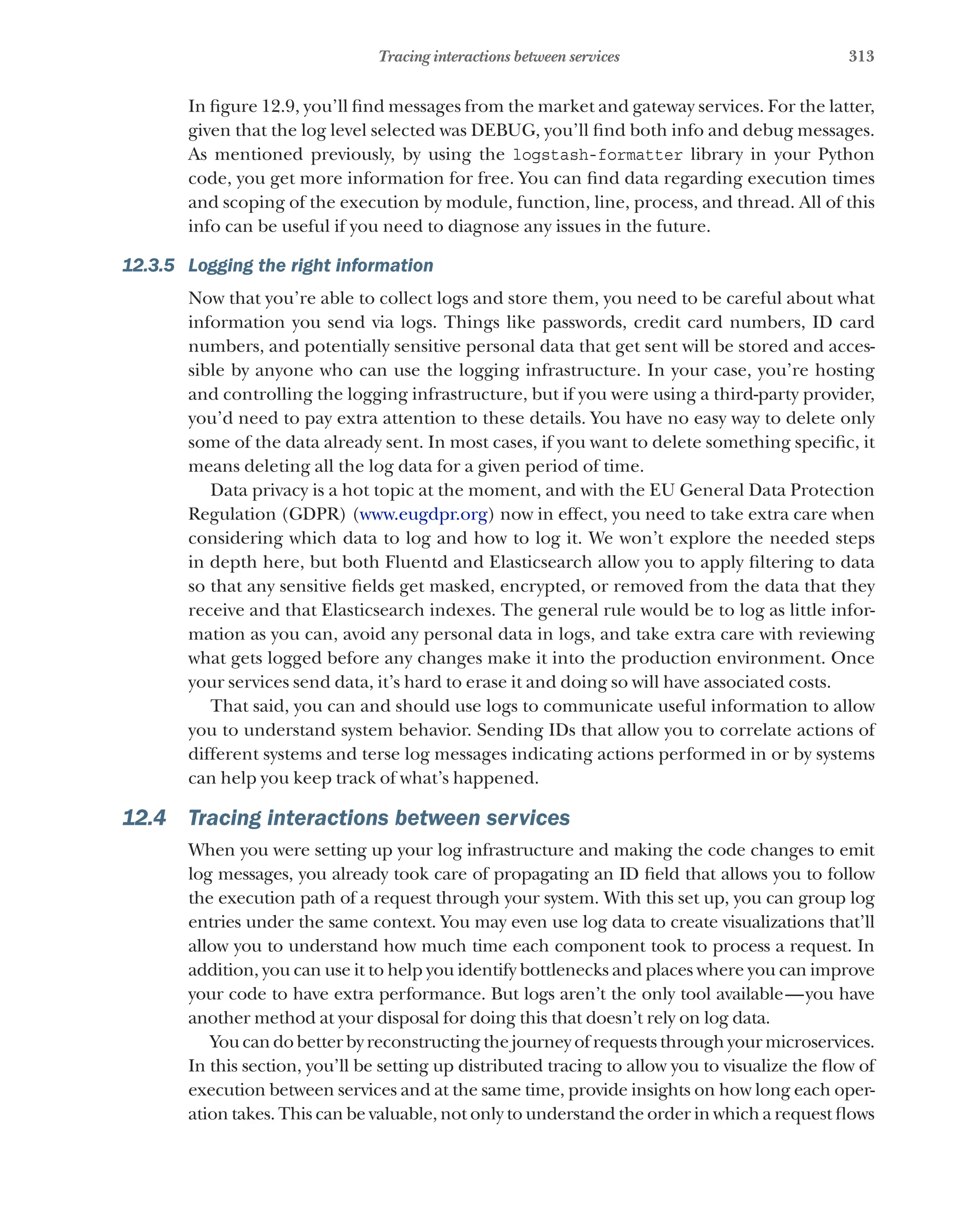
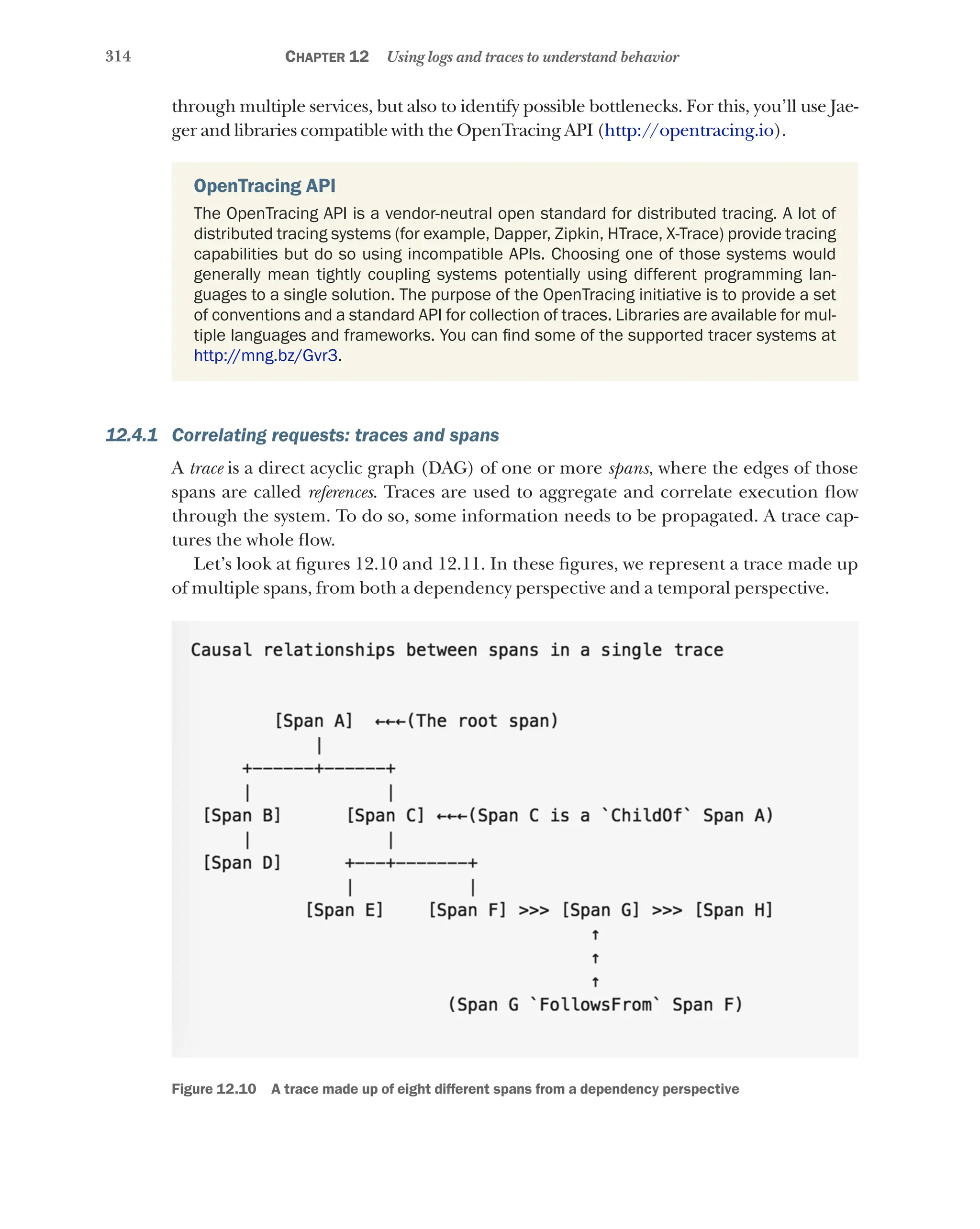
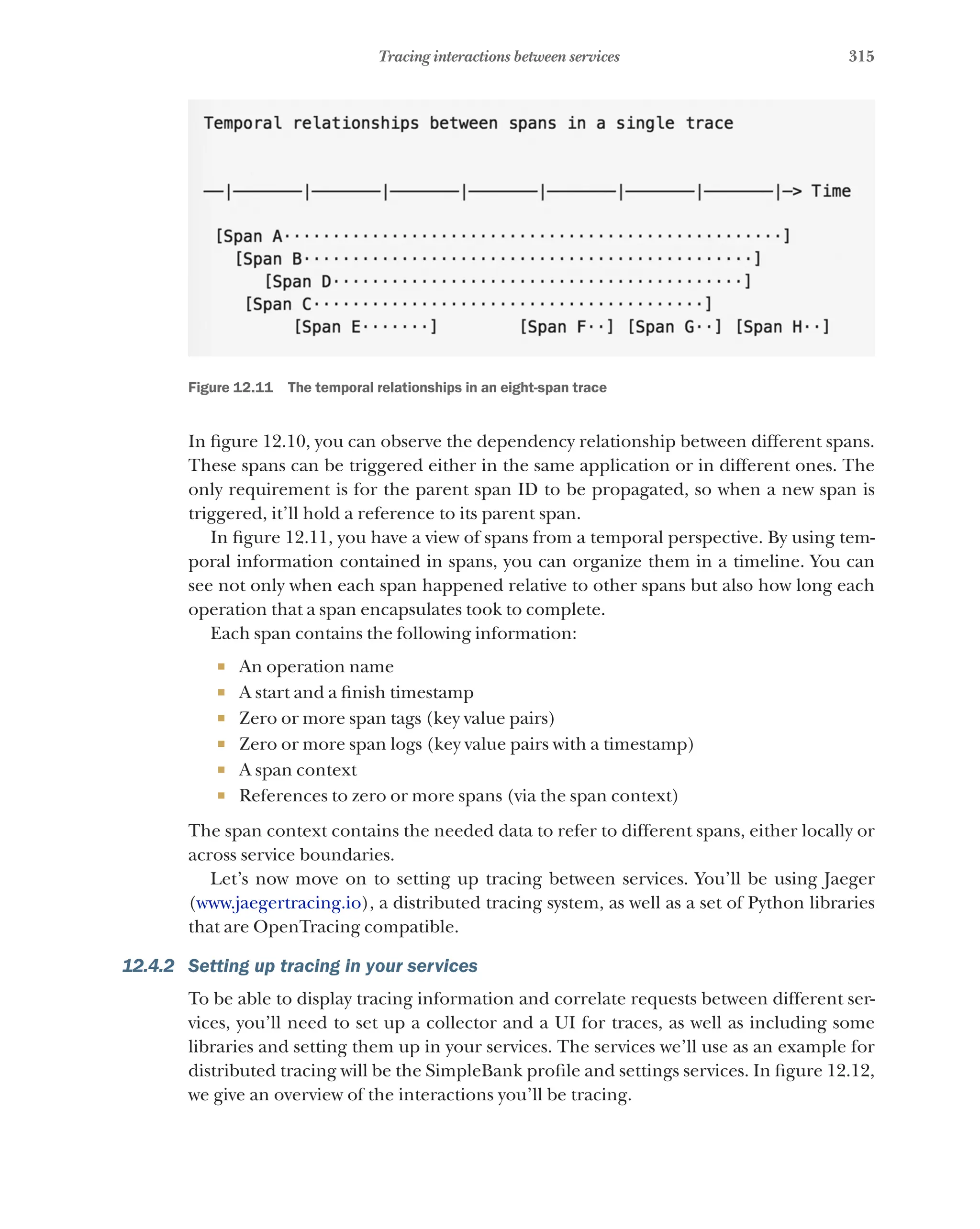
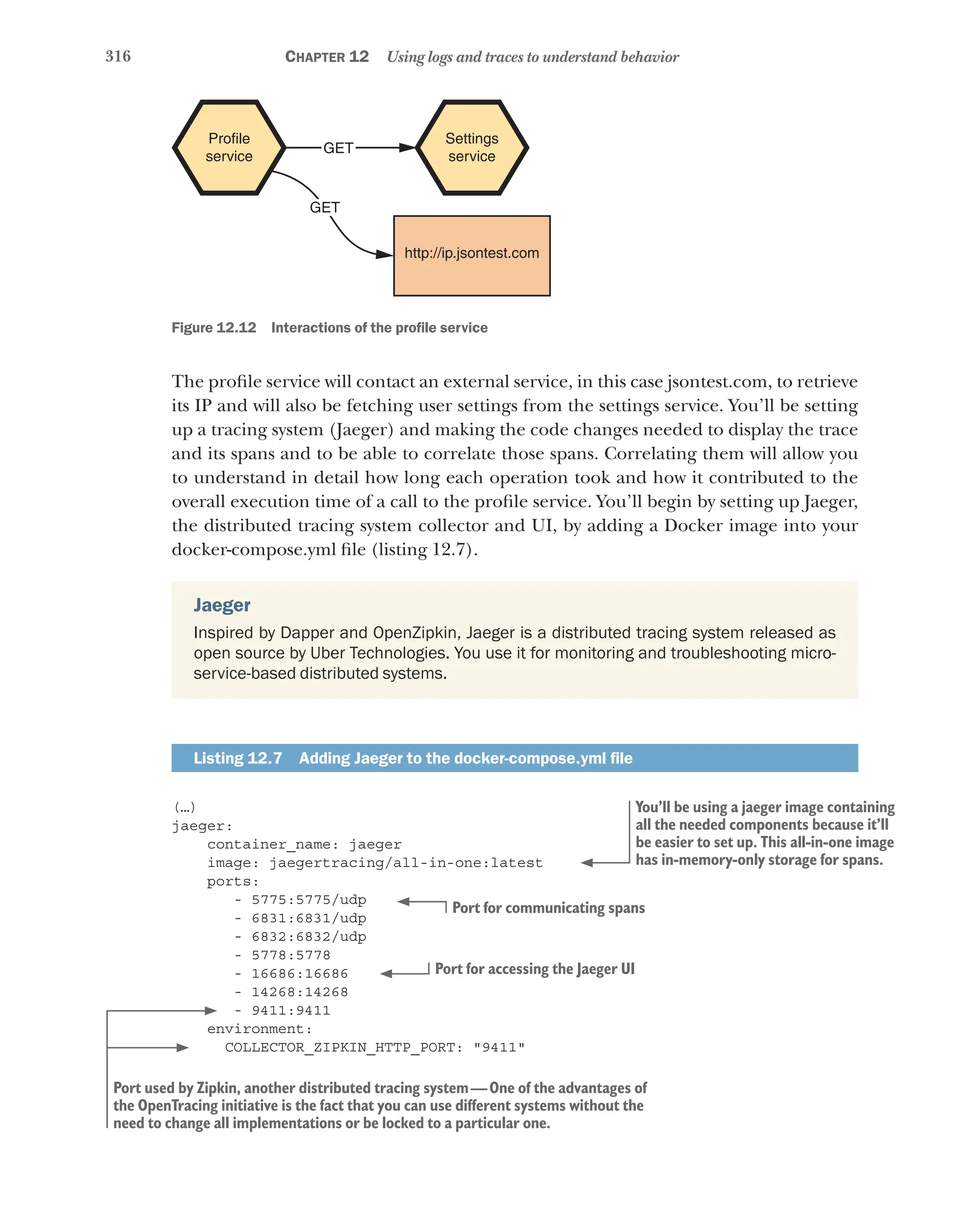
![317
Tracing interactions between services
With the Docker image added to your docker-compose file, once you boot all the
SimpleBank infrastructure, you’ll have a distributed tracing system in place. Now you
need to make sure that the SimpleBank profile and settings services are able to create
traces and spans and communicate them to Jaeger.
Let’s add the needed libraries to both the settings and profile services and initialize
the tracer. The following listing adds the tracing libraries.
Listing 12.8 Adding the tracing libraries to the services via a requirements.txt file
Flask==0.12.0
requests==2.18.4
jaeger-client==3.7.1
opentracing>=1.2,<2
opentracing_instrumentation>=2.2,<3
By adding these libraries, you’re now able to create traces and spans from both ser-
vices. To make the process easier, you can also create a module to provide a convenient
setup function to initialize the tracer, as shown in the following listing.
Listing 12.9 Tracer initializer lib/tracing.py
import logging
from jaeger_client import Config
def init_tracer(service):
logging.getLogger('').handlers = []
logging.basicConfig(format='%(message)s', level=logging.DEBUG)
config = Config(
config={
'sampler': {
'type': 'const',
'param': 1,
},
'local_agent': {
'reporting_host': "jaeger",
'reporting_port': 5775,
},
'logging': True,
'reporter_batch_size': 1,
},
service_name=service,
)
return config.initialize_tracer()
Jaeger client library that connects the
service to the tracer system
Python OpenTracing platform library
Collection of instrumentation tools to simplify integration
with different frameworks and applications
Imports the Jaeger client that allows
establishing communication between
the app and the tracing collector system
Receives the service name as an argument
Sets up both the host and the port where
traces and spans will be sent—In the
Docker compose file, you have Jaeger
running as “jaeger” and receiving
metrics via UDP on port 5775. This is
necessary because you’ll have one
collector agent running for all services.
In addition to collecting metrics in Jaeger, you’re
also emitting the trace events to the logs.
Sets the service name to the one
received as the init function argument](https://image.slidesharecdn.com/microservicesinaction-240113230140-1bc300cc/75/microservices-in-action-pdf-344-2048.jpg)
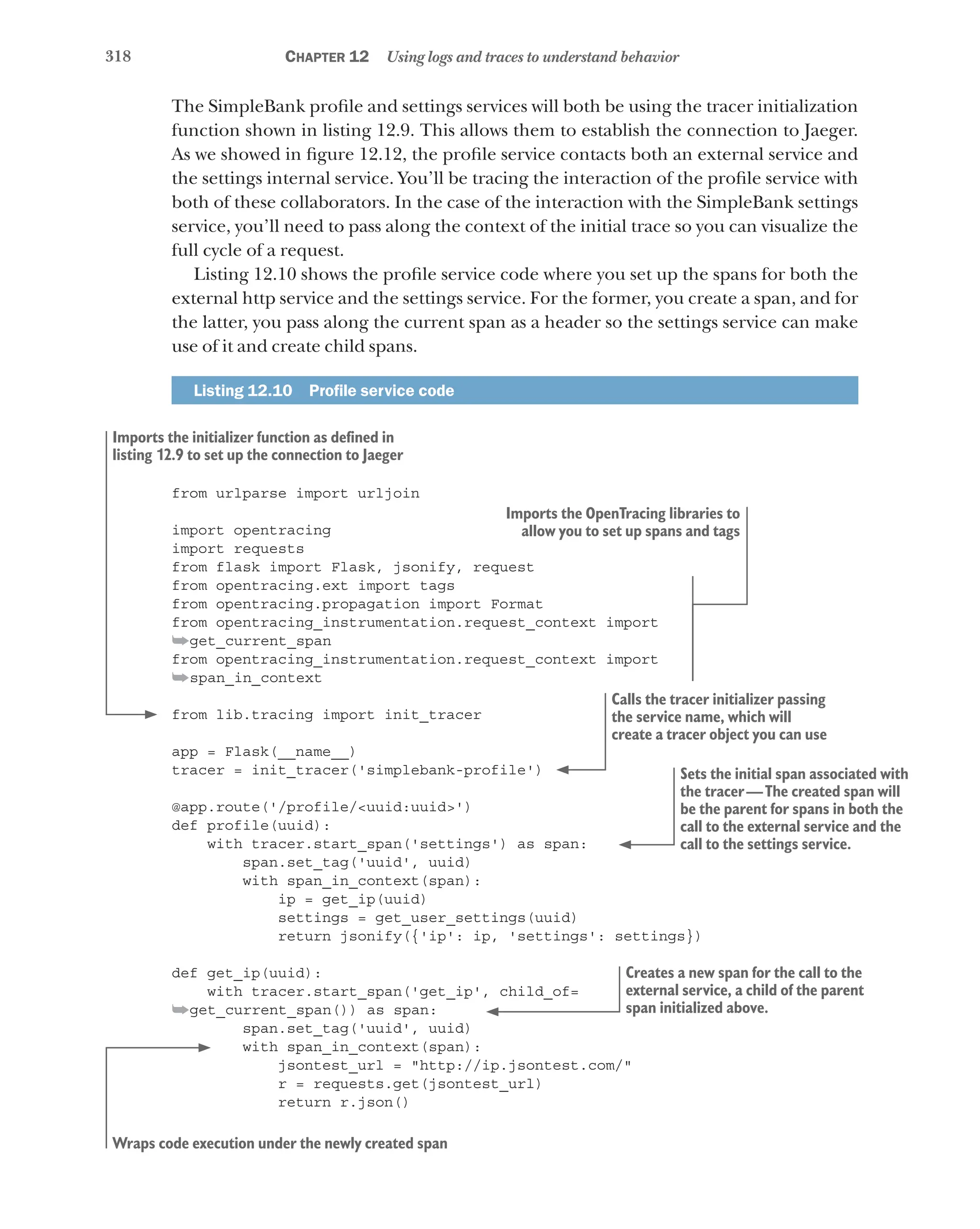
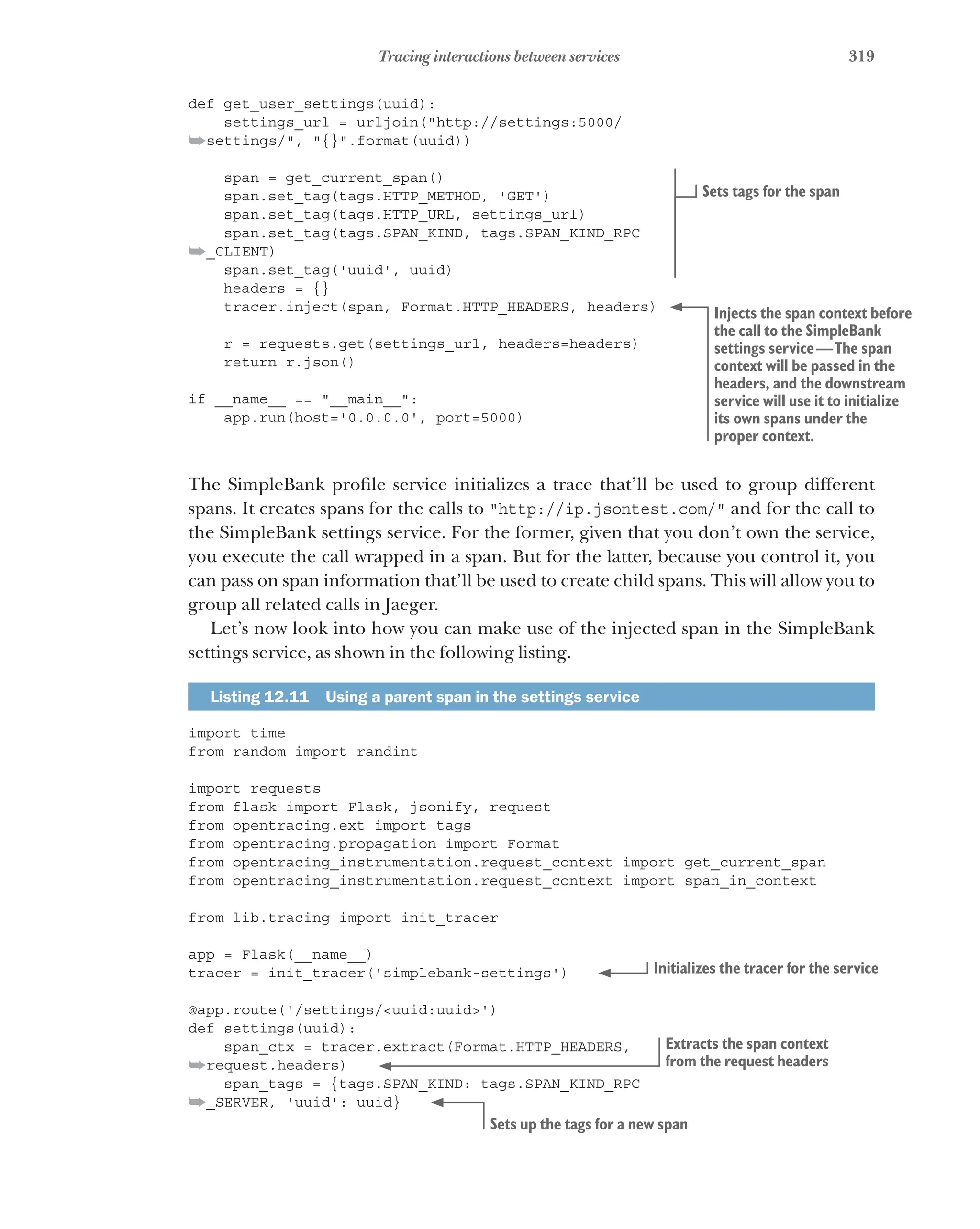
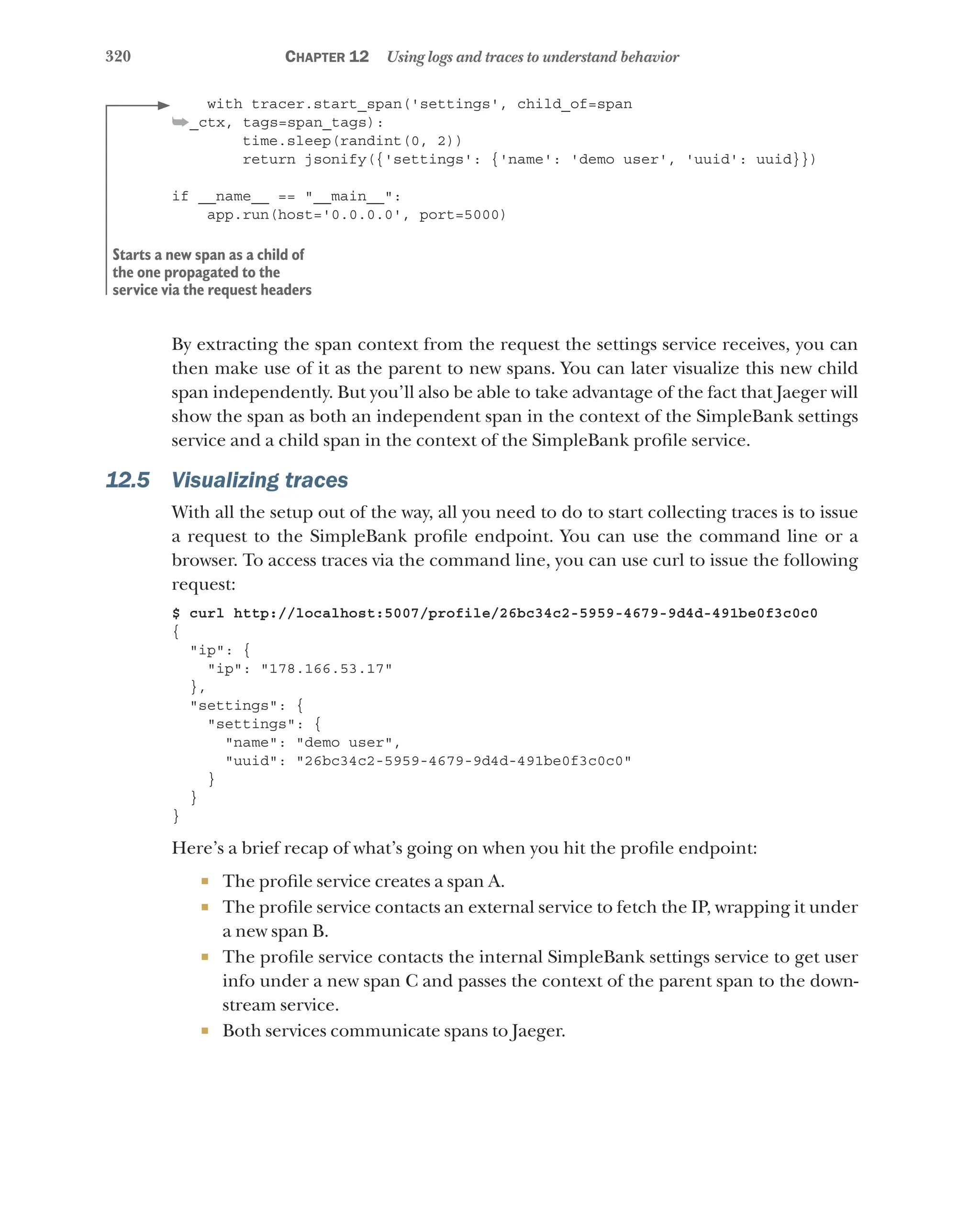



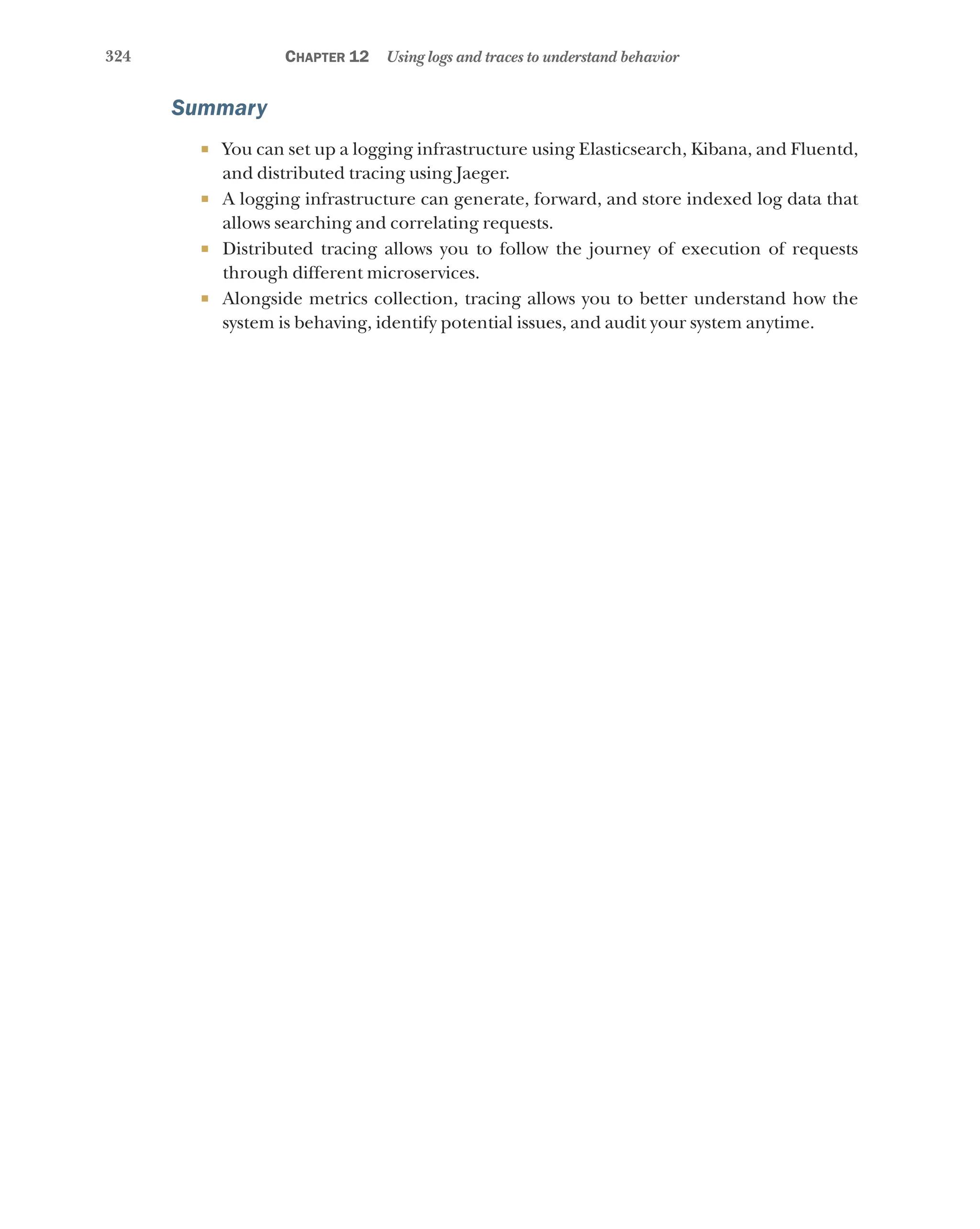
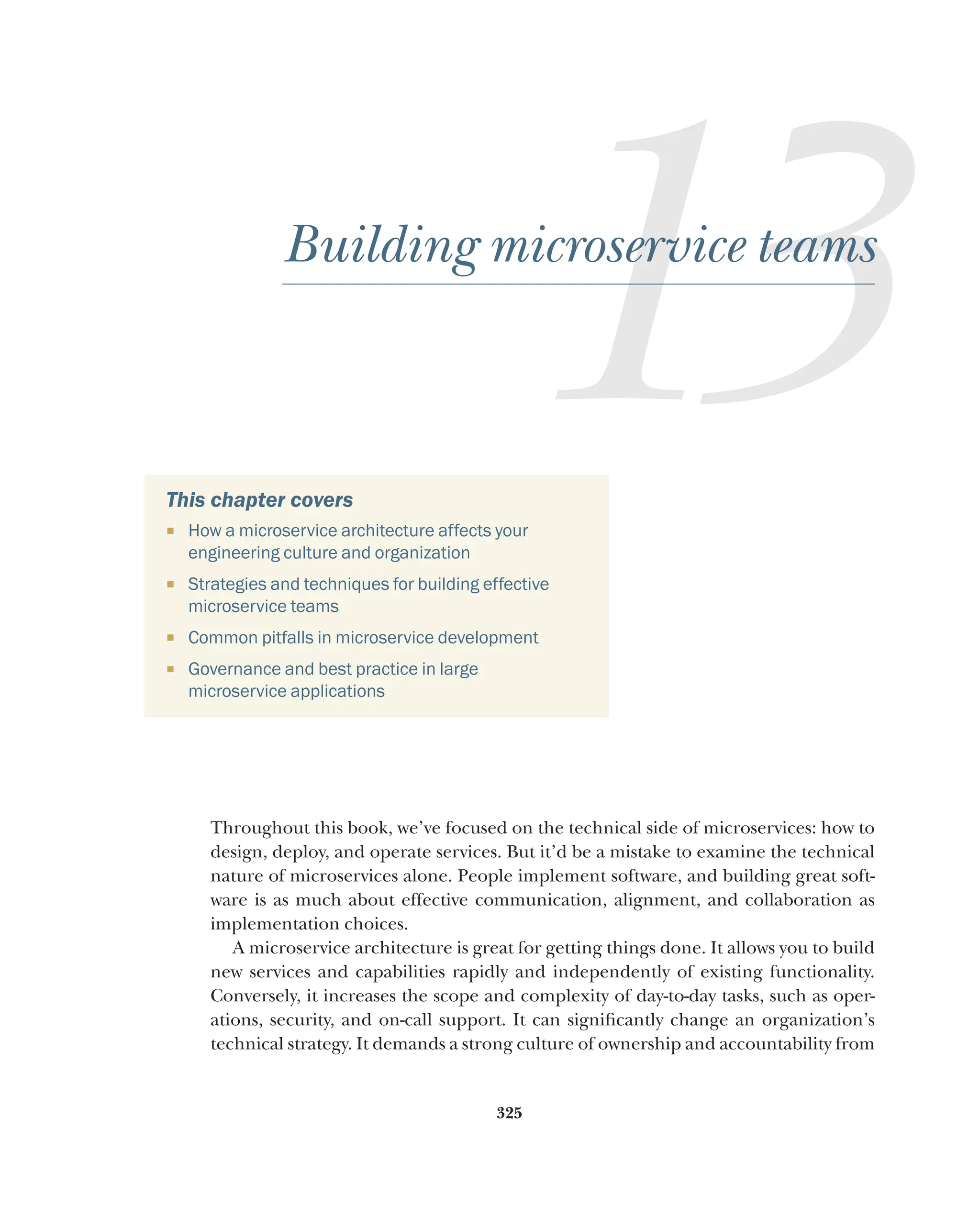
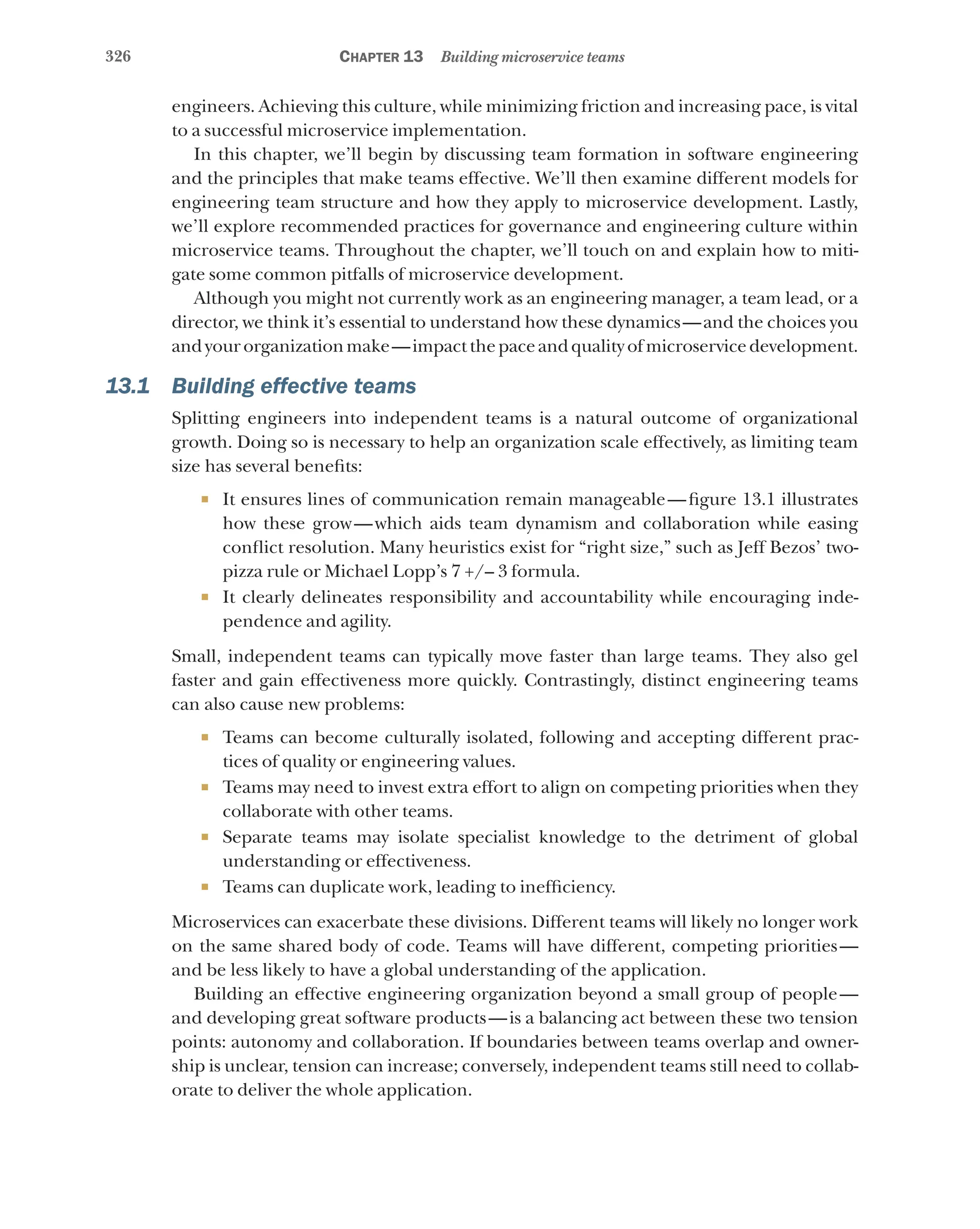


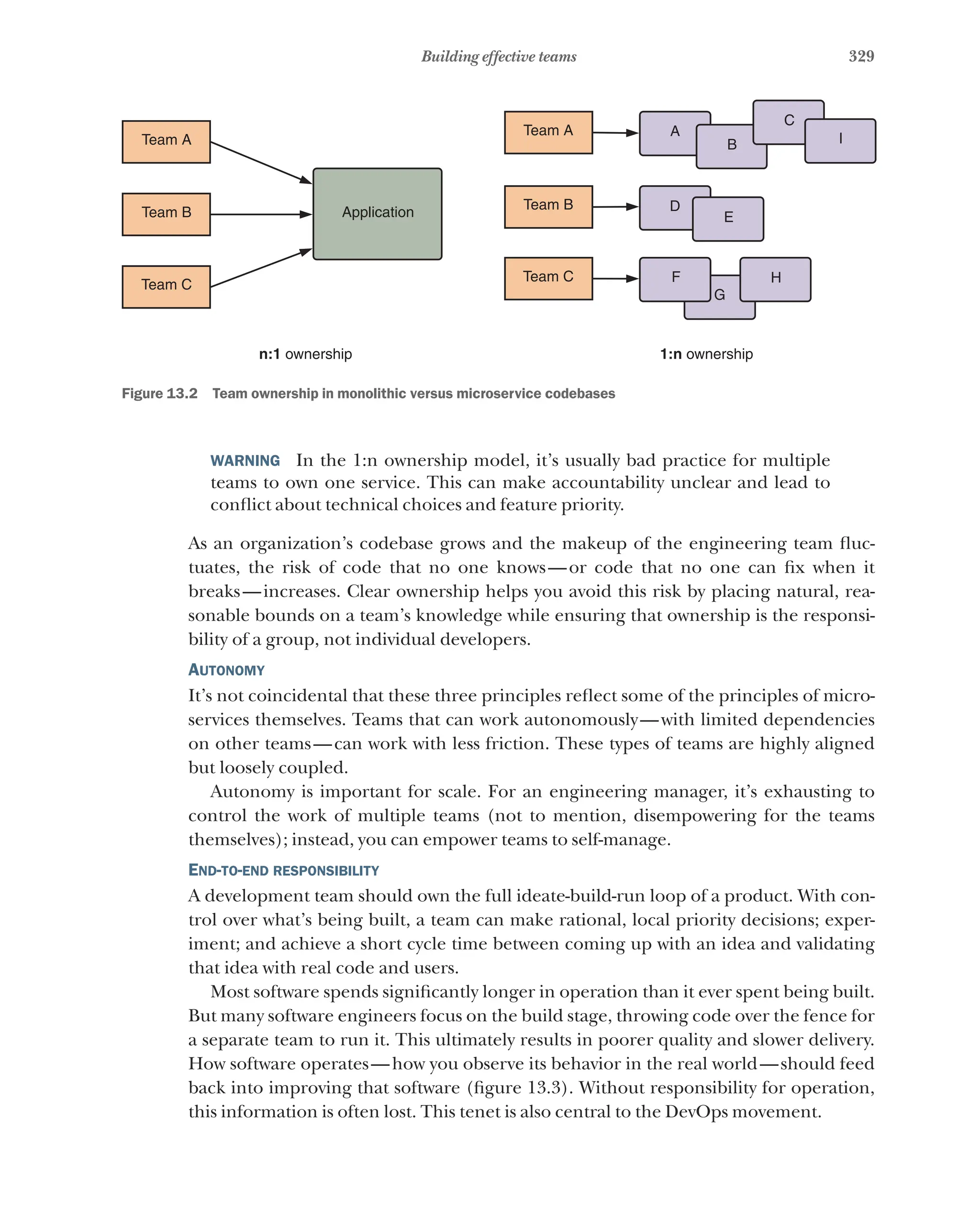
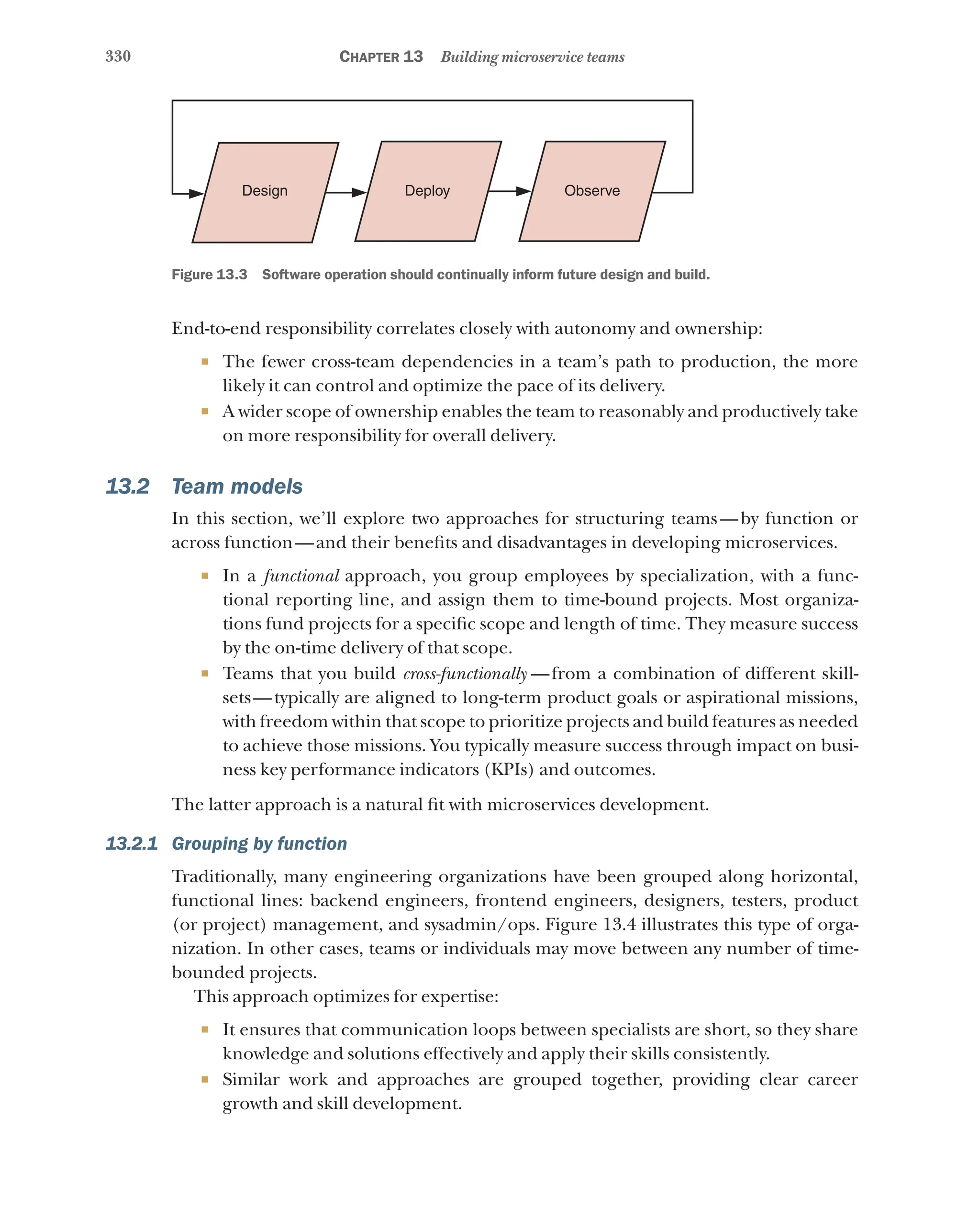
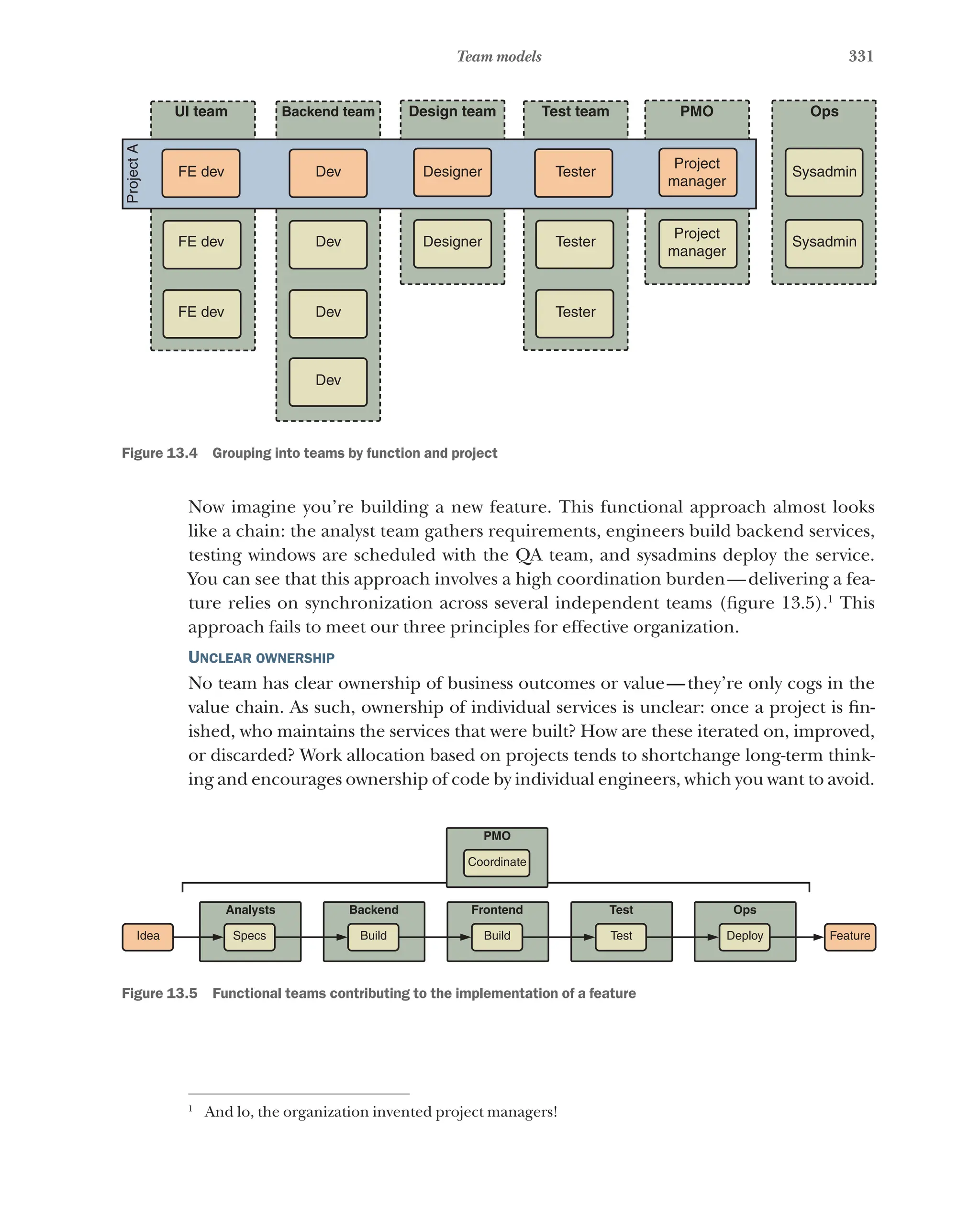
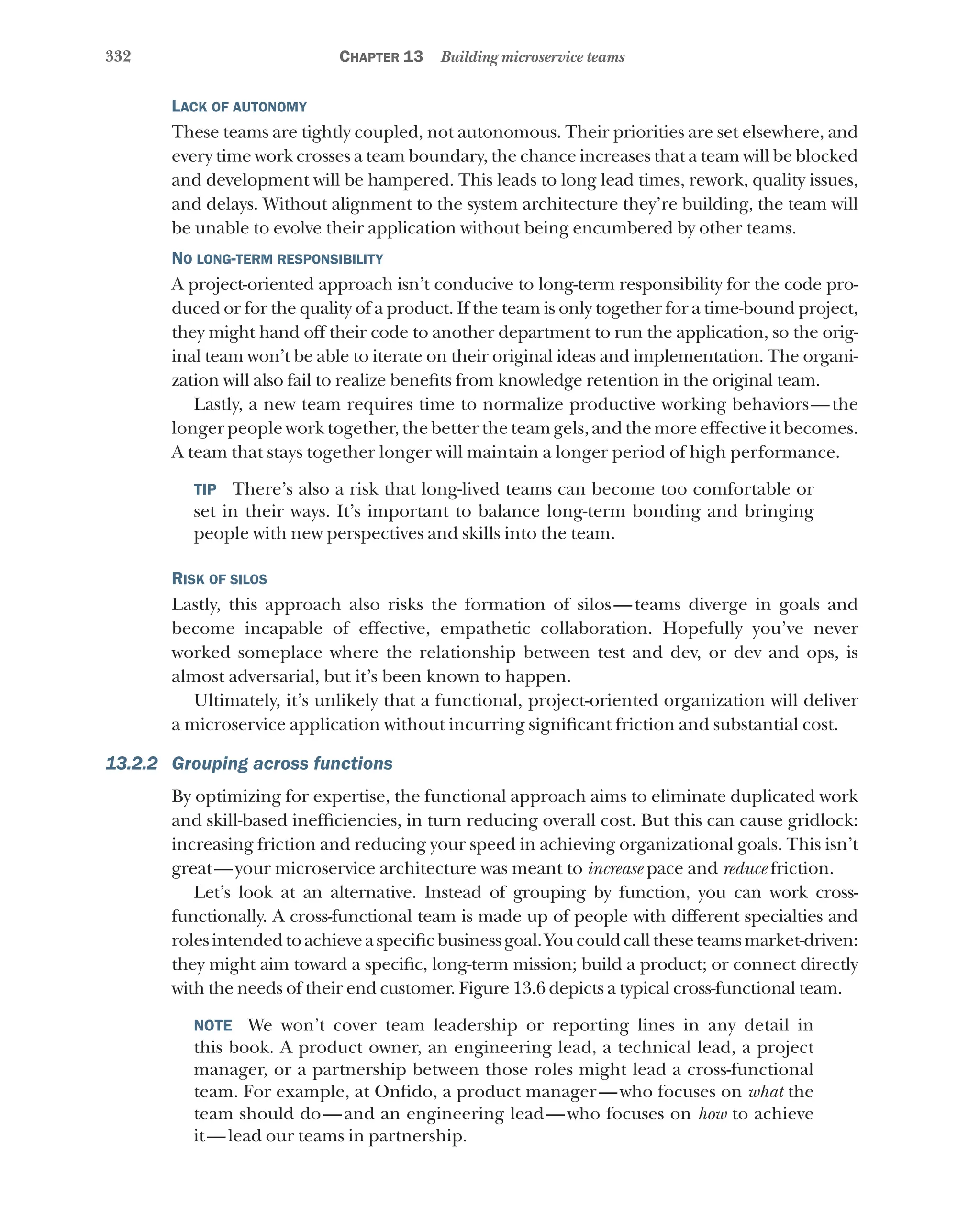
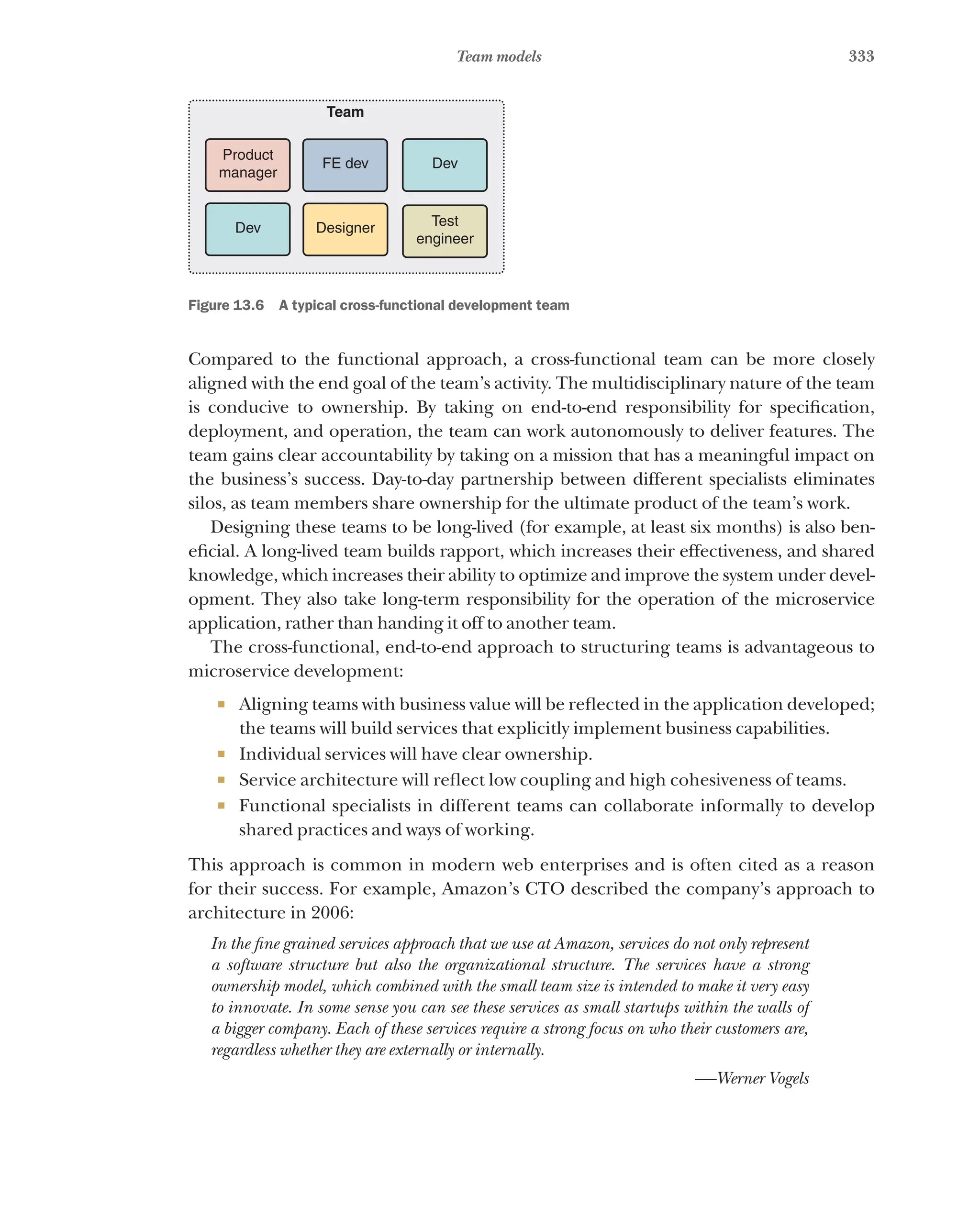
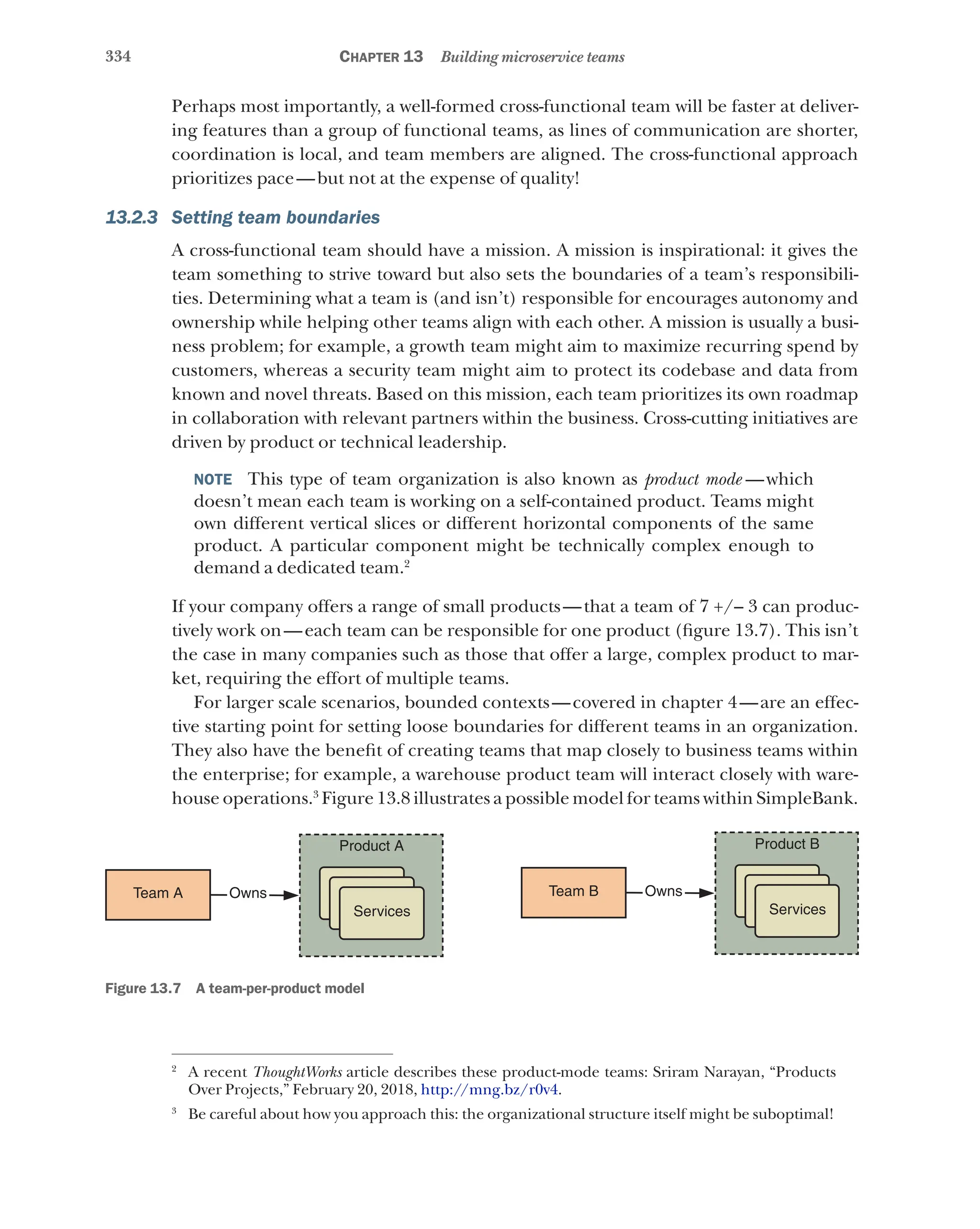
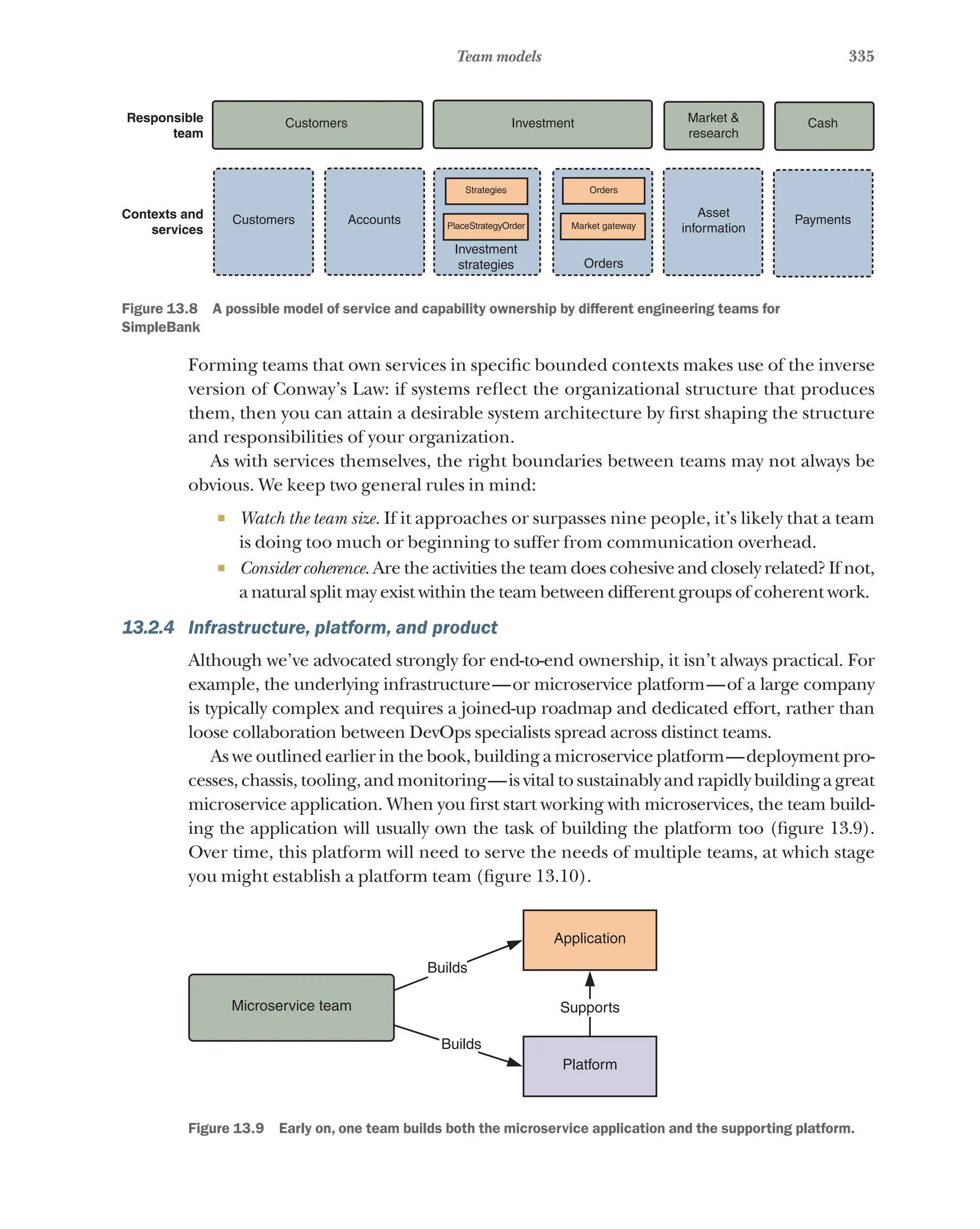
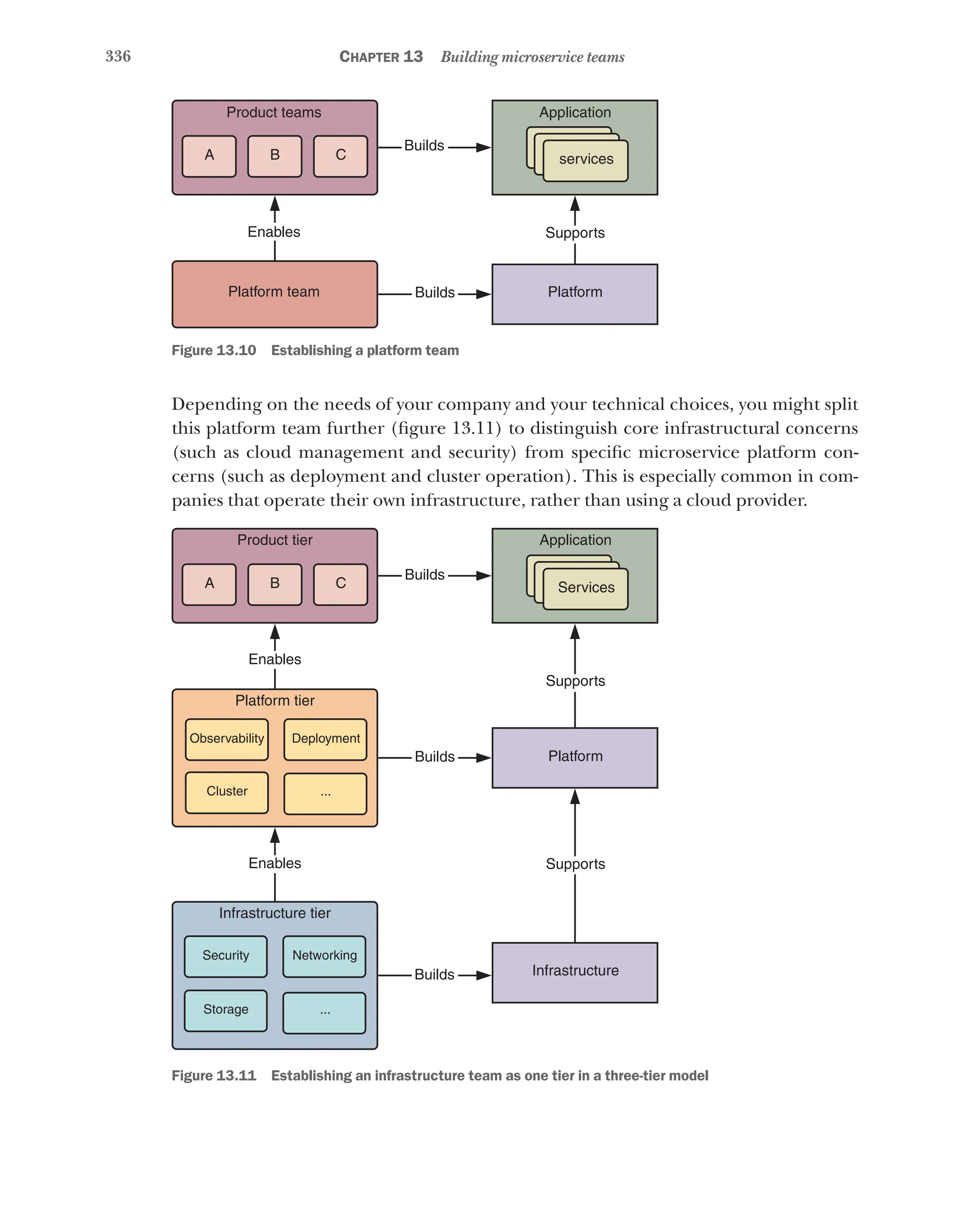

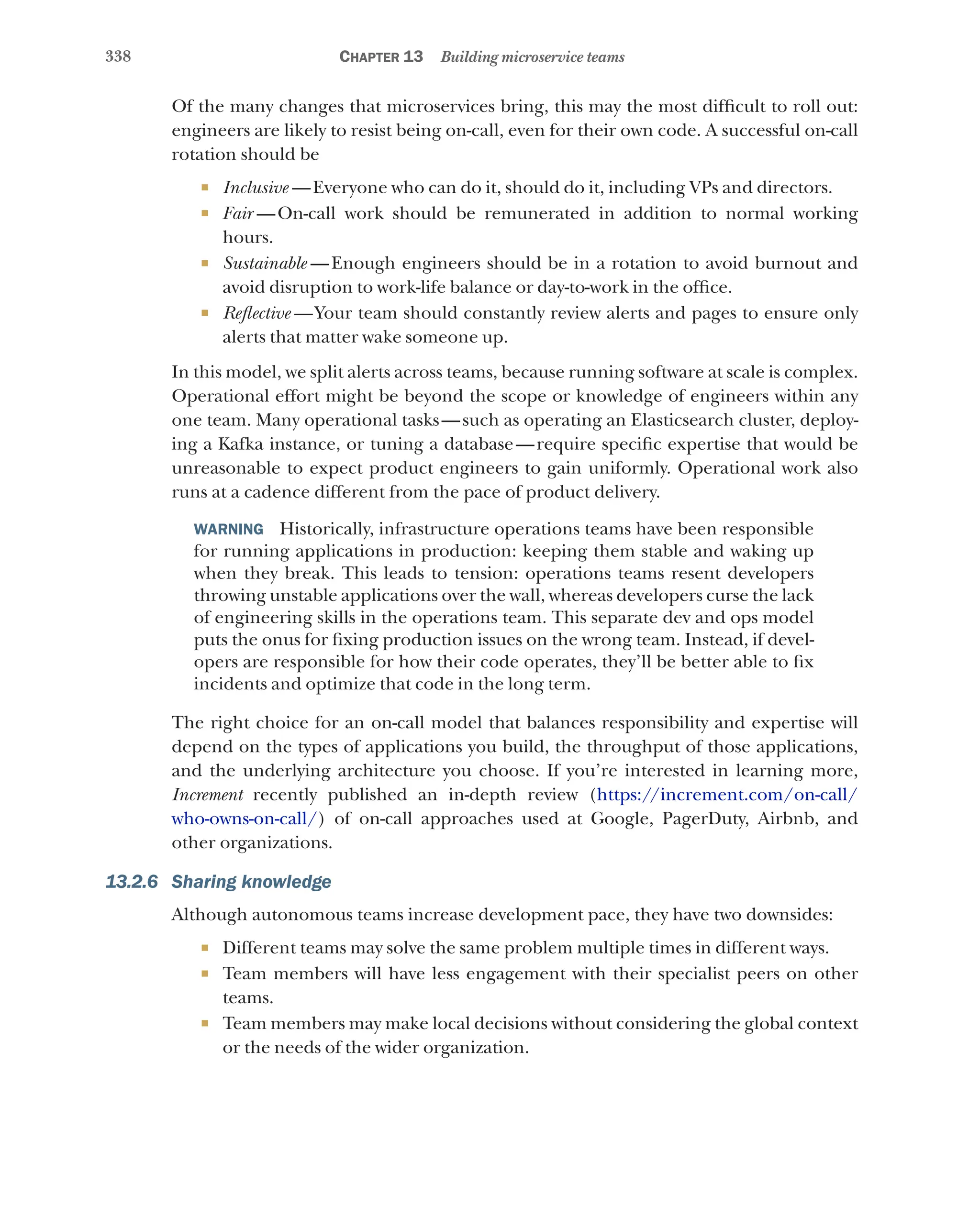
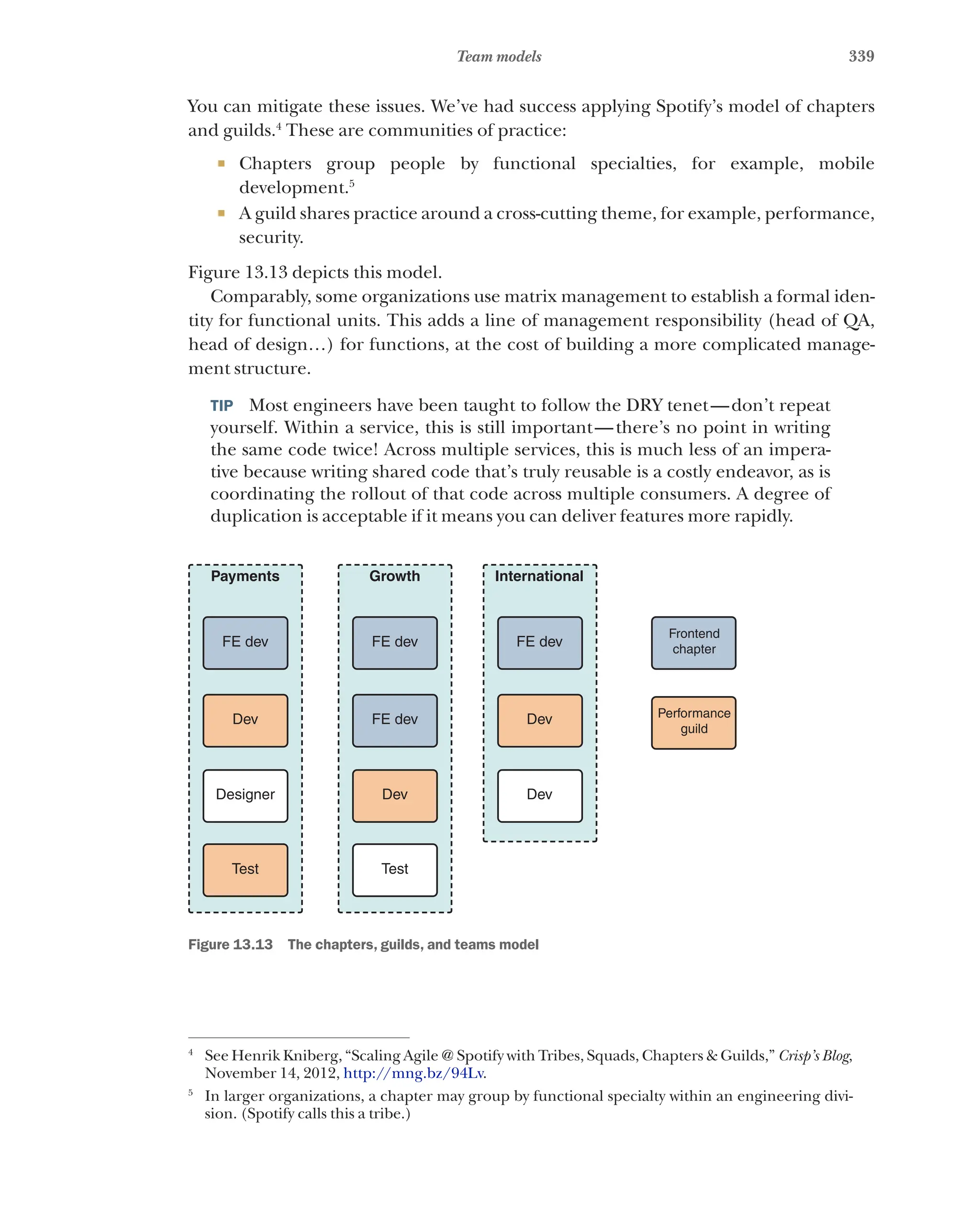
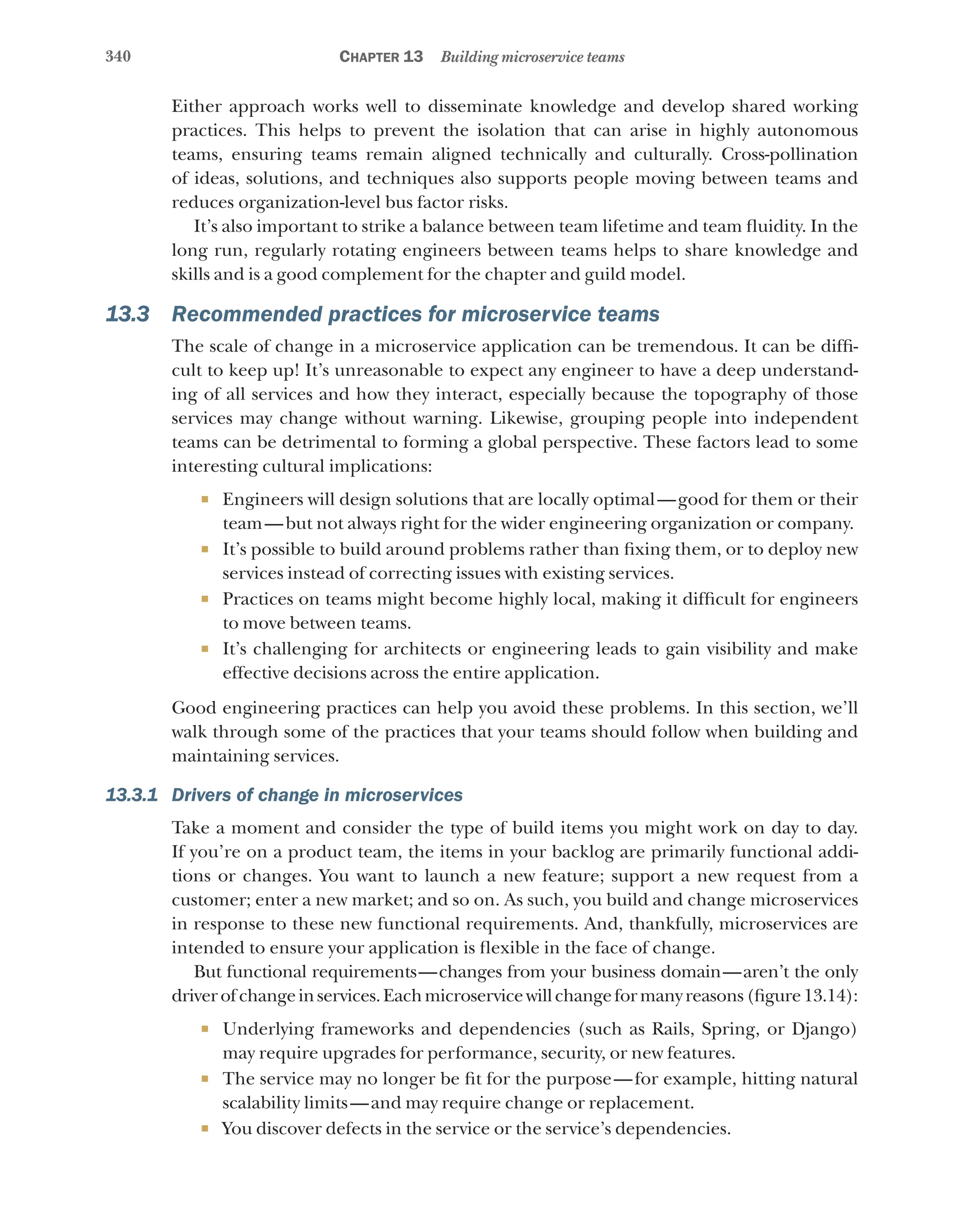
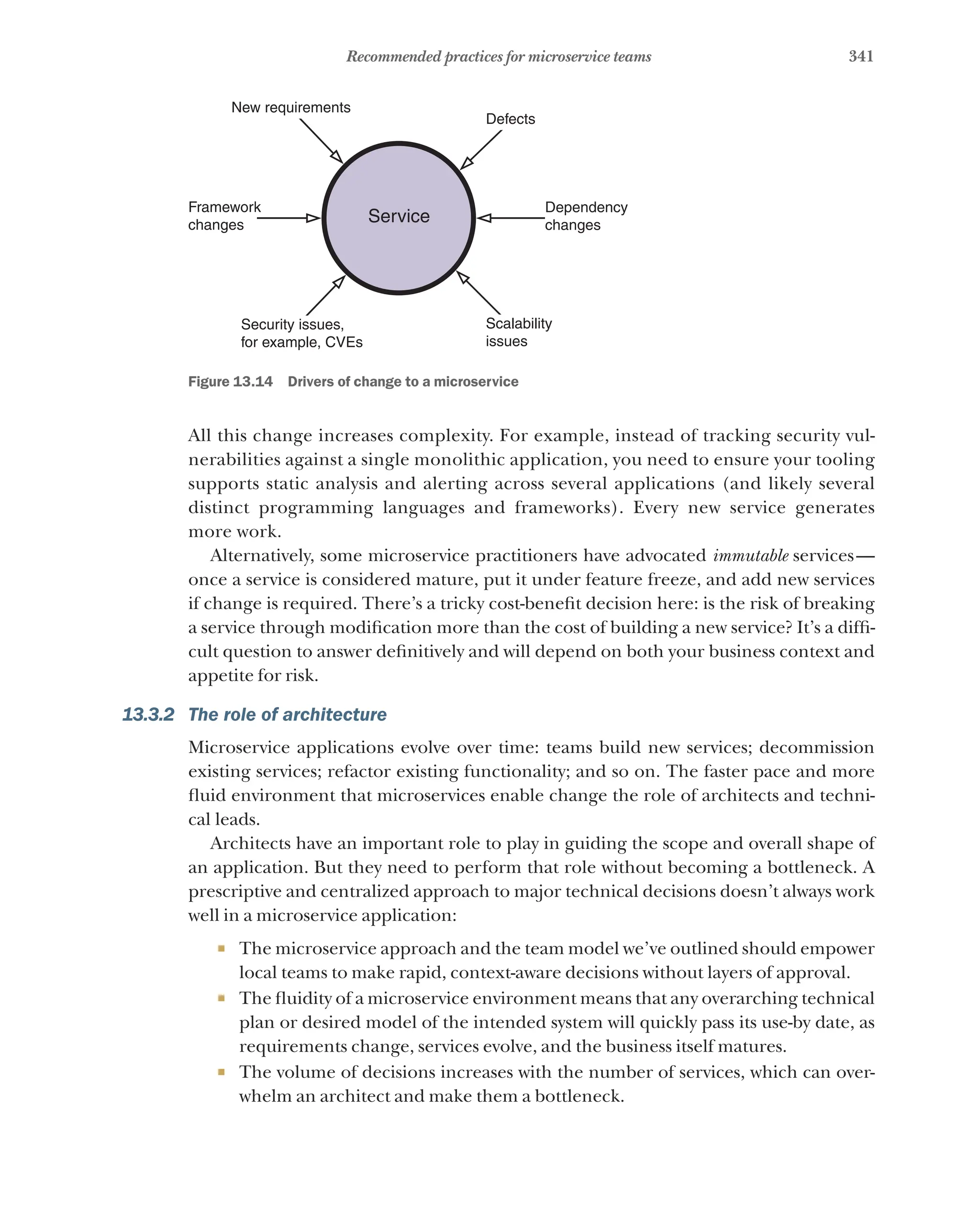

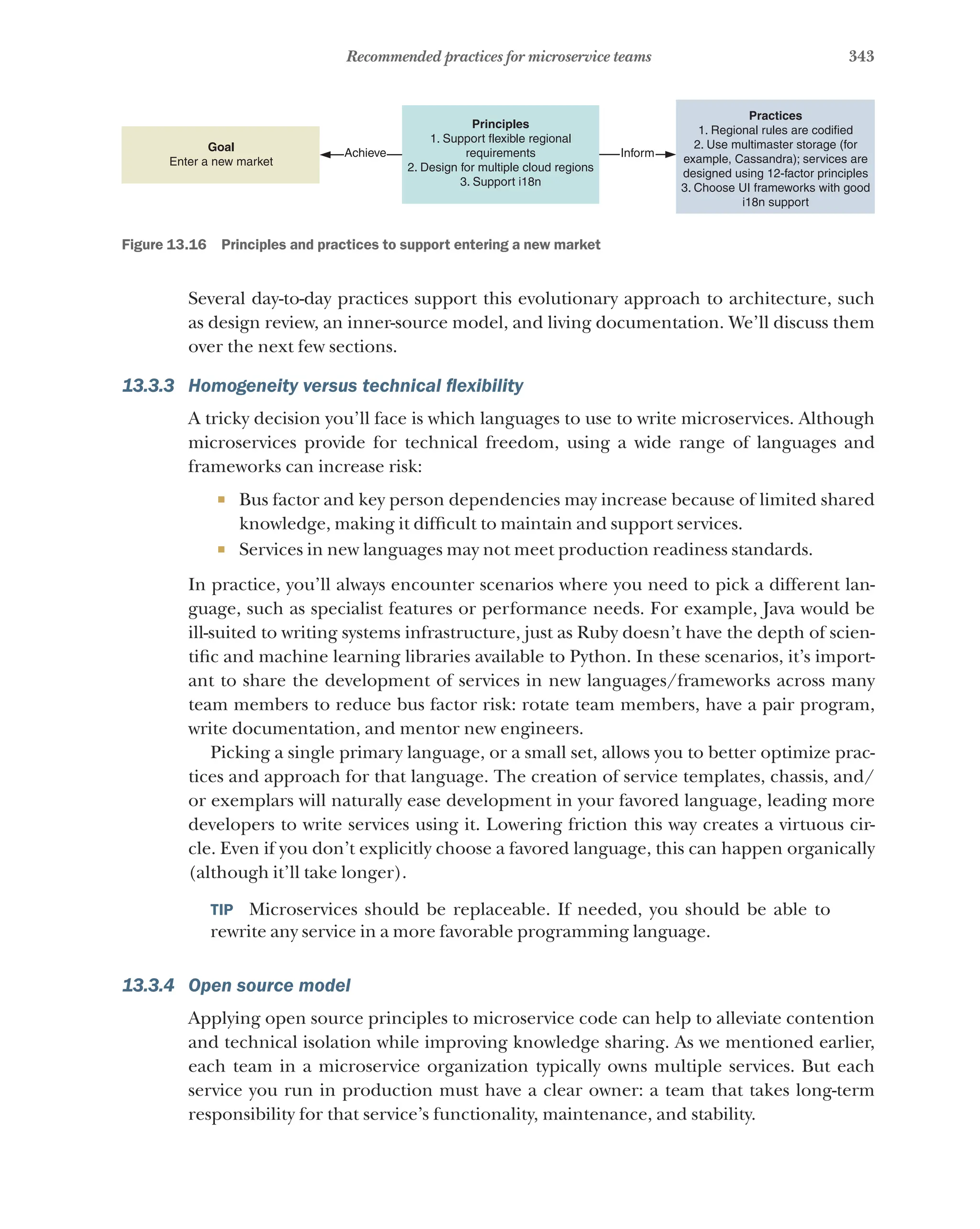

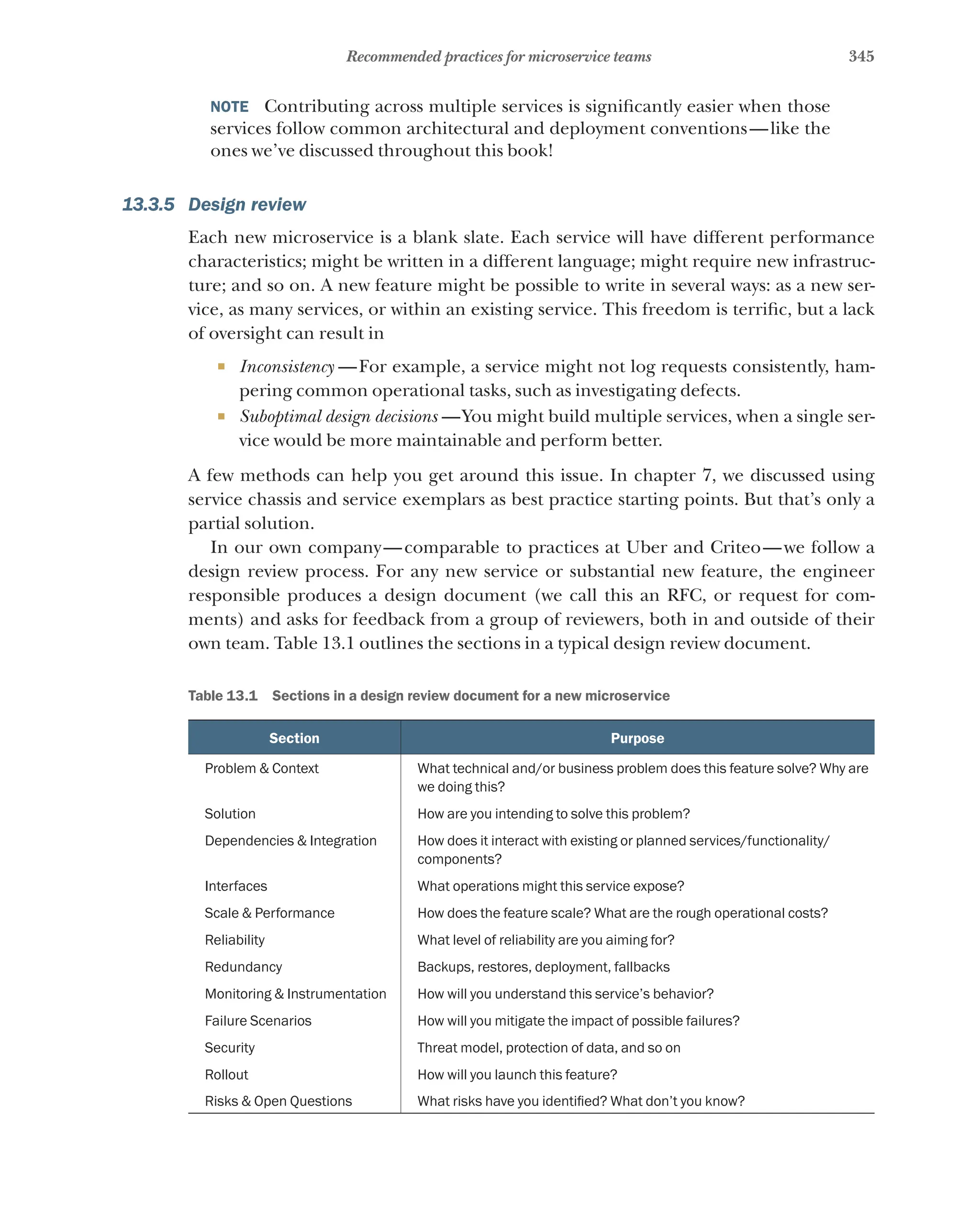
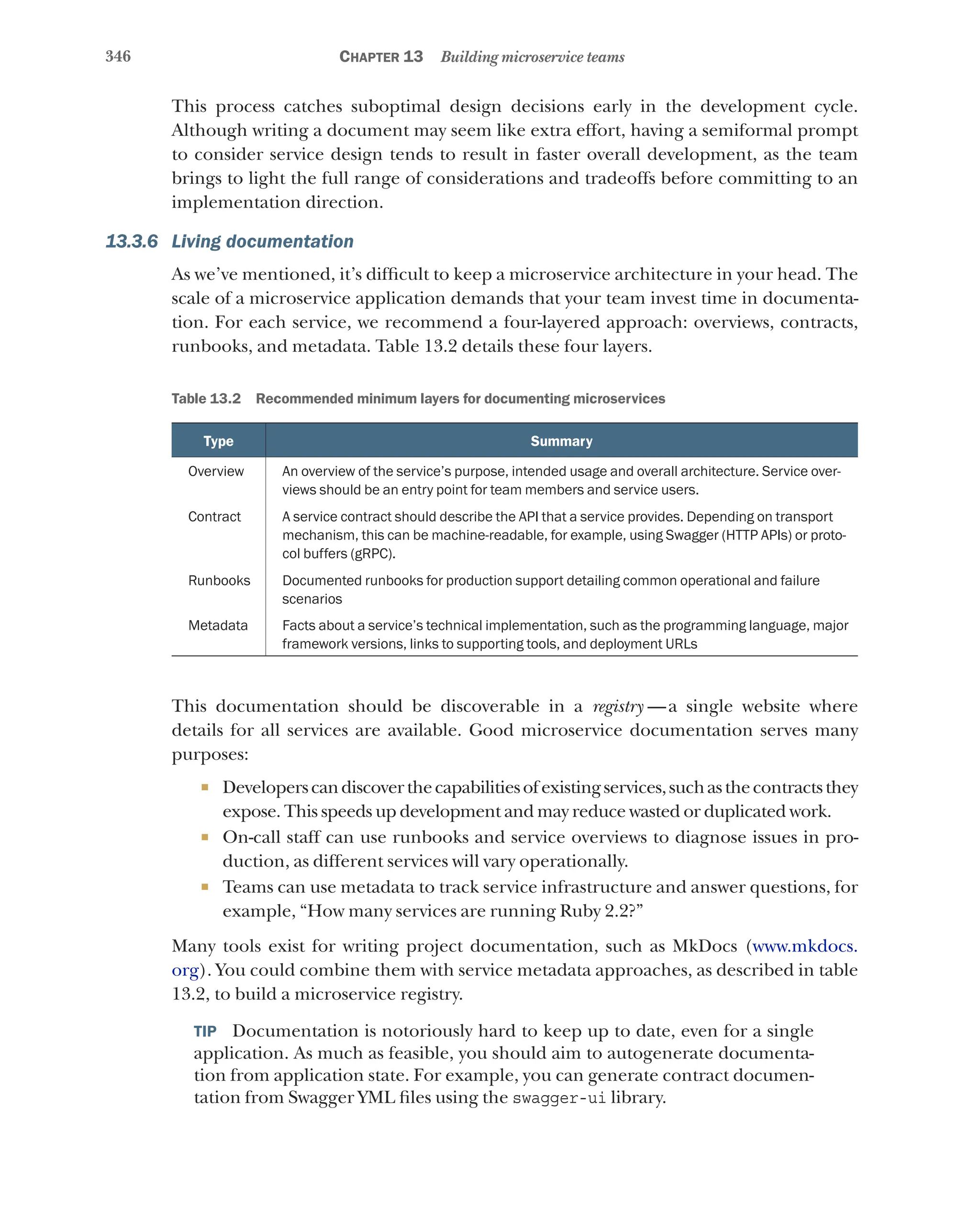
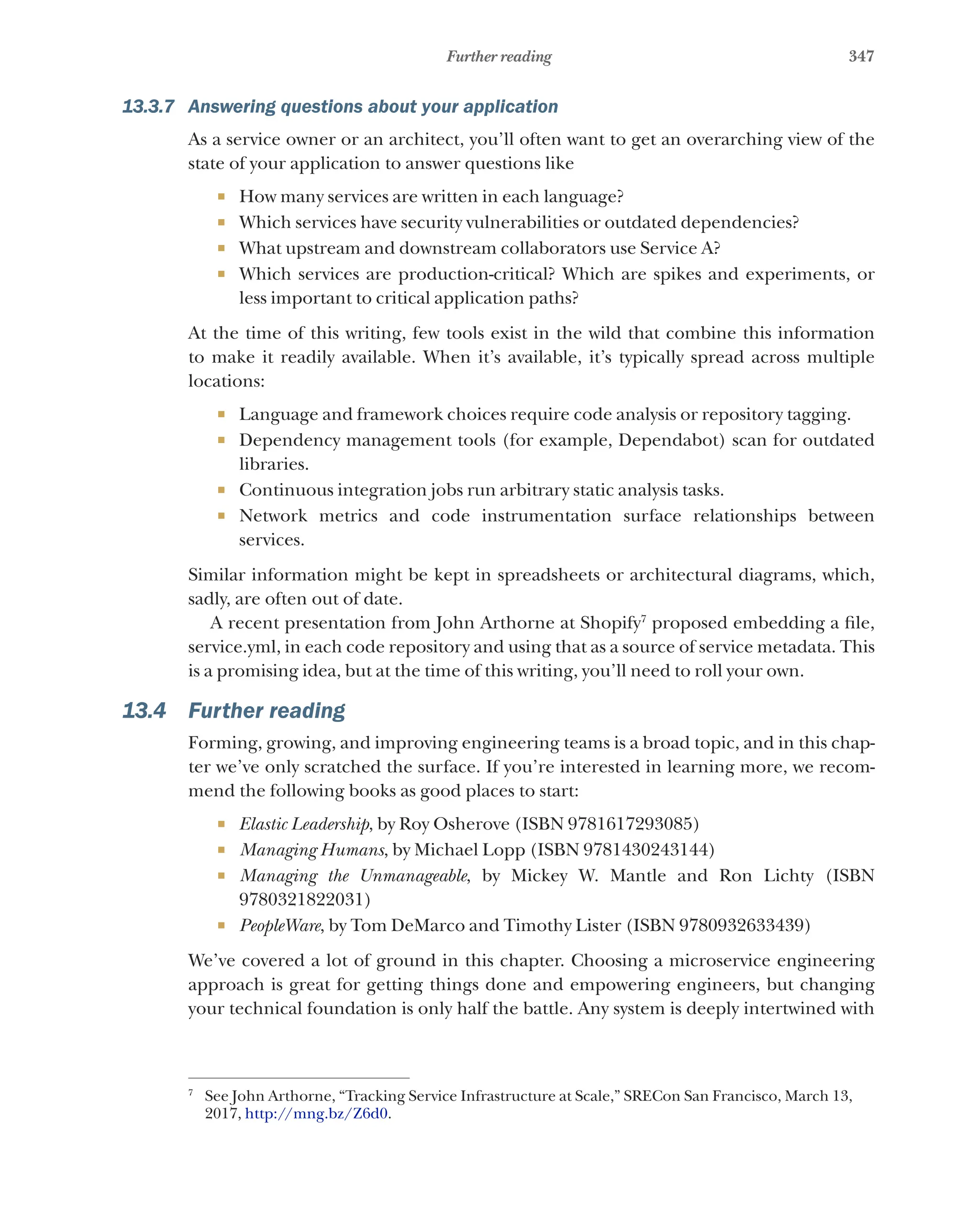
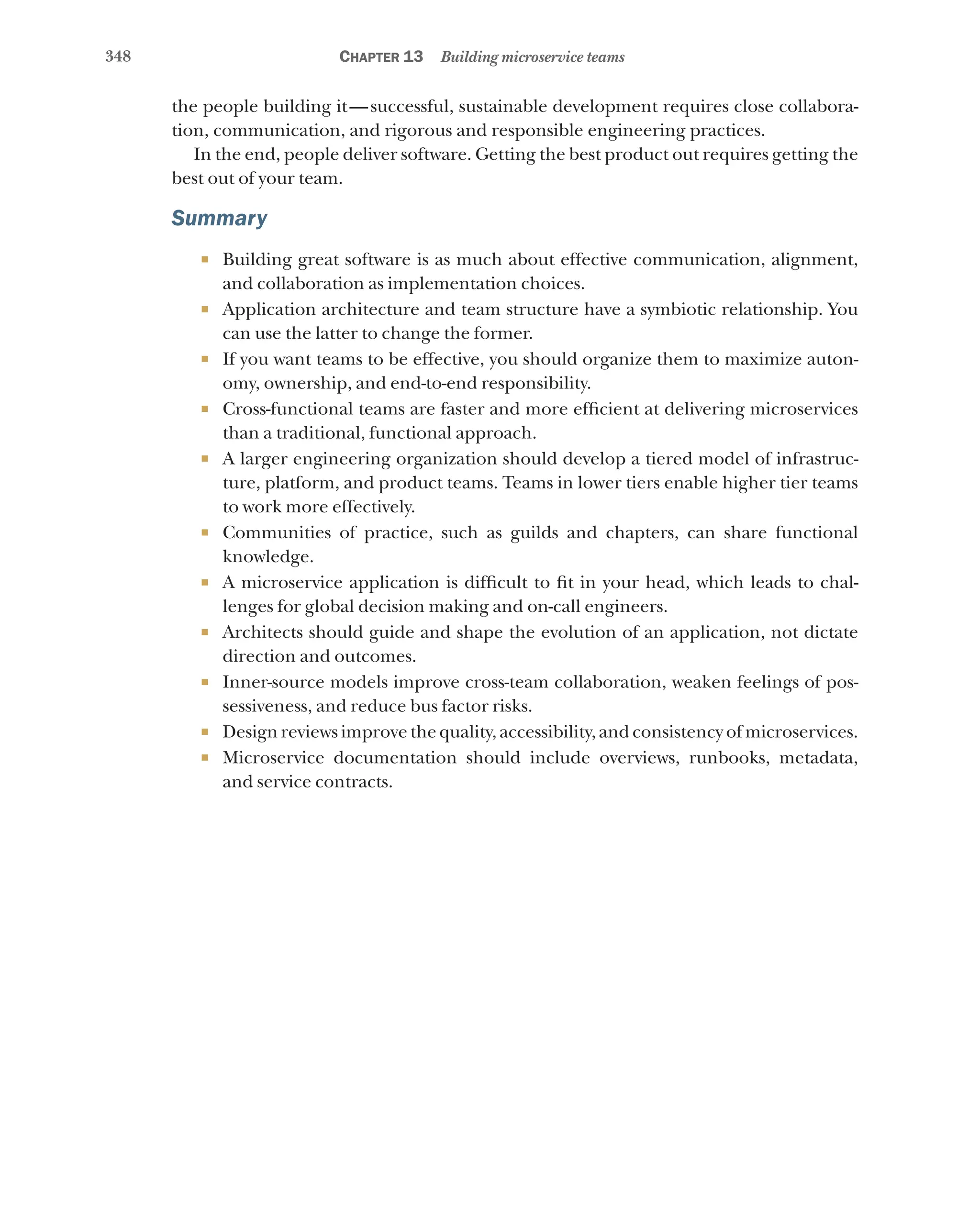
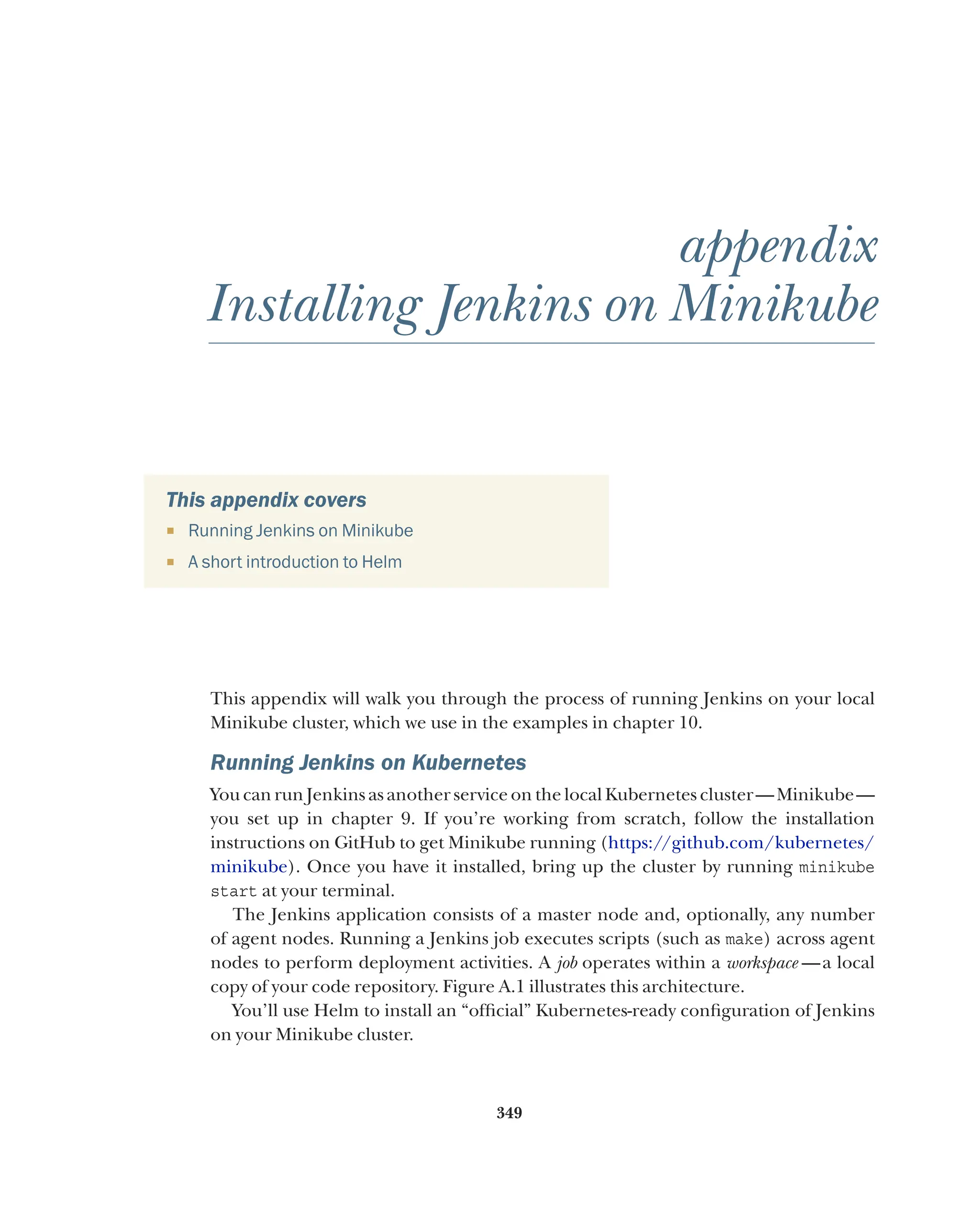
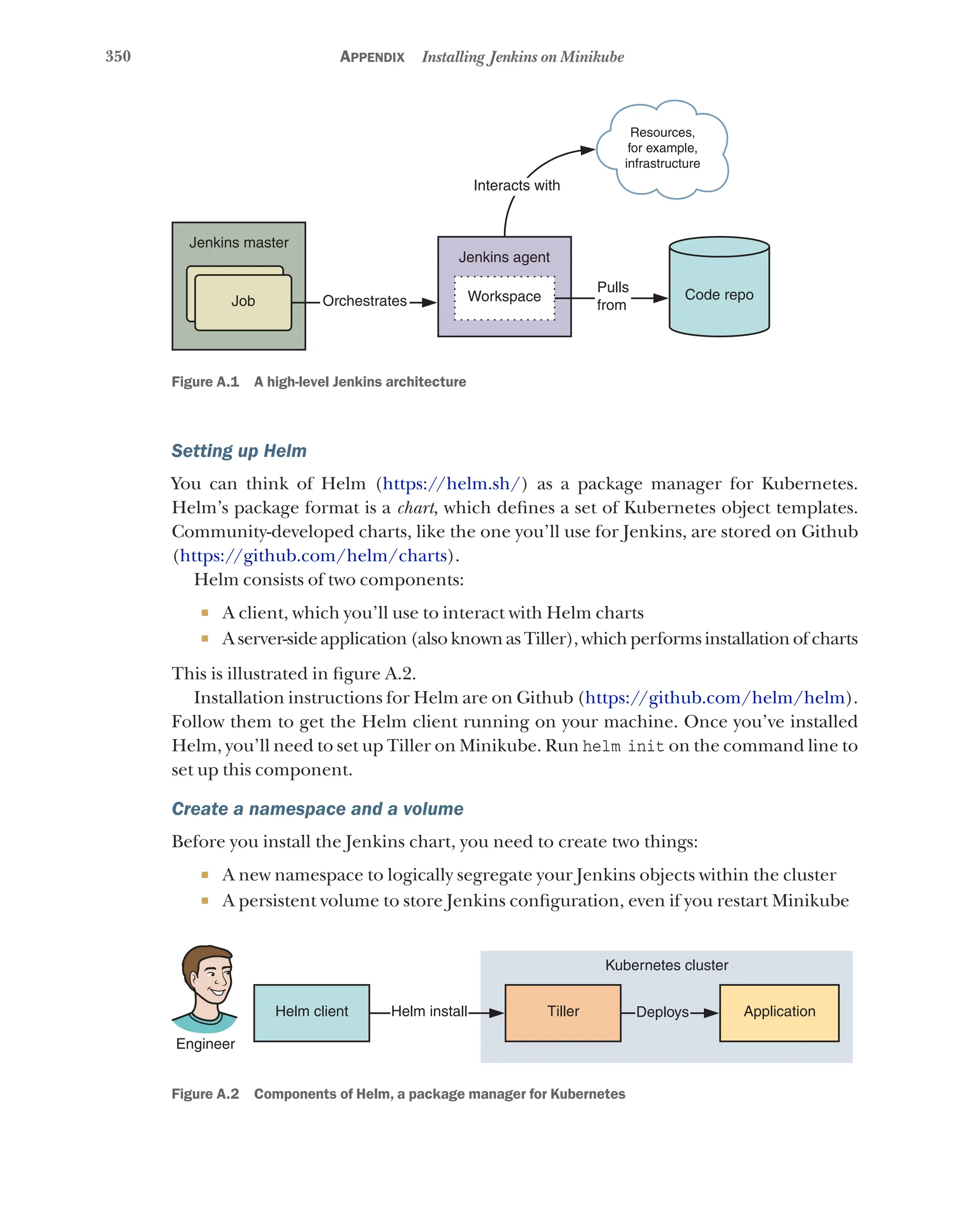
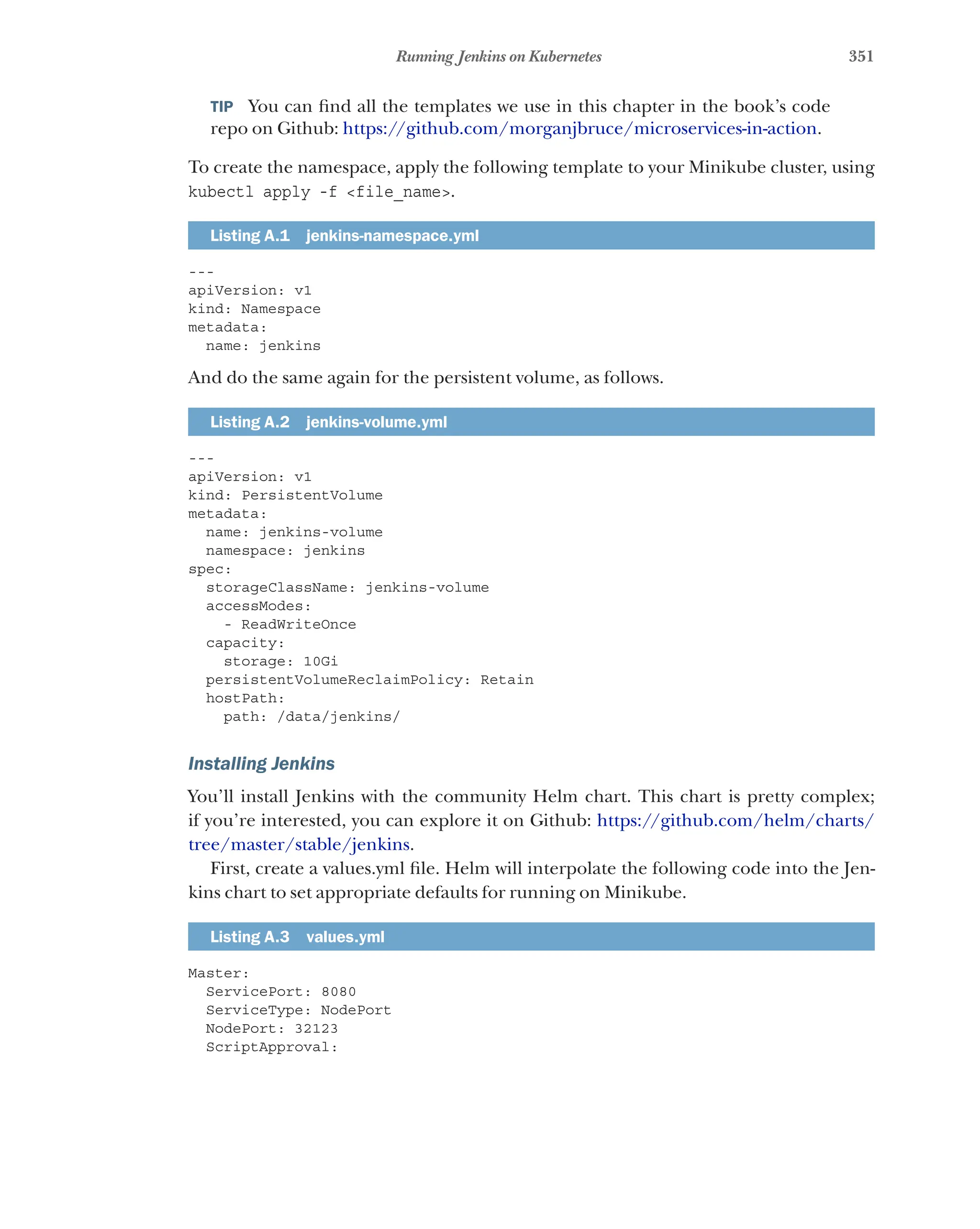
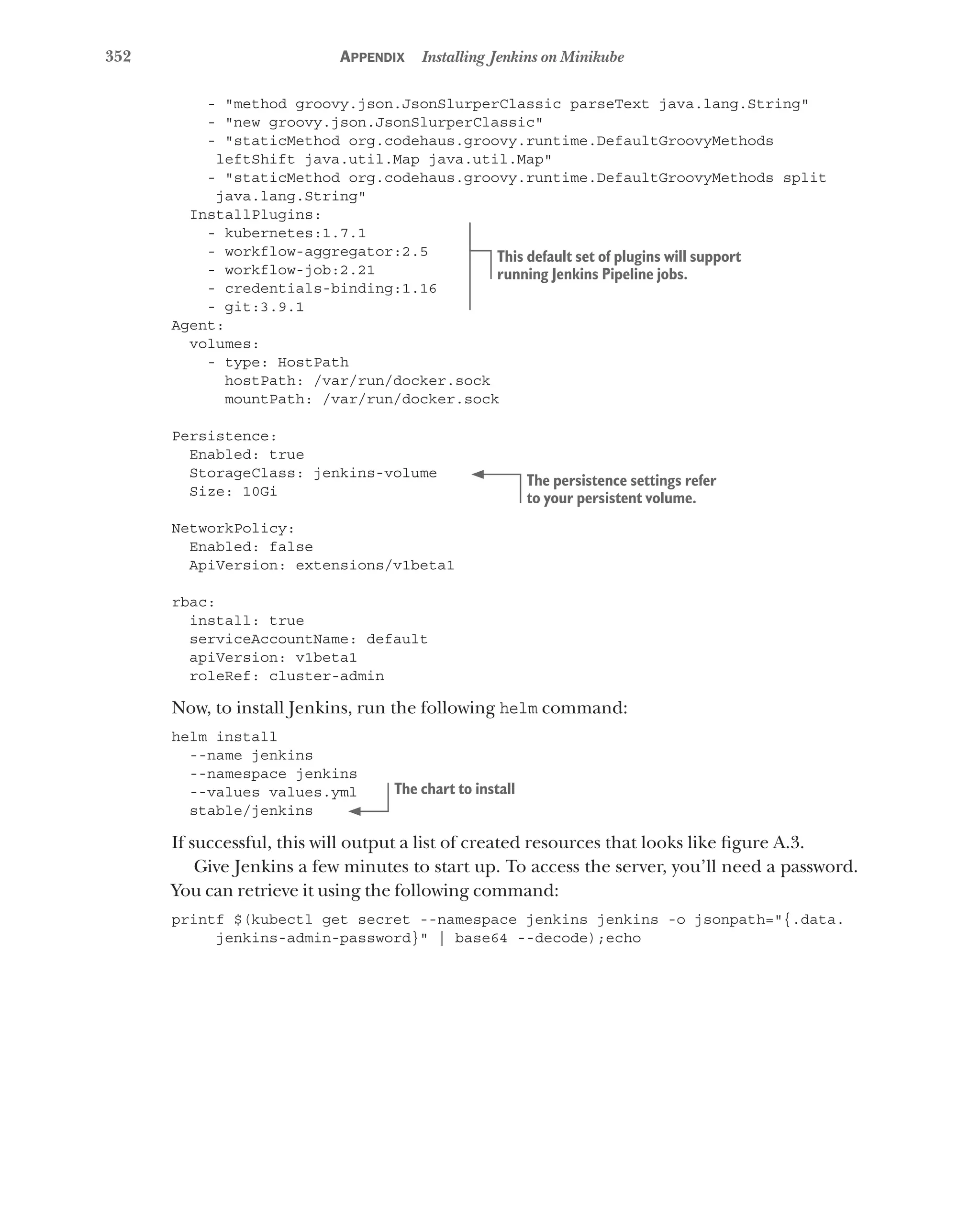
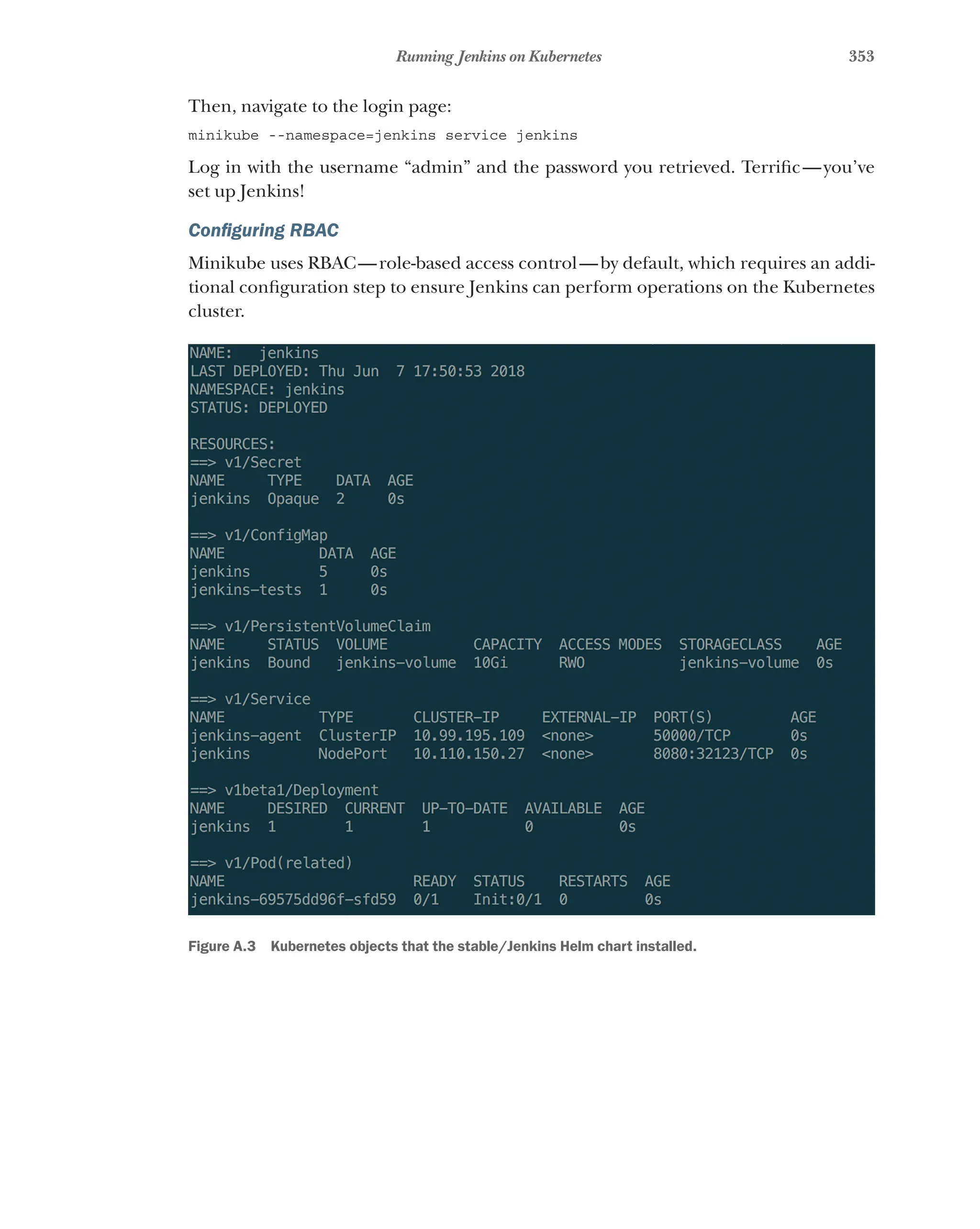
![354 Appendix Installing Jenkins on Minikube
To configure this appropriately on the Jenkins server:
1 Log in to the Jenkins dashboard.
2 Navigate to Credentials > System > Global Credentials > Add Credentials.
3 Add a Kubernetes Service Account credential, setting the value of the ID field to
jenkins.
4 Save and navigate to Jenkins > Manage Jenkins > System.
5 Under the Kubernetes section, configure the credentials to those you created in
step 3 (figure A.4) and click Save.
Figure A.4 Kubernetes cloud credentials
Testing it all works
You can run a simple build to make sure everything’s working. First, log in to your new
Jenkins dashboard and navigate to New Item in the left-hand column.
Create a new pipeline job named “test-job” per the configuration in figure A.5. Click
OK to move to the next page and configure that job with the following script in the Pipe-
line Script field.
Listing A.4 Test pipeline script
podTemplate(label: 'build', containers: [
containerTemplate(name: 'docker', image: 'docker', command: 'cat',
ttyEnabled: true)
],
volumes: [
hostPathVolume(mountPath: '/var/run/docker.sock', hostPath: '/var/run/
docker.sock'),](https://image.slidesharecdn.com/microservicesinaction-240113230140-1bc300cc/75/microservices-in-action-pdf-381-2048.jpg)
![355
Running Jenkins on Kubernetes
]
) {
node('build') {
container('docker') {
sh 'docker version'
}
}
}
Click Save, then, on the following page, click Build Now. This will execute your job.
TIP The first build run may take some time!
The script you added will
1 Create a new pod, containing a Docker container
2 Execute the docker version command inside that container and output the
results to the console
Figure A.5 New job page on Jenkins](https://image.slidesharecdn.com/microservicesinaction-240113230140-1bc300cc/75/microservices-in-action-pdf-382-2048.jpg)
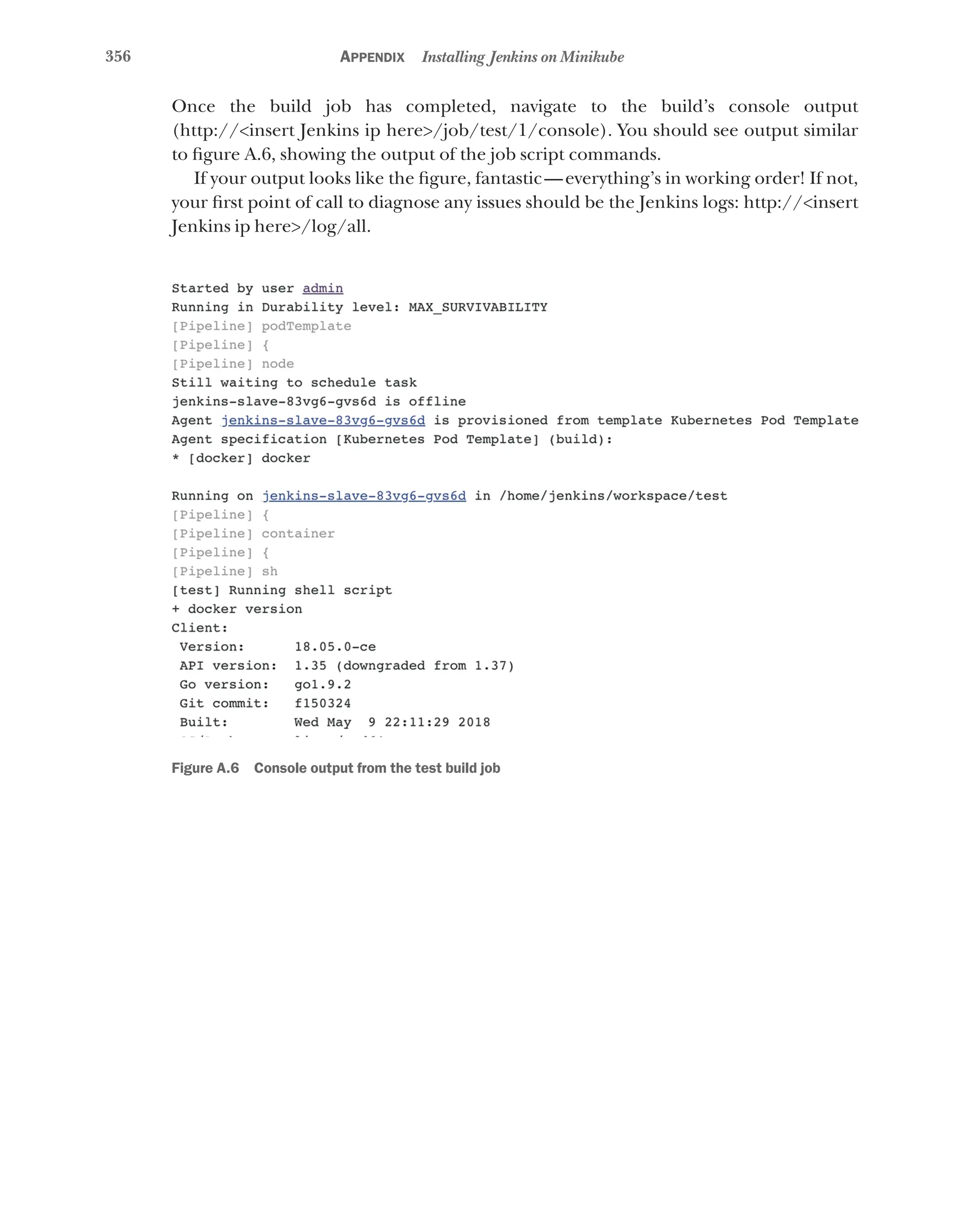
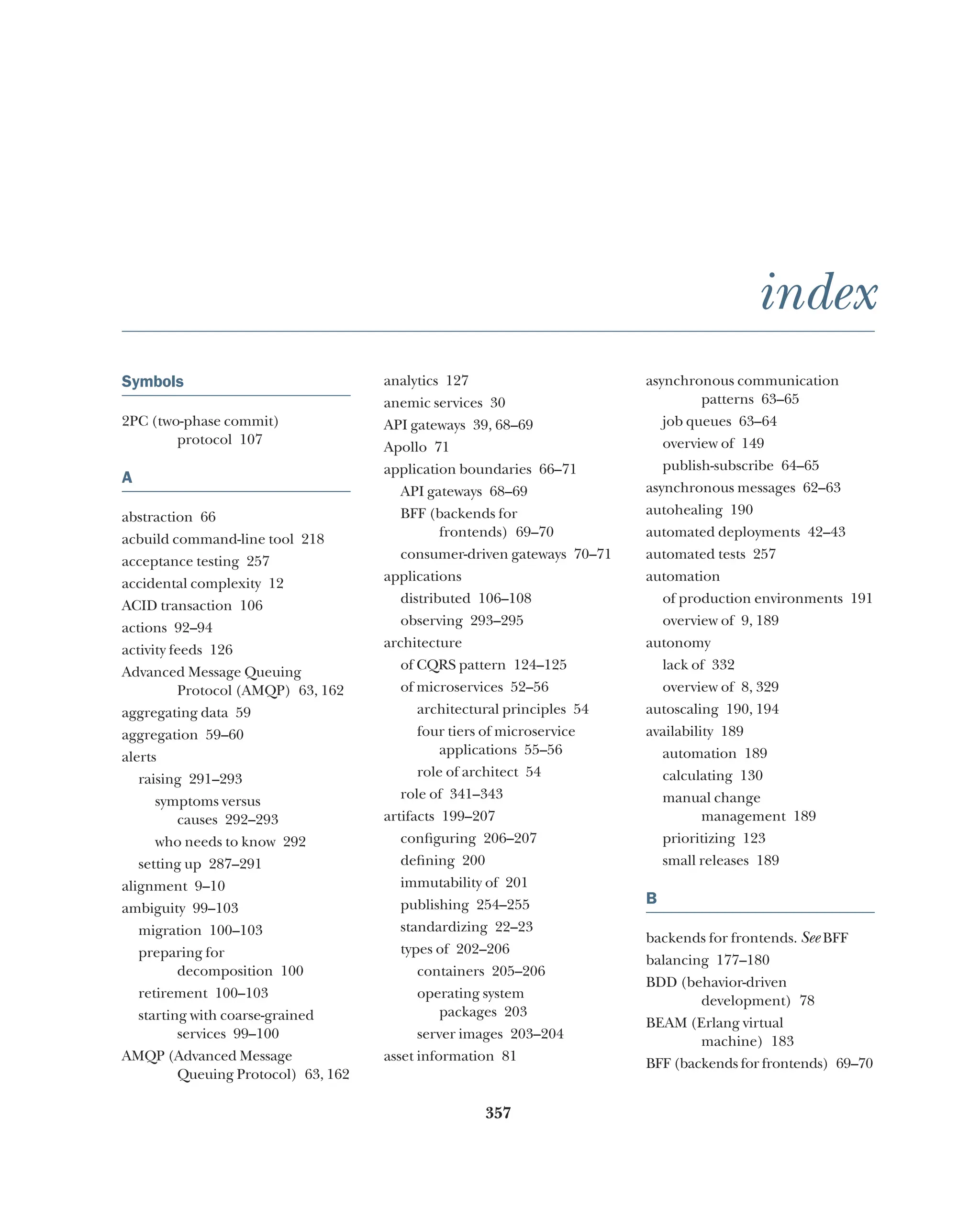

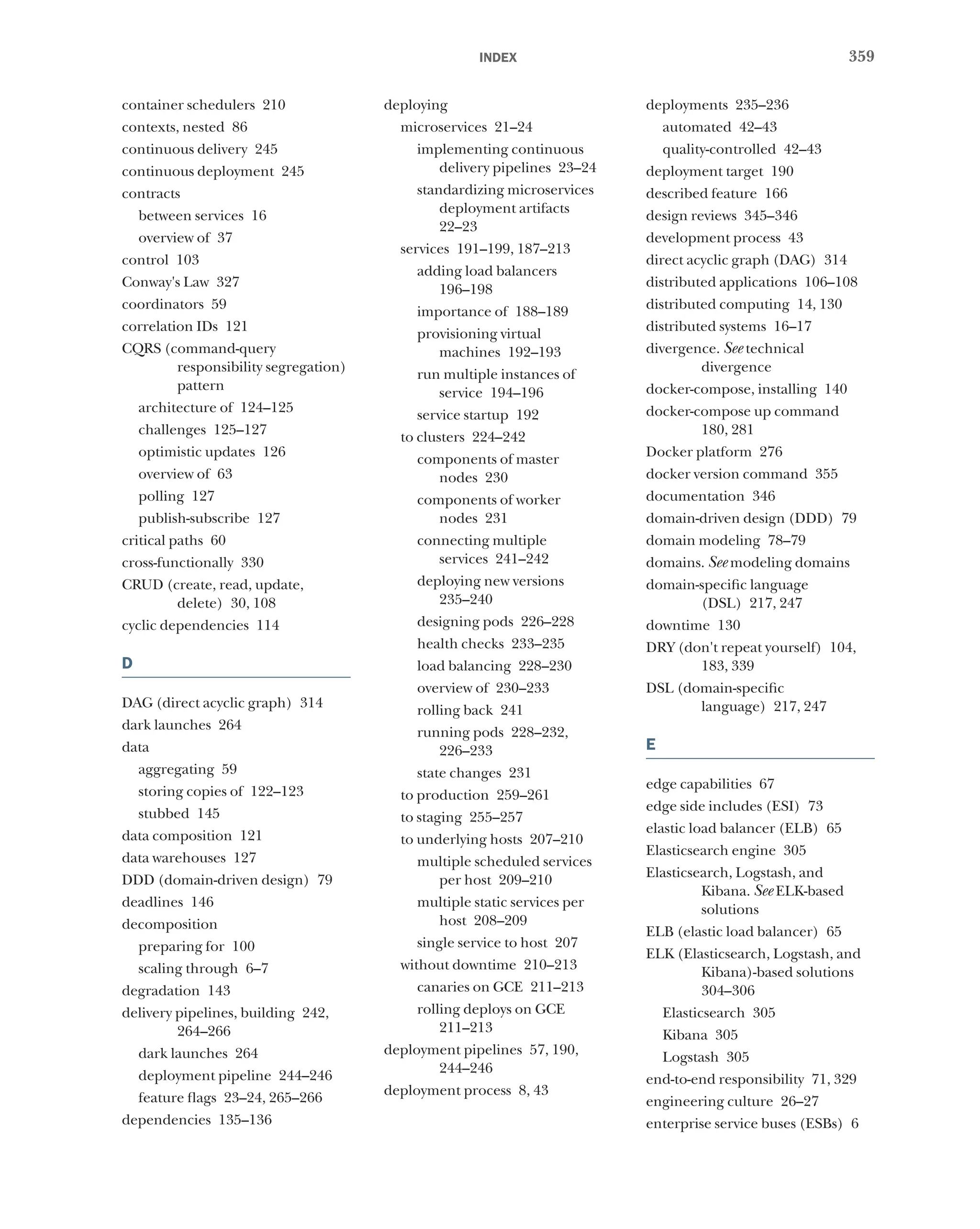
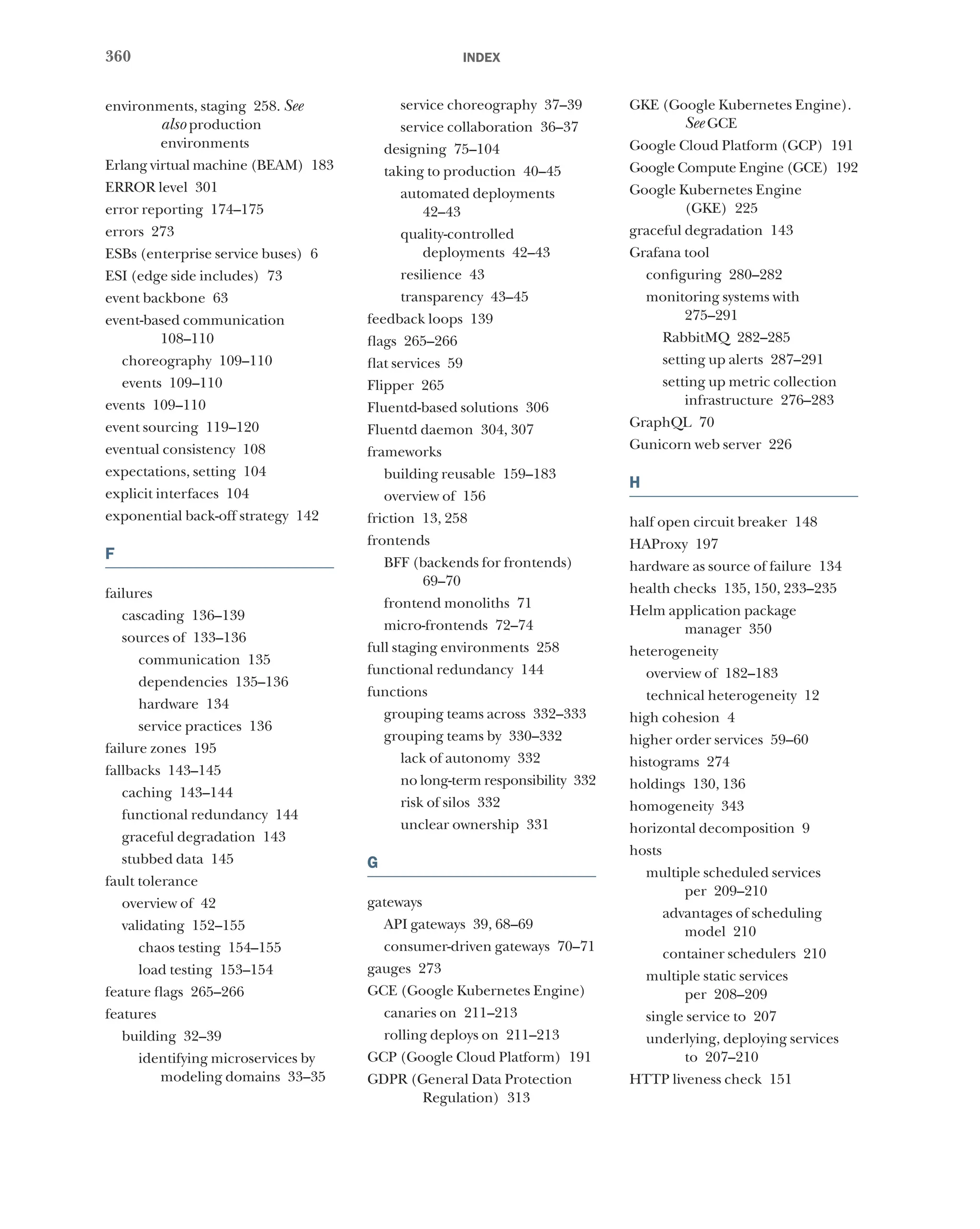


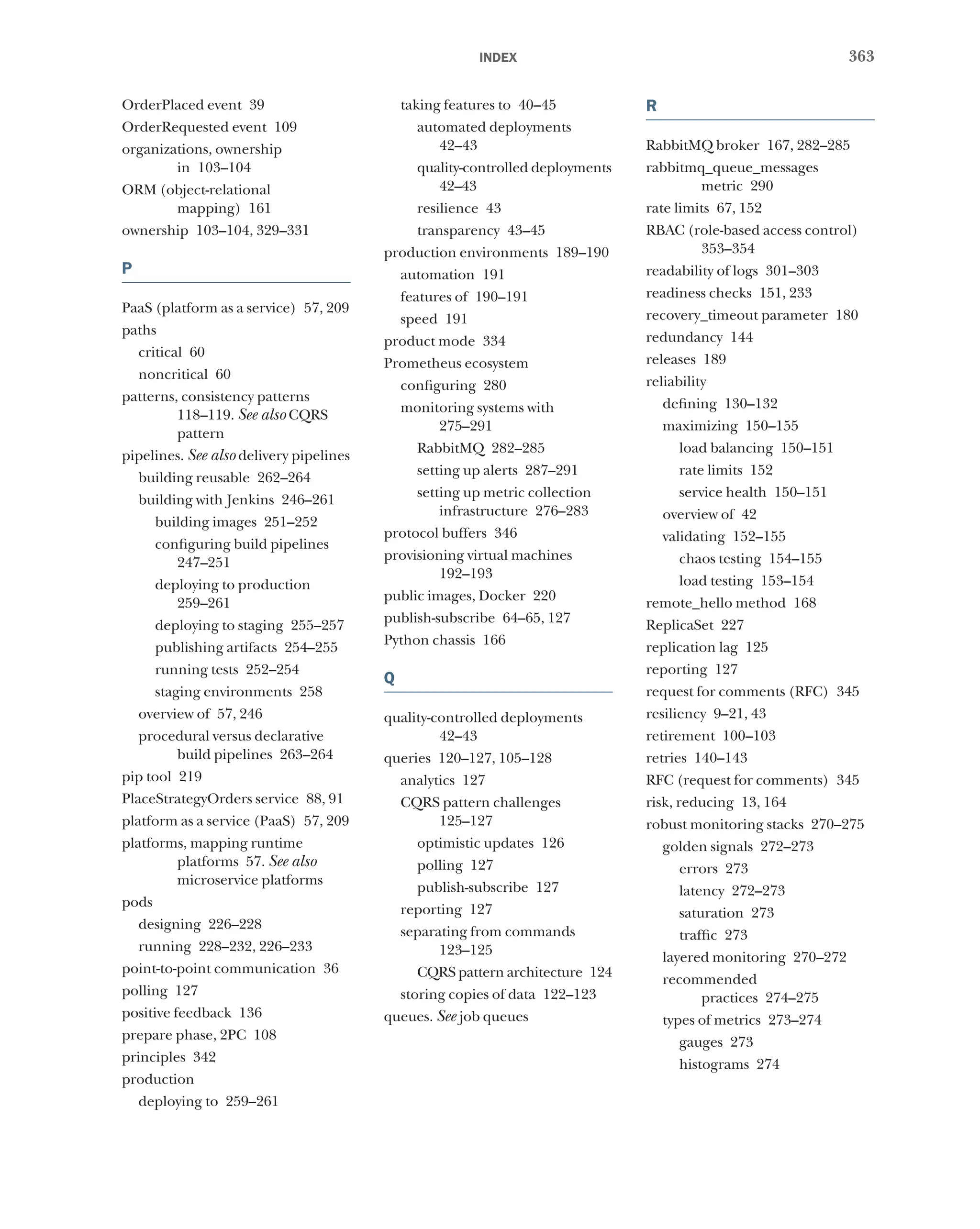



![Bruce ● Pereira
I
nvest your time in designing great applications, improving
infrastructure, and making the most out of your dev teams.
Microservices are easier to write, scale, and maintain than
traditional enterprise applications because they’re built as a
system of independent components. Master a few important
new patterns and processes, and you’ll be ready to develop,
deploy, and run production-quality microservices.
Microservices in Action teaches you how to write and maintain
microservice-based applications. Created with day-to-day
development in mind, this informative guide immerses you
in real-world use cases from design to deployment. You’ll
discover how microservices enable an efficient continuous
delivery pipeline, and explore examples using Kubernetes,
Docker, and Google Container Engine.
What’s Inside
● An overview of microservice architecture
● Building a delivery pipeline
● Best practices for designing multi-service transactions
and queries
● Deploying with containers
● Monitoring your microservices
Written for intermediate developers familiar with enterprise
architecture and cloud platforms like AWS and GCP.
Morgan Bruce and Paulo A. Pereira are experienced engineering
leaders. They work daily with microservices in a production
environment, using the techniques detailed in this book.
To download their free eBook in PDF, ePub, and Kindle formats, owners
of this book should visit manning.com/books/microservices-in-action
$49.99 / Can $65.99 [INCLUDING eBOOK]
MicroservicesINACTION
SOFTWARE DEVELOPMENT
M A N N I N G
“The one [and only] book
on implementing micro-
services with a real-world,
cover-to-cover example
you can relate to.
”
—Christian Bach, Swiss Re
“A perfect fit for those who
want to move their majestic
monolith to a scalable
microservice architecture.
”
—Akshat Paul
McKinsey & Company
“Shows not only how to
write microservices, but also
how to prepare your
business and infrastructure
for this change.
”
—Maciej Jurkowski, Grupa Pracuj
“A deep dive into microser-
vice development with many
real and useful examples.
”
—Antonio Pessolano
Consoft Sistemi
See first page](https://image.slidesharecdn.com/microservicesinaction-240113230140-1bc300cc/75/microservices-in-action-pdf-394-2048.jpg)